Documents
Report on Inquiry Into CIA Related Electronic Surveillance Activities
Oct. 2, 2014
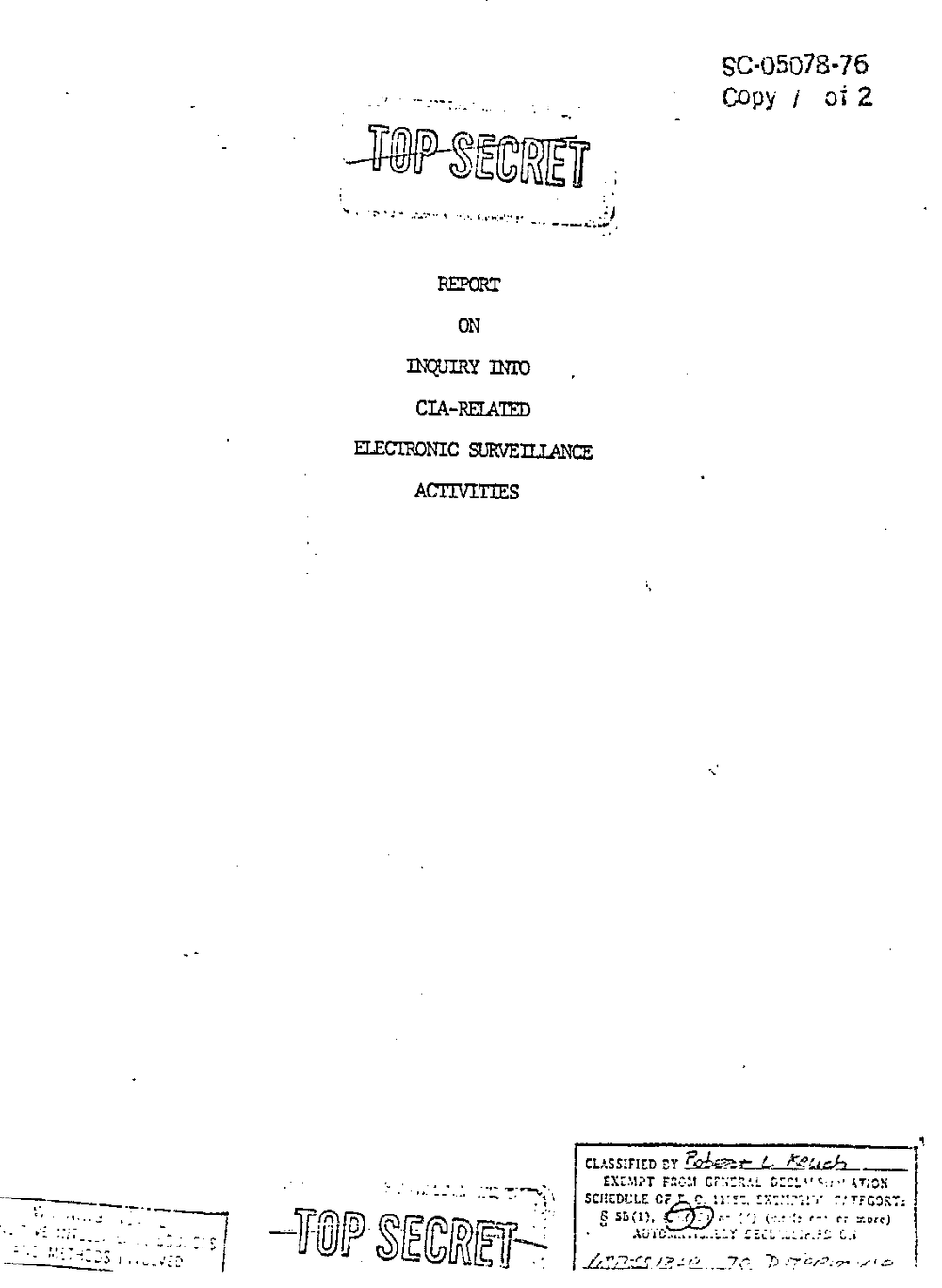
-
v~)l
80-05078-76
Copy of 2.
-,
- - -.. -nu?Lu-I'
REPORT
ON
IRWIRY INIO
CIA-RELATED
ELECTRONIC SUMEMNCE
ACTIVITIES
a?
Exam Fae-:2 cram; max
- 5015013.: 0: c. :175'1. 5142:1123-
?sam.
(-291: r? mare?Hv? 4-
42:14.55 .J w?m
1
-
v~)l
80-05078-76
Copy of 2.
-,
- - -.. -nu?Lu-I'
REPORT
ON
IRWIRY INIO
CIA-RELATED
ELECTRONIC SUMEMNCE
ACTIVITIES
a?
Exam Fae-:2 cram; max
- 5015013.: 0: c. :175'1. 5142:1123-
?sam.
(-291: r? mare?Hv? 4-
42:14.55 .J w?m
1
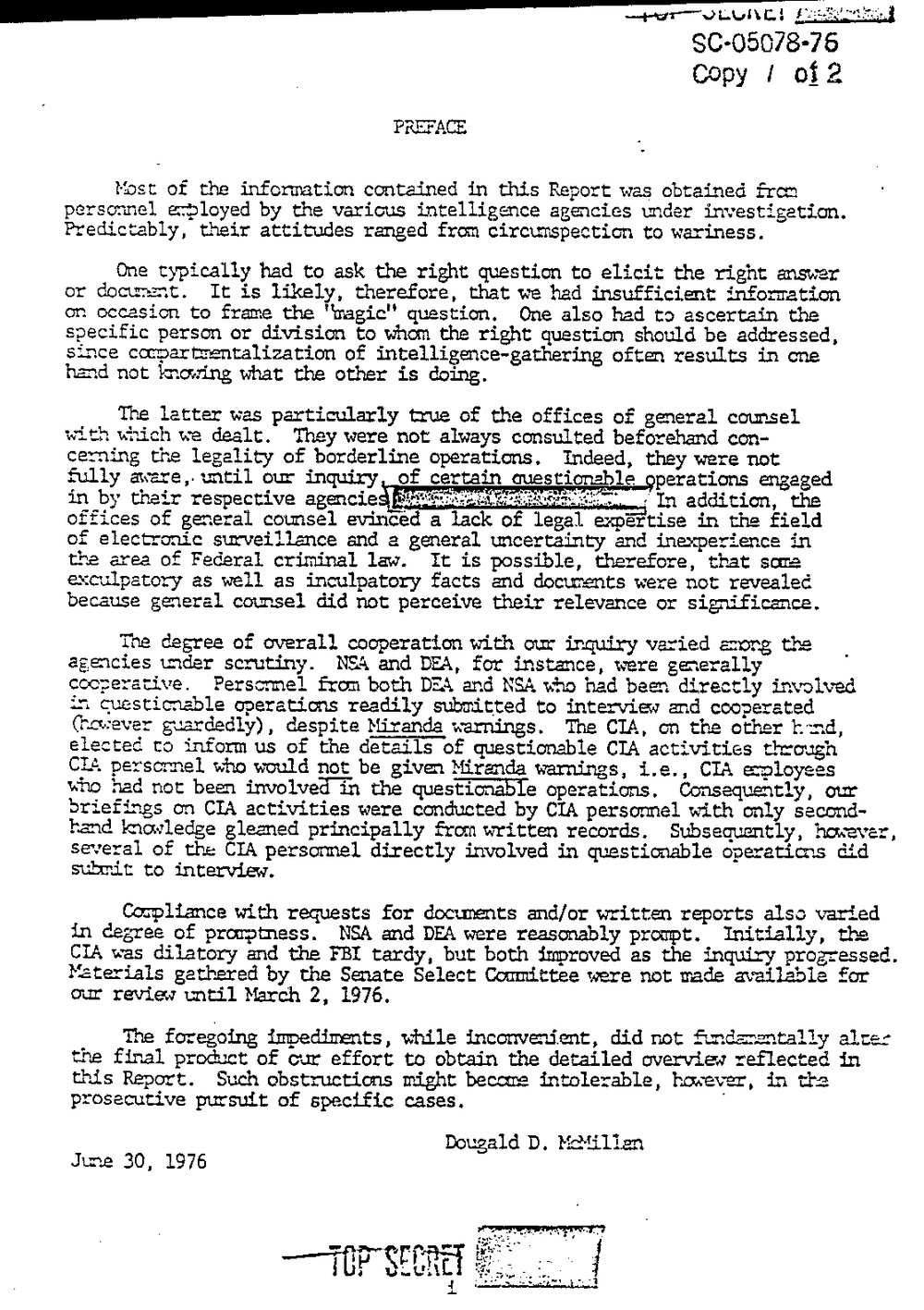
I
80-05078-75
Copy I 032
PREACE
Most of the information contained in this Report was obtained from
personnel ezrployed by the various intelligence agencies under investigation.
Predictably, their attitudes ranged from circurspection to wariness.
One typically had to ask the right question to elicit the right met
or docurent. It is likely, therefore, that we had insufficient information
on occasion to frame the "tragic" question. One also had to ascertain the
specific person or division to whom the right question should be addressed,
since carparmentalization of intelligenceugathering often results in one
hand not knowing what the other is doing.
The latter was particularly true of the offices of general counsel
with which we dealt. They were not always consulted beforehand con-
cerning the legality of borderline Operations. Indeed, they were not
fully aware, until our inquiry of certain questionable perations engaged
in by their respective agencie a;areuse-oat: In addition, the
offices of general counsel evinced a lack of legal expertise in the field
of electronic surveillance and a general mcertainty and inexperience in
the area of Federal criminal law. It is possible, therefore, that some
exculpatory as well as inculpatory facts and docments were not revealed
because general counsel did not perceive their relevance or significmce.
'i?he degree of overall cooperation with our inquiry varied asorg the
agencies under scrutiny. NSA and DEX, for instance, were generally
cooperative. from both DEA and NBA who had been directly involved
in questionable operations readily submitted to interview and coOperated
rat-ever guardedly) despite Miranda warnings. The CIA, on the other
elected to inform us of the details of questionable CIA activities through
CIA personnel who would not be given Miranda warnings, i.e. CIA aployees
who had not been involved?in the quest??bre operations. Consequentl our
briefings on CD. activities were conducted by CIA personnel with only second-
hand knowledge gleaned principally from written records. Subsequently, however,
several of the CIA personnel directly involved in questionable operations did
submit to interview.
Cocpliance with requests for documents and/or written reports also varied
in degree of pronpmess. NSA and DE were reasonably prompt. Initially, the
CIA was dilatory and the FBI tardy, but both improved as the inquiry progressed.
iaterials gathered by the Senate Select Coomittee were not made available for
our review until March 2, 1976.
The foregoing inpadinents, while moonvenient, did not fmdaentally altar
the final product of our effort to obtain the detailed overview reflected in
this Report. Such obstructions might becone intolerable, box-ever, in tire.
prosecutive pursuit of specific cases.
Dougald D. Md-iillm
June 30, 1976
I
80-05078-75
Copy I 032
PREACE
Most of the information contained in this Report was obtained from
personnel ezrployed by the various intelligence agencies under investigation.
Predictably, their attitudes ranged from circurspection to wariness.
One typically had to ask the right question to elicit the right met
or docurent. It is likely, therefore, that we had insufficient information
on occasion to frame the "tragic" question. One also had to ascertain the
specific person or division to whom the right question should be addressed,
since carparmentalization of intelligenceugathering often results in one
hand not knowing what the other is doing.
The latter was particularly true of the offices of general counsel
with which we dealt. They were not always consulted beforehand con-
cerning the legality of borderline Operations. Indeed, they were not
fully aware, until our inquiry of certain questionable perations engaged
in by their respective agencie a;areuse-oat: In addition, the
offices of general counsel evinced a lack of legal expertise in the field
of electronic surveillance and a general mcertainty and inexperience in
the area of Federal criminal law. It is possible, therefore, that some
exculpatory as well as inculpatory facts and docments were not revealed
because general counsel did not perceive their relevance or significmce.
'i?he degree of overall cooperation with our inquiry varied asorg the
agencies under scrutiny. NSA and DEX, for instance, were generally
cooperative. from both DEA and NBA who had been directly involved
in questionable operations readily submitted to interview and coOperated
rat-ever guardedly) despite Miranda warnings. The CIA, on the other
elected to inform us of the details of questionable CIA activities through
CIA personnel who would not be given Miranda warnings, i.e. CIA aployees
who had not been involved?in the quest??bre operations. Consequentl our
briefings on CD. activities were conducted by CIA personnel with only second-
hand knowledge gleaned principally from written records. Subsequently, however,
several of the CIA personnel directly involved in questionable operations did
submit to interview.
Cocpliance with requests for documents and/or written reports also varied
in degree of pronpmess. NSA and DE were reasonably prompt. Initially, the
CIA was dilatory and the FBI tardy, but both improved as the inquiry progressed.
iaterials gathered by the Senate Select Coomittee were not made available for
our review until March 2, 1976.
The foregoing inpadinents, while moonvenient, did not fmdaentally altar
the final product of our effort to obtain the detailed overview reflected in
this Report. Such obstructions might becone intolerable, box-ever, in tire.
prosecutive pursuit of specific cases.
Dougald D. Md-iillm
June 30, 1976
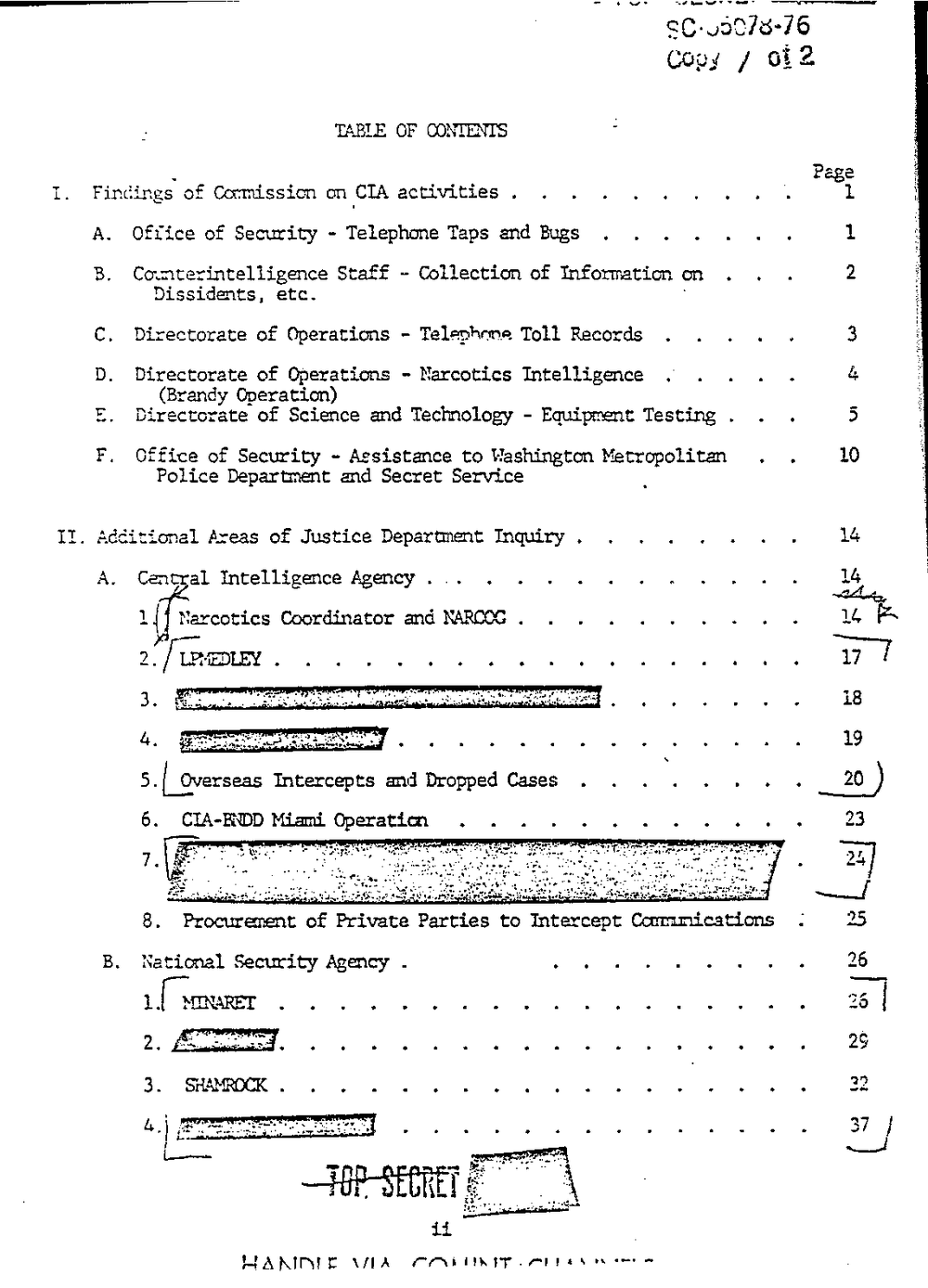
012
new OF mamas
Findings of on CIA activities .
A. Office of Sectrrity - Telephone Taps and Bugs
3. Comterintelligence Staff Collection of Infomation on
Dissidents. etc.
C. Directorate of Operations - Telephone Toll Records
D. Directorate of Operations - Narcotics Intelligence
(Brandy Operation)
75?
Directorate of Science and 'I?ecl?mology - Equiprrent Testing .
F. ffice of Security - Assistance to Washington Metropolitan
Police Department and Secret Service
. Additional Areas of Justice Department Inquiry .
A. Central Intelligence Agency . . .
14 Narcotics Coordinator and mecca . .
. .. . . . - r-rJ - - um?.
7.1? 0_ n,
'1 H. ?r A-n-"Hw 1L 2.3.: at .-- .-..
8. Prmaient of Private Parties to Intercept Cwnmications
B. National Security Agency .
HANHHI VIA quutTJ-nu.
I
012
new OF mamas
Findings of on CIA activities .
A. Office of Sectrrity - Telephone Taps and Bugs
3. Comterintelligence Staff Collection of Infomation on
Dissidents. etc.
C. Directorate of Operations - Telephone Toll Records
D. Directorate of Operations - Narcotics Intelligence
(Brandy Operation)
75?
Directorate of Science and 'I?ecl?mology - Equiprrent Testing .
F. ffice of Security - Assistance to Washington Metropolitan
Police Department and Secret Service
. Additional Areas of Justice Department Inquiry .
A. Central Intelligence Agency . . .
14 Narcotics Coordinator and mecca . .
. .. . . . - r-rJ - - um?.
7.1? 0_ n,
'1 H. ?r A-n-"Hw 1L 2.3.: at .-- .-..
8. Prmaient of Private Parties to Intercept Cwnmications
B. National Security Agency .
HANHHI VIA quutTJ-nu.
I
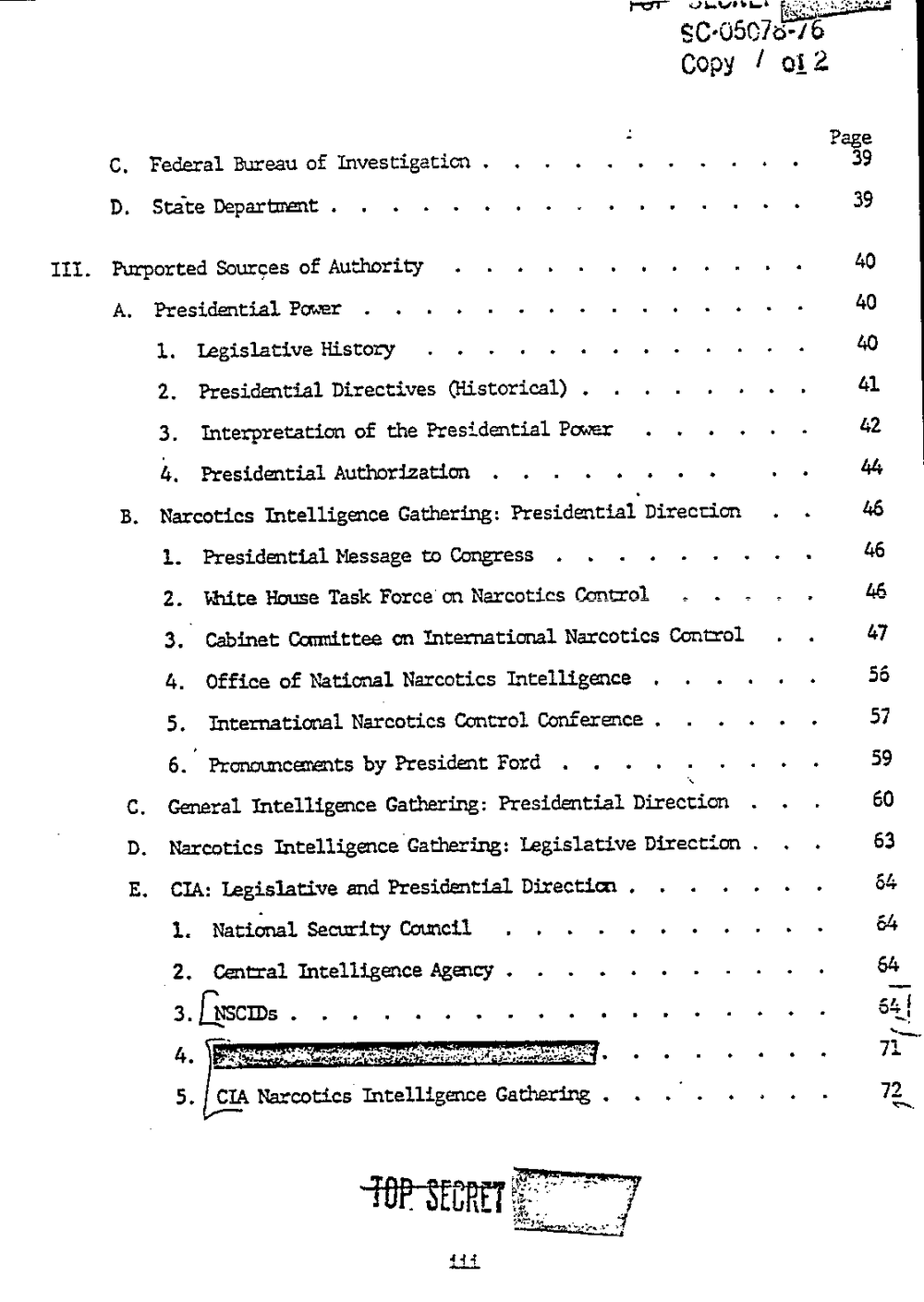
C. Federal Bureau of Investigation .
D. State Deparmmt .
Exported Sources of Authority
A. Presidential Power
1.
2.
3.
2..
WT. .
3005075326
COpy 01 2.
?age
39
40
legislative History . . . . . . . . . . . . . 40
Presidential Directives (HistoricalInterpretation of the Presidential Power . . . . . . 42
Presidential Authorization . . . . . . . . . 44
B. Narcotics Intelligence Gathering: Presidential. Direction . . 1:5
1. Presidential Message to Congress . . . . . . . . . 46
2. Waite House Task Force on Narcotics Control . . ?16
3. Cabinet Committee on International Narcotics Control . . 47
4 Office of National Narcotics Intelligence . . . . . . 56
5 International Narcotics Control Conference . . . . . . 57
6.. Pronomcenents by President Ford . . . . . . . . . 59
C. General Intelligence Gathering: Presidential Direction . . . 60
D. Narcotics Intelligmcelcathering: legislative Direction . . . 63
E. CIA: legislative and Presidential Directim .
1. National Security Council
2. Central Intelligence Agency .
I I .
C. Federal Bureau of Investigation .
D. State Deparmmt .
Exported Sources of Authority
A. Presidential Power
1.
2.
3.
2..
WT. .
3005075326
COpy 01 2.
?age
39
40
legislative History . . . . . . . . . . . . . 40
Presidential Directives (HistoricalInterpretation of the Presidential Power . . . . . . 42
Presidential Authorization . . . . . . . . . 44
B. Narcotics Intelligence Gathering: Presidential. Direction . . 1:5
1. Presidential Message to Congress . . . . . . . . . 46
2. Waite House Task Force on Narcotics Control . . ?16
3. Cabinet Committee on International Narcotics Control . . 47
4 Office of National Narcotics Intelligence . . . . . . 56
5 International Narcotics Control Conference . . . . . . 57
6.. Pronomcenents by President Ford . . . . . . . . . 59
C. General Intelligence Gathering: Presidential Direction . . . 60
D. Narcotics Intelligmcelcathering: legislative Direction . . . 63
E. CIA: legislative and Presidential Directim .
1. National Security Council
2. Central Intelligence Agency .
I I .
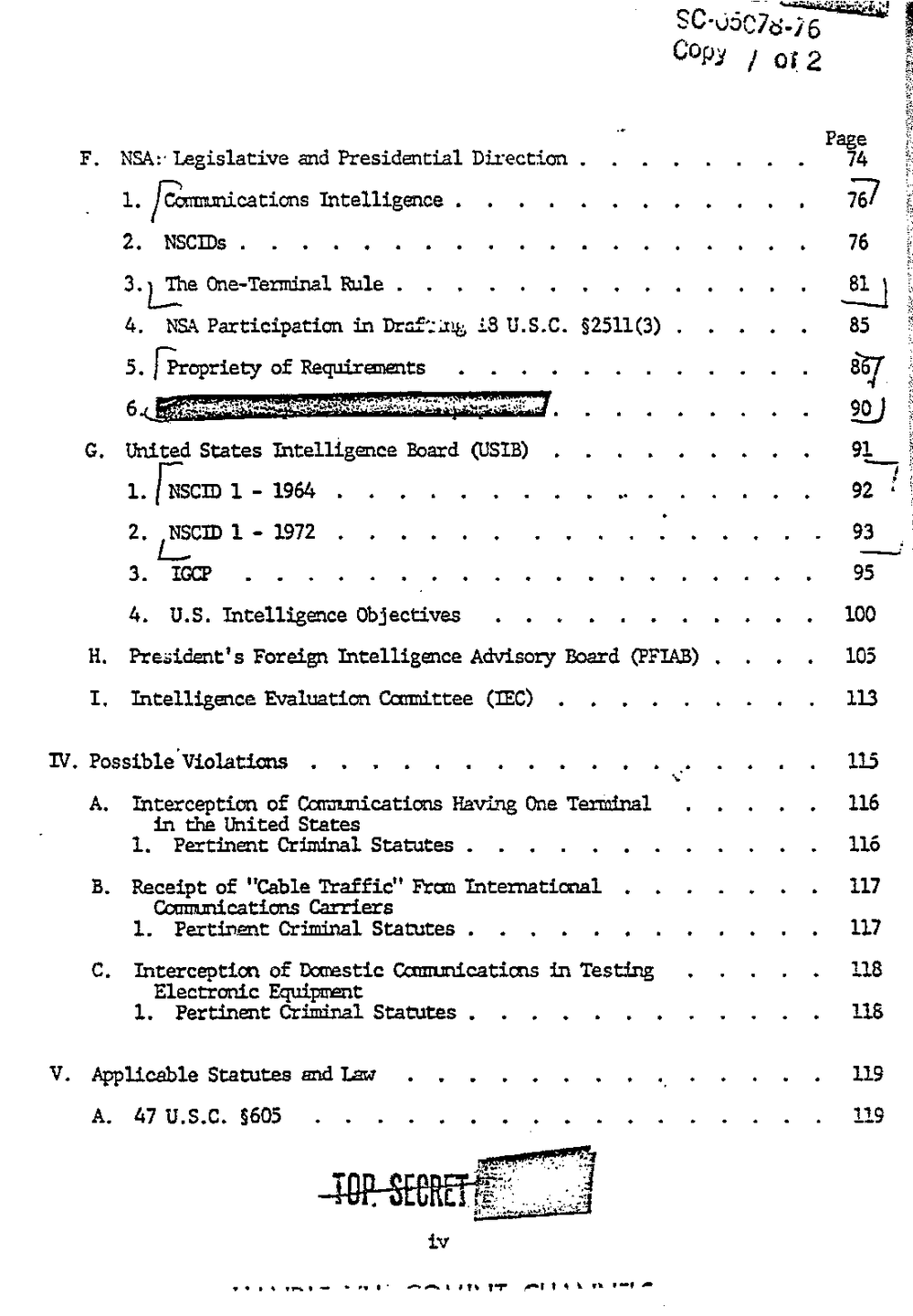
legislative and Presidential Direction .
G.
H.
I.
1. Communications Intelligence .
2. NSCIDs .
3 . Line One-Terminal Rule .
4. NSA Participation in Draftarg i3 U.S.C. ?2511(3) .
5. rPropriety of Requirements
. . ulna-United States mtelligmce Board (USIB)
1. Esau) 1 - 1954
2. NSCID 1 - 1972
L.
3. IGCP .
4. U.S. Intelligence Objectives
President's Foreign Intelligence Advisory Board (PFIAB) .
Intelligmce Evaluation Committee (IEC)
IV. Possible?Violatims
A.
V. Applicable Statutes and law
A.
Interception of Commicatims Hav?mg One Tern?nal
in the United States
1. Pertinent Criminal Statutes .
Receipt of "Cable Traffic" Fran International
Conwrications Carriers
1. Pertinent Criminal Statutes .
Interception of Domestic Cmnmicatims in Testing
Electronic Equipment
1. Pertinent Criminal Statutes .
47 U.S.C. 5605
100
105
113
115
116
116
117
117
118
118
Lew?w.
an .
legislative and Presidential Direction .
G.
H.
I.
1. Communications Intelligence .
2. NSCIDs .
3 . Line One-Terminal Rule .
4. NSA Participation in Draftarg i3 U.S.C. ?2511(3) .
5. rPropriety of Requirements
. . ulna-United States mtelligmce Board (USIB)
1. Esau) 1 - 1954
2. NSCID 1 - 1972
L.
3. IGCP .
4. U.S. Intelligence Objectives
President's Foreign Intelligence Advisory Board (PFIAB) .
Intelligmce Evaluation Committee (IEC)
IV. Possible?Violatims
A.
V. Applicable Statutes and law
A.
Interception of Commicatims Hav?mg One Tern?nal
in the United States
1. Pertinent Criminal Statutes .
Receipt of "Cable Traffic" Fran International
Conwrications Carriers
1. Pertinent Criminal Statutes .
Interception of Domestic Cmnmicatims in Testing
Electronic Equipment
1. Pertinent Criminal Statutes .
47 U.S.C. 5605
100
105
113
115
116
116
117
117
118
118
Lew?w.
an .
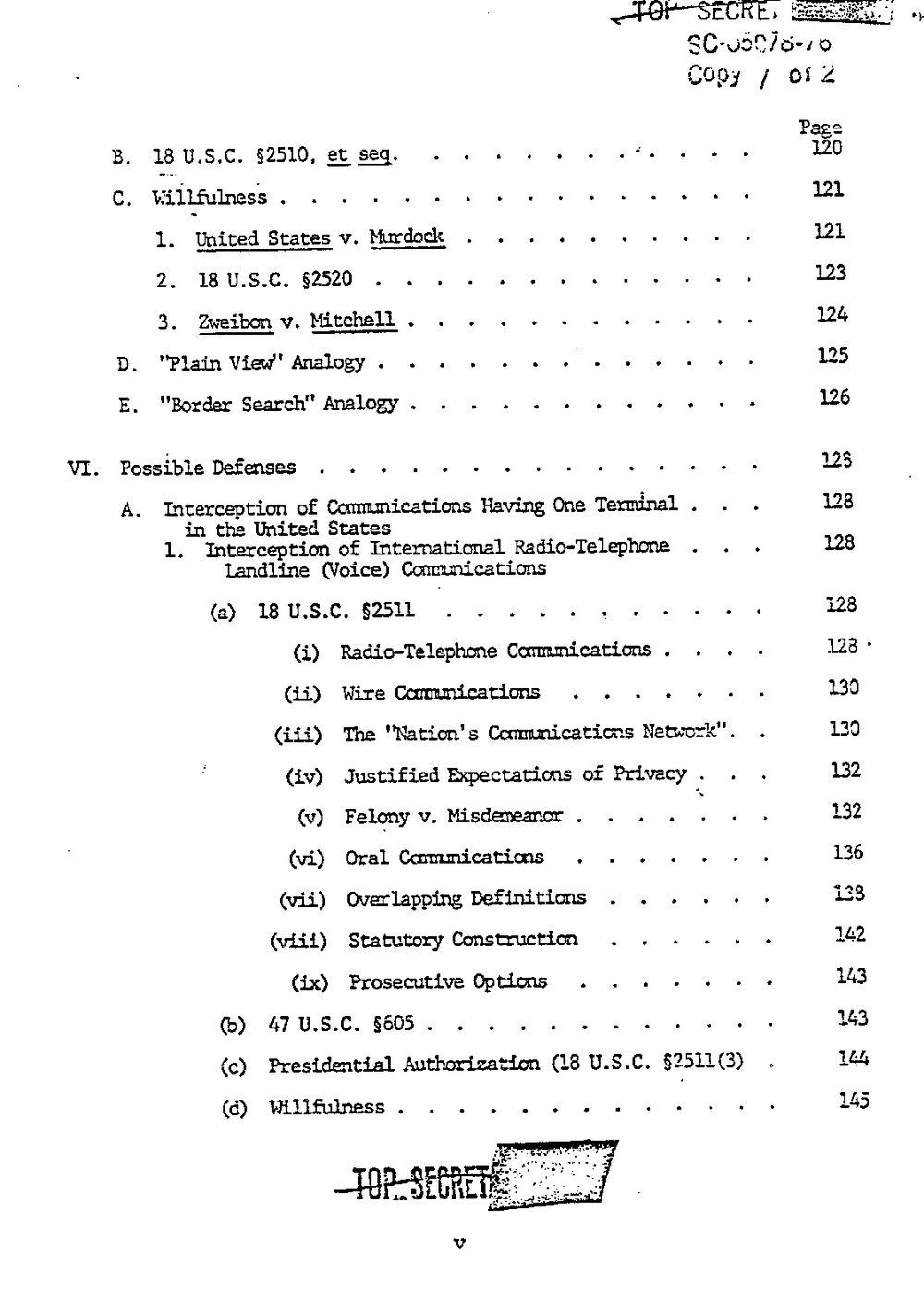
VI.
30'05926-10
Copy 012
B. 18 U.S.C. 52510, 32%.
c. vaiifumes's .
1. United States v. Murdock
2. 18 U.S.C. 52520
3. WV. Mitchell .
D. "Plain View" Analogy .
E. "Border Search" Analogy .
Possible Defenses
A. Interception of Commications Having One Teminal .
in the United States
1. Interception of International Radio-Telephone
landline (Voice) Cmomications
18 U.S.C. ?2511 I
Radio-Telephone .
(ii) Wire Cmumications
The "Nation' 5 Cmmications Network" .
(iv) Justified bcpectations of Privacy -.
Felony v. Misdemeanor .
(vi) Oral
(vii) Ovalapping Definitions
Statutory Construction
(ix) Prosecutive Options
47 U.S.C. 5605 .
Presidential Authorization (18 U.S.C. 52511.0)
Willfulness .
. .?riJ 1'125
128
128?
130
130
VI.
30'05926-10
Copy 012
B. 18 U.S.C. 52510, 32%.
c. vaiifumes's .
1. United States v. Murdock
2. 18 U.S.C. 52520
3. WV. Mitchell .
D. "Plain View" Analogy .
E. "Border Search" Analogy .
Possible Defenses
A. Interception of Commications Having One Teminal .
in the United States
1. Interception of International Radio-Telephone
landline (Voice) Cmomications
18 U.S.C. ?2511 I
Radio-Telephone .
(ii) Wire Cmumications
The "Nation' 5 Cmmications Network" .
(iv) Justified bcpectations of Privacy -.
Felony v. Misdemeanor .
(vi) Oral
(vii) Ovalapping Definitions
Statutory Construction
(ix) Prosecutive Options
47 U.S.C. 5605 .
Presidential Authorization (18 U.S.C. 52511.0)
Willfulness .
. .?riJ 1'125
128
128?
130
130
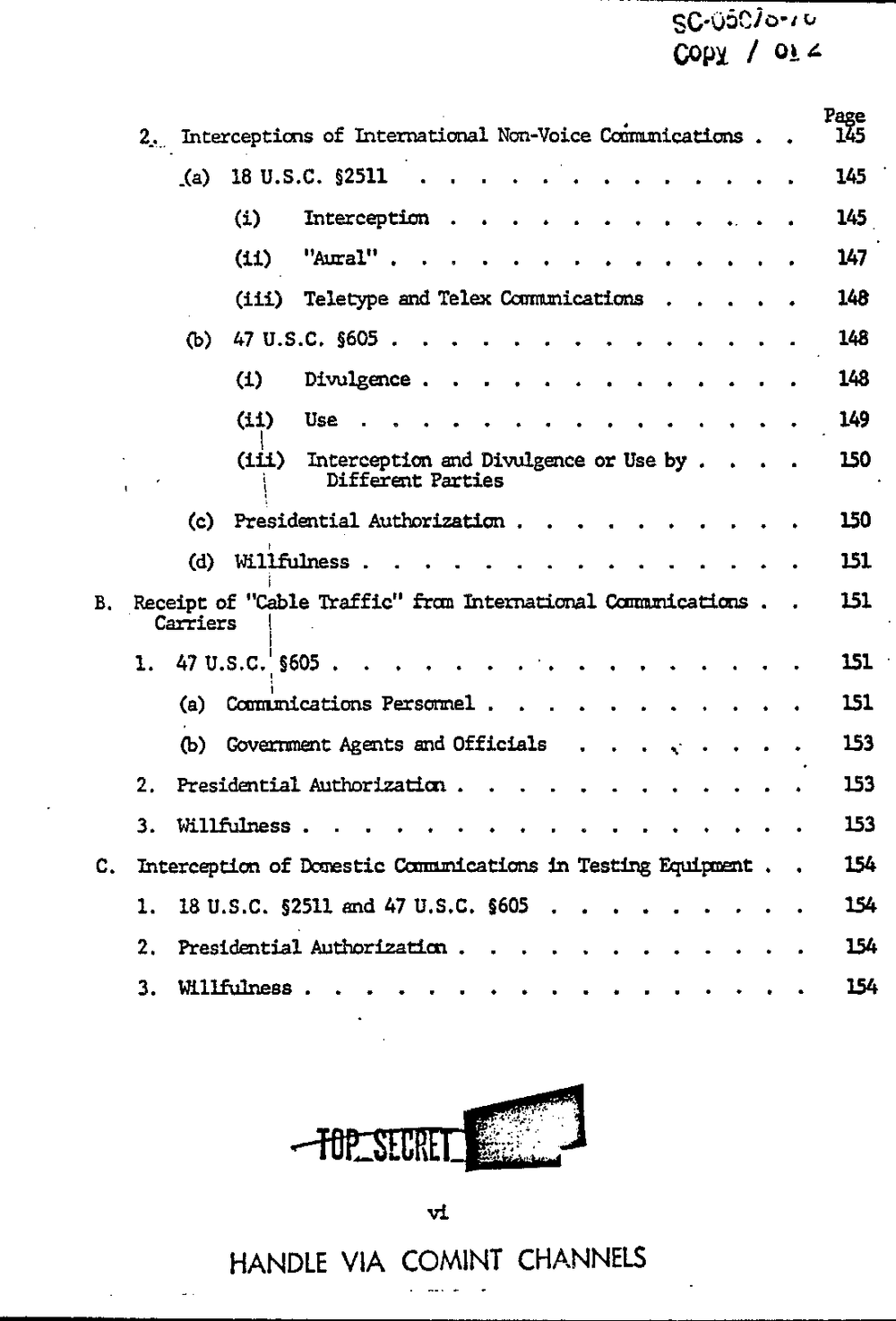
0091 014
Interceptions of International Non-Voice Cc?rmmications . .
13 U.S.C. ?2511 .
Interception . . . . . . . . . .. . . 145.
Teletype and Telex Coommications . . 148
47 U.S.C. ?605 . . . . . . . . . . . . . . 148
Divulgence . . . . . . . . . . . . . I 148
(ii_149
Interception and Divulgence Different Parties .
Presidential Authorization . . . . . . . . . . 150
151
B. Receipt of "Cable Traffic" International Cmmx?cadms . . 151
Carriers I
1.51-
Personnel . . 151
Goverzment Agents and Officials ., 153
2. Presidential Anthorizadcn .
3. Willft?ness .
Interception of Dcmestic Conmmications in Testing mm: . 154
1. 18 U.S.C. 52511. and 47 U.S.C. 5605 . . . . . . . . . 1.54
2. Presidential Authorizaticn . 154
3. Will??ness . . . . 154
HANDLE VIA COMINT CHANNELS
I
0091 014
Interceptions of International Non-Voice Cc?rmmications . .
13 U.S.C. ?2511 .
Interception . . . . . . . . . .. . . 145.
Teletype and Telex Coommications . . 148
47 U.S.C. ?605 . . . . . . . . . . . . . . 148
Divulgence . . . . . . . . . . . . . I 148
(ii_149
Interception and Divulgence Different Parties .
Presidential Authorization . . . . . . . . . . 150
151
B. Receipt of "Cable Traffic" International Cmmx?cadms . . 151
Carriers I
1.51-
Personnel . . 151
Goverzment Agents and Officials ., 153
2. Presidential Anthorizadcn .
3. Willft?ness .
Interception of Dcmestic Conmmications in Testing mm: . 154
1. 18 U.S.C. 52511. and 47 U.S.C. 5605 . . . . . . . . . 1.54
2. Presidential Authorizaticn . 154
3. Will??ness . . . . 154
HANDLE VIA COMINT CHANNELS
I
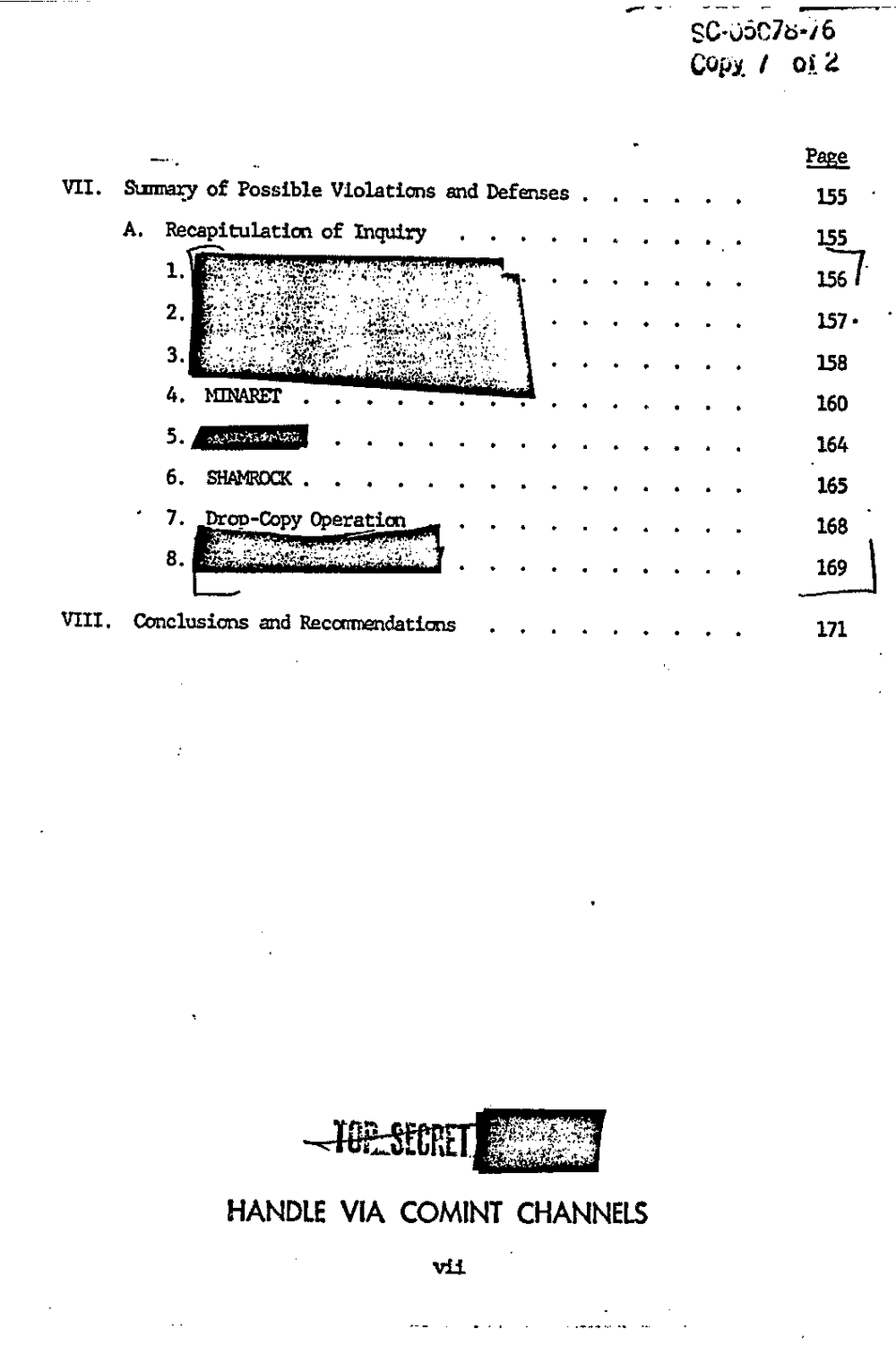
800587546
CC:ij I 05.2
1222
VII. Sumaer of Possible Violations and Defenses . . . . 155
A. RecapitulatimofInquiry . . . . . . . . 155
- .$9.331 .- ?r #572 . -
. 4,152? "Hi-.165
. . . . 168
. . . . . . . 169
Conclusions and Recamendations . . . . . . . . . 171
HANDLE VIA COMINT CHANNELS
v1.1
800587546
CC:ij I 05.2
1222
VII. Sumaer of Possible Violations and Defenses . . . . 155
A. RecapitulatimofInquiry . . . . . . . . 155
- .$9.331 .- ?r #572 . -
. 4,152? "Hi-.165
. . . . 168
. . . . . . . 169
Conclusions and Recamendations . . . . . . . . . 171
HANDLE VIA COMINT CHANNELS
v1.1
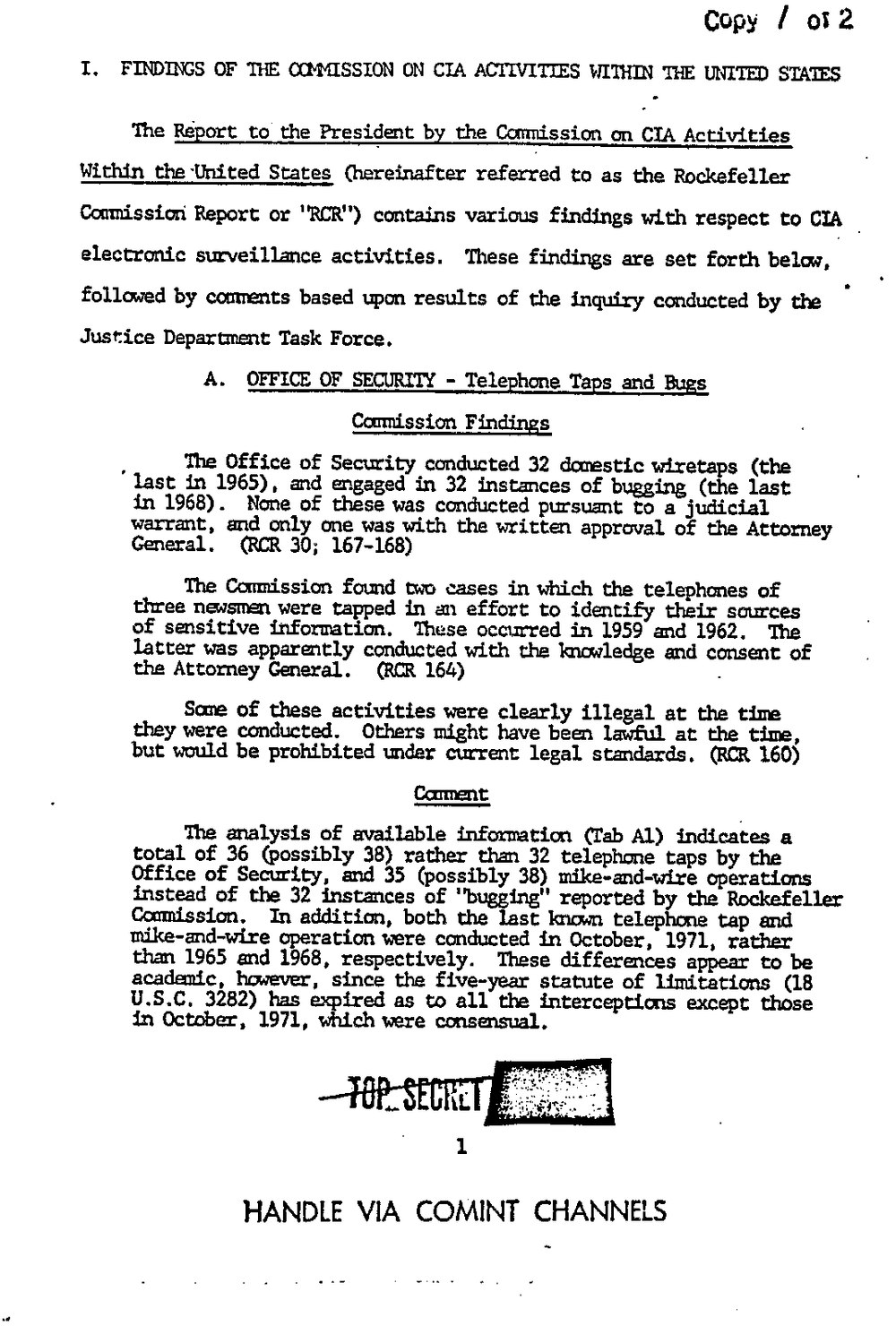
Copy I 01 2
I. FINDINGS OF 0N CIA ACTIVITIES WITHIN THE UNITED STATES
The Report to' the President by the Commission on CIA Activities
Within the?United States (hereinafter referred to as the Rockefeller
Conmission' Report or contains various findings with respect to CIA
electronic surveillance activities. These findings are set forth below. .
followed by comments based upon results of the inquiry conducted by the
Justice Deparmmt Task Force.
A. OFFICE OF SECURITY - Telephone Taps and Bugs
Commission Findings
. The Office of Security conducted 32 domestic wiretaps (the
last in 1965). and engaged in 32 of bugging (the last
in 1968). None of these was conducted pursuant to a judicial
warrant, and only one was with the written approval of the Attorney
General. (RCR 30; 167-168)
The Commission found two cases in which the telephones of
three newsmen were tapped in an effort to idemtify their sources
of sensitive information. These occurred in 1959 and 1962. The
latter was apparently conducted with the knowledge and consent of
the Attorney General. (RCR 164) .
Some of these activities were clearly illegal at the time
they were conducted. Others might have been lawft?. at the time,
but would be prohibited under current legal standards. (RCR 160)
Garment
The analysis of available informtim (Tab Al) indicates a
total of 36 (possibly 38) rather than 32 telephone taps by the
Office of Security. and 35 (possibly 38) mike-and-wire operations
instead of the 32 instances of "bugging" reported by the Rockefeller
Commission. In addition, both the last Imam telephone tap and
mike-and-wire operation were conducted in October, 1971. rather
than 1965 and 1968, respectively. These differences appear to be
academic, however, since the five-year statute of limitations (18
U.S.C. 3282) has expired as to all the interceptions except those
in October, 1971, which were cmsensual.
HANDLE VIA COMINT CHANNELS
Copy I 01 2
I. FINDINGS OF 0N CIA ACTIVITIES WITHIN THE UNITED STATES
The Report to' the President by the Commission on CIA Activities
Within the?United States (hereinafter referred to as the Rockefeller
Conmission' Report or contains various findings with respect to CIA
electronic surveillance activities. These findings are set forth below. .
followed by comments based upon results of the inquiry conducted by the
Justice Deparmmt Task Force.
A. OFFICE OF SECURITY - Telephone Taps and Bugs
Commission Findings
. The Office of Security conducted 32 domestic wiretaps (the
last in 1965). and engaged in 32 of bugging (the last
in 1968). None of these was conducted pursuant to a judicial
warrant, and only one was with the written approval of the Attorney
General. (RCR 30; 167-168)
The Commission found two cases in which the telephones of
three newsmen were tapped in an effort to idemtify their sources
of sensitive information. These occurred in 1959 and 1962. The
latter was apparently conducted with the knowledge and consent of
the Attorney General. (RCR 164) .
Some of these activities were clearly illegal at the time
they were conducted. Others might have been lawft?. at the time,
but would be prohibited under current legal standards. (RCR 160)
Garment
The analysis of available informtim (Tab Al) indicates a
total of 36 (possibly 38) rather than 32 telephone taps by the
Office of Security. and 35 (possibly 38) mike-and-wire operations
instead of the 32 instances of "bugging" reported by the Rockefeller
Commission. In addition, both the last Imam telephone tap and
mike-and-wire operation were conducted in October, 1971. rather
than 1965 and 1968, respectively. These differences appear to be
academic, however, since the five-year statute of limitations (18
U.S.C. 3282) has expired as to all the interceptions except those
in October, 1971, which were cmsensual.
HANDLE VIA COMINT CHANNELS
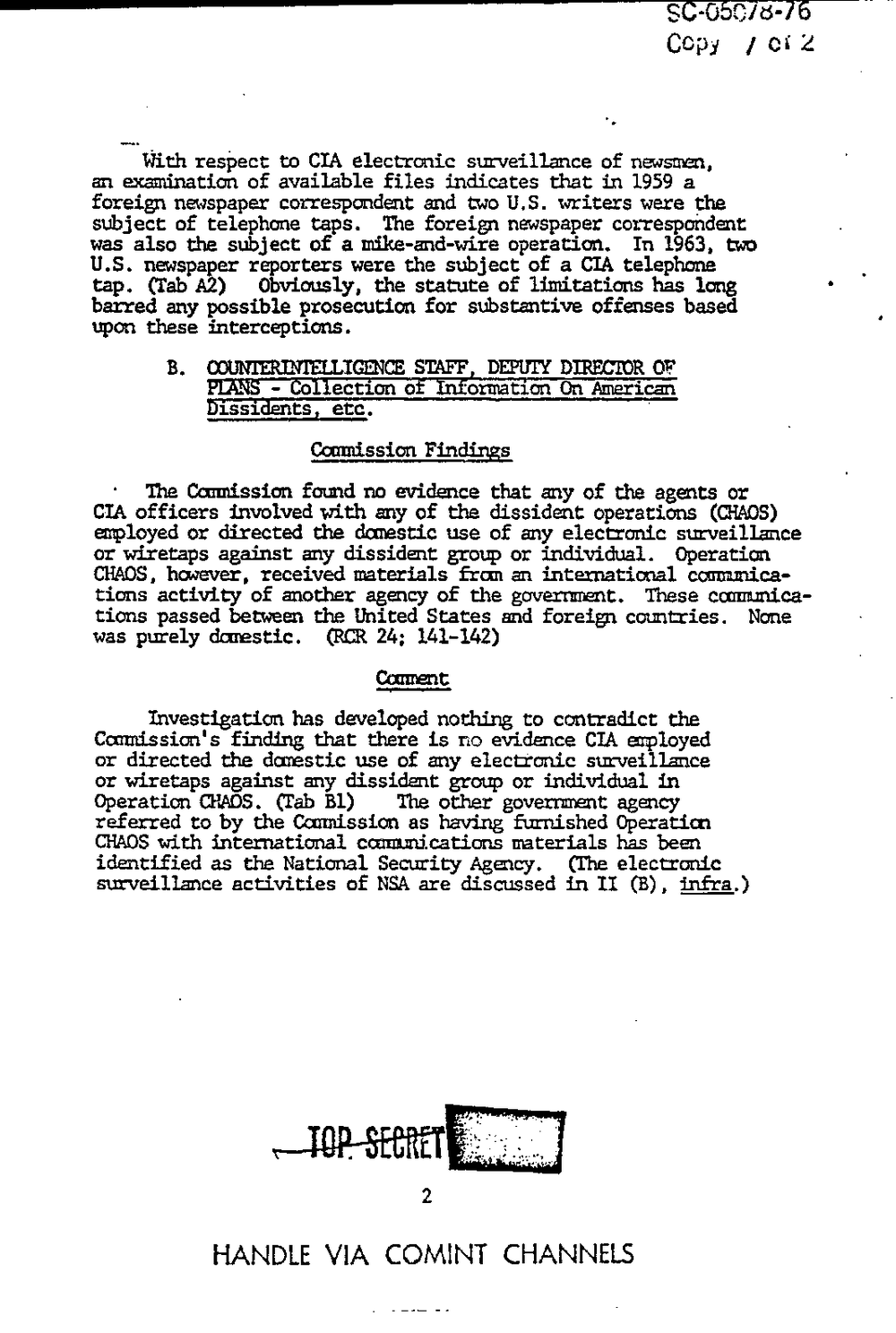
-0 53-15-
c: 2
With respect to CIA electronic surveillance of newsman,
an exas?mtion of available files indicates that in 1959 a
foreign newspaper correspondent and two U.S. writers were the
subject: of telephone taps. The foreign newspaper correspondent
was also the subject of a mike-and-wire operation. In 1963, two
U.S. neWSpaper reporters were the subject of a CIA telephone
tap. (Tab A2) Obviously, the statute of limitations has long
barred any possible prosecution for substantive offenses based
upon these interceptions.
B. WINE STAFF, DEPUTY DIRIKTIDR 0F
PINS Collection of Information On American
Dissidents, etc.
Coumission Findings
The Commission found no evidence that any of the agents or
CIA officers involved with any of the dissident operations (CHAOS)
employed or directed the domestic use of any electronic surveillance
or wiretaps against any dissident group or individual. Operation
CHAOS, hovever, received materials from an international amica-
tions activity of another agency of the government. These cconmica-
tions passed between the United States and foreign countries. None
was purely dcmestic. (RCR 24; 141-142)
Camemt
Investigation has developed nothing to contradict the
Conmissim's finding that there is no evidence CIA eoployed
or directed the domestic use of any electronic smeillance
or wiretaps against any dissident group or individual in
Operation CHAOS. (Tab Bl) The other government agency
referred to by the Commission as having furnished Operaticn
CHAOS with international ccommitatims materials has haen
idmtified as the National Security Agency. (The electronic
smveillance activities of NSA are discussed in II (B), infra.)
HANDLE VIA COMINT CHANNELS
-0 53-15-
c: 2
With respect to CIA electronic surveillance of newsman,
an exas?mtion of available files indicates that in 1959 a
foreign newspaper correspondent and two U.S. writers were the
subject: of telephone taps. The foreign newspaper correspondent
was also the subject of a mike-and-wire operation. In 1963, two
U.S. neWSpaper reporters were the subject of a CIA telephone
tap. (Tab A2) Obviously, the statute of limitations has long
barred any possible prosecution for substantive offenses based
upon these interceptions.
B. WINE STAFF, DEPUTY DIRIKTIDR 0F
PINS Collection of Information On American
Dissidents, etc.
Coumission Findings
The Commission found no evidence that any of the agents or
CIA officers involved with any of the dissident operations (CHAOS)
employed or directed the domestic use of any electronic surveillance
or wiretaps against any dissident group or individual. Operation
CHAOS, hovever, received materials from an international amica-
tions activity of another agency of the government. These cconmica-
tions passed between the United States and foreign countries. None
was purely dcmestic. (RCR 24; 141-142)
Camemt
Investigation has developed nothing to contradict the
Conmissim's finding that there is no evidence CIA eoployed
or directed the domestic use of any electronic smeillance
or wiretaps against any dissident group or individual in
Operation CHAOS. (Tab Bl) The other government agency
referred to by the Commission as having furnished Operaticn
CHAOS with international ccommitatims materials has haen
idmtified as the National Security Agency. (The electronic
smveillance activities of NSA are discussed in II (B), infra.)
HANDLE VIA COMINT CHANNELS
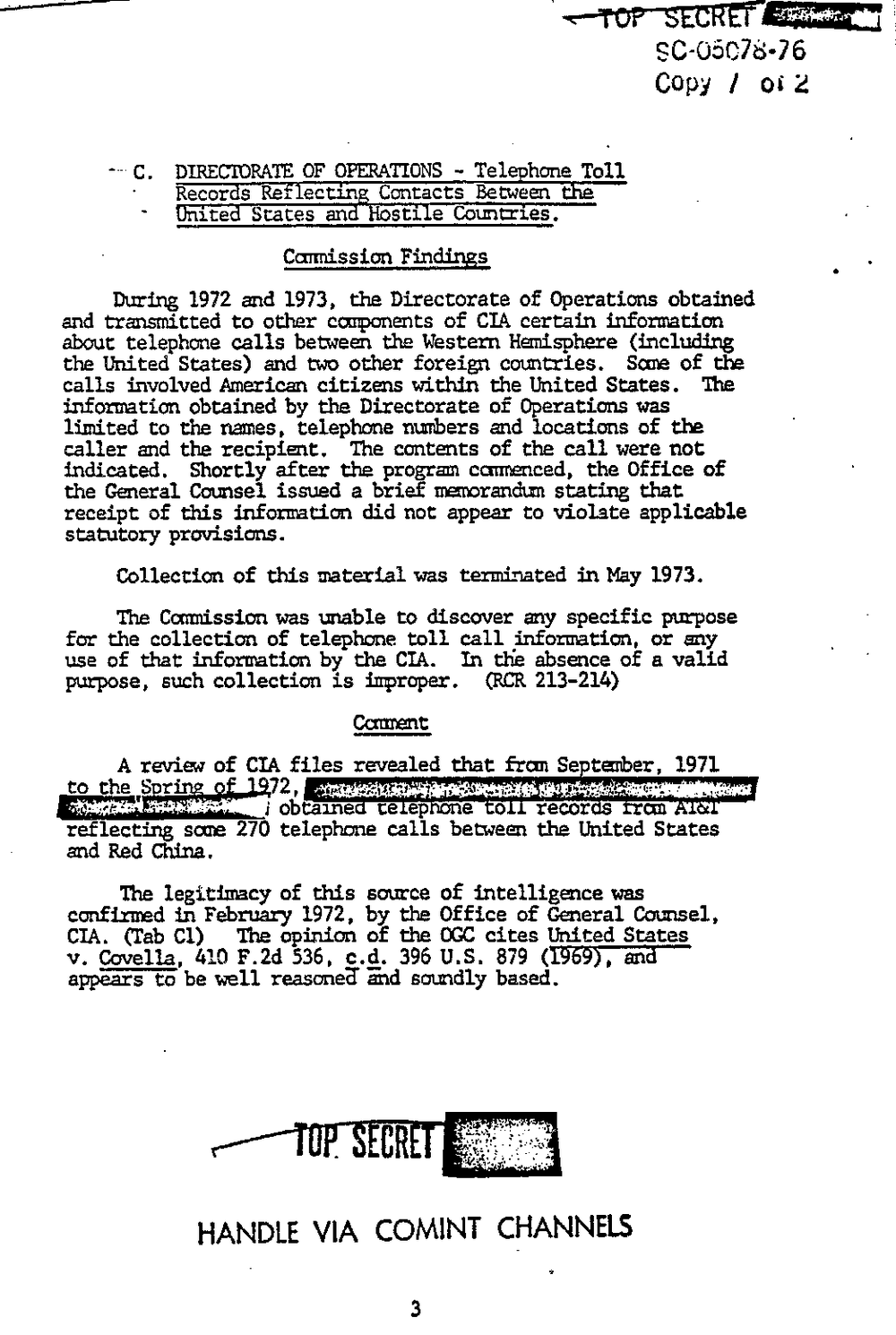
80-05073-76
Copy I 0:2
C. DIRECIORATE OF OPERATIONS - Telephone Toll
Records Reflecting Contacts Between the
United States and Hostile Countries.
Commission Findings
During 1972 and 1973. the Directorate of Operations obtained
and transmitted to other components of CIA certain information
about telephone calls between the Western Hemisphere (including
the United States) and two other foreign countries. Sane of the
calls involved American citizens within the United States. The
information obtained by the Directorate of Operations was
limited to the names, telephone numbers and locations of the
caller and the recipient. The contents of the call were not
indicated. Shortly after the program ccnmenced, the Office of
the Gmeral Counsel issued a brief namrandtm stating that
receipt of this information did not appear to violate applicable
statutory provisions.
Collection of this material was terminated in May 1973.
The Commission was unable to discover any specific pmpose
for the collection of telephone toll call information, or any
use of that information by the CIA. In the absence of a valid
purpose. such collection is improper. CRCR 213-214)
Cammt
A review of CIA file 1971
to the 'Sorreflecting some 270 telephone call between the united States
and Red China.
The legitimacy of this source of intelligence was
confirmed in February 1972, by the Office of General Cmmsel,
CIA. (Tab Cl) The opinion of the OGC cites United States
v. Covella, 410 F.2d 536, cg. 396 U.S. 879 (13595, and
appears to be well reasoned and soundly based.
HANDLE VIA COMINT CHANNELS
3
80-05073-76
Copy I 0:2
C. DIRECIORATE OF OPERATIONS - Telephone Toll
Records Reflecting Contacts Between the
United States and Hostile Countries.
Commission Findings
During 1972 and 1973. the Directorate of Operations obtained
and transmitted to other components of CIA certain information
about telephone calls between the Western Hemisphere (including
the United States) and two other foreign countries. Sane of the
calls involved American citizens within the United States. The
information obtained by the Directorate of Operations was
limited to the names, telephone numbers and locations of the
caller and the recipient. The contents of the call were not
indicated. Shortly after the program ccnmenced, the Office of
the Gmeral Counsel issued a brief namrandtm stating that
receipt of this information did not appear to violate applicable
statutory provisions.
Collection of this material was terminated in May 1973.
The Commission was unable to discover any specific pmpose
for the collection of telephone toll call information, or any
use of that information by the CIA. In the absence of a valid
purpose. such collection is improper. CRCR 213-214)
Cammt
A review of CIA file 1971
to the 'Sorreflecting some 270 telephone call between the united States
and Red China.
The legitimacy of this source of intelligence was
confirmed in February 1972, by the Office of General Cmmsel,
CIA. (Tab Cl) The opinion of the OGC cites United States
v. Covella, 410 F.2d 536, cg. 396 U.S. 879 (13595, and
appears to be well reasoned and soundly based.
HANDLE VIA COMINT CHANNELS
3
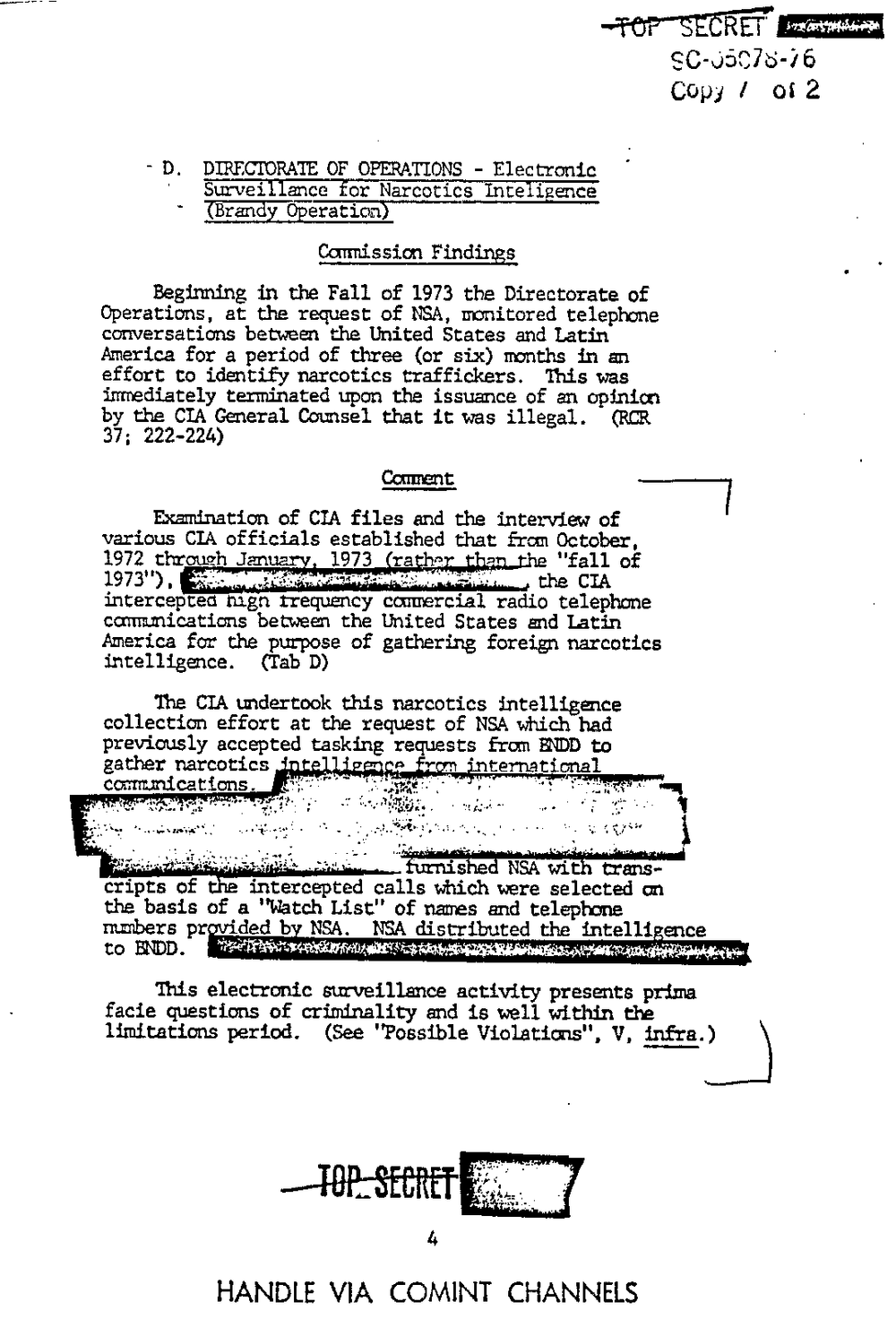
50-05075-26
Cow I as 2
D. DIRECIURATE OF OPERATIONS - Electronic
Surveillance for Narcotics Intelligence
(Brandy Operation)
Conmission Findings
Begirming in the Fall of 1973 the Directorate of
Operations, at the request of NBA, Ironitored telephone
comersations bemeen the United States and Latin
America for a period of three (or six) months in an
effort to identify narcotics traffickers. This was
immediately terminated upon the issuance of an opinion
by the CIA General Counsel that it was illegal. (RCR
37; 222-224)
Garment
Examination of CIA files and the interview of
various CIA officials established that from October,
1972 through Janna "fall of
. . . the cm
intercepted nigh trequency 1 radio telephone
cmnmications between the United States and Latin
America for the purpose of gathering foreign narcotics
intelligence. (Tab D)
The CIA undertook this narcotics intelligence
collection effort at the request of NSA which had
previously accepted tasking requests from BNDD to
gather narcotics .. ternational
cmicationsnew
cripts of intercepted calls which were selected on
the basis of a "Watch List" of names and telephone
numbers pr 'ed NSA. NBA distributed the intelli
to MD. I ?m
ence
.
Tnis electronic surveillance activity presents prima
facie questions of criminality and is well within the
limitations period. (See "Possible Violatims", V, infra.)
HANDLE VIA CHANNELS
50-05075-26
Cow I as 2
D. DIRECIURATE OF OPERATIONS - Electronic
Surveillance for Narcotics Intelligence
(Brandy Operation)
Conmission Findings
Begirming in the Fall of 1973 the Directorate of
Operations, at the request of NBA, Ironitored telephone
comersations bemeen the United States and Latin
America for a period of three (or six) months in an
effort to identify narcotics traffickers. This was
immediately terminated upon the issuance of an opinion
by the CIA General Counsel that it was illegal. (RCR
37; 222-224)
Garment
Examination of CIA files and the interview of
various CIA officials established that from October,
1972 through Janna "fall of
. . . the cm
intercepted nigh trequency 1 radio telephone
cmnmications between the United States and Latin
America for the purpose of gathering foreign narcotics
intelligence. (Tab D)
The CIA undertook this narcotics intelligence
collection effort at the request of NSA which had
previously accepted tasking requests from BNDD to
gather narcotics .. ternational
cmicationsnew
cripts of intercepted calls which were selected on
the basis of a "Watch List" of names and telephone
numbers pr 'ed NSA. NBA distributed the intelli
to MD. I ?m
ence
.
Tnis electronic surveillance activity presents prima
facie questions of criminality and is well within the
limitations period. (See "Possible Violatims", V, infra.)
HANDLE VIA CHANNELS
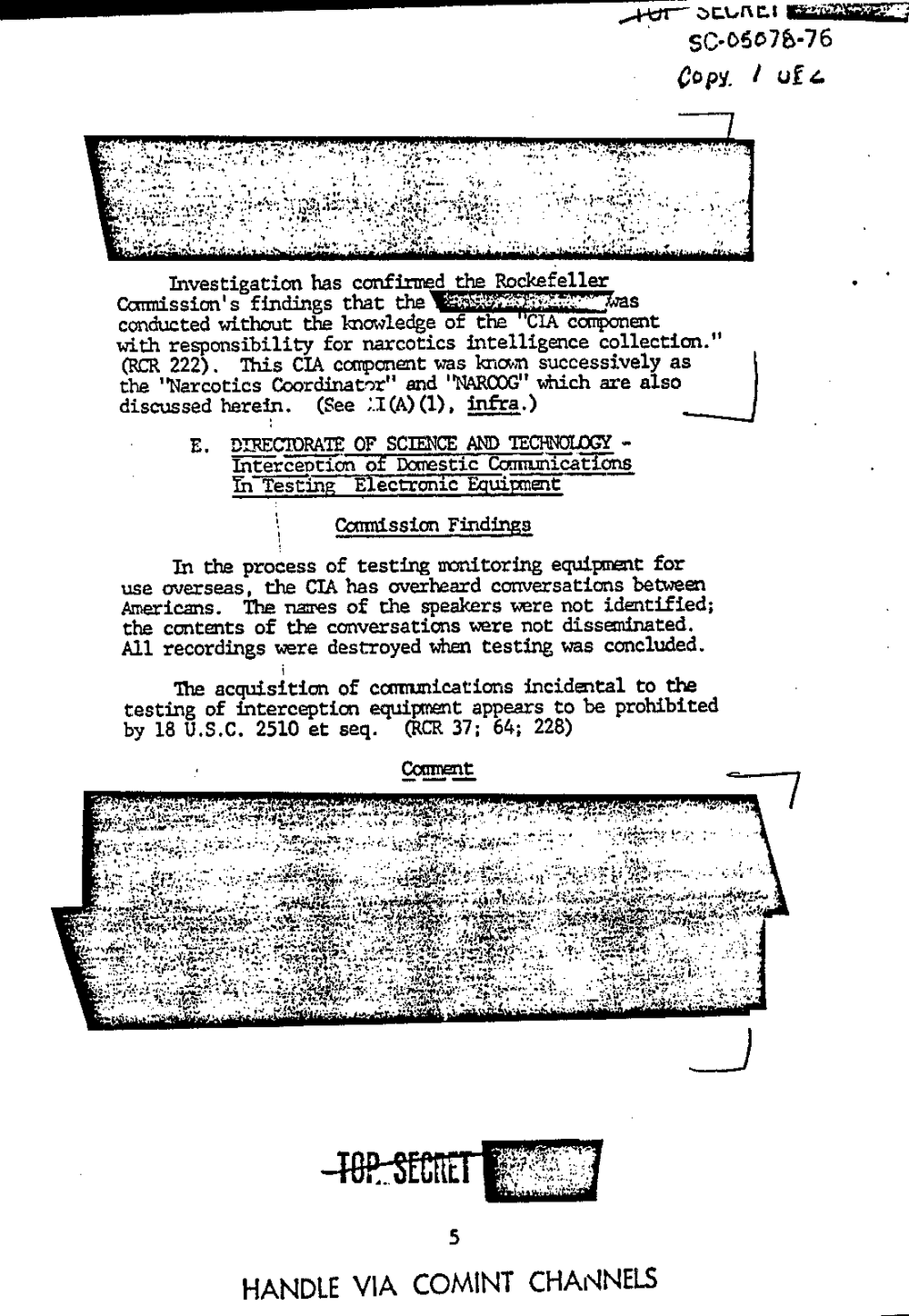
5(3-05078-76
Copy. I Uf?buyer-rm -. r,
Investigation has confined the Rockefeller .
Corrmission's findings that the
conducted without the knowledge of the CIA component
with responsibility for narcotics intelligence collection."
222) . This CIA component was known successively as
the 'Narcotics Coordinator" and which are also
discussed herein. (See (A) (1), infra.)
E. DIRECIDRATE OF SCIENCE AND TECHNOLOGY
Interception of Domestic Conmmications
In Testing Electronic Equipment
Commission Findings
In the process of testing monitoring equipment for
use overseas, the CIA has overheard conversations between
Americans. The names of the speakers were not identified;
the contents of the conversations were not disseminated.
All recordings were destroyed when testing was concluded.
The acquisition of cormunications incidental to the
testing of interception equipment appears to be prohibited
by 18 U.S.C. 2510 et seq. (RCR 37; 64; 228)
.- Comment
. . . .Idh. . 5?1. - .-
.- . . ?mew-rInl- .
ti '1 . . human
Sup,?-
. - - .. -- .
.. -.. -
.4524.1,152 1?
.. . 453.?
- ..
I :ikg-Ei?
.
HANDLE VIA COMINT CHANNELS
5(3-05078-76
Copy. I Uf?buyer-rm -. r,
Investigation has confined the Rockefeller .
Corrmission's findings that the
conducted without the knowledge of the CIA component
with responsibility for narcotics intelligence collection."
222) . This CIA component was known successively as
the 'Narcotics Coordinator" and which are also
discussed herein. (See (A) (1), infra.)
E. DIRECIDRATE OF SCIENCE AND TECHNOLOGY
Interception of Domestic Conmmications
In Testing Electronic Equipment
Commission Findings
In the process of testing monitoring equipment for
use overseas, the CIA has overheard conversations between
Americans. The names of the speakers were not identified;
the contents of the conversations were not disseminated.
All recordings were destroyed when testing was concluded.
The acquisition of cormunications incidental to the
testing of interception equipment appears to be prohibited
by 18 U.S.C. 2510 et seq. (RCR 37; 64; 228)
.- Comment
. . . .Idh. . 5?1. - .-
.- . . ?mew-rInl- .
ti '1 . . human
Sup,?-
. - - .. -- .
.. -.. -
.4524.1,152 1?
.. . 453.?
- ..
I :ikg-Ei?
.
HANDLE VIA COMINT CHANNELS
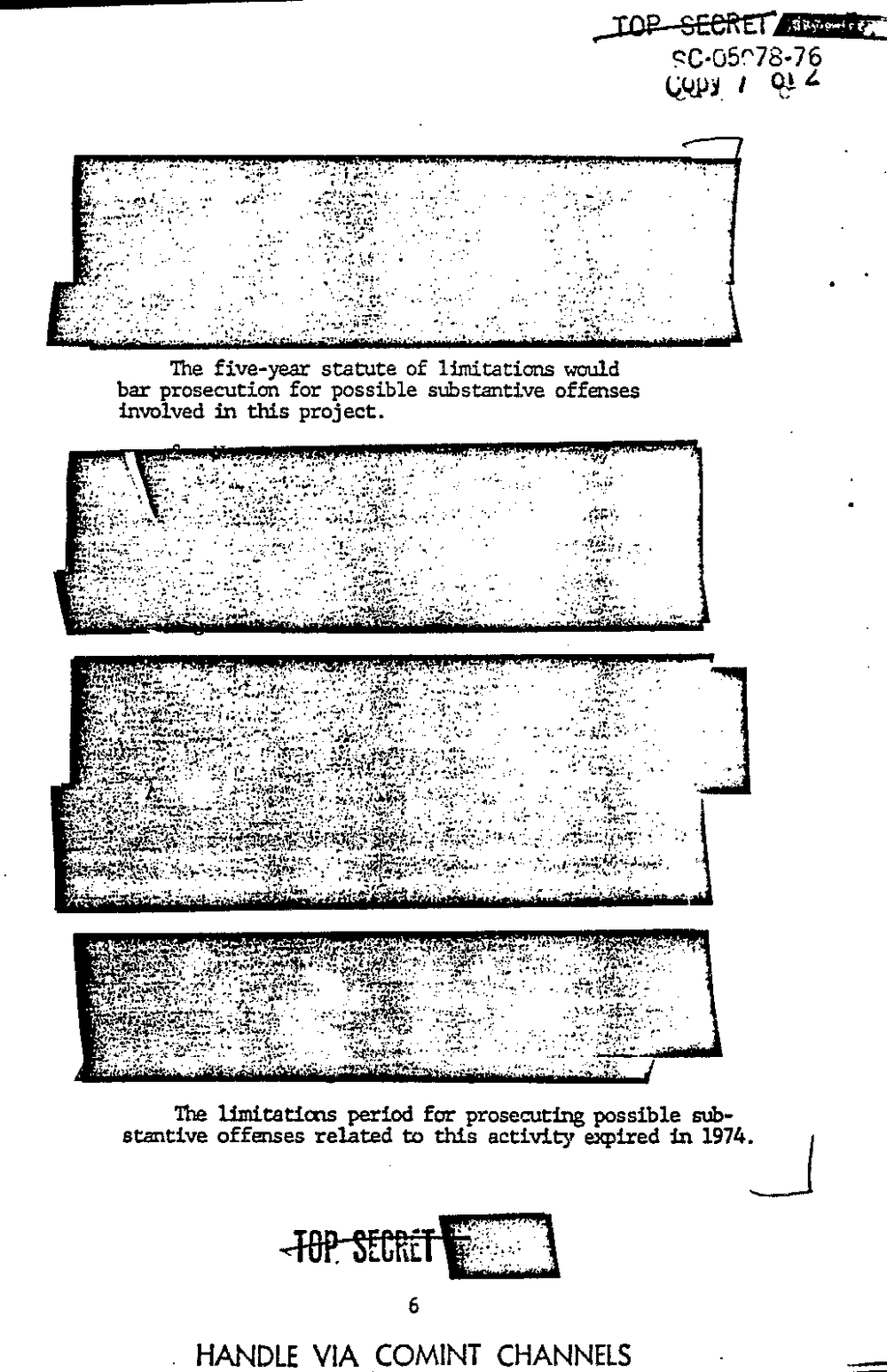
Wm
cc-osm-m
um I 4
The five?year statute of limitations would
bar prosecution for possible substantive offenses
involved in this project(shy. 4 . l' -. - 1:433},
1"?tt?l14?. .
.v'llo 12.35 1' .--.
. 0'
..
gun-Ir},
- 4" 44 .
r4523}:The limitations period for prosecuting possible sub-
stantive offenses related to this activity expired in 1974.
. HANDLE VIA COMINT CHANNELS -
Wm
cc-osm-m
um I 4
The five?year statute of limitations would
bar prosecution for possible substantive offenses
involved in this project(shy. 4 . l' -. - 1:433},
1"?tt?l14?. .
.v'llo 12.35 1' .--.
. 0'
..
gun-Ir},
- 4" 44 .
r4523}:The limitations period for prosecuting possible sub-
stantive offenses related to this activity expired in 1974.
. HANDLE VIA COMINT CHANNELS -
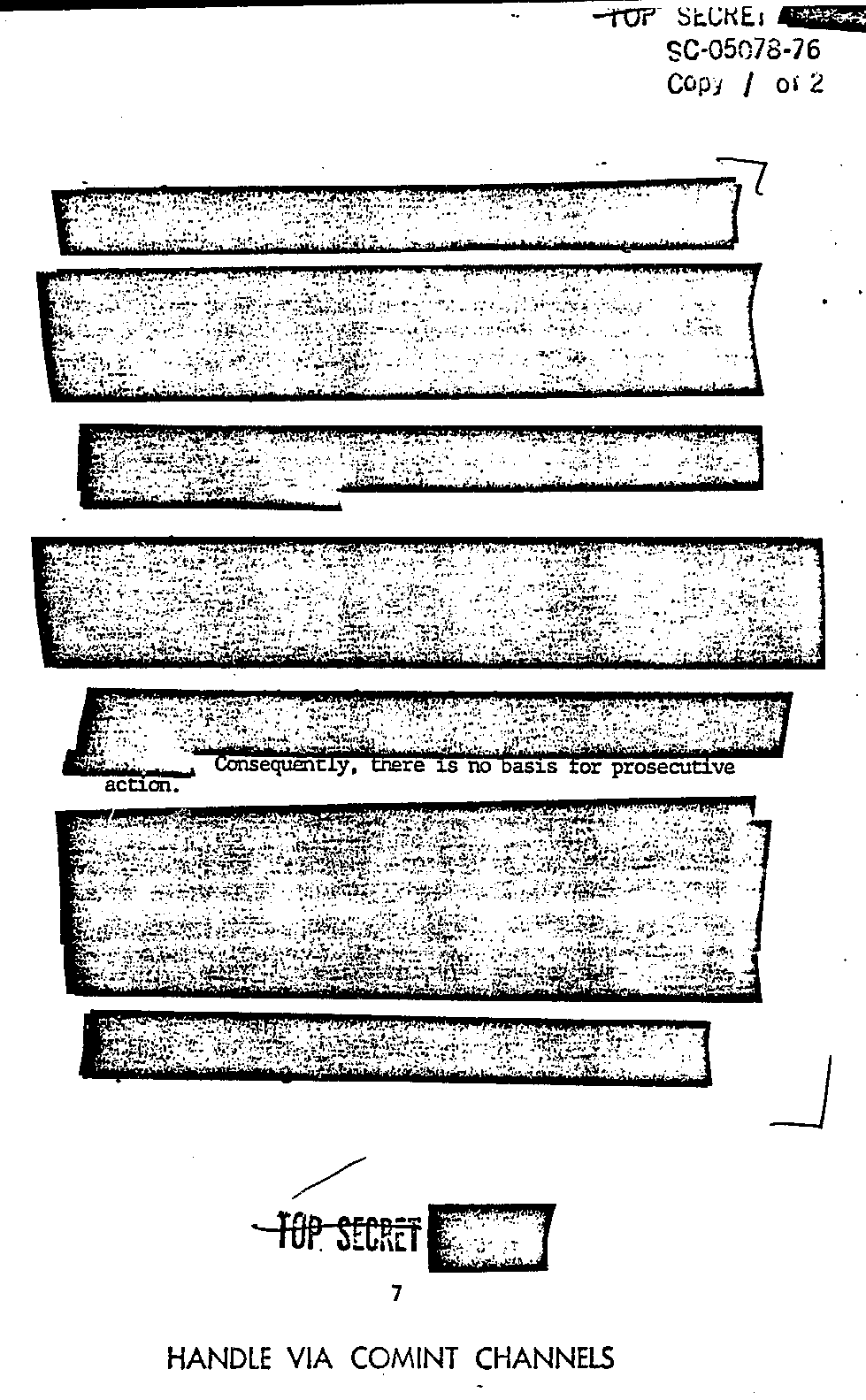
same:
80-05878-gm,? ??gt?tu use-.-. - . rbass or prosecuuve
HANDLE VIA COMINT CHANNELS
same:
80-05878-gm,? ??gt?tu use-.-. - . rbass or prosecuuve
HANDLE VIA COMINT CHANNELS
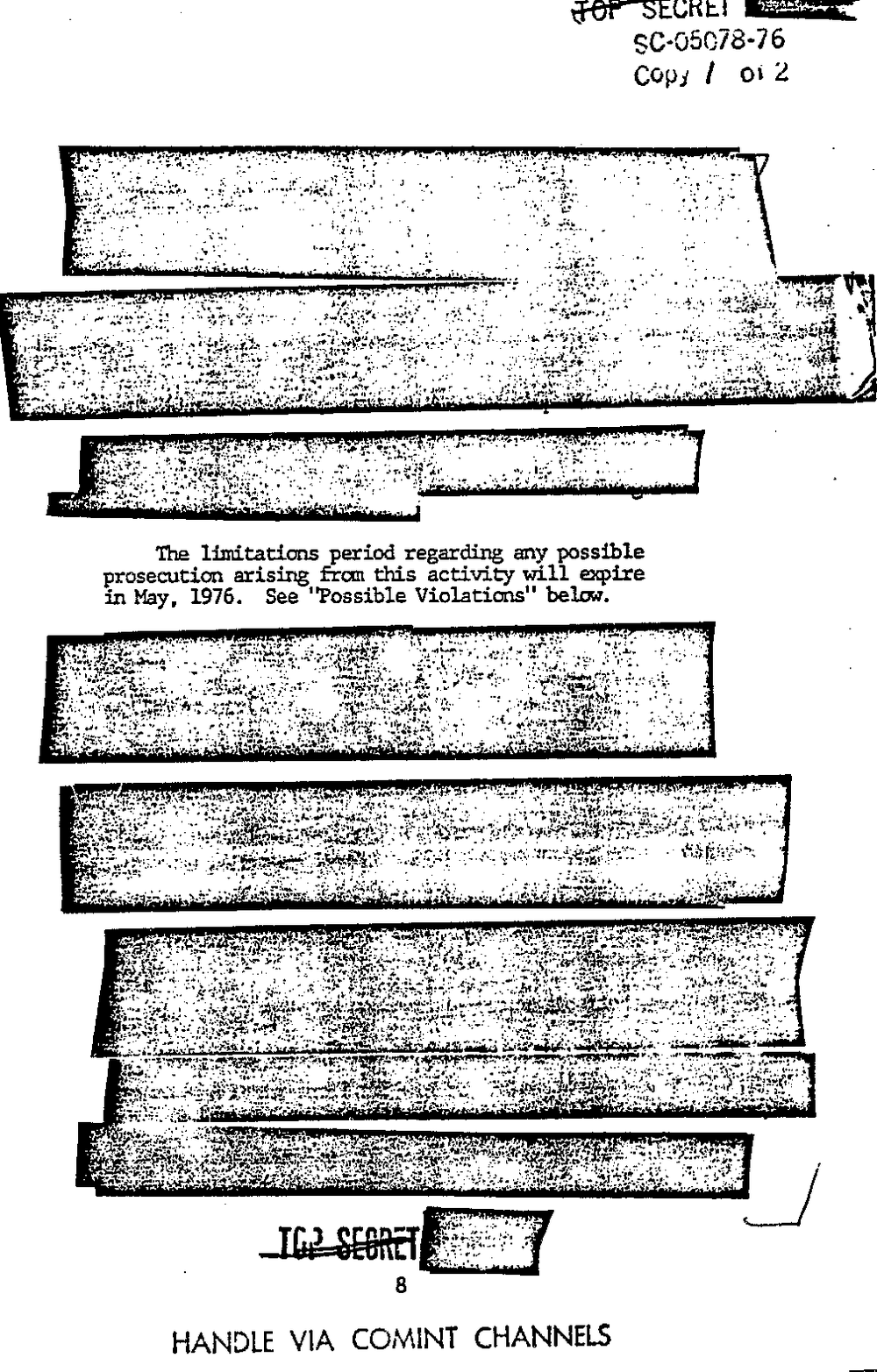
mew-.2
80-05078-(nap . . -
Add) - 14-?
try-?hag.
..-. .?aln
The limitaticns period regarding any possible
prosecution arising from this activity will expire
in May. 1976. See "Possible Violations" below.
. .
..
.
1ft
Iu-n? i.
a. gram-.1.-
.
Au.
:1
HANDLE VIA CHANNELS
mew-.2
80-05078-(nap . . -
Add) - 14-?
try-?hag.
..-. .?aln
The limitaticns period regarding any possible
prosecution arising from this activity will expire
in May. 1976. See "Possible Violations" below.
. .
..
.
1ft
Iu-n? i.
a. gram-.1.-
.
Au.
:1
HANDLE VIA CHANNELS
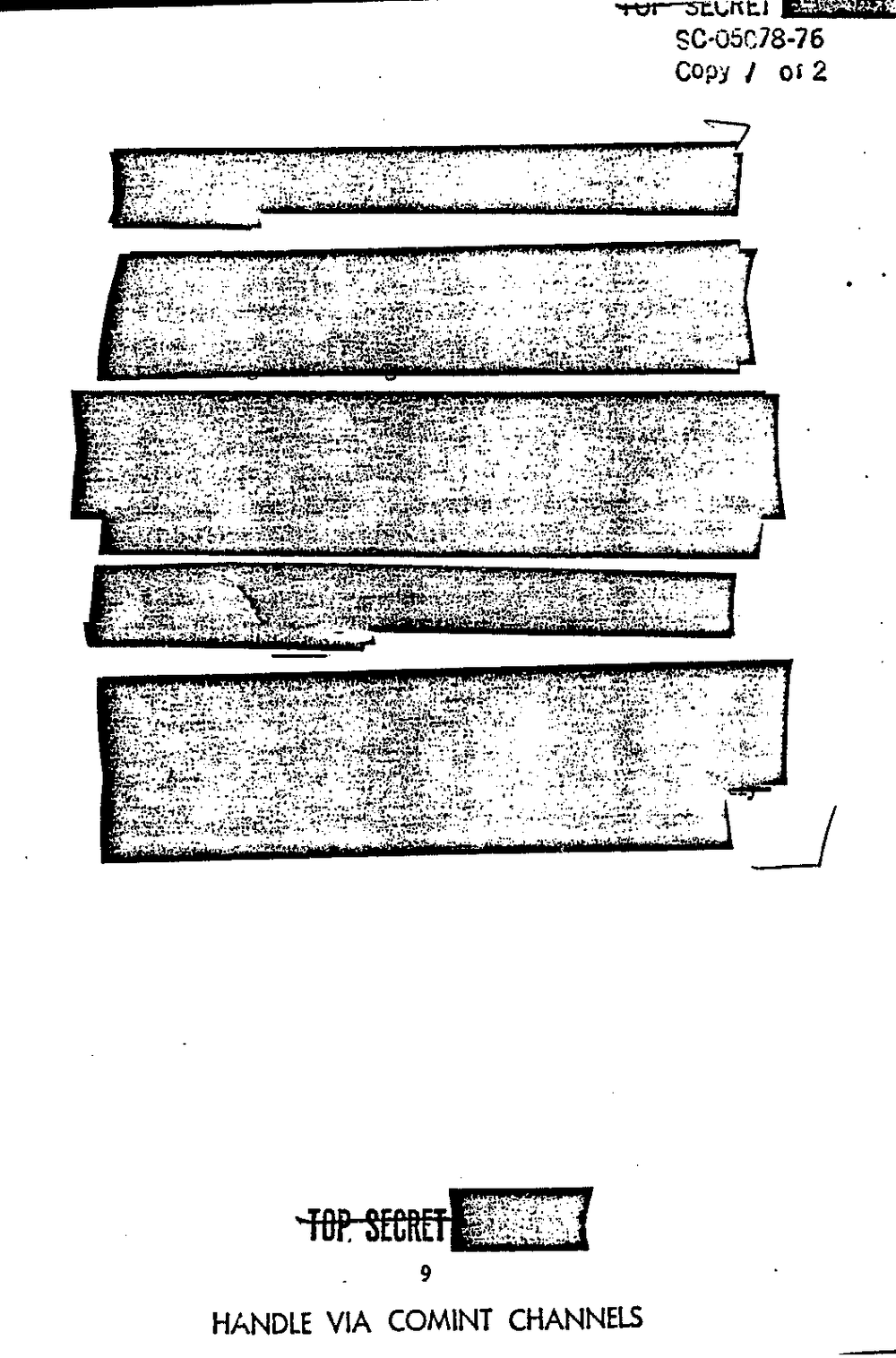
900567846
- COW I or 2
?ii??fultHANDLE VIA COMINT CHANNELS
900567846
- COW I or 2
?ii??fultHANDLE VIA COMINT CHANNELS
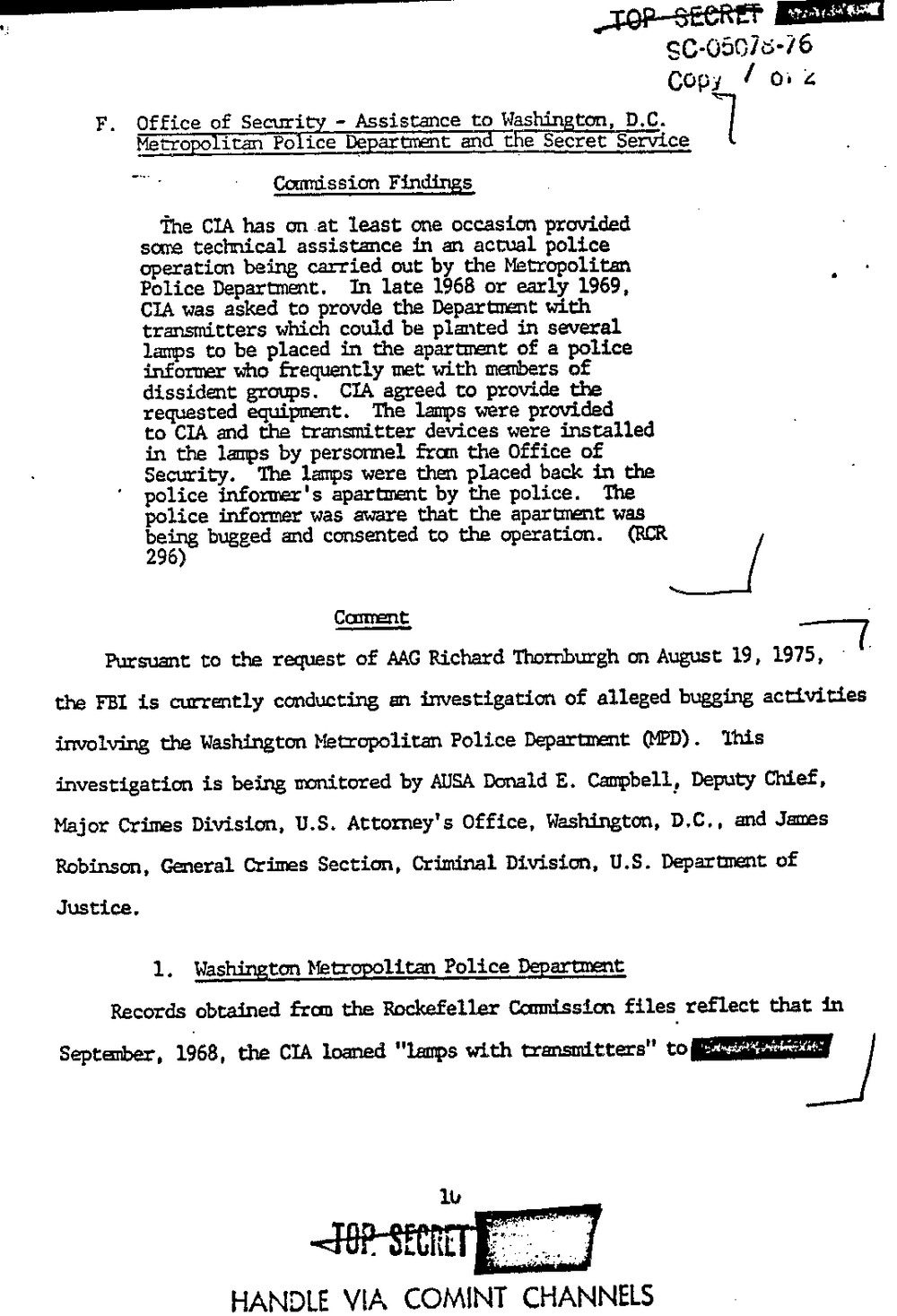
50-05075-76
COW 0" '4
Office of Security - Assistance to Washington, D.C.
Metropolitan Police Department and the Secret Service
Commission Findings
The CIA has on .at least one occasion provided
some technical assistance in an actual police
operation being carried out by the Metropolitan
Police Department. In late 1968 or early 1969.
CIA was asked to provde the Department with
transmitters which could be planted in several
lamps to be placed in the apartment of a police
informer who frequently met with members of
dissident groups. CIA agreed to provide the
requested equipment. The lamps were provided
to CIA and the transmitter devices were installed
in the lamps by personnel from the Office of
Security. The lamps were then placed back in the
police informer's aparmmt by the police. The
police informer was aware that the was
being bugged and consented to the operation. (RCR
296)
Content
Pursuant to the request of AAG Richard Thornburgh on August 19, 197;:7'
the FBI is marently conducting an investigation of alleged bugging activities
involving the Washington Metropolitan Police Department (MPD) . this
investigation is being monitored by AUSA Donald E. Campbell, Deputy Chief,
Major Crimes Division, U.S. Attorney's Office, Washington. D.C., and James
Robinson, General Crimes Section, Criminal Division. U.S. Department of
Justice.
1. Washington Metropolitan Police Department
Records obtained from the Rockefeller Cmmissim files reflect that in
September, 1968. the CIA loaned "lanrps with to
ruf .
50-05075-76
COW 0" '4
Office of Security - Assistance to Washington, D.C.
Metropolitan Police Department and the Secret Service
Commission Findings
The CIA has on .at least one occasion provided
some technical assistance in an actual police
operation being carried out by the Metropolitan
Police Department. In late 1968 or early 1969.
CIA was asked to provde the Department with
transmitters which could be planted in several
lamps to be placed in the apartment of a police
informer who frequently met with members of
dissident groups. CIA agreed to provide the
requested equipment. The lamps were provided
to CIA and the transmitter devices were installed
in the lamps by personnel from the Office of
Security. The lamps were then placed back in the
police informer's aparmmt by the police. The
police informer was aware that the was
being bugged and consented to the operation. (RCR
296)
Content
Pursuant to the request of AAG Richard Thornburgh on August 19, 197;:7'
the FBI is marently conducting an investigation of alleged bugging activities
involving the Washington Metropolitan Police Department (MPD) . this
investigation is being monitored by AUSA Donald E. Campbell, Deputy Chief,
Major Crimes Division, U.S. Attorney's Office, Washington. D.C., and James
Robinson, General Crimes Section, Criminal Division. U.S. Department of
Justice.
1. Washington Metropolitan Police Department
Records obtained from the Rockefeller Cmmissim files reflect that in
September, 1968. the CIA loaned "lanrps with to
ruf .
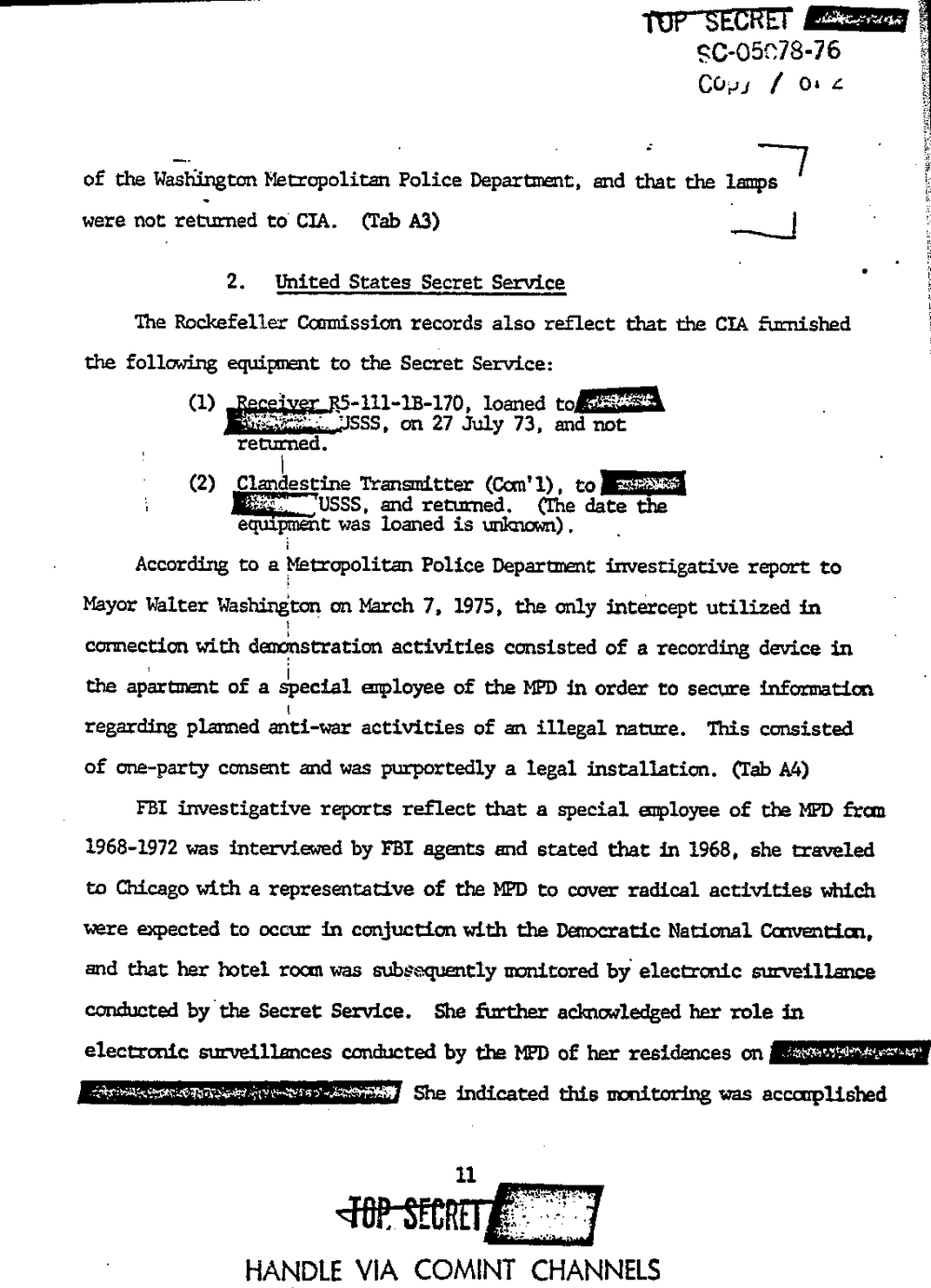
'o
C091 0t 4
of the Wasl?ngton Metropolitan Police Department, and that the lamps I
were not returned to CIA. (Tab A3)
2. United States Secret Service
The Rockefeller Coumission records also re?ect that the CIA furnished
the following equipment to the Secret Service:
(1) 411-113-170, loaned to
. 583, on 27 July 73, and not
(2) Clandestine Transmitter (Com' 1). to
i and returned. (The date
eqmpment was loaned is tmlmovm) .
According to a :Metropolitan Police Departs-mt investigative report to
Mayor Walter Washington on March 7, 1975, the only intercept utilized in
connection with deminstration activities consisted of a recording device in
the apartment of a sipecial employee of the MPD in order to secure information
regarding planned anti-war activities of an illegal nature. This consisted
of one-party consent and was purportedly a legal installation. (Tab A4)
FBI investigative reports reflect that a special employee of the MPD fran
1968-1972 was interviewed by FBI agents and stated that in 1968, she traveled
to Ching with a representative of the MPD to cover radical activities which
were expected to occur in conjuction with the Democratic National
and that her hotel room was subsequmtly unnitored by electrmic smreillmce
conducted by the Secret Service. She further acknowledged her role in
electrmic surveillances conducted by the MPD of her residences on
. 9?5 Win?st
seems She indicated this mmitoring was accurplished
.
.
1" I
HANDLE VIA COMINT CHANNELS
'o
C091 0t 4
of the Wasl?ngton Metropolitan Police Department, and that the lamps I
were not returned to CIA. (Tab A3)
2. United States Secret Service
The Rockefeller Coumission records also re?ect that the CIA furnished
the following equipment to the Secret Service:
(1) 411-113-170, loaned to
. 583, on 27 July 73, and not
(2) Clandestine Transmitter (Com' 1). to
i and returned. (The date
eqmpment was loaned is tmlmovm) .
According to a :Metropolitan Police Departs-mt investigative report to
Mayor Walter Washington on March 7, 1975, the only intercept utilized in
connection with deminstration activities consisted of a recording device in
the apartment of a sipecial employee of the MPD in order to secure information
regarding planned anti-war activities of an illegal nature. This consisted
of one-party consent and was purportedly a legal installation. (Tab A4)
FBI investigative reports reflect that a special employee of the MPD fran
1968-1972 was interviewed by FBI agents and stated that in 1968, she traveled
to Ching with a representative of the MPD to cover radical activities which
were expected to occur in conjuction with the Democratic National
and that her hotel room was subsequmtly unnitored by electrmic smreillmce
conducted by the Secret Service. She further acknowledged her role in
electrmic surveillances conducted by the MPD of her residences on
. 9?5 Win?st
seems She indicated this mmitoring was accurplished
.
.
1" I
HANDLE VIA COMINT CHANNELS
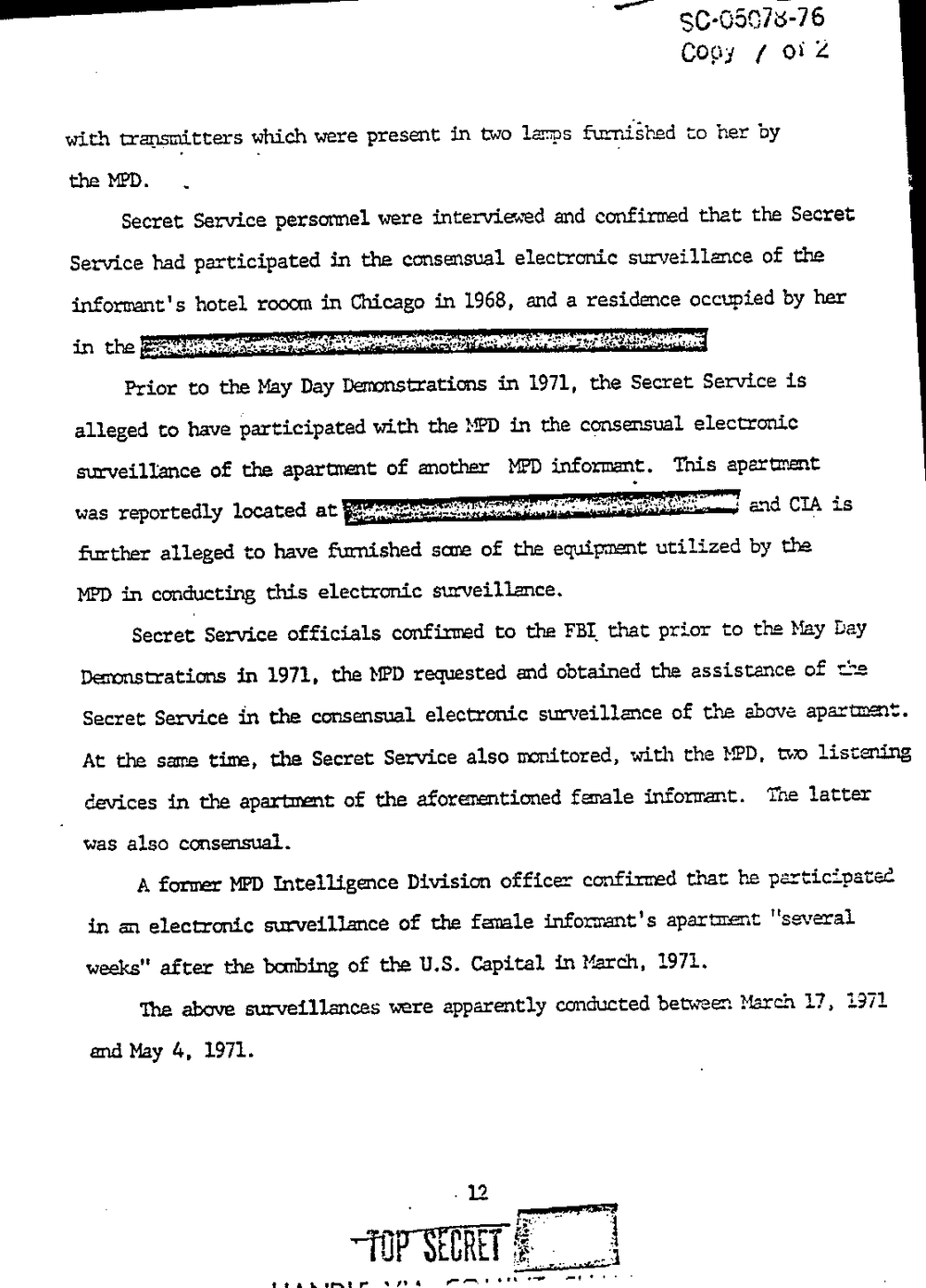
30-65979-76
Cow 0i 2
with transnattas which were present in two laps fro-?shed to her by
theMPD.
Secret Service personnel were interviewed and confimed that the Secret
Service had participated in the consensual electronic smeillance of the
informant's hotel in Chicago in 1968, and a residence occupied by her
Prior to the May Day in 1971. the Secret Service is
alleged to have participated with the MP1) in the consensual electronic
surveillance of the apartment of another MPD informant. This apartment
was reportedly located at
and CIA is
further alleged to have ?nished some of the equipsent utilized by the
MPD in conducting this electronic smeillance.
Secret Service officials confirmed to the FBI. that prior to the May Day
in 1971, the MP1) requested and obtained the assistance of
Secret Service in the consensual electronic smreillance of the above apartment.
At the same time, the Secret Service also monitored, with the NED, two listening
devices in the ath of the aforementioned ferale informant. The latter
was also consensual.
A former MPD Intelligence Division officer confirmed that he participated
in an electronic surveillance of the female infomait?s apartment "several
weeks" after the bombing of tie U.S. Capital in March, 1971.
above surveillances were apparently wnducted between March 3.971
and May 4, 1971.
- 12
err?Juan
IIALIHIF in!
30-65979-76
Cow 0i 2
with transnattas which were present in two laps fro-?shed to her by
theMPD.
Secret Service personnel were interviewed and confimed that the Secret
Service had participated in the consensual electronic smeillance of the
informant's hotel in Chicago in 1968, and a residence occupied by her
Prior to the May Day in 1971. the Secret Service is
alleged to have participated with the MP1) in the consensual electronic
surveillance of the apartment of another MPD informant. This apartment
was reportedly located at
and CIA is
further alleged to have ?nished some of the equipsent utilized by the
MPD in conducting this electronic smeillance.
Secret Service officials confirmed to the FBI. that prior to the May Day
in 1971, the MP1) requested and obtained the assistance of
Secret Service in the consensual electronic smreillance of the above apartment.
At the same time, the Secret Service also monitored, with the NED, two listening
devices in the ath of the aforementioned ferale informant. The latter
was also consensual.
A former MPD Intelligence Division officer confirmed that he participated
in an electronic surveillance of the female infomait?s apartment "several
weeks" after the bombing of tie U.S. Capital in March, 1971.
above surveillances were apparently wnducted between March 3.971
and May 4, 1971.
- 12
err?Juan
IIALIHIF in!
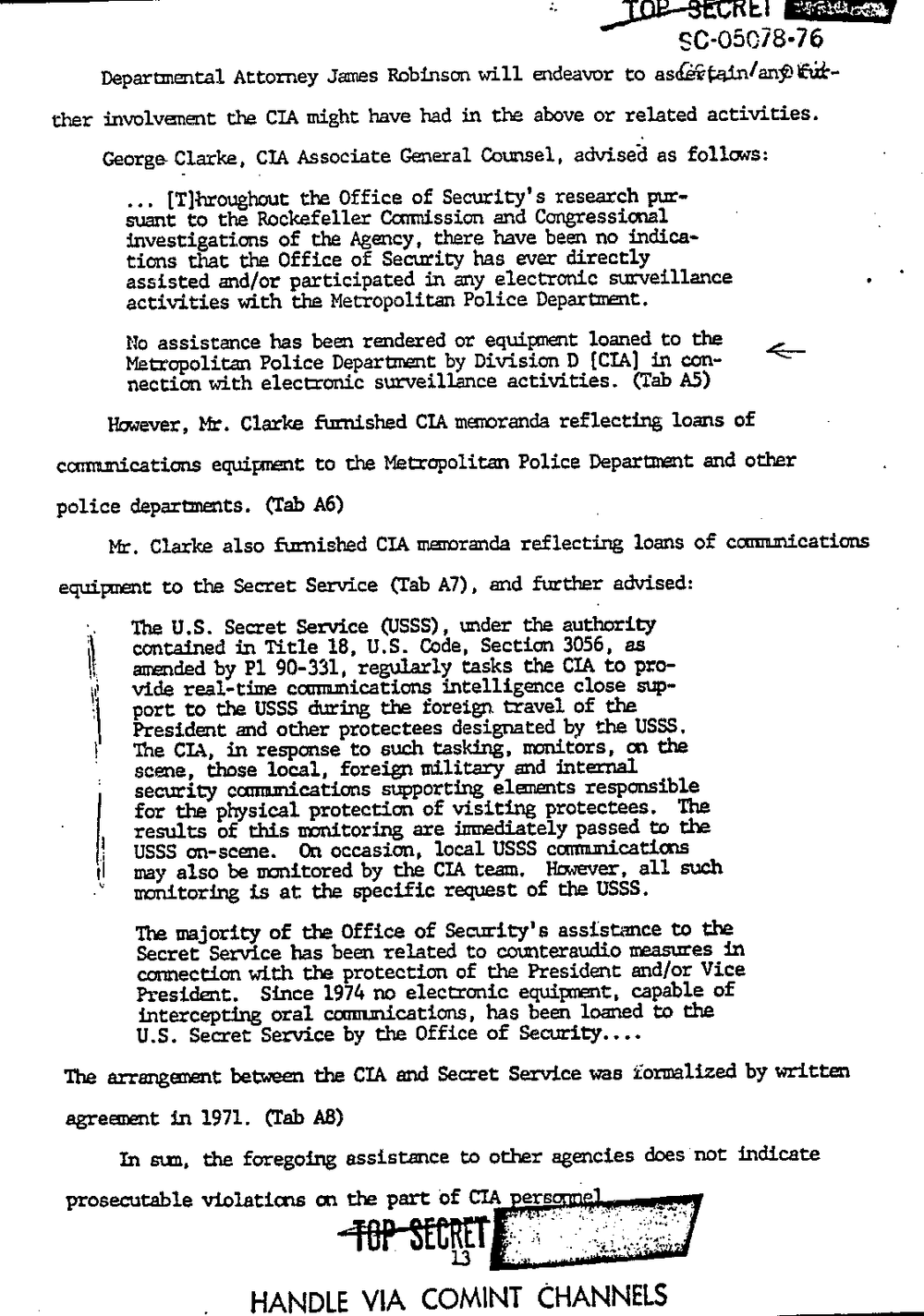
80-05078-76
Departmental Attorney James Robinson will endeavor to ascf?ftajn/any) ne?e?
ther involvement the CIA might have had in the above or related activities.
Ge0rge Clarke, CIA Associate General Counsel, advised as follows:
. . . [Tlhroughout the Office of Security's research pur-
suant to the Rockefeller Commission and Congressimal
investigations of the Agency, there have been no indica-
tions that the Office of Security has ever directly
assisted and/or participated in any electronic surveillance .
activities with the Metropolitan Police DeparUrent.
No assistance has been rendered or equipment loaned to the
Metropolitan Police Department by Division in con? "3
nection with electronic surveillance activities. (Tab A5)
However, Mr. Clarke furnished CIA memoranda reflecting loans of
cornnmications equigrmt to the Metropolitan Police Department and other
police departments. (Tab A6) I
Mr. Clarke also furnished CIA mranda reflecting loans of counnmications
equipment to the Secret Service (Tab A7), and further advised:
The U.S. Secret Service under the authority
contained in Title 18, U.S. Code, Section 3056, as
amended by P1 90-331, regularly tasks the CIA to pro-
v! vide real-time coonmications intelligence close sup-
port to the [1388 during the foreign travel of the
President and other protectees designated by the 11358.
i The CIA, in response to such tasking, monitors, on the
scene, those local, foreign military and internal
semity communications supporting elmts responsible
for the physical protection of visiting protectees. The
results of this mitoring are immediately passed to the
on-scene. On occasion, local
may also be monitored by the CIA team. However, all such
monitoring is at the specific request of the U888.
The majority of the Office of Security's assistance to the
Secret Service has been related to counteraudio measures in
connection with the protection of the President and/or Vice
President. Since 1974 no electronic equipomt, capable of
intercepting oral coommications, has been loaned to the
U.S. Secret Service by the Office of Security. . ..
The arrangmt between the CIA and Secret Service was formalized by written
agreement in 1971. (Tab AB)
In sun. the foregoing assistance to other agencies does'not indicate
HANDLE VIA COMINT CHANNELS
80-05078-76
Departmental Attorney James Robinson will endeavor to ascf?ftajn/any) ne?e?
ther involvement the CIA might have had in the above or related activities.
Ge0rge Clarke, CIA Associate General Counsel, advised as follows:
. . . [Tlhroughout the Office of Security's research pur-
suant to the Rockefeller Commission and Congressimal
investigations of the Agency, there have been no indica-
tions that the Office of Security has ever directly
assisted and/or participated in any electronic surveillance .
activities with the Metropolitan Police DeparUrent.
No assistance has been rendered or equipment loaned to the
Metropolitan Police Department by Division in con? "3
nection with electronic surveillance activities. (Tab A5)
However, Mr. Clarke furnished CIA memoranda reflecting loans of
cornnmications equigrmt to the Metropolitan Police Department and other
police departments. (Tab A6) I
Mr. Clarke also furnished CIA mranda reflecting loans of counnmications
equipment to the Secret Service (Tab A7), and further advised:
The U.S. Secret Service under the authority
contained in Title 18, U.S. Code, Section 3056, as
amended by P1 90-331, regularly tasks the CIA to pro-
v! vide real-time coonmications intelligence close sup-
port to the [1388 during the foreign travel of the
President and other protectees designated by the 11358.
i The CIA, in response to such tasking, monitors, on the
scene, those local, foreign military and internal
semity communications supporting elmts responsible
for the physical protection of visiting protectees. The
results of this mitoring are immediately passed to the
on-scene. On occasion, local
may also be monitored by the CIA team. However, all such
monitoring is at the specific request of the U888.
The majority of the Office of Security's assistance to the
Secret Service has been related to counteraudio measures in
connection with the protection of the President and/or Vice
President. Since 1974 no electronic equipomt, capable of
intercepting oral coommications, has been loaned to the
U.S. Secret Service by the Office of Security. . ..
The arrangmt between the CIA and Secret Service was formalized by written
agreement in 1971. (Tab AB)
In sun. the foregoing assistance to other agencies does'not indicate
HANDLE VIA COMINT CHANNELS
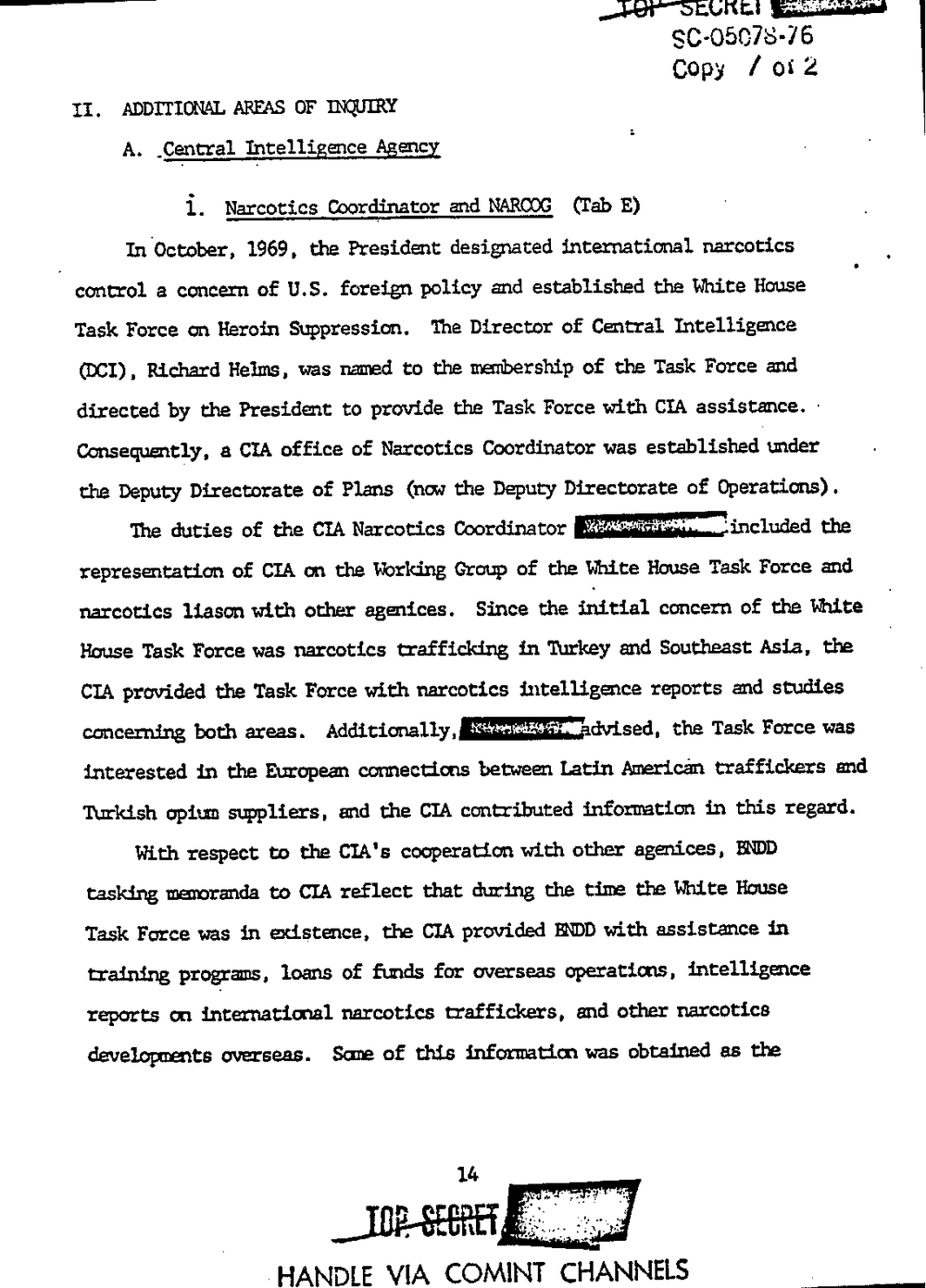
Muriel
80-05078-76
Cepy 0x2
II. ADDITIONAL AREAS or mm:
A. ,Central Intelligence Agencl
l. Narcotics Coordinator and NARCOG (Tab E)
In'October. 1969. the President desigiated international narcotics
I control a concern of U.S. foreign policy and established the White House
Task Force on Heroin Suppression. The Director of Central Intelligence
(DCI) . Richard Helms, was named to the membership of the Task Force and
directed by the President to provide the Task Force with CIA assistance. -
Consequently, a CIA office of Narcotics Coordinator was establishedunder
the Deputy Directorate of Plans (now the Deputy Directorate of Operations).
The duties of the CIA Narcotics Coordinator
representation of CIA on the Working Group of the White House Task Force and
narcotics liason with other agenices. Since the initial concern of the mite
House Task Force was narcotics in Turkey and Southeast Asia. the
CIA provided the Task Force with narcotics intelligence reports and studies
concerning both areas. Additionally.Madv-ised, the Task Force was
interested in the European comections between Latin American traffickers and
Turkish opium suppliers, and the CIA contributed information in this regard.
With respect to the CIA's cooperation with other agenices. RIDD
tasking memoranda to CIA reflect that during the time the White House
Task Force was in existence, the CIA provided BNDD with assistance in
training programs, loans of funds for overseas operations, intelligence
reports on international narcotics traffickers, and other narcotics
deveIOpments overseas. Sane of this information was obtained as the
Muriel
80-05078-76
Cepy 0x2
II. ADDITIONAL AREAS or mm:
A. ,Central Intelligence Agencl
l. Narcotics Coordinator and NARCOG (Tab E)
In'October. 1969. the President desigiated international narcotics
I control a concern of U.S. foreign policy and established the White House
Task Force on Heroin Suppression. The Director of Central Intelligence
(DCI) . Richard Helms, was named to the membership of the Task Force and
directed by the President to provide the Task Force with CIA assistance. -
Consequently, a CIA office of Narcotics Coordinator was establishedunder
the Deputy Directorate of Plans (now the Deputy Directorate of Operations).
The duties of the CIA Narcotics Coordinator
representation of CIA on the Working Group of the White House Task Force and
narcotics liason with other agenices. Since the initial concern of the mite
House Task Force was narcotics in Turkey and Southeast Asia. the
CIA provided the Task Force with narcotics intelligence reports and studies
concerning both areas. Additionally.Madv-ised, the Task Force was
interested in the European comections between Latin American traffickers and
Turkish opium suppliers, and the CIA contributed information in this regard.
With respect to the CIA's cooperation with other agenices. RIDD
tasking memoranda to CIA reflect that during the time the White House
Task Force was in existence, the CIA provided BNDD with assistance in
training programs, loans of funds for overseas operations, intelligence
reports on international narcotics traffickers, and other narcotics
deveIOpments overseas. Sane of this information was obtained as the
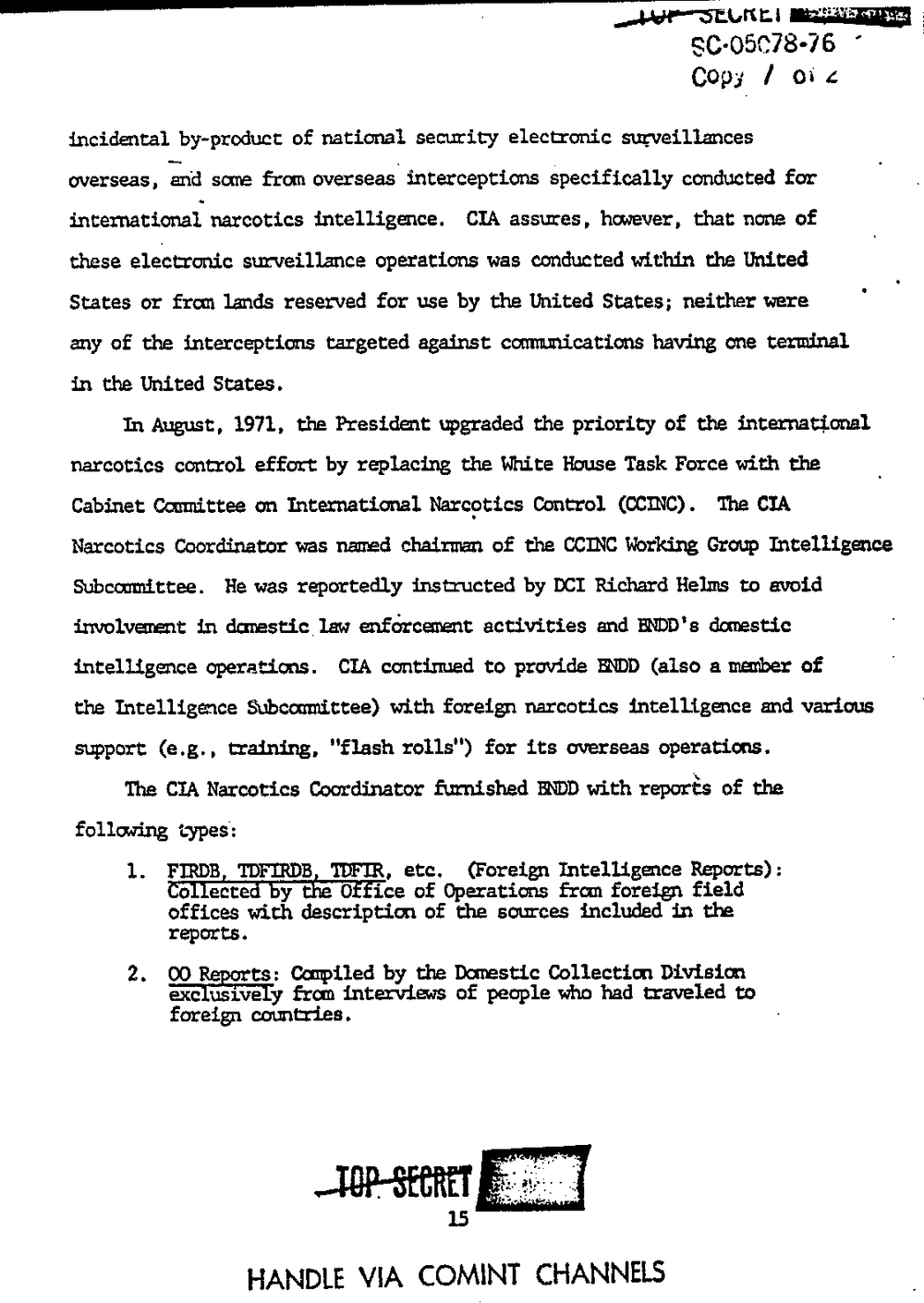
?ew?
30-05078-76
009;; ox .4
incidental lay-product of national security electronic surveillances
overseas, Ema some from overseas. interceptions Specifically conducted for
international narcotics intelligence. CIA assures, however, that none of
these electronic surveillance operations was conducted within the United
States or from lands reserved for use by the United States; neither were
any of the interceptions targeted against having one terminal
in the United States.
In August, 1971, the President upgraded the priority of the international
narcotics control effort by replacing the White House Task Force with the
Cabinet Cooudttee on International Narcotics Control (some) . The CIA
Narcotics Coordinator was named chairman of the CCINC Working Group Intelligence
Subcommittee. He was reportedly instructed by DCI Richard Helms to avoid
involvement in dmesticlm mforcement activities and domestic
intelligence operations. CIA continued to provide ENDD (also a member of
the Intelligence Subcommittee) with foreigz narcotics intelligence and various
support . training, "flash rolls") for its overseas operations.
The on Narcotics Coordinator fumished son with reports of the
following types:
1. FIRDB TDFIRDB TDFIR, etc. (Foreign Intelligence Reports):
Wm of Operations from foreign field
offices with description of the sources included in the
reports.
2. Cmpiled by the Danestic Collection Division
usive from interviews of people who had traveled to
foreign countries.
HANDLE VIA COMINT CHANNELS
?ew?
30-05078-76
009;; ox .4
incidental lay-product of national security electronic surveillances
overseas, Ema some from overseas. interceptions Specifically conducted for
international narcotics intelligence. CIA assures, however, that none of
these electronic surveillance operations was conducted within the United
States or from lands reserved for use by the United States; neither were
any of the interceptions targeted against having one terminal
in the United States.
In August, 1971, the President upgraded the priority of the international
narcotics control effort by replacing the White House Task Force with the
Cabinet Cooudttee on International Narcotics Control (some) . The CIA
Narcotics Coordinator was named chairman of the CCINC Working Group Intelligence
Subcommittee. He was reportedly instructed by DCI Richard Helms to avoid
involvement in dmesticlm mforcement activities and domestic
intelligence operations. CIA continued to provide ENDD (also a member of
the Intelligence Subcommittee) with foreigz narcotics intelligence and various
support . training, "flash rolls") for its overseas operations.
The on Narcotics Coordinator fumished son with reports of the
following types:
1. FIRDB TDFIRDB TDFIR, etc. (Foreign Intelligence Reports):
Wm of Operations from foreign field
offices with description of the sources included in the
reports.
2. Cmpiled by the Danestic Collection Division
usive from interviews of people who had traveled to
foreign countries.
HANDLE VIA COMINT CHANNELS
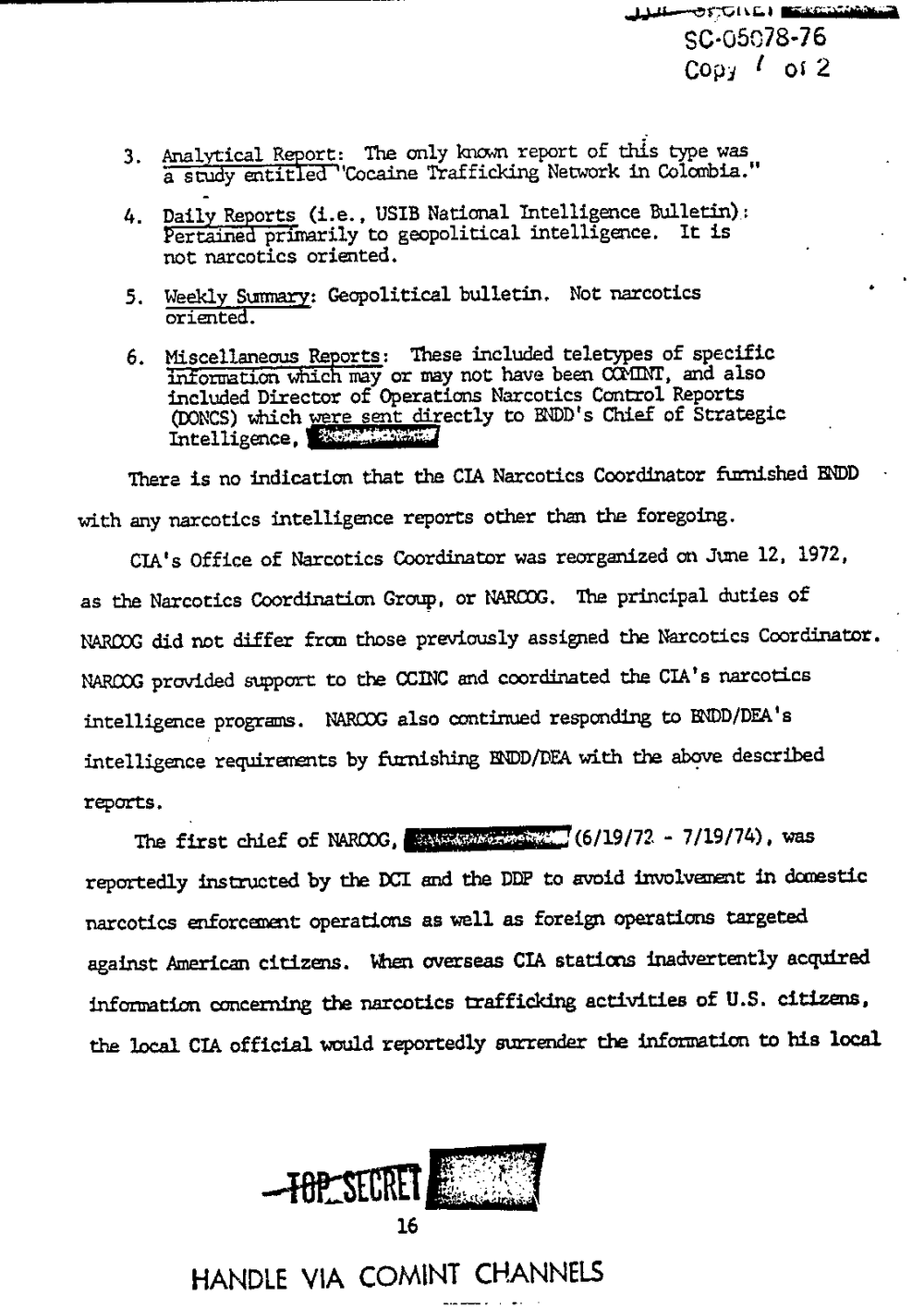
?rm-T11
80-05078-76
Copy o: 2
3. Analytical Report: The only Imown report of type was
a study entitled "Cocaine Trafficking Network in Colombia."
4. Dail Re orts USIB National Intelligence Bulletin);
PertaineE primarily to geopolitical intelligence. It is
not narcotics oriented.
5. Weekly Geopolitical bulletin. Not narcotics
oriente .
6. Miscellaneous Reports: These included telewpes of specific
information which may or may not have been cam, and also
included Director of Operations Narcotics Control Reports
(DONCS) which wee sent directly to BNDD's Chief of Strategic
Intelligence,
'Ihere is no indication that the CIA Narcotics Coordinator furnished EDD
with any narcotics intelligence reports other than the foregoing.
CIA's Office of Narcotics Coordinator was reorganized on June 12, 1972,
as the Narcotics Coordination Group, or NARCOG. The principal duties of
NAREDG did not differ from those previously assigned the Narcotics Coordinator. -
NARCOG provided wpport to the CCINC and coordinated the ClA's narcotics
intelligence program. NARCOG also continued responding to
intelligence requirenents by ?rrnishing with the described
reports.
The first chief of mono, (6/19/72. - 7/19/74). was
reportedly instructed by the DCI and the to avoid involvement: in domestic
narcotics enforcenent operations as well as foreigi operations targeted
against American citizens. When overseas CIA stations inadvertently acquired
information concerning the narcotics trafficking activities of 11.8. citizens,
the local CIA official would reportedly made: the information to his local
HANDLE VIA COMINT CHANNELS
?rm-T11
80-05078-76
Copy o: 2
3. Analytical Report: The only Imown report of type was
a study entitled "Cocaine Trafficking Network in Colombia."
4. Dail Re orts USIB National Intelligence Bulletin);
PertaineE primarily to geopolitical intelligence. It is
not narcotics oriented.
5. Weekly Geopolitical bulletin. Not narcotics
oriente .
6. Miscellaneous Reports: These included telewpes of specific
information which may or may not have been cam, and also
included Director of Operations Narcotics Control Reports
(DONCS) which wee sent directly to BNDD's Chief of Strategic
Intelligence,
'Ihere is no indication that the CIA Narcotics Coordinator furnished EDD
with any narcotics intelligence reports other than the foregoing.
CIA's Office of Narcotics Coordinator was reorganized on June 12, 1972,
as the Narcotics Coordination Group, or NARCOG. The principal duties of
NAREDG did not differ from those previously assigned the Narcotics Coordinator. -
NARCOG provided wpport to the CCINC and coordinated the ClA's narcotics
intelligence program. NARCOG also continued responding to
intelligence requirenents by ?rrnishing with the described
reports.
The first chief of mono, (6/19/72. - 7/19/74). was
reportedly instructed by the DCI and the to avoid involvement: in domestic
narcotics enforcenent operations as well as foreigi operations targeted
against American citizens. When overseas CIA stations inadvertently acquired
information concerning the narcotics trafficking activities of 11.8. citizens,
the local CIA official would reportedly made: the information to his local
HANDLE VIA COMINT CHANNELS
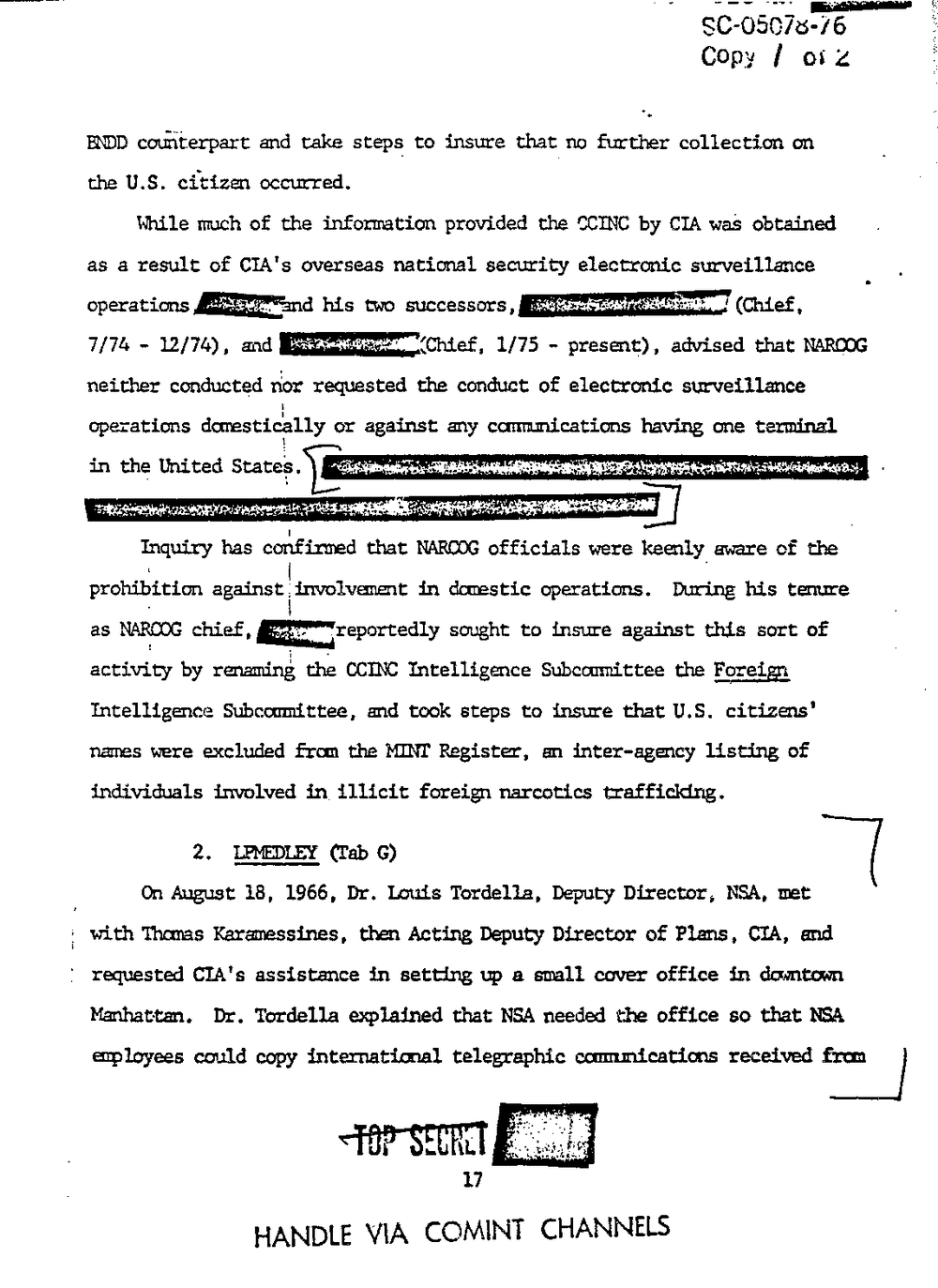
80-05075-76
Copy I os 24
ENDD comiiterpart and take steps to insure that no further collection on
the U.S. citizen occurred.
Wile much of the information provided the CCDIC by CIA was obtained
as a result of CIA's overseas national security electronic surveillmce
neither conducted nor requested the conduct of electronic surveillance
operations domesticially or against any cmmications having one terminal
in the United .
Wyanymme; -. A
Inquiry has confirmed that NARCOG officials were keenly. aware of the
prohibition againstfimrolvement in domestic operations. During his tenure
as chief, @reportedly sought to insure against this sort of
activity by CCINC Intelligence Subcommittee the Foreign
Intelligence Subcommittee, and took steps to insure that U.S. citizens'
nanes were excluded from the MINT Register, an inter-agency listing of
individuals involved in illicit foreign narcotics
2. mm (Tab G)
On August 18, 1966, Dr. louis Tordella, Deputy Director, NSA, met
with Times Karamessines, tl'xen Acting Deputy Director of Plans. CIA, and
requested ClA's assistance in setting up a small cover office in dath
Mmhat-tan. Dr. Tordella explained that NSA needed the office so that NBA
employees could copy internatimal telegraphic ccummications received f:
HANDLE COMINT CHANNELS
80-05075-76
Copy I os 24
ENDD comiiterpart and take steps to insure that no further collection on
the U.S. citizen occurred.
Wile much of the information provided the CCDIC by CIA was obtained
as a result of CIA's overseas national security electronic surveillmce
neither conducted nor requested the conduct of electronic surveillance
operations domesticially or against any cmmications having one terminal
in the United .
Wyanymme; -. A
Inquiry has confirmed that NARCOG officials were keenly. aware of the
prohibition againstfimrolvement in domestic operations. During his tenure
as chief, @reportedly sought to insure against this sort of
activity by CCINC Intelligence Subcommittee the Foreign
Intelligence Subcommittee, and took steps to insure that U.S. citizens'
nanes were excluded from the MINT Register, an inter-agency listing of
individuals involved in illicit foreign narcotics
2. mm (Tab G)
On August 18, 1966, Dr. louis Tordella, Deputy Director, NSA, met
with Times Karamessines, tl'xen Acting Deputy Director of Plans. CIA, and
requested ClA's assistance in setting up a small cover office in dath
Mmhat-tan. Dr. Tordella explained that NSA needed the office so that NBA
employees could copy internatimal telegraphic ccummications received f:
HANDLE COMINT CHANNELS
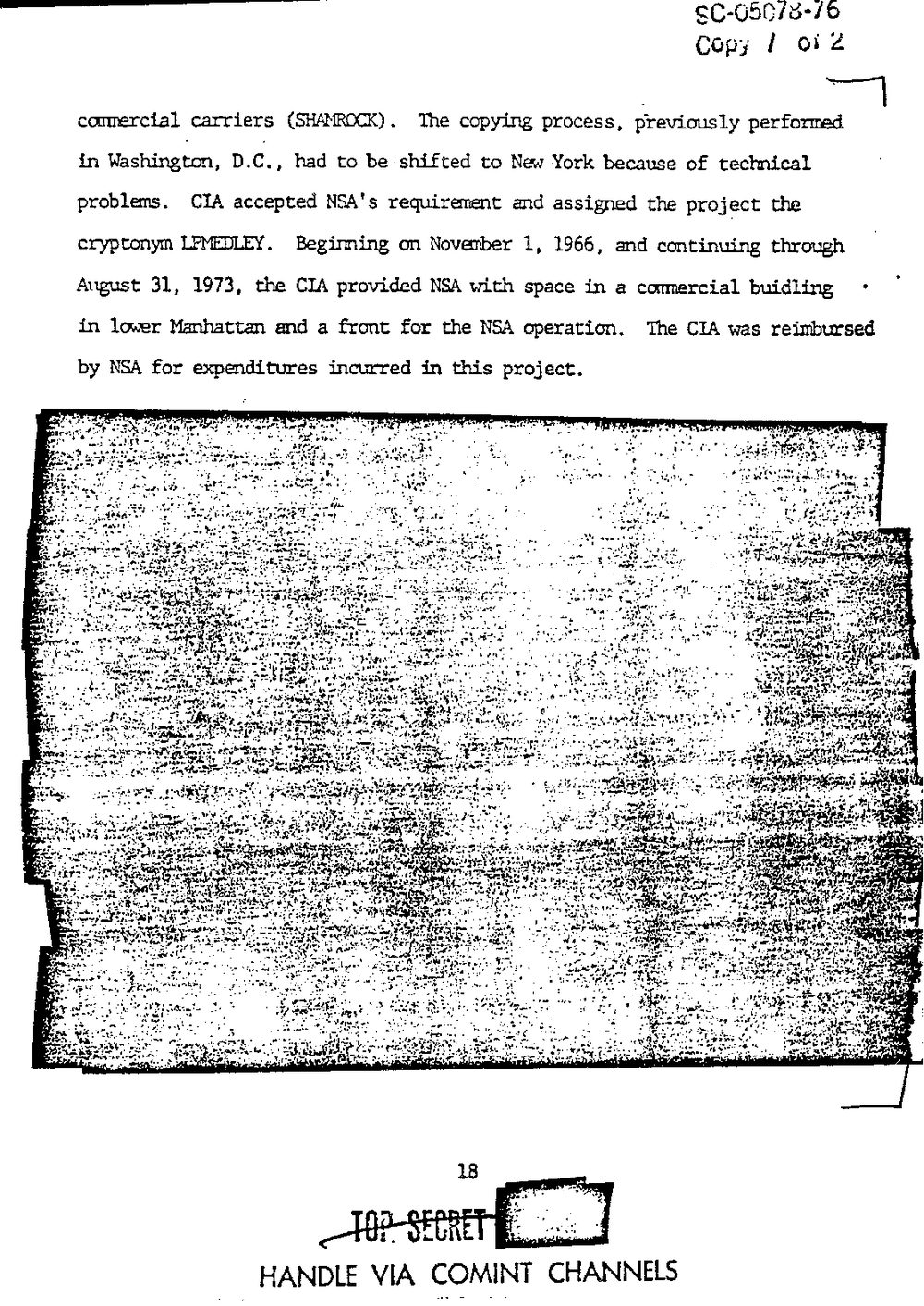
commercial carriers . The copying process, previously performed
in Washington, DC. had to be shifted to New York because of technical
problems. CIA accepted NSA's requirement and assigned the project the
WY. Beginning on November 1. 1966, and continuing through
August 31, 1973, the CIA provided NSA with space in a commercial buidling
in lower Manhattan and a front for the NSA operation. The CIA was reimbursed
by NSA for expenditures incurred in this project.
. . .
-, .-.:
them-1?1.
..
0"
All
Axel?30,;g our3.4..
{ivy-In.? .II-.. 1: -
q. .
.
t"
unI' -
. Ki .
. uni-la f,
073.
c2; .. 1 .
a?yfp ur'
?rlf?I? I an", lov?I
Iii-{ugh Irwii?fd?tu-I I.I .- gr'vin5l1.?f??Man's\??y?gwh
Ila?hm . Pu}.
.2 v4 3.245v.14meanwr ., ..
L, . 1'
33L -. when n5.? - .. I
HANDLE VIA COMINT CHANNELS
commercial carriers . The copying process, previously performed
in Washington, DC. had to be shifted to New York because of technical
problems. CIA accepted NSA's requirement and assigned the project the
WY. Beginning on November 1. 1966, and continuing through
August 31, 1973, the CIA provided NSA with space in a commercial buidling
in lower Manhattan and a front for the NSA operation. The CIA was reimbursed
by NSA for expenditures incurred in this project.
. . .
-, .-.:
them-1?1.
..
0"
All
Axel?30,;g our3.4..
{ivy-In.? .II-.. 1: -
q. .
.
t"
unI' -
. Ki .
. uni-la f,
073.
c2; .. 1 .
a?yfp ur'
?rlf?I? I an", lov?I
Iii-{ugh Irwii?fd?tu-I I.I .- gr'vin5l1.?f??Man's\??y?gwh
Ila?hm . Pu}.
.2 v4 3.245v.14meanwr ., ..
L, . 1'
33L -. when n5.? - .. I
HANDLE VIA COMINT CHANNELS
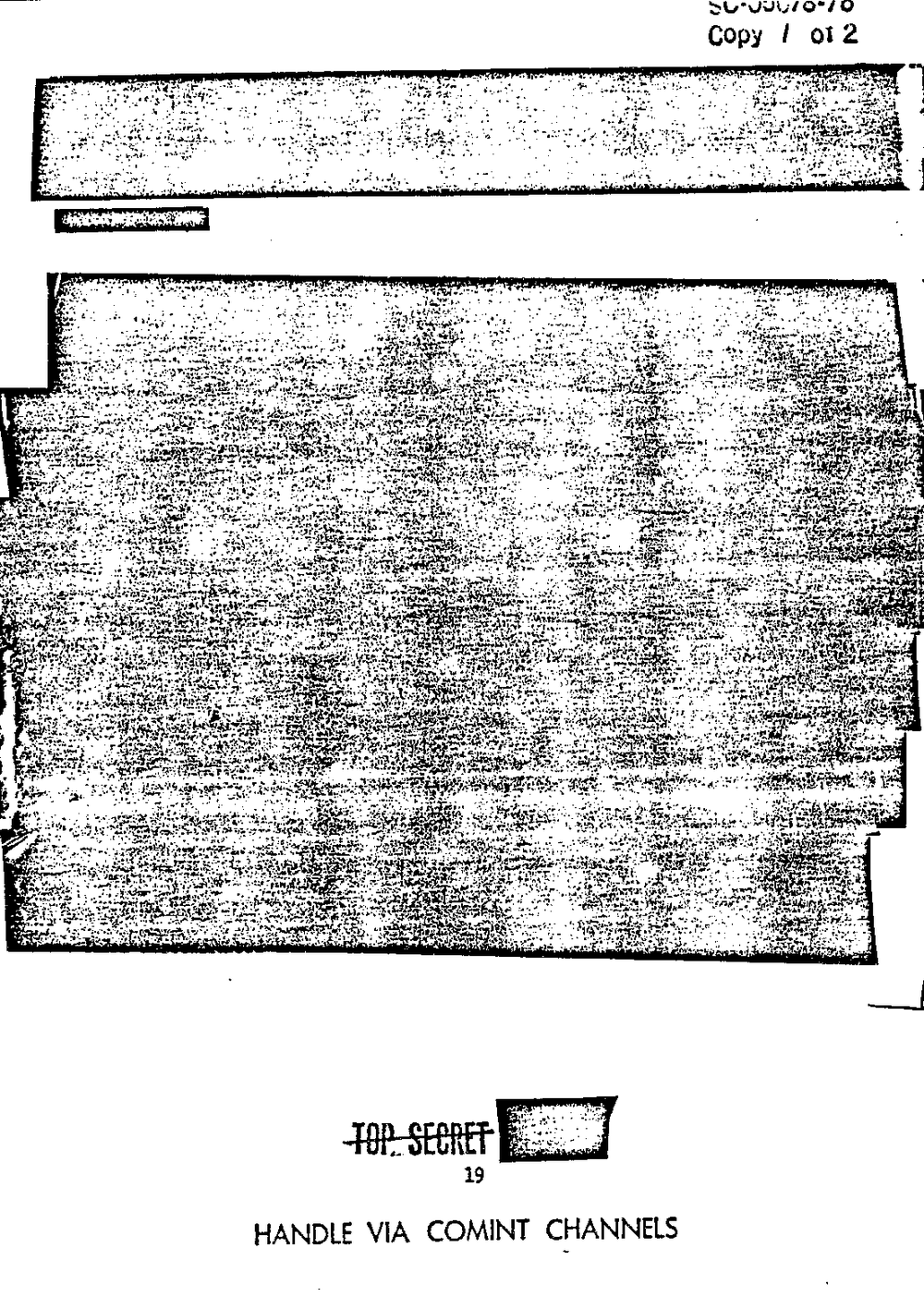
If.1351bur-?5* . . .L
I. . 15-3-I-luIf} ?ti?$555I.nIv - fawar-a?mL-s?-
u. IfMIT-luff49:? rt?1:913:
. - 24$ .
9.
If?"
5
HANDLE VIA COMINT
If.1351bur-?5* . . .L
I. . 15-3-I-luIf} ?ti?$555I.nIv - fawar-a?mL-s?-
u. IfMIT-luff49:? rt?1:913:
. - 24$ .
9.
If?"
5
HANDLE VIA COMINT
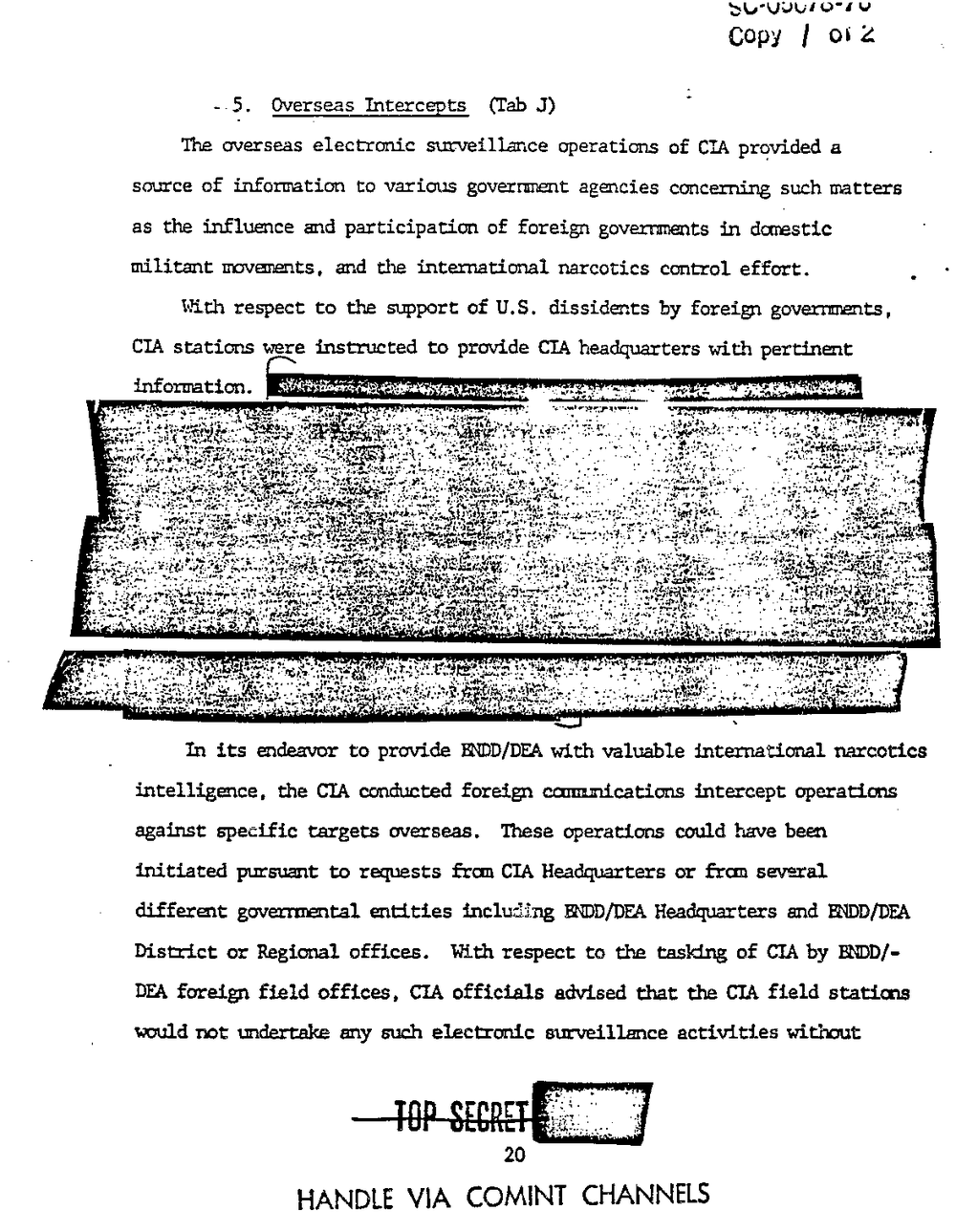
COpy I 082
Overseas Intercepts (Tab J)
The overseas electronic surveillance operations of CIA provided a
source of information to various goverrntent agencies concerning such matters
as the influence and participation of foreign in darestic
militant movements, and the international narcotics control effort.
With respect to the support of U.S. dissidents by foreign
CIA stations were instructed to provide CIA headquarters with pertinent
informationrun-?1?
ad
3"
?v
-
(I Pt'tea-?-
. i-?Aviva.kgf??u?f?UR? '3 34." .:
. I c. I?nu.Nziki- .
#5329211;fo t) - is. ,mehJim?s-- "flu;
.3. 0? -: outta-r1" 5 - . I ml": Hintme.- ?Ltin}; T-hl?li- tr" . .
4b11'3"} 293.26.};
avg-its endeavor to provide with valuable international narcotics
intelligence, the CIA conducted foreign coummications intercept Operations
against specific targets overseas. These operations could rave been I
initiated pursuant to requests from CIA Headquarters or from several
different govermental entities including Headquarters and
District or Regional offices. With respect to the tasking of CIA by BNDDI-
foreign field offices, CIA officials advised that the CIA field ataticns
would not undertake any such electronic surveillance activities without
HANDLE VIA COMINT CHANNELS
COpy I 082
Overseas Intercepts (Tab J)
The overseas electronic surveillance operations of CIA provided a
source of information to various goverrntent agencies concerning such matters
as the influence and participation of foreign in darestic
militant movements, and the international narcotics control effort.
With respect to the support of U.S. dissidents by foreign
CIA stations were instructed to provide CIA headquarters with pertinent
informationrun-?1?
ad
3"
?v
-
(I Pt'tea-?-
. i-?Aviva.kgf??u?f?UR? '3 34." .:
. I c. I?nu.Nziki- .
#5329211;fo t) - is. ,mehJim?s-- "flu;
.3. 0? -: outta-r1" 5 - . I ml": Hintme.- ?Ltin}; T-hl?li- tr" . .
4b11'3"} 293.26.};
avg-its endeavor to provide with valuable international narcotics
intelligence, the CIA conducted foreign coummications intercept Operations
against specific targets overseas. These operations could rave been I
initiated pursuant to requests from CIA Headquarters or from several
different govermental entities including Headquarters and
District or Regional offices. With respect to the tasking of CIA by BNDDI-
foreign field offices, CIA officials advised that the CIA field ataticns
would not undertake any such electronic surveillance activities without
HANDLE VIA COMINT CHANNELS
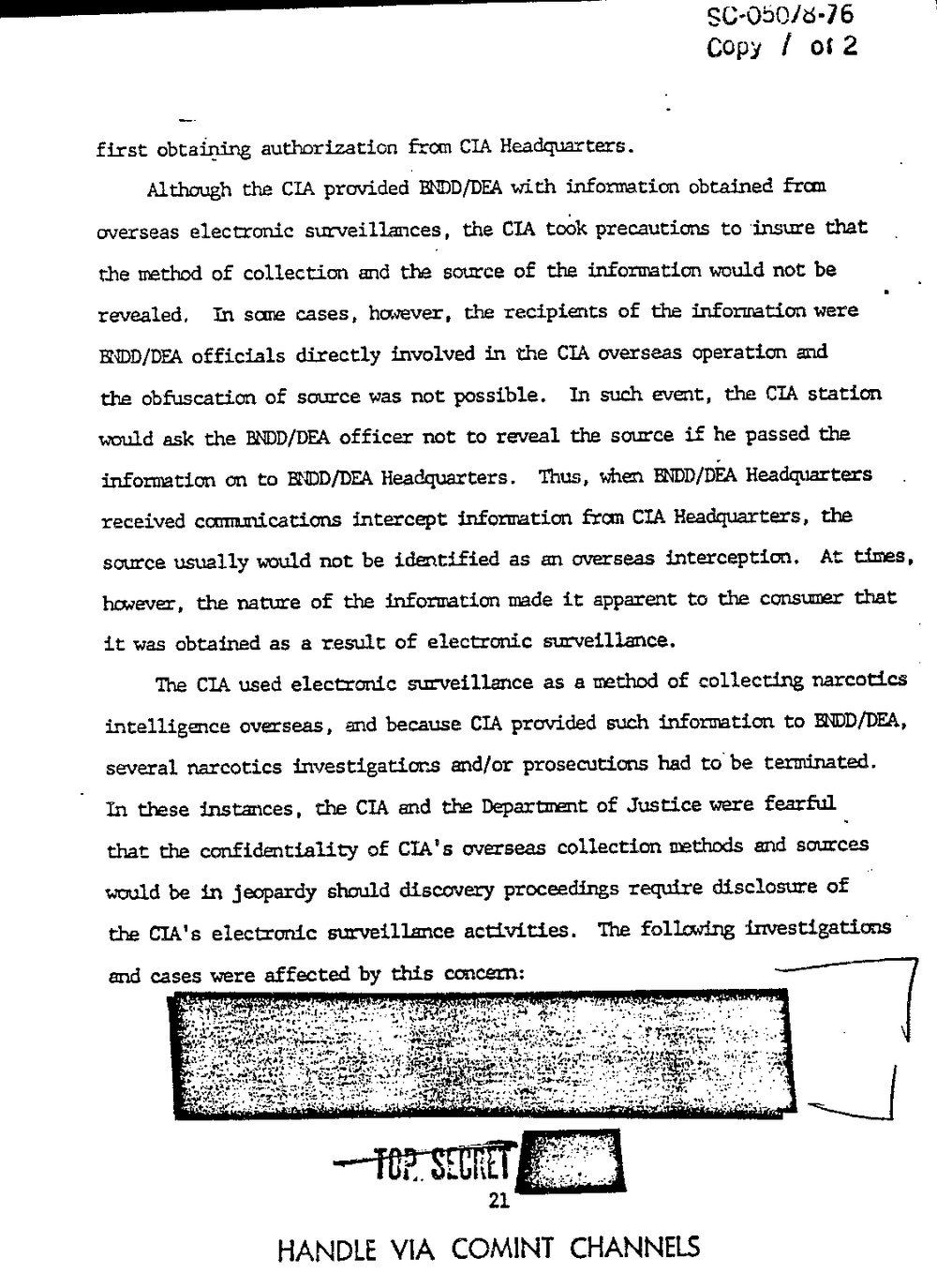
com I 0?2
first obtaining authorization from CIA Headquarters.
Although the cm provided with information obtained
overseas electronic smeillances, the CIA took precautions to insure that
the method of collection and the. source of the information would not be
revealed. In some cases, however, the recipients of the information were
officials directly involved in the CIA overseas operation aid
the obfuscation of source was not possible. In such event, the CIA station
would ask the officer not to reveal the source if he passed the
information on to Headquarters. Thus, when Headquarters
received communications intercept information from CIA Headquarters, the
source usually would not be idmtified as an overseas interception. At tines,
Weaver, the nature of the information made it apparent to the construe]: that
it was obtained as a result of electronic surveillance.
The CIA used electronic surveillance as a method of collecting narcotics I
intelligence overseas, mid because CIA provided such information to
several narcotics investigations and/or prosecutions had to'be terminated.
In these instances, the CIA and the Department of Justice were fearful
that the confidentiality of overseas collection methods and sources
would be in jeopardy should discovery proceedings require disclosure of
the electronic mirveillance activities. The follming investigade
and cas
m.
Q. it"!
HANDLE VIA COMINT CHANNELS
com I 0?2
first obtaining authorization from CIA Headquarters.
Although the cm provided with information obtained
overseas electronic smeillances, the CIA took precautions to insure that
the method of collection and the. source of the information would not be
revealed. In some cases, however, the recipients of the information were
officials directly involved in the CIA overseas operation aid
the obfuscation of source was not possible. In such event, the CIA station
would ask the officer not to reveal the source if he passed the
information on to Headquarters. Thus, when Headquarters
received communications intercept information from CIA Headquarters, the
source usually would not be idmtified as an overseas interception. At tines,
Weaver, the nature of the information made it apparent to the construe]: that
it was obtained as a result of electronic surveillance.
The CIA used electronic surveillance as a method of collecting narcotics I
intelligence overseas, mid because CIA provided such information to
several narcotics investigations and/or prosecutions had to'be terminated.
In these instances, the CIA and the Department of Justice were fearful
that the confidentiality of overseas collection methods and sources
would be in jeopardy should discovery proceedings require disclosure of
the electronic mirveillance activities. The follming investigade
and cas
m.
Q. it"!
HANDLE VIA COMINT CHANNELS
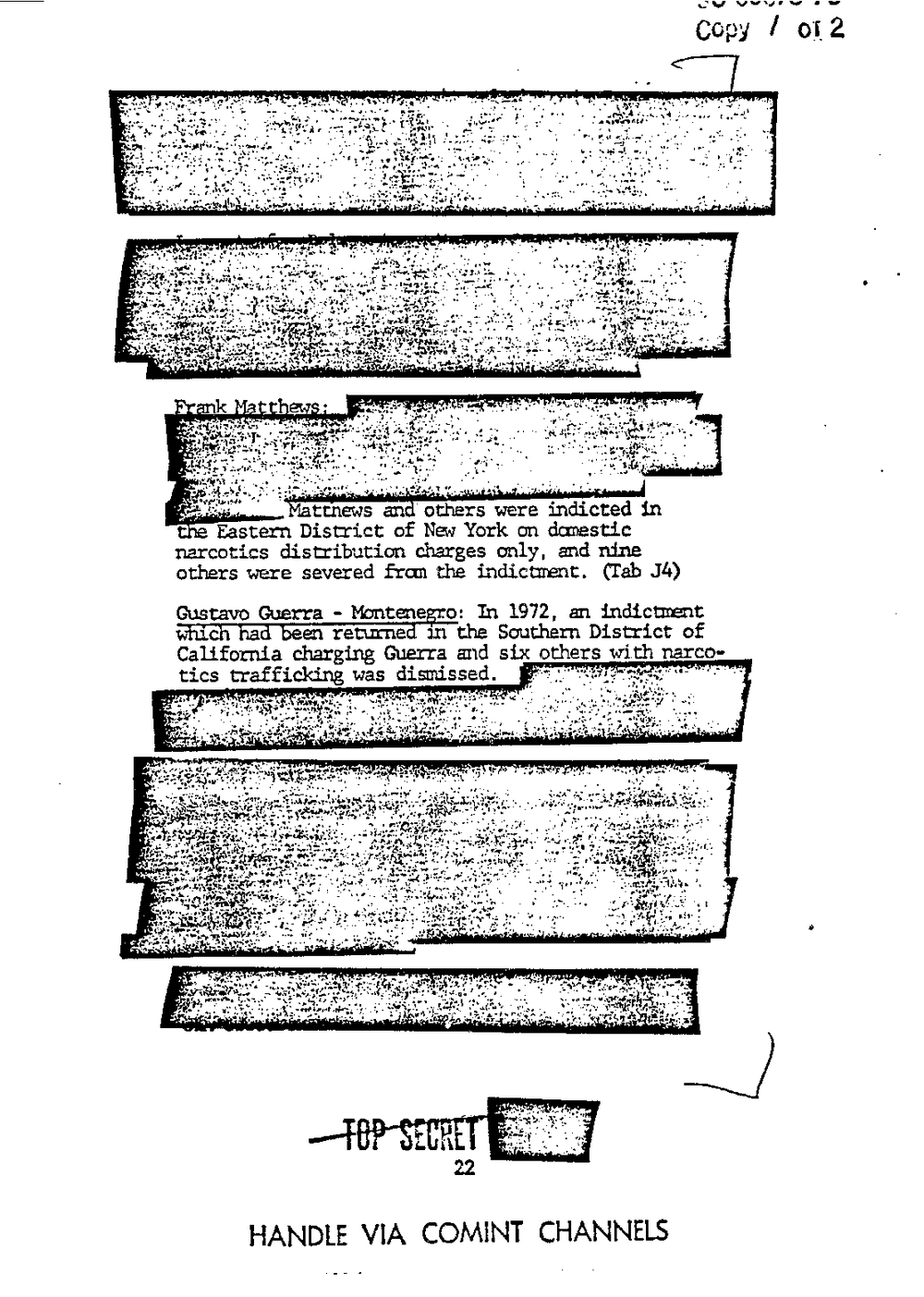
cu Vv'utu 0?1441Eastern District of New York on dcmestic
narcotics distribution charges only, and nine
others were severed from the indictment. (Tab J4)
Gustavo Guerra - Montenegro: In 1972, an indictment
1Erich had been renamed in the Southern District of
California charging Guerra and six oth co-
tics trafficking was dismissed ?it:
.
..
HANDLE VIA CHANNELS
cu Vv'utu 0?1441Eastern District of New York on dcmestic
narcotics distribution charges only, and nine
others were severed from the indictment. (Tab J4)
Gustavo Guerra - Montenegro: In 1972, an indictment
1Erich had been renamed in the Southern District of
California charging Guerra and six oth co-
tics trafficking was dismissed ?it:
.
..
HANDLE VIA CHANNELS
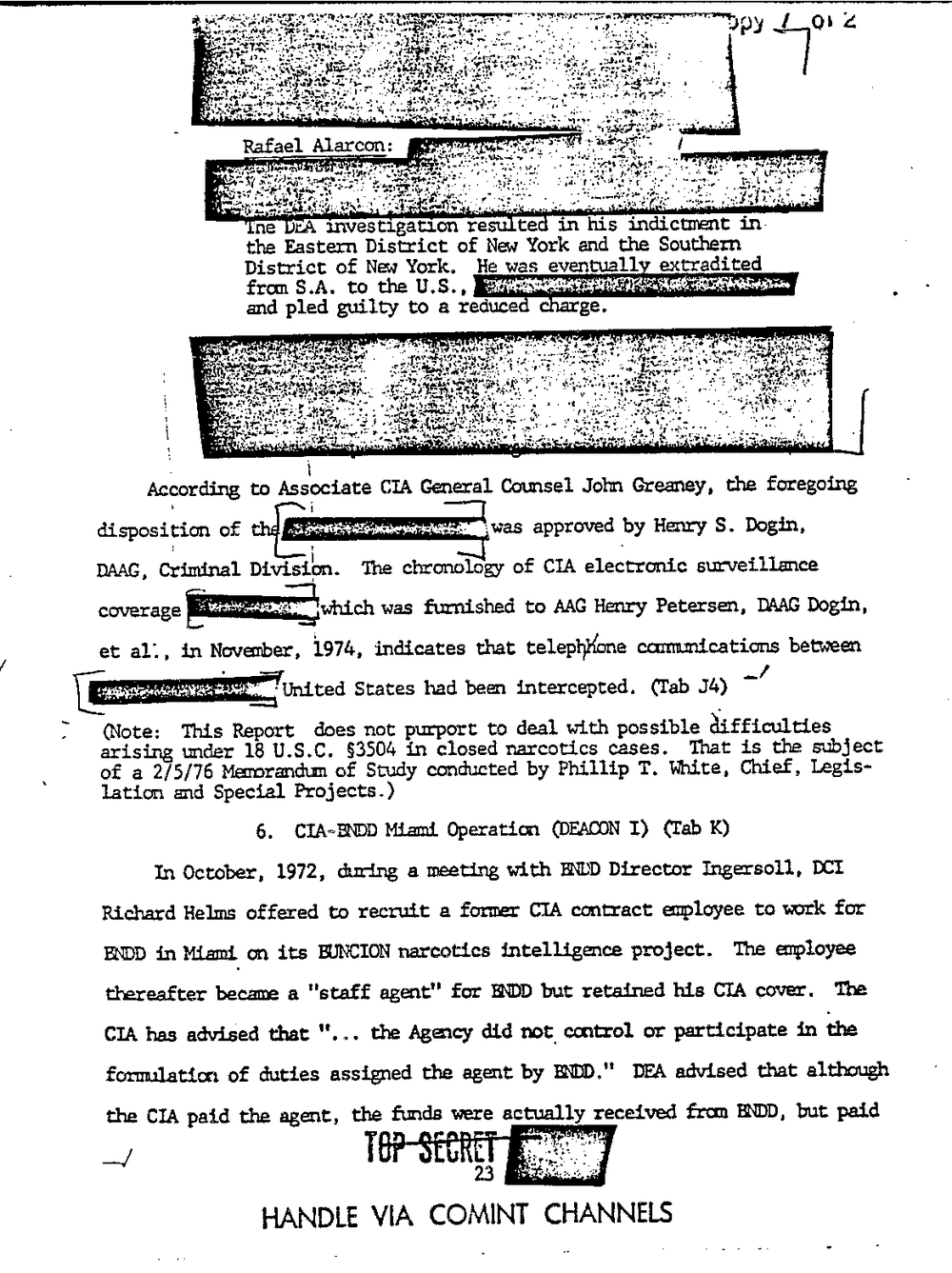
-. . .. I. . .A-ti. ?andtun-.4? "3 .- 11.. Licmga?' - 35." ..- ?91truth-7 -
.. jiffiT?- . rim?:
0
avian-a - #334: n;
3-,
we lgu?lak'lw "uf,vag?uf"
gigabs" "4 -l
-
. . .3317-
Rafael Alarconit'd"! .r wartHugg?qyf. . a; .
m" "ti-?JinInvestigation indictment in-
the Eastern District of New York and the Southern
District of New York. He was eventual]. extradited
disposition of was approved by Henry S. Dogin,
DAAG, Criminal Divisiion. The chronology of CIA electronic surveillance
coverage,
at al'. in November, 3.974, indicates that telephlione cmnmications between
I
'United States had been intercepted. (Tab J4)
a inf. -
i -
(Note: This Report does not pmrport to deal with possible difficulties
arising under 18 U.S.C. 53504 in closed narcotics cases. That is the subject
of a 2/5/76 Meanrandtm of Study conducted by Phillip White, Chief, legis?
lation aid Special Projects.)
6. Miami Operation (DRAGON I) (Tab K)
In October, 1972, during a meeting with Director Ingersoll, DCI
Richard Helms offered to recruit a former CIA contract employee to work for
BNDD in Miami on its EJNCION narcotics intelligence project. The employee
thereafter became a "staff agent" for EQDD but retained his CIA cover. The
CIA has advised that . the Agate-y did not. cmtrol or participate in
formulation of duties assigned the agent by DEA advised that although
137 received frun ENDD, but paid
i I.
Q.
the CIA paid the agent, the funds were so
-. . .. I. . .A-ti. ?andtun-.4? "3 .- 11.. Licmga?' - 35." ..- ?91truth-7 -
.. jiffiT?- . rim?:
0
avian-a - #334: n;
3-,
we lgu?lak'lw "uf,vag?uf"
gigabs" "4 -l
-
. . .3317-
Rafael Alarconit'd"! .r wartHugg?qyf. . a; .
m" "ti-?JinInvestigation indictment in-
the Eastern District of New York and the Southern
District of New York. He was eventual]. extradited
disposition of was approved by Henry S. Dogin,
DAAG, Criminal Divisiion. The chronology of CIA electronic surveillance
coverage,
at al'. in November, 3.974, indicates that telephlione cmnmications between
I
'United States had been intercepted. (Tab J4)
a inf. -
i -
(Note: This Report does not pmrport to deal with possible difficulties
arising under 18 U.S.C. 53504 in closed narcotics cases. That is the subject
of a 2/5/76 Meanrandtm of Study conducted by Phillip White, Chief, legis?
lation aid Special Projects.)
6. Miami Operation (DRAGON I) (Tab K)
In October, 1972, during a meeting with Director Ingersoll, DCI
Richard Helms offered to recruit a former CIA contract employee to work for
BNDD in Miami on its EJNCION narcotics intelligence project. The employee
thereafter became a "staff agent" for EQDD but retained his CIA cover. The
CIA has advised that . the Agate-y did not. cmtrol or participate in
formulation of duties assigned the agent by DEA advised that although
137 received frun ENDD, but paid
i I.
Q.
the CIA paid the agent, the funds were so
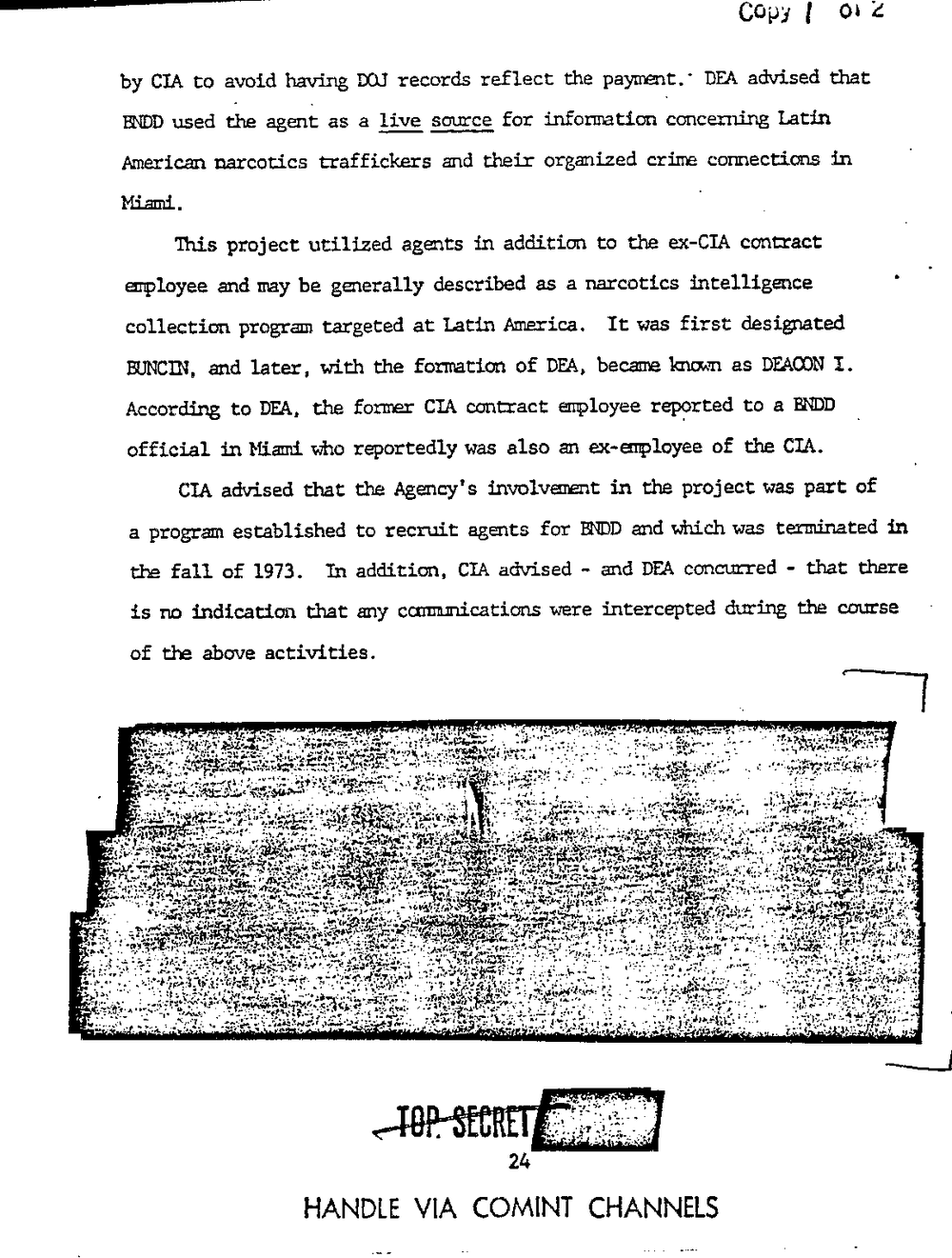
Copy 1 0* '4
by CIA to avoid having DOJ records reflect the payment: DEA advised that
ENDD used agent as a Jig we for information concealing latin
Merican narcotics traffickers and their organized crime cormectiorm in
man-Ii.
This project utilized agents in addition to the contract
employee and?may be generally described as a narcotics intelligence
collection program targeted at Latin America. It was first desigtated
BUNCIN, and later, with the formation of DEA, became knom as DEACDN I.
According to DEA, the former CIA contract employee reported to a ENDD
official in Miami who reportedly was also an ex-anployee of the CIA.
CIA advised that the Agency's J'm'olvermt in the project was part of
a program established to recruit agents for BNDD and which was terminated in
the fall of 1973. In addition, CIA advised - and DEA concurred - that there
is no indication that any ccnnuiications were intercepted during the course
5? (.N
- vowthe above activities?Wisernu. wipe g-I-f? ?it 5.,
I a 3-: air-~43 .
. a? . 41.3. av.?Ihr'n' . . ow -
suspeug?ihfm
-
5'
. .. -. mar-:?of7i?55:1; - .cuggz??mjw?f.55 :23. 1;,1339? hang-i. -. ?31 un?t-?Inifs-'1 -
I w.
'a?hr' -
:o?olsn-NBIHANDLE VIA COMINT CHANNELS
Copy 1 0* '4
by CIA to avoid having DOJ records reflect the payment: DEA advised that
ENDD used agent as a Jig we for information concealing latin
Merican narcotics traffickers and their organized crime cormectiorm in
man-Ii.
This project utilized agents in addition to the contract
employee and?may be generally described as a narcotics intelligence
collection program targeted at Latin America. It was first desigtated
BUNCIN, and later, with the formation of DEA, became knom as DEACDN I.
According to DEA, the former CIA contract employee reported to a ENDD
official in Miami who reportedly was also an ex-anployee of the CIA.
CIA advised that the Agency's J'm'olvermt in the project was part of
a program established to recruit agents for BNDD and which was terminated in
the fall of 1973. In addition, CIA advised - and DEA concurred - that there
is no indication that any ccnnuiications were intercepted during the course
5? (.N
- vowthe above activities?Wisernu. wipe g-I-f? ?it 5.,
I a 3-: air-~43 .
. a? . 41.3. av.?Ihr'n' . . ow -
suspeug?ihfm
-
5'
. .. -. mar-:?of7i?55:1; - .cuggz??mjw?f.55 :23. 1;,1339? hang-i. -. ?31 un?t-?Inifs-'1 -
I w.
'a?hr' -
:o?olsn-NBIHANDLE VIA COMINT CHANNELS
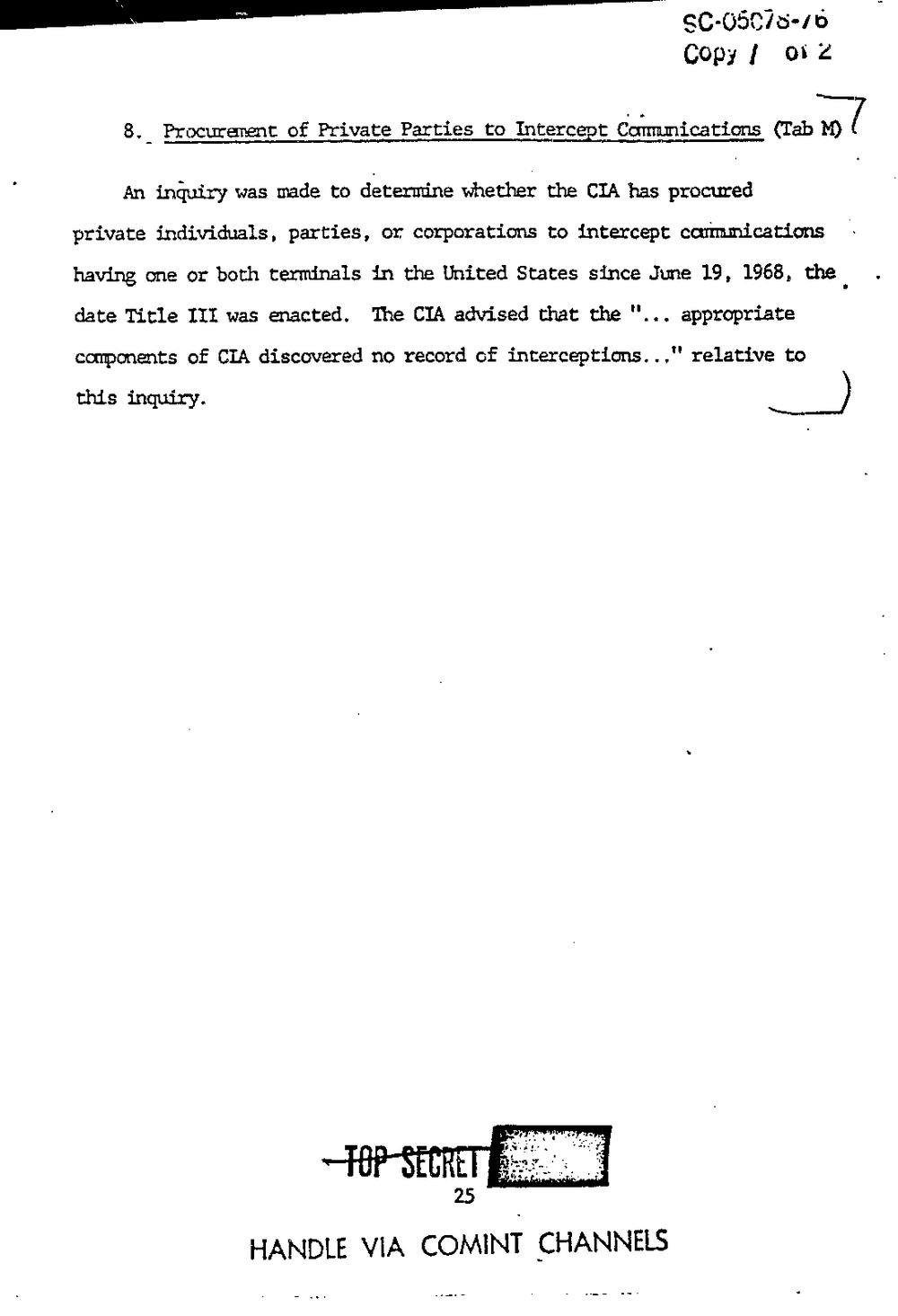
ego-0975.16
00p; I OK 2
h-I?u
Procmanent of Private Parties to Intercept Coinmications (Tab M)
An inEIuiry was made to determine whether the CIA has procured
private individuals, parties, or corporations to intercept cwirmicaticns
having one or both terminals in the United States since June 19, 1968, the .
date Title was enacted. 'Ihe CIA advised that the . appropriate
components of CIA discovered no record of interceptions. . relative to
this
HANDLE COMINT
ego-0975.16
00p; I OK 2
h-I?u
Procmanent of Private Parties to Intercept Coinmications (Tab M)
An inEIuiry was made to determine whether the CIA has procured
private individuals, parties, or corporations to intercept cwirmicaticns
having one or both terminals in the United States since June 19, 1968, the .
date Title was enacted. 'Ihe CIA advised that the . appropriate
components of CIA discovered no record of interceptions. . relative to
this
HANDLE COMINT
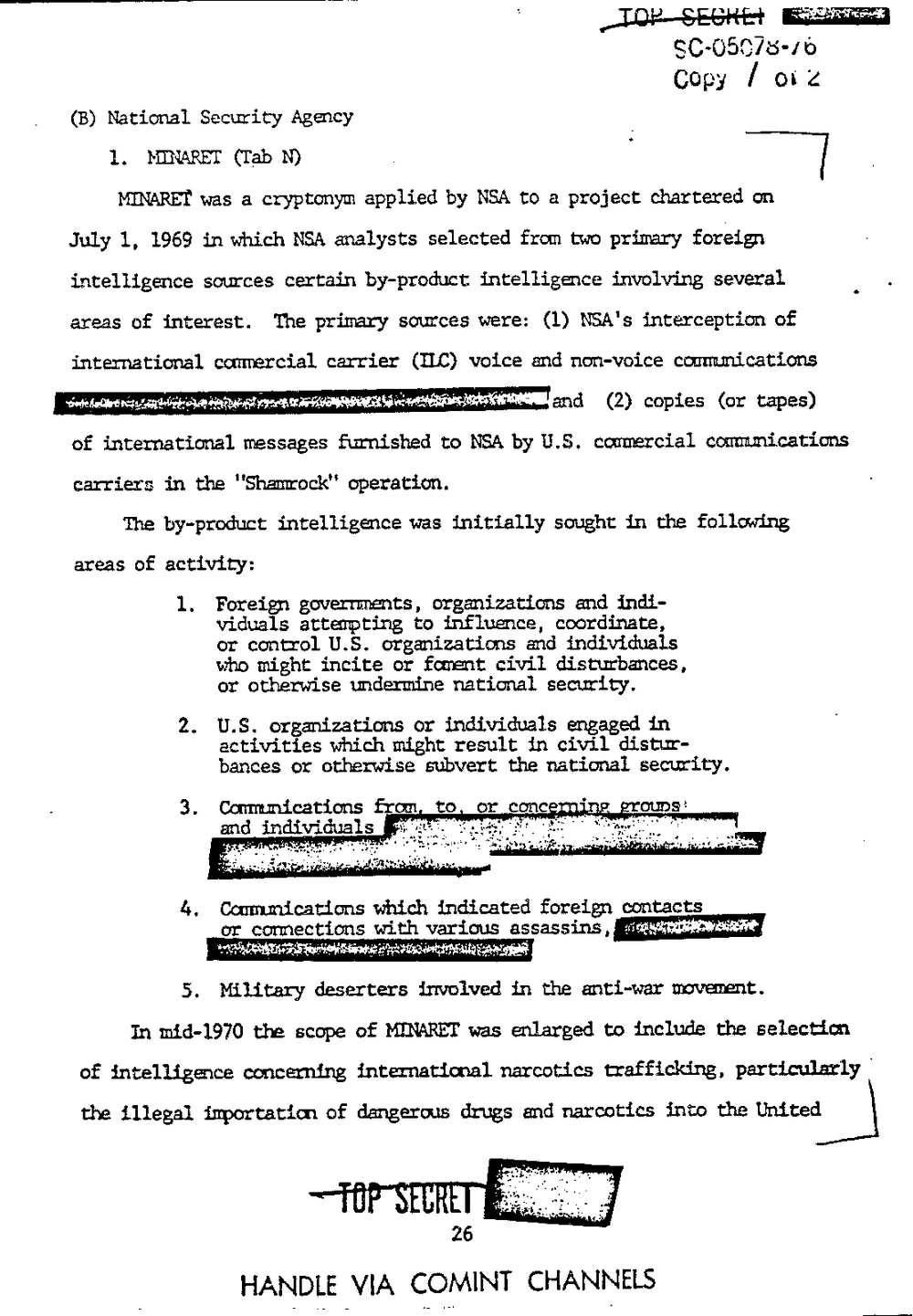
SCI-0507546
Cepy ox
(B) National Security Agency
1. mum: (Tab N) .
PEENAREP was a applied by NSA to a project chartered on
July 1, 1969 in which NSA selected from two primary foreign
intelligence sources certain lay-product intelligence involving several
areas of interest. The primary sources were: (1) NSA's interception of
international commercial carrier (1113) voice and non-voice counmications
and (2) copies (or tapes)
of international messages furnished to NSA by 11.53. commercial communications
carriers in the "Shamrock" operation.
The by-product intelligence was initially sought in the following
areas of activity:
1. Foreig?: goverrments organizations and indi-
viduals attempting to influence, coordinate,
or control U.S. organizations and individuals
who might incite or fonent civil disturbances,
or otherwise mdemine national security.
2. U.S. organizations or individuals engaged in
activities which might result in civil distur-
bances or otherwise subvert the national security.
4. Ccummications which indicated foreign contats
or connections with various assassins, adewmm.
5. Military deserters involved in the anti-war movement.
In mid-1970 the scope of WET was enlarged to include the selection
of intelligmce concerning international narcotics particularly
the illegal importation of dangerous drugs and narcotics into the United
HANDLE VIA COMINT CHANNELS
SCI-0507546
Cepy ox
(B) National Security Agency
1. mum: (Tab N) .
PEENAREP was a applied by NSA to a project chartered on
July 1, 1969 in which NSA selected from two primary foreign
intelligence sources certain lay-product intelligence involving several
areas of interest. The primary sources were: (1) NSA's interception of
international commercial carrier (1113) voice and non-voice counmications
and (2) copies (or tapes)
of international messages furnished to NSA by 11.53. commercial communications
carriers in the "Shamrock" operation.
The by-product intelligence was initially sought in the following
areas of activity:
1. Foreig?: goverrments organizations and indi-
viduals attempting to influence, coordinate,
or control U.S. organizations and individuals
who might incite or fonent civil disturbances,
or otherwise mdemine national security.
2. U.S. organizations or individuals engaged in
activities which might result in civil distur-
bances or otherwise subvert the national security.
4. Ccummications which indicated foreign contats
or connections with various assassins, adewmm.
5. Military deserters involved in the anti-war movement.
In mid-1970 the scope of WET was enlarged to include the selection
of intelligmce concerning international narcotics particularly
the illegal importation of dangerous drugs and narcotics into the United
HANDLE VIA COMINT CHANNELS
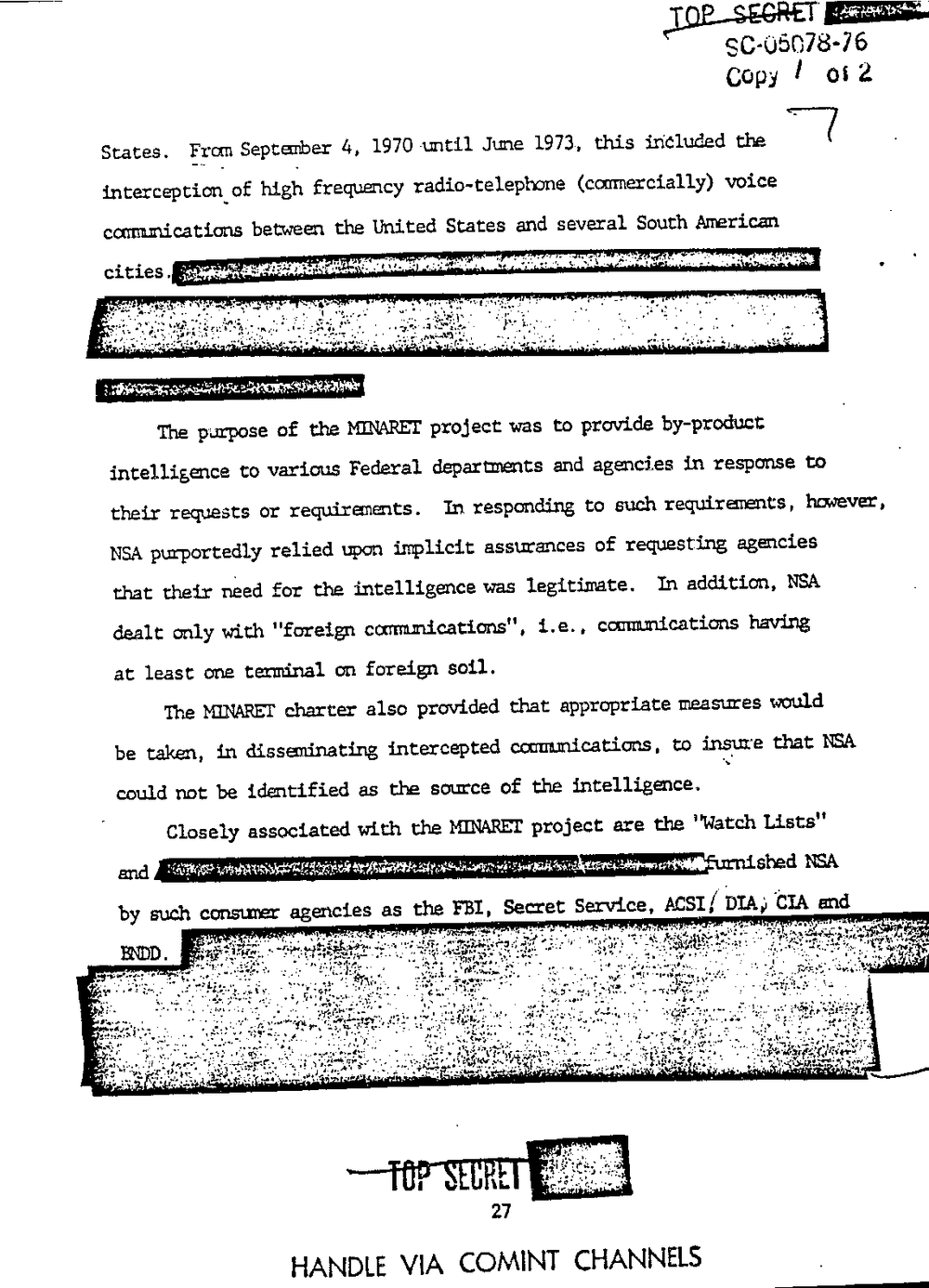
COpy I 0i 2
States. September 4, 1970 until June 1973?, this included the
interception_ of high frequency radio-telephone (coumercially) voice
cotmmications between the United States and several South American
The purpose of the project was to provide lay-product
intelligence to various Federal departments and agencies in response to
their requests or requirements. In. responding to such requirements, however,
NBA purportedly relied upon implicit assm'ances of requesting agencies
that their naed for the intelligence was legitimate. In addition, NSA
dealt only with "foreign cormnmications", i.e. canmnications having
at least one terminal on foreign soil.
The WET charter also provided that appropriate measures would
be taken, in dissen?nating intercepted coommications, to insure that NBA
could not be identified as the source of the intelligence.
Closely associated with the project are the "Watch Lists"
- . shed NSA
by such consumer agencies as the FBI, Secret Service:24up?: 553?. my" . 1.7
menu - Mia;
.
-
HANDLE VIA COMINT CHANNELS
COpy I 0i 2
States. September 4, 1970 until June 1973?, this included the
interception_ of high frequency radio-telephone (coumercially) voice
cotmmications between the United States and several South American
The purpose of the project was to provide lay-product
intelligence to various Federal departments and agencies in response to
their requests or requirements. In. responding to such requirements, however,
NBA purportedly relied upon implicit assm'ances of requesting agencies
that their naed for the intelligence was legitimate. In addition, NSA
dealt only with "foreign cormnmications", i.e. canmnications having
at least one terminal on foreign soil.
The WET charter also provided that appropriate measures would
be taken, in dissen?nating intercepted coommications, to insure that NBA
could not be identified as the source of the intelligence.
Closely associated with the project are the "Watch Lists"
- . shed NSA
by such consumer agencies as the FBI, Secret Service:24up?: 553?. my" . 1.7
menu - Mia;
.
-
HANDLE VIA COMINT CHANNELS
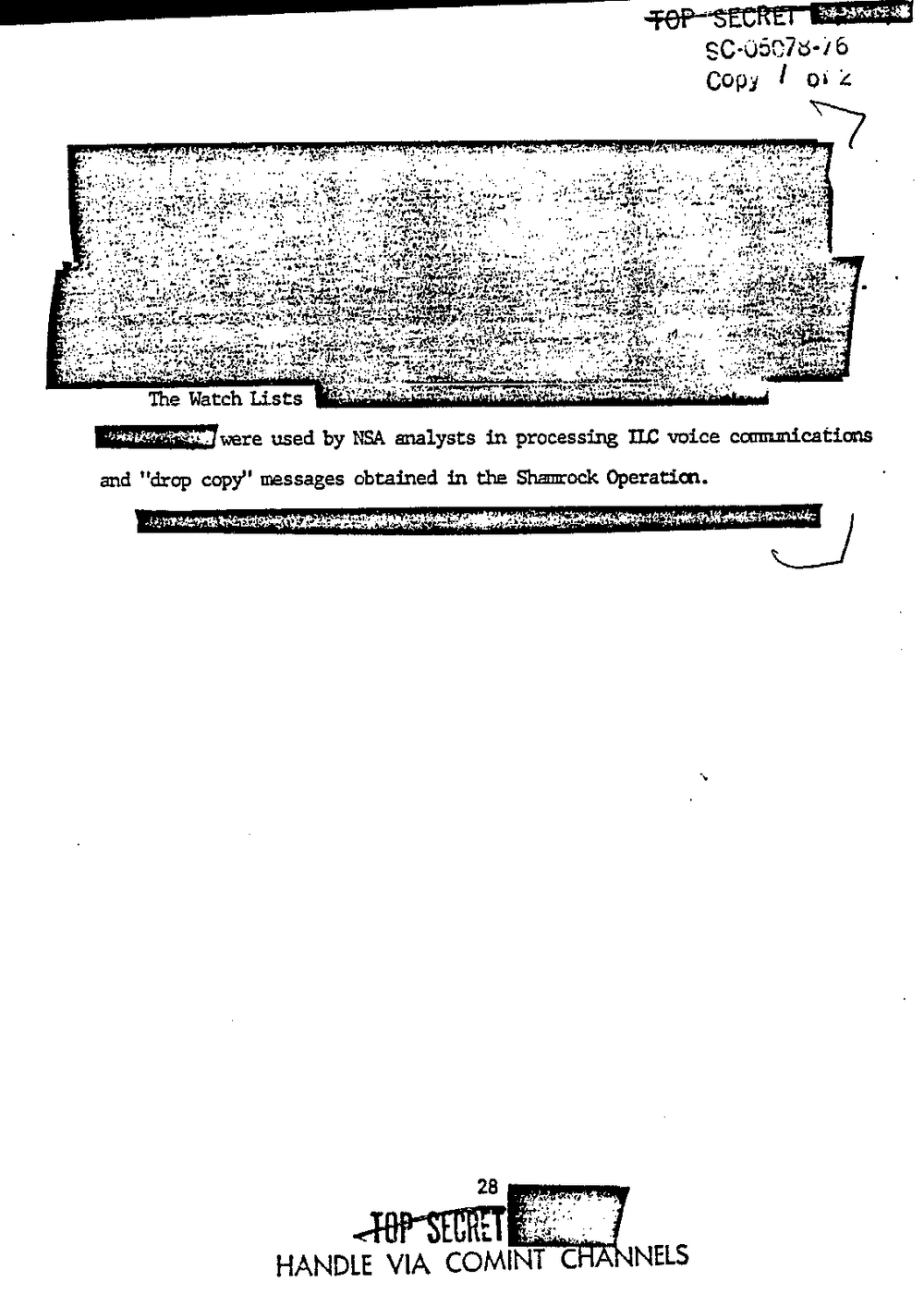
500507646
Copy 0?2
3- w,
..
"inqul'u
.
unr-w 1' Imam-Inn
. ?g
. . .
were used by NSA in processing I18 voice communications
and "drop copy" messages obtained in the Shamrock Operatim.
500507646
Copy 0?2
3- w,
..
"inqul'u
.
unr-w 1' Imam-Inn
. ?g
. . .
were used by NSA in processing I18 voice communications
and "drop copy" messages obtained in the Shamrock Operatim.
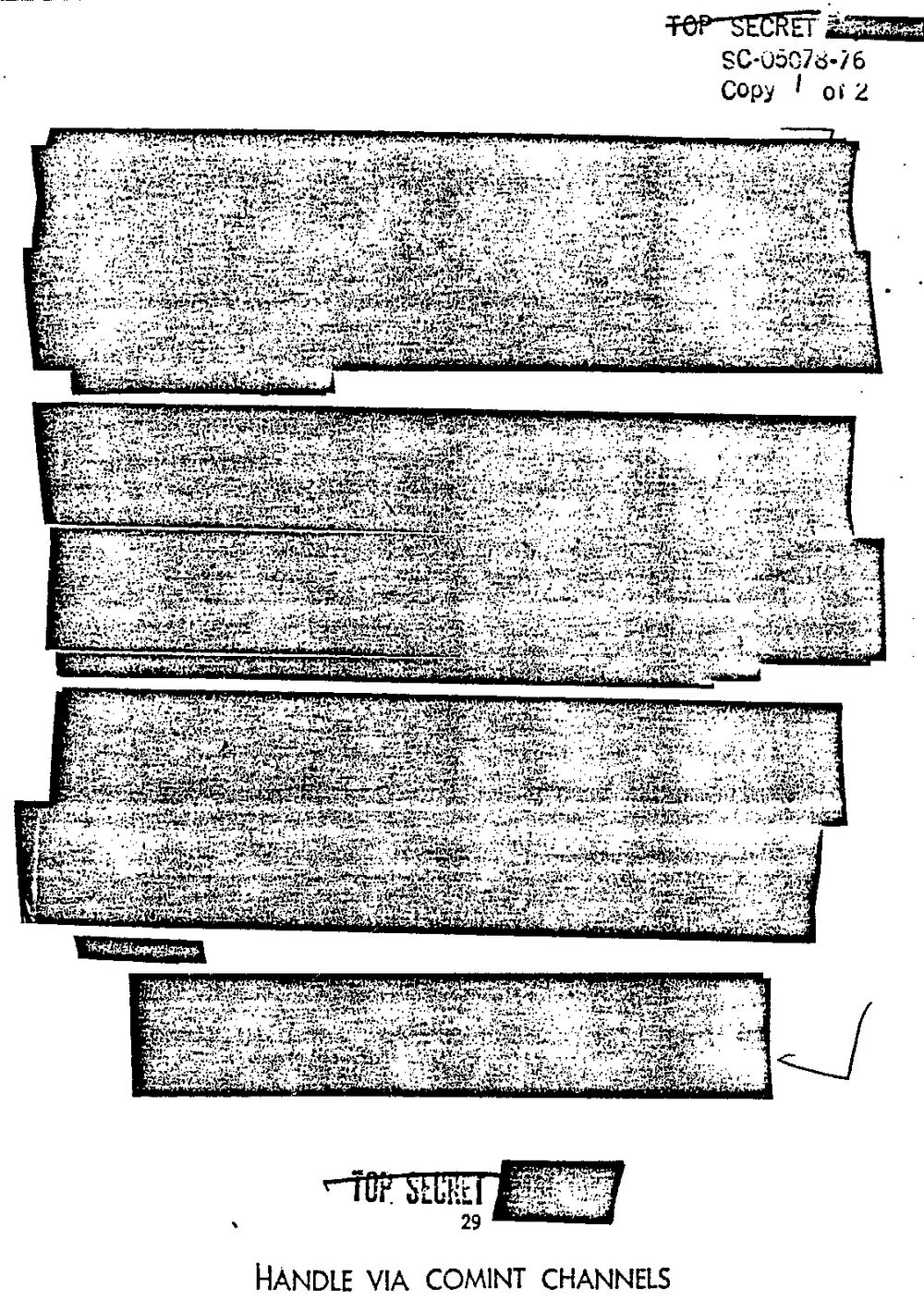
80050-7646
0093 0"nu-gm:- .-
?rst?
- ?Sf?e'?3h??gaw
1? .V.
0.
.
?ain'sinIt.
5:23.?
'1 fax! .
.
.
a'tfg
-- Vs?n.41?Eh-Fri"
I .. 5.1
IL".ng 13""
A I I
-I "gnu-o'avg-f: I
a" 5.315,. .3 ?4 4,2? (r Ergy?j
.
if
. . tit'33- . .
- 121,5 -, 2.:
I
.
*u-wu 5?
sh}
v3." r. by r?
. h'
"93-14"
HANDLE VIA COMINT CHANNELS
80050-7646
0093 0"nu-gm:- .-
?rst?
- ?Sf?e'?3h??gaw
1? .V.
0.
.
?ain'sinIt.
5:23.?
'1 fax! .
.
.
a'tfg
-- Vs?n.41?Eh-Fri"
I .. 5.1
IL".ng 13""
A I I
-I "gnu-o'avg-f: I
a" 5.315,. .3 ?4 4,2? (r Ergy?j
.
if
. . tit'33- . .
- 121,5 -, 2.:
I
.
*u-wu 5?
sh}
v3." r. by r?
. h'
"93-14"
HANDLE VIA COMINT CHANNELS
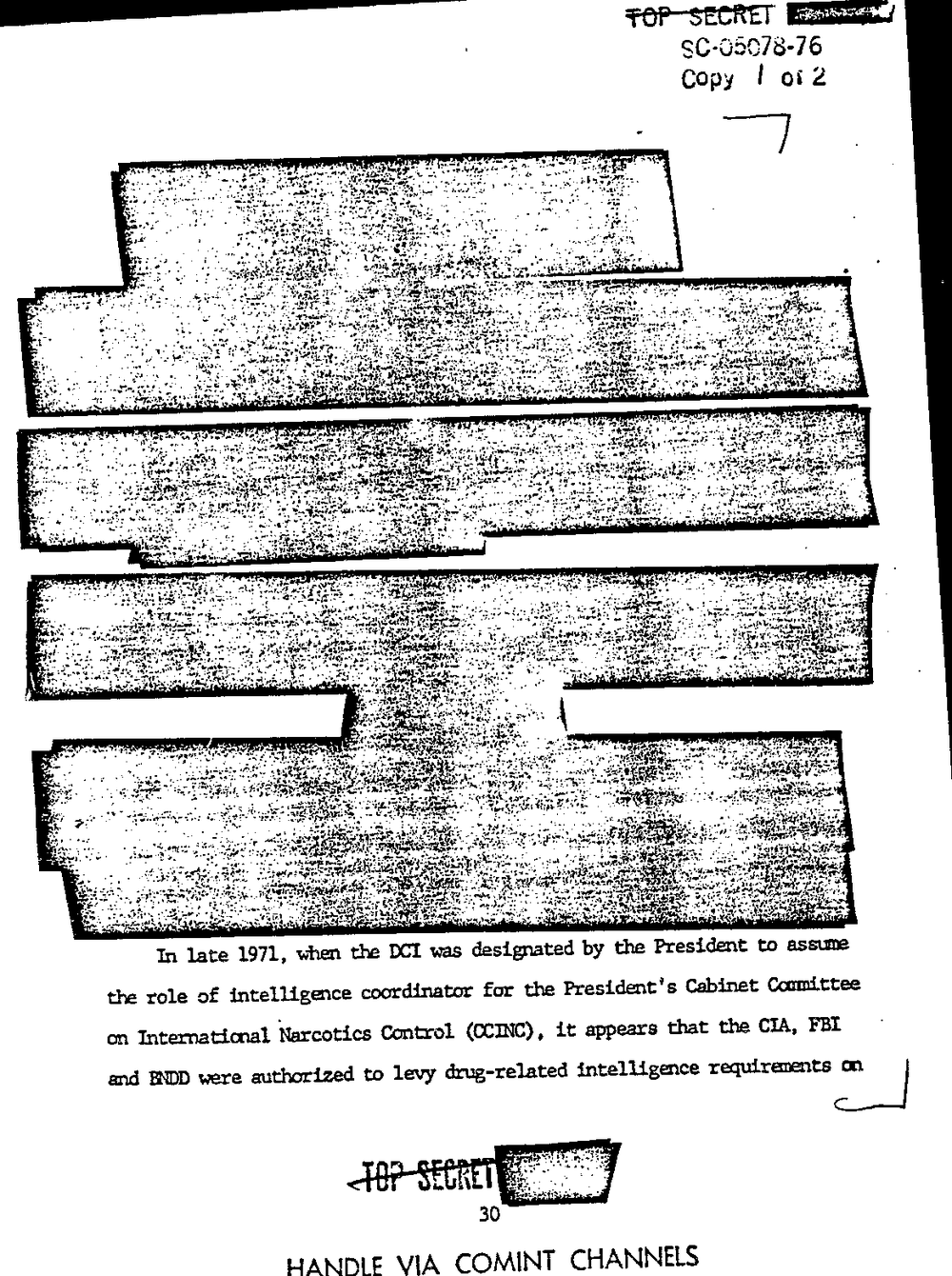
800507806
com .wr"
.
.
Sui{Nb
?dli I .
.
1
. .
'd?i?mul'?v
Ere-x
I . .
9 41
"::1'1 1'
b: 1
i.
I. 7?19late 1971, when the DCI was designated by the President to assume
the role of intelligence coordinator for the Presidmt's Cabinet Cmittee
on Internatimal Narcotics Control (GOING) it appears that the CIA, FBI
and MD were authorized to levy dung-related intelligence requirements tn
HANDLE VIA COMINT CHANNELS
800507806
com .wr"
.
.
Sui{Nb
?dli I .
.
1
. .
'd?i?mul'?v
Ere-x
I . .
9 41
"::1'1 1'
b: 1
i.
I. 7?19late 1971, when the DCI was designated by the President to assume
the role of intelligence coordinator for the Presidmt's Cabinet Cmittee
on Internatimal Narcotics Control (GOING) it appears that the CIA, FBI
and MD were authorized to levy dung-related intelligence requirements tn
HANDLE VIA COMINT CHANNELS
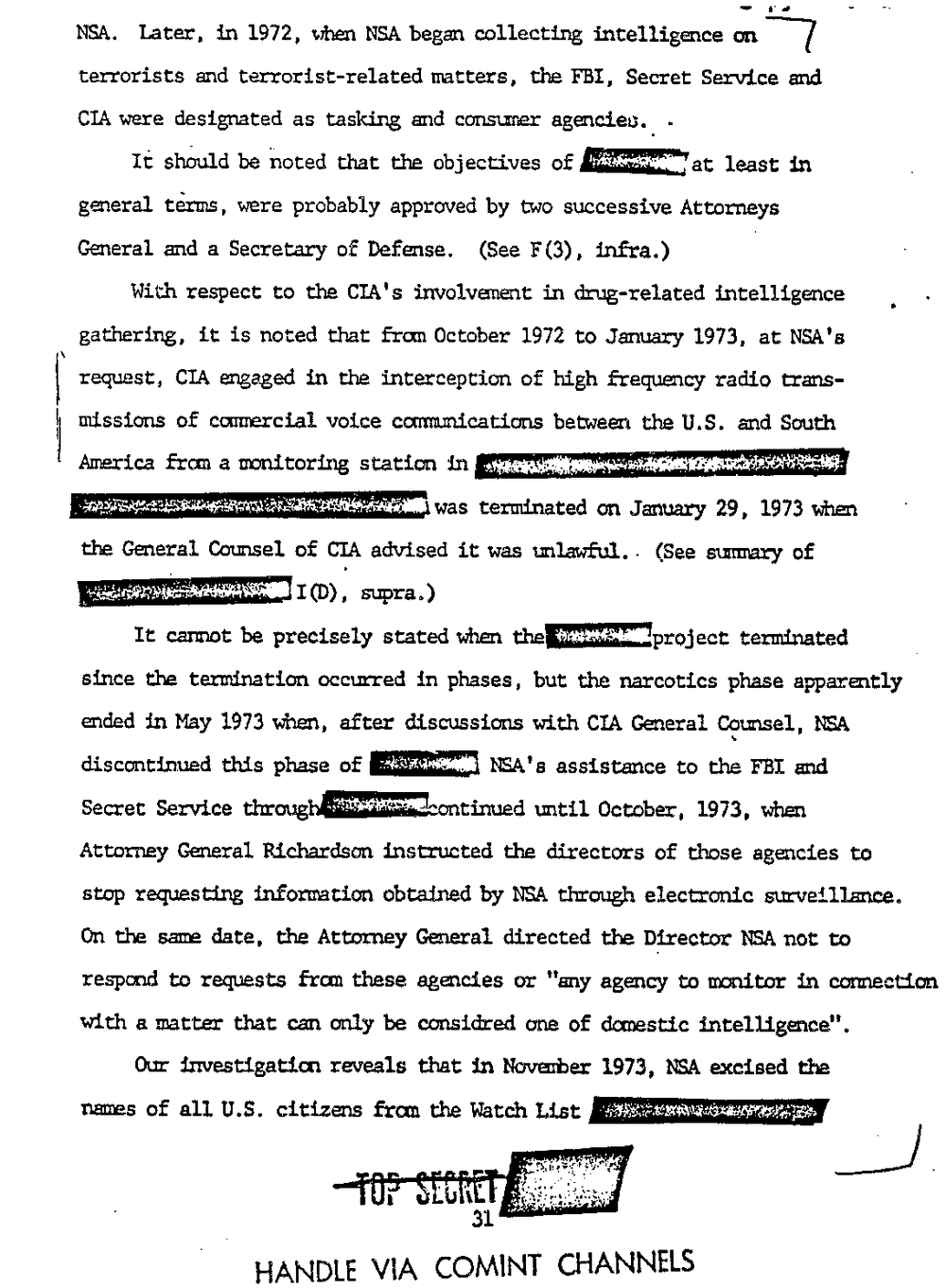
ll
NSA. Later, in 1972, men NSA began collecting intelligence on .7
terrorists and terrorist-related matters, the FBI, Secret Service and
CIA were designated as tasking and consumer agencies. -
It should be noted that the objectives of at least in
general terms, were probably approved by two successive Attorneys
General and a Secretary of Defense. (See infra.) .
With respect to the CIA's involvement in drug-related intelligence
gathering, it is noted that from October 1972 to January 1973, at
request, CIA engaged in the interception of high frequency radio trans-
missions of connercial voice coronmications between the U.S. and South
America from a monitoring station in
was terminated on January 29. 1973 when
the Gmeral Counsel of CIA advised it was mlawful.- (See suImIary of
It cannot be precisely stated when theWproject terminated .
since the termination occurred in phases, but the narcotics phase apparently
ended in May 1973 when, after discussions with CIA General Counsel, NSA
discontinued this phase of NSA's assistance to the FBI and
Secret Service drummed until October, 1973, when
Attorney General Richardson instructed the directors of those agmcies to
stop requesting information obtained by NSA through electronic surveillmce.
On the same date, the Attorney General directed the Director NSA not to
respond to requests from these agencies or "any agency to miter in comection
with a matter that can only be considred one of dunestic intelligence".
Our irwestigetim reveals that in Noverber 1973, NSA excised the
nanes of all U.S. citizens the Watch List seneememene
HANDLE CHANNELS
ll
NSA. Later, in 1972, men NSA began collecting intelligence on .7
terrorists and terrorist-related matters, the FBI, Secret Service and
CIA were designated as tasking and consumer agencies. -
It should be noted that the objectives of at least in
general terms, were probably approved by two successive Attorneys
General and a Secretary of Defense. (See infra.) .
With respect to the CIA's involvement in drug-related intelligence
gathering, it is noted that from October 1972 to January 1973, at
request, CIA engaged in the interception of high frequency radio trans-
missions of connercial voice coronmications between the U.S. and South
America from a monitoring station in
was terminated on January 29. 1973 when
the Gmeral Counsel of CIA advised it was mlawful.- (See suImIary of
It cannot be precisely stated when theWproject terminated .
since the termination occurred in phases, but the narcotics phase apparently
ended in May 1973 when, after discussions with CIA General Counsel, NSA
discontinued this phase of NSA's assistance to the FBI and
Secret Service drummed until October, 1973, when
Attorney General Richardson instructed the directors of those agmcies to
stop requesting information obtained by NSA through electronic surveillmce.
On the same date, the Attorney General directed the Director NSA not to
respond to requests from these agencies or "any agency to miter in comection
with a matter that can only be considred one of dunestic intelligence".
Our irwestigetim reveals that in Noverber 1973, NSA excised the
nanes of all U.S. citizens the Watch List seneememene
HANDLE CHANNELS
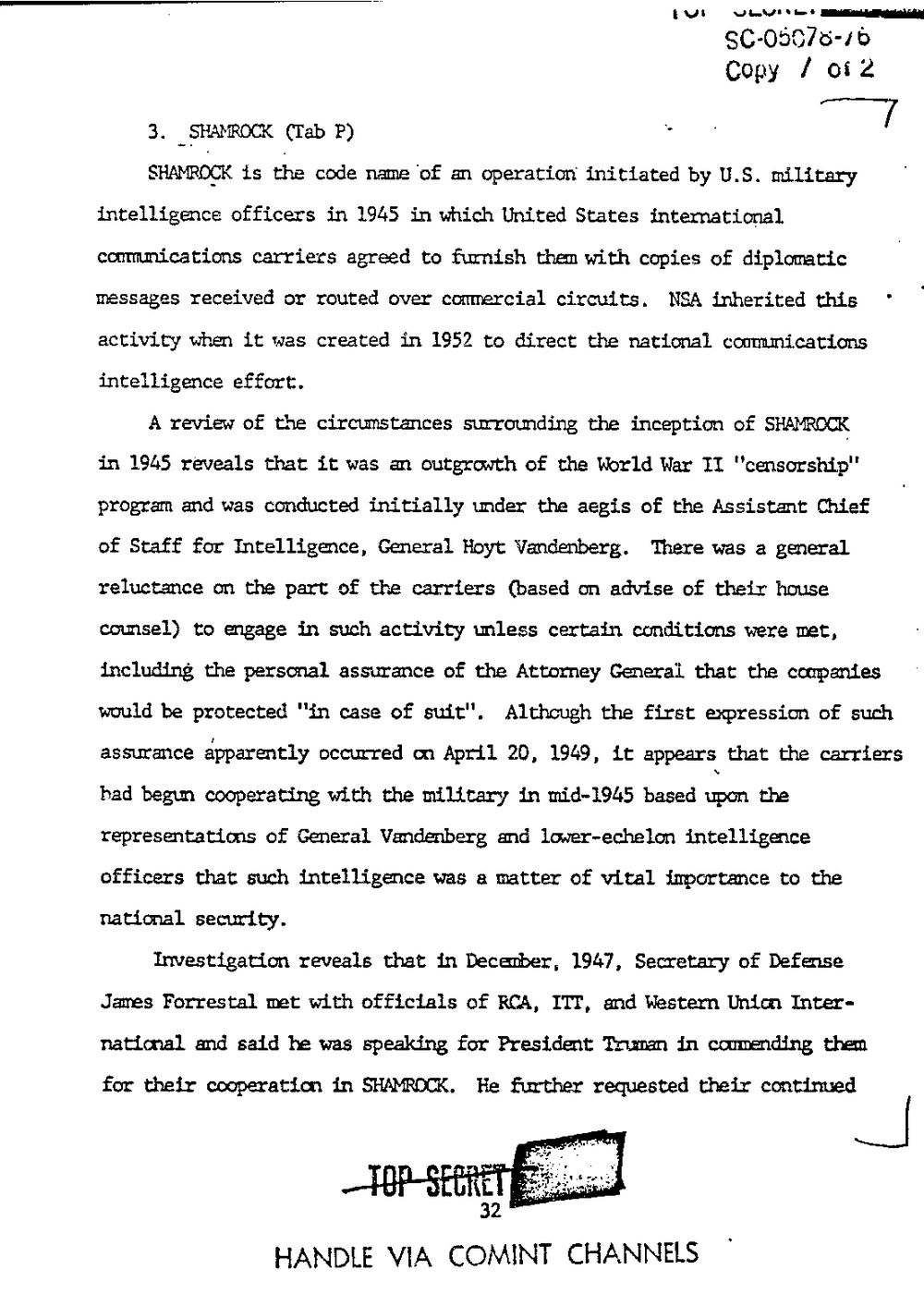
nun
80-05075-16
Copy 052
3. (Tab P)
is code name 'of an operation" initiated by U.S. military
intelligence officers in 1945 in which United States international
communications carriers agreed to furnish them with copies of diplomatic
messages received or routed over commercial circuits. NSA inherited this
activity Wen it was created in 195?. to direct the national communications
intelligence effort.
A review of the circumstances surrounding the inception of SW
in 1945 reveals that it was an outgrowth of the World War II "censorship"
program and was conducted initially under the aegis of the Assistmt Chief
of Staff for Intelligence, General Hoyt Vanderberg. There was a general
reluctance on the part of the carriers (based on advise of their house
counsel) to engage in such activity unless certain conditions were met,
including the personal assurance of the Attorney General that the ccmpanies
would be protected "in case of suit". Although the first expression of such
assurance apparently occurred on April 20, 1949, it appears that the carriers
had begun cooperating with the military in mid-1945 based upon the
representations of General Vandenberg and lower-echelon intelligmce
officers that such intelligence was a matter of vital importance to the
national security.
Investigation reveals that in Decanber. 1947, Secretary of Defense
James Forrestal met with officials of RCA, and Western Union Inter-
natimal and said he was speaking for President Tainan in cmmending than
for their cooperation in W. He further requested their continued
HANDLE VIA COMINT CHANNELS
nun
80-05075-16
Copy 052
3. (Tab P)
is code name 'of an operation" initiated by U.S. military
intelligence officers in 1945 in which United States international
communications carriers agreed to furnish them with copies of diplomatic
messages received or routed over commercial circuits. NSA inherited this
activity Wen it was created in 195?. to direct the national communications
intelligence effort.
A review of the circumstances surrounding the inception of SW
in 1945 reveals that it was an outgrowth of the World War II "censorship"
program and was conducted initially under the aegis of the Assistmt Chief
of Staff for Intelligence, General Hoyt Vanderberg. There was a general
reluctance on the part of the carriers (based on advise of their house
counsel) to engage in such activity unless certain conditions were met,
including the personal assurance of the Attorney General that the ccmpanies
would be protected "in case of suit". Although the first expression of such
assurance apparently occurred on April 20, 1949, it appears that the carriers
had begun cooperating with the military in mid-1945 based upon the
representations of General Vandenberg and lower-echelon intelligmce
officers that such intelligence was a matter of vital importance to the
national security.
Investigation reveals that in Decanber. 1947, Secretary of Defense
James Forrestal met with officials of RCA, and Western Union Inter-
natimal and said he was speaking for President Tainan in cmmending than
for their cooperation in W. He further requested their continued
HANDLE VIA COMINT CHANNELS
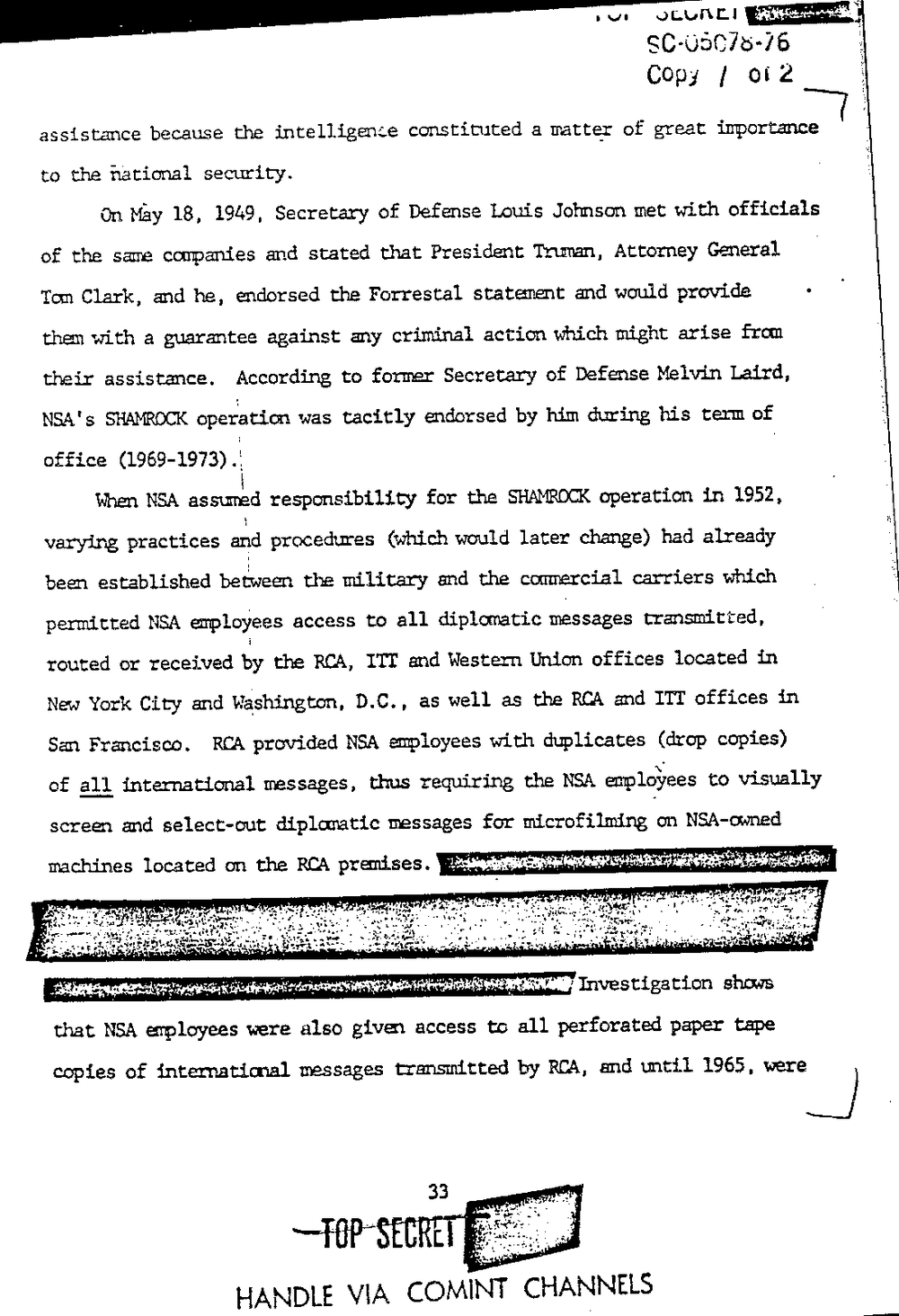
. u. ouuntl
COpy I 0i 2
assistance because the intelligence constituted a matter of great importance
to the national security.
On May 18, 1949, Secretary of Defense Louis Johnson met with officials
of the same companies and stated that President 'I?runan, Attorney General
Tom Clark, and he, endorsed the Forrestal statenent and would provide
them with a guarantee against any criminal action which might arise from
their assistance. According to former Secretary of Defense Melvin Laird,
NSA's SHAMROCK operation was tacitly endorsed by him during his term of
office
When NSA assum?ed responsibility for the SHAMROCK operation in 1952,
varying practices and procedures (which would later change) had already
been established batween the military and the ccxmercial carriers which
permitted NSA employees access to all diplomatic messages transmitted,
routed or received by the RCA, HT and Western Union offices located in
New York City and washington, D.C. as well as the RCA and HT offices in
San Francisco. RCA provided NSA employees with duplicates (drop copies)
of all international messages, thus requiring the NSA employees to visually
screen and select-out diplomatic messages for microfilming on NSA?onmed
machines located on the RCA premisesinIn.? o' .- Irwtil 5., ?it-.nFHf-ojft.? Iii?Va-i? ?In135-21:"Investigation shows
that NSA arployees were also given access to all perforated paper tape
copies of international messages transmitted by RCA, and until 1965, were
33 a
asp-*-
HANDLE VIA COMINT CHANNELS
. u. ouuntl
COpy I 0i 2
assistance because the intelligence constituted a matter of great importance
to the national security.
On May 18, 1949, Secretary of Defense Louis Johnson met with officials
of the same companies and stated that President 'I?runan, Attorney General
Tom Clark, and he, endorsed the Forrestal statenent and would provide
them with a guarantee against any criminal action which might arise from
their assistance. According to former Secretary of Defense Melvin Laird,
NSA's SHAMROCK operation was tacitly endorsed by him during his term of
office
When NSA assum?ed responsibility for the SHAMROCK operation in 1952,
varying practices and procedures (which would later change) had already
been established batween the military and the ccxmercial carriers which
permitted NSA employees access to all diplomatic messages transmitted,
routed or received by the RCA, HT and Western Union offices located in
New York City and washington, D.C. as well as the RCA and HT offices in
San Francisco. RCA provided NSA employees with duplicates (drop copies)
of all international messages, thus requiring the NSA employees to visually
screen and select-out diplomatic messages for microfilming on NSA?onmed
machines located on the RCA premisesinIn.? o' .- Irwtil 5., ?it-.nFHf-ojft.? Iii?Va-i? ?In135-21:"Investigation shows
that NSA arployees were also given access to all perforated paper tape
copies of international messages transmitted by RCA, and until 1965, were
33 a
asp-*-
HANDLE VIA COMINT CHANNELS
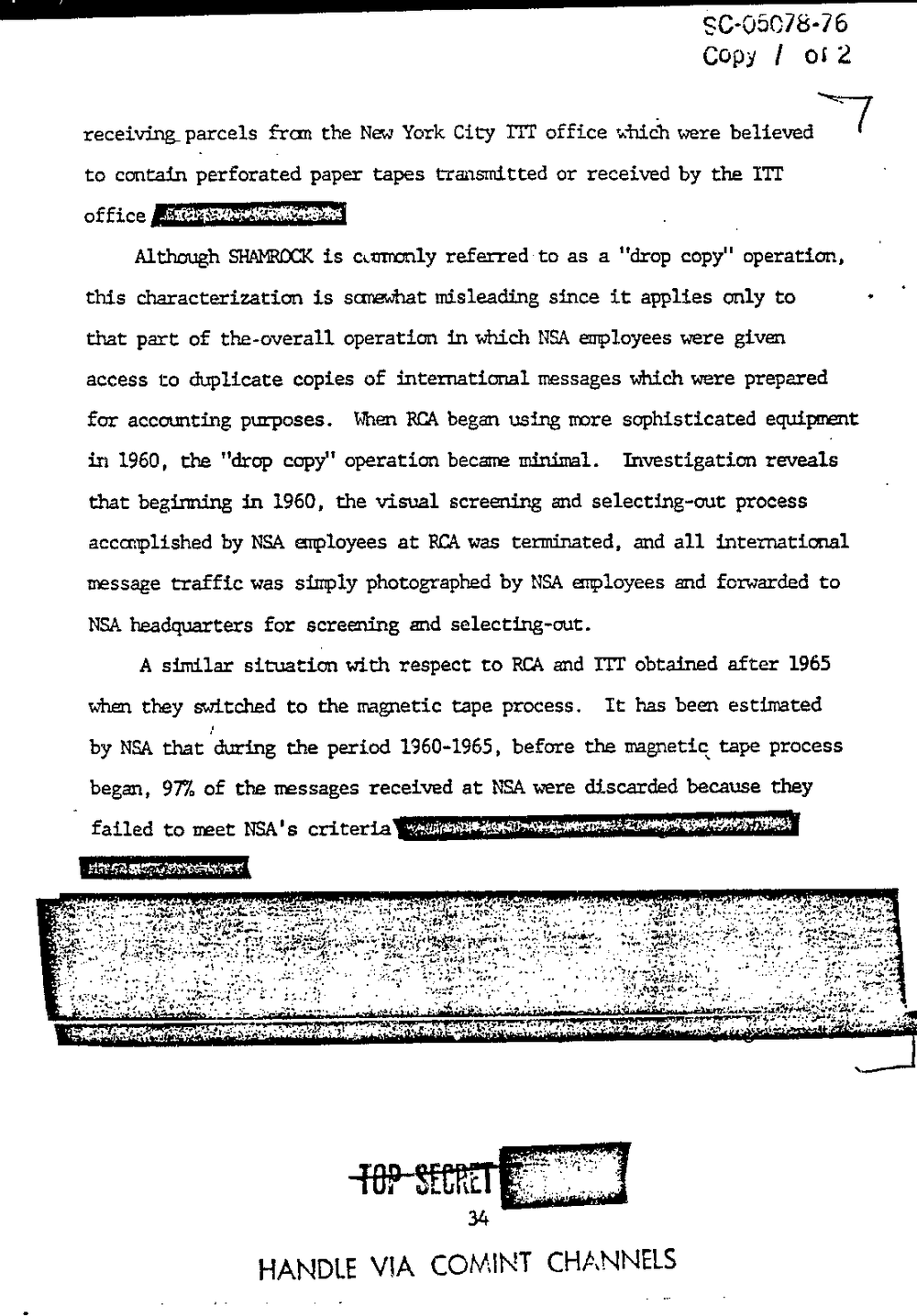
80-05078-76
Copy I or 2
receiving parcels from the New York City office which were believed?
to contain perforated paper tapes or received by the HT
office I
Although SEW is cmnonly referred-to as a "drop copy" operation.
this characterization is smavhat misleading since it applies only to -
that part of the-overall operation in which NSA employees were given
access to duplicate copies of international messages which were prepared
for accounting purposes. When RCA began using more sophisticated equipmmt
in 1960, the "drop copy" operation became minimal. Investigation reveals
that beginning in 1960, the visual screening and selecting?out process
accomplished by NSA employees at Rm was terminated, and all international
message traffic was simply photographed by NSA employees and forwarded to
NSA headquarters for screening and selecting-out.
A similar situation with respect to RCA and HT obtained after 1965
vim they switched to the magnetic tape process. It has been estimated
by NSA that during the period 1960-1965, before the magnetic; tape process
began, 97% of the messages received at NSA were discarded because they
failed to meet NSA's criteria
.
HANDLE VIA COMINT CHANNELS
80-05078-76
Copy I or 2
receiving parcels from the New York City office which were believed?
to contain perforated paper tapes or received by the HT
office I
Although SEW is cmnonly referred-to as a "drop copy" operation.
this characterization is smavhat misleading since it applies only to -
that part of the-overall operation in which NSA employees were given
access to duplicate copies of international messages which were prepared
for accounting purposes. When RCA began using more sophisticated equipmmt
in 1960, the "drop copy" operation became minimal. Investigation reveals
that beginning in 1960, the visual screening and selecting?out process
accomplished by NSA employees at Rm was terminated, and all international
message traffic was simply photographed by NSA employees and forwarded to
NSA headquarters for screening and selecting-out.
A similar situation with respect to RCA and HT obtained after 1965
vim they switched to the magnetic tape process. It has been estimated
by NSA that during the period 1960-1965, before the magnetic; tape process
began, 97% of the messages received at NSA were discarded because they
failed to meet NSA's criteria
.
HANDLE VIA COMINT CHANNELS
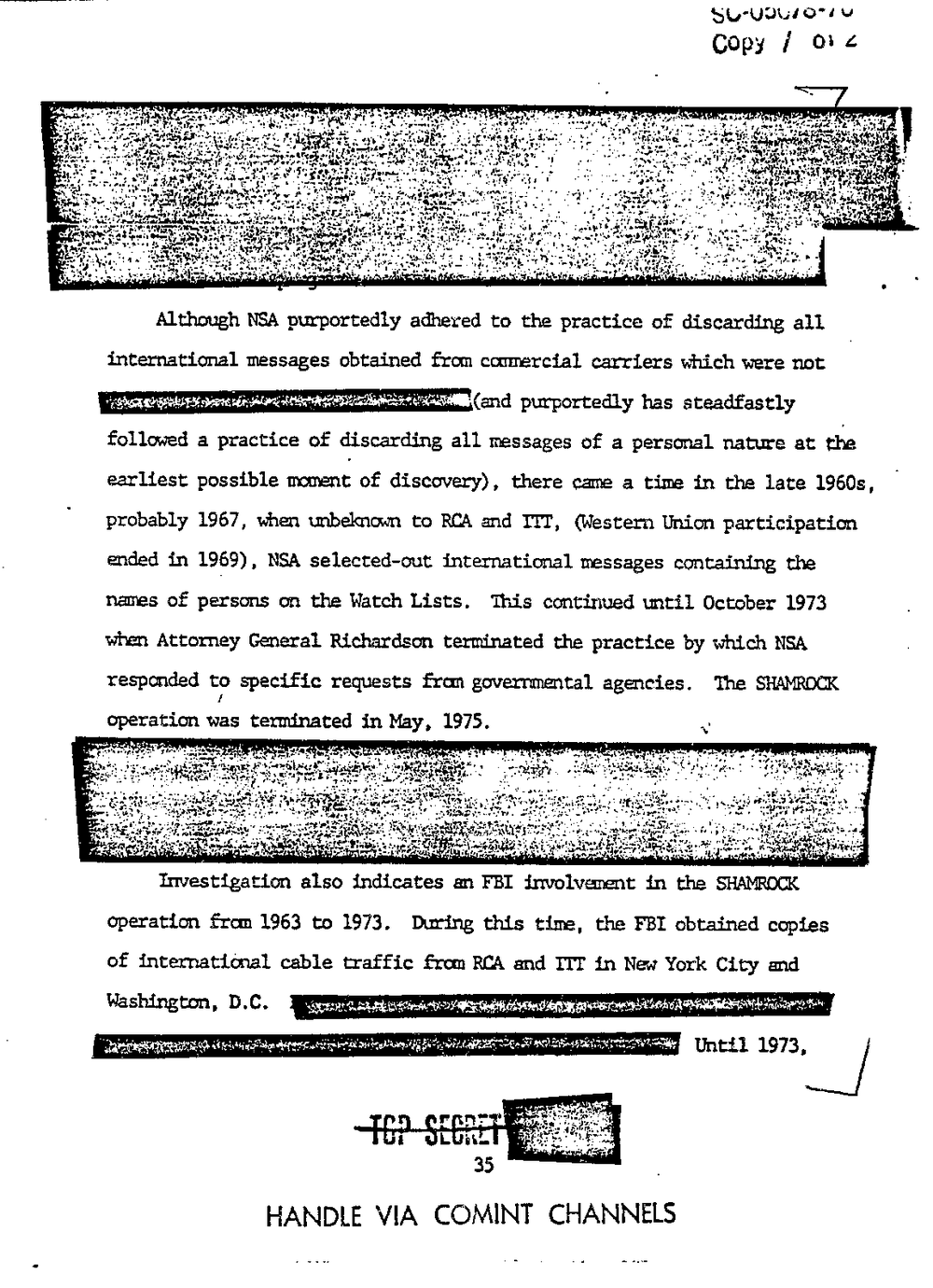
Copy 1"l?
?Turin:
Although NSA purportedly adhered to the practice of discarding all
international messages obtained from commercial carriers which were not
followed a practice of discarding all messages of a personal nature at
earliest possible of discovery) there came a time in the late 19605.
probably 1967, than imbeknown to RCA and HT, (Western Union participation
ended in 1969), NSA selected-out international messages containing the
names of persons on the Watch Lists. 'Ihis continued until October 1973
when Attorney General Richardson tenm?nated the practice by which NSA
responded to specific requests from agencies. The
Operation was terminated in May, 1975.
.-
I
.-.. 1p:?'aamhni'tg9:Ifhlni ?t?mwuw?, .. anyIva-3FBI Movexmt in the
Operation from 1963 to 1973. Ming this time, the FBI obtained copies
of internatimal cable traffic from RCA and in New York City and
Wasl'dngton, D.C.
Investigation also indica
Until 1973,
?ea-?ream;
Copy 1"l?
?Turin:
Although NSA purportedly adhered to the practice of discarding all
international messages obtained from commercial carriers which were not
followed a practice of discarding all messages of a personal nature at
earliest possible of discovery) there came a time in the late 19605.
probably 1967, than imbeknown to RCA and HT, (Western Union participation
ended in 1969), NSA selected-out international messages containing the
names of persons on the Watch Lists. 'Ihis continued until October 1973
when Attorney General Richardson tenm?nated the practice by which NSA
responded to specific requests from agencies. The
Operation was terminated in May, 1975.
.-
I
.-.. 1p:?'aamhni'tg9:Ifhlni ?t?mwuw?, .. anyIva-3FBI Movexmt in the
Operation from 1963 to 1973. Ming this time, the FBI obtained copies
of internatimal cable traffic from RCA and in New York City and
Wasl'dngton, D.C.
Investigation also indica
Until 1973,
?ea-?ream;
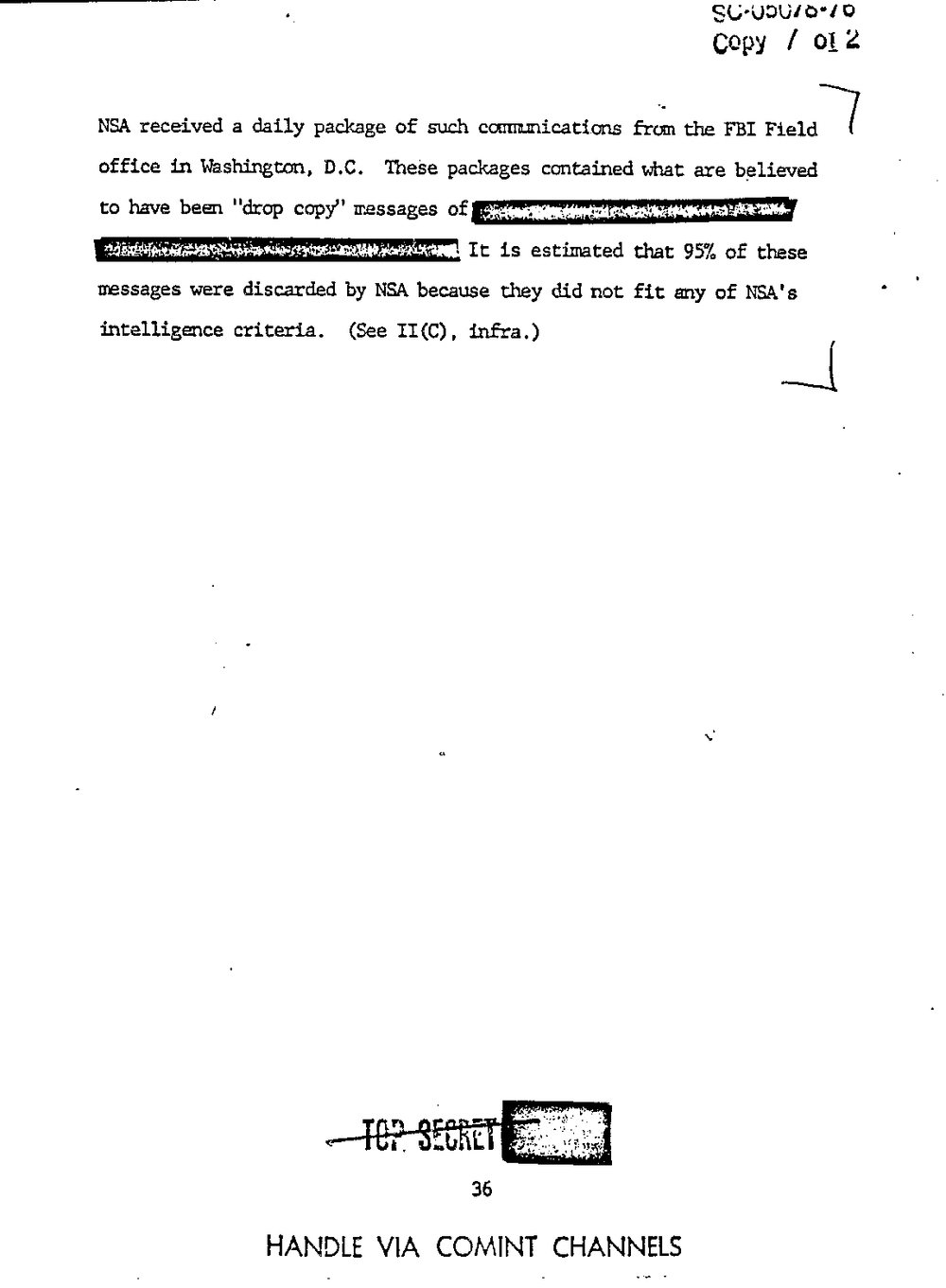
Su-gaUlo-lo
Copy 01?-
NSA received a daily package of such cormmications from the FBI Helm-17
office in Washington, 13.6. These packages contained what are believed
to have been "drop copy" messages of . .
messages were discarded by NSA because they did not fit any of NSA's
4
intelligence criteria. (See infra.)
I. ah
HANDLE VIA COMINT CHANNELS
Su-gaUlo-lo
Copy 01?-
NSA received a daily package of such cormmications from the FBI Helm-17
office in Washington, 13.6. These packages contained what are believed
to have been "drop copy" messages of . .
messages were discarded by NSA because they did not fit any of NSA's
4
intelligence criteria. (See infra.)
I. ah
HANDLE VIA COMINT CHANNELS
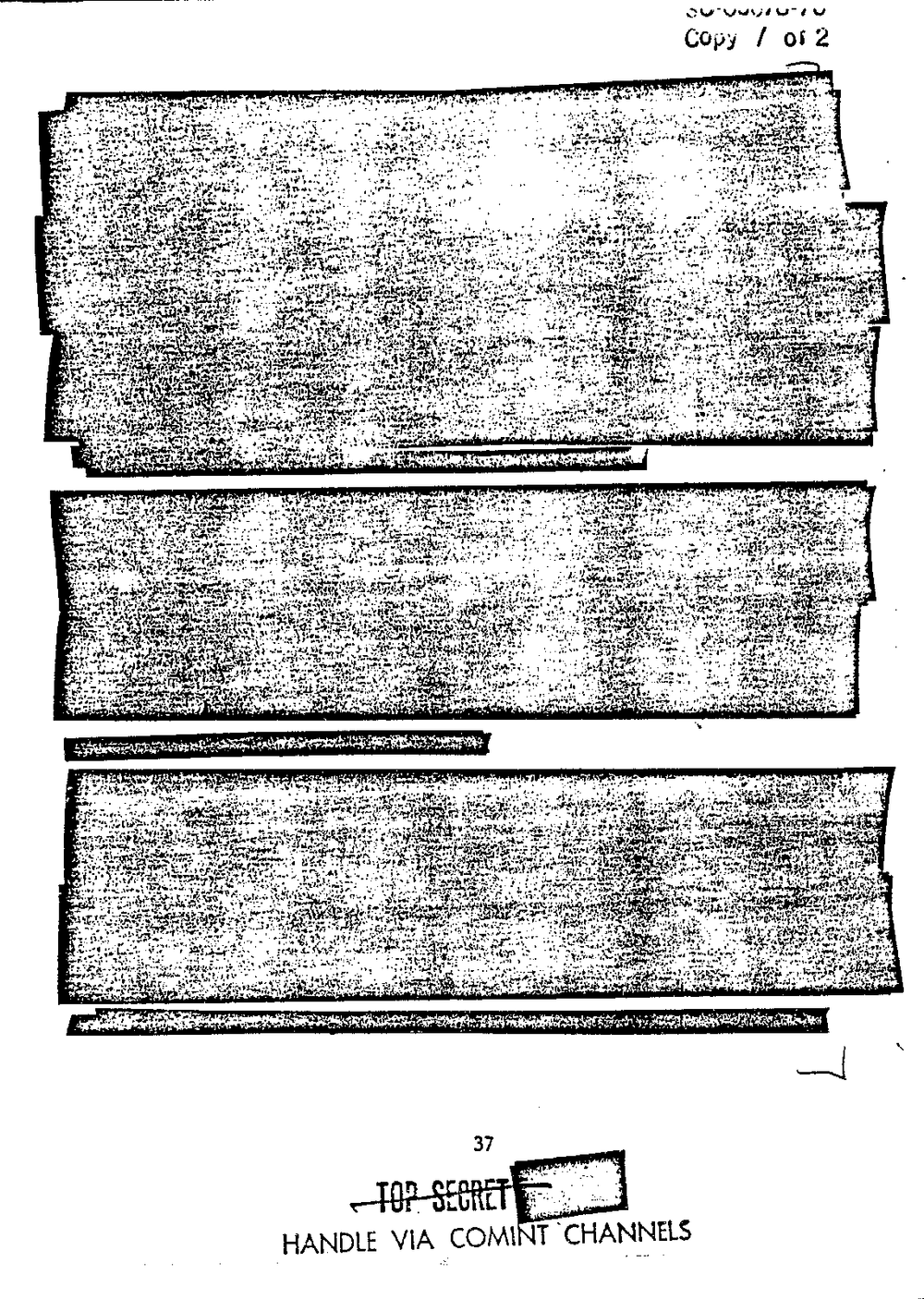
Uup";
v1.5
..
a)
{viz-J" . ..- .547.
I'l'llu -
-. -. .v
'J-Qvlu?<
. "?53,31733,
(:?Ia?rhh'.507psi; neg-5393:3575
- .
am: new! - .-,
.- 9'45
l. .
l-giant, -
?1
.
..
3"
xvii-35f
. I. u. 1?
r- m. . 131:13?!
i Ia-
{Orr-05. urn3341?;va 5'
.. .-.- ..3111?llafm3HANDLE VIA CHANNELS
Uup";
v1.5
..
a)
{viz-J" . ..- .547.
I'l'llu -
-. -. .v
'J-Qvlu?<
. "?53,31733,
(:?Ia?rhh'.507psi; neg-5393:3575
- .
am: new! - .-,
.- 9'45
l. .
l-giant, -
?1
.
..
3"
xvii-35f
. I. u. 1?
r- m. . 131:13?!
i Ia-
{Orr-05. urn3341?;va 5'
.. .-.- ..3111?llafm3HANDLE VIA CHANNELS
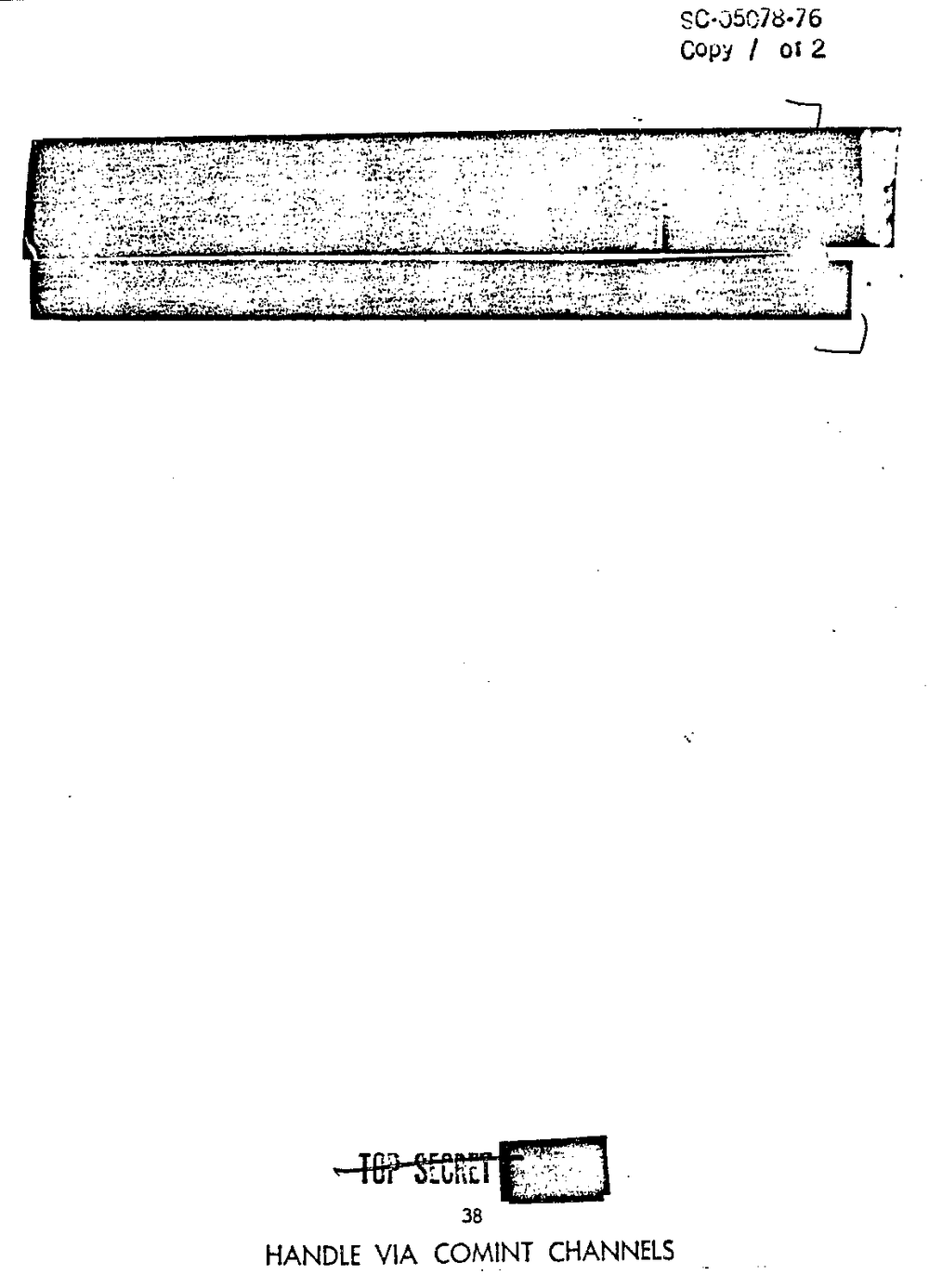
80050-784 6
Copy I o: 2
HANDLE VIA COMINT CHANNELS
80050-784 6
Copy I o: 2
HANDLE VIA COMINT CHANNELS
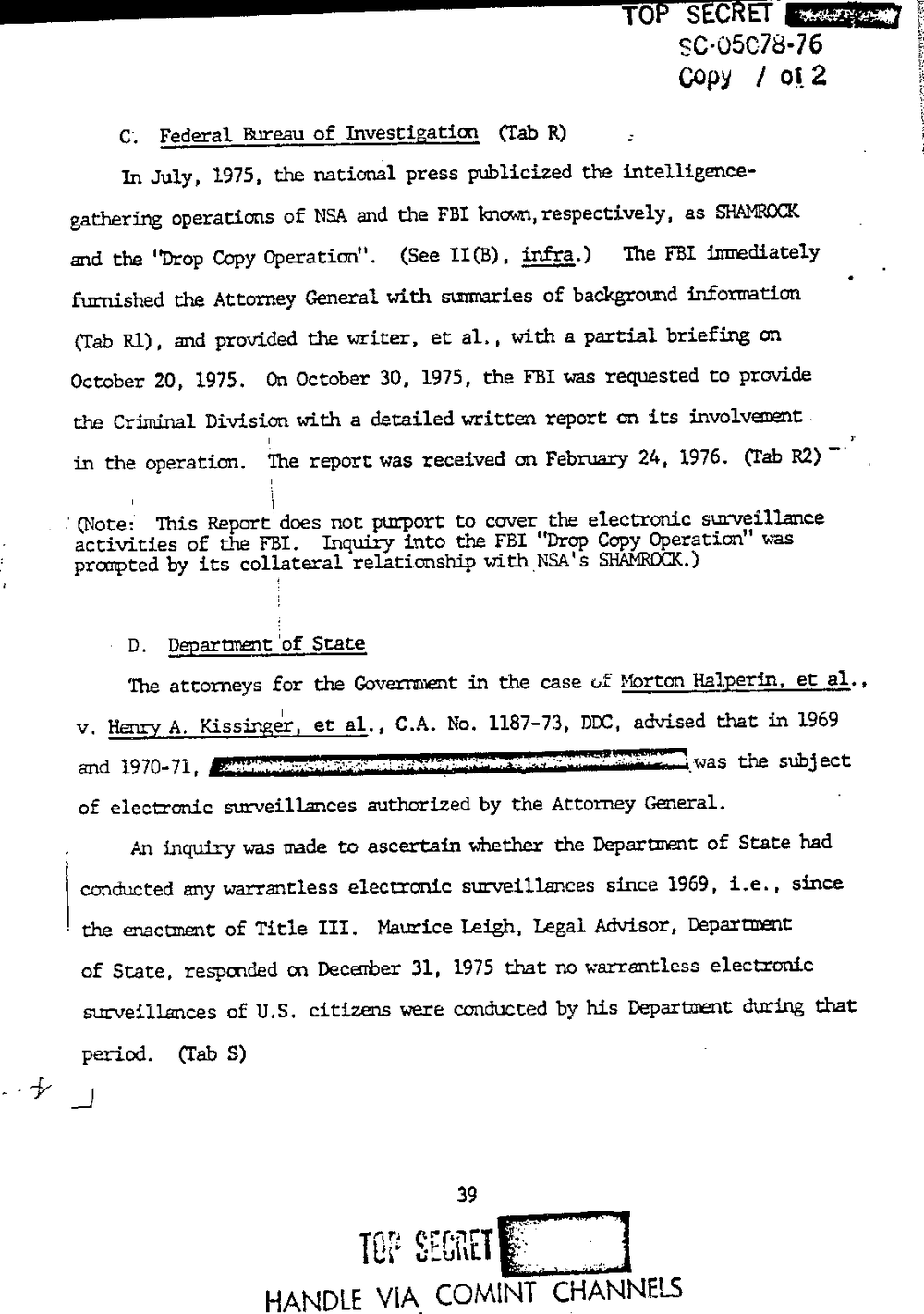
sec Er
80-05078-76
Copy 012
Federal Bureau of Investigation (Tab R) ..
In July, 1975. the national press publicized the intelligence-
gathering operations of NSA and the FBI lmom,respectively, as SHAMROCK
and the "Drop Copy Operation". (See II (B), The FBI immediately
?nished the Attorney General with summaries of background information
Crab R1) and provided the writer, et a1. with a partial briefing on
October 20, 1975. On October 30, 1975, the FBI was requested to provide
the Criminal Division with a detailed written report on its involvanent .
in the operation. 2the report was received on February 24, 1976. (Tab R2)
3 (Note; This Report\ does not purport to cover the electronic surveillance
activities of the FBI. Inquiry into the FBI "Drop Copy Operation" was
prompted by its collateral relationship withNSA's W.)
- D. Department :of State
The attorneys for the Government in the case of Morton Halperin, et al.,
v. Henry A. Kissinger, et 31., C.A. No. 1187-73, DDC, advised that in 1969
and 1970-71,
'v-was the subject
of electronic surveillances authorized by the Attorney General.
An inquiry was made to ascertain whether the Department of State had
conducted any electronic surveillances since 1969, Le. since
the enactment of Title Maurice Leigh, Legal Advisor, Department
of State, responded on December 31, 1975 that no warrantless electronic
meillmces of 11.5. citizens were conducted by his Deparment during that
period. (Tab 5)
a
39
scan
HANDLE COMINT CHANNELS
Mr 5
sec Er
80-05078-76
Copy 012
Federal Bureau of Investigation (Tab R) ..
In July, 1975. the national press publicized the intelligence-
gathering operations of NSA and the FBI lmom,respectively, as SHAMROCK
and the "Drop Copy Operation". (See II (B), The FBI immediately
?nished the Attorney General with summaries of background information
Crab R1) and provided the writer, et a1. with a partial briefing on
October 20, 1975. On October 30, 1975, the FBI was requested to provide
the Criminal Division with a detailed written report on its involvanent .
in the operation. 2the report was received on February 24, 1976. (Tab R2)
3 (Note; This Report\ does not purport to cover the electronic surveillance
activities of the FBI. Inquiry into the FBI "Drop Copy Operation" was
prompted by its collateral relationship withNSA's W.)
- D. Department :of State
The attorneys for the Government in the case of Morton Halperin, et al.,
v. Henry A. Kissinger, et 31., C.A. No. 1187-73, DDC, advised that in 1969
and 1970-71,
'v-was the subject
of electronic surveillances authorized by the Attorney General.
An inquiry was made to ascertain whether the Department of State had
conducted any electronic surveillances since 1969, Le. since
the enactment of Title Maurice Leigh, Legal Advisor, Department
of State, responded on December 31, 1975 that no warrantless electronic
meillmces of 11.5. citizens were conducted by his Deparment during that
period. (Tab 5)
a
39
scan
HANDLE COMINT CHANNELS
Mr 5
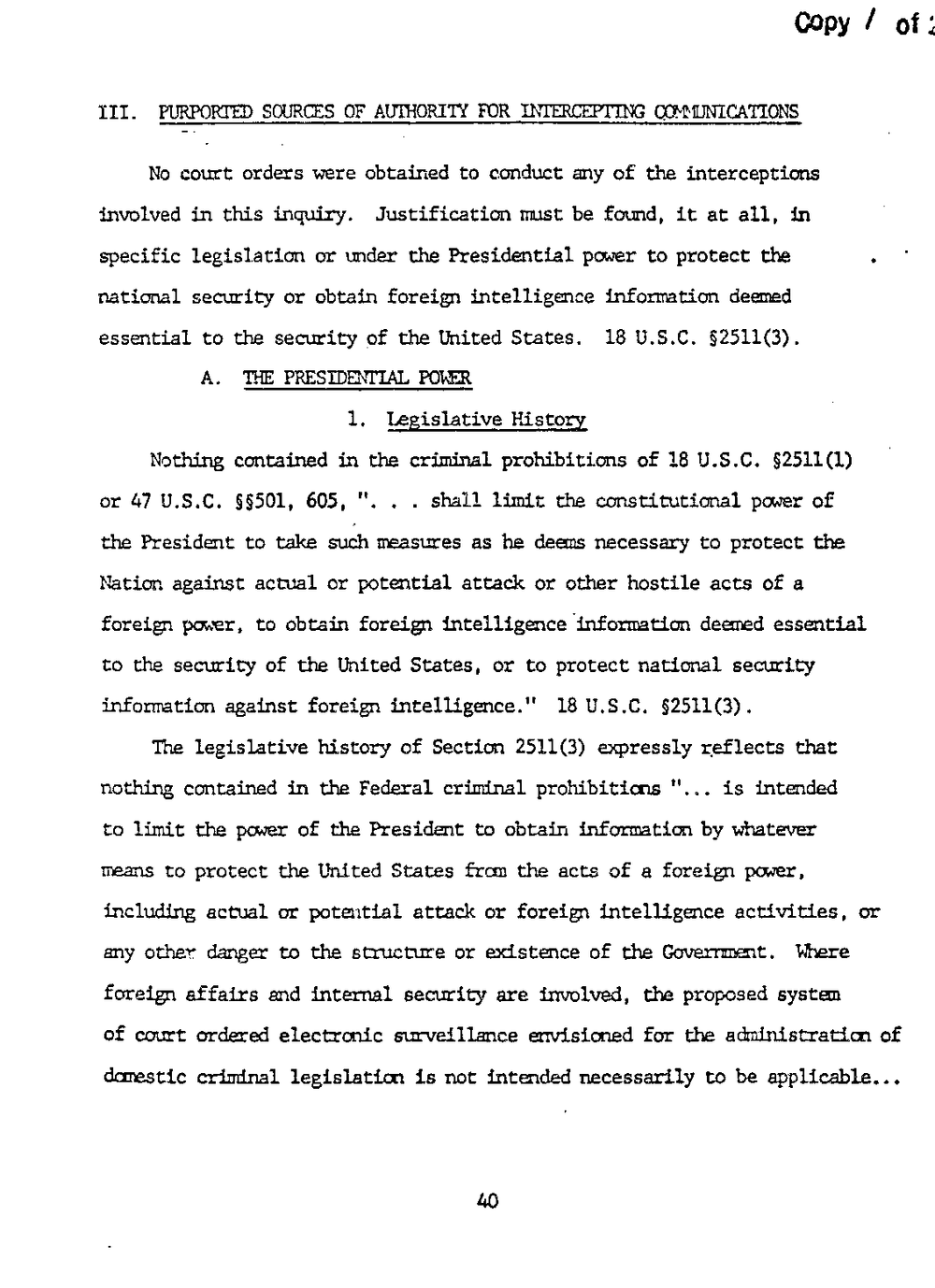
Copy 012
SOURCES OF AUTHORITY EUR
No court orders were obtained to conduct any of the interceptions
involved in this inquiry. Justification must be found, it at all, in
specific legislation or under the Presidential power to protect the .
national security or obtain foreign intelligence information deemed
essential to the security of the United States. 18 U.S.C. ?2511(3).
A. THE PRESEENTIAL POWER
1. Legislative History
Nothing contained in the criminal prohibitions of 18 U.S.C. ?2511(1)
or 47 U.S.C. ??501, 605. . . shall limit the constitutional power of
the President to take measures as he deems necessary to protect the
Nation against actual or potential attack or other hostile acts of a
foreign power, to obtain foreign intelligence information deemed essential
to the security of the United States. or to protect national security
information against foreign intelligence." 18 U.S.C. 525116) .
The legislative history of Section 2511(3) expressly reflects that
nothing contained in the Federal criminal prohibitims . . is intended
to limit the power of the President to obtain information by whatever
means to protect the United States ?rm the acts of a foreign power,
including actual or potential attack or foreign intelligence activities, or
any other danger to the structure or existence of the Goverrment. Where
foreign affairs and internal security are involved, the proposed system
of court ordered electronic surveillance envisimed for the administratint of
dcmastic criminal legislaticn is not intended necessarily to be
Copy 012
SOURCES OF AUTHORITY EUR
No court orders were obtained to conduct any of the interceptions
involved in this inquiry. Justification must be found, it at all, in
specific legislation or under the Presidential power to protect the .
national security or obtain foreign intelligence information deemed
essential to the security of the United States. 18 U.S.C. ?2511(3).
A. THE PRESEENTIAL POWER
1. Legislative History
Nothing contained in the criminal prohibitions of 18 U.S.C. ?2511(1)
or 47 U.S.C. ??501, 605. . . shall limit the constitutional power of
the President to take measures as he deems necessary to protect the
Nation against actual or potential attack or other hostile acts of a
foreign power, to obtain foreign intelligence information deemed essential
to the security of the United States. or to protect national security
information against foreign intelligence." 18 U.S.C. 525116) .
The legislative history of Section 2511(3) expressly reflects that
nothing contained in the Federal criminal prohibitims . . is intended
to limit the power of the President to obtain information by whatever
means to protect the United States ?rm the acts of a foreign power,
including actual or potential attack or foreign intelligence activities, or
any other danger to the structure or existence of the Goverrment. Where
foreign affairs and internal security are involved, the proposed system
of court ordered electronic surveillance envisimed for the administratint of
dcmastic criminal legislaticn is not intended necessarily to be
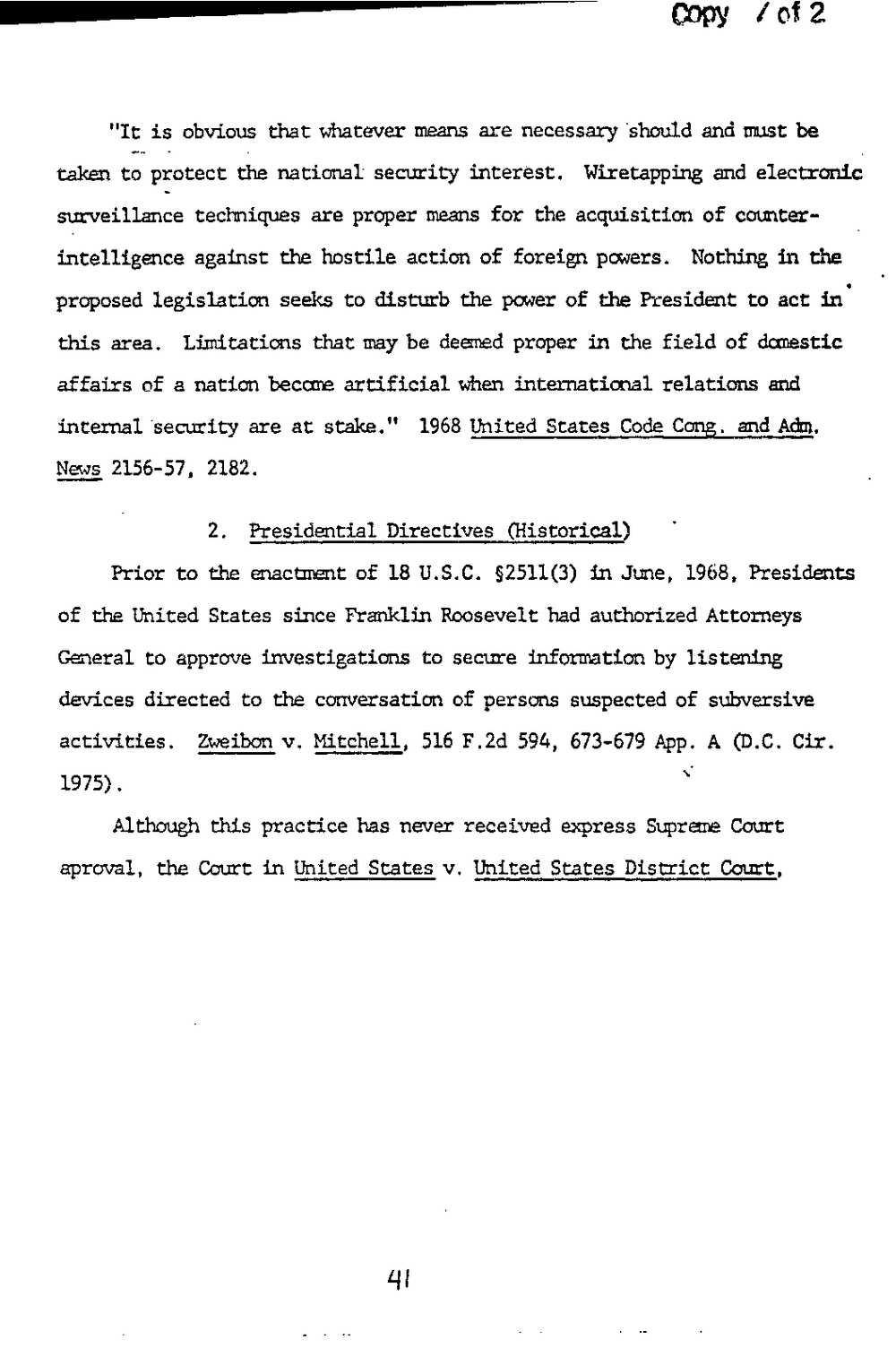
m, [dz
"It is obvious that whatever means are necessary should and must be
taken to? protect national security interest. Wiretapping and electronic
smeillance techniques are proper means for the acquisition of counter-
intelligence against the hostile action of foreign powers. Nothing in the
proposed legislation seeks to disturb the power of the President to act in.
this area. Limitations that may be deemed proper in the field of domestic
affairs of a nation become artificial when international relations and
internal security are at stake." 1968 United States Code Cong. and Adm.
Eggs 2156-57, 2182.
2. Presidential Directives (Historical)
Prior to the enath of 18 U.S.C. ?2511(3) in June, 1968. Presidents
of the United States since Franklin Roosevelt had authorized Attorneys
General to approve investigations to secure information by listerdng
devices directed to the conversation of persons suspected of subversive
activities. Zweibon v. Mitchell, 516 F.2d 594, 673-679 App. A (D.C. Cir.
1975).
Although this practice has never received express Court
aproval. the Court in United States v. United States District Court,
4:
m, [dz
"It is obvious that whatever means are necessary should and must be
taken to? protect national security interest. Wiretapping and electronic
smeillance techniques are proper means for the acquisition of counter-
intelligence against the hostile action of foreign powers. Nothing in the
proposed legislation seeks to disturb the power of the President to act in.
this area. Limitations that may be deemed proper in the field of domestic
affairs of a nation become artificial when international relations and
internal security are at stake." 1968 United States Code Cong. and Adm.
Eggs 2156-57, 2182.
2. Presidential Directives (Historical)
Prior to the enath of 18 U.S.C. ?2511(3) in June, 1968. Presidents
of the United States since Franklin Roosevelt had authorized Attorneys
General to approve investigations to secure information by listerdng
devices directed to the conversation of persons suspected of subversive
activities. Zweibon v. Mitchell, 516 F.2d 594, 673-679 App. A (D.C. Cir.
1975).
Although this practice has never received express Court
aproval. the Court in United States v. United States District Court,
4:
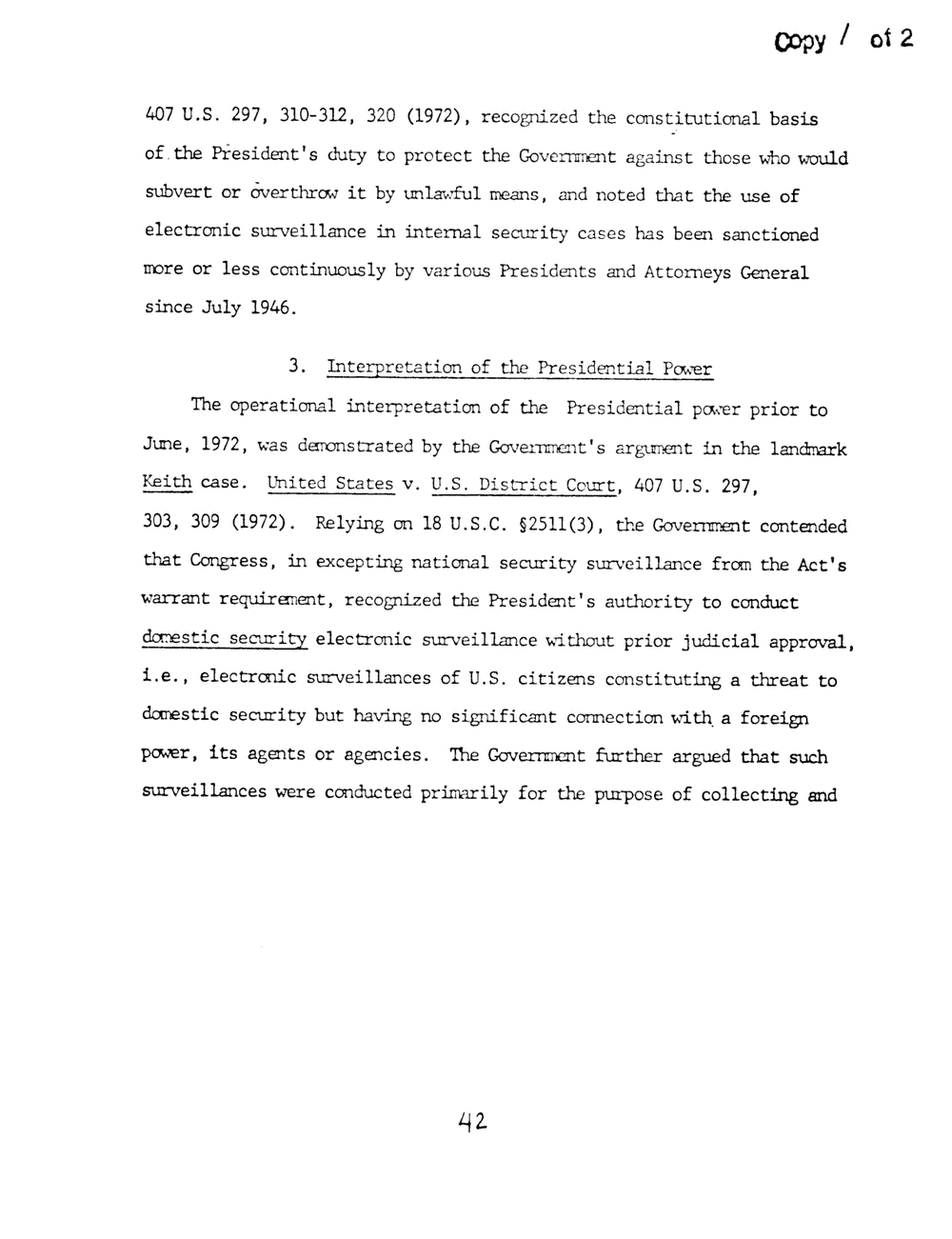
(jgpy'll (3:12
407 U.S. 297, 310-312, 320 (1972), recognized the constitutional basis
of the President's duty to protect the Government against those who would
subvert or overthrow it by unlawful neans, and noted that the use of
electronic surveillance in internal security cases has been sanctioned
more or less continuously by various Presidents and Attorneys General
since July 1946.
3. Interpretation of the Presidential Power
The operational interpretation of the Presidential power prior to
June, 1972, was demonstrated by the Government's argument in the landmark
Keith case. United States v. U.S. District Court, 407 U.S. 297,
303, 309 (1972). Relying on 18 U.S.C. ?2511(3), the Government contended
that Congress, in excepting national security surveillance from the Act's
warrant requirement, recognized the President's authority to conduct
domestic security electronic surveillance without prior judicial approval,
electronic surveillances of U.S. citizens constituting a threat to
domestic security but having no significant connection with a foreign
power, its agents or agencies. The Government further argued that such
surveillances were conducted primarily for the purpose of collecting and
42
(jgpy'll (3:12
407 U.S. 297, 310-312, 320 (1972), recognized the constitutional basis
of the President's duty to protect the Government against those who would
subvert or overthrow it by unlawful neans, and noted that the use of
electronic surveillance in internal security cases has been sanctioned
more or less continuously by various Presidents and Attorneys General
since July 1946.
3. Interpretation of the Presidential Power
The operational interpretation of the Presidential power prior to
June, 1972, was demonstrated by the Government's argument in the landmark
Keith case. United States v. U.S. District Court, 407 U.S. 297,
303, 309 (1972). Relying on 18 U.S.C. ?2511(3), the Government contended
that Congress, in excepting national security surveillance from the Act's
warrant requirement, recognized the President's authority to conduct
domestic security electronic surveillance without prior judicial approval,
electronic surveillances of U.S. citizens constituting a threat to
domestic security but having no significant connection with a foreign
power, its agents or agencies. The Government further argued that such
surveillances were conducted primarily for the purpose of collecting and
42
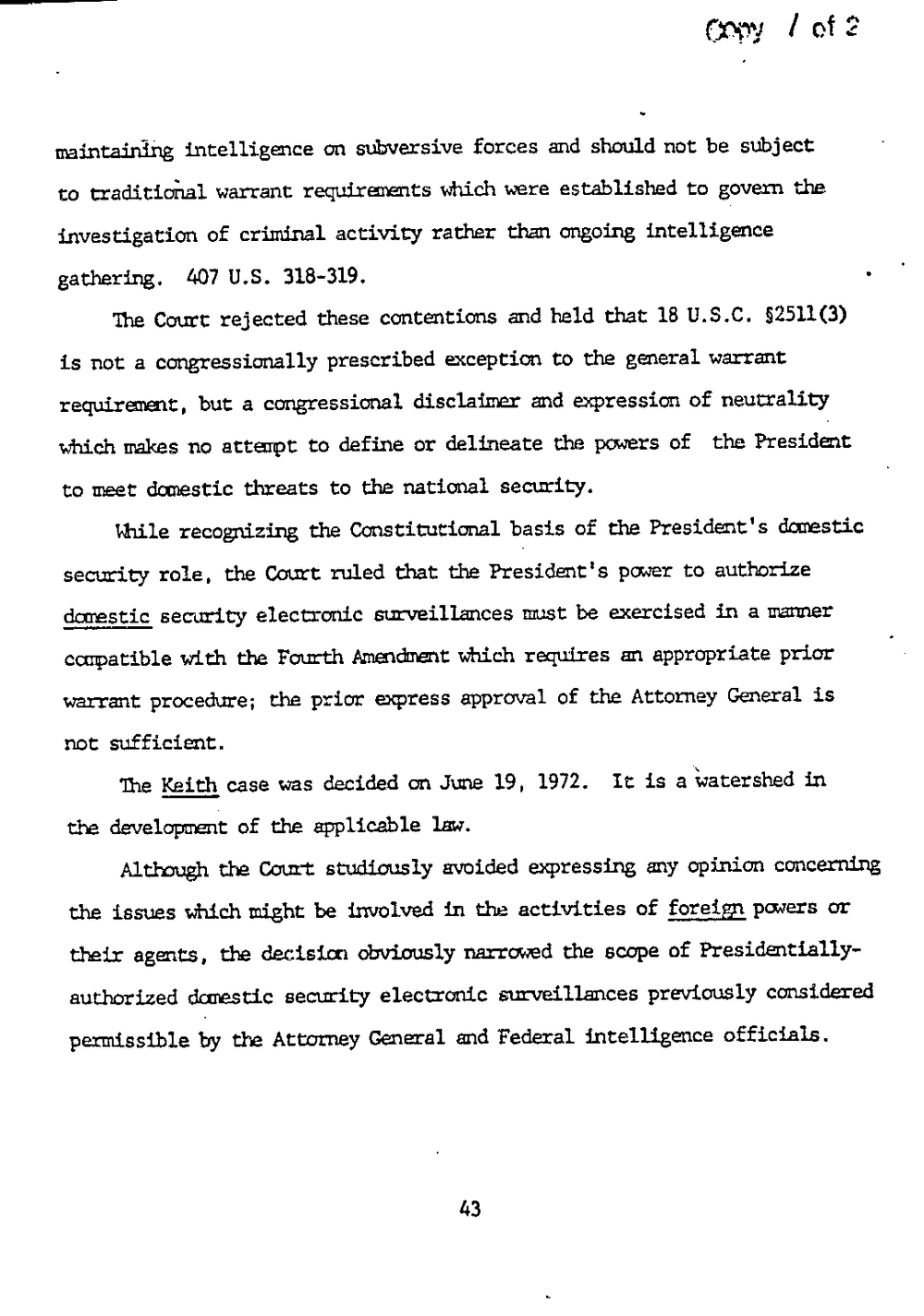
of 2
intelligence on subversive forces and should not be subject
to traditional warrant requirements which were established to govern the
investigation of criminal activity rather than ongoing intelligence
gathering. 407 0.3. 318-319. -
The Court rejected these contentions and held that 18 U.S.C. ?2511(3)
is not a congressionally prescribed exception to the general warrant
requirement, but a congressional disclaimer and expression of neutrality
which makes no attanpt to define or delineate the powers of the President
to meet domestic threats to the national security.
mile recognizing the Constitutional basis of the President's domestic
security role, the Court ruled that the President's power to authorize
domestic security electronic surveillances must be exercised in a numer
compatible with the Fourth Amendment which requires an appropriate prior
warrant procedure; the prior express approval of the Attorney General is
not sufficient.
The Kid; case was decided on June 19, 1972. It is a \watershed in
the development of the applicable law.
Altl'nugh the Court studiously avoided expressing any opinion concerning
the issues which might be involved in the activities of foreig powers or
their agents, the decision obviously narrowed the scope of Presidentially?
authorized drmestic security electronic surveillances previously considered
permissible the Attorney General and Federal intelligence officials.
43
of 2
intelligence on subversive forces and should not be subject
to traditional warrant requirements which were established to govern the
investigation of criminal activity rather than ongoing intelligence
gathering. 407 0.3. 318-319. -
The Court rejected these contentions and held that 18 U.S.C. ?2511(3)
is not a congressionally prescribed exception to the general warrant
requirement, but a congressional disclaimer and expression of neutrality
which makes no attanpt to define or delineate the powers of the President
to meet domestic threats to the national security.
mile recognizing the Constitutional basis of the President's domestic
security role, the Court ruled that the President's power to authorize
domestic security electronic surveillances must be exercised in a numer
compatible with the Fourth Amendment which requires an appropriate prior
warrant procedure; the prior express approval of the Attorney General is
not sufficient.
The Kid; case was decided on June 19, 1972. It is a \watershed in
the development of the applicable law.
Altl'nugh the Court studiously avoided expressing any opinion concerning
the issues which might be involved in the activities of foreig powers or
their agents, the decision obviously narrowed the scope of Presidentially?
authorized drmestic security electronic surveillances previously considered
permissible the Attorney General and Federal intelligence officials.
43
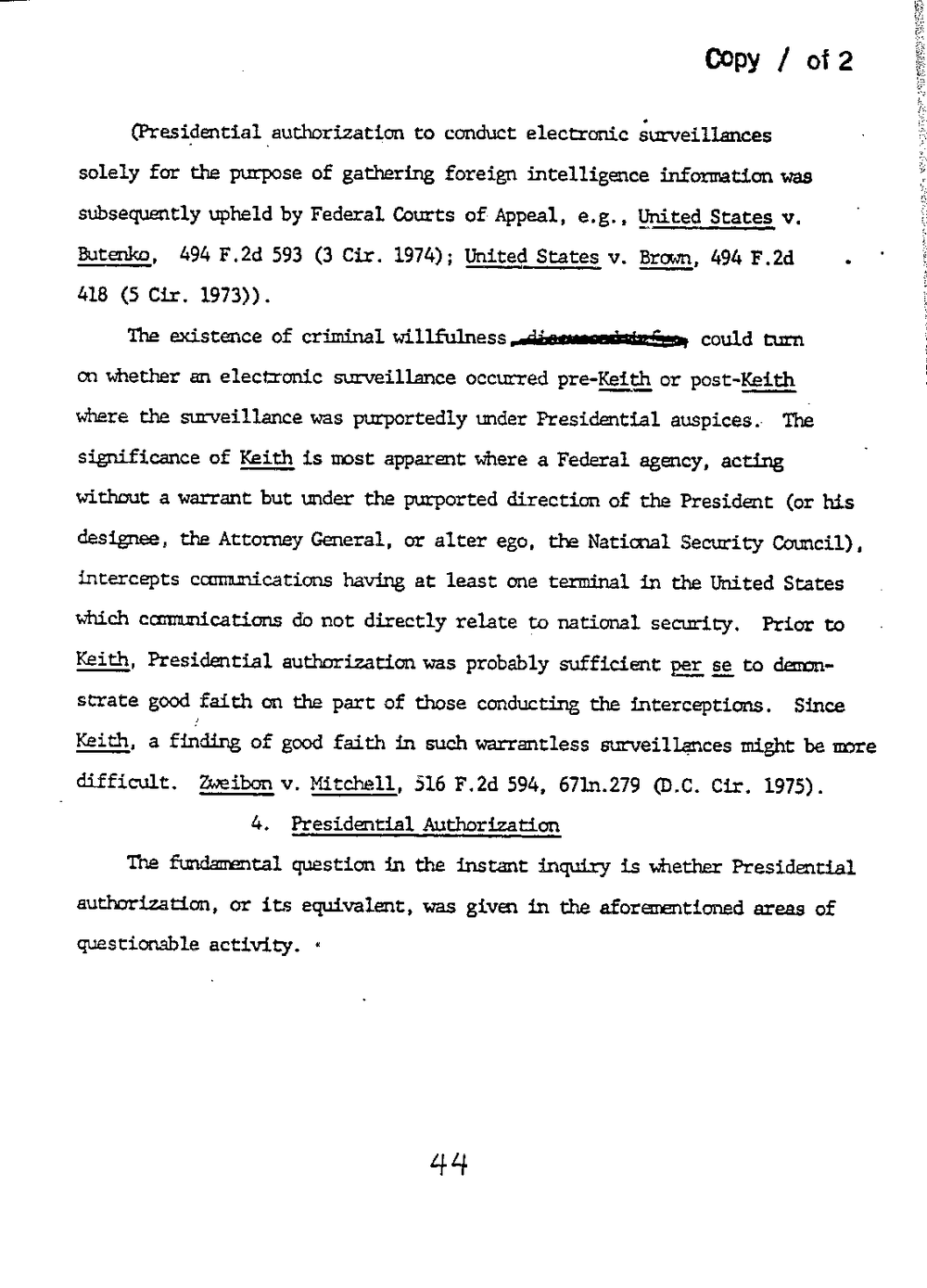
Copy oi2
(Presidmtial?authorization to conduct electronic sin-veillances
solely for the purpose of gathering foreign intelligence information was
subsequently upheld by Federal Courts of Appeal, e.g. Qn_i_t_e_d States v.
311153.112, 494 F.2d 593 (3 Cir. 1974); United States v. Brown. 494 F.2d .
418 (5 Cir. 1973)).
The existence of criminal will??nessw could turn
on whether an electronic surveillance occurred pre-Ijgith or post-Rig
where the smeillance was purportedly under Presidential auspices .-
significance of Ke__it_h_ is most apparent where a Federal agency, acting
without a warrant but under the purported direction of the President (or his
designee, the Attorney General, or alter ego, the National Security Council),
intercepts cconmications having at least one terminal in the United States
which cmmunications do not directly relate to national security. Prior to
Ke_ith_. Presidential authorization was probably sufficient ?3 to demon--
strate good faith on the part of those conducting the interceptions. Since
?ail}. a finding of good faith in such warrantless Sin-veillances might be more
difficult. Zweibon v. WE, 516 F.2d 594, 67ln.279 (D.C. Cir. 1975).
. 4. Presidential Authorization
The ?mdanmtal question in the instant inquiry is whether Presidential
authorization, or its equivalent, was given in the aforementioned areas of
questionable activity. 0
44
Copy oi2
(Presidmtial?authorization to conduct electronic sin-veillances
solely for the purpose of gathering foreign intelligence information was
subsequently upheld by Federal Courts of Appeal, e.g. Qn_i_t_e_d States v.
311153.112, 494 F.2d 593 (3 Cir. 1974); United States v. Brown. 494 F.2d .
418 (5 Cir. 1973)).
The existence of criminal will??nessw could turn
on whether an electronic surveillance occurred pre-Ijgith or post-Rig
where the smeillance was purportedly under Presidential auspices .-
significance of Ke__it_h_ is most apparent where a Federal agency, acting
without a warrant but under the purported direction of the President (or his
designee, the Attorney General, or alter ego, the National Security Council),
intercepts cconmications having at least one terminal in the United States
which cmmunications do not directly relate to national security. Prior to
Ke_ith_. Presidential authorization was probably sufficient ?3 to demon--
strate good faith on the part of those conducting the interceptions. Since
?ail}. a finding of good faith in such warrantless Sin-veillances might be more
difficult. Zweibon v. WE, 516 F.2d 594, 67ln.279 (D.C. Cir. 1975).
. 4. Presidential Authorization
The ?mdanmtal question in the instant inquiry is whether Presidential
authorization, or its equivalent, was given in the aforementioned areas of
questionable activity. 0
44
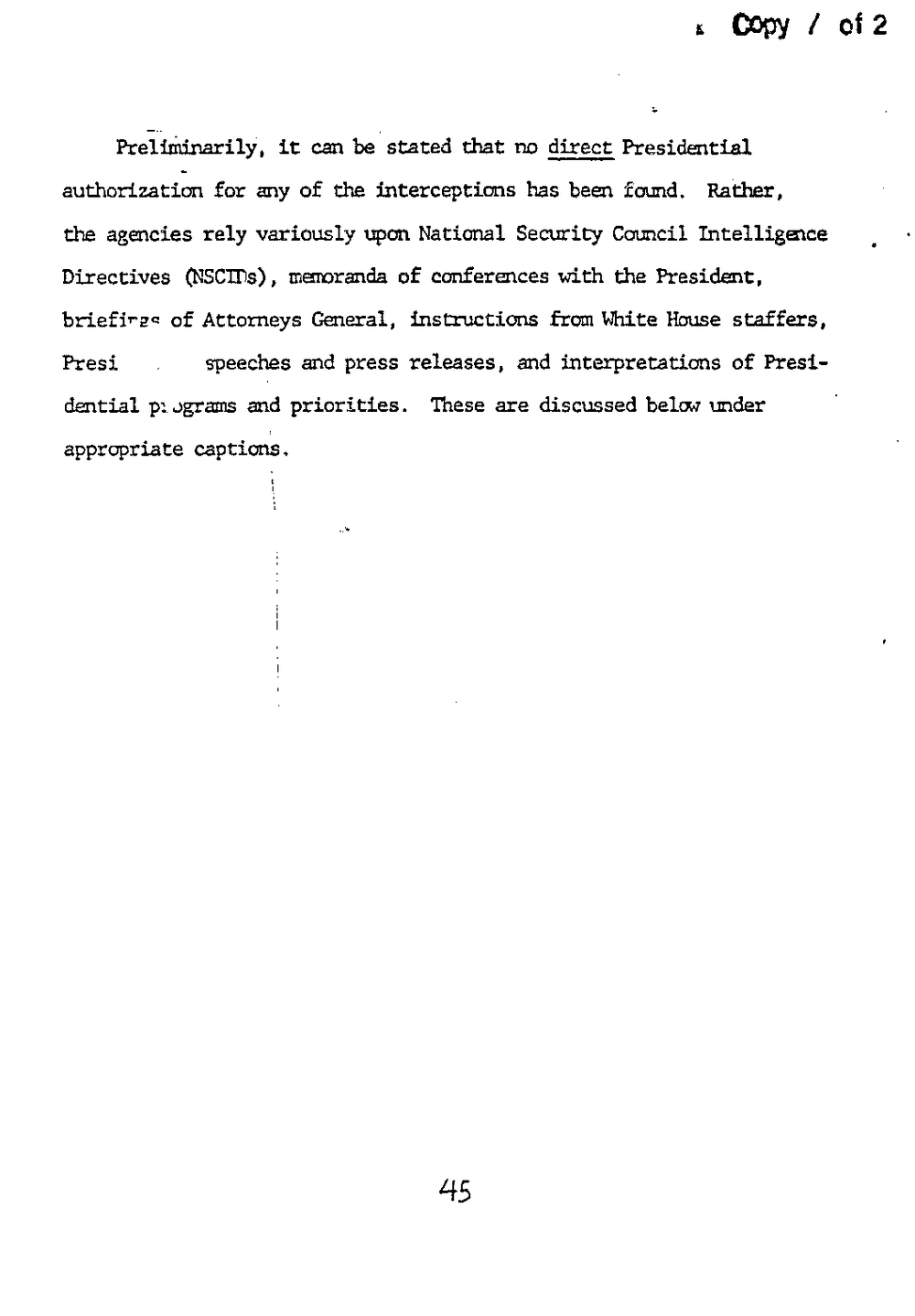
lam/0?2
Prelixi?narily, it can be. stated that no {15% Presidential
authorization for any of the interceptions has been found. Rather,
the agencies rely variously upon National Security Council mtelligmce
Directives . manoranda of conferences with the President.
briefings of Attorneys General, instructions from White House staffers.
Presi . speeches and press releases, and interpretations of Presi-
dmtial p1. grams and priorities. These are discussed below under
appropriate captions .
I
1
45
lam/0?2
Prelixi?narily, it can be. stated that no {15% Presidential
authorization for any of the interceptions has been found. Rather,
the agencies rely variously upon National Security Council mtelligmce
Directives . manoranda of conferences with the President.
briefings of Attorneys General, instructions from White House staffers.
Presi . speeches and press releases, and interpretations of Presi-
dmtial p1. grams and priorities. These are discussed below under
appropriate captions .
I
1
45
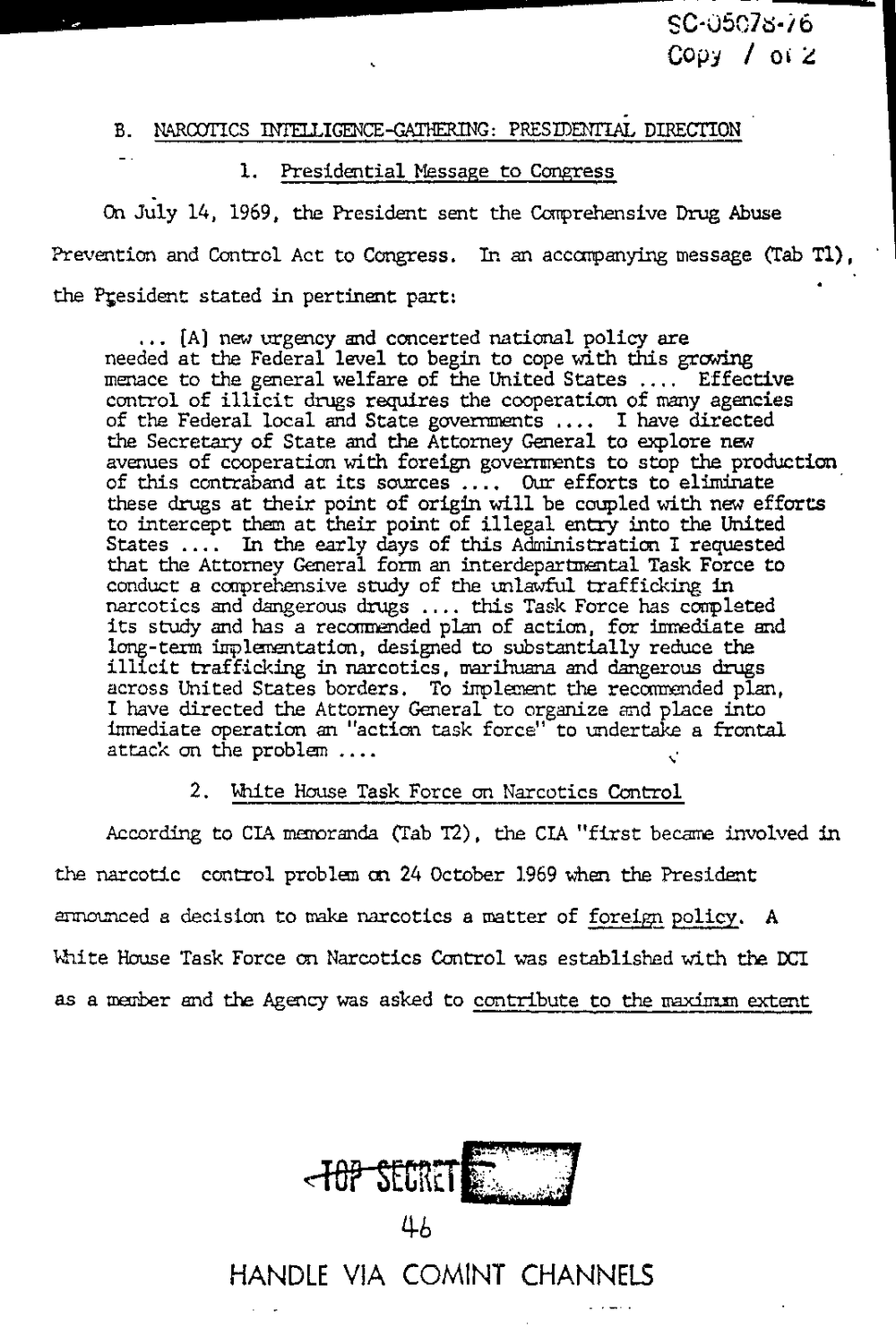
800587646
Copy 052.
B. nmconcs MIMEWG: Parsmm DIRECTION
1. Presidential Message to Congress
On July 14, 1969, the President sent the Cmprehensive Drug Abuse
Prevention and Control Act to Congress. In an accompanying message (Tab T1).
the President stated in pertinent part:
.. . new urgency and concerted national policy are
needed at the Federal level to begin to cope with this growing
menace to the general welfare of the United States . . .. Effective
control of illicit drugs requires the cooperation of many agencies
of the Federal local and State governments .. . . I have directed
the Secretary of State and the Attorney General to explore new
avenues of cooperation with foreign governments to stop the production
of this contraband at its sources . . . . Our efforts to eliminate
these drugs at their point of origin will be coupled with new efforts
to intercept them at their point of illegal entry into the United
States . . . . In the early days of this Adn?nistration I requested
that the Attorney General form an interdepartmental Task Force to
conduct a comprehensive study of the unlawful trafficking in
narcotics and dangerous drugs . . . . this Task Force has completed
its study and has a recount-aided plan of action, for immediate and
long?term implementation, designed to substantially reduce the
illicit trafficking in narcotics, marihuana and dangerous drugs
across United States borders. To implement the recmnended plan,
I have directed the Attorney General to organize and place into
immediate operation an "action task force" to undertake a frontal
attack on the problem . . . . -
2. White House Task Force on Narcotics Control
According to CIA memramda (Tab T2), the CIA "first becme involved in
the narcotic control problem on 24 October 1969 when the President
aims-med a decision to make narcotics a matter of fore.ign__ poly. A
White House Task Force on Narcotics Control was established with the DCI
as a member and the Agency was asked to contribute to the neximm extent
HANDLE VIA COMINT CHANNELS
800587646
Copy 052.
B. nmconcs MIMEWG: Parsmm DIRECTION
1. Presidential Message to Congress
On July 14, 1969, the President sent the Cmprehensive Drug Abuse
Prevention and Control Act to Congress. In an accompanying message (Tab T1).
the President stated in pertinent part:
.. . new urgency and concerted national policy are
needed at the Federal level to begin to cope with this growing
menace to the general welfare of the United States . . .. Effective
control of illicit drugs requires the cooperation of many agencies
of the Federal local and State governments .. . . I have directed
the Secretary of State and the Attorney General to explore new
avenues of cooperation with foreign governments to stop the production
of this contraband at its sources . . . . Our efforts to eliminate
these drugs at their point of origin will be coupled with new efforts
to intercept them at their point of illegal entry into the United
States . . . . In the early days of this Adn?nistration I requested
that the Attorney General form an interdepartmental Task Force to
conduct a comprehensive study of the unlawful trafficking in
narcotics and dangerous drugs . . . . this Task Force has completed
its study and has a recount-aided plan of action, for immediate and
long?term implementation, designed to substantially reduce the
illicit trafficking in narcotics, marihuana and dangerous drugs
across United States borders. To implement the recmnended plan,
I have directed the Attorney General to organize and place into
immediate operation an "action task force" to undertake a frontal
attack on the problem . . . . -
2. White House Task Force on Narcotics Control
According to CIA memramda (Tab T2), the CIA "first becme involved in
the narcotic control problem on 24 October 1969 when the President
aims-med a decision to make narcotics a matter of fore.ign__ poly. A
White House Task Force on Narcotics Control was established with the DCI
as a member and the Agency was asked to contribute to the neximm extent
HANDLE VIA COMINT CHANNELS
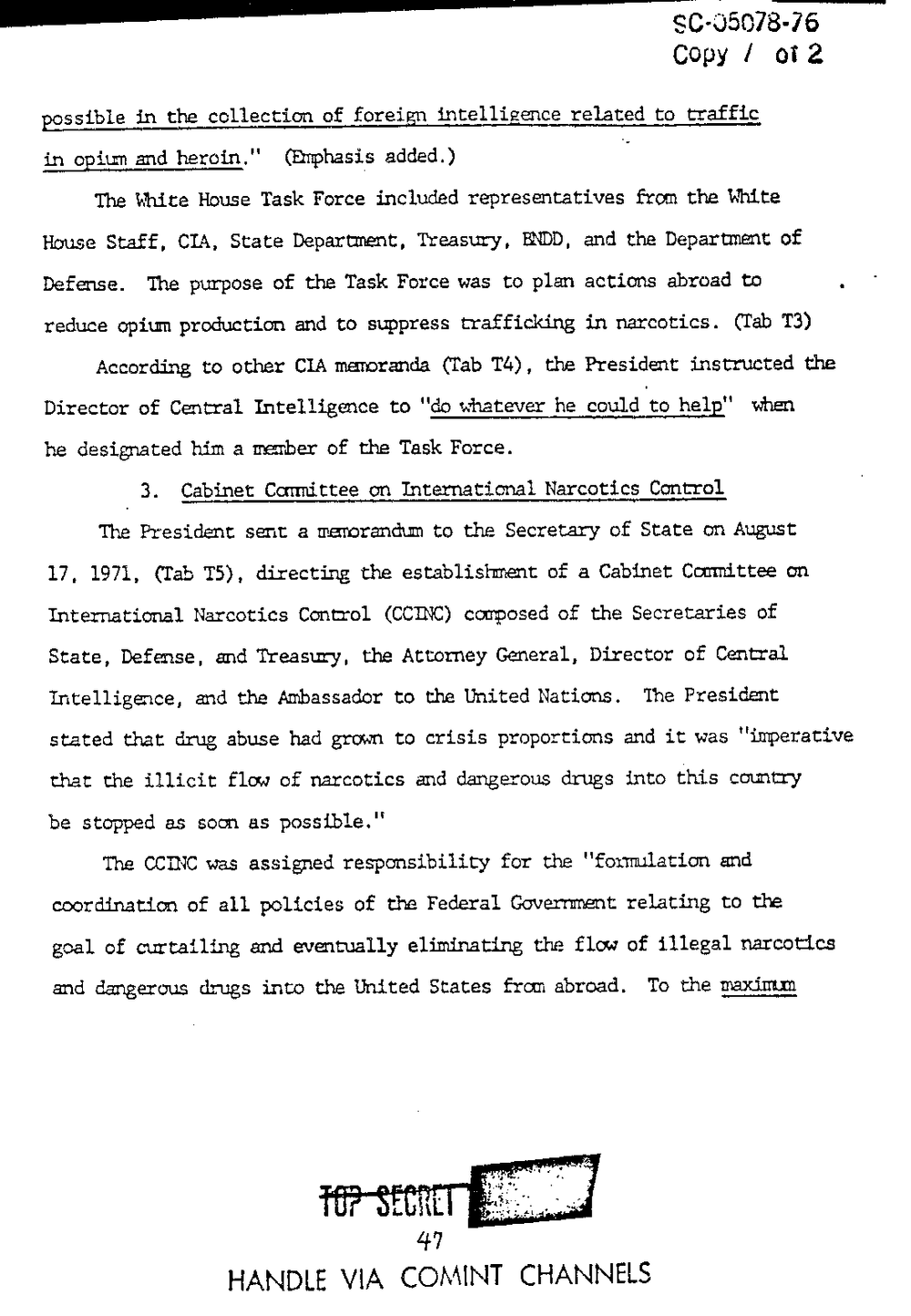
900507846
CODY OI 2
possible in the collection of foreign intelligence related to traffic
in opium and heroin." (Emphasis added.) -
The White House Task Force included representatives from the White
House Staff, CIA, State Deparmmt, Treasury, BNDD, and the Department of
Defense. The purpose of the Task Force was to plan actions abroad to
reduce opium production and to suppress trafficking in narcotics. (Tab T3)
According to other CIA mamranda (Tab T4), the President instructed the
Director of Central Intelligence to "do whatever he could to help" when
he designated him a member of the Task Force.
3. Cabinet Committee on International Narcotics Control
The President sent a memorandum to the Secretary of State on August
17, 1971, (Tab T5), directing the establith of a Cabinet Carmittee on
International Narcotics Control (CCINC) composed of the Secretaries of
State, Defense, and Treasury, the Attorney General, Director of Central
Intelligence, and the Ambassador to the United Nations. The President
stated that drug abuse had grown to crisis proportions and it was "imperative
that the illicit flow of narcotics and dangerous drugs into this coma-y
be stopped as soon as possible."
The was assigned responsibility for the ?formilation and
coordination of all policies of the Federal Government relating to the
goal of curtailing and eventually eliminating the flow of illegal narcotics
and dangerous into the United States from abroad. To the
HANDLE VIA COMINT CHANNELS
900507846
CODY OI 2
possible in the collection of foreign intelligence related to traffic
in opium and heroin." (Emphasis added.) -
The White House Task Force included representatives from the White
House Staff, CIA, State Deparmmt, Treasury, BNDD, and the Department of
Defense. The purpose of the Task Force was to plan actions abroad to
reduce opium production and to suppress trafficking in narcotics. (Tab T3)
According to other CIA mamranda (Tab T4), the President instructed the
Director of Central Intelligence to "do whatever he could to help" when
he designated him a member of the Task Force.
3. Cabinet Committee on International Narcotics Control
The President sent a memorandum to the Secretary of State on August
17, 1971, (Tab T5), directing the establith of a Cabinet Carmittee on
International Narcotics Control (CCINC) composed of the Secretaries of
State, Defense, and Treasury, the Attorney General, Director of Central
Intelligence, and the Ambassador to the United Nations. The President
stated that drug abuse had grown to crisis proportions and it was "imperative
that the illicit flow of narcotics and dangerous drugs into this coma-y
be stopped as soon as possible."
The was assigned responsibility for the ?formilation and
coordination of all policies of the Federal Government relating to the
goal of curtailing and eventually eliminating the flow of illegal narcotics
and dangerous into the United States from abroad. To the
HANDLE VIA COMINT CHANNELS
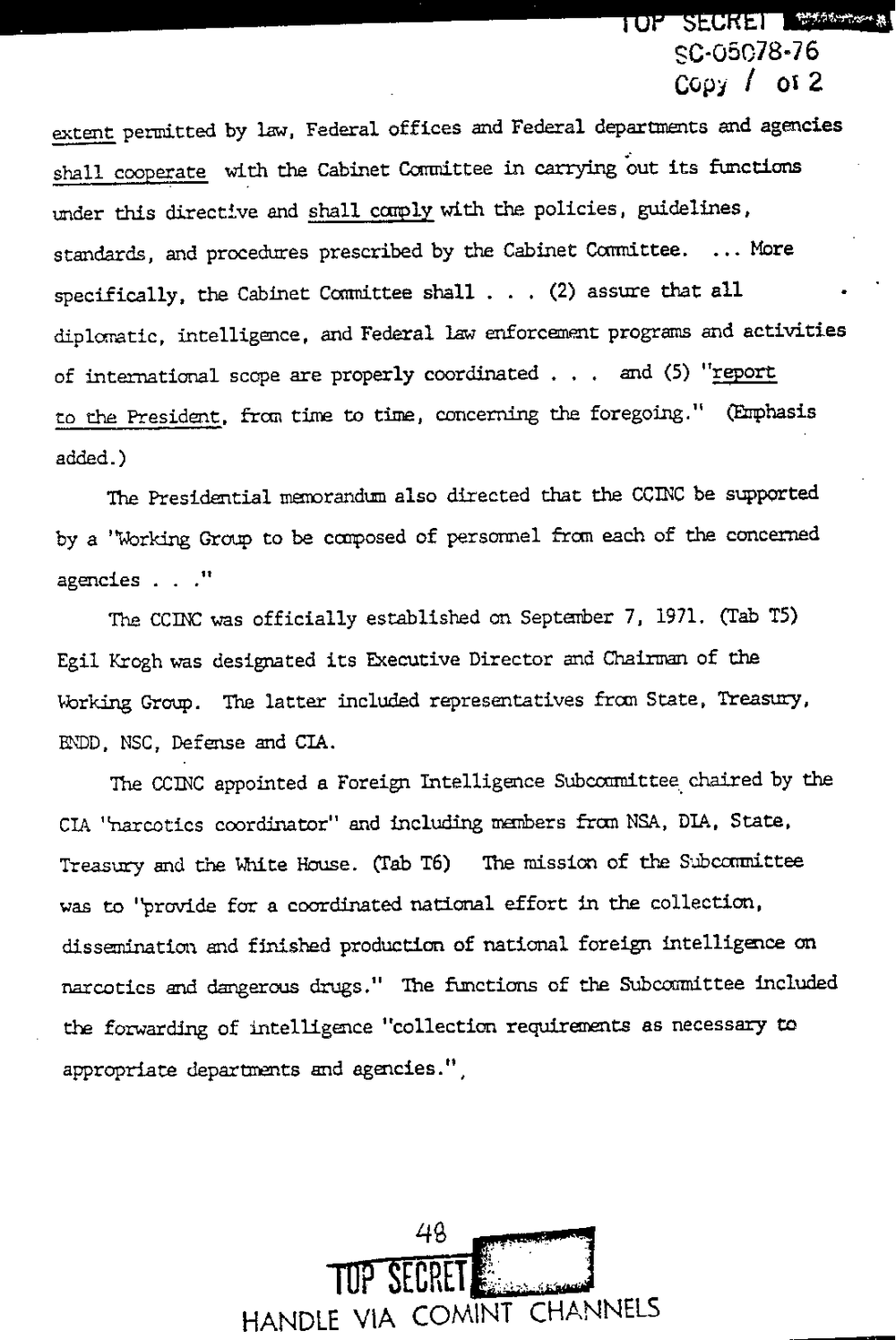
30-05078-76
(30p; I or 2
3:51:31; permitted by law. Federal offices and Federal departments and agencies
shall cooperate with the Cabinet Committee in carrying but its functions
under this directive and shall cg?? with the policies, guidelines,
standards, and procedures prescribed by the Cabinet Committee. . . . More
specifically, the Cabinet Committee shall . . . (2) assure that all .
diplomatic, intelligence, and Federal law enforcement programs and activities
of international scope are properly coordinated . . . and (5) "report
to the President, from time to time, concerning the foregoing." (Ephesis
added.) I
The Presidential also directed that the CCINC be emported
by a Group to be composed of personnel from each of the concerned
agencies . .
The CCINC was officially established on September 7, 1971. (Tab T5)
Egil Krogh was designated its Executive Director and Chairman of the
Working Group. The latter included representatives from State, Treasury,
BNDD, NSC, Defense and CIA.
The appointed a Foreign Intelligence Subcommittee chaired by the
CIA "narcotics coordinator" and including members NSA, DIA. State.
Treasury and the White House. (Tab T6) The mission of the Subcmmittee
was to "provide for a coordinated national effort in the collection,
dissemination and finished production of national foreign intelligence on
narcotics and dangerous drugs." The functions of the Subconmittee included
the forwarding of intelligence "collection requirements as necessary to
appropriate and agencies",
HANDLE VIA COMINT CHANNELS
I 510%?"
30-05078-76
(30p; I or 2
3:51:31; permitted by law. Federal offices and Federal departments and agencies
shall cooperate with the Cabinet Committee in carrying but its functions
under this directive and shall cg?? with the policies, guidelines,
standards, and procedures prescribed by the Cabinet Committee. . . . More
specifically, the Cabinet Committee shall . . . (2) assure that all .
diplomatic, intelligence, and Federal law enforcement programs and activities
of international scope are properly coordinated . . . and (5) "report
to the President, from time to time, concerning the foregoing." (Ephesis
added.) I
The Presidential also directed that the CCINC be emported
by a Group to be composed of personnel from each of the concerned
agencies . .
The CCINC was officially established on September 7, 1971. (Tab T5)
Egil Krogh was designated its Executive Director and Chairman of the
Working Group. The latter included representatives from State, Treasury,
BNDD, NSC, Defense and CIA.
The appointed a Foreign Intelligence Subcommittee chaired by the
CIA "narcotics coordinator" and including members NSA, DIA. State.
Treasury and the White House. (Tab T6) The mission of the Subcmmittee
was to "provide for a coordinated national effort in the collection,
dissemination and finished production of national foreign intelligence on
narcotics and dangerous drugs." The functions of the Subconmittee included
the forwarding of intelligence "collection requirements as necessary to
appropriate and agencies",
HANDLE VIA COMINT CHANNELS
I 510%?"
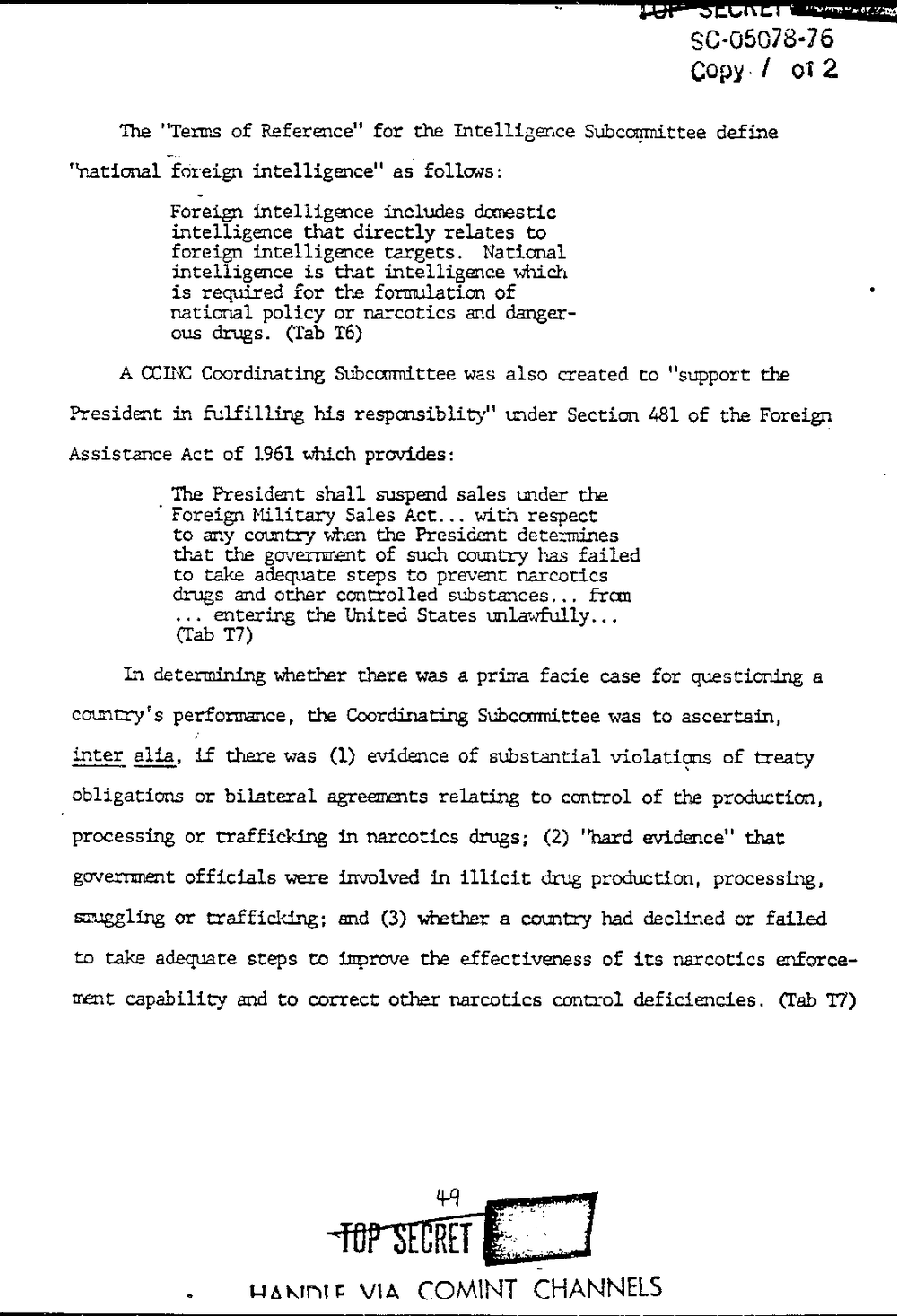
80-05078-76
com. I 01 2
The "Terms of Reference? for the Intelligence Subcoqmittee define
"national foreign intelligence" as follows:
Foreign intelligence includes domestic
intelligence that directly relates to
foreign intelligence targets. National
intelligence is that intelligence which
is required for the formulation of
national policy or narcotics and danger-
ous drugs. (Tab T6)
A CCINC Coordinating Subcommittee was also created to "support the
President in fulfilling his responsiblity" under Section (+81 of the Foreign
Assistance Act of 1.961 which provides:
. The President shall suspend sales under the
Foreign Military Sales Act. . . with respect
to any country when the Presth determines
that the government of such country has failed
to take adequate steps to prevent narcotics
drugs and other controlled
entering the United States mlawfully. . .
(Tab T7)
In determining whether there was a prima facie case for questioning a
country?s performer-ice, the Coordinating Subcommittee was to ascertain,
11.3.3325 alga, there was (I) evidence of substantial violations of treaty
obligations or bilateral agreements relating to control of the production,
processing or trafficking in narcotics drugs; (2) "hard evidence" that
govemment officials were involved in illicit drug production, processing,
smuggling or trafficking; and (3) whether a country had declined or failed
to take adequate steps to improve the effectiveness of its narcotics enforce-
ment capability and to correct other narcotics control deficiencies. (Tab T7)
.
. HAHN: VIA (EHANNELS
80-05078-76
com. I 01 2
The "Terms of Reference? for the Intelligence Subcoqmittee define
"national foreign intelligence" as follows:
Foreign intelligence includes domestic
intelligence that directly relates to
foreign intelligence targets. National
intelligence is that intelligence which
is required for the formulation of
national policy or narcotics and danger-
ous drugs. (Tab T6)
A CCINC Coordinating Subcommittee was also created to "support the
President in fulfilling his responsiblity" under Section (+81 of the Foreign
Assistance Act of 1.961 which provides:
. The President shall suspend sales under the
Foreign Military Sales Act. . . with respect
to any country when the Presth determines
that the government of such country has failed
to take adequate steps to prevent narcotics
drugs and other controlled
entering the United States mlawfully. . .
(Tab T7)
In determining whether there was a prima facie case for questioning a
country?s performer-ice, the Coordinating Subcommittee was to ascertain,
11.3.3325 alga, there was (I) evidence of substantial violations of treaty
obligations or bilateral agreements relating to control of the production,
processing or trafficking in narcotics drugs; (2) "hard evidence" that
govemment officials were involved in illicit drug production, processing,
smuggling or trafficking; and (3) whether a country had declined or failed
to take adequate steps to improve the effectiveness of its narcotics enforce-
ment capability and to correct other narcotics control deficiencies. (Tab T7)
.
. HAHN: VIA (EHANNELS
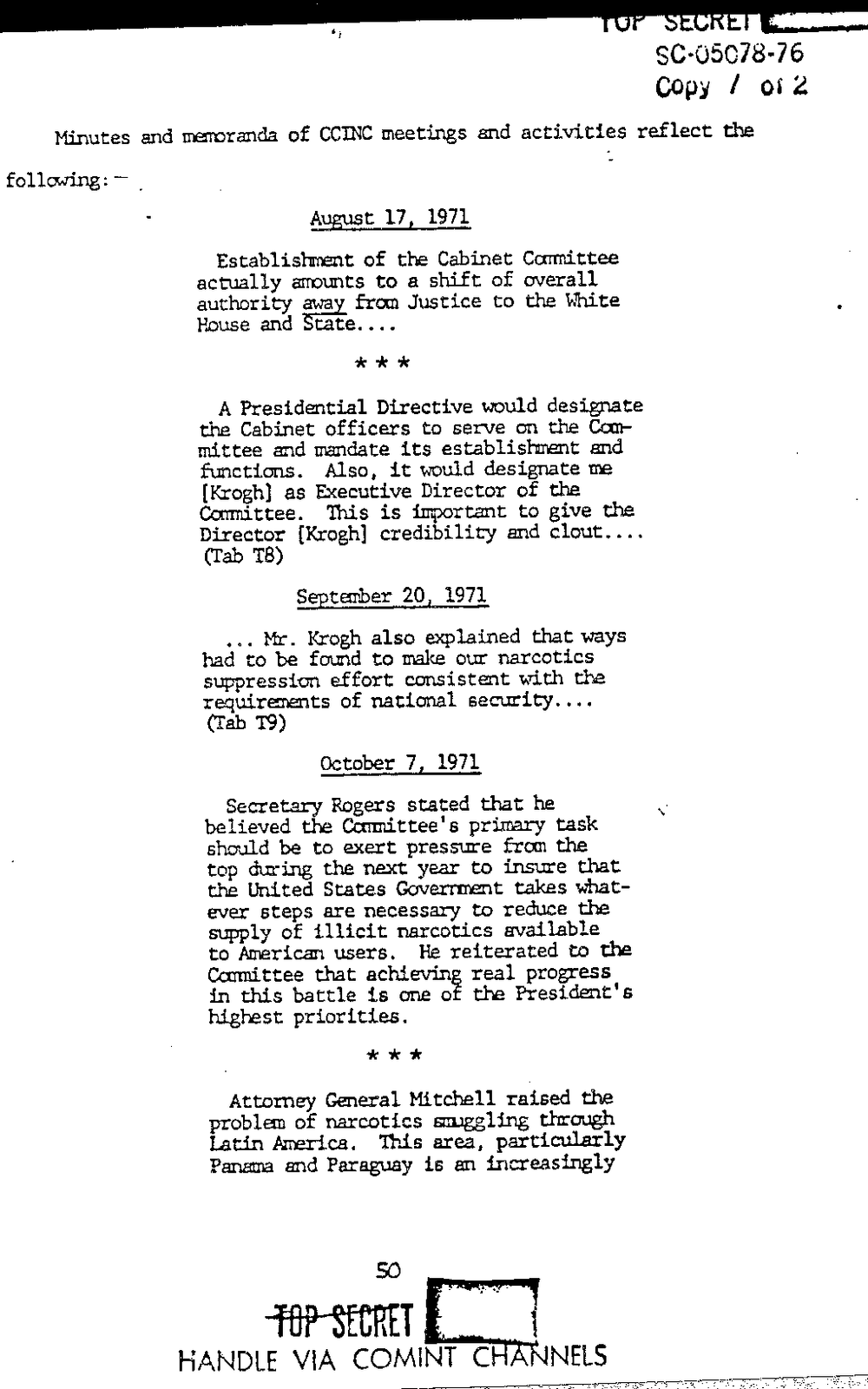
80-05078-76
Copy I as 2
Minutes and mrmda of CCIZNC meetings and activities reflect die
following:
August 17 1971
Establishment of the Cabinet Committee
actually ammts to a shift of overall
authority am from Justice to the White
House and tate. . . .
A Presidential Directive would designate
the Cabinet officers to serve on the Can-
mittee and mandate its establith and
fmctions. Also, it would designate me
[Krogh] as Executive Director of the
Committee. This is inportant to give the
Director [Krogh] credibility and clout. . . .
(Tab T8)
September 20, 1971
. . . Mr. Krogh also explained that ways
had to be found to make our narcotics
suppression effort consistent with the
requirements of national security. . ..
(Tab T9)
October 7, 1971
Secretary Rogers stated that he
believed the Committee's primary task
should be to exert pressure from the
top during the next year to insure that
the United States Government takes somat-
ever steps are necessary to reduce the
supply of illicit narcotics available
to American users. He reiterated to the
Cwmittee that achievin real progress
in this battle is one the President's
highest priorities.
Attorney General Mitchell raised the
problem of narcotics through
Latin America. This area, particularly
Panama and Paraguay is an increasingly
80-05078-76
Copy I as 2
Minutes and mrmda of CCIZNC meetings and activities reflect die
following:
August 17 1971
Establishment of the Cabinet Committee
actually ammts to a shift of overall
authority am from Justice to the White
House and tate. . . .
A Presidential Directive would designate
the Cabinet officers to serve on the Can-
mittee and mandate its establith and
fmctions. Also, it would designate me
[Krogh] as Executive Director of the
Committee. This is inportant to give the
Director [Krogh] credibility and clout. . . .
(Tab T8)
September 20, 1971
. . . Mr. Krogh also explained that ways
had to be found to make our narcotics
suppression effort consistent with the
requirements of national security. . ..
(Tab T9)
October 7, 1971
Secretary Rogers stated that he
believed the Committee's primary task
should be to exert pressure from the
top during the next year to insure that
the United States Government takes somat-
ever steps are necessary to reduce the
supply of illicit narcotics available
to American users. He reiterated to the
Cwmittee that achievin real progress
in this battle is one the President's
highest priorities.
Attorney General Mitchell raised the
problem of narcotics through
Latin America. This area, particularly
Panama and Paraguay is an increasingly
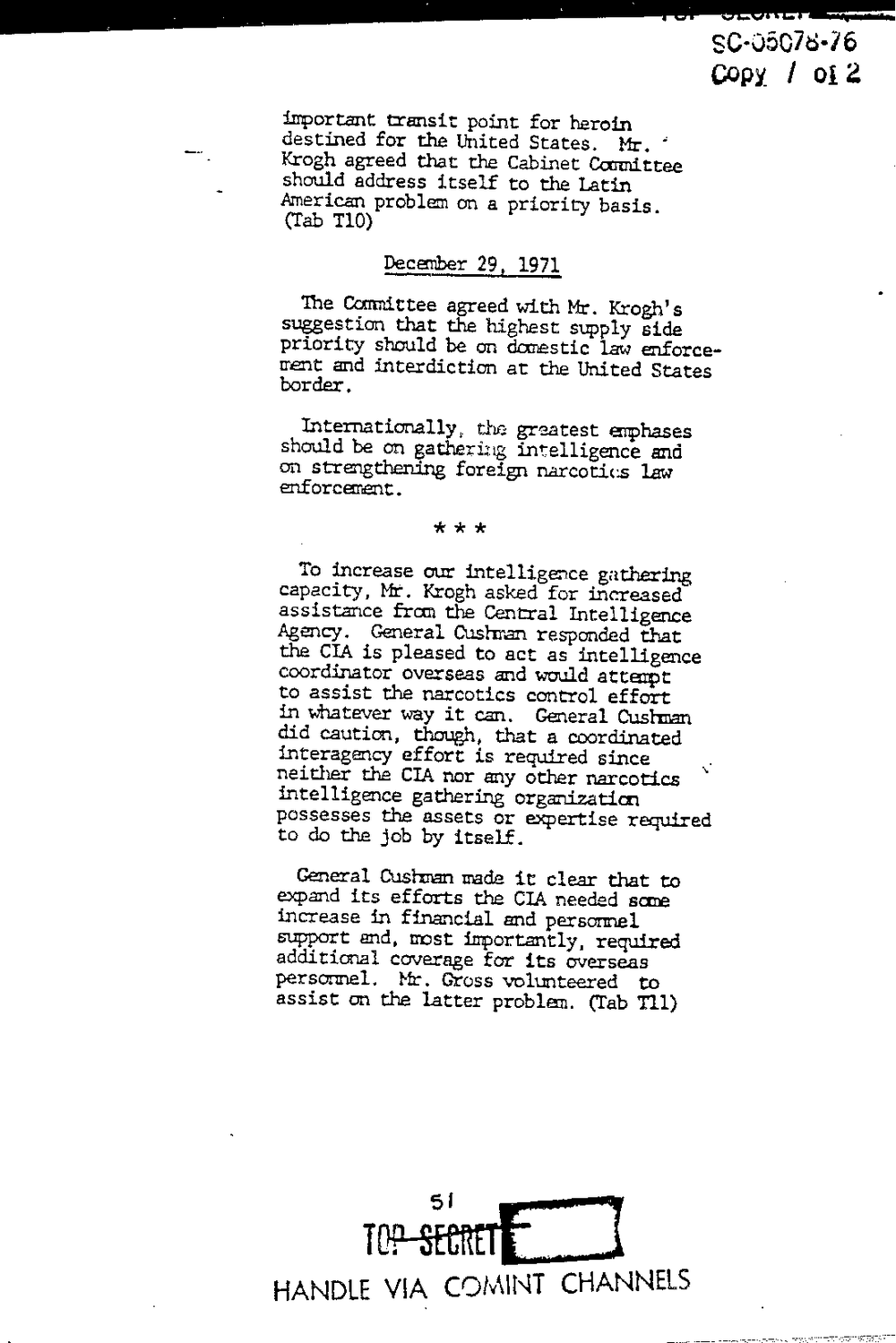
30.05075-76
Copy: 1 012
important transit point for heroin
destined for the United States. Mr.
Krogh agreed that the Cabinet Committee
should address itself to the Latin
American problem on a priority basis.
(Tab T10)
December 29, 1971
The Connittee agreed with Mr. Krogh's
suggestion that the highest supply side
priority should be on domestic law enforce?
ment and interdiction at the United States
border.
Internationally, the greatest emphases
should be on gathering intelligence and
on strengthening foreign narcotics law
enforcement.
*nl'n'r
To increase our intelligence gathering
capacity, Mr. Krogh asked for increased
assistance from the Central Intelligence
Agency. General Cushnan responded that
the CIA is pleased to act as intelligence
coordinator overseas and would attempt
to assist the narcotics control effort
in whatever way it can. General Cushnan
did caution, though, that a coordinated
interagency effort is required since
neither the CIA nor any other narcotics
intelligence gathering organization
possesses the assets or expertise required
to do the job by itself.
General Cuslman made it clear that to
expand its efforts the CIA needed sane
increase in financial and personnel
support and, most importantly, required
additional coverage for its overseas
personnel. Mr. Gross voltmteered to
assist on the latter problem. (Tab 'I'll)
5
7%
HANDLE VIA CHANNELS
30.05075-76
Copy: 1 012
important transit point for heroin
destined for the United States. Mr.
Krogh agreed that the Cabinet Committee
should address itself to the Latin
American problem on a priority basis.
(Tab T10)
December 29, 1971
The Connittee agreed with Mr. Krogh's
suggestion that the highest supply side
priority should be on domestic law enforce?
ment and interdiction at the United States
border.
Internationally, the greatest emphases
should be on gathering intelligence and
on strengthening foreign narcotics law
enforcement.
*nl'n'r
To increase our intelligence gathering
capacity, Mr. Krogh asked for increased
assistance from the Central Intelligence
Agency. General Cushnan responded that
the CIA is pleased to act as intelligence
coordinator overseas and would attempt
to assist the narcotics control effort
in whatever way it can. General Cushnan
did caution, though, that a coordinated
interagency effort is required since
neither the CIA nor any other narcotics
intelligence gathering organization
possesses the assets or expertise required
to do the job by itself.
General Cuslman made it clear that to
expand its efforts the CIA needed sane
increase in financial and personnel
support and, most importantly, required
additional coverage for its overseas
personnel. Mr. Gross voltmteered to
assist on the latter problem. (Tab 'I'll)
5
7%
HANDLE VIA CHANNELS
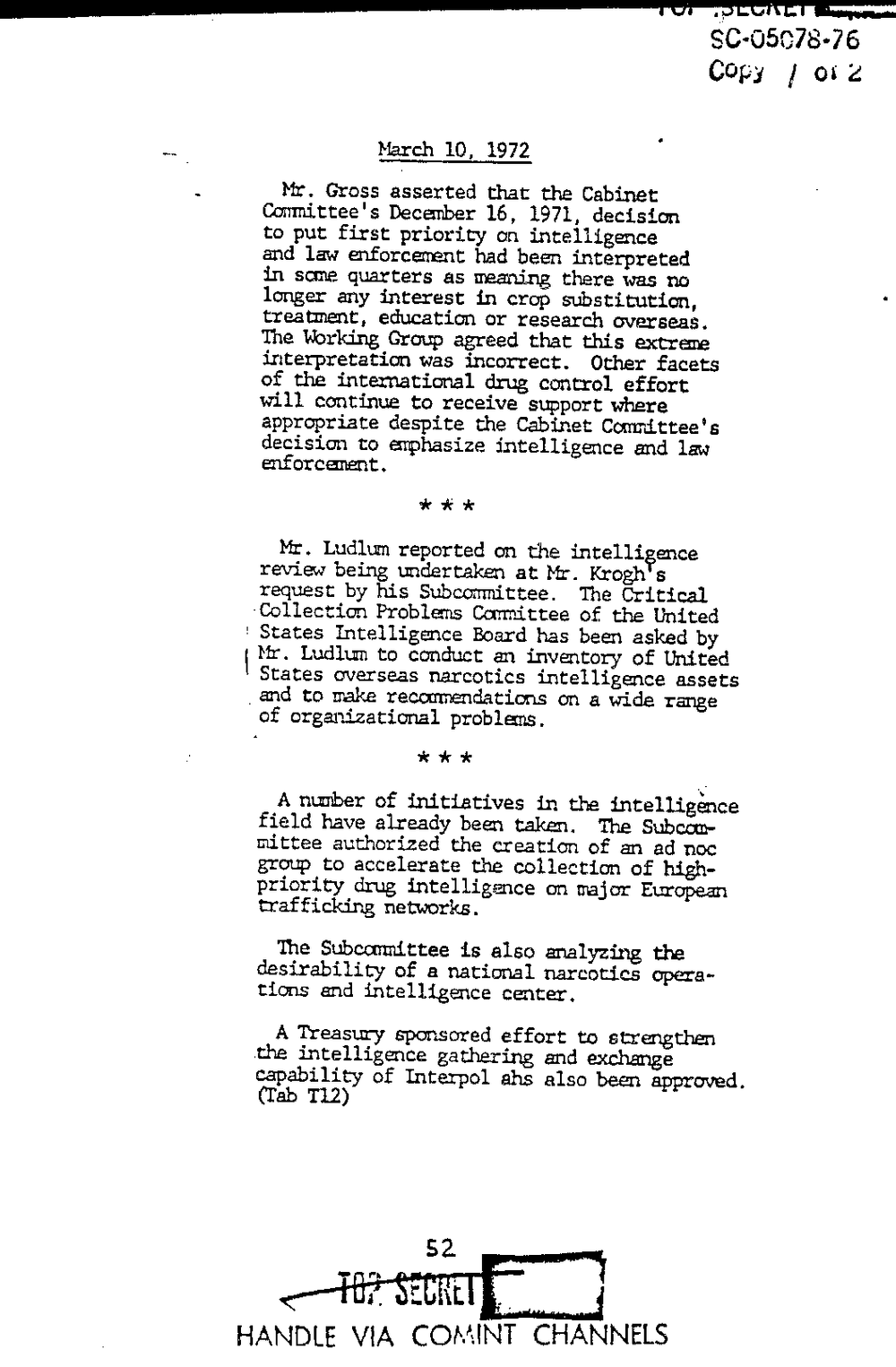
Seasons-76
Cop-y ox 2
March 10 1972
Mr. Gross asserted that the Cabinet
Committee's December 16, 1971, decision
to put first priority on intelligence
and law enforcement had been interpreted
in some quarters as neaning there was no
longer any interest in crop substitution,
treatment, education or research overseas.
The Group agreed that this extreme
interpretation was incorrect. Other facets
of the international drug control effort
will continue to receive support where
appropriate despite the Cabinet Conmittee?s
decision to emphasize intelligence and law
enforcement.
a-
Mr. Ludlum reported on the intelli ence
review being mdertaken at Mr. Krogh a
request by his Subconmittee. The Critical
Collection Problems Committee of. the United
States Intelligence Board has been asked by
Mr. Ludlum to conduct an inventory of United
States overseas narcotics intelligence assets
I and to make recoonmdatims on a wide rmge
of organizational problems.
A number of initiatives in the intelligence
field have already been taken. The Subcom?
mittee authorized the creation of an ad noc
group to accelerate the collection of high-
priority drug intelligence on mjor European
trafficking networks.
The Subcwmittee is also analyzing the
desirability of a national narcotics opera-
tions and intelligence center.
A Treasury sponsored effort to strengthen
the intelligence gathering and exchange
capability of Interpol ahs also been approved.
(Tab T12)
52.
at?.
HANDLE VIA COMINT CHANNELS
Seasons-76
Cop-y ox 2
March 10 1972
Mr. Gross asserted that the Cabinet
Committee's December 16, 1971, decision
to put first priority on intelligence
and law enforcement had been interpreted
in some quarters as neaning there was no
longer any interest in crop substitution,
treatment, education or research overseas.
The Group agreed that this extreme
interpretation was incorrect. Other facets
of the international drug control effort
will continue to receive support where
appropriate despite the Cabinet Conmittee?s
decision to emphasize intelligence and law
enforcement.
a-
Mr. Ludlum reported on the intelli ence
review being mdertaken at Mr. Krogh a
request by his Subconmittee. The Critical
Collection Problems Committee of. the United
States Intelligence Board has been asked by
Mr. Ludlum to conduct an inventory of United
States overseas narcotics intelligence assets
I and to make recoonmdatims on a wide rmge
of organizational problems.
A number of initiatives in the intelligence
field have already been taken. The Subcom?
mittee authorized the creation of an ad noc
group to accelerate the collection of high-
priority drug intelligence on mjor European
trafficking networks.
The Subcwmittee is also analyzing the
desirability of a national narcotics opera-
tions and intelligence center.
A Treasury sponsored effort to strengthen
the intelligence gathering and exchange
capability of Interpol ahs also been approved.
(Tab T12)
52.
at?.
HANDLE VIA COMINT CHANNELS
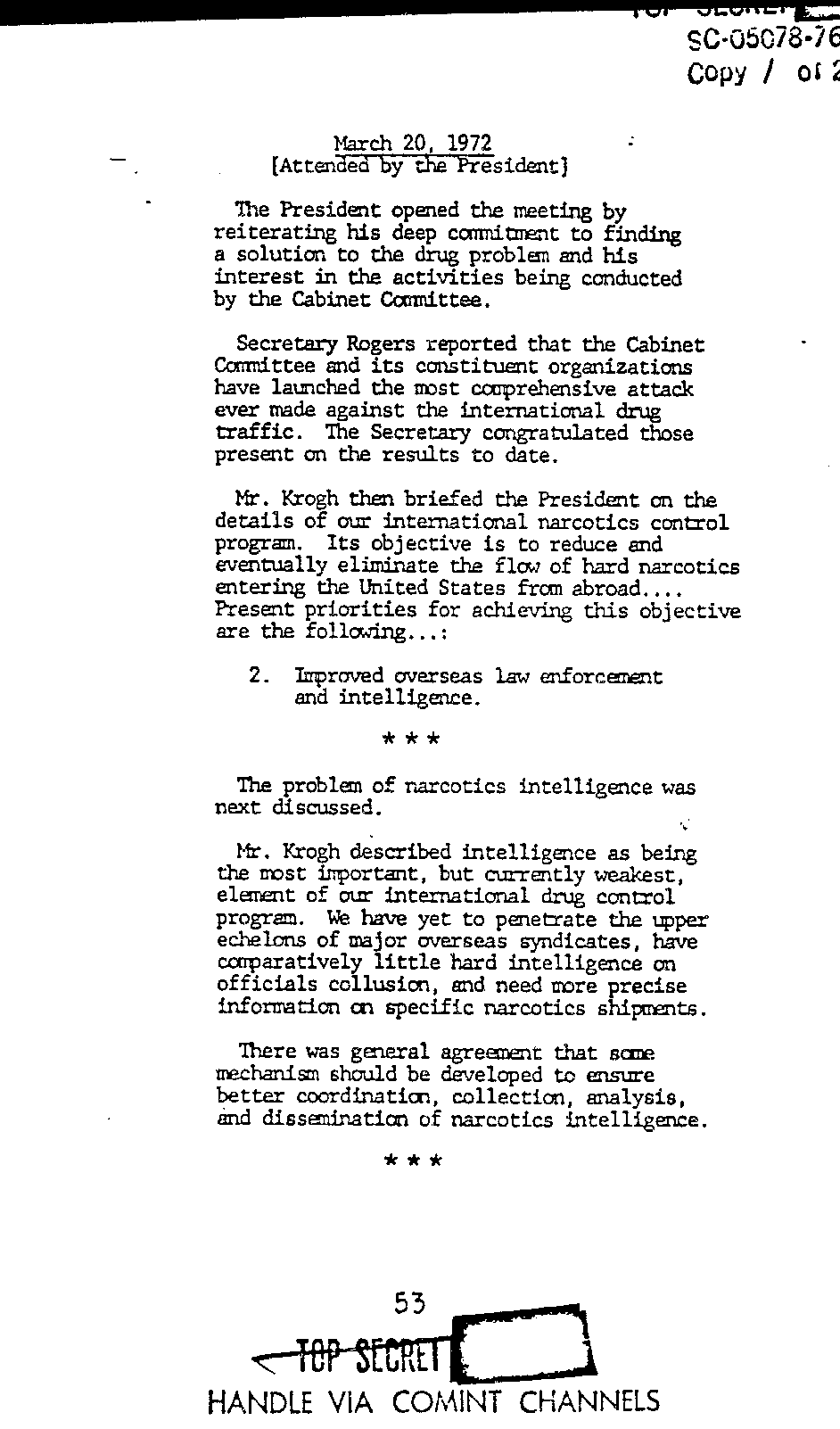
80-05078-76
Copy 0?2
March 20. 1972
[Attended By the ?esident]
The President opened the meeting by
reiterating his deep coronth to finding
a solution to the drug problen and his
interest in the activities being conducted
by the Cabinet Committee.
Secretary Rogers reported that the Cabinet
Committee and its constituent organizations
have launched the most comprehensive attack
ever made against the international drug
traffic. The Secretary congratulated those
present on the results to date.
Mr. Krogh then briefed the President. on the
details of our international narcotics control
program. Its objective is to reduce and
eventually elinn?nate the flow of hard narcotics
entering the United States from abroad. . . .
Present priorities for achieving this objective
are the follming. . .:
2. Improved overseas law enforcement
and intelligence.
The problen of narcotics intelligence was
next discussed.
5
Hr. Krogh described intelligence as being
the most important, but currently weakest,
element of our international drug control
progr. We have yet to penetrate the upper
echelons of major overseas syndicates, have
comparatively little hard intelligence on
officials collusion, and need more precise
information on specific narcotics shipments.
There was general agreement that acme
mechanism should be developed to ensure
better coordination, collection, analysis.
and disseninatim of narcotics intelligence.
5'5
HANDLE CHANNELS
80-05078-76
Copy 0?2
March 20. 1972
[Attended By the ?esident]
The President opened the meeting by
reiterating his deep coronth to finding
a solution to the drug problen and his
interest in the activities being conducted
by the Cabinet Committee.
Secretary Rogers reported that the Cabinet
Committee and its constituent organizations
have launched the most comprehensive attack
ever made against the international drug
traffic. The Secretary congratulated those
present on the results to date.
Mr. Krogh then briefed the President. on the
details of our international narcotics control
program. Its objective is to reduce and
eventually elinn?nate the flow of hard narcotics
entering the United States from abroad. . . .
Present priorities for achieving this objective
are the follming. . .:
2. Improved overseas law enforcement
and intelligence.
The problen of narcotics intelligence was
next discussed.
5
Hr. Krogh described intelligence as being
the most important, but currently weakest,
element of our international drug control
progr. We have yet to penetrate the upper
echelons of major overseas syndicates, have
comparatively little hard intelligence on
officials collusion, and need more precise
information on specific narcotics shipments.
There was general agreement that acme
mechanism should be developed to ensure
better coordination, collection, analysis.
and disseninatim of narcotics intelligence.
5'5
HANDLE CHANNELS
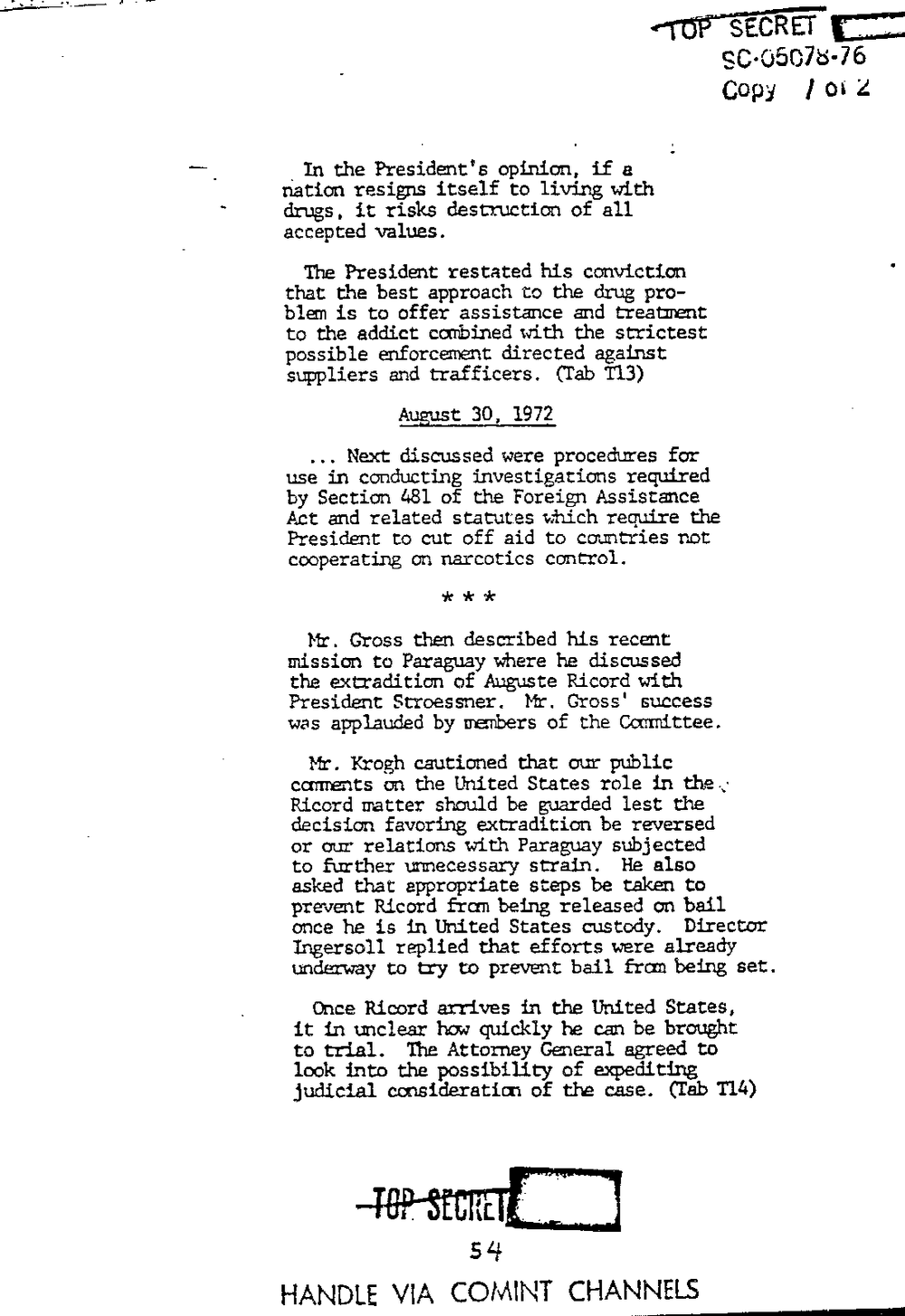
SECRET
800507546
Copy I cl; 2
In the President's opinion, if a -
nation resigns itself to living with
drugs, it risks destruction of all
accepted values.
The President restated his conviction
that the best approach to the drug pro-
blem is to offer assistance and treatment
to the addict combined with the strictest
possible enforcement directed against
suppliers and trafficers. (Tab T13)
August 30, 1972
.. . Next discussed were procedures for
use in conducting investigations required
by Section 481 of the Foreign Assistance
Act and related statutes which require the
President to cut off aid to countries not
cooperating on narcotics control.
Mr. Gross then described his recent
mission to Paraguay where he discussed
the extradition of Auguste Ricord with
President Stroessner. Mr. Gross' success
was applauded by members of the Committee.
Mr. Krogh cautioned that our public
comments on the United States role in the
Ricord matter should be guarded lest the
decision favoring extradition be reversed
or our relations with Paraguay subjected
to further unnecessary strain. He also
asked that appropriate steps be taken to
prevent Ricord being released on bail
once he is in United States custody. Director
Ingersoll replied that efforts were already
underway to try to prevent bail being set.
Once Rioord arrives in the United States,
it: in unclear how quickly he can be brought
to trial. The Attorney General agreed to
look into the possibility of expediting
judicial cmsideratim of the case. (Tab T14)
51+
HANDLE VIA COMINT CHANNELS
SECRET
800507546
Copy I cl; 2
In the President's opinion, if a -
nation resigns itself to living with
drugs, it risks destruction of all
accepted values.
The President restated his conviction
that the best approach to the drug pro-
blem is to offer assistance and treatment
to the addict combined with the strictest
possible enforcement directed against
suppliers and trafficers. (Tab T13)
August 30, 1972
.. . Next discussed were procedures for
use in conducting investigations required
by Section 481 of the Foreign Assistance
Act and related statutes which require the
President to cut off aid to countries not
cooperating on narcotics control.
Mr. Gross then described his recent
mission to Paraguay where he discussed
the extradition of Auguste Ricord with
President Stroessner. Mr. Gross' success
was applauded by members of the Committee.
Mr. Krogh cautioned that our public
comments on the United States role in the
Ricord matter should be guarded lest the
decision favoring extradition be reversed
or our relations with Paraguay subjected
to further unnecessary strain. He also
asked that appropriate steps be taken to
prevent Ricord being released on bail
once he is in United States custody. Director
Ingersoll replied that efforts were already
underway to try to prevent bail being set.
Once Rioord arrives in the United States,
it: in unclear how quickly he can be brought
to trial. The Attorney General agreed to
look into the possibility of expediting
judicial cmsideratim of the case. (Tab T14)
51+
HANDLE VIA COMINT CHANNELS
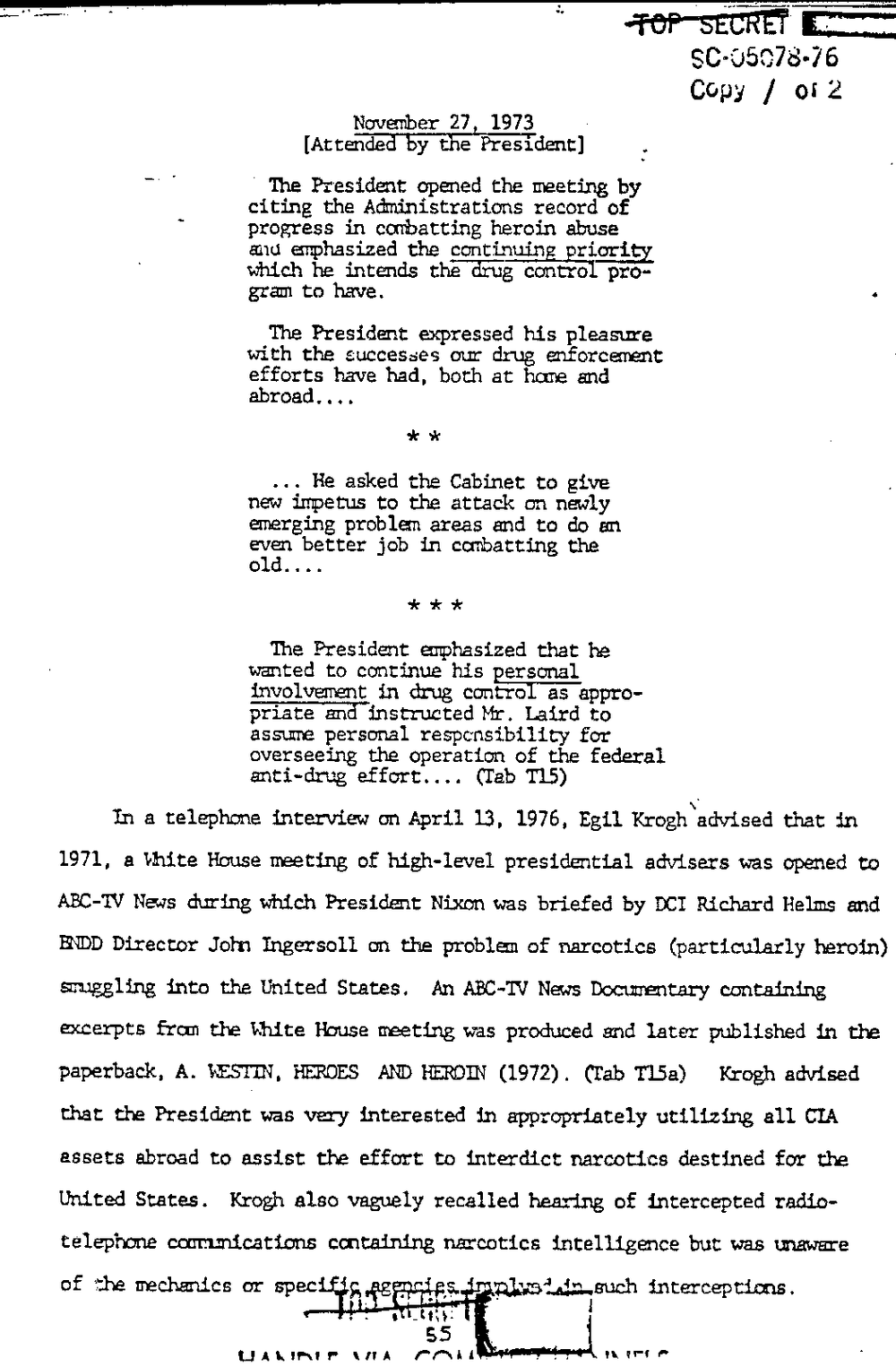
80'05378-76
COpy 0:2
November 27, 1973
[Attended by the President]
a
The President Opened the meeting by
citing the Administrations record of
progress in conbatting heroin abuse
and enphasized the continuing priority
which he intends the drug control pro-
gram to have. -
The President expressed his pleasure
with the successes our drug enforcement
efforts have had, both at hare and
*ir
. . . He asked the Cabinet to give
new impetus to the attack on newly
emerging problem areas and to do an
even better job in ccmbatting the
old. . . .
The President emphasized that he
waited to continue his ersonal
involvement in drug control as appro-
priate and instructed Mr. Laird to
assume personal responsibility for
overseeing the operation of the federal
anti-dmg effort. . .. (Tab T15)
In a telephone interview on April 13. 1976, Egil Kroghxadv-ised that in
1971, a White House meeting of high-level presidential advisers was opened to
ABC-TV News during which President Nixon was briefed by DCI Richard Helms and
BNDD Director Join Ingersoll on the problem of narcotics (particularly heroin)
wiggling into the United States. An ABC-TV News Documentary containing
excerpts ?rm the White House testing was produced and later published in the
paperback, A. m, PERDES AND (1972). (Tab Krogh advised
that the President was very interested in appropriately utilizing all CIA
assets abroad to assist the effort to interdict narcotics destined for the
United States. Krogh also vaguely recalled hearing of intercepted radio-
telep'mne coomznications cmtaining narcotics intelligence but was We
of the medianics or spec
80'05378-76
COpy 0:2
November 27, 1973
[Attended by the President]
a
The President Opened the meeting by
citing the Administrations record of
progress in conbatting heroin abuse
and enphasized the continuing priority
which he intends the drug control pro-
gram to have. -
The President expressed his pleasure
with the successes our drug enforcement
efforts have had, both at hare and
*ir
. . . He asked the Cabinet to give
new impetus to the attack on newly
emerging problem areas and to do an
even better job in ccmbatting the
old. . . .
The President emphasized that he
waited to continue his ersonal
involvement in drug control as appro-
priate and instructed Mr. Laird to
assume personal responsibility for
overseeing the operation of the federal
anti-dmg effort. . .. (Tab T15)
In a telephone interview on April 13. 1976, Egil Kroghxadv-ised that in
1971, a White House meeting of high-level presidential advisers was opened to
ABC-TV News during which President Nixon was briefed by DCI Richard Helms and
BNDD Director Join Ingersoll on the problem of narcotics (particularly heroin)
wiggling into the United States. An ABC-TV News Documentary containing
excerpts ?rm the White House testing was produced and later published in the
paperback, A. m, PERDES AND (1972). (Tab Krogh advised
that the President was very interested in appropriately utilizing all CIA
assets abroad to assist the effort to interdict narcotics destined for the
United States. Krogh also vaguely recalled hearing of intercepted radio-
telep'mne coomznications cmtaining narcotics intelligence but was We
of the medianics or spec
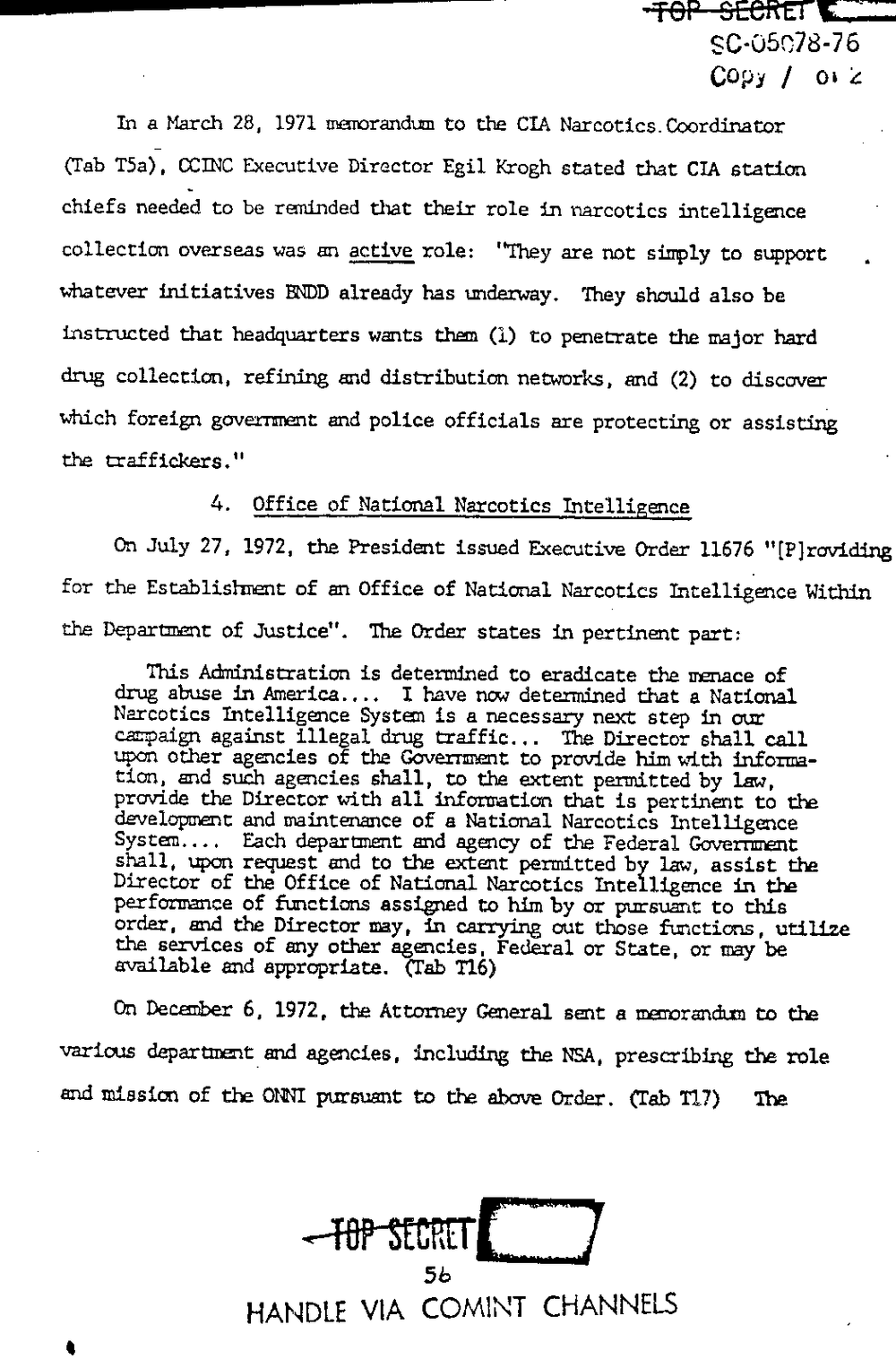
seesaw-75
COW 0 '4
In a March 28, 1971 mermrandim to the CIA Narcotics.erdinator
(Tab T5a)_, CCINC Executive Director Egil Krogh stated that CIA station
chiefs needed to be reminded that their role in narcotics intelligence
collection overseas was an active role: "They are not simply to support
whatever initiatives EIDD already has underway. They should also be
instructed that headquarters wants them (1) to penetrate the major hard
drug collection, refining and distribution networks, and (2) to discover
which foreign government and police officials are protecting or assisting
the traffickers."
4. Office of National Narcotics Intelligence
On July 27, 1972, the President issued Executive Order 11676 "[P]roviding
for the Establith of an Office of National Narcotics Intelligence Within
the Deparmmt of Justice". The Order states in pertinent part:
This Administration is determined to eradicate the menace of
drug abuse in America. I have hm determined that a National
Narcotics Intelligence System is a necessary next step in our
carpaign against illegal drug traffic. . . The Director shall call
upon other agencies of the to provide him with informa-
tion, and such agencies shall, to the extent permitted by law,
provide the Director with all information that is pertinent to the
develowment and maintenance of a National Narcotics Intelligence
System . .. Each and agency of the Federal Gmrermmt
shall, upon request and to the extent permitted by law, assist the
Director of the Office of National Narcotics lnte ligence in the
performance of functions assigned to him by or pursuant to this
order. and the Director may, in carrying out those fmetions, utilize
the services of any other agencies, Federal or State, or may be
available and appropriate. (Tab T16)
On December 6, 1972, the Attorney General sent a mes-cram to the
various department?and agencies, including the NBA, prescribing the role
and mission of the pursuant to the above Order. (Tab Tl?) The
St:
HANDLE VIA COMINT CHANNELS
seesaw-75
COW 0 '4
In a March 28, 1971 mermrandim to the CIA Narcotics.erdinator
(Tab T5a)_, CCINC Executive Director Egil Krogh stated that CIA station
chiefs needed to be reminded that their role in narcotics intelligence
collection overseas was an active role: "They are not simply to support
whatever initiatives EIDD already has underway. They should also be
instructed that headquarters wants them (1) to penetrate the major hard
drug collection, refining and distribution networks, and (2) to discover
which foreign government and police officials are protecting or assisting
the traffickers."
4. Office of National Narcotics Intelligence
On July 27, 1972, the President issued Executive Order 11676 "[P]roviding
for the Establith of an Office of National Narcotics Intelligence Within
the Deparmmt of Justice". The Order states in pertinent part:
This Administration is determined to eradicate the menace of
drug abuse in America. I have hm determined that a National
Narcotics Intelligence System is a necessary next step in our
carpaign against illegal drug traffic. . . The Director shall call
upon other agencies of the to provide him with informa-
tion, and such agencies shall, to the extent permitted by law,
provide the Director with all information that is pertinent to the
develowment and maintenance of a National Narcotics Intelligence
System . .. Each and agency of the Federal Gmrermmt
shall, upon request and to the extent permitted by law, assist the
Director of the Office of National Narcotics lnte ligence in the
performance of functions assigned to him by or pursuant to this
order. and the Director may, in carrying out those fmetions, utilize
the services of any other agencies, Federal or State, or may be
available and appropriate. (Tab T16)
On December 6, 1972, the Attorney General sent a mes-cram to the
various department?and agencies, including the NBA, prescribing the role
and mission of the pursuant to the above Order. (Tab Tl?) The
St:
HANDLE VIA COMINT CHANNELS
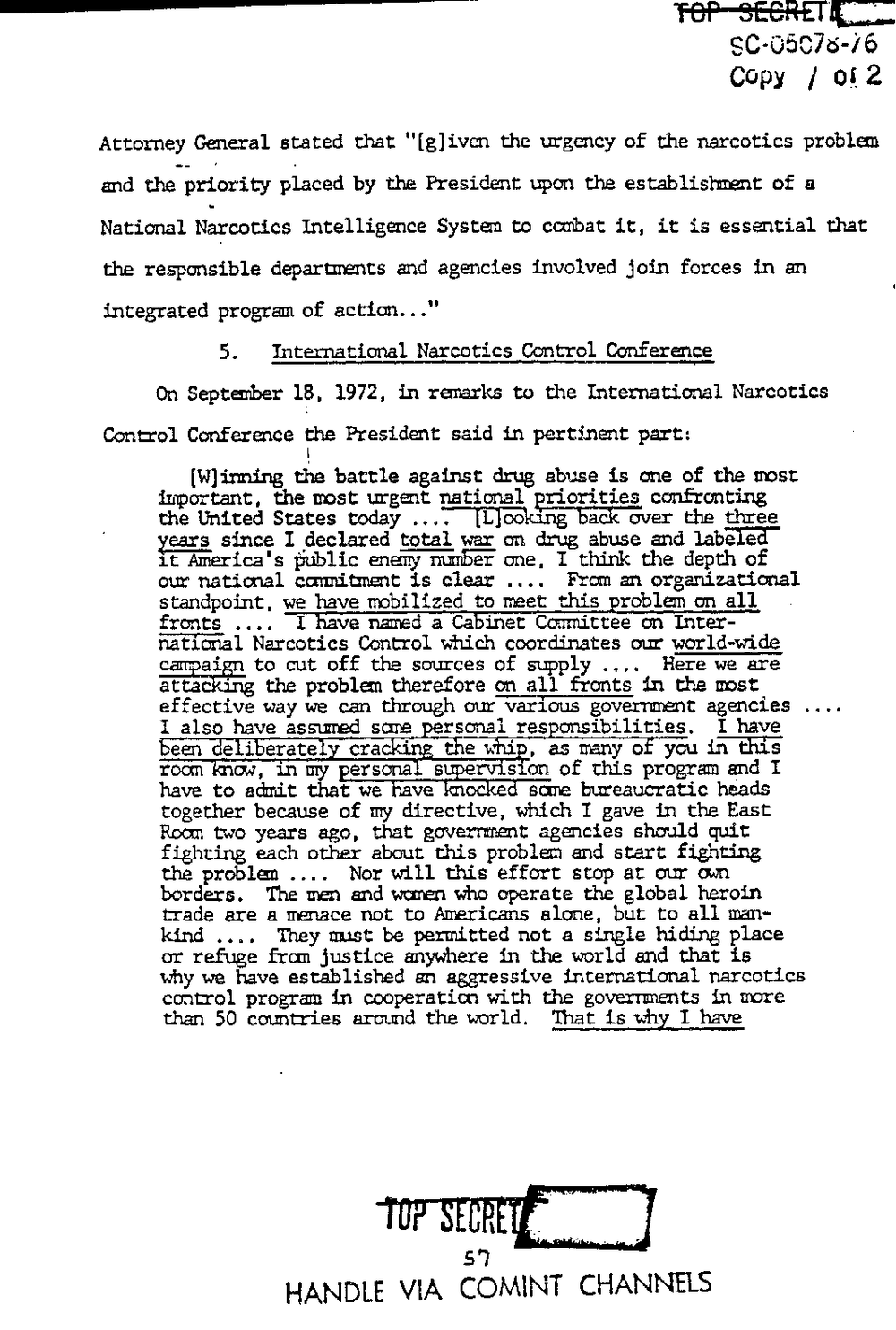
800507546
Copy o! 2
Attorney General stated that "[g]iven the urgency of the narcotics problem
and the-priority placed by the President upon the establith of a
National Narcotics Intelligence System to ccnbat it, it is essential that
the responsible departments and agencies involved join forces in an
integrated program of action. .
5. International Narcotics Control Conference
On September 18, 1972, in remarks to the International Narcotics
Control Conference President said in pertinent part:
[Wlirming the battle against drug abuse is one of the most
important. the most urgent national priorities confronting
the United States today .. . . [Hooking back over the three
years since I declared total war on drug abuse and labeled
1t America's public enemy numb?e? one, I think the depth of
our national cmu?tment is clear . . . . From an organizational
standpoint, we have mobilized to meet this problem on all
fronts . . . . I have named a Cabinet Committee on Inter-
national Narcotics Control which coordinates our world-wide
ai to cut off the sources of supply .. .. Here we are
?g the problem therefore on all fronts in the most
effective way we can through our various government agencies . . . .
I also have assumed same personal responsibilities. I have
been deliberately cracking the whip, as many of you in this
in my personal supervision of this program and I
have to admit that we haves??ocked some bureaucratic heads
together because of my directive, which I gave in the East
Room two years ago, that government agencies should quit
fighting each other about this problem and start fighting
the problem . . .. Nor will this effort stop at our om
borders. The men and wcmen who Operate the global heroin
trade are a menace not to Americans alone, but to all man-
kind . .. . They must be permitted not a single hiding place
or refuge from justice anywhere in the world and that is
why we have established an aggressive international narcotics
control program in cooperation with the governments in more
than 50 countries around the world. 'Ihat is have
5'7
HANDLE VIA COMINT CHANNELS
800507546
Copy o! 2
Attorney General stated that "[g]iven the urgency of the narcotics problem
and the-priority placed by the President upon the establith of a
National Narcotics Intelligence System to ccnbat it, it is essential that
the responsible departments and agencies involved join forces in an
integrated program of action. .
5. International Narcotics Control Conference
On September 18, 1972, in remarks to the International Narcotics
Control Conference President said in pertinent part:
[Wlirming the battle against drug abuse is one of the most
important. the most urgent national priorities confronting
the United States today .. . . [Hooking back over the three
years since I declared total war on drug abuse and labeled
1t America's public enemy numb?e? one, I think the depth of
our national cmu?tment is clear . . . . From an organizational
standpoint, we have mobilized to meet this problem on all
fronts . . . . I have named a Cabinet Committee on Inter-
national Narcotics Control which coordinates our world-wide
ai to cut off the sources of supply .. .. Here we are
?g the problem therefore on all fronts in the most
effective way we can through our various government agencies . . . .
I also have assumed same personal responsibilities. I have
been deliberately cracking the whip, as many of you in this
in my personal supervision of this program and I
have to admit that we haves??ocked some bureaucratic heads
together because of my directive, which I gave in the East
Room two years ago, that government agencies should quit
fighting each other about this problem and start fighting
the problem . . .. Nor will this effort stop at our om
borders. The men and wcmen who Operate the global heroin
trade are a menace not to Americans alone, but to all man-
kind . .. . They must be permitted not a single hiding place
or refuge from justice anywhere in the world and that is
why we have established an aggressive international narcotics
control program in cooperation with the governments in more
than 50 countries around the world. 'Ihat is have
5'7
HANDLE VIA COMINT CHANNELS
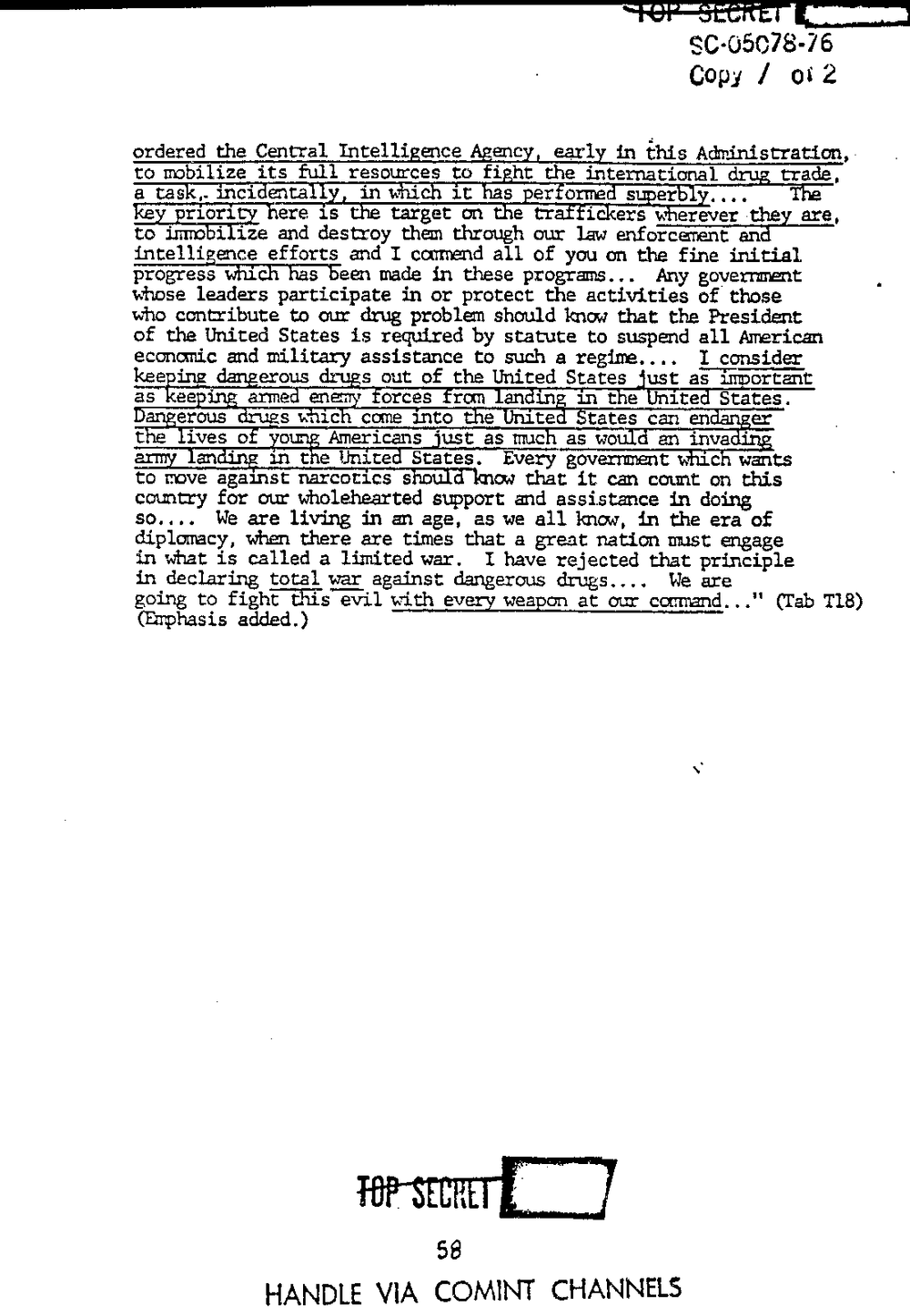
(SC-0507846
COpy 08 2
ordered the Central Intelligence gang, early in this Administration,
to mobilize its full resources to fight the international drug trade.
a task.. incidentallyg in which it has performed superbly. . . . Tm
ke riori here is the target on the traffickers wherever they are.
to immobilize and destroy than through our law enforth and
intelligence efforts and I contend all of you on the fine initial
progress which has been made in these programs. . . Any government
those leaders participate in or protect the activities of those
who contribute to our drug problem should know that the President
of the United States is required by statute to suspend all American
economic and military assistance to such a regime. . . . I consider
keeping dangerous drugs out of the United States just as important
as keeping armed enemy forces from landing in the United States.
Dangerous drugs which come into the United States can endanger
the lives of yomg Americans just as much as would an invading
army landing in the United States. Every government which wants
to move against narcotics should know that it can count on this
country for our wholehearted support and assistance in doing
We are living in an age, as we all know, in the era of
diplomacy, when there are times that a great nation must engage
in what is called a limited war. I have rejected that principle
in declaring total against dangerous drugs? . . We are
going to fight this evil with every weapon at our command. . (Tab T18)
(Emphasis added.)
HANDLE VIA COMINT CHANNELS
(SC-0507846
COpy 08 2
ordered the Central Intelligence gang, early in this Administration,
to mobilize its full resources to fight the international drug trade.
a task.. incidentallyg in which it has performed superbly. . . . Tm
ke riori here is the target on the traffickers wherever they are.
to immobilize and destroy than through our law enforth and
intelligence efforts and I contend all of you on the fine initial
progress which has been made in these programs. . . Any government
those leaders participate in or protect the activities of those
who contribute to our drug problem should know that the President
of the United States is required by statute to suspend all American
economic and military assistance to such a regime. . . . I consider
keeping dangerous drugs out of the United States just as important
as keeping armed enemy forces from landing in the United States.
Dangerous drugs which come into the United States can endanger
the lives of yomg Americans just as much as would an invading
army landing in the United States. Every government which wants
to move against narcotics should know that it can count on this
country for our wholehearted support and assistance in doing
We are living in an age, as we all know, in the era of
diplomacy, when there are times that a great nation must engage
in what is called a limited war. I have rejected that principle
in declaring total against dangerous drugs? . . We are
going to fight this evil with every weapon at our command. . (Tab T18)
(Emphasis added.)
HANDLE VIA COMINT CHANNELS
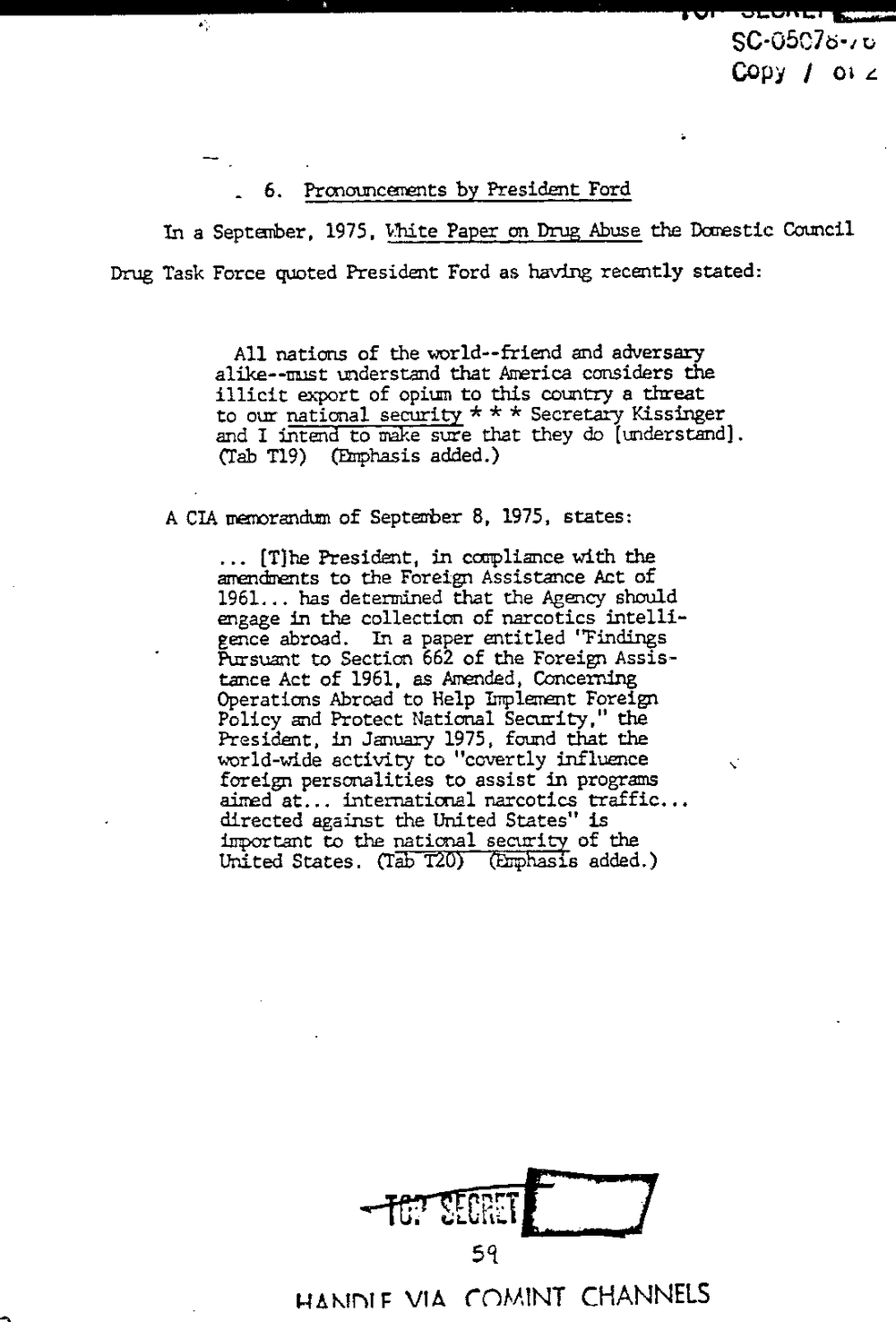
Copy I o:
. 6. by President Ford
In a September, 1975. White Paper on Drug Abuse the Domestic Council
Drug Task Force quoted President Ford as having recently stated:
All nations of the world--friend and adversary
alike-must understand that America considers the
illicit export of opium to this country a threat
to our national security Secretary Kissinger
and I intend to make sure that they do [understand].
(Tab T19) (Emphasis added.)
A CIA memorandum of Septetber 8, 1975, states:
.. . [T]he Presida'xt, in compliance with the
to the Foreig1 Assistance Act of
1961. . . has determined that the Agency should
engage in the collection of narcotics intelli-
gence abroad. In a paper entitled "Findings
Pin-sumt to Section 662 of the Foreign Assis-
tance Act of 1961, as Amended, Concerning
Operations Abroad to Help Implement Foreign
Policy md Protect National Security." the
President, in January 1975, found that the
world-wide activity to "covertly influence
foreign personalities to assist in programs
aimed at. . . internatimal narcotics
directed against the United States" is
important to the national security of the
United States. (TED T20) (Emphasis added.)
VIA (OMINT CHANNELS
Copy I o:
. 6. by President Ford
In a September, 1975. White Paper on Drug Abuse the Domestic Council
Drug Task Force quoted President Ford as having recently stated:
All nations of the world--friend and adversary
alike-must understand that America considers the
illicit export of opium to this country a threat
to our national security Secretary Kissinger
and I intend to make sure that they do [understand].
(Tab T19) (Emphasis added.)
A CIA memorandum of Septetber 8, 1975, states:
.. . [T]he Presida'xt, in compliance with the
to the Foreig1 Assistance Act of
1961. . . has determined that the Agency should
engage in the collection of narcotics intelli-
gence abroad. In a paper entitled "Findings
Pin-sumt to Section 662 of the Foreign Assis-
tance Act of 1961, as Amended, Concerning
Operations Abroad to Help Implement Foreign
Policy md Protect National Security." the
President, in January 1975, found that the
world-wide activity to "covertly influence
foreign personalities to assist in programs
aimed at. . . internatimal narcotics
directed against the United States" is
important to the national security of the
United States. (TED T20) (Emphasis added.)
VIA (OMINT CHANNELS
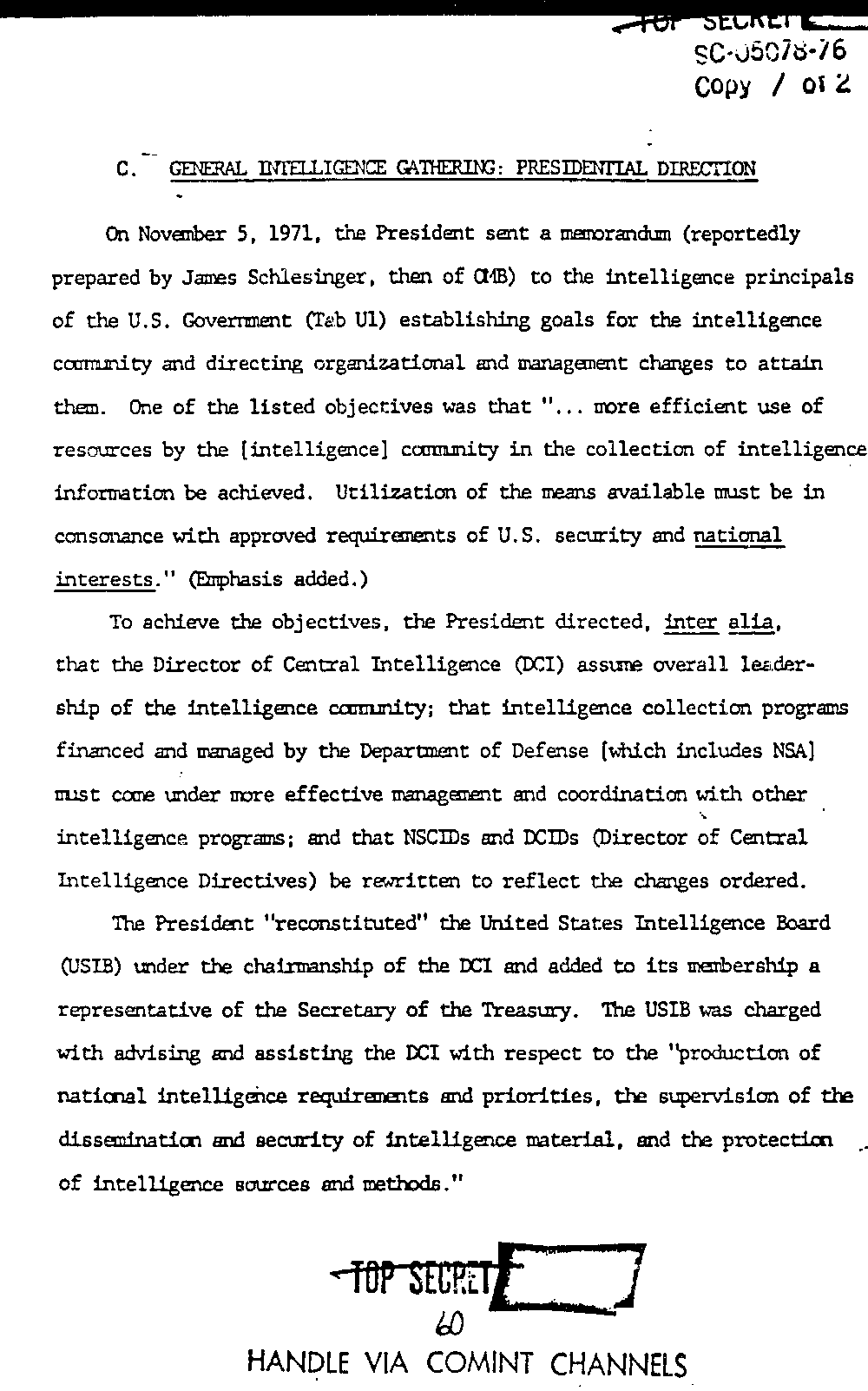
800507846
COpy 0i 2
C. GENERAL INTELLIGENCE cam: PRESIDENTIAL DIRECTION
On November 5, 1971. the President sent a memrandim (reportedly
prepared by James Schlesinger. then of (MB) to the intelligence principals
of the 11.5. Goverment (Tab U1) establishing goals for the intelligence
comnmity and directing organizational and management changes to attain
them. One of the listed objectives was that . . more efficient use of
resources by the [intelligence] in the collection of intelligence
information be achieved. Utilization of the means available must be in
consonance with approved requirenents of U.S. security and national
interests." (Bi-phasis added.)
To achieve the objectives, the President directed, alga,
that the Director of Central Intelligence (DCI) assume overall leader-
ship of the intelligence mmity; that intelligence collection programs
financed and managed by the of Defense [which includes
must come more effective Irenath and coordination with other I
intelligence programs; and that NSCIDs and 1301135 (Director of Central
Intelligence Directives) be rewritten to reflect the changes ordered.
The Presidmt "reconstituted" the United States Intelligence Board
(USIB) under the chairmanship of the D01 and added to its umbership a
representative of the Secretary of the Treasury. 'Ihe USIB was charged
with advising and assisting the DCI with respect to the "production of
natimal intelligdice reqx?remmts and priorities, the supervision of the
disseminaticn and security of intelligence material, and the protection
of intelligence sources and methods."
60
HANDLE VIA COMINT CHANNELS
800507846
COpy 0i 2
C. GENERAL INTELLIGENCE cam: PRESIDENTIAL DIRECTION
On November 5, 1971. the President sent a memrandim (reportedly
prepared by James Schlesinger. then of (MB) to the intelligence principals
of the 11.5. Goverment (Tab U1) establishing goals for the intelligence
comnmity and directing organizational and management changes to attain
them. One of the listed objectives was that . . more efficient use of
resources by the [intelligence] in the collection of intelligence
information be achieved. Utilization of the means available must be in
consonance with approved requirenents of U.S. security and national
interests." (Bi-phasis added.)
To achieve the objectives, the President directed, alga,
that the Director of Central Intelligence (DCI) assume overall leader-
ship of the intelligence mmity; that intelligence collection programs
financed and managed by the of Defense [which includes
must come more effective Irenath and coordination with other I
intelligence programs; and that NSCIDs and 1301135 (Director of Central
Intelligence Directives) be rewritten to reflect the changes ordered.
The Presidmt "reconstituted" the United States Intelligence Board
(USIB) under the chairmanship of the D01 and added to its umbership a
representative of the Secretary of the Treasury. 'Ihe USIB was charged
with advising and assisting the DCI with respect to the "production of
natimal intelligdice reqx?remmts and priorities, the supervision of the
disseminaticn and security of intelligence material, and the protection
of intelligence sources and methods."
60
HANDLE VIA COMINT CHANNELS
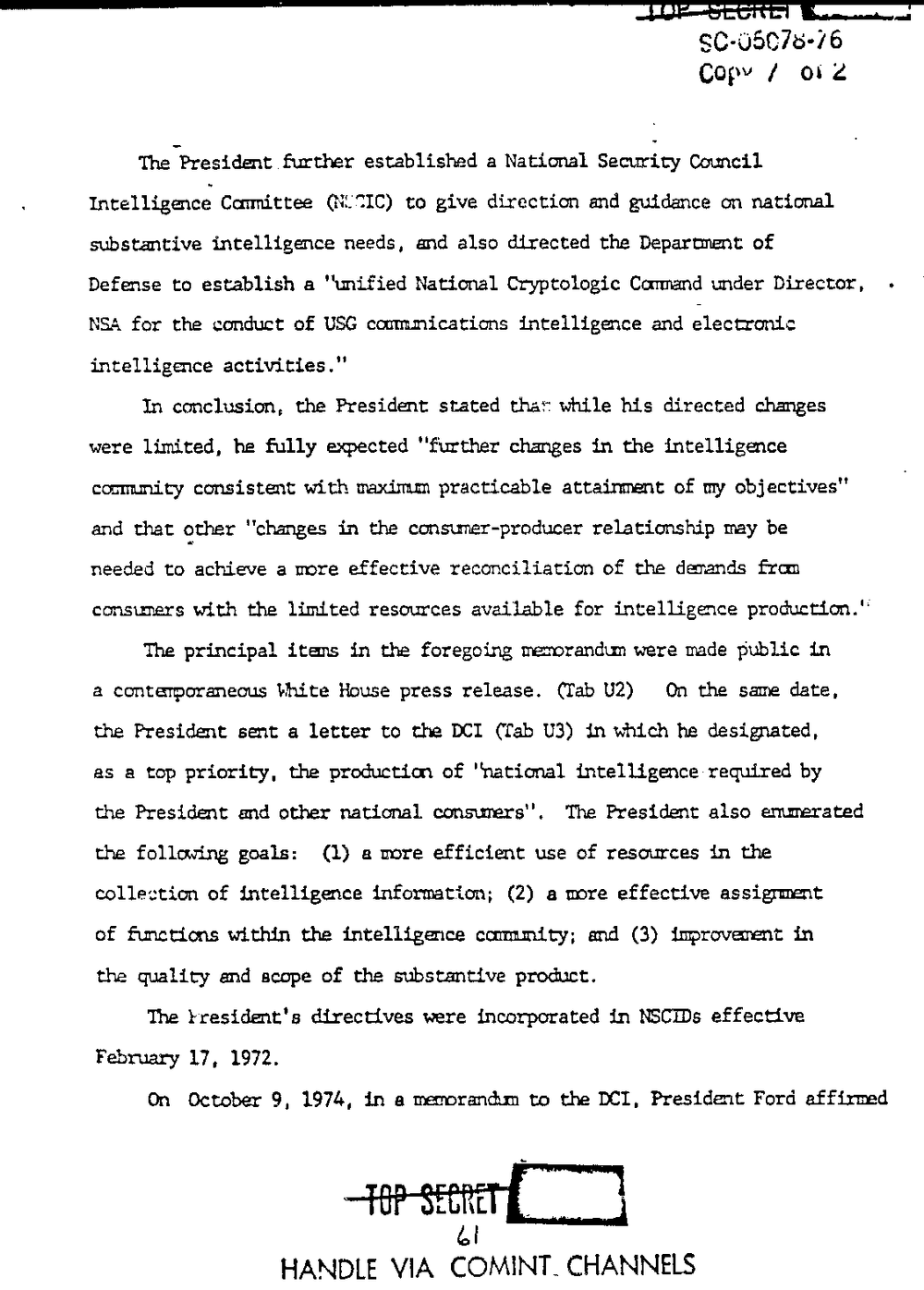
30-05075-26
COpv 0:
?re?Presidmtfurther established a National Security Council
Intelligence Cmittee to give direction and guidance on national
substantive intelligence needs, and also directed the Department of
Defense to establish a "unified National Cmmand under Director.
NSA for the conduct of USG communications intelligence and electronic
intelligence activities .
In conclusion. the President stated that. while his directed charges
were limited, he fully expected ?further changes in the intelligence
commity consistent with maxim practicable attainment of my objectives"
and that other "changes in the manner-producer relationship may be
needed to achieve a more effective reconciliation of the demands from
consumers with the limited resources available for intelligence production."
The principal itans in the foregoing memorandLm were trade public in
a cmtarporaneous White House press release. (Tab U2) 0n the sane date,
the President sent a letter to the DCI (Tab U3) in which he desigmted,
as a top priority, the production of "national intelligmce-required by
the President and other national consmers". The President also emerated
the following goals: (1) a more efficient use of resources in the
collection of intelligence information; (2) a more effective assigment
of within the intelligence cmznity; and (3) improvement in
the quality and scope of the substantive product.
The kresidmt's directives were incorporated in NSCIDs effective
February 17. 1972.
On October 9. 1.974, in a mrmdun to the DCI, President Ford affirmed
at
HANDLE VIA COMINT- CHANNELS
30-05075-26
COpv 0:
?re?Presidmtfurther established a National Security Council
Intelligence Cmittee to give direction and guidance on national
substantive intelligence needs, and also directed the Department of
Defense to establish a "unified National Cmmand under Director.
NSA for the conduct of USG communications intelligence and electronic
intelligence activities .
In conclusion. the President stated that. while his directed charges
were limited, he fully expected ?further changes in the intelligence
commity consistent with maxim practicable attainment of my objectives"
and that other "changes in the manner-producer relationship may be
needed to achieve a more effective reconciliation of the demands from
consumers with the limited resources available for intelligence production."
The principal itans in the foregoing memorandLm were trade public in
a cmtarporaneous White House press release. (Tab U2) 0n the sane date,
the President sent a letter to the DCI (Tab U3) in which he desigmted,
as a top priority, the production of "national intelligmce-required by
the President and other national consmers". The President also emerated
the following goals: (1) a more efficient use of resources in the
collection of intelligence information; (2) a more effective assigment
of within the intelligence cmznity; and (3) improvement in
the quality and scope of the substantive product.
The kresidmt's directives were incorporated in NSCIDs effective
February 17. 1972.
On October 9. 1.974, in a mrmdun to the DCI, President Ford affirmed
at
HANDLE VIA COMINT- CHANNELS
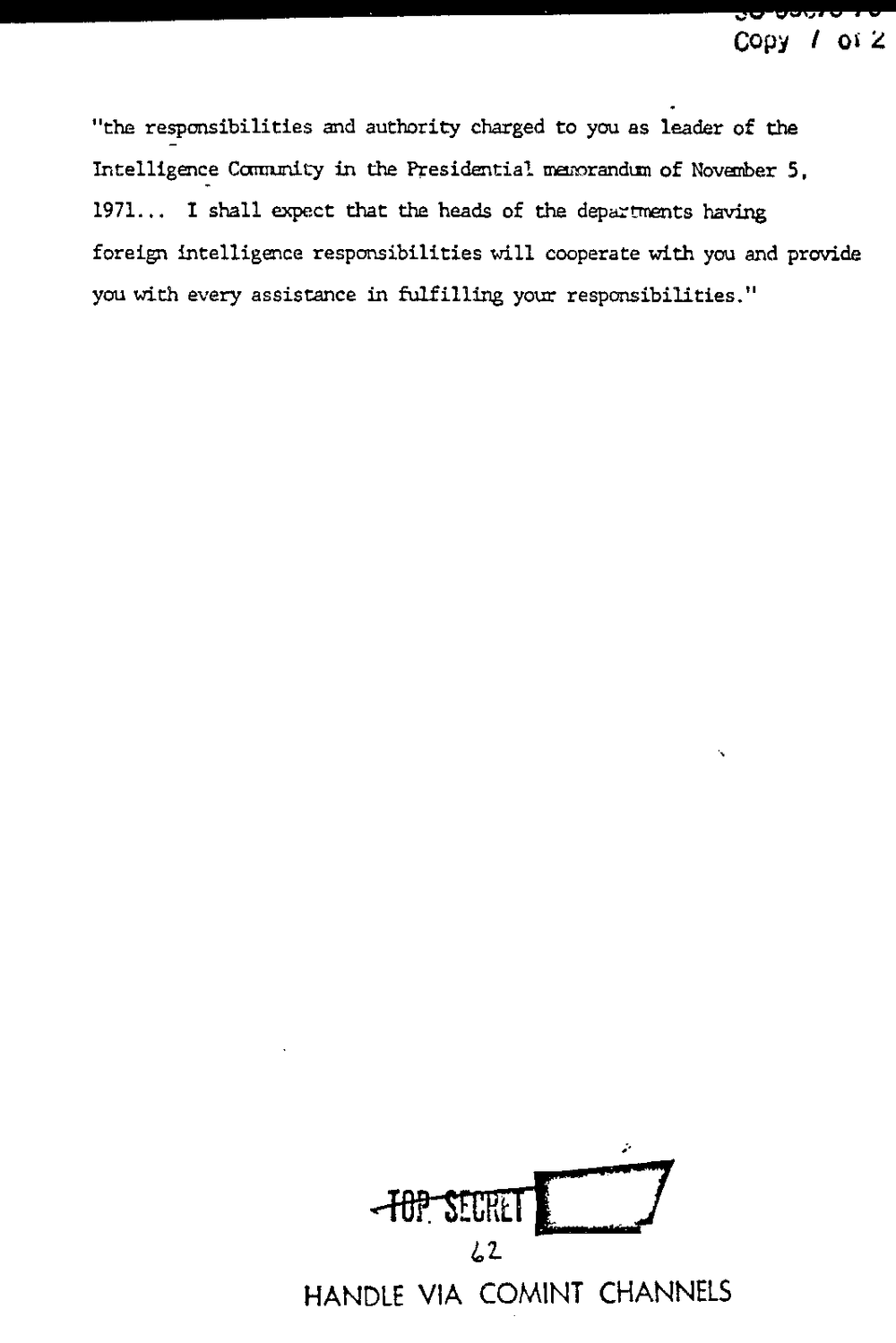
00513 I m?z
"the responsibilities and authority charged to you as leader of the
Intelligence Cormunity in the Residential memorandun of November 5.
I shall expect that the heads of the having
foreign intelligence responsibilities will cooperate with you and provide
you with every assistance in fulfilling your responsibilities."
.. (t
4,1
HANDLE VIA COMINT CHANNELS
00513 I m?z
"the responsibilities and authority charged to you as leader of the
Intelligence Cormunity in the Residential memorandun of November 5.
I shall expect that the heads of the having
foreign intelligence responsibilities will cooperate with you and provide
you with every assistance in fulfilling your responsibilities."
.. (t
4,1
HANDLE VIA COMINT CHANNELS
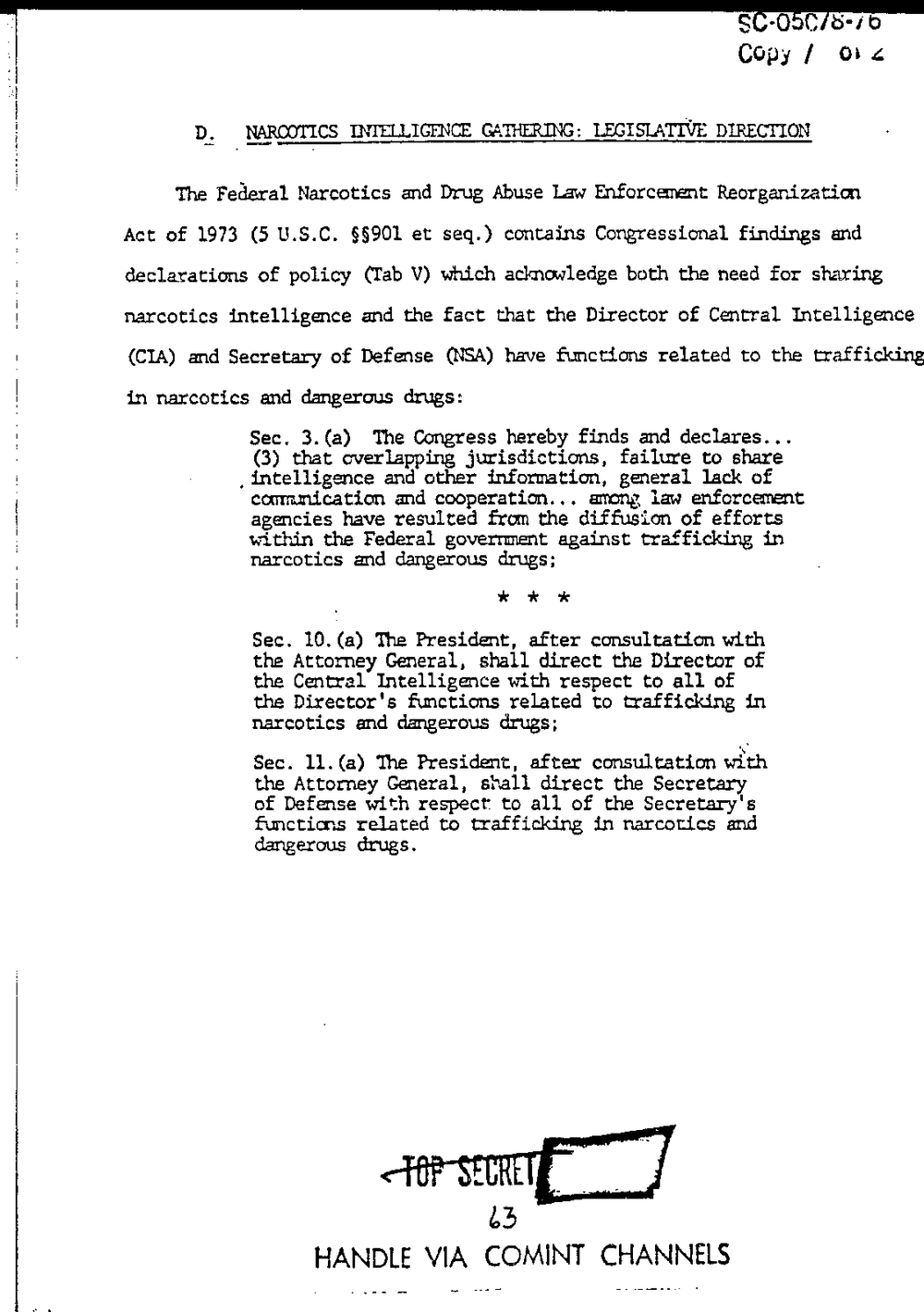
'0 b'vb
Copy 0t 4
D. Wes ammo: LEGISLATNE DIRECTION
The Federal Narcotics and Dung Abuse Law Enforcement Reorganization
Act of 1973 (5 U.S.C. ??901 et seq.) contains Congressional findings and
declarations of policy (Tab V) which acknowledge both the need for sharing
narcotics intelligence and the fact that the Director of Central Intelligence
(CIA) and Secretary of Defense (NSA) have functions related to the trafficking
in narcotics and dangerous drugs:
Sec. 3. The Congress hereby finds and declares. . .
(3) that overlapping jurisdictions, failure to share
,intelligence and other information, general lack of
cemmication and cooperation. . . 2 law enforcenent
agencies have resulted from the diffusion of efforts
within the Federal govermnent against trafficking in
narcotics and dangerous drugs;
*ir'k
Sec. 10. The President. after consultation with
the Attorney General, shall direct the Director of
the Central Intelligence with respect to all of
the Director's functions related to in
narcotics and dangerous drugs;
Sec. 11. line President, after consultation with
the Attorney General, shall direct the Secretary
of Defense with respect to all of the Secretary's
functims related to m'affiddng in narcotics and
dangerous drugs .
HANDLE VIA COMINT CHANNELS
'0 b'vb
Copy 0t 4
D. Wes ammo: LEGISLATNE DIRECTION
The Federal Narcotics and Dung Abuse Law Enforcement Reorganization
Act of 1973 (5 U.S.C. ??901 et seq.) contains Congressional findings and
declarations of policy (Tab V) which acknowledge both the need for sharing
narcotics intelligence and the fact that the Director of Central Intelligence
(CIA) and Secretary of Defense (NSA) have functions related to the trafficking
in narcotics and dangerous drugs:
Sec. 3. The Congress hereby finds and declares. . .
(3) that overlapping jurisdictions, failure to share
,intelligence and other information, general lack of
cemmication and cooperation. . . 2 law enforcenent
agencies have resulted from the diffusion of efforts
within the Federal govermnent against trafficking in
narcotics and dangerous drugs;
*ir'k
Sec. 10. The President. after consultation with
the Attorney General, shall direct the Director of
the Central Intelligence with respect to all of
the Director's functions related to in
narcotics and dangerous drugs;
Sec. 11. line President, after consultation with
the Attorney General, shall direct the Secretary
of Defense with respect to all of the Secretary's
functims related to m'affiddng in narcotics and
dangerous drugs .
HANDLE VIA COMINT CHANNELS
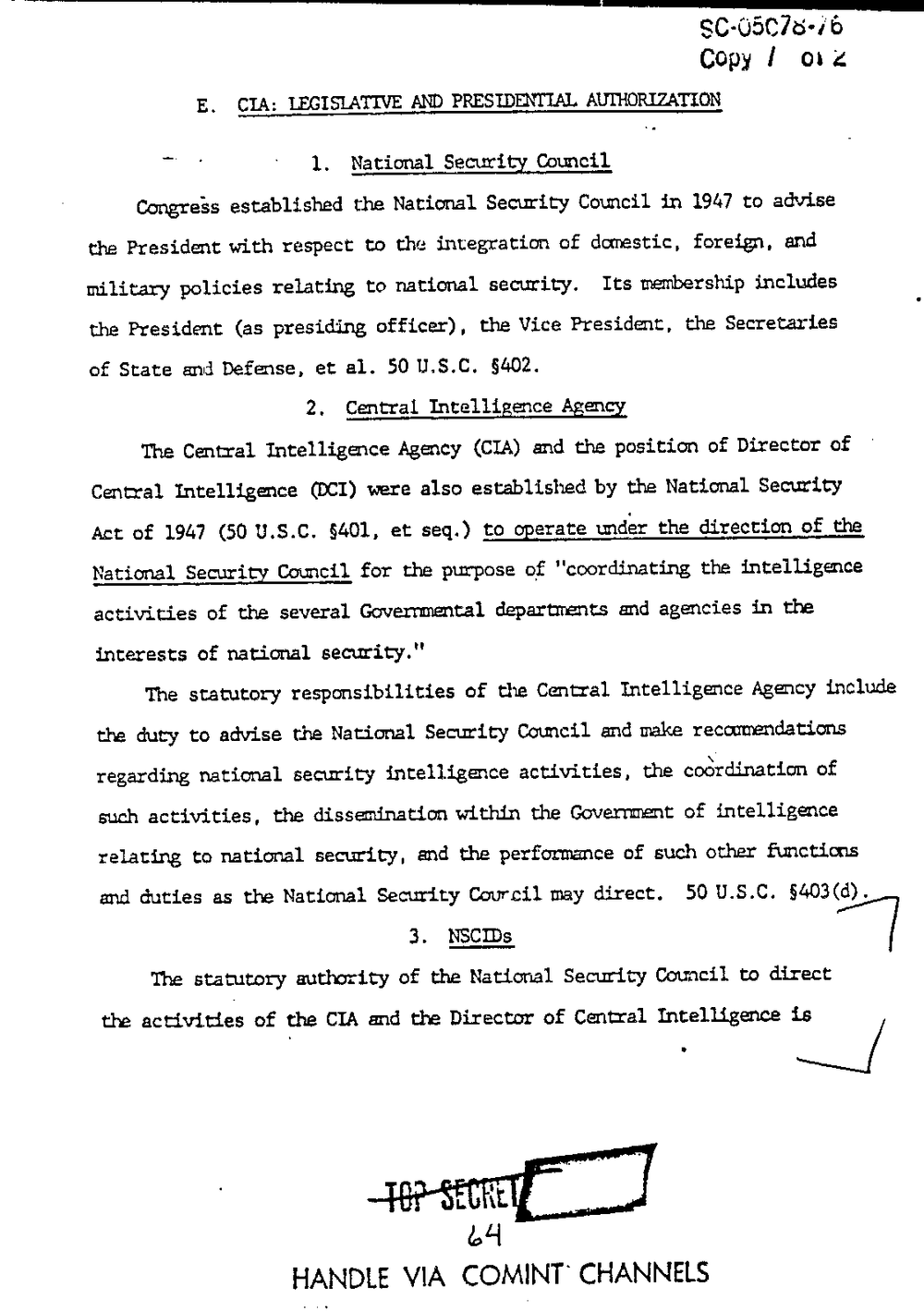
800507546
COpy I on a
E. CIA: AND AUIHORIZATION
1. National Security Council
Congress established the National Security Council in 1947 to advise
the President with respect to the integration of domestic, foreign, and
military policies relating to national security. Its membership includes
the President (as presiding officer), the Vice President, the Secretaries
of State and Defense, et al. 50 U.S.C. ?402.
2. Central Intelligence Agency
The Central Intelligence Agency (CIA) and the position of Director of
Central Intelligence (DCI) were also established by the National Security
Act of 1947 (50 11.5.0. 5401, et seq.) to operate under the direction of the
National Security Council for the purpose of "coordinating the intelligence
activities of the several Governmental departments and agencies in the
interests of national security."
The statutory responsibilities of the Central Intelligence Agency include
the duty to advise the National Security Council and make recouuendations
regarding national security intelligence activities, the coordination of
such activities, the dissemination within the Govermmt of intelligence
relating to national security, and the performance of such other ?mctions
and duties as the National Security Council may direct. 50 U.S.C. 5403(d).
a. 4
The statutory authority of the National Security Council to direct
the activities of the CIA and the Director of Central Intelligence
- 1/
HANDLE CHANNELS
800507546
COpy I on a
E. CIA: AND AUIHORIZATION
1. National Security Council
Congress established the National Security Council in 1947 to advise
the President with respect to the integration of domestic, foreign, and
military policies relating to national security. Its membership includes
the President (as presiding officer), the Vice President, the Secretaries
of State and Defense, et al. 50 U.S.C. ?402.
2. Central Intelligence Agency
The Central Intelligence Agency (CIA) and the position of Director of
Central Intelligence (DCI) were also established by the National Security
Act of 1947 (50 11.5.0. 5401, et seq.) to operate under the direction of the
National Security Council for the purpose of "coordinating the intelligence
activities of the several Governmental departments and agencies in the
interests of national security."
The statutory responsibilities of the Central Intelligence Agency include
the duty to advise the National Security Council and make recouuendations
regarding national security intelligence activities, the coordination of
such activities, the dissemination within the Govermmt of intelligence
relating to national security, and the performance of such other ?mctions
and duties as the National Security Council may direct. 50 U.S.C. 5403(d).
a. 4
The statutory authority of the National Security Council to direct
the activities of the CIA and the Director of Central Intelligence
- 1/
HANDLE CHANNELS
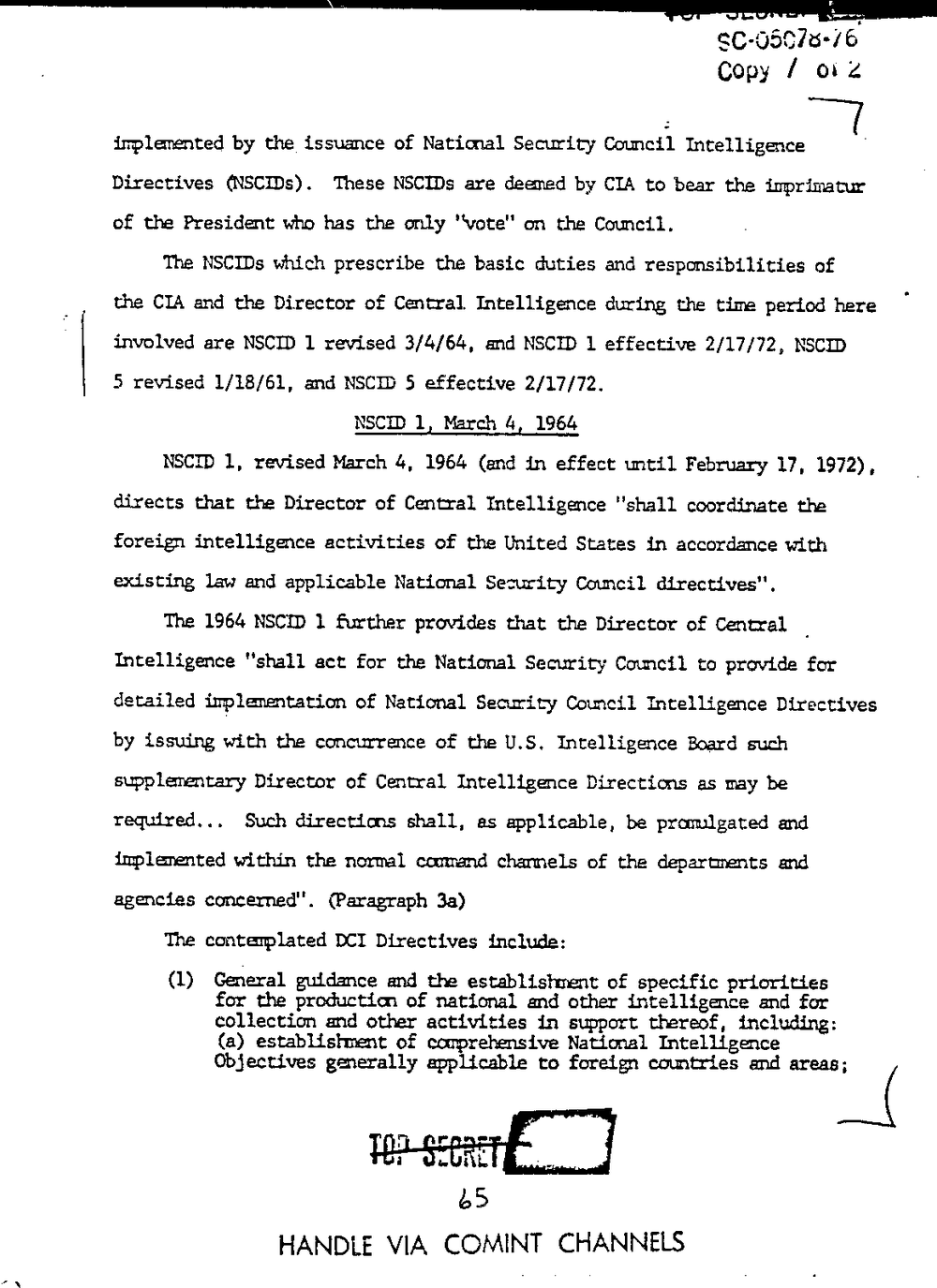
rec-0507546
00p} 012
implemented by the issuance of National Security Council Intelligence
Directives (NSCIDs). These NSCIDs are deemed by CIA to bear the imprimatur
of the President who has the only "vote" on the Council.
The NSCIDs which prescribe the basic duties and responsibilities of
the CIA and the Director of Central. Intelligence during the time period here
involved are NSCID 1 revised 3/4/64. and NSCID 1 effective 2/17/72, NSCID
5 revised 1/18/61. and NSCID 5 effective 2/17/72.
14 March 44 1964
NSCID 1, revised March 4, 1964 (and in effect until February 17, 1972) .
directs that the Director of Central Intelligence "shall coordinate the
foreign intelligence activities of the United States in accordance with
existing law and applicable National Semrity Cmmcil directives".
The 1964 NSCID 1 further provides that the Director of Central
Intelligence "shall act for the National Security Council to provide for
detailed implantation of National Security Council Intelligence Directives
by issuing with the concurrence of the U.S. Intelligence Board such
supplementary Director of Central Intelligence Directions as may be
Such directions shall, as applicable, be promulgated and
implemented witl'dn the normal cmmaml channels of the and
agencies concerned". (Paragraph 38)
The contemplated DCI Directives include:
(1) General guidance and the establislment of specific priorities
for the productim of national and other intelligence and for
collection and other activities in support thereof. including:
establisl'n?ent of cooprehensive National Intelligence
Objectives generally applicable to foreig1 comtries and areas;
I -
I ail.
?5
HANDLE VIA COMINT CHANNELS
rec-0507546
00p} 012
implemented by the issuance of National Security Council Intelligence
Directives (NSCIDs). These NSCIDs are deemed by CIA to bear the imprimatur
of the President who has the only "vote" on the Council.
The NSCIDs which prescribe the basic duties and responsibilities of
the CIA and the Director of Central. Intelligence during the time period here
involved are NSCID 1 revised 3/4/64. and NSCID 1 effective 2/17/72, NSCID
5 revised 1/18/61. and NSCID 5 effective 2/17/72.
14 March 44 1964
NSCID 1, revised March 4, 1964 (and in effect until February 17, 1972) .
directs that the Director of Central Intelligence "shall coordinate the
foreign intelligence activities of the United States in accordance with
existing law and applicable National Semrity Cmmcil directives".
The 1964 NSCID 1 further provides that the Director of Central
Intelligence "shall act for the National Security Council to provide for
detailed implantation of National Security Council Intelligence Directives
by issuing with the concurrence of the U.S. Intelligence Board such
supplementary Director of Central Intelligence Directions as may be
Such directions shall, as applicable, be promulgated and
implemented witl'dn the normal cmmaml channels of the and
agencies concerned". (Paragraph 38)
The contemplated DCI Directives include:
(1) General guidance and the establislment of specific priorities
for the productim of national and other intelligence and for
collection and other activities in support thereof. including:
establisl'n?ent of cooprehensive National Intelligence
Objectives generally applicable to foreig1 comtries and areas;
I -
I ail.
?5
HANDLE VIA COMINT CHANNELS
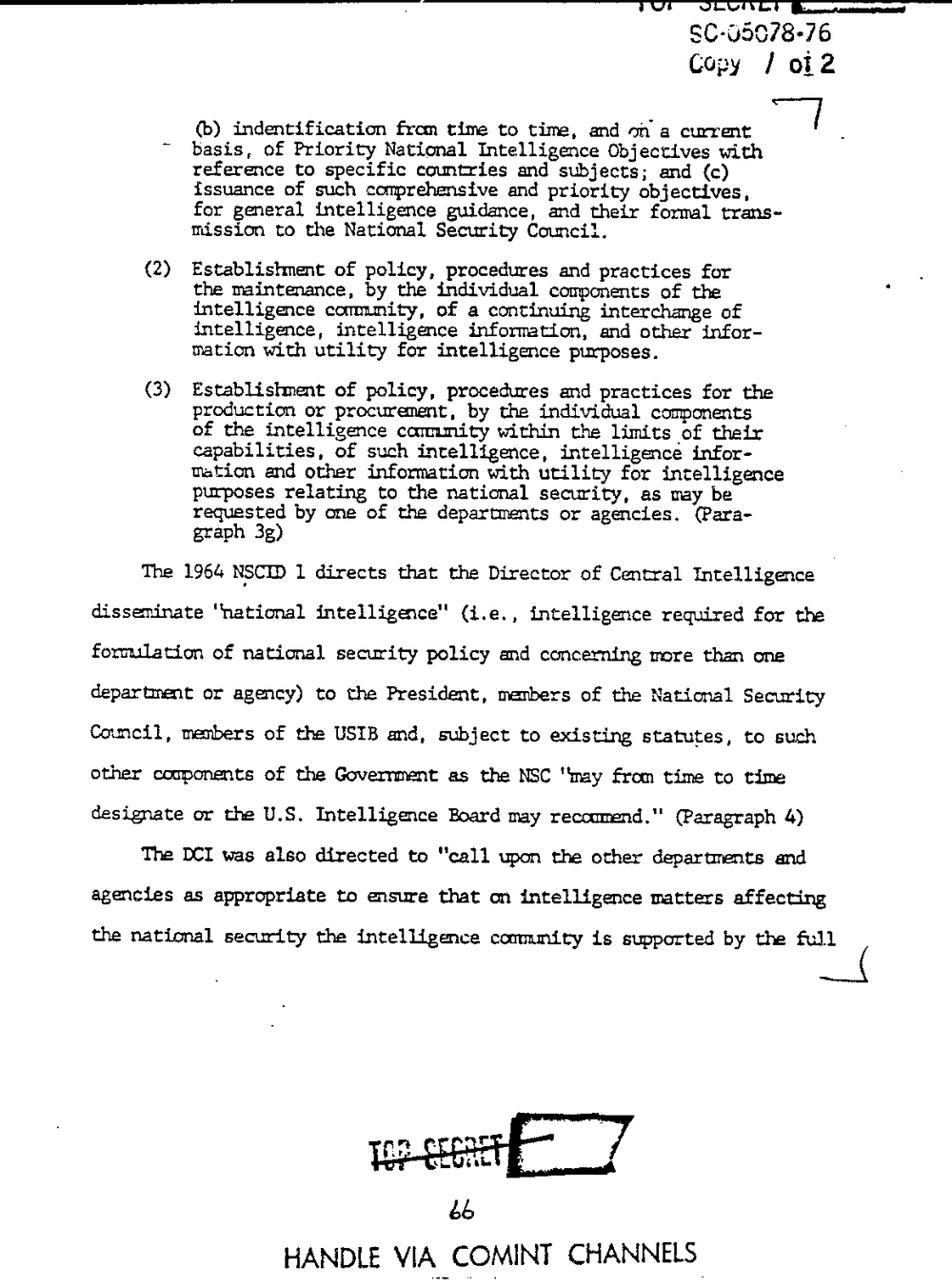
80-05078-76
Copy I 03,2
indentification from time to time, and on a elm-rent -
basis, of Priority National Intelligence Objectives with
reference to specific countries and subjects; and
issuance of such comprehensive and priority objectives,
for geieral intelligence guidance, and their formal trans-
mission to the National Security Council.
(2) Establishment of policy, procedures and practices for
the maintenance, by the individual components of the
intelligeice community, of a continuing interchange of
intelligence, intelligence information, and other infor-
mation with utility for intelligence purposes.
(3) Establishment of policy, procedures and practices for the
production or procurement, by the individual components
of the intelligence cerumity within the limits .of their
capabilities, of such intelligeice, intelligence infor?
mation and other mformation with utility for intelligence
purposes relating to the national security, as may be
requested by one of the departments or agencies. (Para-
graph 33)
The 1964 directs that the Director of Central Intelligence
disseminate "national intelligeice" intelligence required for the
formulation of national security policy and concerning more than one
deparmmt or agency) to the hesidmt, mariners of the National Security
Council, embers of the USIB and, subject to existing statutes, to such
other components of the Govermmt as the NSC "may from time to time
designate or the U.S. Intelligence Board may recmmend." (Paragraph 4)
The DCI was also directed to "call upon the other departmeits and
agencies as appropriate to eisure that on intelligence matters affecting
the national security the intelligence community is supported by the full
66
HANDLE VIA COMINT CHANNELS
80-05078-76
Copy I 03,2
indentification from time to time, and on a elm-rent -
basis, of Priority National Intelligence Objectives with
reference to specific countries and subjects; and
issuance of such comprehensive and priority objectives,
for geieral intelligence guidance, and their formal trans-
mission to the National Security Council.
(2) Establishment of policy, procedures and practices for
the maintenance, by the individual components of the
intelligeice community, of a continuing interchange of
intelligence, intelligence information, and other infor-
mation with utility for intelligence purposes.
(3) Establishment of policy, procedures and practices for the
production or procurement, by the individual components
of the intelligence cerumity within the limits .of their
capabilities, of such intelligeice, intelligence infor?
mation and other mformation with utility for intelligence
purposes relating to the national security, as may be
requested by one of the departments or agencies. (Para-
graph 33)
The 1964 directs that the Director of Central Intelligence
disseminate "national intelligeice" intelligence required for the
formulation of national security policy and concerning more than one
deparmmt or agency) to the hesidmt, mariners of the National Security
Council, embers of the USIB and, subject to existing statutes, to such
other components of the Govermmt as the NSC "may from time to time
designate or the U.S. Intelligence Board may recmmend." (Paragraph 4)
The DCI was also directed to "call upon the other departmeits and
agencies as appropriate to eisure that on intelligence matters affecting
the national security the intelligence community is supported by the full
66
HANDLE VIA COMINT CHANNELS
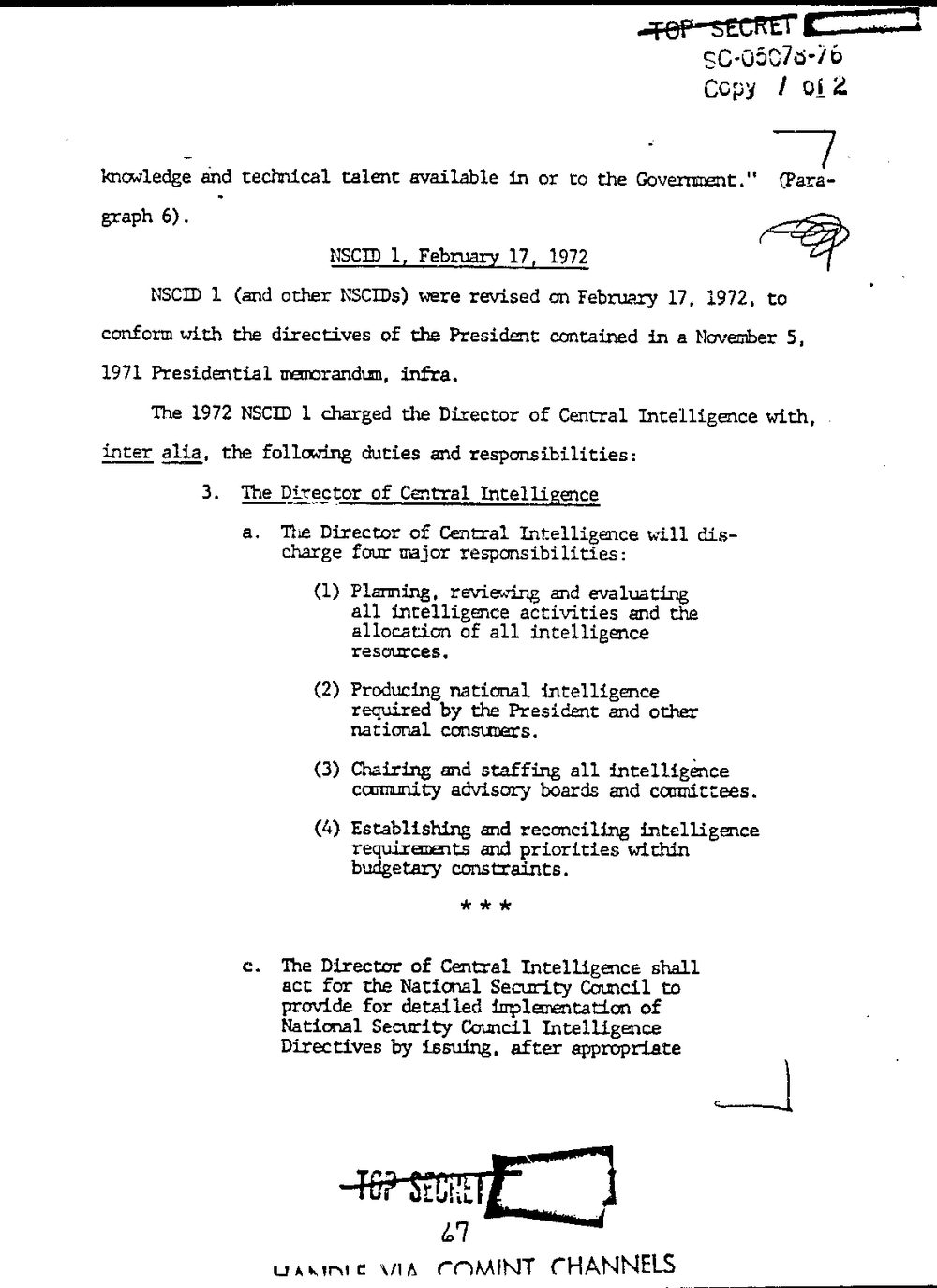
knowledge and technical talent available in or to the Govenmut." {Para-
graph 6).
NSCID 1, February 17, 1972
NSCID (and other NSCIDs) were revised on February 17, 1972, to
conform with the directives of the President contained in a November 5.
1971 Presidential amnrandim, infra.
The 1972 NSCID 1 charged the Director of Central Intelligence with, .
113$, the following duties and responsibilities:
3. 'I_h_e_D_i_re?tor of Central Intelligence
a. The Director of Central Intelligence will dis-
charge four major reSponsibilities:
(1) Flaming. reviewing and evaluating
all intelligence activities and the
allocation of all intelligence
resources.
(2) Producing national intelligence
required by the President and other
national consumers.
(3) Chatting and staffing all intelligence
coonnmity advisory boards and committees.
(4) Establishing and reconciling intelligence
requirements and priorities within
budgetary constraints.
c. The Director of Central Intelligence shall
act for the National Security Council to
provide for detailed implementation of
National Security Council Intelligence
Directives by issuing, after appropriate
in}
LIAMN VIA FOMINT CHANNELSA
knowledge and technical talent available in or to the Govenmut." {Para-
graph 6).
NSCID 1, February 17, 1972
NSCID (and other NSCIDs) were revised on February 17, 1972, to
conform with the directives of the President contained in a November 5.
1971 Presidential amnrandim, infra.
The 1972 NSCID 1 charged the Director of Central Intelligence with, .
113$, the following duties and responsibilities:
3. 'I_h_e_D_i_re?tor of Central Intelligence
a. The Director of Central Intelligence will dis-
charge four major reSponsibilities:
(1) Flaming. reviewing and evaluating
all intelligence activities and the
allocation of all intelligence
resources.
(2) Producing national intelligence
required by the President and other
national consumers.
(3) Chatting and staffing all intelligence
coonnmity advisory boards and committees.
(4) Establishing and reconciling intelligence
requirements and priorities within
budgetary constraints.
c. The Director of Central Intelligence shall
act for the National Security Council to
provide for detailed implementation of
National Security Council Intelligence
Directives by issuing, after appropriate
in}
LIAMN VIA FOMINT CHANNELSA
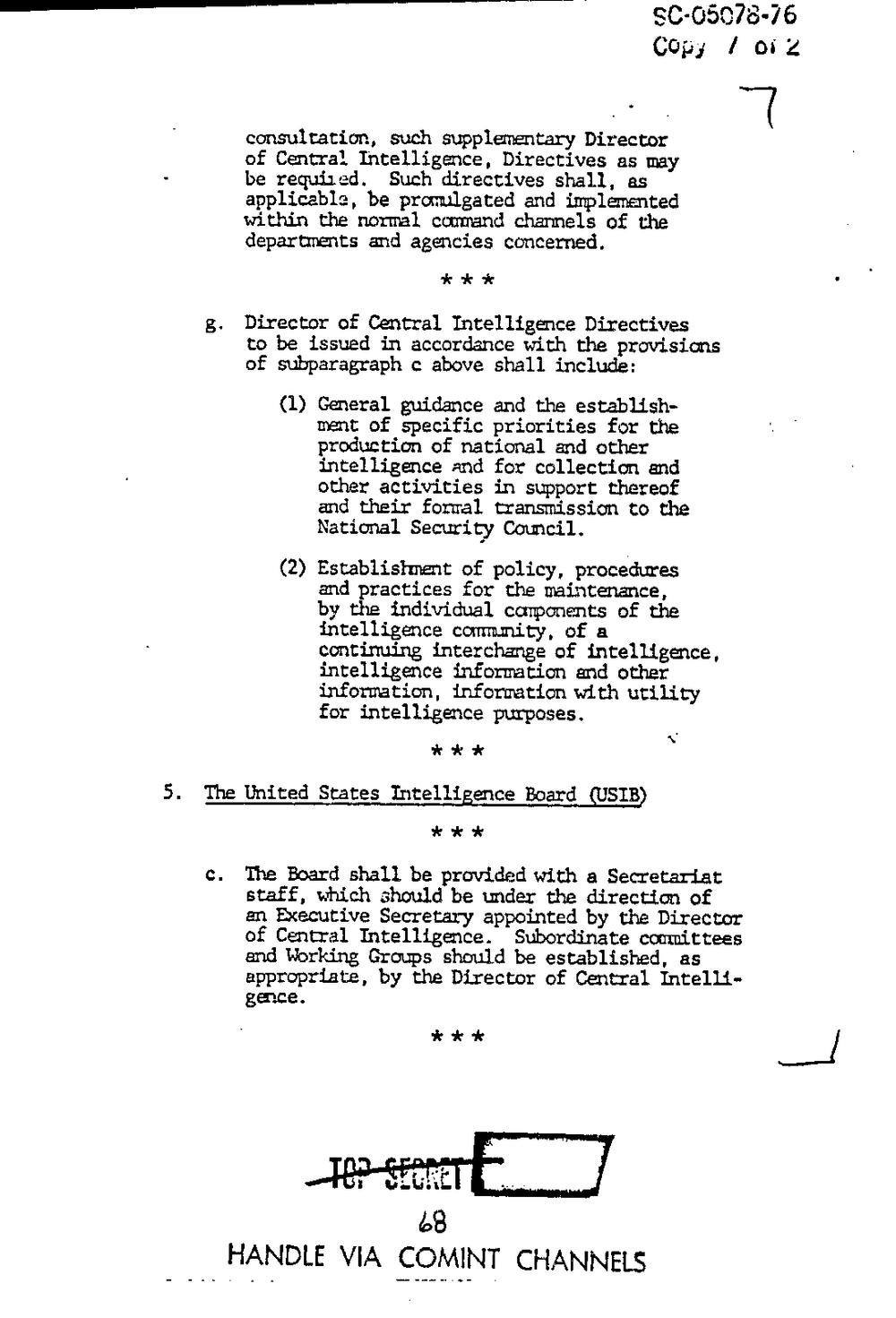
5.
consultation, such supplementary Director
of Central Intelligence, Directives as may
be require . Such directives shall, as
applicable, be pramlgated and implanted
within the normal coomand channels of the
departments and agencies concerned.
Director of Central Intelligence Directives
to be issued in accordance with the provisions
of subparagraph above shall include:
(1) General guidance and the establish-
mt of specific priorities for the
production of national and other
intelligence and for collection and
other activities in support thereof
and their forsal transmission to the
National Security Counsil.
(2) Establishment of policy, procedures
and practices for the maintenance,
by the individual carponemts of the
intelligence if a In
contnming' interchange inte ence,
intelligence information and otheig'
information, information with utility
for intelligence purposes.
The United States mtelligence Board Q1513)
C.
The Board shall be provided with a Secretariat
staff. which should be under the direction of
an Executive Secretaiy appointed by the Director
of Central Intelligence. Subordinate committees
and Working Groups should be established. as
appropriate, by the Director of Central Intelli-
gel-ace.
HANDLE VIA COMINT CHANNELS
VJ
5.
consultation, such supplementary Director
of Central Intelligence, Directives as may
be require . Such directives shall, as
applicable, be pramlgated and implanted
within the normal coomand channels of the
departments and agencies concerned.
Director of Central Intelligence Directives
to be issued in accordance with the provisions
of subparagraph above shall include:
(1) General guidance and the establish-
mt of specific priorities for the
production of national and other
intelligence and for collection and
other activities in support thereof
and their forsal transmission to the
National Security Counsil.
(2) Establishment of policy, procedures
and practices for the maintenance,
by the individual carponemts of the
intelligence if a In
contnming' interchange inte ence,
intelligence information and otheig'
information, information with utility
for intelligence purposes.
The United States mtelligence Board Q1513)
C.
The Board shall be provided with a Secretariat
staff. which should be under the direction of
an Executive Secretaiy appointed by the Director
of Central Intelligence. Subordinate committees
and Working Groups should be established. as
appropriate, by the Director of Central Intelli-
gel-ace.
HANDLE VIA COMINT CHANNELS
VJ
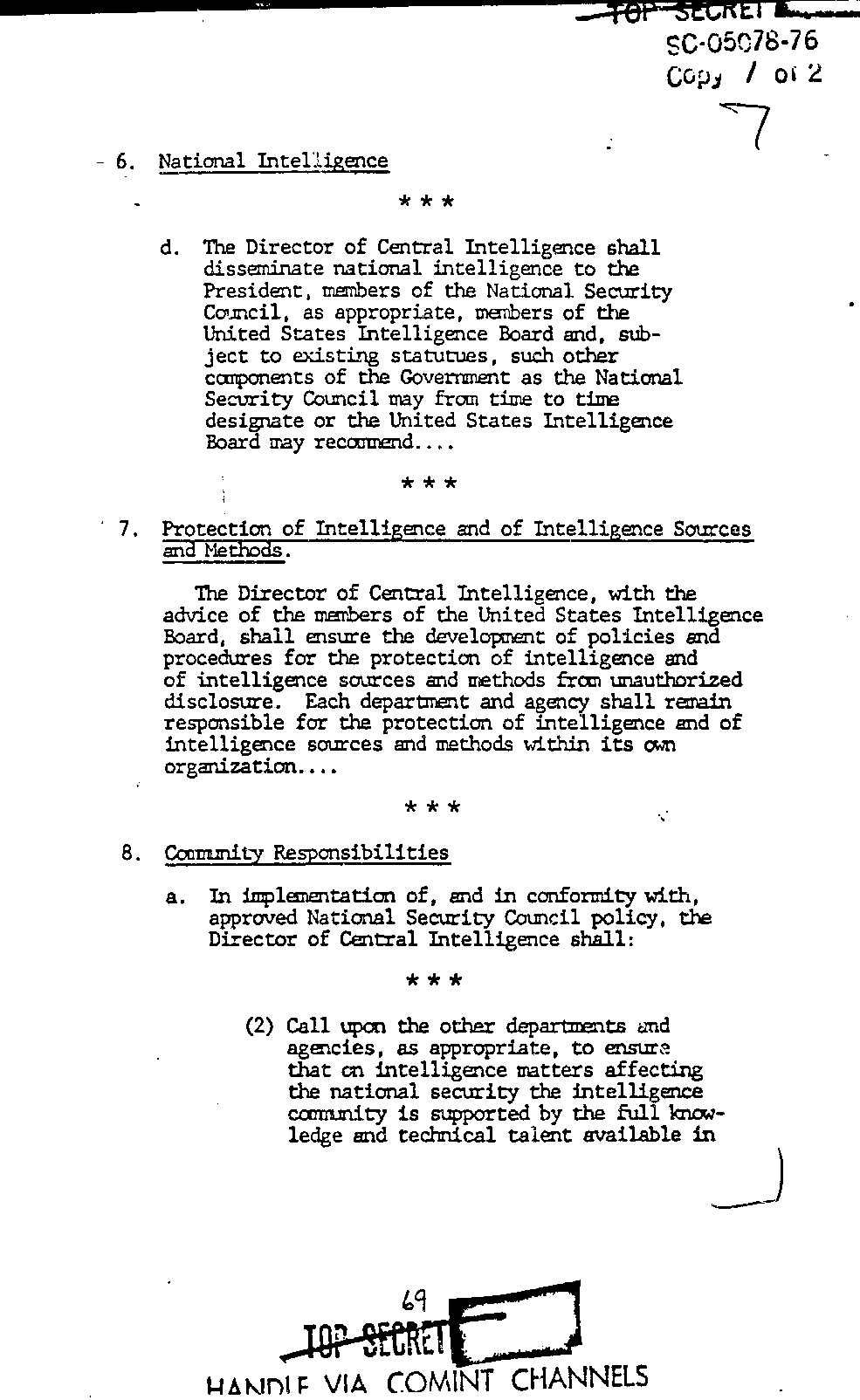
seesaw-76
cap, ox 2
National Intelligence
..
d. The Director of Central Intelligmce shall
disseminate national intelligence to the
President, members of the National Security
Council. as appropriate, members of the
United States Litelligence Board and. sub-
ject to existing statutues, such other
ccmponents of the Goveth as the National
Security Council may time to time
designate or the United States Intelligence
Board may recosuend. . . .
7. Protection of Intelligence and of Intelligence Sources
and Methods.
The Director of Central Intelligence, with the
advice of the numbers of the United States Intelligence
Board, shall ensue the development of policies and
procedures for the protection of intelligence and
of intelligence sources and methods from mauthorized
disclosure. Each department and agency shall remain
responsible for the protection of intelligence and of
intelligence sources and methods within its own
organizationCommunity Responsibilities
3. In implementation of, and in conformity with,
approved National Security Council policy, the
Director of Central Intelligence shall:
(2) Cell upon the other departments and
agencies, as apprOpriate, to ensure
that on intelligence matters affecting
the national security the intelligence
is supported by the full know-
ledge and technical talent available in
HANDIF VIA COMINT CHANNELS
seesaw-76
cap, ox 2
National Intelligence
..
d. The Director of Central Intelligmce shall
disseminate national intelligence to the
President, members of the National Security
Council. as appropriate, members of the
United States Litelligence Board and. sub-
ject to existing statutues, such other
ccmponents of the Goveth as the National
Security Council may time to time
designate or the United States Intelligence
Board may recosuend. . . .
7. Protection of Intelligence and of Intelligence Sources
and Methods.
The Director of Central Intelligence, with the
advice of the numbers of the United States Intelligence
Board, shall ensue the development of policies and
procedures for the protection of intelligence and
of intelligence sources and methods from mauthorized
disclosure. Each department and agency shall remain
responsible for the protection of intelligence and of
intelligence sources and methods within its own
organizationCommunity Responsibilities
3. In implementation of, and in conformity with,
approved National Security Council policy, the
Director of Central Intelligence shall:
(2) Cell upon the other departments and
agencies, as apprOpriate, to ensure
that on intelligence matters affecting
the national security the intelligence
is supported by the full know-
ledge and technical talent available in
HANDIF VIA COMINT CHANNELS
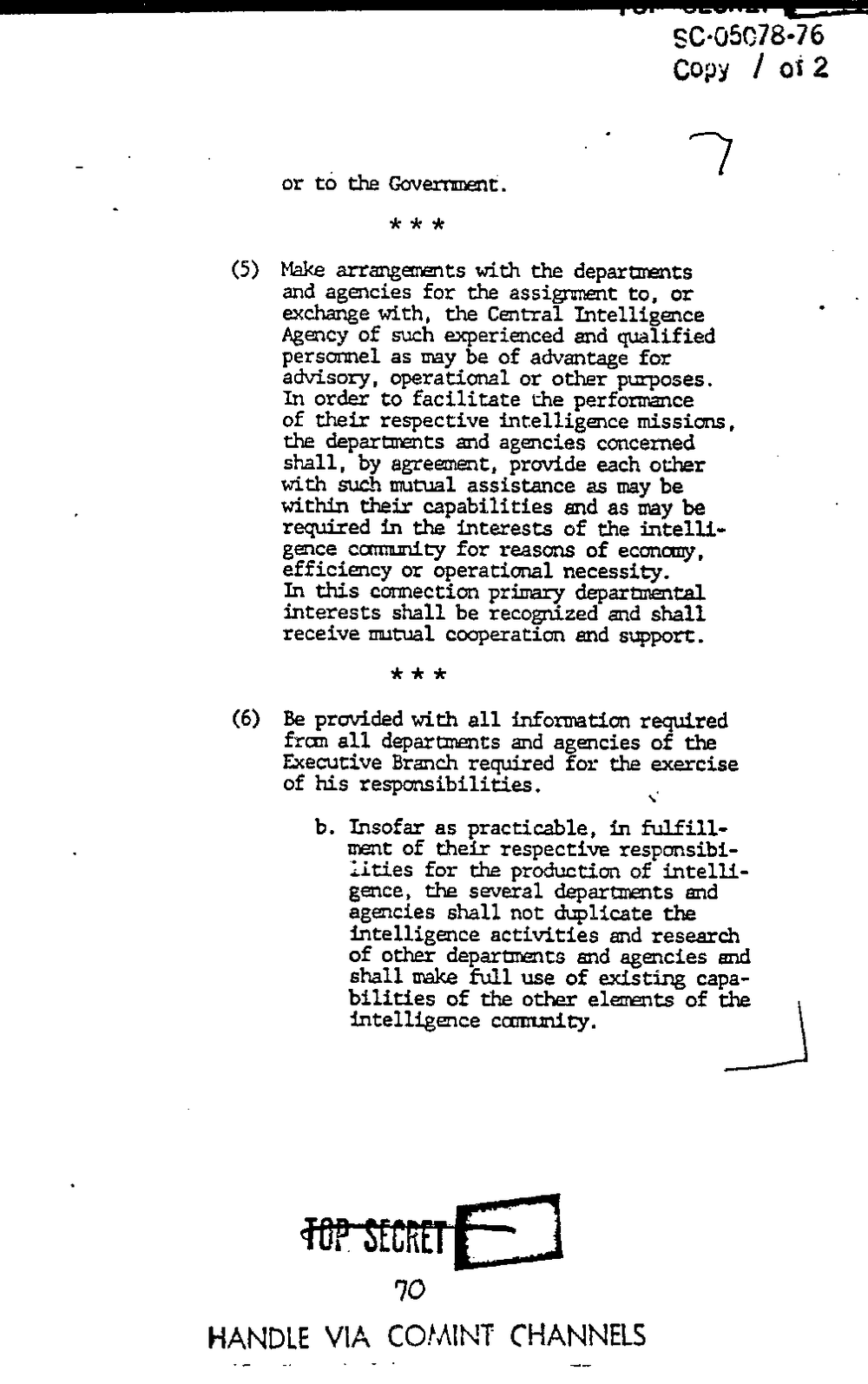
sac-0507846
Copy of 2
7
or to the Govermnent.
(5) Make arrangements with the departments
and agencies for the assignment to, or
exchange with. the Central Intelligence
Agency of such experienced and qualified
personnel as may be of advantage for
advisory. operational or other purposes.
In order to facilitate the performance
of their respective intelligence missions,
the departments and agencies concerned
shall, by agreement, provide each other
with such mutual assistance as may be
within their capabilities and as may be
reqwired in the interests of the intelli-
gence for reasons of economy,
efficiency or operational necessity.
In this connection primary departme?xtal
interests shall be recognized and shall
receive mutual cooperation and support.
*1'r1't
(6) Be provided with all information required
from all departure-ate and agencies of the
Executive Branch required for the exercise
of his responsibilities.
b. Insofar as practicable, in fulfill-
ment of their respective responsibi-
lities for the production of intelli-
gence. the several and
agencies shall not duplicate the
intelligence activities and research
of other departments and agencies and
shall make full use of existing capa-
bilities of the other elements of the
intelligence cmuunity. A
-. - a
'70
HANDLE VIA CHANNELS
sac-0507846
Copy of 2
7
or to the Govermnent.
(5) Make arrangements with the departments
and agencies for the assignment to, or
exchange with. the Central Intelligence
Agency of such experienced and qualified
personnel as may be of advantage for
advisory. operational or other purposes.
In order to facilitate the performance
of their respective intelligence missions,
the departments and agencies concerned
shall, by agreement, provide each other
with such mutual assistance as may be
within their capabilities and as may be
reqwired in the interests of the intelli-
gence for reasons of economy,
efficiency or operational necessity.
In this connection primary departme?xtal
interests shall be recognized and shall
receive mutual cooperation and support.
*1'r1't
(6) Be provided with all information required
from all departure-ate and agencies of the
Executive Branch required for the exercise
of his responsibilities.
b. Insofar as practicable, in fulfill-
ment of their respective responsibi-
lities for the production of intelli-
gence. the several and
agencies shall not duplicate the
intelligence activities and research
of other departments and agencies and
shall make full use of existing capa-
bilities of the other elements of the
intelligence cmuunity. A
-. - a
'70
HANDLE VIA CHANNELS
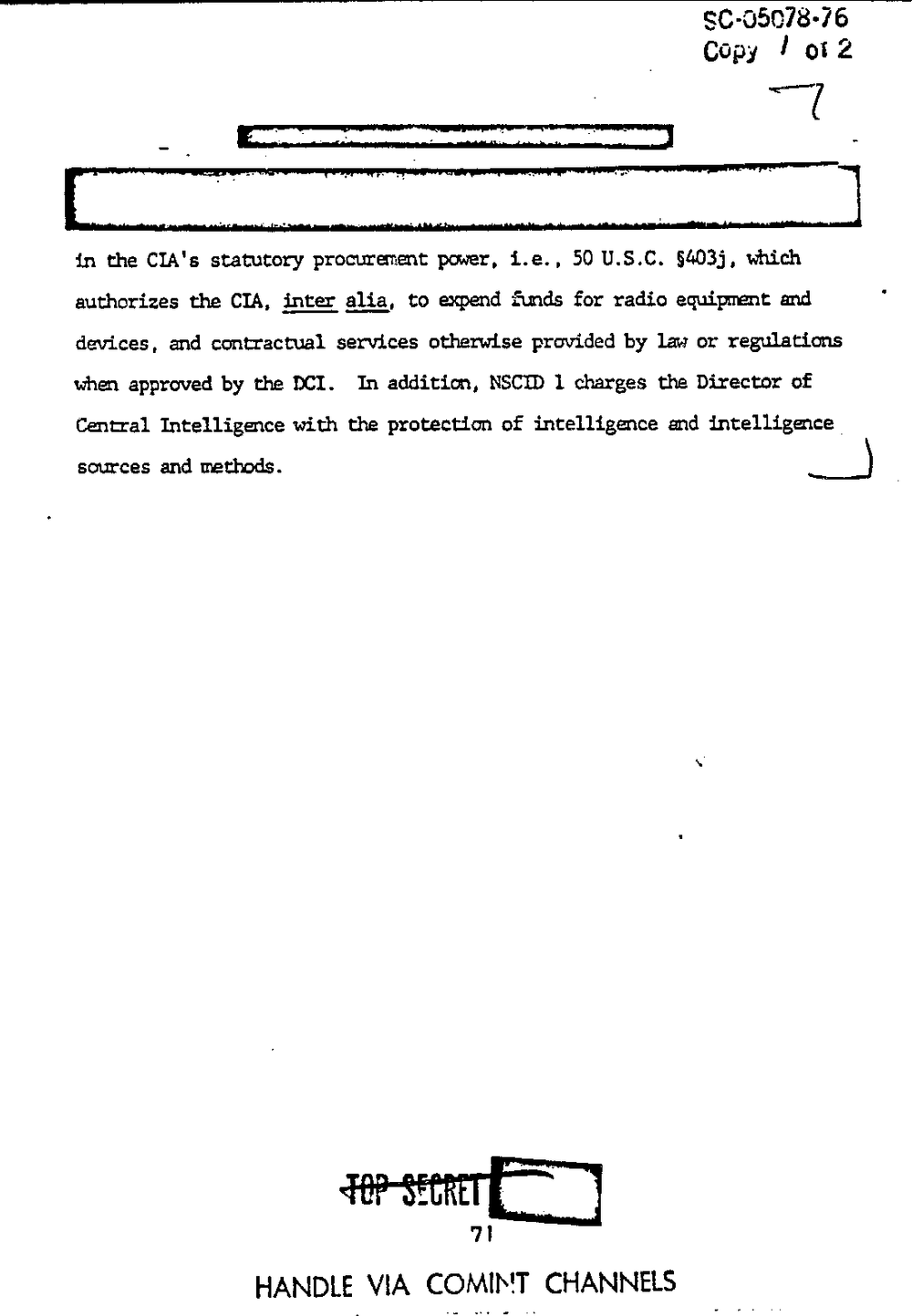
80-05078-76
Cepy I 0:2
in the CIA's statutory promenmt power, Le. . 50 U.S.C. ?403j. which
authorizes the CIA, inter alia. to expend funds for radio equipment and
devices. and contractual services otherwise provided by law or regulations
when approved by the DCI. In addition. NSCID 1 charges the Director of
Central Intelligence with the protection of intelligence and intelligence.
sources and methods.
HANDLE VIA COMINT CHANNELS
80-05078-76
Cepy I 0:2
in the CIA's statutory promenmt power, Le. . 50 U.S.C. ?403j. which
authorizes the CIA, inter alia. to expend funds for radio equipment and
devices. and contractual services otherwise provided by law or regulations
when approved by the DCI. In addition. NSCID 1 charges the Director of
Central Intelligence with the protection of intelligence and intelligence.
sources and methods.
HANDLE VIA COMINT CHANNELS
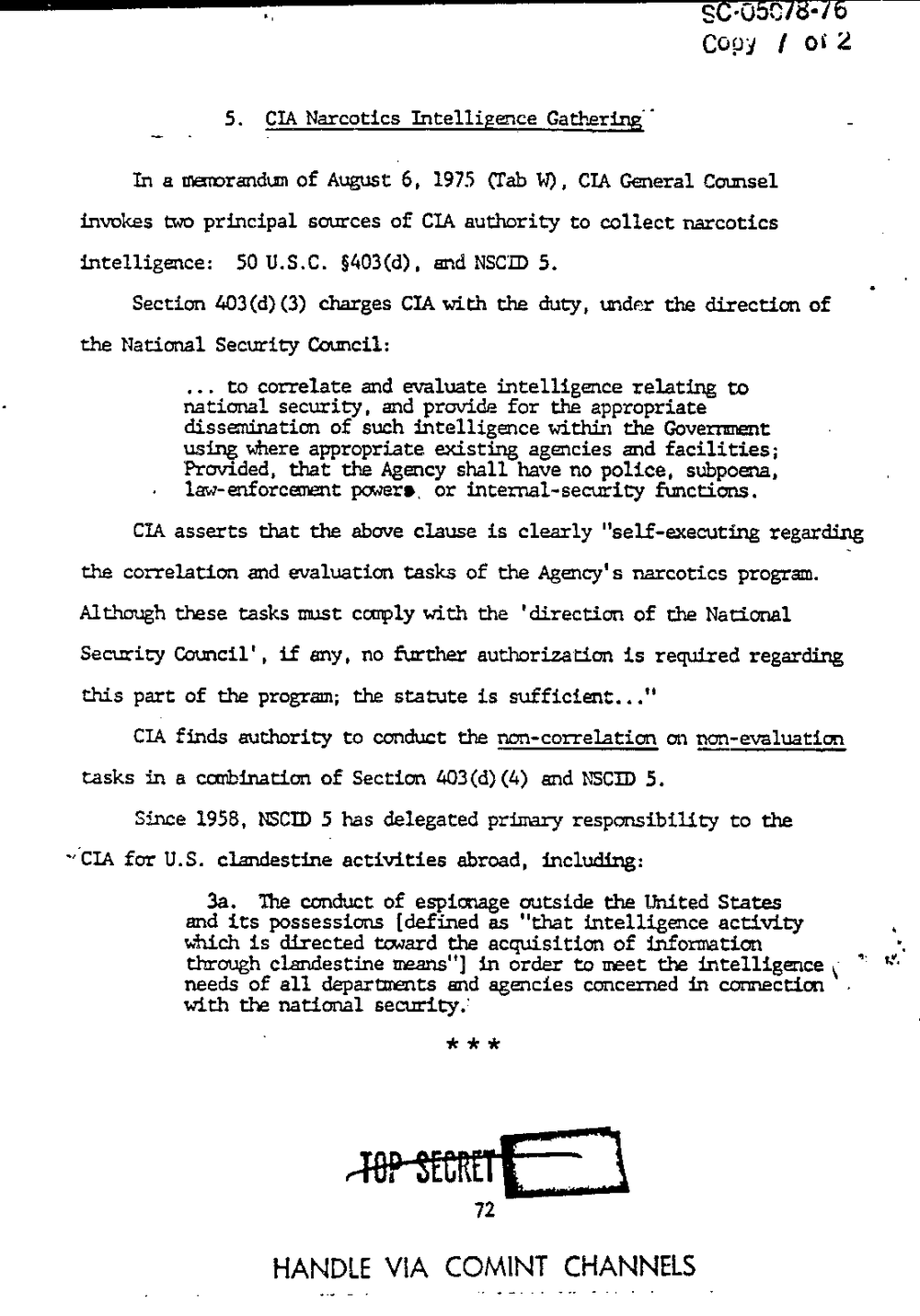
., Q.OC.
\u
Copy I of 2
5. CIA Narcotics Intelligence Gathering"
In a themrandun of August 6, 1975 (Tab W) CIA General Counsel
invokes two principal sources of CIA authority to collect narcotics
intelligence: 50 U.S.C. 5403(d). and NSCID 5.
Section 403 (3) charges CIA with the duty, mder the direction of
the National Security Council:
. to correlate and evaluate intelligence relating to
national security. and provide for the appropriate
dissemination of such intelligence within the Government
using where appropriate existing agencies and facilities;
Provided, that the Agency shall have no police, subpoena,
law-enforcement powers, or internal-security functions.
CIA asserts that the above clause is clearly "self-executing regarding
the correlation and evaluation tasks of the Agency's narcotics program.
Although these tasks must comply with the ?direction of the National
Security Council' if any. no further authorization is required regarding
this part of the program; the staunte is sufficient. .
CIA finds authority to conduct the non-correlation on non-evaluation
tasks in a combination of Section 403(d) (4) and NSCID 5.
Since 1958, NSCID 5 has delegated primary responsibility to the
for U.S. clandestine activities abroad. including:
3a. The conduct of espicnage outside the United States
and its possessions [defined as "that intelligence activity
which is directed toward the acquisition of information
through clandestine neans?] in order to meet the intelligence
needs of all departments and agencies concerned in connection
with the national security.?
HANDLE COMINT CHANNELS
., Q.OC.
\u
Copy I of 2
5. CIA Narcotics Intelligence Gathering"
In a themrandun of August 6, 1975 (Tab W) CIA General Counsel
invokes two principal sources of CIA authority to collect narcotics
intelligence: 50 U.S.C. 5403(d). and NSCID 5.
Section 403 (3) charges CIA with the duty, mder the direction of
the National Security Council:
. to correlate and evaluate intelligence relating to
national security. and provide for the appropriate
dissemination of such intelligence within the Government
using where appropriate existing agencies and facilities;
Provided, that the Agency shall have no police, subpoena,
law-enforcement powers, or internal-security functions.
CIA asserts that the above clause is clearly "self-executing regarding
the correlation and evaluation tasks of the Agency's narcotics program.
Although these tasks must comply with the ?direction of the National
Security Council' if any. no further authorization is required regarding
this part of the program; the staunte is sufficient. .
CIA finds authority to conduct the non-correlation on non-evaluation
tasks in a combination of Section 403(d) (4) and NSCID 5.
Since 1958, NSCID 5 has delegated primary responsibility to the
for U.S. clandestine activities abroad. including:
3a. The conduct of espicnage outside the United States
and its possessions [defined as "that intelligence activity
which is directed toward the acquisition of information
through clandestine neans?] in order to meet the intelligence
needs of all departments and agencies concerned in connection
with the national security.?
HANDLE COMINT CHANNELS
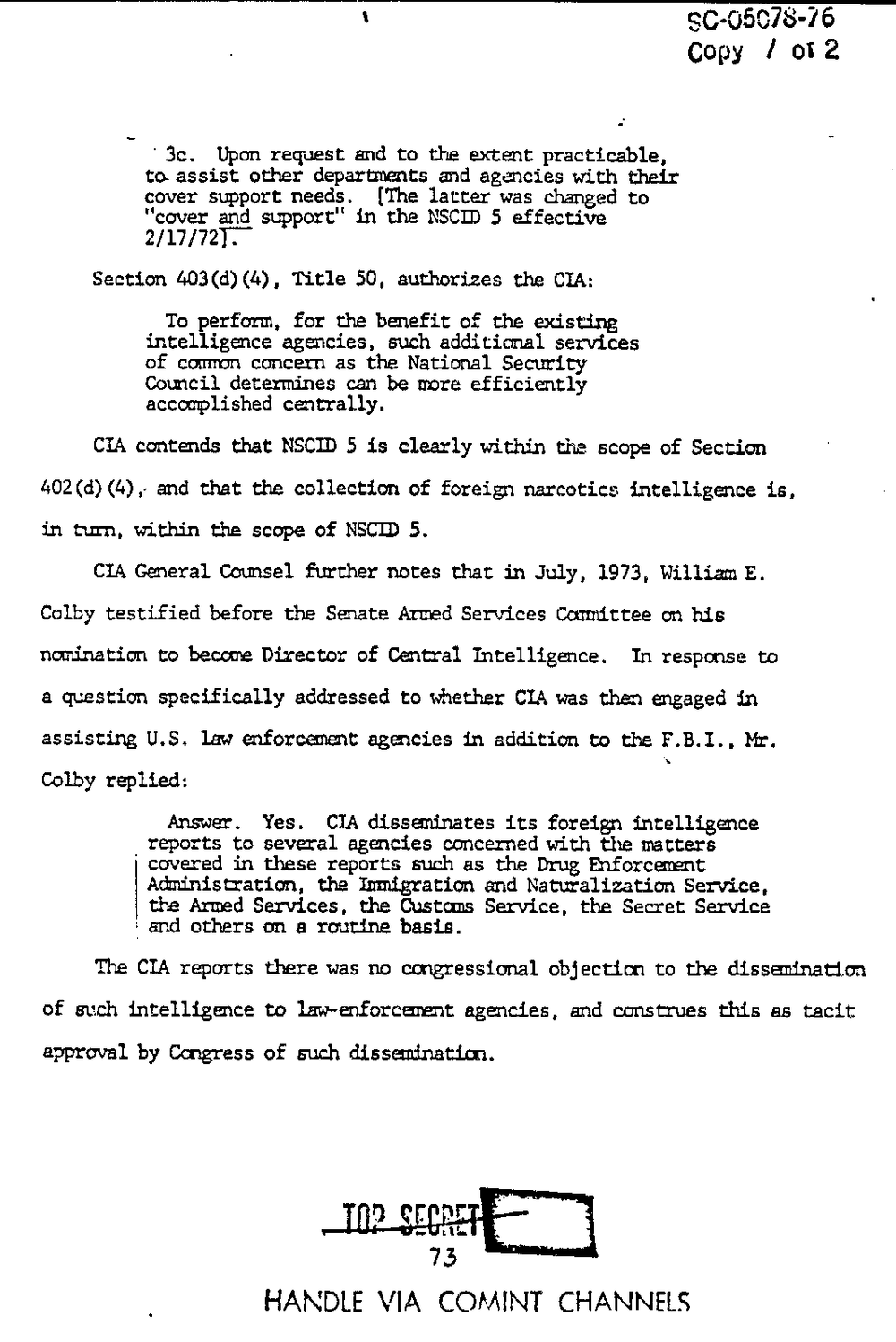
80058-7846
Copy 012
3c. Upon request and to the extent practicable,
to. assist other departments and agencies with their
cover support needs. [The latter was changed to
"cover and support" in the NSCID 5 effective
2/17/7211?
Section 403(d) (4), Title 50, authorizes the CIA:
To perform. for the benefit of the existing
intelligence agencies, such additional services
of common concern as the National Security
Council determines can be more efficiently
emu-ally.
CIA contends that NSCID 5 is clearly within scope of Section
402 and that the collection of foreign narcotics intelligence is,
in turn, within the scope of NSCID 5.
CIA General Counsel further notes that in July, 1973, William E.
Colby testified before the Senate Armed Services Committee on his
noo?nation to become Director of Central Intelligence. In response to
a question specifically addressed to whether CIA was then engaged in
assisting U.S. law enforth agencies in addition to the F.B.I.. Mr.
Colby replied:
Answer. Yes. CIA disseminates its foreign intelligence
reports to several agencies concerned with the matters
covered in these reports such as the Drug Enforcement
Administration, the Immigration and Naturalization Service,
the Armed Services, the Customs Service, the Secret Service
and others on a routine basis.
The CIA reports there was no cmgressional objection to the dissemination
of such intelligence to lmmforcarmt agencies, and construes this as tacit
approval by of such dissaninatim.
HANDLE VIA COMINT CHANNELS
80058-7846
Copy 012
3c. Upon request and to the extent practicable,
to. assist other departments and agencies with their
cover support needs. [The latter was changed to
"cover and support" in the NSCID 5 effective
2/17/7211?
Section 403(d) (4), Title 50, authorizes the CIA:
To perform. for the benefit of the existing
intelligence agencies, such additional services
of common concern as the National Security
Council determines can be more efficiently
emu-ally.
CIA contends that NSCID 5 is clearly within scope of Section
402 and that the collection of foreign narcotics intelligence is,
in turn, within the scope of NSCID 5.
CIA General Counsel further notes that in July, 1973, William E.
Colby testified before the Senate Armed Services Committee on his
noo?nation to become Director of Central Intelligence. In response to
a question specifically addressed to whether CIA was then engaged in
assisting U.S. law enforth agencies in addition to the F.B.I.. Mr.
Colby replied:
Answer. Yes. CIA disseminates its foreign intelligence
reports to several agencies concerned with the matters
covered in these reports such as the Drug Enforcement
Administration, the Immigration and Naturalization Service,
the Armed Services, the Customs Service, the Secret Service
and others on a routine basis.
The CIA reports there was no cmgressional objection to the dissemination
of such intelligence to lmmforcarmt agencies, and construes this as tacit
approval by of such dissaninatim.
HANDLE VIA COMINT CHANNELS
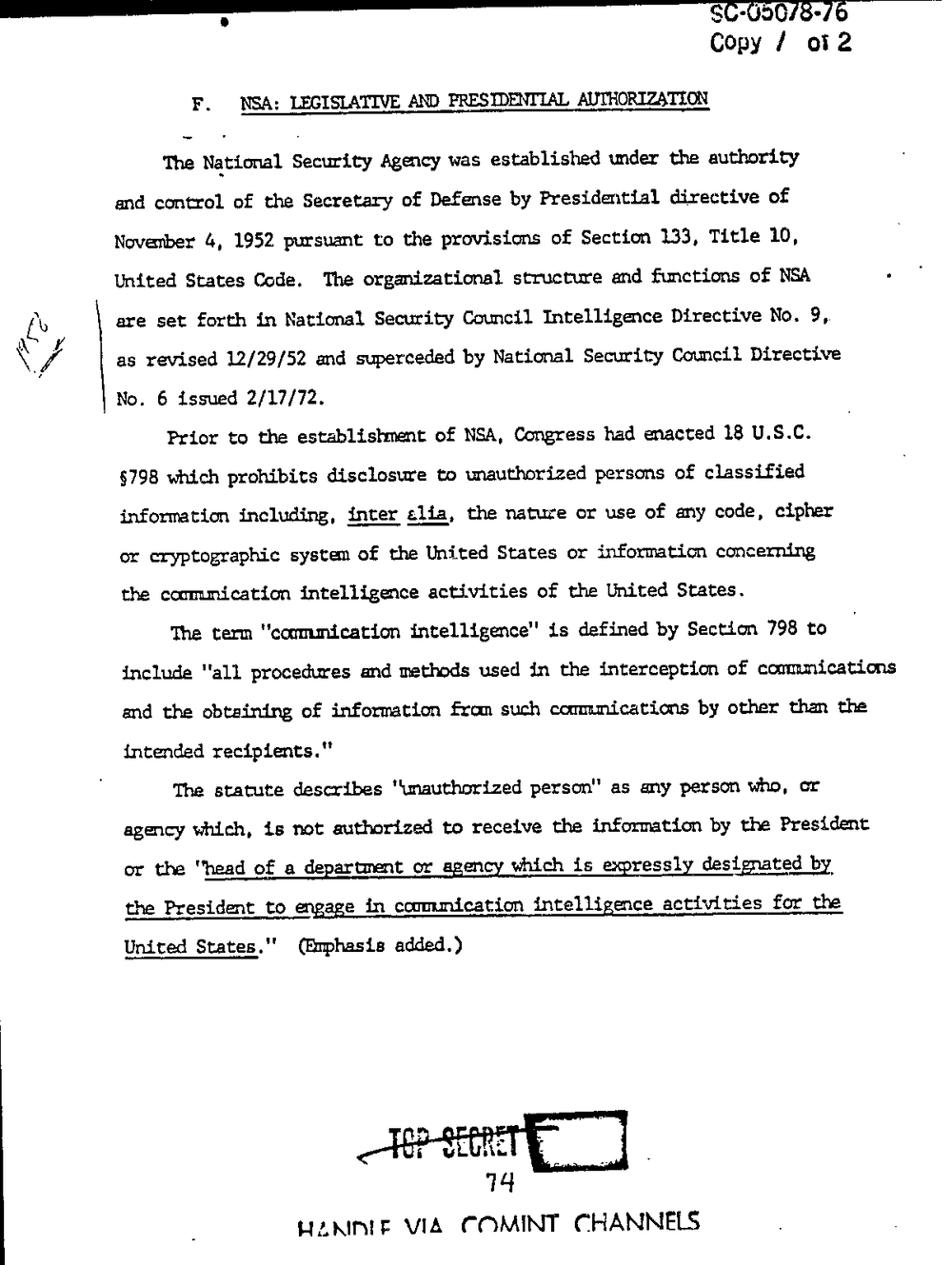
COpy I or 2
F. NBA: IEISIATIVE AND PRESEWIIAL AUTHORIMTION
The National Security Agency was established under the authority
and control of the Secretary of Defense by Presidential directive of
Novanber A, 1952 pursuant to the provisions of Section 133, Title 10,
United States Code. The organizational structure and functions of NSA
0, are set forth in National Security Council Intelligence Directive No.
as revised 12/29/52 and superseded by National Security Council Directive
No. 6 issued 2/17/72.
Prior to the establith of NSA. Congress had enacted 18 U.S.C.
5798 which prohibits disclosure to mauthorized persons of classified
information including. inter; 51g, the nature or use of any code. cipher
or system of the United States or information concerning
the communication intelligence activities of the United States.
lhe term intelligence" is defined by Section 798 to
include "all procedures and cathode used in the interception of communications
and the obtaining of information from such connimications by other than the
intended recipients."
The statute describes "mauthorized person" as any person who. or
agency which, is not authorized to receive the information by the President
or the "head of a department or agency which is expressly designated by
the President to algage in coummication intelligence activities for the
United States." (Emphasis added.)
Heron?: VIA CHANNELS
COpy I or 2
F. NBA: IEISIATIVE AND PRESEWIIAL AUTHORIMTION
The National Security Agency was established under the authority
and control of the Secretary of Defense by Presidential directive of
Novanber A, 1952 pursuant to the provisions of Section 133, Title 10,
United States Code. The organizational structure and functions of NSA
0, are set forth in National Security Council Intelligence Directive No.
as revised 12/29/52 and superseded by National Security Council Directive
No. 6 issued 2/17/72.
Prior to the establith of NSA. Congress had enacted 18 U.S.C.
5798 which prohibits disclosure to mauthorized persons of classified
information including. inter; 51g, the nature or use of any code. cipher
or system of the United States or information concerning
the communication intelligence activities of the United States.
lhe term intelligence" is defined by Section 798 to
include "all procedures and cathode used in the interception of communications
and the obtaining of information from such connimications by other than the
intended recipients."
The statute describes "mauthorized person" as any person who. or
agency which, is not authorized to receive the information by the President
or the "head of a department or agency which is expressly designated by
the President to algage in coummication intelligence activities for the
United States." (Emphasis added.)
Heron?: VIA CHANNELS
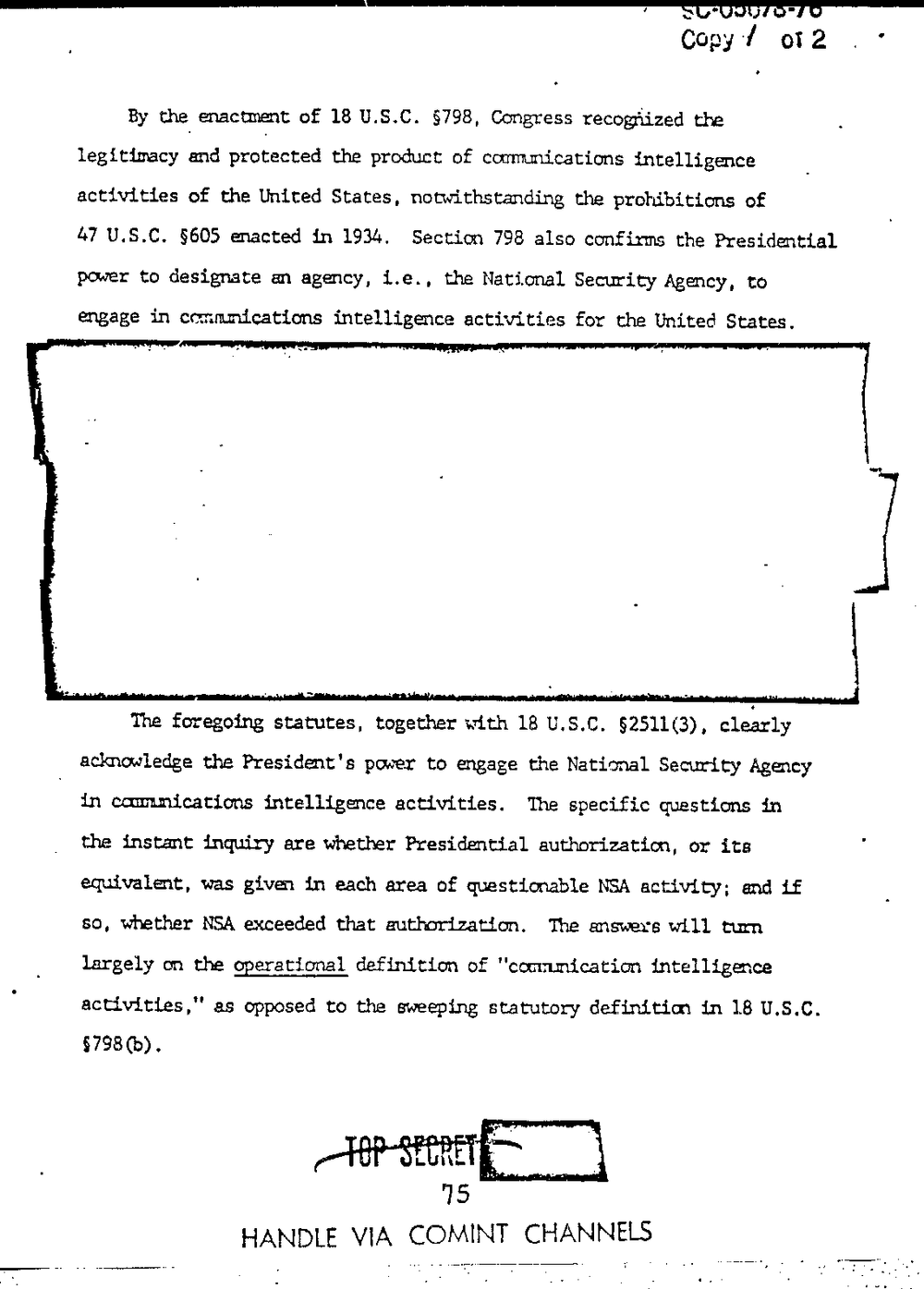
COpy'l 012
By the enactment of 18 U.S.C. ?798, Congress recognized the
legitimacy and protected the product of intelligence
activities of the United States, nomithstanding the prohibitions of
47 U.S.C. 5605 enacted in 1934. Section 798 also confirms the Presidential
power to designate an agency, the National Security Agency, to
engage in commutations intelligence activities for the United States.
The foregoing statutes. together with 18 use 525110). clearly
acknowledge the President's power to engage the National Security Agency
in mmications intelligence activities. The specific questions in
the instant inquiry are whether Presidential authorization, or its
equivalent. was given in each area of questionable NSA activity; and if
so. whether NSA exceeded that eutl'nrization. 'Ihe answers will turn
largely on the operational definition of intelligence
activities," as opposed to the sweeping statutory definitim in 18 U.S.C.
579803).
'75
HANDLE VIA COMINT CHANNE
-
.
COpy'l 012
By the enactment of 18 U.S.C. ?798, Congress recognized the
legitimacy and protected the product of intelligence
activities of the United States, nomithstanding the prohibitions of
47 U.S.C. 5605 enacted in 1934. Section 798 also confirms the Presidential
power to designate an agency, the National Security Agency, to
engage in commutations intelligence activities for the United States.
The foregoing statutes. together with 18 use 525110). clearly
acknowledge the President's power to engage the National Security Agency
in mmications intelligence activities. The specific questions in
the instant inquiry are whether Presidential authorization, or its
equivalent. was given in each area of questionable NSA activity; and if
so. whether NSA exceeded that eutl'nrization. 'Ihe answers will turn
largely on the operational definition of intelligence
activities," as opposed to the sweeping statutory definitim in 18 U.S.C.
579803).
'75
HANDLE VIA COMINT CHANNE
-
.
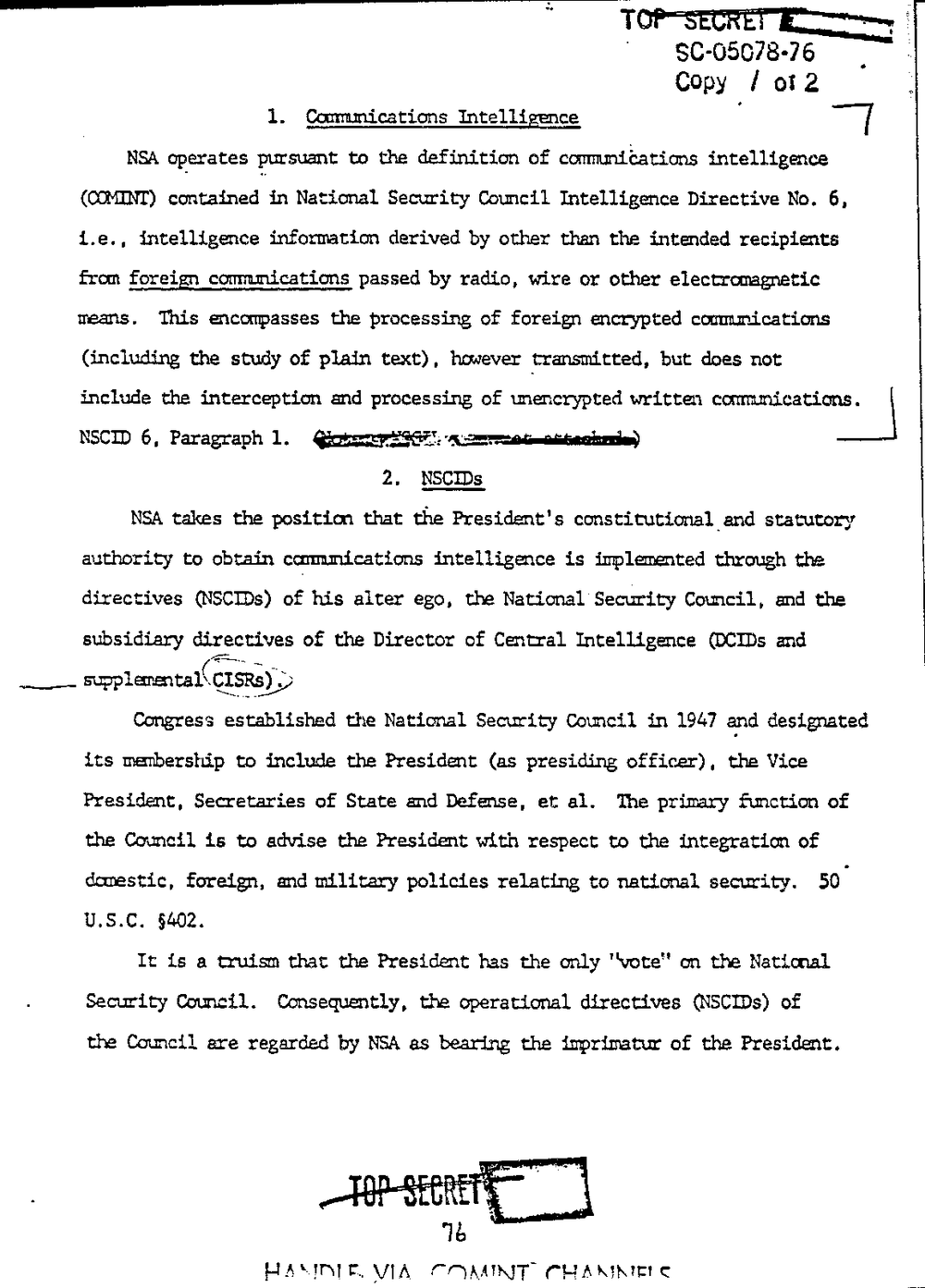
80-05078-76 . i
Copy 1 012
l. lntelligmce '7
NSA operates pLu?suant to the definition of cmnmications intelligence
(CEMENT) contained in National Security Council Intelligence Directive No. 6,
Le. intelligence information derived by other than the intended recipients
from foreig: cornmmications passed by radio, wire or other electromagnetic
means. This encompasses the processing of foreign omnications
(including the study of plain text) however trmmitted, but does not
include the interception and processing of written
NSCID 6, Paragraph 1.
2- 13.59.12;
NBA takes the position that the President's constitutionaland statutory
authority to obtain communications intelligence is implemented through the
directives of his alter ego, the National'Security Council, and the
subsidiary directives of the Director of Central Intelligence CDCIDs and
supplemental
Congress established the National Security Council in 1947 and designated
its mmubership to include the President (as presiding officer) . the Vice
President, Secretaries of State and Defense, et al. The primary fimction of
the Council is to advise the Presidmt with respect to the integration of
domestic, foreign, and military policies relating to national security. 50'
U.S.C. 54-02.
It is a u'uism that the President has the only "vote" on the National
Security Comeil. Consequently. the operational directives (NSCIDS) of
the Council are regarded by NSA as bearing the imprimatur of the President.
HA mm VIA FHA t:
80-05078-76 . i
Copy 1 012
l. lntelligmce '7
NSA operates pLu?suant to the definition of cmnmications intelligence
(CEMENT) contained in National Security Council Intelligence Directive No. 6,
Le. intelligence information derived by other than the intended recipients
from foreig: cornmmications passed by radio, wire or other electromagnetic
means. This encompasses the processing of foreign omnications
(including the study of plain text) however trmmitted, but does not
include the interception and processing of written
NSCID 6, Paragraph 1.
2- 13.59.12;
NBA takes the position that the President's constitutionaland statutory
authority to obtain communications intelligence is implemented through the
directives of his alter ego, the National'Security Council, and the
subsidiary directives of the Director of Central Intelligence CDCIDs and
supplemental
Congress established the National Security Council in 1947 and designated
its mmubership to include the President (as presiding officer) . the Vice
President, Secretaries of State and Defense, et al. The primary fimction of
the Council is to advise the Presidmt with respect to the integration of
domestic, foreign, and military policies relating to national security. 50'
U.S.C. 54-02.
It is a u'uism that the President has the only "vote" on the National
Security Comeil. Consequently. the operational directives (NSCIDS) of
the Council are regarded by NSA as bearing the imprimatur of the President.
HA mm VIA FHA t:
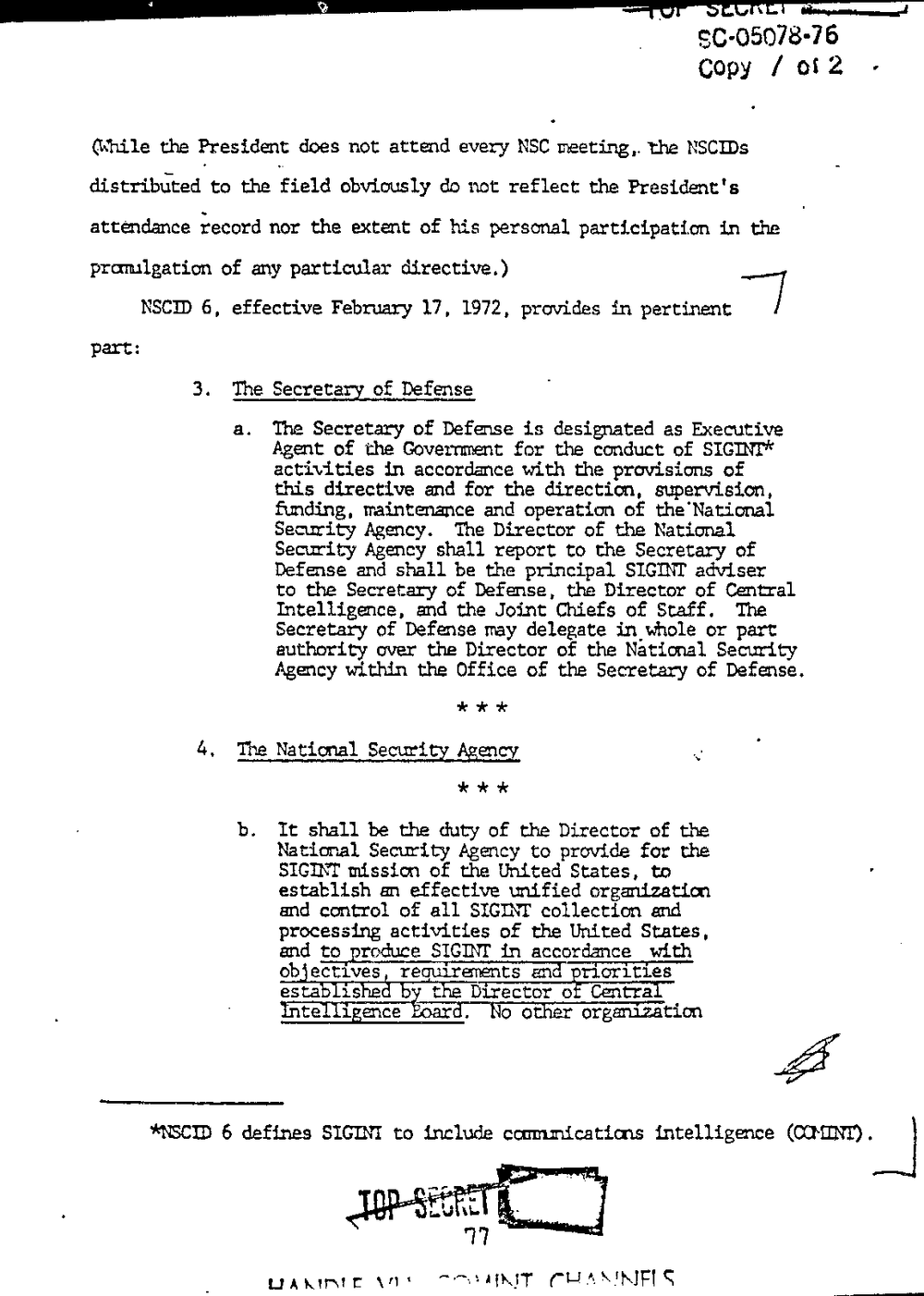
30-05078-76
COpy 0:2
(While the President does not attemd every NSC meetingr the NSCIDS
distributed to the field obviously do not reflect the President's
attendance record
nor the extent of his personal participation in the
promulgation of any particular directive.)
NSCID 6, effective February 17, 1972, provides in pertinent
.7
Secretary of Defense
The Secretary of Defense is designated as Executive
Agait of the Goverrment for the conduct of
activities in accordance with the provisions of
this directive and for the direction. supervision,
funding, maintenance and operation of ?ie'National
Security Agency. The Director of the National
Security Agency shall report to the Secretary of
Defense and shall be the principal adviser
to the Secretary of Defense, the Director of Central
Intelligence, and the Joint Chiefs of Staff. The
Secretary of Defense may delegate in_whole or part
authority over the Director of the National Security
Agency within the Office of the Secretary of Defense.
Naticnal Securig Agency
partshall be the duty of the Director of the
National Security Agency to provide for the
mission of the United States. to
establish an effective unified organization
and control of all collection and
processing activities of the United States.
and to produce in accordance with
objea?ves, requirements and priorities
established by the Director of Central
Intelligence Board. No other organization
6 defines SIGINI to include commnicaticns intelligence (CG-UNI) .
\n
30-05078-76
COpy 0:2
(While the President does not attemd every NSC meetingr the NSCIDS
distributed to the field obviously do not reflect the President's
attendance record
nor the extent of his personal participation in the
promulgation of any particular directive.)
NSCID 6, effective February 17, 1972, provides in pertinent
.7
Secretary of Defense
The Secretary of Defense is designated as Executive
Agait of the Goverrment for the conduct of
activities in accordance with the provisions of
this directive and for the direction. supervision,
funding, maintenance and operation of ?ie'National
Security Agency. The Director of the National
Security Agency shall report to the Secretary of
Defense and shall be the principal adviser
to the Secretary of Defense, the Director of Central
Intelligence, and the Joint Chiefs of Staff. The
Secretary of Defense may delegate in_whole or part
authority over the Director of the National Security
Agency within the Office of the Secretary of Defense.
Naticnal Securig Agency
partshall be the duty of the Director of the
National Security Agency to provide for the
mission of the United States. to
establish an effective unified organization
and control of all collection and
processing activities of the United States.
and to produce in accordance with
objea?ves, requirements and priorities
established by the Director of Central
Intelligence Board. No other organization
6 defines SIGINI to include commnicaticns intelligence (CG-UNI) .
\n
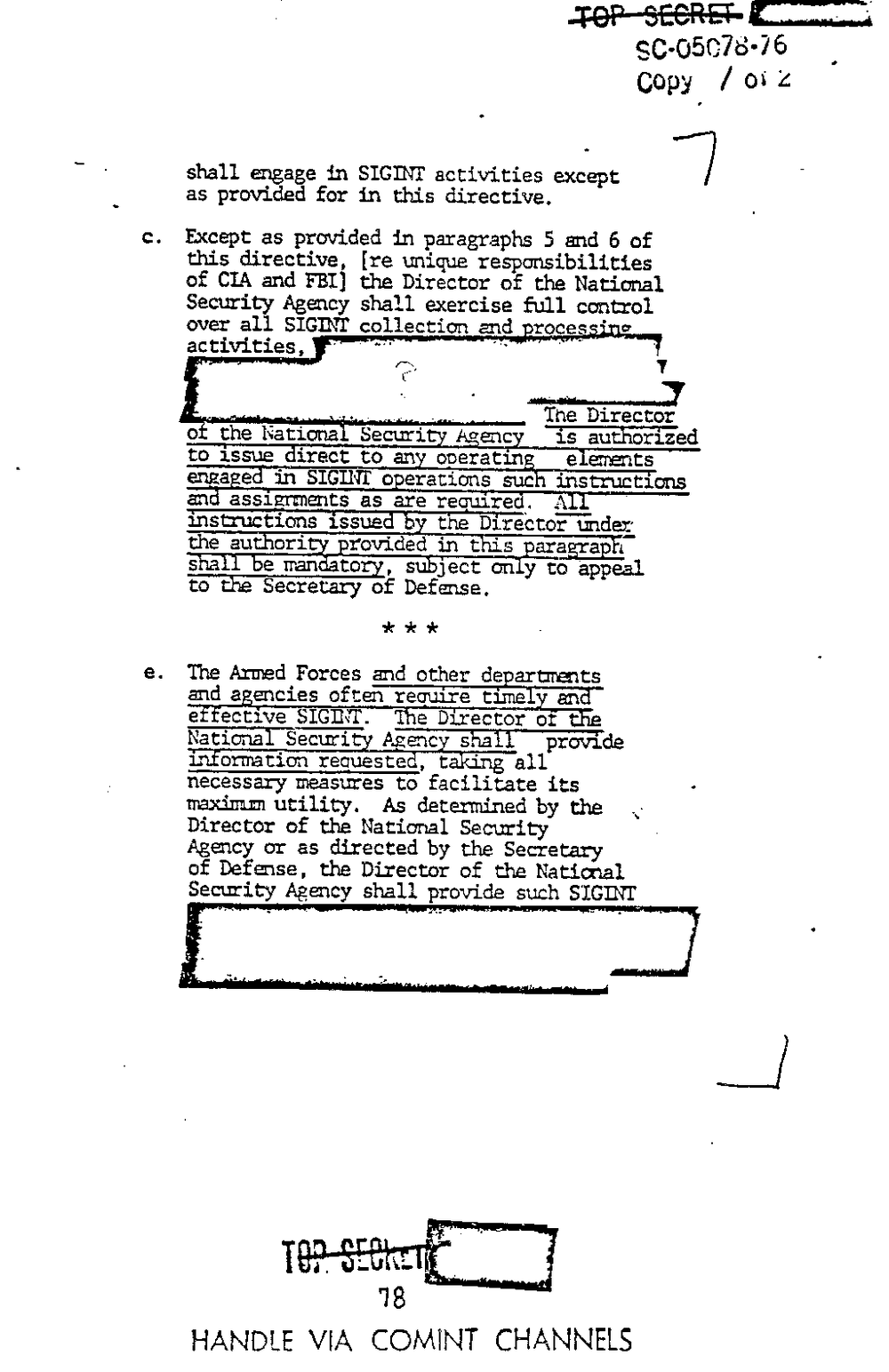
WEE:
50-05078-76
Copy 0? '4
shall engage in SIGINT activities except
as provided for in this directive.
Except as provided in paragraphs 5 and 6 of
this directive, [re unique responsibilities
of CIA and the Director of the National
Security Agency shall exercise full control
over all collection and roces ?7
activities,
. The Director
0 the National Securig Igmcy is authorized
to issue direct to any operating elements
Engaged in SIGINI operations such instructions
an as are reqmre . A
issued by the Director under
the authorityjrovided in this paragraph
smalle tranc'atog, s?aject only to appeal
to the Secretary of Defense.
The Armed Forces and other departments
and agencies often require timely and
effective The Director of the
National Security Agency shall provide
information reouested, taking all
necessary measures to facilitate its
maxim utility. As determined by the
Director of the National Security
Agency or as directed by the Secretary
of Defense, the Director of the National
Security Agency shall provide such
HANDLE VIA COMINT CHANNELS
WEE:
50-05078-76
Copy 0? '4
shall engage in SIGINT activities except
as provided for in this directive.
Except as provided in paragraphs 5 and 6 of
this directive, [re unique responsibilities
of CIA and the Director of the National
Security Agency shall exercise full control
over all collection and roces ?7
activities,
. The Director
0 the National Securig Igmcy is authorized
to issue direct to any operating elements
Engaged in SIGINI operations such instructions
an as are reqmre . A
issued by the Director under
the authorityjrovided in this paragraph
smalle tranc'atog, s?aject only to appeal
to the Secretary of Defense.
The Armed Forces and other departments
and agencies often require timely and
effective The Director of the
National Security Agency shall provide
information reouested, taking all
necessary measures to facilitate its
maxim utility. As determined by the
Director of the National Security
Agency or as directed by the Secretary
of Defense, the Director of the National
Security Agency shall provide such
HANDLE VIA COMINT CHANNELS
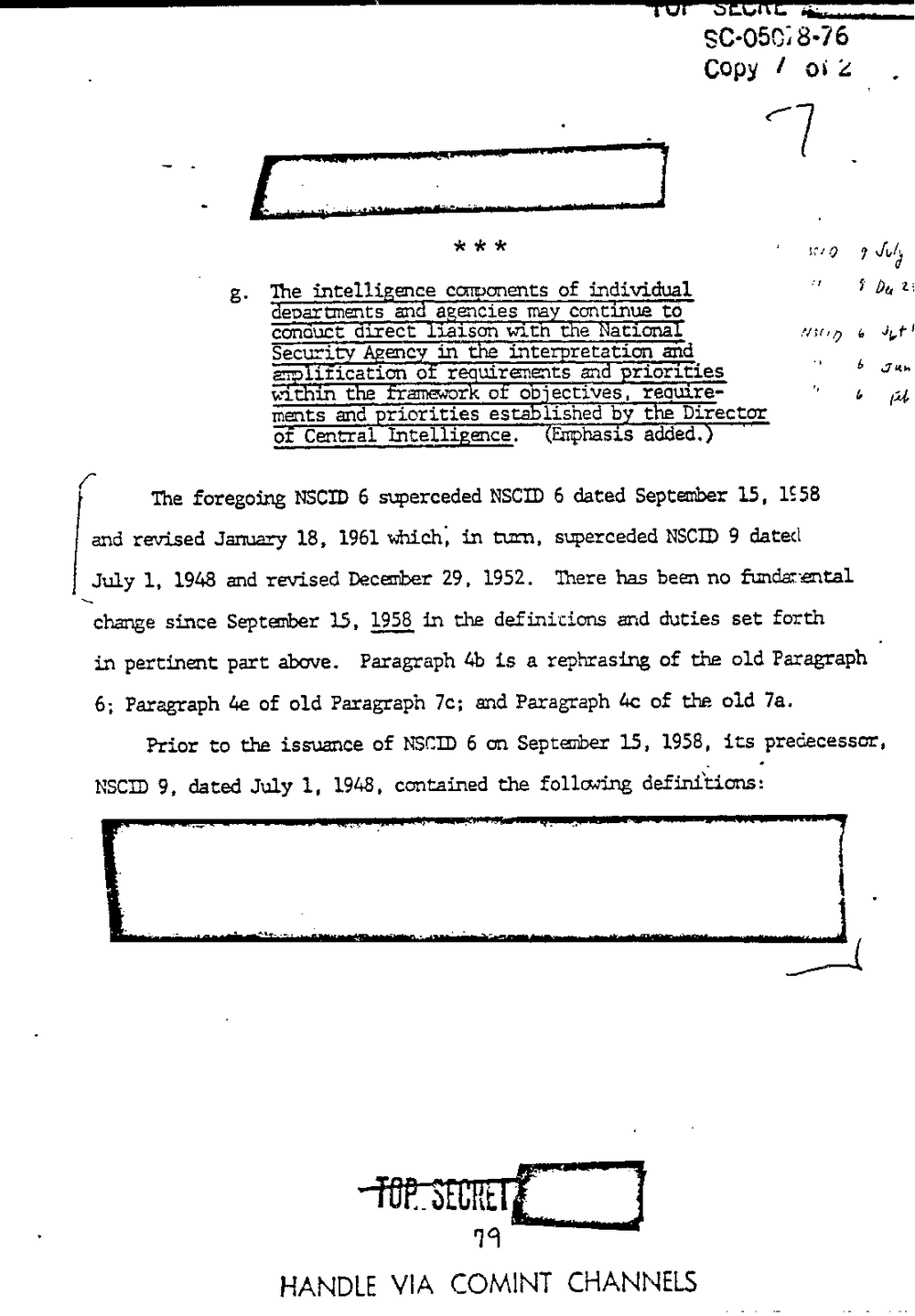
80050] 8-76
COpy as 2
I
g. 'Ilne intelligence components of individual 5' Do 11
departments and agencies ma}: continue to
conduct direct liaison w?zh the National mm) 3
Securitv Agency in the interpretation and
mlification of requirements and priorities 5
?thin the framework of o?on?ectives, require- In
ments and priorities established by the Director
mantra]. Intelligence. (Emphasis added.)
The foregoing NSCID 6 superseded NSCID 6 dated September 15, 1958
and revised January 18, 1961 which; in turn, superceded NSCID 9 dated
July 1, 1948 and revised Dacennber 29, 1952. There has been no fundamental
\change since September 15, in the definitions and duties set forth
in pertinent part above. Paragraph 41) is a rephrasing of the old Paragraph
6; Paragraph he of old Paragraph 7c; and Paragraph 4c of the old 7.3.
Prior to the issuance of NSCID 6 on September 15, 1958, its predecessor.
NSCID 9, dated July 1, 1948. contained the follming
HANDLE WA COMINT CHANNELS
80050] 8-76
COpy as 2
I
g. 'Ilne intelligence components of individual 5' Do 11
departments and agencies ma}: continue to
conduct direct liaison w?zh the National mm) 3
Securitv Agency in the interpretation and
mlification of requirements and priorities 5
?thin the framework of o?on?ectives, require- In
ments and priorities established by the Director
mantra]. Intelligence. (Emphasis added.)
The foregoing NSCID 6 superseded NSCID 6 dated September 15, 1958
and revised January 18, 1961 which; in turn, superceded NSCID 9 dated
July 1, 1948 and revised Dacennber 29, 1952. There has been no fundamental
\change since September 15, in the definitions and duties set forth
in pertinent part above. Paragraph 41) is a rephrasing of the old Paragraph
6; Paragraph he of old Paragraph 7c; and Paragraph 4c of the old 7.3.
Prior to the issuance of NSCID 6 on September 15, 1958, its predecessor.
NSCID 9, dated July 1, 1948. contained the follming
HANDLE WA COMINT CHANNELS
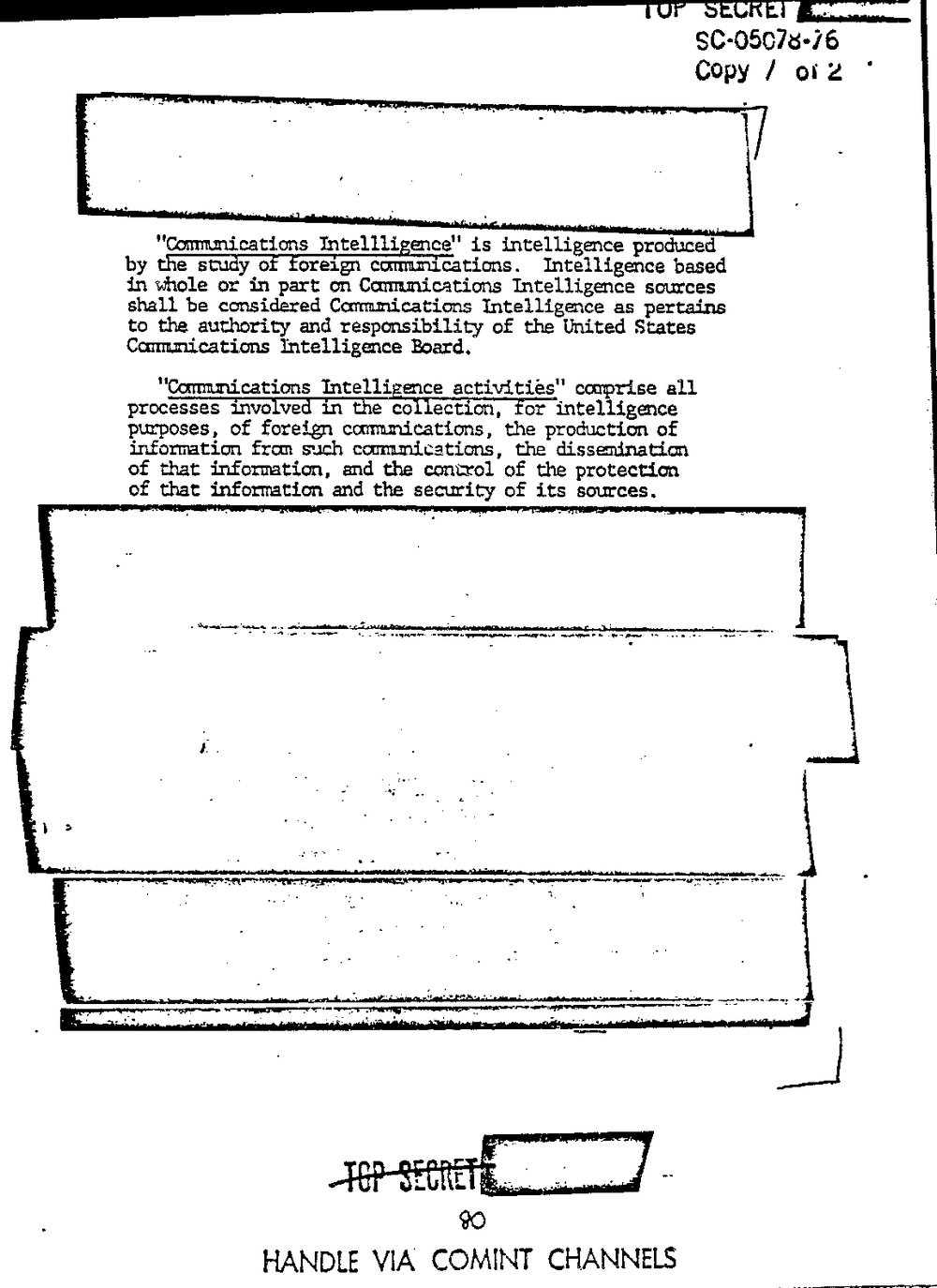
SID-0507546
Capy otz
"Conmmications is intelligence produced
by the study of foreign communications. Intelligence based
in whole or in part on Cmmications Intelligence sources
shall be considered Cormmications Intelligence as pertains
to the authority and responsibility of the United States
Intelligence Board.
Intelligence activities? comprise all
processes involved in the collection. for intelligence
purposes, of foreign the production of
information from such cmmications, the disseminadon
of that information, and the control of the protection
of that information and the security of its sources.
1w? 1-11?
.e
HANDLE VIA COMINT CHANNELS
SID-0507546
Capy otz
"Conmmications is intelligence produced
by the study of foreign communications. Intelligence based
in whole or in part on Cmmications Intelligence sources
shall be considered Cormmications Intelligence as pertains
to the authority and responsibility of the United States
Intelligence Board.
Intelligence activities? comprise all
processes involved in the collection. for intelligence
purposes, of foreign the production of
information from such cmmications, the disseminadon
of that information, and the control of the protection
of that information and the security of its sources.
1w? 1-11?
.e
HANDLE VIA COMINT CHANNELS
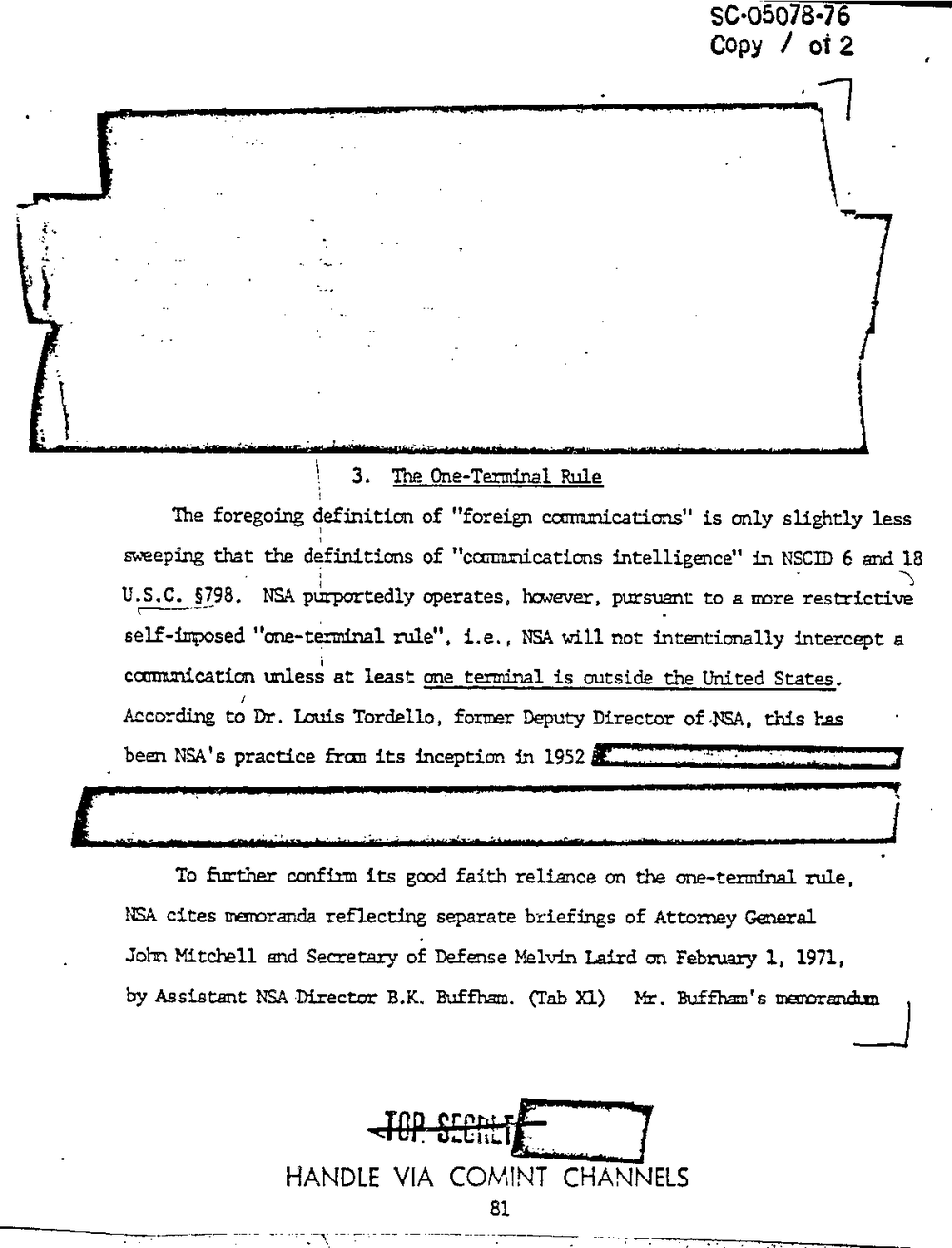
5040507846
COpy of 2
?1
3. The One-Tern?nal Rule
The foregoing definition of "foreign coonmications" is only less
sweeping that the definitions of "coommications intelligence" in NSCID 6 md 18
NSA ptizrportedly operates. however, pmsuant to a more restrictive
self-imposed "one-temdnal rule", i.e. . NSA will not intentionally intercept a
unless at least one terminal is outside the United States.
According to Dr. Louis Tordello, former Deputy Director of NSA, this has
been practice from its inception in 1952
To further confirm its good faith reliance on the one-teminal rule,
NBA cites mmranda reflecting separate briefings of Attorney General
John Mitchell and Secretary of Defense Melvin Laird on February 1. 1971,
by Assistant NSA Director B.K. Buffham. (Tab Xl) Mr. Buffhan?s memorandIn
I
I-
A
HANDLE VIA COMINT CHANNELS
81
5040507846
COpy of 2
?1
3. The One-Tern?nal Rule
The foregoing definition of "foreign coonmications" is only less
sweeping that the definitions of "coommications intelligence" in NSCID 6 md 18
NSA ptizrportedly operates. however, pmsuant to a more restrictive
self-imposed "one-temdnal rule", i.e. . NSA will not intentionally intercept a
unless at least one terminal is outside the United States.
According to Dr. Louis Tordello, former Deputy Director of NSA, this has
been practice from its inception in 1952
To further confirm its good faith reliance on the one-teminal rule,
NBA cites mmranda reflecting separate briefings of Attorney General
John Mitchell and Secretary of Defense Melvin Laird on February 1. 1971,
by Assistant NSA Director B.K. Buffham. (Tab Xl) Mr. Buffhan?s memorandIn
I
I-
A
HANDLE VIA COMINT CHANNELS
81
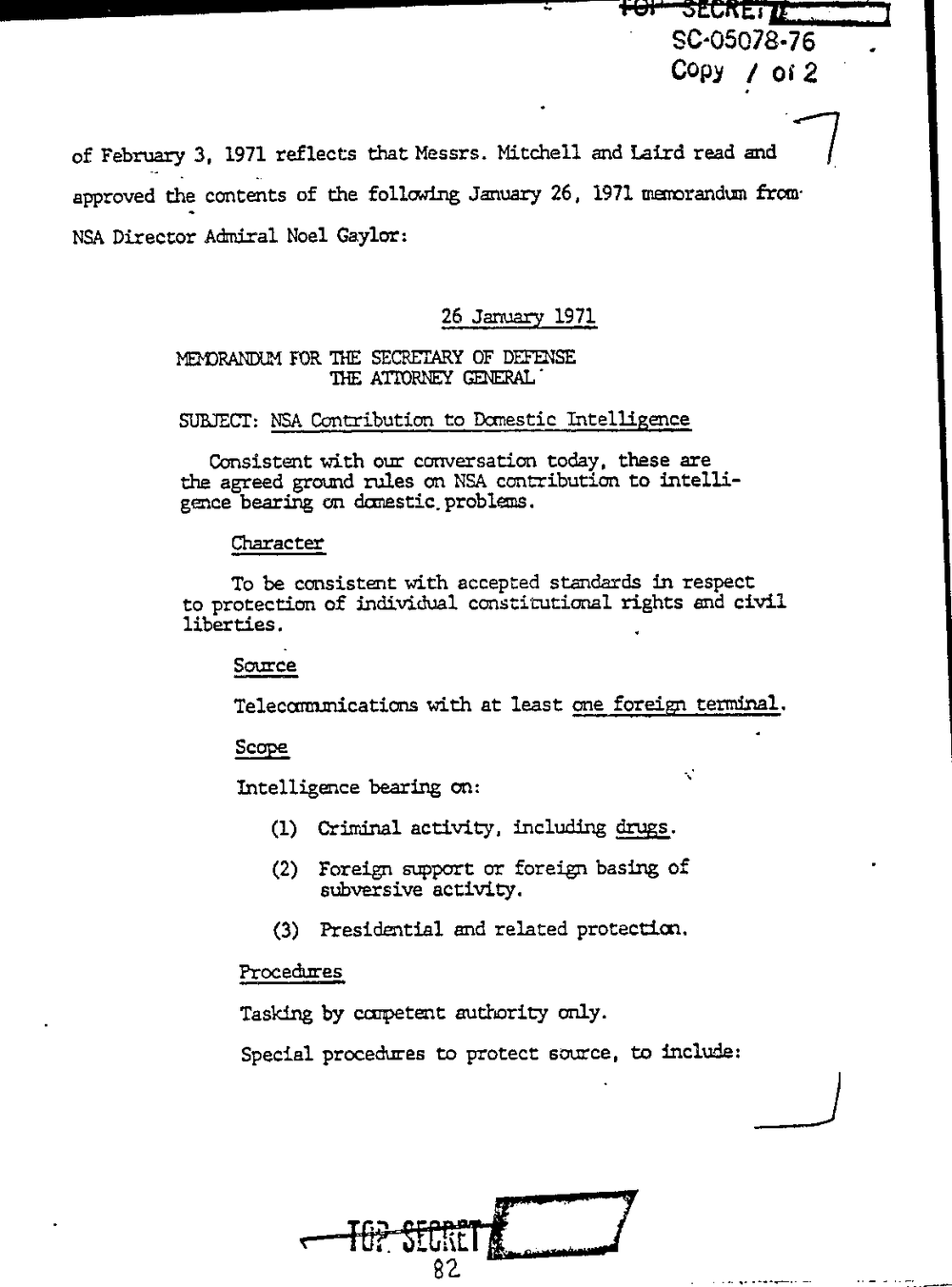
80-05078-76
Copy or 2
of February 3, 1971 reflects that Messrs. Mitchell and Laird read and ?7
approved the contents of the following January 26, 1971 mrandim from-
NSA Director Admiral Noel Gaylor:
26 January 1971
MEMJRANDLM FOR THE SECRETARY OF DEFESE
THE ATTORNEY GENERAL
SUBJECT: NSA Contribution to Domestic Intelligence
Consistent with our conversation today, these are
the agreed ground rules on NSA contribution to intelli-
gence bearing on dcmestic. problems.
Character
To be consistent with accepted standards in respect
to protection of individual constitutional rights and civil
liberties.
see
with at least one foreign tenninal.
Intelligence bearing on:
(1) Criminal activity. including 95:55.
(2) Foreign support or foreig'x basing of
subversive activity.
(3) Presidential and related protect-1m.
Procedures
Tasking by competent authority only.
Special procedures to protect source, to include:
80-05078-76
Copy or 2
of February 3, 1971 reflects that Messrs. Mitchell and Laird read and ?7
approved the contents of the following January 26, 1971 mrandim from-
NSA Director Admiral Noel Gaylor:
26 January 1971
MEMJRANDLM FOR THE SECRETARY OF DEFESE
THE ATTORNEY GENERAL
SUBJECT: NSA Contribution to Domestic Intelligence
Consistent with our conversation today, these are
the agreed ground rules on NSA contribution to intelli-
gence bearing on dcmestic. problems.
Character
To be consistent with accepted standards in respect
to protection of individual constitutional rights and civil
liberties.
see
with at least one foreign tenninal.
Intelligence bearing on:
(1) Criminal activity. including 95:55.
(2) Foreign support or foreig'x basing of
subversive activity.
(3) Presidential and related protect-1m.
Procedures
Tasking by competent authority only.
Special procedures to protect source, to include:
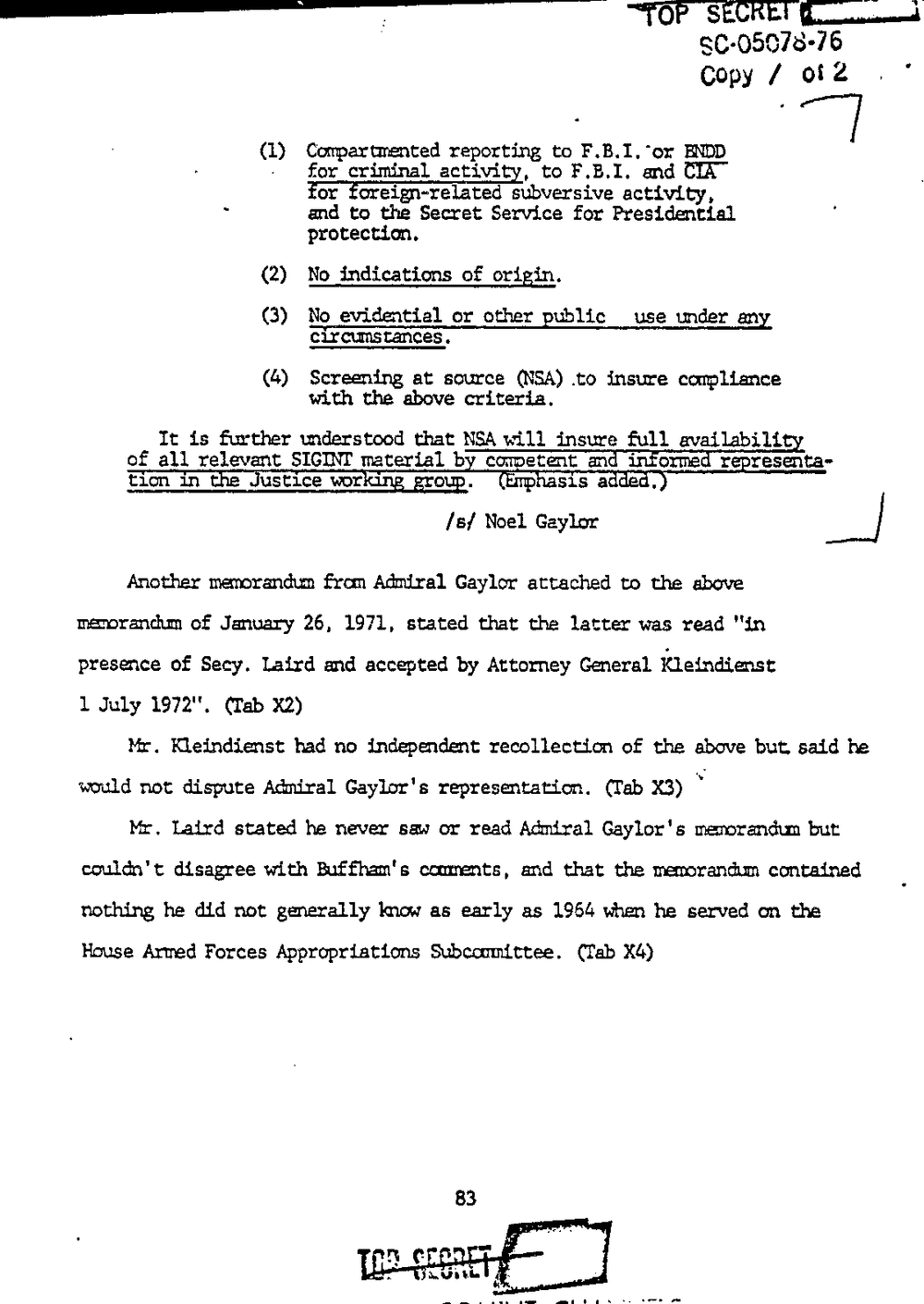
30-05078-76
COpy 0l2 .
7
C?cmpartmented reporting to F.B.I. 'or EDD
- for crin?nal activity, to F.B.I. and
for foreign-related subversive activity,
and to the Secret Service for Presidential
protection.
(2) No indications of origin.
(3) No evidential or other public use under any
(4) Screening at source (NSA) .to insure compliance
with the above criteria.
It is father mderstood that NSA will insure full availability
of all relevant material by carpetent and informed rgaresenta-
Eon in the Justice working group. (BrphaSiS added)
I 3/ Noel Geylor I
Another mermrandum ?rm Admiral Gaylor attached to the above
mrmdum of January 26, 1971, stated that the latter was read "in
presence of Secy. Laird and accepted by Attorney General lileindienst
1 July 1972". (Tab X2)
Mr. Kleindienst had no indepmdent recollection of the above but. said he
would not dispute Admiral Gaylor?s representation. (Tab X3)
Mr. Laird stated he never saw or read Admiral Gaylor's but
couldn't disagree with Buffham'a commits, and that the mernorandim contained
nothing he did not generally know as early as 1964 when he served on the
House Armed Forces ApprOpriations Subcmmittee. (Tab X4)
30-05078-76
COpy 0l2 .
7
C?cmpartmented reporting to F.B.I. 'or EDD
- for crin?nal activity, to F.B.I. and
for foreign-related subversive activity,
and to the Secret Service for Presidential
protection.
(2) No indications of origin.
(3) No evidential or other public use under any
(4) Screening at source (NSA) .to insure compliance
with the above criteria.
It is father mderstood that NSA will insure full availability
of all relevant material by carpetent and informed rgaresenta-
Eon in the Justice working group. (BrphaSiS added)
I 3/ Noel Geylor I
Another mermrandum ?rm Admiral Gaylor attached to the above
mrmdum of January 26, 1971, stated that the latter was read "in
presence of Secy. Laird and accepted by Attorney General lileindienst
1 July 1972". (Tab X2)
Mr. Kleindienst had no indepmdent recollection of the above but. said he
would not dispute Admiral Gaylor?s representation. (Tab X3)
Mr. Laird stated he never saw or read Admiral Gaylor's but
couldn't disagree with Buffham'a commits, and that the mernorandim contained
nothing he did not generally know as early as 1964 when he served on the
House Armed Forces ApprOpriations Subcmmittee. (Tab X4)
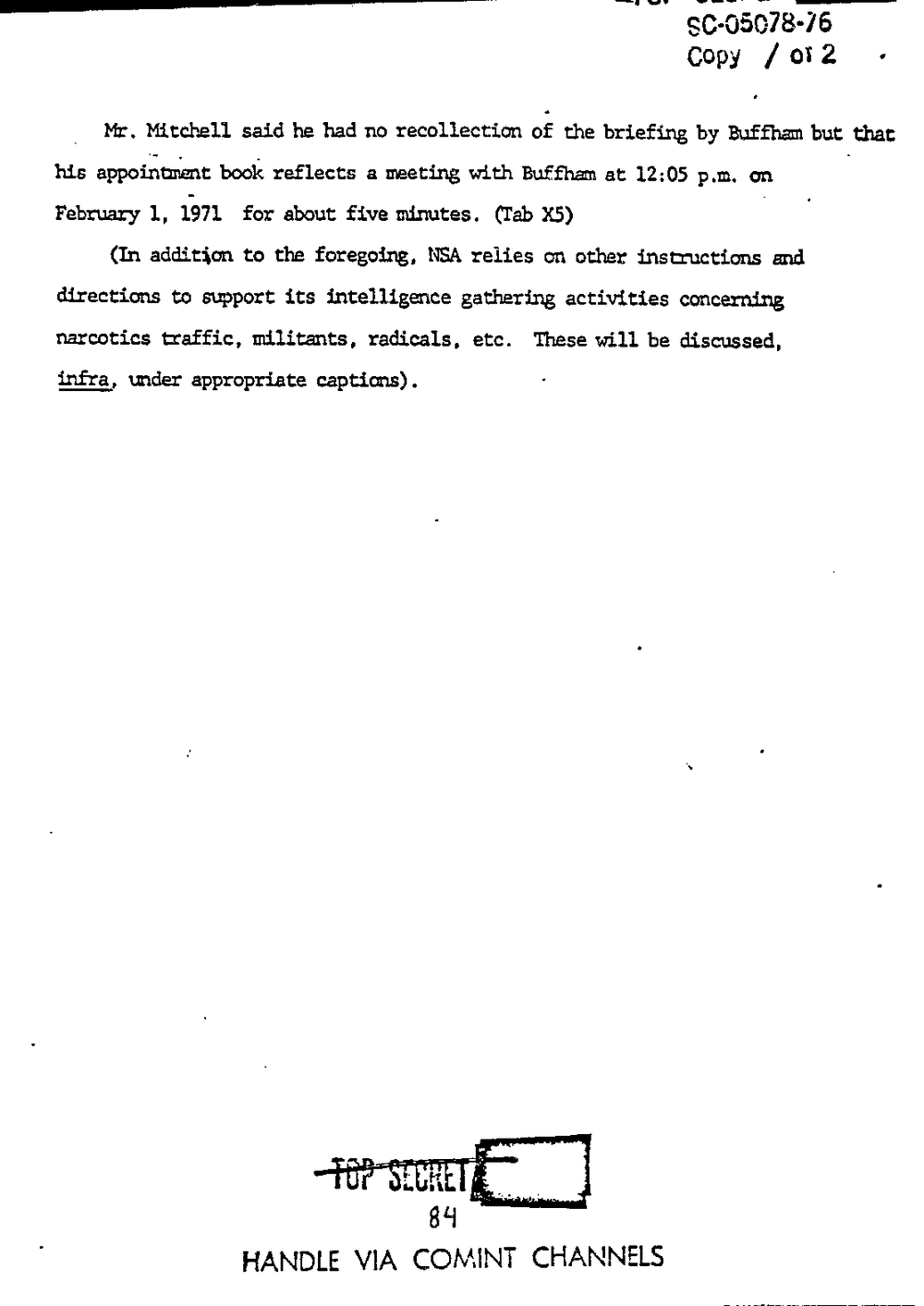
53.050787?
COpy or 2
Mr. Mitchell said he had no recollection oi: the briefing by Buffham but that
his appoinmient book reflects a meeting with Buffham at 12:05 p.m. on .
February 1, 1-971 for about five udnutes. crab X5)
(In addition to the foregoing, NSA relies on other instructions and
directions to support its intelligence gathering activities concerning
narcotics traffic, militants. radicals. etc. These will be discussed.
infra, under appropriate captions).
53.050787?
COpy or 2
Mr. Mitchell said he had no recollection oi: the briefing by Buffham but that
his appoinmient book reflects a meeting with Buffham at 12:05 p.m. on .
February 1, 1-971 for about five udnutes. crab X5)
(In addition to the foregoing, NSA relies on other instructions and
directions to support its intelligence gathering activities concerning
narcotics traffic, militants. radicals. etc. These will be discussed.
infra, under appropriate captions).
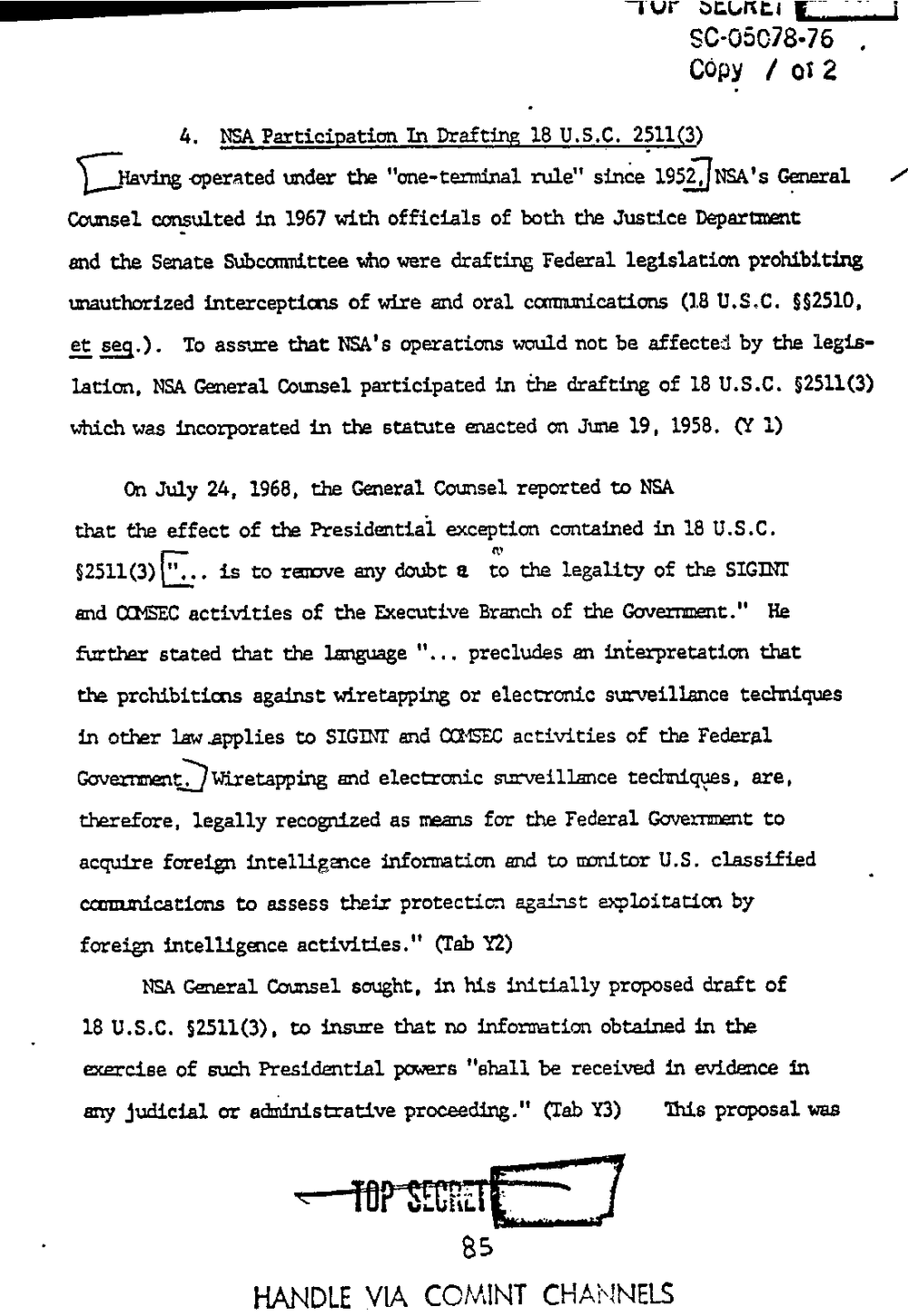
'wr stunt: i
80-05078-76
012
4. NSA Participation In Drafting 18 U.S.C. 2811(3)
:Having operated under the "one-tenninal rule" since General
Counsel consulted in 1967 with officials of both the Justice Department
and the Senate Subcommittee who were drafting Federal legislation prohibiting
muthorized intercepticns of wire and oral cmunmications (1.8 U.S.C. 552510,
gt sea.) . To assure that NSA's operations would not be affected by the legis-
lation, NSA General Counsel participated in the drafting of 18 U.S.C. 525110)
which was incorporated in the statute enacted on June 19. 1958. (Y 1)
On July 24, 1968. the General Counsel reported to NSA
that the effect of the Presidential exception contained in 18 U.S.C.
525110) is to remove any doubt a. the legality of the
and (INSEC activities of the Executive Branch of the Goverment." He
further stated that the language . . precludes an interpretation that
the prohibitions against wiretapping or electronic surveillance techniques
in other lawapplies to and coast activities of the Federal
Wiretapping and electronic surveillance tectmiques, are.
therefore, legally recognized as means for the Federal Goverth to
acquire foreign intelligence information and to monitor U.S. classified
to assess their protection against eJ-cploitatim by
foreign intelligence activities." (Tab Y2)
NSA General Counsel sought. in his initially proposed draft of
18 U.S.C. 525116), to insure that no infomtion obtained in the
exercise of such Presidential powers "shall be received in evidence in
any judicial or administrative proceeding." Crab Y3) This proposal was
-
85
HANDLE VIA COMINT CHANNELS
'wr stunt: i
80-05078-76
012
4. NSA Participation In Drafting 18 U.S.C. 2811(3)
:Having operated under the "one-tenninal rule" since General
Counsel consulted in 1967 with officials of both the Justice Department
and the Senate Subcommittee who were drafting Federal legislation prohibiting
muthorized intercepticns of wire and oral cmunmications (1.8 U.S.C. 552510,
gt sea.) . To assure that NSA's operations would not be affected by the legis-
lation, NSA General Counsel participated in the drafting of 18 U.S.C. 525110)
which was incorporated in the statute enacted on June 19. 1958. (Y 1)
On July 24, 1968. the General Counsel reported to NSA
that the effect of the Presidential exception contained in 18 U.S.C.
525110) is to remove any doubt a. the legality of the
and (INSEC activities of the Executive Branch of the Goverment." He
further stated that the language . . precludes an interpretation that
the prohibitions against wiretapping or electronic surveillance techniques
in other lawapplies to and coast activities of the Federal
Wiretapping and electronic surveillance tectmiques, are.
therefore, legally recognized as means for the Federal Goverth to
acquire foreign intelligence information and to monitor U.S. classified
to assess their protection against eJ-cploitatim by
foreign intelligence activities." (Tab Y2)
NSA General Counsel sought. in his initially proposed draft of
18 U.S.C. 525116), to insure that no infomtion obtained in the
exercise of such Presidential powers "shall be received in evidence in
any judicial or administrative proceeding." Crab Y3) This proposal was
-
85
HANDLE VIA COMINT CHANNELS
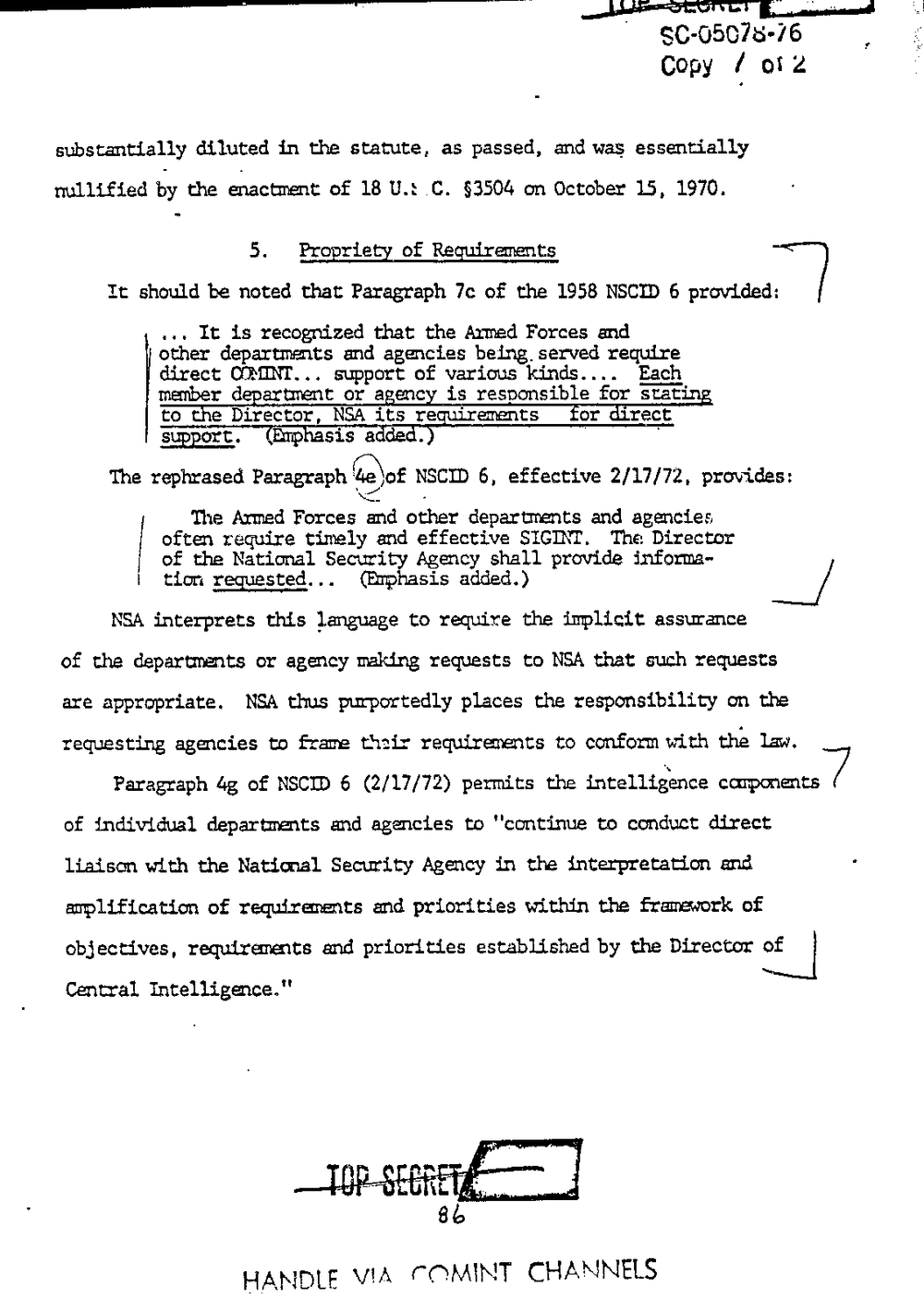
COpy o: 2
substantially diluted in the statute, as passed, and was essentially
nullified by the enactment of 18 LL: .C. 53504 on October 15, 1970.
5 Propriety of Requirarmts
It should be noted that Paragraph 7c of the 1958 NSCID 6 provided:
It is recognized that the Aired Forces mid
other and agencies being, served require
direct . . support of various kinds. . . . Each
member department or agency is responsible for stating
to the Director, NSA its rgiirenmts for direct
syport. (Emphasis added.)
The rephrased Paragraph @of NSCIZD 6. effective 2/17/72, provides:
.
The Armed Forces and other departments and agencies
often require timely and effective The Director
of the National Security Agency shall provide informa-
1 tion r?sted. . . (Emphasis added.)
NSA interprets this language to require the implicit assurance
of the departments or agency making requests to NSA that such requests
are appropriate. NSA thus purportedly places the responsibility on the
requesting agencies to frame their requiranents to conform with the law.
Paragraph 4g of NSCID 6 (2/17/72) permits the intelligence conponents7
of individual departments and agencies to "continue to conduct direct
liaison with the Natimal Security Agmcy in the interpretation and
amplification of requirezmts and priorities within the framework of
obj actives, requirements and priorities established by the Director of
Central Intelligence."
HANDLE VIA FOMXNT CHANNELS
COpy o: 2
substantially diluted in the statute, as passed, and was essentially
nullified by the enactment of 18 LL: .C. 53504 on October 15, 1970.
5 Propriety of Requirarmts
It should be noted that Paragraph 7c of the 1958 NSCID 6 provided:
It is recognized that the Aired Forces mid
other and agencies being, served require
direct . . support of various kinds. . . . Each
member department or agency is responsible for stating
to the Director, NSA its rgiirenmts for direct
syport. (Emphasis added.)
The rephrased Paragraph @of NSCIZD 6. effective 2/17/72, provides:
.
The Armed Forces and other departments and agencies
often require timely and effective The Director
of the National Security Agency shall provide informa-
1 tion r?sted. . . (Emphasis added.)
NSA interprets this language to require the implicit assurance
of the departments or agency making requests to NSA that such requests
are appropriate. NSA thus purportedly places the responsibility on the
requesting agencies to frame their requiranents to conform with the law.
Paragraph 4g of NSCID 6 (2/17/72) permits the intelligence conponents7
of individual departments and agencies to "continue to conduct direct
liaison with the Natimal Security Agmcy in the interpretation and
amplification of requirezmts and priorities within the framework of
obj actives, requirements and priorities established by the Director of
Central Intelligence."
HANDLE VIA FOMXNT CHANNELS
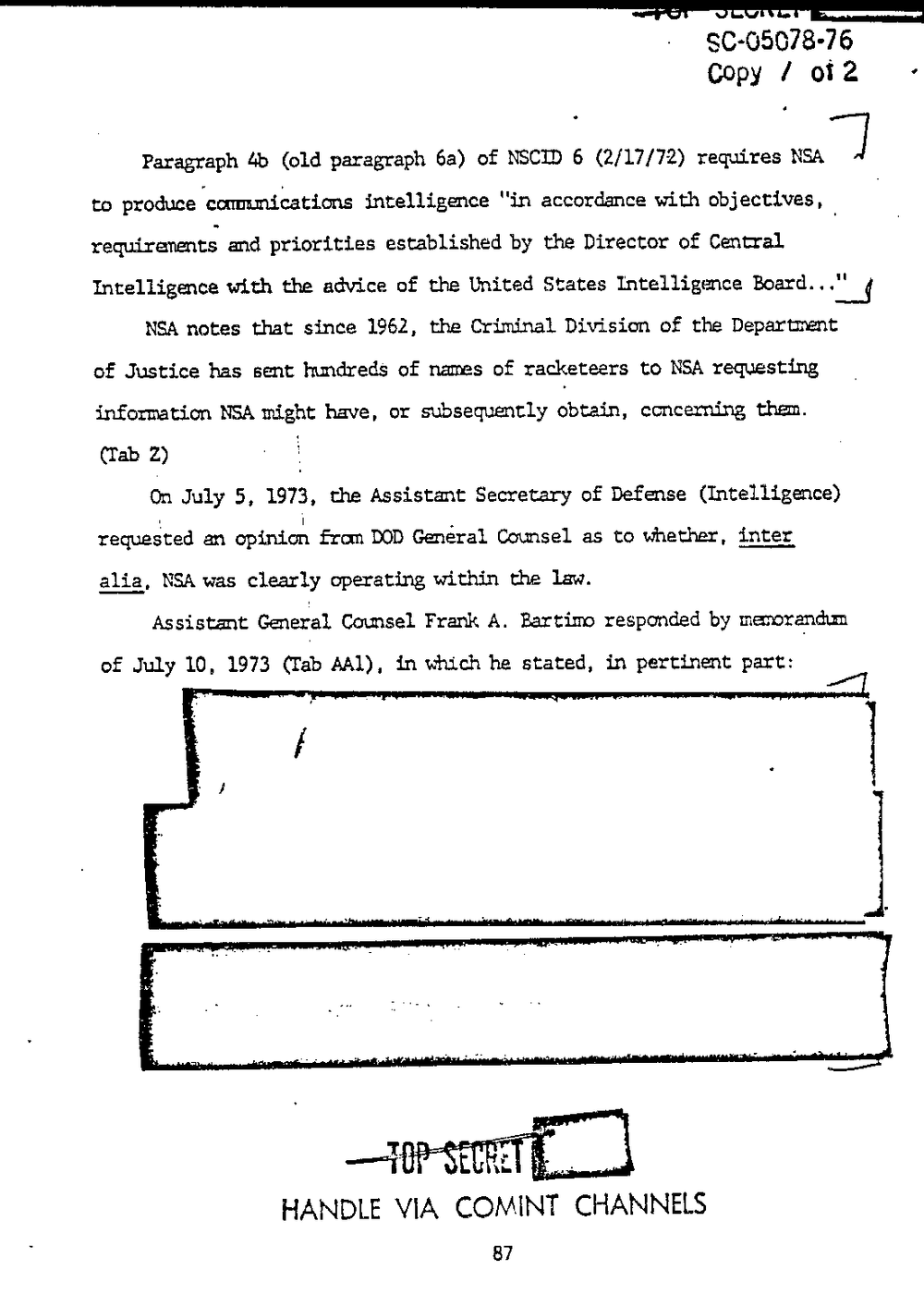
50-05078-76
Copy oi2 -
Paragraph 41: (old paragraph 6a) of NSCID 6 (2/17/72) requires NESA7
to produce intelligence "in accordance with obj actives. I
requirements: and priorities established by the Director of Central
Intelligence. with the advice of the United States Intelligence Board. .
NSA notes that since 1962, the Criminal Division of the Department
of Justice has sent of names of racketeers to NBA requesting
information NSA might have, or subsequently obtain, concerning them.
crab 2)
On July 5, 1973, the Assistant Secretary of Defense (Intelligence)
requested an opinion from DOD General Comsel as to whether. $511535
g3, NSA was clearly operating within the law.
Assistant General Counsel Frank A. Bartimo responded by manoranchn
of July 10, 1973 (Tab M1). in which he stated. in pertinent part:
87
50-05078-76
Copy oi2 -
Paragraph 41: (old paragraph 6a) of NSCID 6 (2/17/72) requires NESA7
to produce intelligence "in accordance with obj actives. I
requirements: and priorities established by the Director of Central
Intelligence. with the advice of the United States Intelligence Board. .
NSA notes that since 1962, the Criminal Division of the Department
of Justice has sent of names of racketeers to NBA requesting
information NSA might have, or subsequently obtain, concerning them.
crab 2)
On July 5, 1973, the Assistant Secretary of Defense (Intelligence)
requested an opinion from DOD General Comsel as to whether. $511535
g3, NSA was clearly operating within the law.
Assistant General Counsel Frank A. Bartimo responded by manoranchn
of July 10, 1973 (Tab M1). in which he stated. in pertinent part:
87
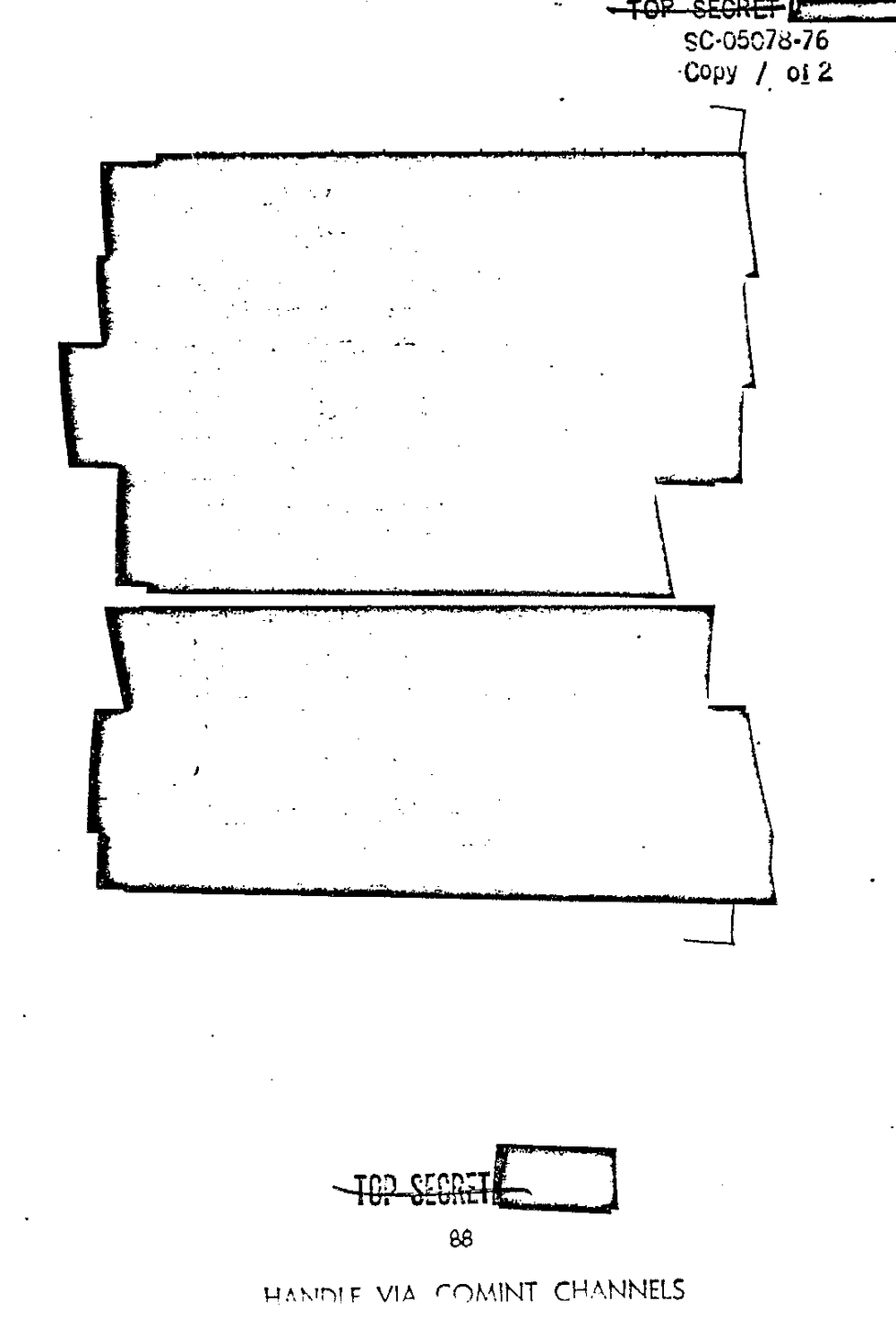
sac-0507856
Copy o: 2
mer VIA FOMINT CHANNELS
sac-0507856
Copy o: 2
mer VIA FOMINT CHANNELS
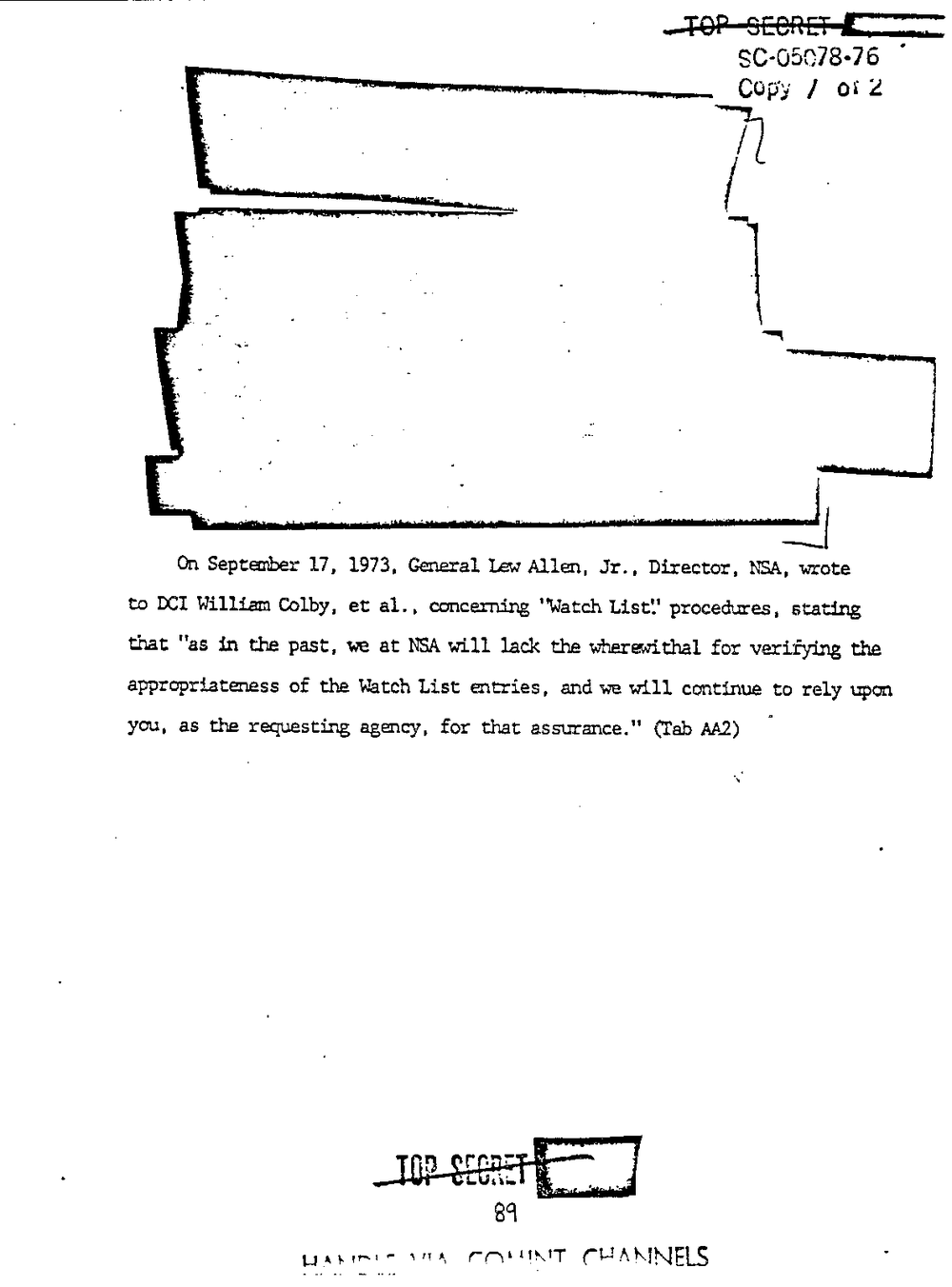
80-05078-76
C0"?y 05
Z7
On Septanber 17, 1973, General Lew Allen. Jr., Director, NSA. wrote
to DCI William Colby, et a1. . concerning "Watch List? procedures, stating
that "as in the past, we at NSA will lack the Warmithal for verifying the
of the Watch List entries, and we will continue to rely upon
you. as the requesting age-may. for that assurance." (Tab M2)
80-05078-76
C0"?y 05
Z7
On Septanber 17, 1973, General Lew Allen. Jr., Director, NSA. wrote
to DCI William Colby, et a1. . concerning "Watch List? procedures, stating
that "as in the past, we at NSA will lack the Warmithal for verifying the
of the Watch List entries, and we will continue to rely upon
you. as the requesting age-may. for that assurance." (Tab M2)
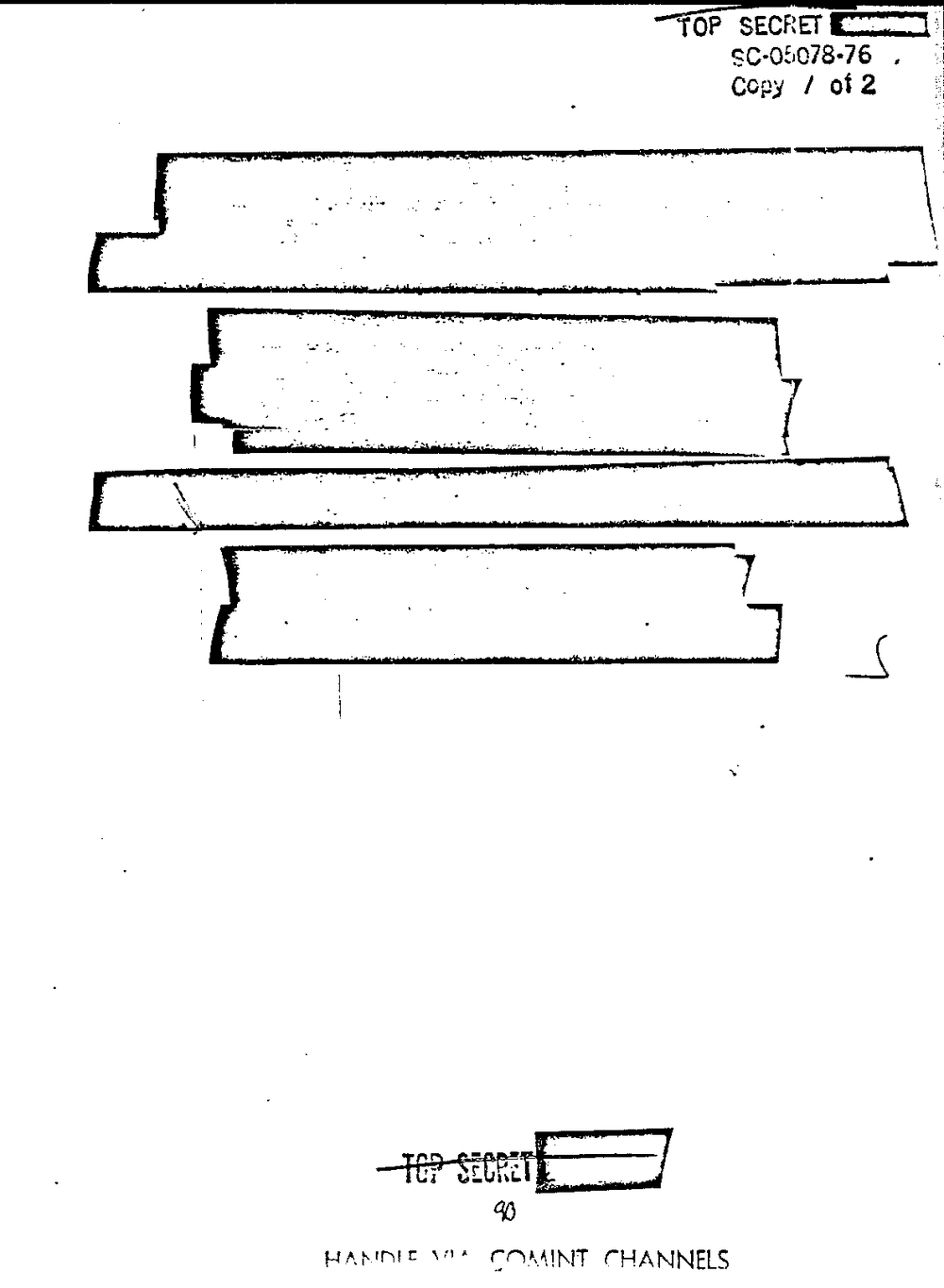
HAth I: A
TOP SECRET
sc-oso78-76
Copy 012
FHANNELS
HAth I: A
TOP SECRET
sc-oso78-76
Copy 012
FHANNELS
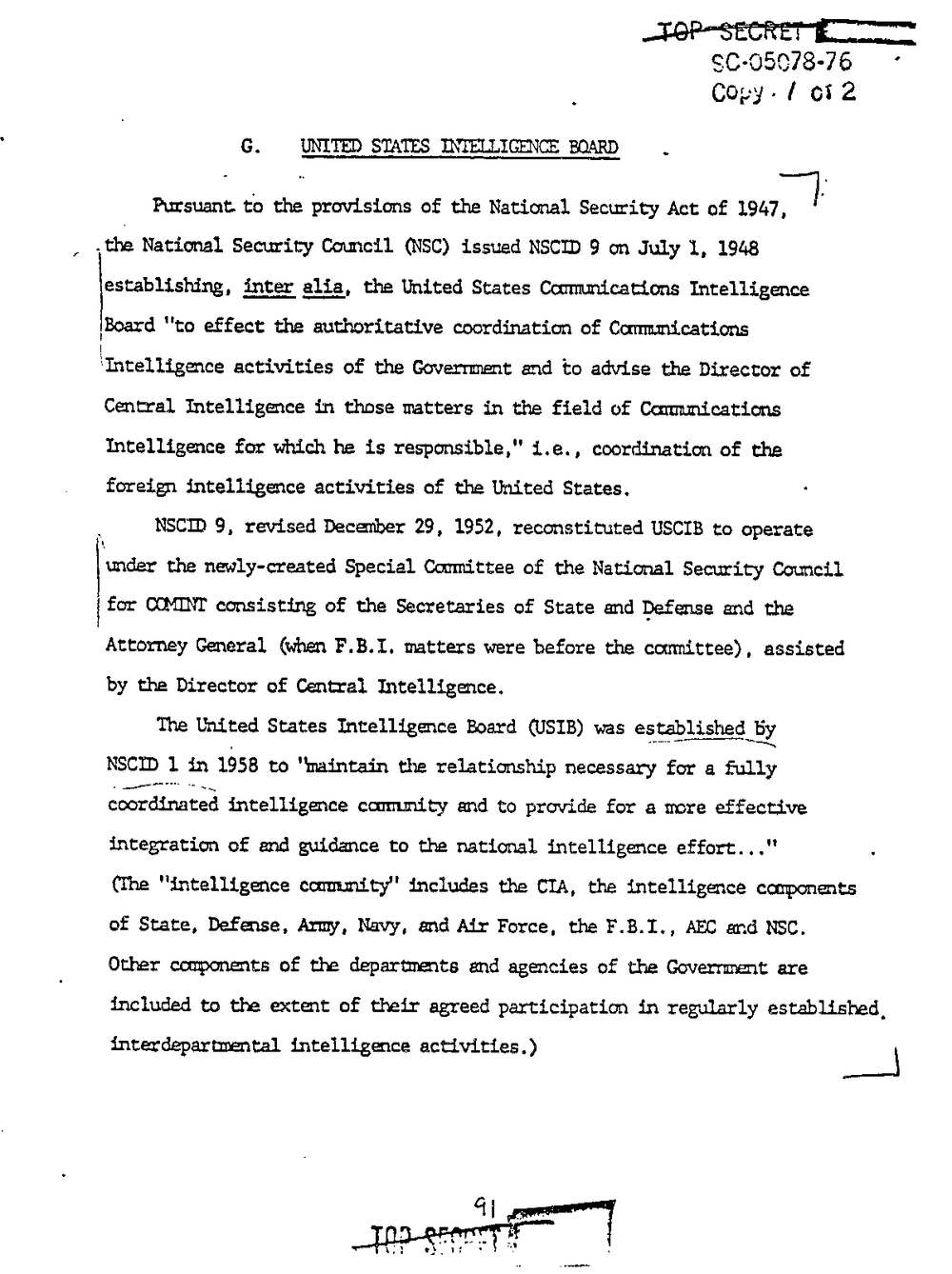
30-05978-76
COpy- I OS 2
G. UNITED STATES INTELLIGENCE BOARD
9
Pursuant to the provisions of the National Security Act of
.the National Security Council (use) issued 9 on July 1, 1948
establishing, Elia, the United States Coummications Intelligence
?Board "to effect the authoritative coordination of
activities of the Govermmt and to advise the Director of
Centml Intelligence in those matters in the field of
Intelligmce for which he is responsible," i.e. coordination of the
foreign intelligence activities of the United States.
I NSCID 9, revised December 29, 1952, reconstituted USCIB to operate
{under the newly-created Special Committee of the National Seem-in? Council
{for consisting of the Secretaries of State and Defense and the
Attorney General (when F.B.I. matters were before the committee) assisted
by the Director of Germ-a1 Intelligence.
The United States Intelligence Board (USIB) was estahiisheg?
NSCID 1 in 1958 to "maintain the relationship necessary for a fully
intelligence ccommity and to provide for a sore effective
integration of and guidance to the national intelligence effort. .
(The ?intelligence ccunmity? includes the CIA, the intelligence components
of State. Defense. Army, Navy. and Air Force, the F.B.I., ABC and NSC.
Other components of the and agencies of the Goverment are
included to the actent of their agreed participation in regularly established_
interdepartmental intelligence activities.) A
30-05978-76
COpy- I OS 2
G. UNITED STATES INTELLIGENCE BOARD
9
Pursuant to the provisions of the National Security Act of
.the National Security Council (use) issued 9 on July 1, 1948
establishing, Elia, the United States Coummications Intelligence
?Board "to effect the authoritative coordination of
activities of the Govermmt and to advise the Director of
Centml Intelligence in those matters in the field of
Intelligmce for which he is responsible," i.e. coordination of the
foreign intelligence activities of the United States.
I NSCID 9, revised December 29, 1952, reconstituted USCIB to operate
{under the newly-created Special Committee of the National Seem-in? Council
{for consisting of the Secretaries of State and Defense and the
Attorney General (when F.B.I. matters were before the committee) assisted
by the Director of Germ-a1 Intelligence.
The United States Intelligence Board (USIB) was estahiisheg?
NSCID 1 in 1958 to "maintain the relationship necessary for a fully
intelligence ccommity and to provide for a sore effective
integration of and guidance to the national intelligence effort. .
(The ?intelligence ccunmity? includes the CIA, the intelligence components
of State. Defense. Army, Navy. and Air Force, the F.B.I., ABC and NSC.
Other components of the and agencies of the Goverment are
included to the actent of their agreed participation in regularly established_
interdepartmental intelligence activities.) A
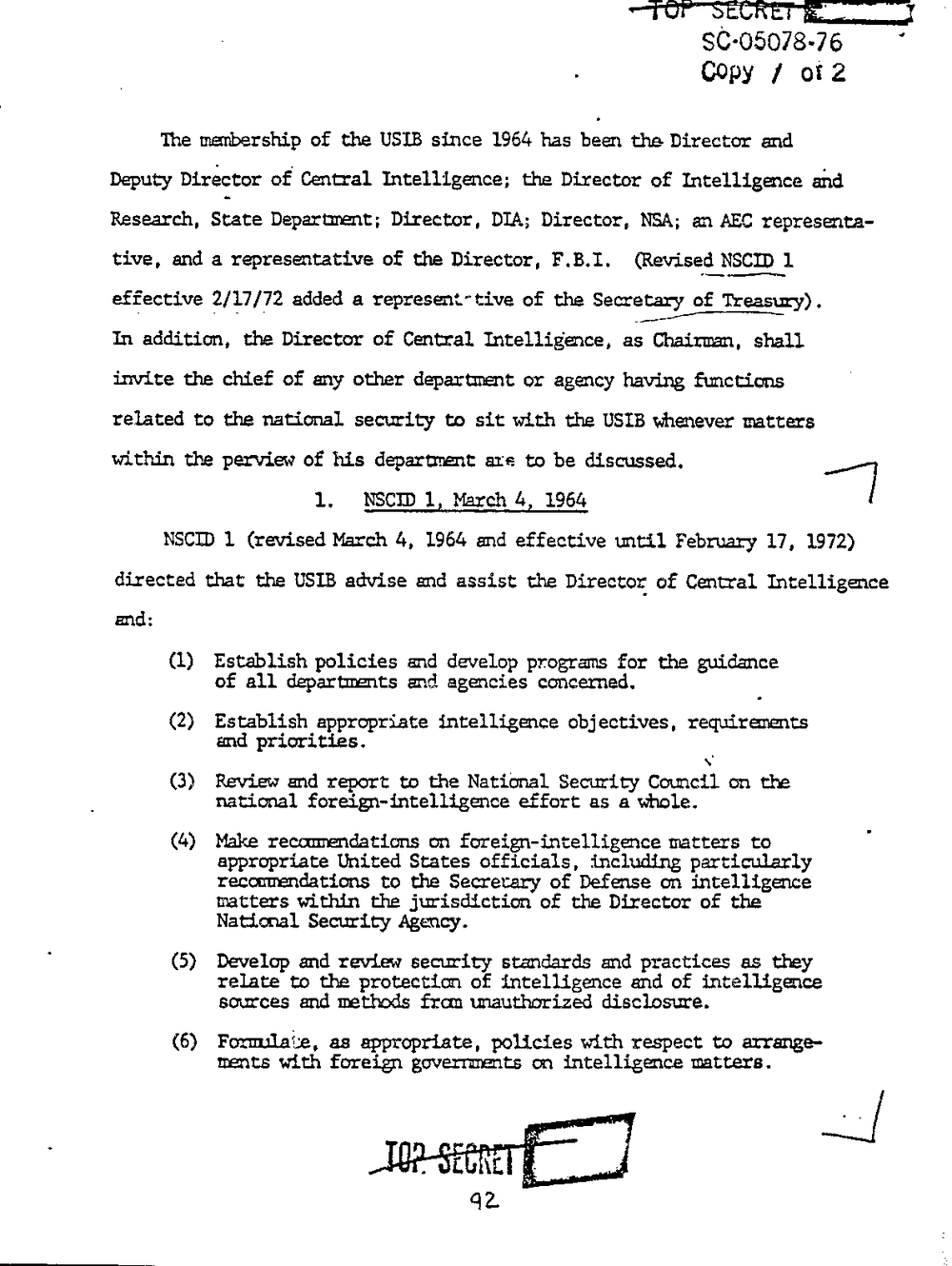
80-05078-76
COPY I oi 2
Tne tmanbership of the USIB since 1964 has been the Director and
Deputy Director of Central Intelligence; the Diractor of Intelligence and
Research, State Director, Director, an ABC representa-
tive, and a representative of the Director, F.B.I. 1
effective 2/17/72 added a of the Secretary i may) .
In addition, the Director of Central Intelligence, as?E?h?airmm, shall
invite the chief of any other department or agency having fmctions
related to the national security to sit with the USIB whenever matters
within the perview of his department are to be discussed.
1. NSCID March 4, 1964
NSCID 1 (revised March 4. 1964 and effective until February 17, 1972)
directed that the USIB advise and assist the Director of Central Intelligence
and:
(1) Establish policies and develop programs for the guidance
of all departments and agencies concerned.
(2) Establish appropriate intelligmce objectives, requirements
and priorities.
(3) Review and report to the National Security Council on the
national foreign-intelligence effort as a whole.
(4) Make recommendations on foreign-intelligence matters to
appropriate United States officials, including particularly
recommdations to the Secretary of Defense on intelligence
matters within the jurisdiction of the Director of the
National Security Agency.
(5) Develop and review security standards and practices as they
relate to the protection of intelligence and of intelligaice
sources and methods mauthorized disclosure.
(6) Formulate. as appropriate, policies with respect to arrange-
ments with foreign governments on intelligence matters.
80-05078-76
COPY I oi 2
Tne tmanbership of the USIB since 1964 has been the Director and
Deputy Director of Central Intelligence; the Diractor of Intelligence and
Research, State Director, Director, an ABC representa-
tive, and a representative of the Director, F.B.I. 1
effective 2/17/72 added a of the Secretary i may) .
In addition, the Director of Central Intelligence, as?E?h?airmm, shall
invite the chief of any other department or agency having fmctions
related to the national security to sit with the USIB whenever matters
within the perview of his department are to be discussed.
1. NSCID March 4, 1964
NSCID 1 (revised March 4. 1964 and effective until February 17, 1972)
directed that the USIB advise and assist the Director of Central Intelligence
and:
(1) Establish policies and develop programs for the guidance
of all departments and agencies concerned.
(2) Establish appropriate intelligmce objectives, requirements
and priorities.
(3) Review and report to the National Security Council on the
national foreign-intelligence effort as a whole.
(4) Make recommendations on foreign-intelligence matters to
appropriate United States officials, including particularly
recommdations to the Secretary of Defense on intelligence
matters within the jurisdiction of the Director of the
National Security Agency.
(5) Develop and review security standards and practices as they
relate to the protection of intelligence and of intelligaice
sources and methods mauthorized disclosure.
(6) Formulate. as appropriate, policies with respect to arrange-
ments with foreign governments on intelligence matters.
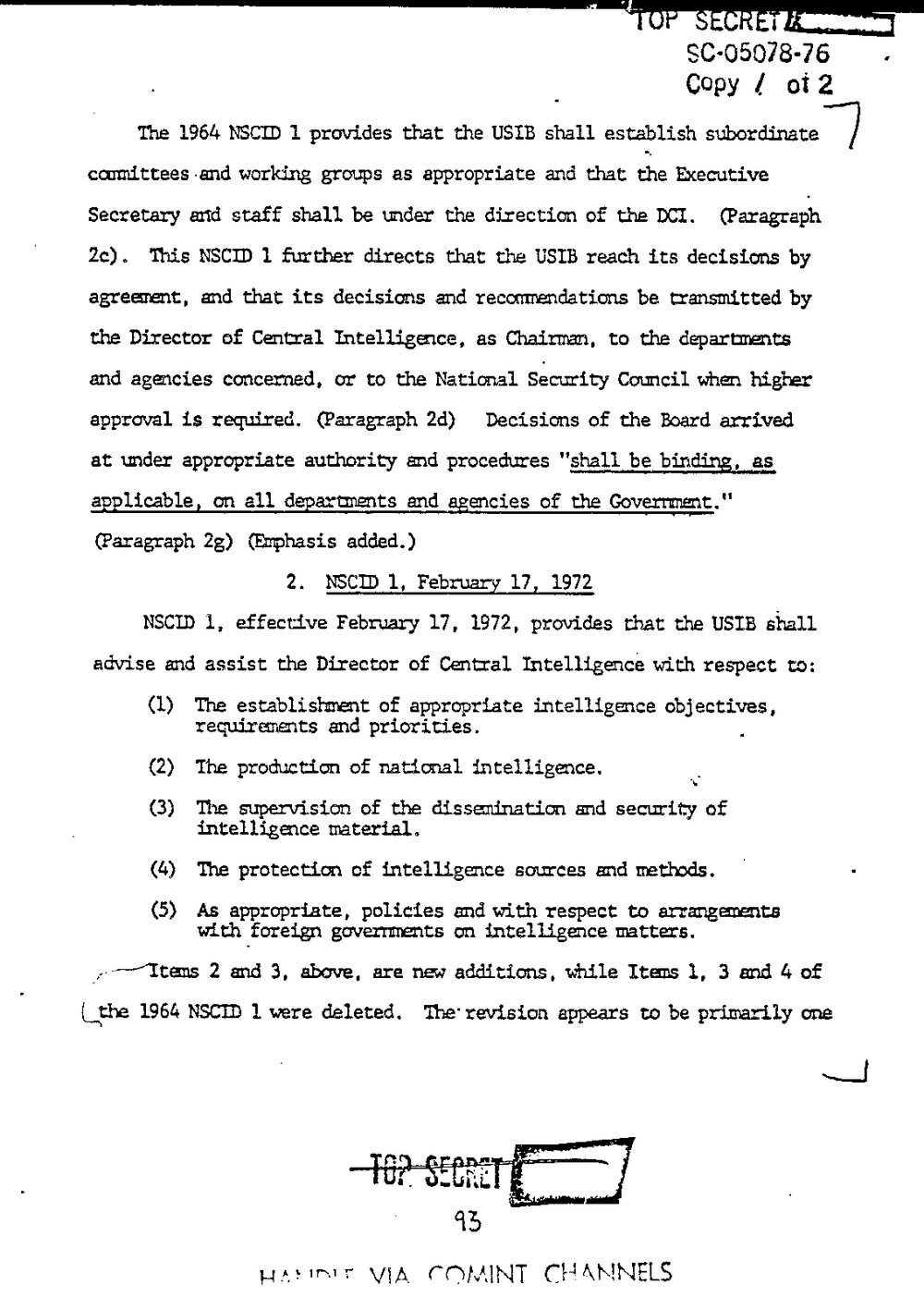
80-05078-76 .
Copy 1 of 2
The 1964 NSCID 1 provides that the USIB shall establish subordinatej
committees and working groups as appropriate and that the Erecutive
Secretary and staff shall be under the direction of the DCI. (Paragraph
2c) . 'Ihis NSCID 1 ?n'ther directs that the USIB reach its decisions by
agreement, and that its decisions and be transmitted by
the Director of Central Intelligence, as Chairman. to the departments
and agencies concerned, or to the National Security Council when higher
approval is required. (Paragraph 2d) Decisions of the Board arrived
at under appropriate authority and procedures "shall be binding. as
applicable, on all departments and agencies of the wvmt."
(Paragraph 2g) (Emphasis added.)
2. NSCID 1, February 17, 1972
user: 1, effective February 17. 1972, provides that the usm shall
advise and assist the Director of Central Intelligaice with respect to:
The establisl?mt of appropriate intelligence objectives,
reqx?reomts and priorities.
(2) The production of national intelligence.
(3) The supervision of the dissemination and security of
intelligence material.
(4) The protection of intelligence sources and methods.
(5) As appropriate, policies and with respect to arrangemaits
with foreign governments on intelligence mattas.
far/Items 2 and 3, above. are new additions. while Items 1. 3 and 4 of
(?rm 1964 NSCID were deleted. 'Ihe'revision appears to be primarily one
His m1 FOIVHNT CH ANNELS
80-05078-76 .
Copy 1 of 2
The 1964 NSCID 1 provides that the USIB shall establish subordinatej
committees and working groups as appropriate and that the Erecutive
Secretary and staff shall be under the direction of the DCI. (Paragraph
2c) . 'Ihis NSCID 1 ?n'ther directs that the USIB reach its decisions by
agreement, and that its decisions and be transmitted by
the Director of Central Intelligence, as Chairman. to the departments
and agencies concerned, or to the National Security Council when higher
approval is required. (Paragraph 2d) Decisions of the Board arrived
at under appropriate authority and procedures "shall be binding. as
applicable, on all departments and agencies of the wvmt."
(Paragraph 2g) (Emphasis added.)
2. NSCID 1, February 17, 1972
user: 1, effective February 17. 1972, provides that the usm shall
advise and assist the Director of Central Intelligaice with respect to:
The establisl?mt of appropriate intelligence objectives,
reqx?reomts and priorities.
(2) The production of national intelligence.
(3) The supervision of the dissemination and security of
intelligence material.
(4) The protection of intelligence sources and methods.
(5) As appropriate, policies and with respect to arrangemaits
with foreign governments on intelligence mattas.
far/Items 2 and 3, above. are new additions. while Items 1. 3 and 4 of
(?rm 1964 NSCID were deleted. 'Ihe'revision appears to be primarily one
His m1 FOIVHNT CH ANNELS
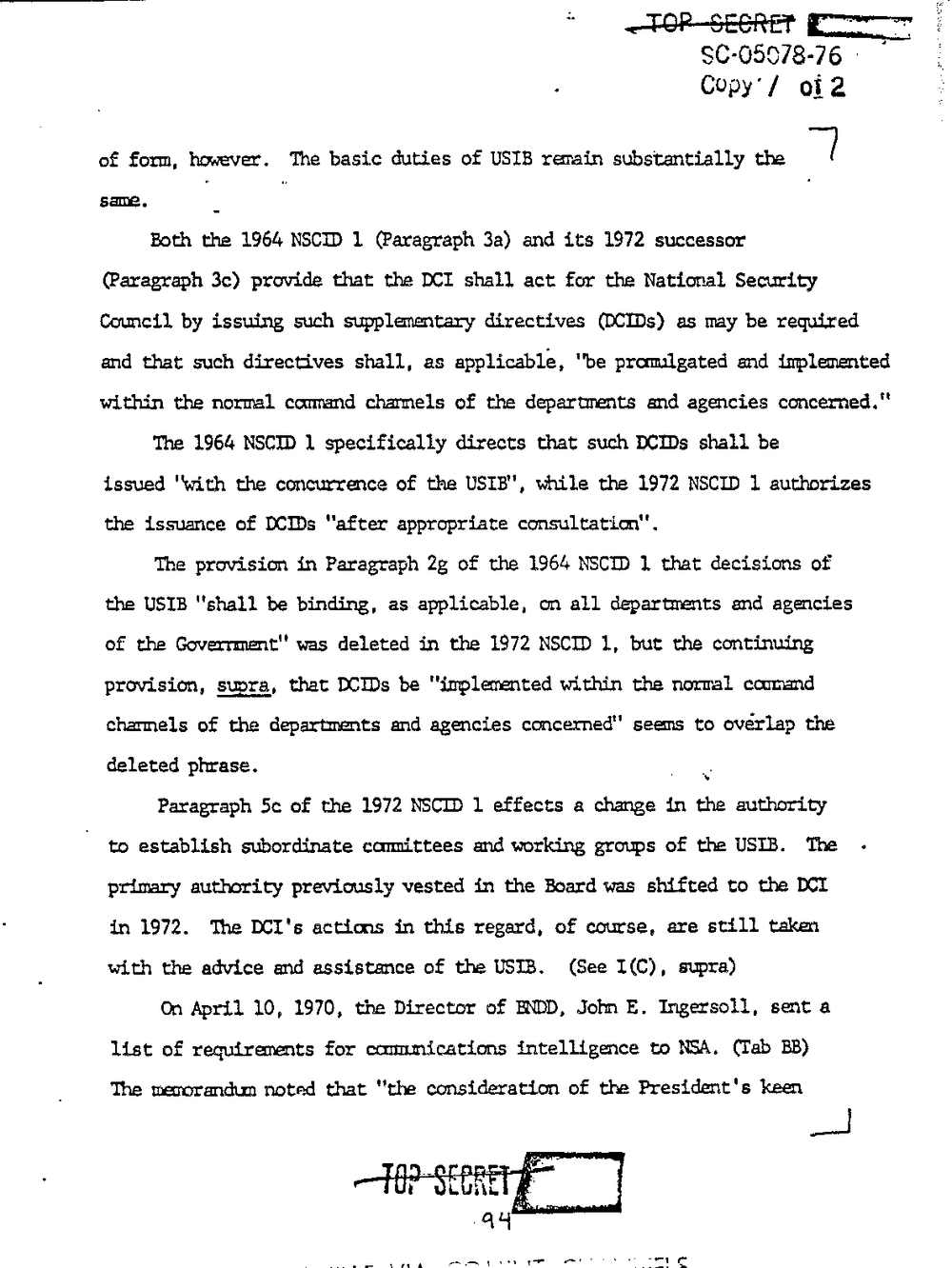
MGR-ET
80-05078-76
0093'! 0:2
of form. however. The basic duties of USIB remain substantially the 7
same.
Both the 1964 N803) 1 (Paragraph 3a) and its 1972 successor
(Paragraph 3c) provide that the D01 shall act for the National Security
Council by issuing such supplementary directives (DCIDs) as may be required
and that such directives shall, as applicable. "be promulgated and implemented
within the normal command chamels of the departments and agencies concerned."
The 1964 NSCID 1 specifically directs that such DCIDs shall be
issued "with the concurrence of the while the 1972 NSCID 1 authorizes
the issuance of DCIDs "after appropriate consultation".
The provision in Paragraph 2g of the 1964 NSCID 1 that decisions of
the USIB "shall be binding, as applicable. on all departments and agencies
of the was deleted in the 1972 NSCID 1, but the continuing
provision, we. that DCIDs be "implemented within the normal command
channels of the departments and agencies concerned" seans to overlap the
deleted phrase. I
Paragraph Sc of the 1972 NSCID 1 effects a change in the authority
to establish subordinate cmmittees and working groups of the USIB. The
primary authority previously vested in the Board was shifted to the DCI
in 1972. The DCI's actions in this regard, of course. are still taken
with the advice and assistance of the USIB. (See . supra)
On April 10. 1970, the Director of ENDD, John E. Ingersoll, sent a
list of requirements for cannmications intelligence to NBA. (Tab BB)
'Ihe meridian noted that "the consideration of the President's keen
MGR-ET
80-05078-76
0093'! 0:2
of form. however. The basic duties of USIB remain substantially the 7
same.
Both the 1964 N803) 1 (Paragraph 3a) and its 1972 successor
(Paragraph 3c) provide that the D01 shall act for the National Security
Council by issuing such supplementary directives (DCIDs) as may be required
and that such directives shall, as applicable. "be promulgated and implemented
within the normal command chamels of the departments and agencies concerned."
The 1964 NSCID 1 specifically directs that such DCIDs shall be
issued "with the concurrence of the while the 1972 NSCID 1 authorizes
the issuance of DCIDs "after appropriate consultation".
The provision in Paragraph 2g of the 1964 NSCID 1 that decisions of
the USIB "shall be binding, as applicable. on all departments and agencies
of the was deleted in the 1972 NSCID 1, but the continuing
provision, we. that DCIDs be "implemented within the normal command
channels of the departments and agencies concerned" seans to overlap the
deleted phrase. I
Paragraph Sc of the 1972 NSCID 1 effects a change in the authority
to establish subordinate cmmittees and working groups of the USIB. The
primary authority previously vested in the Board was shifted to the DCI
in 1972. The DCI's actions in this regard, of course. are still taken
with the advice and assistance of the USIB. (See . supra)
On April 10. 1970, the Director of ENDD, John E. Ingersoll, sent a
list of requirements for cannmications intelligence to NBA. (Tab BB)
'Ihe meridian noted that "the consideration of the President's keen
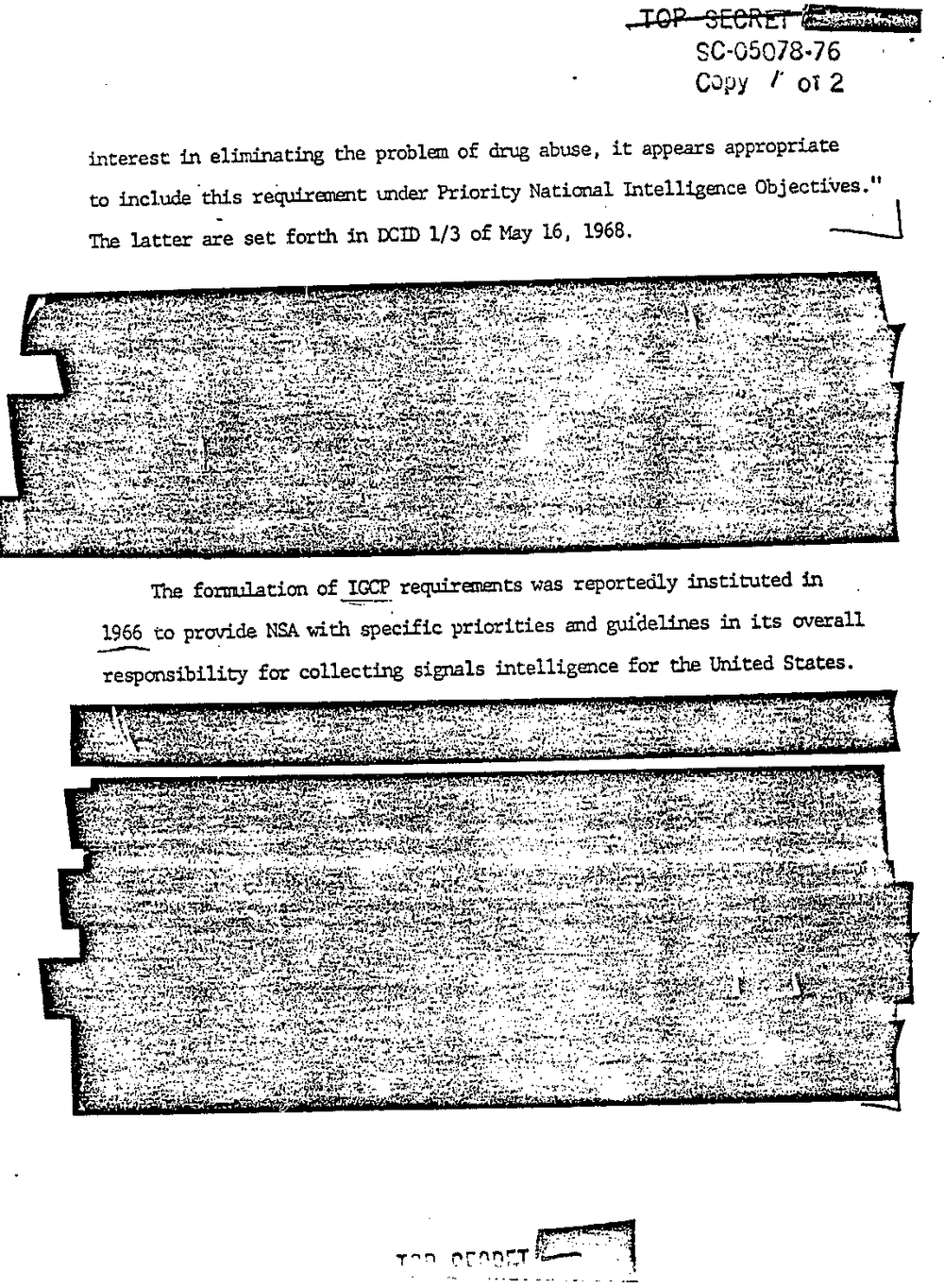
80-05078-76 -
COW or 2
interest in eliminating the problem of drug abuse, it appears appropriate
to include "this re?uixexmt under Priority National Intelligence Objectives."
The latter are set forth in DCID 1/3 of May 16, 1968.
. I ha.16- .
i?'r I.
"z ..
-
.1. emIPI"King?vdrk r"
. .30. . I ?We 535?.
?3 - - 1
.nt'
I I
.- 330
.
Jig-?r
?may
llarT?x?Ih.1..4w}. 2' "M?31" '3 ?:35 ?tr-$.4-
Ihe formulation of IGCP requirements was reportedly instituted in
1966 to provide NSA with specific priorities and guidelines in its overall
A
responsibility for collecting signals intelligence for the United States.
. 1
I-
Mn}.
0-s-
iniw .- 1
- 2.x 9
640:3. -
. - 3-.-
In!? .E-d '35 )1
:o
MT-
wu:
?g?f?zgk? 3
3"
- hill- I
6
I
.imiegaaiqr?It; {drags-.-.. :wf-?u-L-l 35435;" .:
A i. I- 1,595.935. .H 1' ?1.37. ?hr ?28? Jana? ag?hx:?1., ?wap?u'45, . *r .
@131? - mil a: 4-. .. cups.4. ?La-?l - . - hark5-3,ng - ..
395? .- .
4 - 5-
ut?. r'ftZ'pu'C?k'?
.- 2"
.I .1,
v-o?q. -
.
. rl? ?533.3
*f?v Luis.
1:
.
e.
. I?d
50121.2-
?th I- '5?th tI
I I .I
Ten
80-05078-76 -
COW or 2
interest in eliminating the problem of drug abuse, it appears appropriate
to include "this re?uixexmt under Priority National Intelligence Objectives."
The latter are set forth in DCID 1/3 of May 16, 1968.
. I ha.16- .
i?'r I.
"z ..
-
.1. emIPI"King?vdrk r"
. .30. . I ?We 535?.
?3 - - 1
.nt'
I I
.- 330
.
Jig-?r
?may
llarT?x?Ih.1..4w}. 2' "M?31" '3 ?:35 ?tr-$.4-
Ihe formulation of IGCP requirements was reportedly instituted in
1966 to provide NSA with specific priorities and guidelines in its overall
A
responsibility for collecting signals intelligence for the United States.
. 1
I-
Mn}.
0-s-
iniw .- 1
- 2.x 9
640:3. -
. - 3-.-
In!? .E-d '35 )1
:o
MT-
wu:
?g?f?zgk? 3
3"
- hill- I
6
I
.imiegaaiqr?It; {drags-.-.. :wf-?u-L-l 35435;" .:
A i. I- 1,595.935. .H 1' ?1.37. ?hr ?28? Jana? ag?hx:?1., ?wap?u'45, . *r .
@131? - mil a: 4-. .. cups.4. ?La-?l - . - hark5-3,ng - ..
395? .- .
4 - 5-
ut?. r'ftZ'pu'C?k'?
.- 2"
.I .1,
v-o?q. -
.
. rl? ?533.3
*f?v Luis.
1:
.
e.
. I?d
50121.2-
?th I- '5?th tI
I I .I
Ten
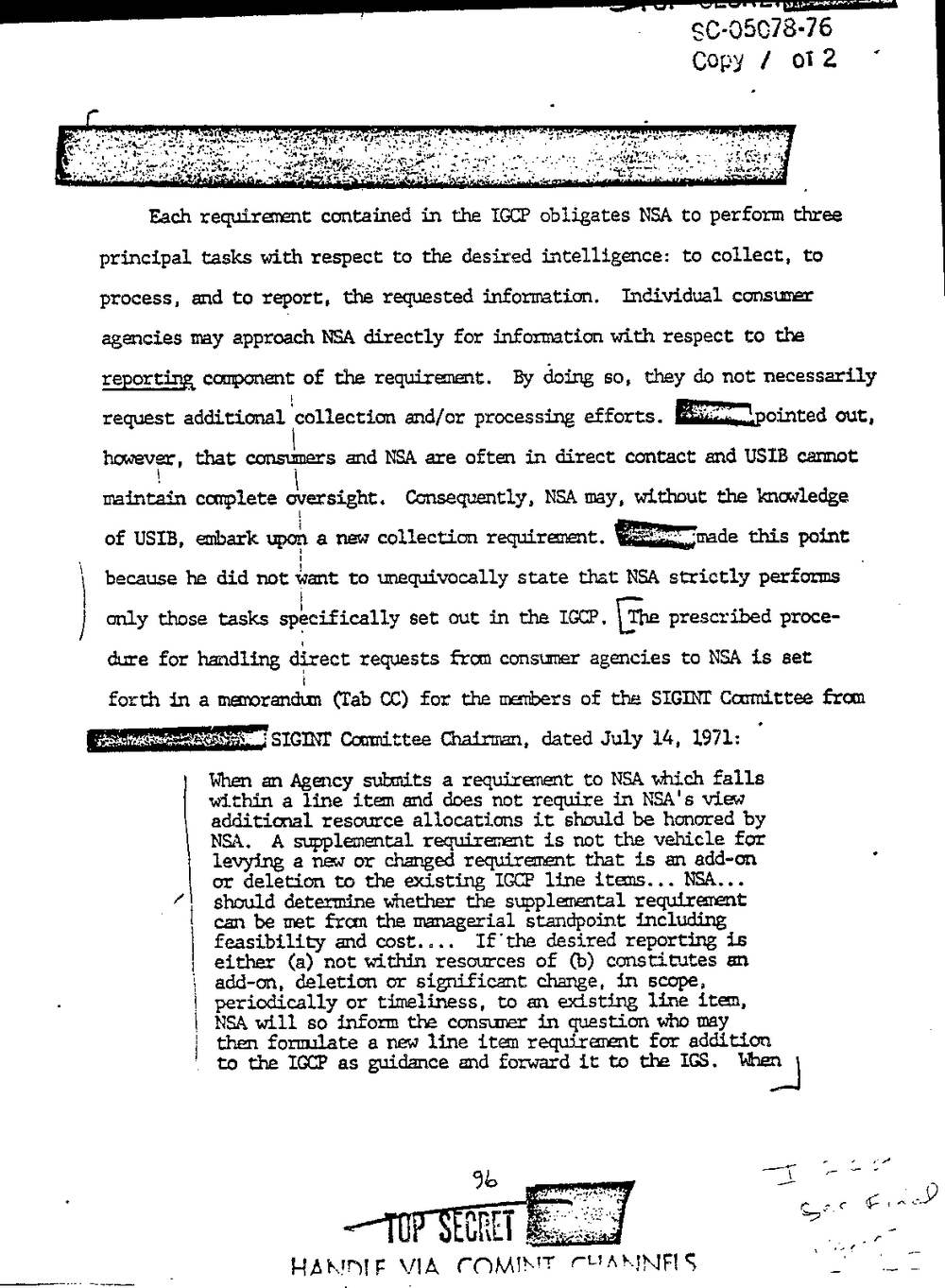
A 80-05078-76
012
Each requirement contained in the IGCP obligates NSA to perform three
principal tasks with respect to the desired intelligence: to collect, to
process, and to report. the requested infomation. Individual consumer
agencies may approach NSA directly for information with respect to the
. carponent of the requirement. By doing so, they do not necessarily
request additionalgcollection and/or processing efforts. mointed out.
however, that consumers and NSA are often in direct contact and USIB cannot
maintain oversight. Consequently, NSA may, without the knowledge
I
of USIB, embark a new collection requirazmt.
because he did not want to unequivocally state that NSA strictly performs
only those tasks spiecifically set out in the IGCP. Elie prescribed proce-
dure for handling direct requests from consumer agencies to NSA is set
forth in a (Tab CC) for the manbers of the Committee from
=3Icmr Comnittee Chairman, dated July 14, 1.971:
When an Agency submits a requirement to NSA which falls
within a line item md does not require in NSA's view
additional resource allocations it should be honored by
NSA. A supplemental requiresmt is not the vehicle for
levying a new or changed requirement that is an add-on
or deletion to the existing IGCP line itans.. .
should determine whether the supple-nli requirement
can be met the managerial standpoint including
feasibility and cost. . . . If'the desired reporting is
either not within resources of constitutes an
add-on, deletion or significant change, in scope,
periodically or timeliness, to an estting line item,
NSA will so inform the consuner in question who may
then formulate a new line item requiranent for addition
to the IGCP as guidance and forward it to the 168. When-J
A
A 80-05078-76
012
Each requirement contained in the IGCP obligates NSA to perform three
principal tasks with respect to the desired intelligence: to collect, to
process, and to report. the requested infomation. Individual consumer
agencies may approach NSA directly for information with respect to the
. carponent of the requirement. By doing so, they do not necessarily
request additionalgcollection and/or processing efforts. mointed out.
however, that consumers and NSA are often in direct contact and USIB cannot
maintain oversight. Consequently, NSA may, without the knowledge
I
of USIB, embark a new collection requirazmt.
because he did not want to unequivocally state that NSA strictly performs
only those tasks spiecifically set out in the IGCP. Elie prescribed proce-
dure for handling direct requests from consumer agencies to NSA is set
forth in a (Tab CC) for the manbers of the Committee from
=3Icmr Comnittee Chairman, dated July 14, 1.971:
When an Agency submits a requirement to NSA which falls
within a line item md does not require in NSA's view
additional resource allocations it should be honored by
NSA. A supplemental requiresmt is not the vehicle for
levying a new or changed requirement that is an add-on
or deletion to the existing IGCP line itans.. .
should determine whether the supple-nli requirement
can be met the managerial standpoint including
feasibility and cost. . . . If'the desired reporting is
either not within resources of constitutes an
add-on, deletion or significant change, in scope,
periodically or timeliness, to an estting line item,
NSA will so inform the consuner in question who may
then formulate a new line item requiranent for addition
to the IGCP as guidance and forward it to the 168. When-J
A
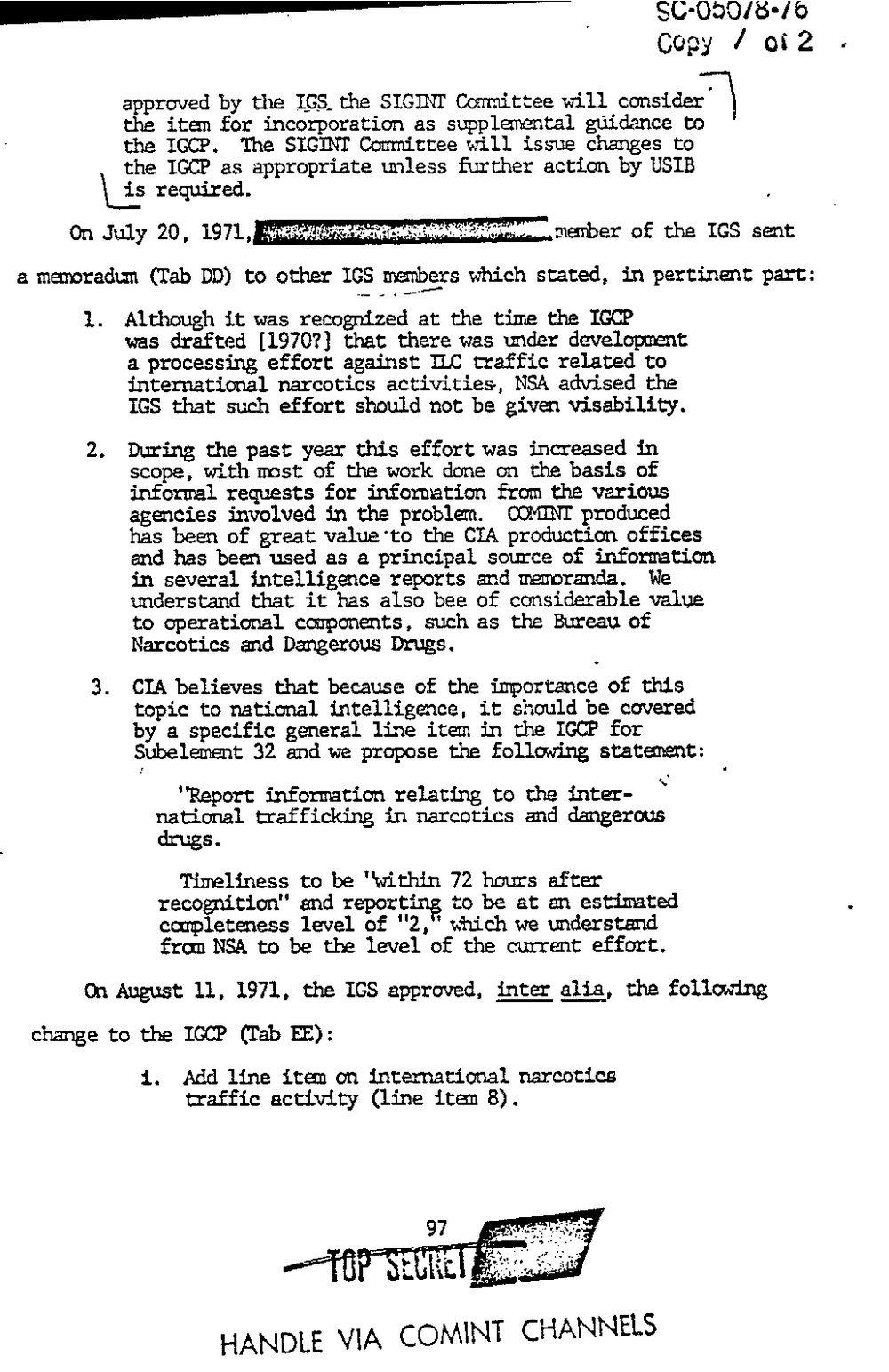
. 80-05018-16
COpy 0:2 -
approved by the 195. the SIGINT Committee will consider.
the item for incorporation as supplemental guidance to
the IGCP. The Committee will issue changes to
the IGCP as appropriate unless further action by USIB
is required.
On July 20, 1971. -
manber of the IGS sent
a memoradun (Tab DD) to other IGS which stated, in pertinent part:
1. Although it was recognized at the time the
was drafted [1970?] that there was under development
a processing effort against traffic related to
international narcotics activities. NSA advised the
IGS that such effort should not be given visability.
2. During the past year this effort was increased in
scope, with most of the work done on the basis of
informal requests for information from the various
agencies involved in the problem. com produced
has been of great value?to the CIA production offices
and has been used as a principal source of information
in several intelligence reports and moranda. We
understand that it has also bee of considerable value
to operational components, such as the Bureau of
Narcotics md Dangerous Drugs.
3. CIA believes that because of the importance of this
topic to national intelligence, it should be covered
by a specific general line item in the IGCP for
Subelemait 32 and we propose the following statement:
"Report information relating to the inter-
national trafficking in narcotics and dangerous
drugs.
Timeliness to be "within 72 hours after
recognition" and reporting to be at an estimated
completeness level of which we mderstand
NSA to be the level of the current effort.
On August 11. 1971, the IGS approved, inter alia, the follcming
change to the IGCP (Tab EE):
1. Add line item on international narcotics
traffic activity (line item 8) .
HANDLE VIA COMINT CHANNELS
. 80-05018-16
COpy 0:2 -
approved by the 195. the SIGINT Committee will consider.
the item for incorporation as supplemental guidance to
the IGCP. The Committee will issue changes to
the IGCP as appropriate unless further action by USIB
is required.
On July 20, 1971. -
manber of the IGS sent
a memoradun (Tab DD) to other IGS which stated, in pertinent part:
1. Although it was recognized at the time the
was drafted [1970?] that there was under development
a processing effort against traffic related to
international narcotics activities. NSA advised the
IGS that such effort should not be given visability.
2. During the past year this effort was increased in
scope, with most of the work done on the basis of
informal requests for information from the various
agencies involved in the problem. com produced
has been of great value?to the CIA production offices
and has been used as a principal source of information
in several intelligence reports and moranda. We
understand that it has also bee of considerable value
to operational components, such as the Bureau of
Narcotics md Dangerous Drugs.
3. CIA believes that because of the importance of this
topic to national intelligence, it should be covered
by a specific general line item in the IGCP for
Subelemait 32 and we propose the following statement:
"Report information relating to the inter-
national trafficking in narcotics and dangerous
drugs.
Timeliness to be "within 72 hours after
recognition" and reporting to be at an estimated
completeness level of which we mderstand
NSA to be the level of the current effort.
On August 11. 1971, the IGS approved, inter alia, the follcming
change to the IGCP (Tab EE):
1. Add line item on international narcotics
traffic activity (line item 8) .
HANDLE VIA COMINT CHANNELS
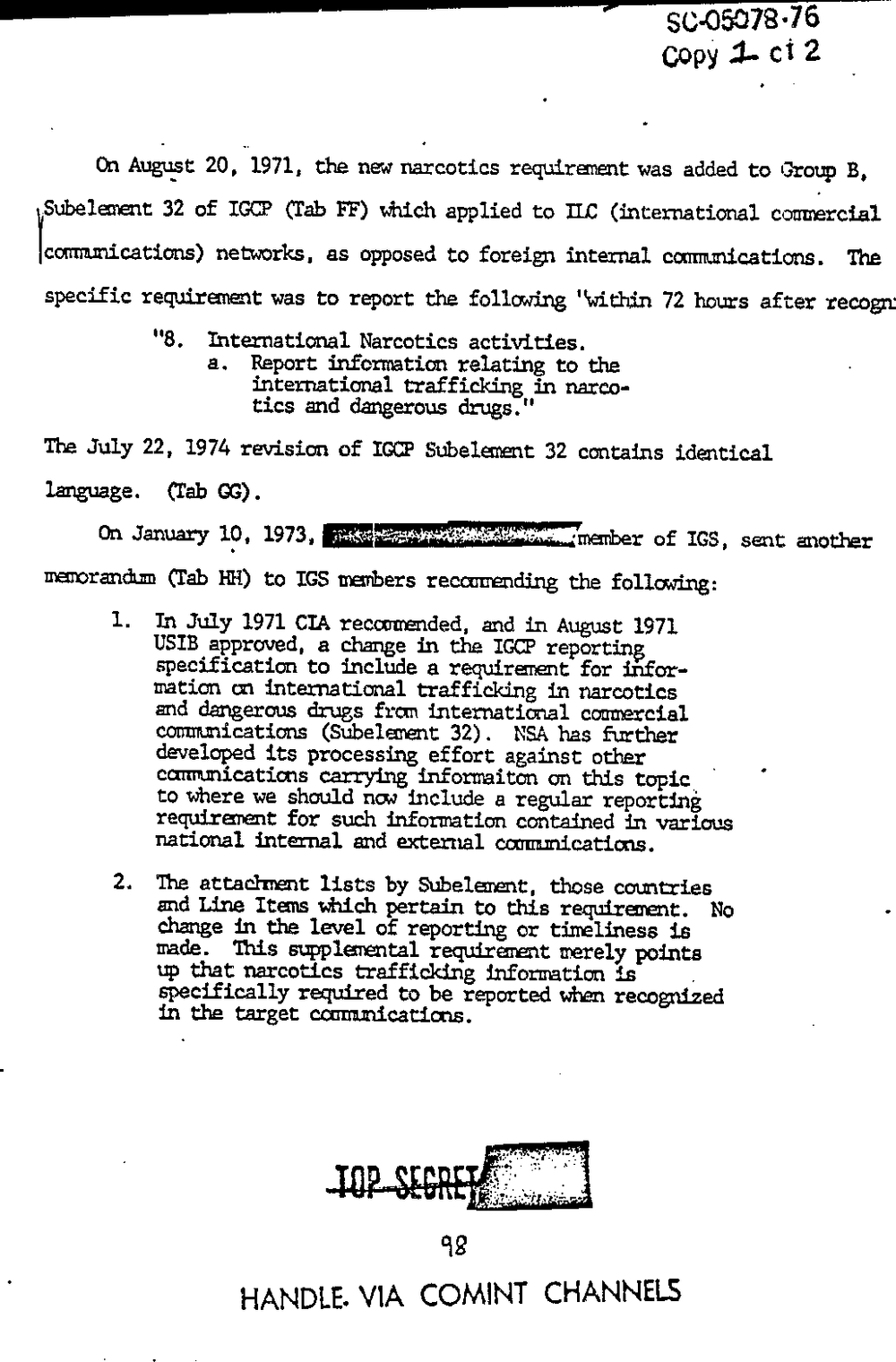
00993-612
On August 20,1971. the new narcotics requirement was added to Group B.
Subelement 32 of IGCP (Tab FF) which applied to no (international
networks, as opposed to foreig1 internal communications. The
specific requirement was to report the following "within 72 hours after recogn:
International Narcotics activities.
a. Report infcmation relating to the
international trafficking in narco-
tics and dangerous drugs."
The July 22, 1974 revision of IGCP Subelezrent 32 contains identical
language. (Tab GG) .
On January 19. 1973, 'member of IGS, sent another
(Tab HR) to IGS umwbers the following:
1. In July 1971 CIA recommended, and in August 1971
USIB approved, a change in the IGCP reporting
specification to include a requirement for infor-
mation on internadonal trafficking in narcotics
and dangerous drugs from international commercial
connmications (Subelemnt 32). NSA has further
developed its processing effort against other
conmmicatims carrying informaiton on this topic,
to where we should now include a regular reporting
requiranmt for such information contained in various
national internal and external connmications.
2. The attachnent lists by Subelement. those countries
and Line Items which pertain to this requirement. No
change in the level of reporting or timeliness is
made. This supplerental reqmenmt merely points
up that narcotics trafficking information is
specifically required to be reported Mien recognized
in the target coummicatims.
HANDLE. VIA COMINT CHANNELS
00993-612
On August 20,1971. the new narcotics requirement was added to Group B.
Subelement 32 of IGCP (Tab FF) which applied to no (international
networks, as opposed to foreig1 internal communications. The
specific requirement was to report the following "within 72 hours after recogn:
International Narcotics activities.
a. Report infcmation relating to the
international trafficking in narco-
tics and dangerous drugs."
The July 22, 1974 revision of IGCP Subelezrent 32 contains identical
language. (Tab GG) .
On January 19. 1973, 'member of IGS, sent another
(Tab HR) to IGS umwbers the following:
1. In July 1971 CIA recommended, and in August 1971
USIB approved, a change in the IGCP reporting
specification to include a requirement for infor-
mation on internadonal trafficking in narcotics
and dangerous drugs from international commercial
connmications (Subelemnt 32). NSA has further
developed its processing effort against other
conmmicatims carrying informaiton on this topic,
to where we should now include a regular reporting
requiranmt for such information contained in various
national internal and external connmications.
2. The attachnent lists by Subelement. those countries
and Line Items which pertain to this requirement. No
change in the level of reporting or timeliness is
made. This supplerental reqmenmt merely points
up that narcotics trafficking information is
specifically required to be reported Mien recognized
in the target coummicatims.
HANDLE. VIA COMINT CHANNELS
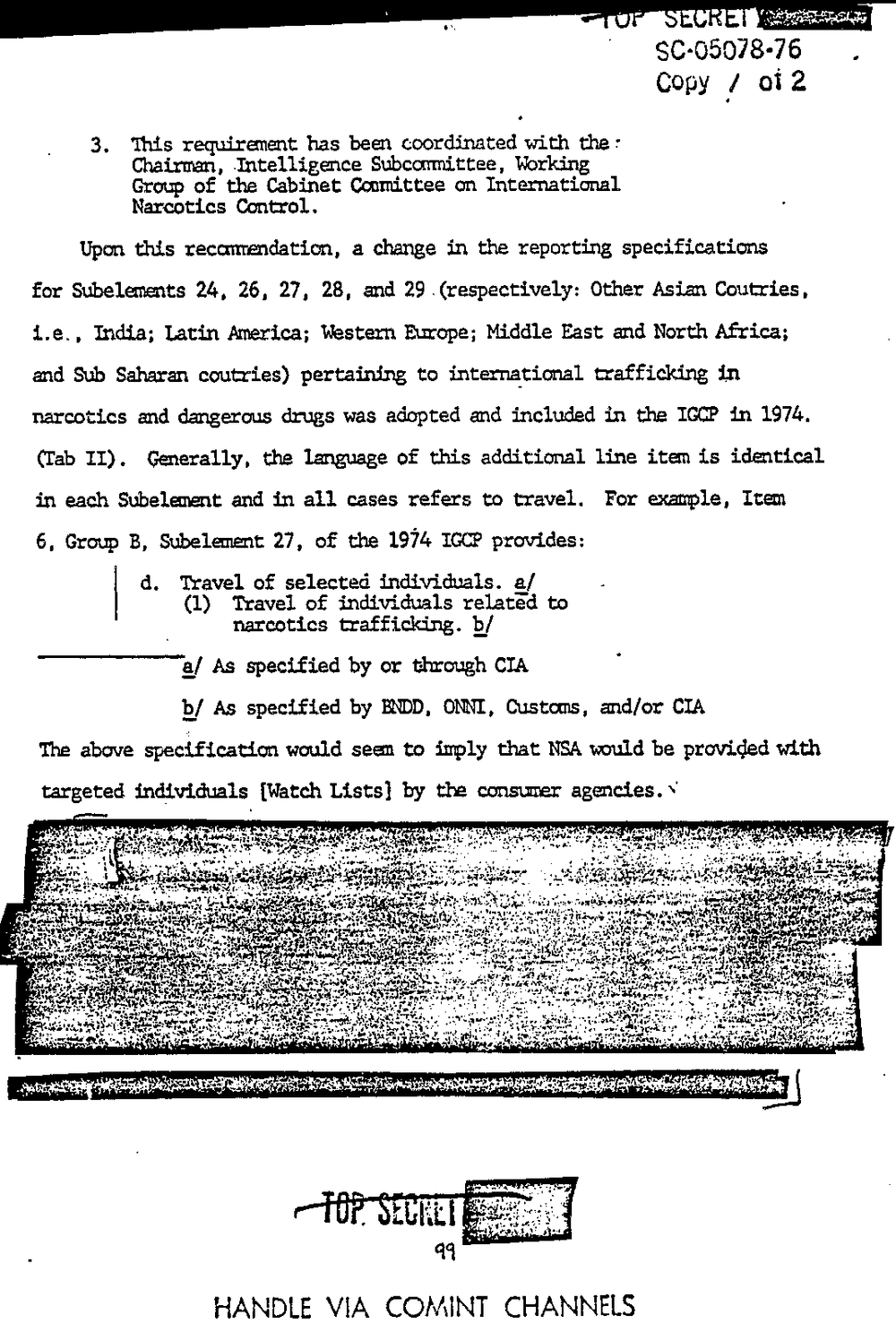
80-050786 .
Copy of 2
3. This requirenent has been coordinated with the .-
Chairman, Intelligence Subcorrmittee, Working
Group of the Cabinet Committee on International
Narcotics Control.
Upon this reccrmaendation, a change in the reporting specifications
for Subelemmts 24, 26, 27, 28, and 29 (respectively: Other Asian Coutries,
i.e. . India; Latin America; Western EuroPe; Middle East and North Africa;
and Sub Saharan coutr?ies) pertaining to international trafficking in
narcotics and dangerous drugs was adopted and included in the IGCP in 1974.
(Tab II) . Generally, the language of this additional line item is identical
in each Subelement and in all cases refers to travel. For example, Item
6. Group B, Subelement 27, of the 1974 IGCP provides:
d. Travel of selected individuals. 5/ .
(1) Travel of individuals related to
narcotics trafficking. bj
As specified by or through CIA
bl As specified by BNDD. ONNI. Customs, and/or CIA
The above specification would seem to imply that NSA would be provided with
targeted individuals [Watch Lists] by the consumer agencies.
. a, ,7
131'?
a
0.. . i
33.5- E??I?hv'37? ?1.9 4.
- we ?an- . w-
. ems?? Hygiene
?waif-bra
L. 34 Err-1-
T. ?Hz;
In?
..
wt? .
3- My?:
.u i" (it,
2.
I.
run-AI",
3- aqua-f
I 533113HANDLE VIA COMINT CHANNELS
80-050786 .
Copy of 2
3. This requirenent has been coordinated with the .-
Chairman, Intelligence Subcorrmittee, Working
Group of the Cabinet Committee on International
Narcotics Control.
Upon this reccrmaendation, a change in the reporting specifications
for Subelemmts 24, 26, 27, 28, and 29 (respectively: Other Asian Coutries,
i.e. . India; Latin America; Western EuroPe; Middle East and North Africa;
and Sub Saharan coutr?ies) pertaining to international trafficking in
narcotics and dangerous drugs was adopted and included in the IGCP in 1974.
(Tab II) . Generally, the language of this additional line item is identical
in each Subelement and in all cases refers to travel. For example, Item
6. Group B, Subelement 27, of the 1974 IGCP provides:
d. Travel of selected individuals. 5/ .
(1) Travel of individuals related to
narcotics trafficking. bj
As specified by or through CIA
bl As specified by BNDD. ONNI. Customs, and/or CIA
The above specification would seem to imply that NSA would be provided with
targeted individuals [Watch Lists] by the consumer agencies.
. a, ,7
131'?
a
0.. . i
33.5- E??I?hv'37? ?1.9 4.
- we ?an- . w-
. ems?? Hygiene
?waif-bra
L. 34 Err-1-
T. ?Hz;
In?
..
wt? .
3- My?:
.u i" (it,
2.
I.
run-AI",
3- aqua-f
I 533113HANDLE VIA COMINT CHANNELS
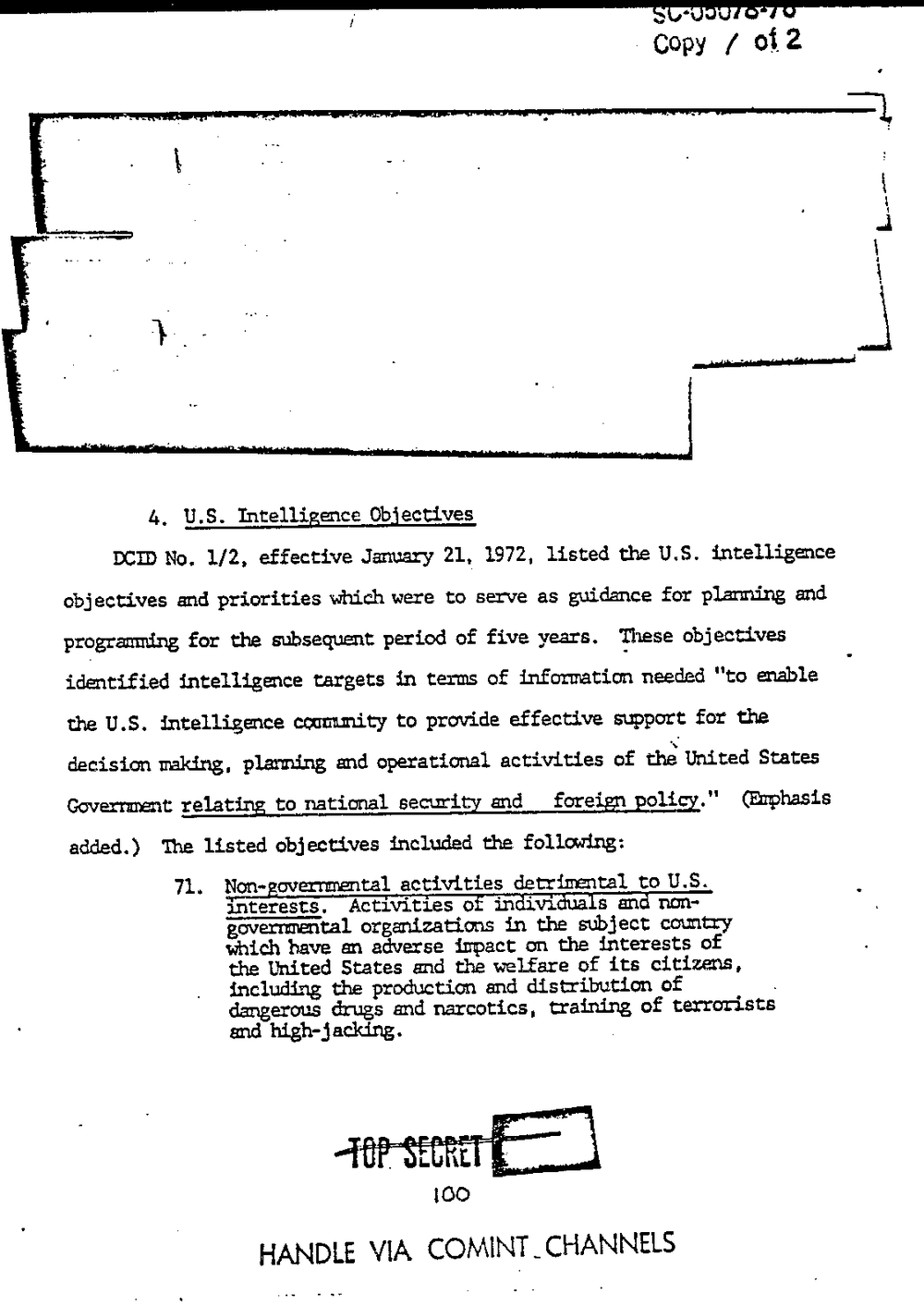
7 Bow 012
4. U.S. Intelligence Objectives
DCID No. 1/2. effective January 21,_ 1972. listed the U.S. intelligence
objectives and priorities mich were to serve as guidance for plaI-n-?ng and
for the subsequmt period of five years. lhese objectives
identified intelligence targets in terms of information needed "to enable
the U.S. intelligence coummity to provide effective support for the
decision making, plaming and operational activities of United States
Government relating to national security and foreign policy." (ElphaSiS
added.) The listed objectives included the following:
71. Non- overrmtal activities detrinmtal to U.S.
interests. Activities 0 in ?v1. 5 an non-
govermental organizations in the subject country
which have an adverse inpact on the interests of
the United States and the welfare of its citizens,
including the production and distribution of .
dangerous drugs and narcotics. training of terrorists
and high-jacking. .
of
HANDLE VIA
7 Bow 012
4. U.S. Intelligence Objectives
DCID No. 1/2. effective January 21,_ 1972. listed the U.S. intelligence
objectives and priorities mich were to serve as guidance for plaI-n-?ng and
for the subsequmt period of five years. lhese objectives
identified intelligence targets in terms of information needed "to enable
the U.S. intelligence coummity to provide effective support for the
decision making, plaming and operational activities of United States
Government relating to national security and foreign policy." (ElphaSiS
added.) The listed objectives included the following:
71. Non- overrmtal activities detrinmtal to U.S.
interests. Activities 0 in ?v1. 5 an non-
govermental organizations in the subject country
which have an adverse inpact on the interests of
the United States and the welfare of its citizens,
including the production and distribution of .
dangerous drugs and narcotics. training of terrorists
and high-jacking. .
of
HANDLE VIA
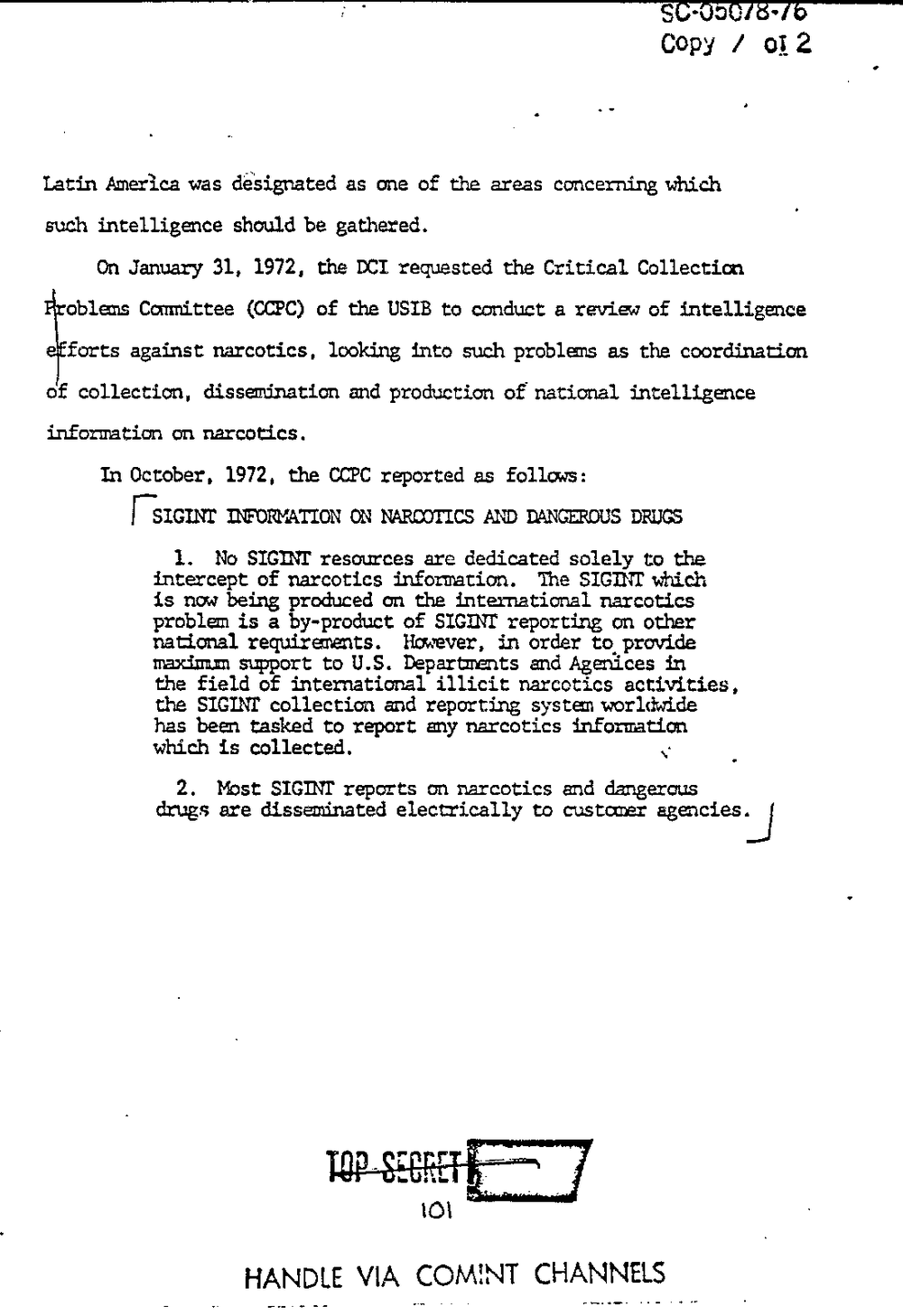
Copy 012
iatin America was d?Signated as one of the areas concerning which
such intelligence should be gathered.
On January 31, 1972. the DCI requested the Critical Collection
oblans Committee (CCPC) of the USIB to conduct a review of intelligence
forts against narcotics. looking into such problems as the coordination
of collection. dissemination and production of national intelligence
information on narcotics .
In October, 1972, the CCPC reported as follows:
MUWATION ON WES AND DANGEROUS DRUGS
1. No SIGINT resources are dedicated solely to the
intercept of narcotics information. The SIGINT which
is now being produced on the international narcotics
problem is a by-product of reporting on other
national requirements. However, in order to. provide
maxim support to U.S. Deparmments and Agenices in
the field of international illicit narcotics activities,
the collection and reporting system worldwide
has been tasked to report any narcotics information
which is collected.
2. Most reports on narcotics and dangerous
drugs are dissen?nated electrically to custcmer agenciesJ
HANDLE VIA COMENT CHANNELS
Copy 012
iatin America was d?Signated as one of the areas concerning which
such intelligence should be gathered.
On January 31, 1972. the DCI requested the Critical Collection
oblans Committee (CCPC) of the USIB to conduct a review of intelligence
forts against narcotics. looking into such problems as the coordination
of collection. dissemination and production of national intelligence
information on narcotics .
In October, 1972, the CCPC reported as follows:
MUWATION ON WES AND DANGEROUS DRUGS
1. No SIGINT resources are dedicated solely to the
intercept of narcotics information. The SIGINT which
is now being produced on the international narcotics
problem is a by-product of reporting on other
national requirements. However, in order to. provide
maxim support to U.S. Deparmments and Agenices in
the field of international illicit narcotics activities,
the collection and reporting system worldwide
has been tasked to report any narcotics information
which is collected.
2. Most reports on narcotics and dangerous
drugs are dissen?nated electrically to custcmer agenciesJ
HANDLE VIA COMENT CHANNELS
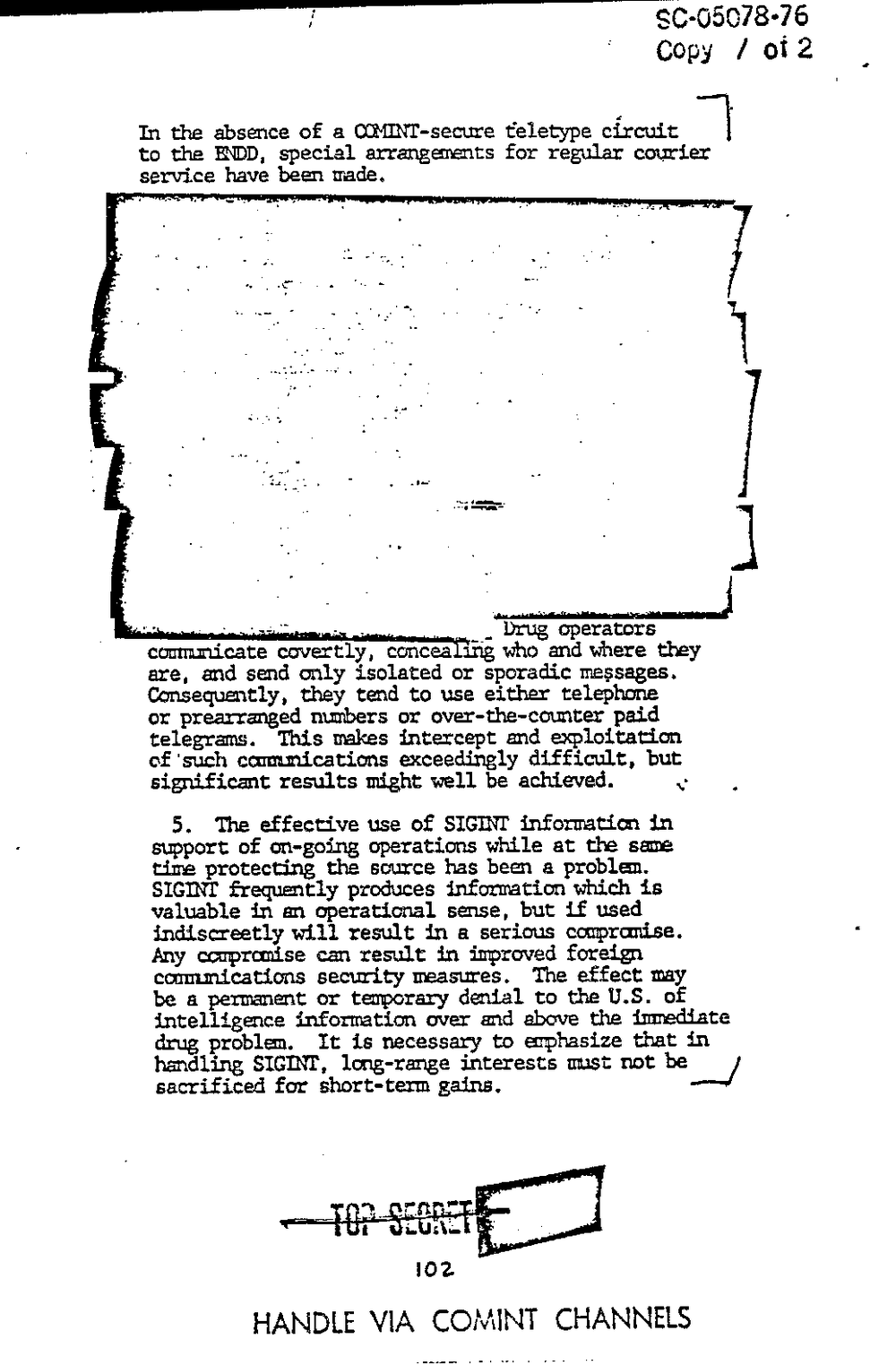
spasms-76
COpy 0:2
In the absence of a dim-same t?eletype cirmiit 7
to the special arrangenmts for regular courier
service have been made.
.-
- - - . Drug operators
coununicate covertly, concea mg who and where they
are. and send only isolated or sporadic messages.
Consequently, they tend to use either telephone
or prearranged numbers or over-the-counter paid
telegrams. This makes intercept and eJ-qaloitation
of 'such ccummications exceedingly difficult, but
significant results might well be achieved.
5. The effective use of SIGINT information in
support of on-going operations while at the sane
time protecting the source has been a problem.
frequently produces information which is
valuable in an operational sense, but if used
indiscreetly will result in a serious
Any compromise can result in iaproved foreign
coummications security measures. The effect may
be a pernment or temporary denial to the U.S. of
intelligence information over and above the immediate
drug problem. It is necessary to emphasize that in
handling SIGN, lmg-range interests mast not be I
sacrificed for short-term gains.
HANDLE VIA COMINT CHANNELS
.-
spasms-76
COpy 0:2
In the absence of a dim-same t?eletype cirmiit 7
to the special arrangenmts for regular courier
service have been made.
.-
- - - . Drug operators
coununicate covertly, concea mg who and where they
are. and send only isolated or sporadic messages.
Consequently, they tend to use either telephone
or prearranged numbers or over-the-counter paid
telegrams. This makes intercept and eJ-qaloitation
of 'such ccummications exceedingly difficult, but
significant results might well be achieved.
5. The effective use of SIGINT information in
support of on-going operations while at the sane
time protecting the source has been a problem.
frequently produces information which is
valuable in an operational sense, but if used
indiscreetly will result in a serious
Any compromise can result in iaproved foreign
coummications security measures. The effect may
be a pernment or temporary denial to the U.S. of
intelligence information over and above the immediate
drug problem. It is necessary to emphasize that in
handling SIGN, lmg-range interests mast not be I
sacrificed for short-term gains.
HANDLE VIA COMINT CHANNELS
.-
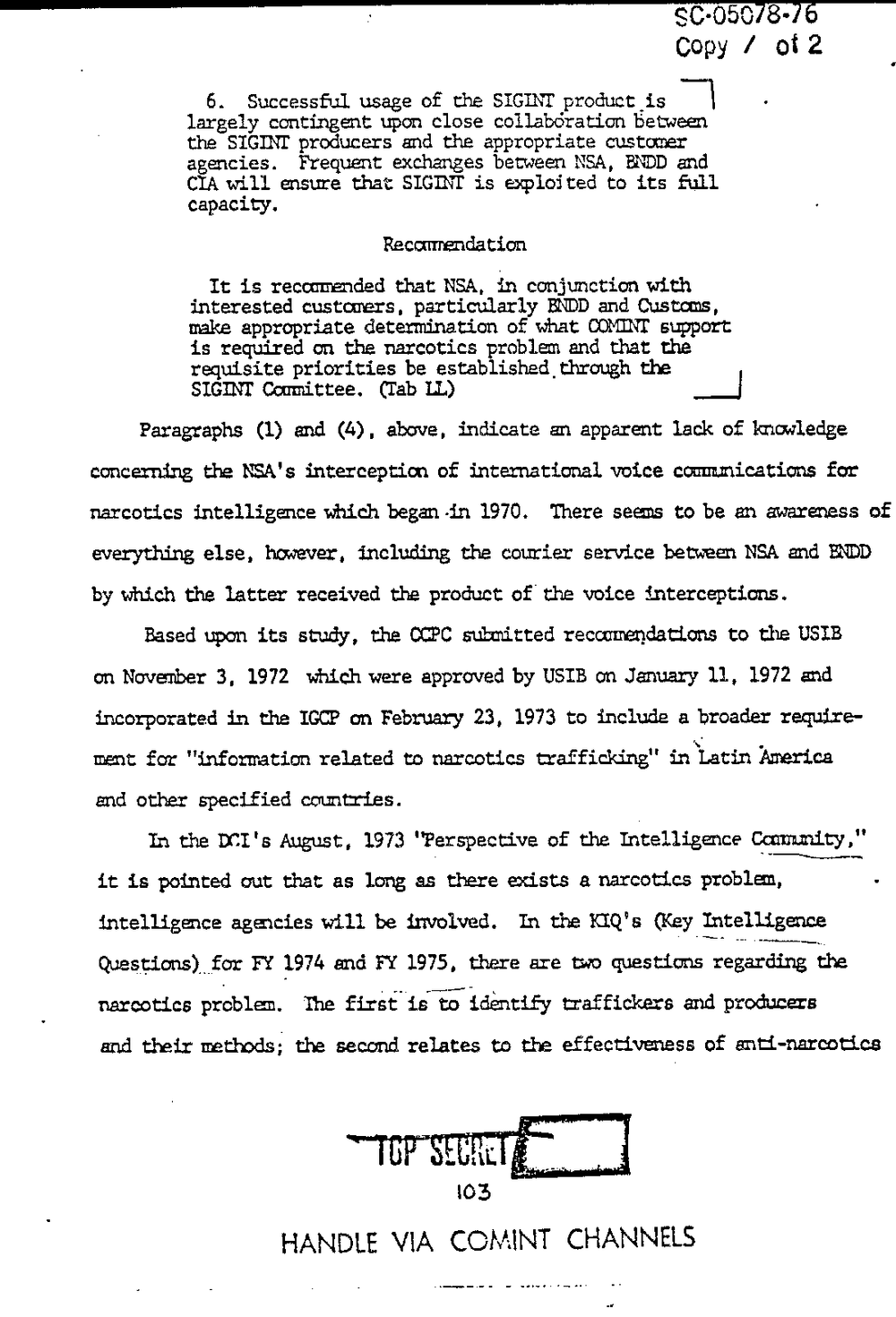
COpy of 2
6. Successful usage of the product_is
largely contingent upon close collaboration between
the producers and the appropriate customer
agencies. Frequent exchanges between NSA, BNDD and
CIA will ensure that is exploited to its full
capacity.
I
It is recommended that NSA. in conjunction with
interested customers. particularly BNDD and Customs,
make determination of what support
is required on the narcotics problem and that the
requisite priorities be establishedthrough the
310m Coomittee. (Tab
Paragraphs (1) and (4) above, indicate an apparent lack of knowledge
concendng the NSA's interception of international voice cormmications for
narcotics intelligence which began -in 1970. There seems to be an awareness of
everything else, however. including the courier service between NBA and BNDD
by which the latter received the product of the voice interceptions.
Based upon its study, the OCPC submitted reccomendations to the USIB
on November 3, 1972 which were approved by USIB on January 11, 1972 and
incorporated in the IGCP on February 23. 1973 to include a broader require-
ment for "information related to narcotics inl?latin America
and other specified mtries.
In the 1111's August. 1973 "Perspective of the Intelligence anmmity,"
it is pointed out that as long as there exists a narcotics problem,
intelligence agencies will be imolved. In the IGQ's (Refintelligence
n: i974 and n: 1975, there are two questions meeting?the
narcotics problem. firsthisfto?identify traffickers and producers
and their methods the second relates to the effectiveness of anti-narcotics
HANDLE VIA COMINT CHANNELS
-
COpy of 2
6. Successful usage of the product_is
largely contingent upon close collaboration between
the producers and the appropriate customer
agencies. Frequent exchanges between NSA, BNDD and
CIA will ensure that is exploited to its full
capacity.
I
It is recommended that NSA. in conjunction with
interested customers. particularly BNDD and Customs,
make determination of what support
is required on the narcotics problem and that the
requisite priorities be establishedthrough the
310m Coomittee. (Tab
Paragraphs (1) and (4) above, indicate an apparent lack of knowledge
concendng the NSA's interception of international voice cormmications for
narcotics intelligence which began -in 1970. There seems to be an awareness of
everything else, however. including the courier service between NBA and BNDD
by which the latter received the product of the voice interceptions.
Based upon its study, the OCPC submitted reccomendations to the USIB
on November 3, 1972 which were approved by USIB on January 11, 1972 and
incorporated in the IGCP on February 23. 1973 to include a broader require-
ment for "information related to narcotics inl?latin America
and other specified mtries.
In the 1111's August. 1973 "Perspective of the Intelligence anmmity,"
it is pointed out that as long as there exists a narcotics problem,
intelligence agencies will be imolved. In the IGQ's (Refintelligence
n: i974 and n: 1975, there are two questions meeting?the
narcotics problem. firsthisfto?identify traffickers and producers
and their methods the second relates to the effectiveness of anti-narcotics
HANDLE VIA COMINT CHANNELS
-
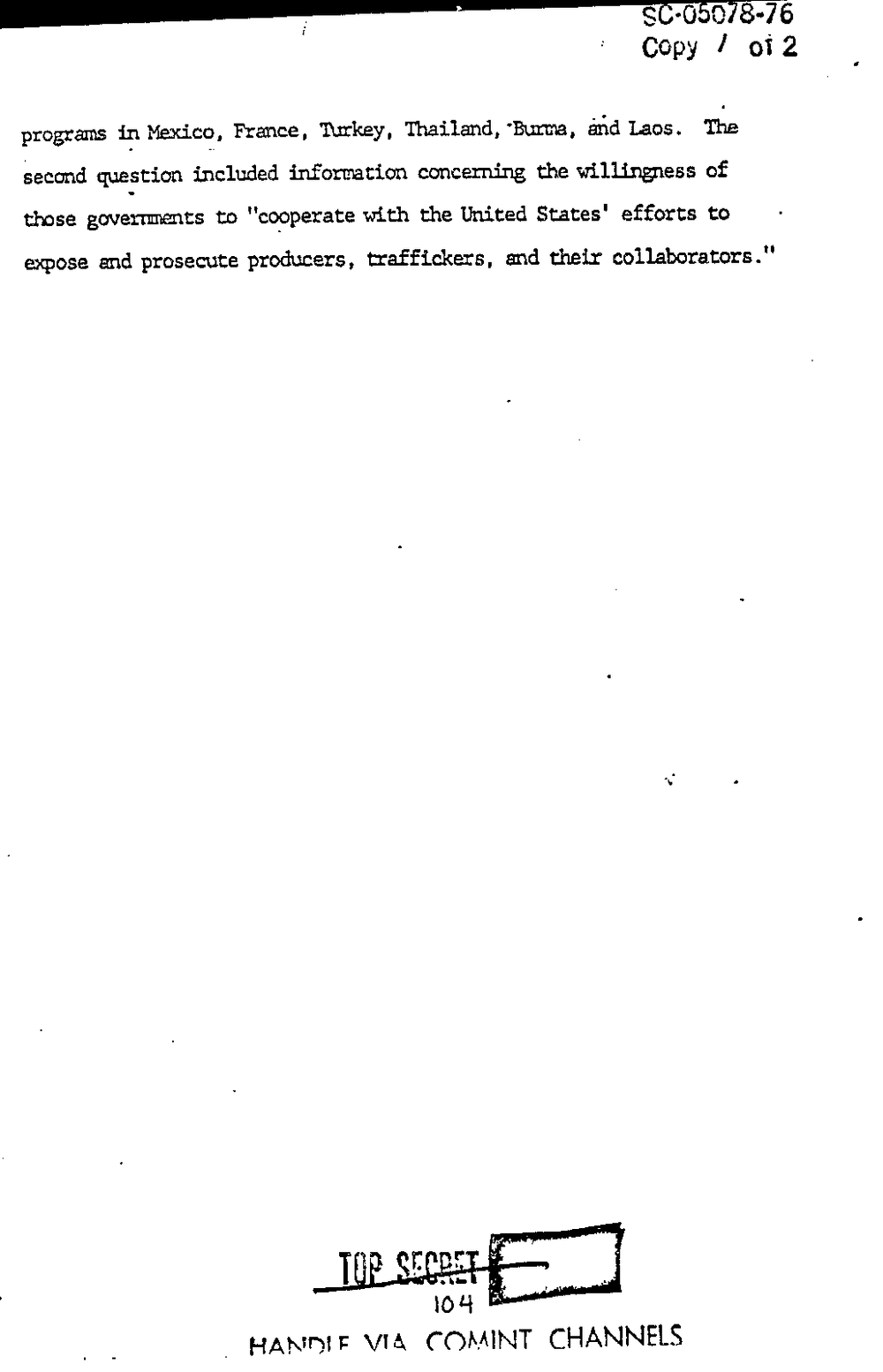
-0 0 8-76
Copy oi2
programs in Mexico, Framce, 'mrkey, Thailand, ?Burma, end Laos. The
becond question included information concerning the willingness of
those governments to "cooperate?with,the United States' effOrts to
expose and prosecute producers, traffickers, and their collaborators."
HANDIF VIA CHANNELS
-0 0 8-76
Copy oi2
programs in Mexico, Framce, 'mrkey, Thailand, ?Burma, end Laos. The
becond question included information concerning the willingness of
those governments to "cooperate?with,the United States' effOrts to
expose and prosecute producers, traffickers, and their collaborators."
HANDIF VIA CHANNELS
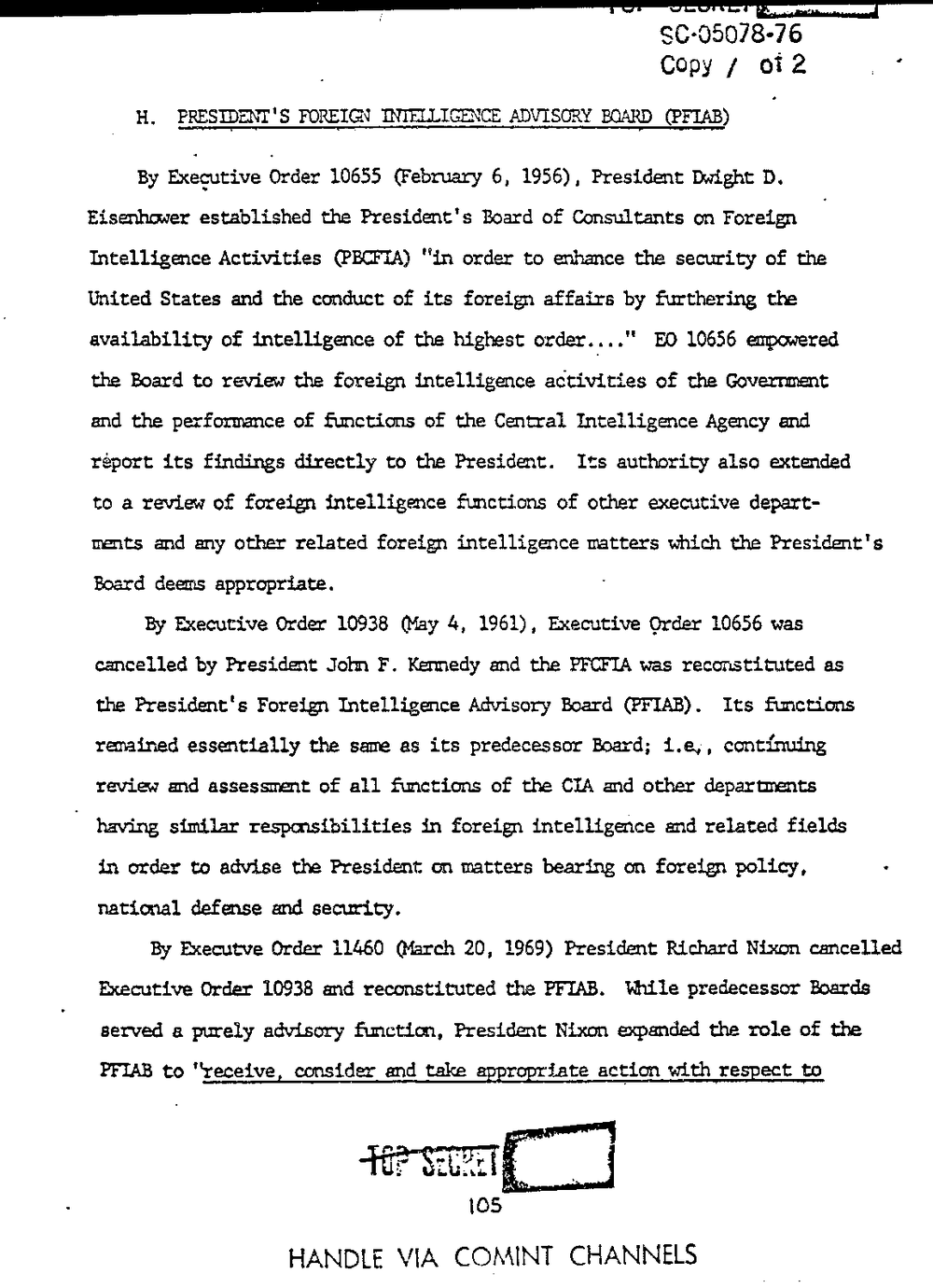
80-05078-76
COpy 01'2
H. FOREIGQ MIME: ADVISORY (PFIAB)
By Executive Order 10655 (February 6, 1956) . President Dwight D.
Eisenhower established the President's Board of Consultants on Foreign
Intelligence Activities (PBCFIA) "in order to enhance the security of the
United States and the conduct of its foreign affairs by furthering the
availability of intelligence of the highest . BO 10656 empowered
the Board to review the foreign intelligence activities of the Government
and the performance of ?znctions of the Central Intelligence Agency and
report its findings directly to the President. Its authority also extended
to a review of foreign intelligence functions of other executive depart-
ments and any other related foreign intelligence matters which the President's
Board deems appropriate.
By Executive Order 10938 (May 4, 1961), Executive Order 10656 was
cancelled by President John F. Remedy and the was reconstituted as
the President's Foreign Intelligence Advisory Board (PFIAB) . Its functions
retrained essentially the same as its predecessor Board; contirming
review and assessment of all functions of the CIA and other departments
having similar respansi?oilities in foreign intelligence and related fields
in order to advise the President on matters bearing on foreign policy,
national defense and security.
By Executve Order 11460 (March 20, 1969) President Richard Nixon cancelled
Executive Order 10938 and reconstituted the PFIAB. While predecessor Boards
served a purely advisory function, President Nixon expanded the role of the
PFIAB to ?receive, consider and take appropriate action withwrespect to
9-5? 5?
HANDLE VIA CHANNELS
80-05078-76
COpy 01'2
H. FOREIGQ MIME: ADVISORY (PFIAB)
By Executive Order 10655 (February 6, 1956) . President Dwight D.
Eisenhower established the President's Board of Consultants on Foreign
Intelligence Activities (PBCFIA) "in order to enhance the security of the
United States and the conduct of its foreign affairs by furthering the
availability of intelligence of the highest . BO 10656 empowered
the Board to review the foreign intelligence activities of the Government
and the performance of ?znctions of the Central Intelligence Agency and
report its findings directly to the President. Its authority also extended
to a review of foreign intelligence functions of other executive depart-
ments and any other related foreign intelligence matters which the President's
Board deems appropriate.
By Executive Order 10938 (May 4, 1961), Executive Order 10656 was
cancelled by President John F. Remedy and the was reconstituted as
the President's Foreign Intelligence Advisory Board (PFIAB) . Its functions
retrained essentially the same as its predecessor Board; contirming
review and assessment of all functions of the CIA and other departments
having similar respansi?oilities in foreign intelligence and related fields
in order to advise the President on matters bearing on foreign policy,
national defense and security.
By Executve Order 11460 (March 20, 1969) President Richard Nixon cancelled
Executive Order 10938 and reconstituted the PFIAB. While predecessor Boards
served a purely advisory function, President Nixon expanded the role of the
PFIAB to ?receive, consider and take appropriate action withwrespect to
9-5? 5?
HANDLE VIA CHANNELS
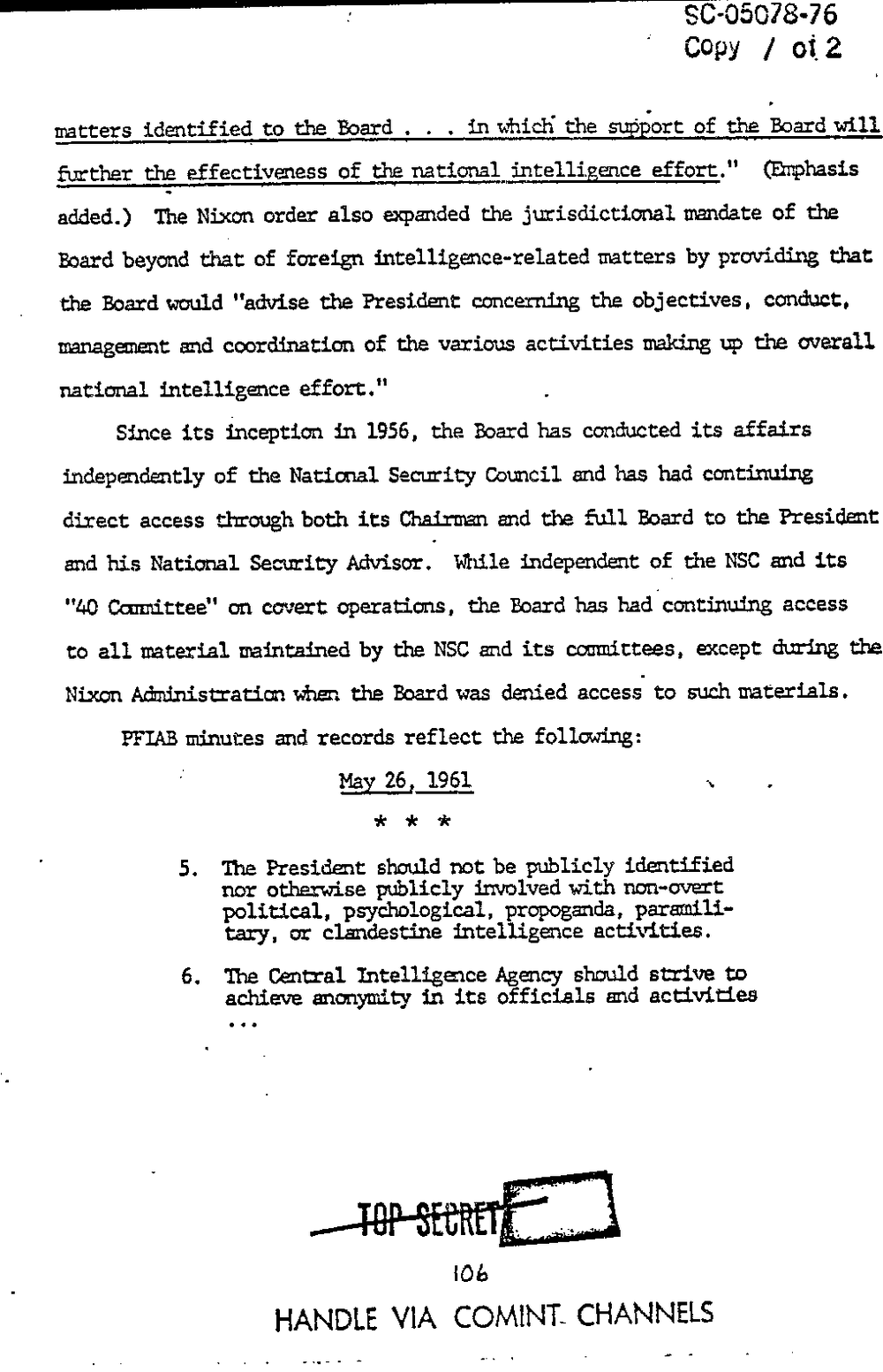
50-55078-76
Copy oi 2
matters identified to the Board . . . in which the support of the Board will
further the effectiveness of national intelligence effort." (Emphasis
added.) The Nixon order also expanded the jurisdictional mandate of the
Board beyond that of foreign intelligence-related matters by providing that
the Board would "advise the President concerning the objectives. conduct,
management and coordination of the various activities making up the overall
national intelligence effort."
Since its inception in 1956. the Board has conducted its affairs
independently of the National Security Council and has had contirming
direct access through both its Chairmm and the full Board to the President
and his National Security Advisor: While independent of the NSC and its
"1+0 Committee" on covert operations, the Board has had-continuing access
to all material maintained by the NSC and its committees, accept during the
Nixon Admnistration when the Board was denied access. to such materials.
PFIAB udnutes and records reflect the following:
My;
5. The President should not be publicly identified
nor othmise publicly involved with non-overt
political, propoganda, paramili-
tary, or clandestine intelligence activities.
6. The Central Intelligence Agency should strive to
achieve anonymity in its officials mid activities
lOb
HANDLE VIA COMINT. CHANNELS
.-
50-55078-76
Copy oi 2
matters identified to the Board . . . in which the support of the Board will
further the effectiveness of national intelligence effort." (Emphasis
added.) The Nixon order also expanded the jurisdictional mandate of the
Board beyond that of foreign intelligence-related matters by providing that
the Board would "advise the President concerning the objectives. conduct,
management and coordination of the various activities making up the overall
national intelligence effort."
Since its inception in 1956. the Board has conducted its affairs
independently of the National Security Council and has had contirming
direct access through both its Chairmm and the full Board to the President
and his National Security Advisor: While independent of the NSC and its
"1+0 Committee" on covert operations, the Board has had-continuing access
to all material maintained by the NSC and its committees, accept during the
Nixon Admnistration when the Board was denied access. to such materials.
PFIAB udnutes and records reflect the following:
My;
5. The President should not be publicly identified
nor othmise publicly involved with non-overt
political, propoganda, paramili-
tary, or clandestine intelligence activities.
6. The Central Intelligence Agency should strive to
achieve anonymity in its officials mid activities
lOb
HANDLE VIA COMINT. CHANNELS
.-
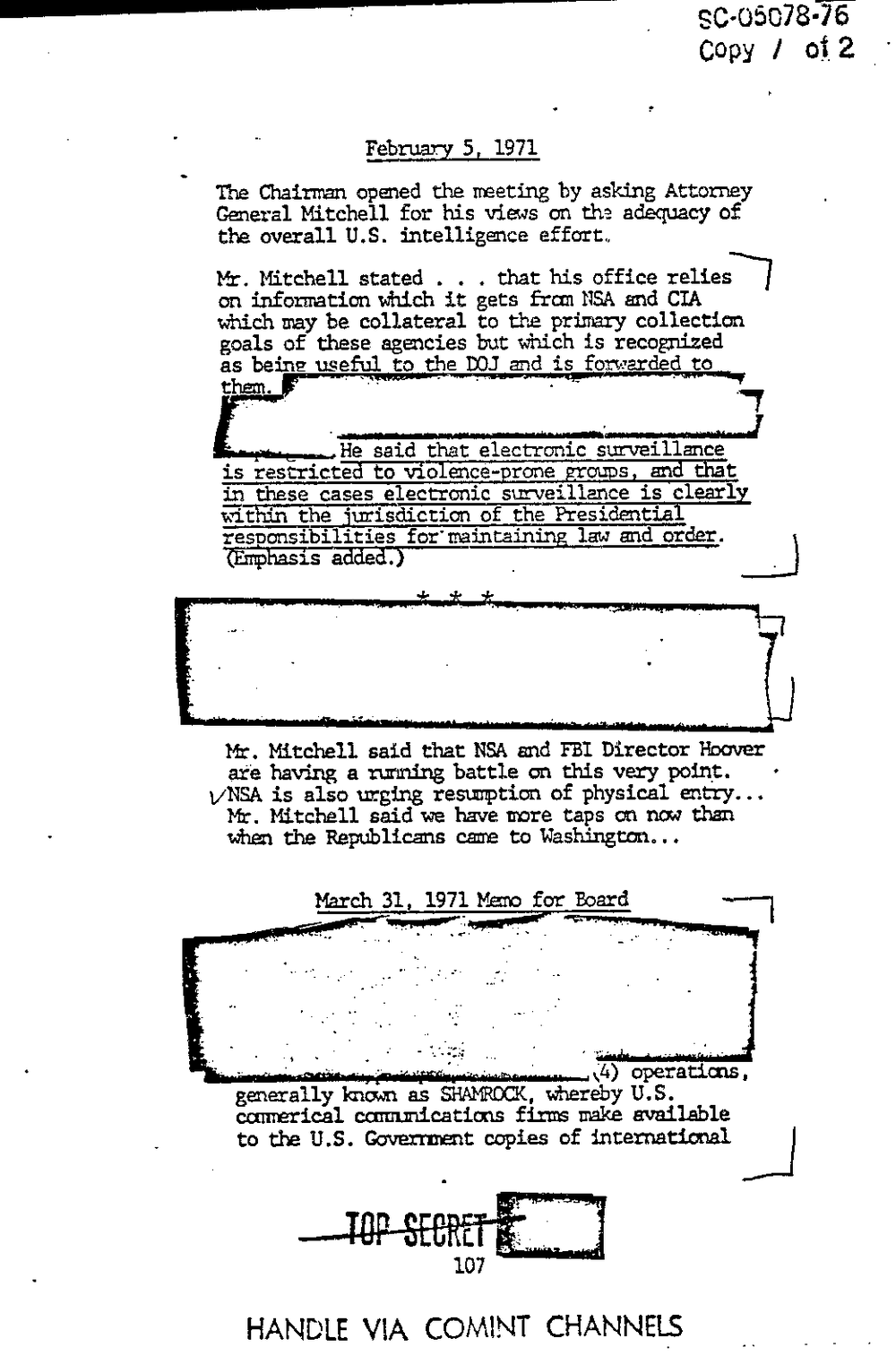
sic-0507857"?
Copy oiz
Febniary 5, 1971
The Chairman opened the meeting by asking Attorney
Gesneral Mitchell for his views on the adequacy of
the overall U.S. intelligence effort.
Mr. Mitchell stated . . . that his office relies?
on information which it gets ?rm NSA and CIA
which may be collateral to the primary collection
goals of these agencies but which is recognized
as beine use?? to the DOJ and is forwarded to
u?
He said that electronic surveillance
is restricted to violence-prone groups, and that
in these cases electronic surveillance is clearl
witff?' the iurisdiction of the Presidmtial
responsibilities for'mintaining law and order.
(Errphasis added.)
Mr. Mitchell said that NSA and FBI Director Hoover
are having a rmning battle on this very point.
VNSA is also urging resumption of physical entry. . .
Mr. Mitchell said we have mre taps on now than
men the Republicans came to Washington. . .
March 31. 197l Mano for Board
- - - - - operations.
generally known as W, whereby U.S.
comerical firms make available
to the U.S. Goverrnent copies of international
1!
r.
107
HANDLE COMINT CHANNELS
sic-0507857"?
Copy oiz
Febniary 5, 1971
The Chairman opened the meeting by asking Attorney
Gesneral Mitchell for his views on the adequacy of
the overall U.S. intelligence effort.
Mr. Mitchell stated . . . that his office relies?
on information which it gets ?rm NSA and CIA
which may be collateral to the primary collection
goals of these agencies but which is recognized
as beine use?? to the DOJ and is forwarded to
u?
He said that electronic surveillance
is restricted to violence-prone groups, and that
in these cases electronic surveillance is clearl
witff?' the iurisdiction of the Presidmtial
responsibilities for'mintaining law and order.
(Errphasis added.)
Mr. Mitchell said that NSA and FBI Director Hoover
are having a rmning battle on this very point.
VNSA is also urging resumption of physical entry. . .
Mr. Mitchell said we have mre taps on now than
men the Republicans came to Washington. . .
March 31. 197l Mano for Board
- - - - - operations.
generally known as W, whereby U.S.
comerical firms make available
to the U.S. Goverrnent copies of international
1!
r.
107
HANDLE COMINT CHANNELS
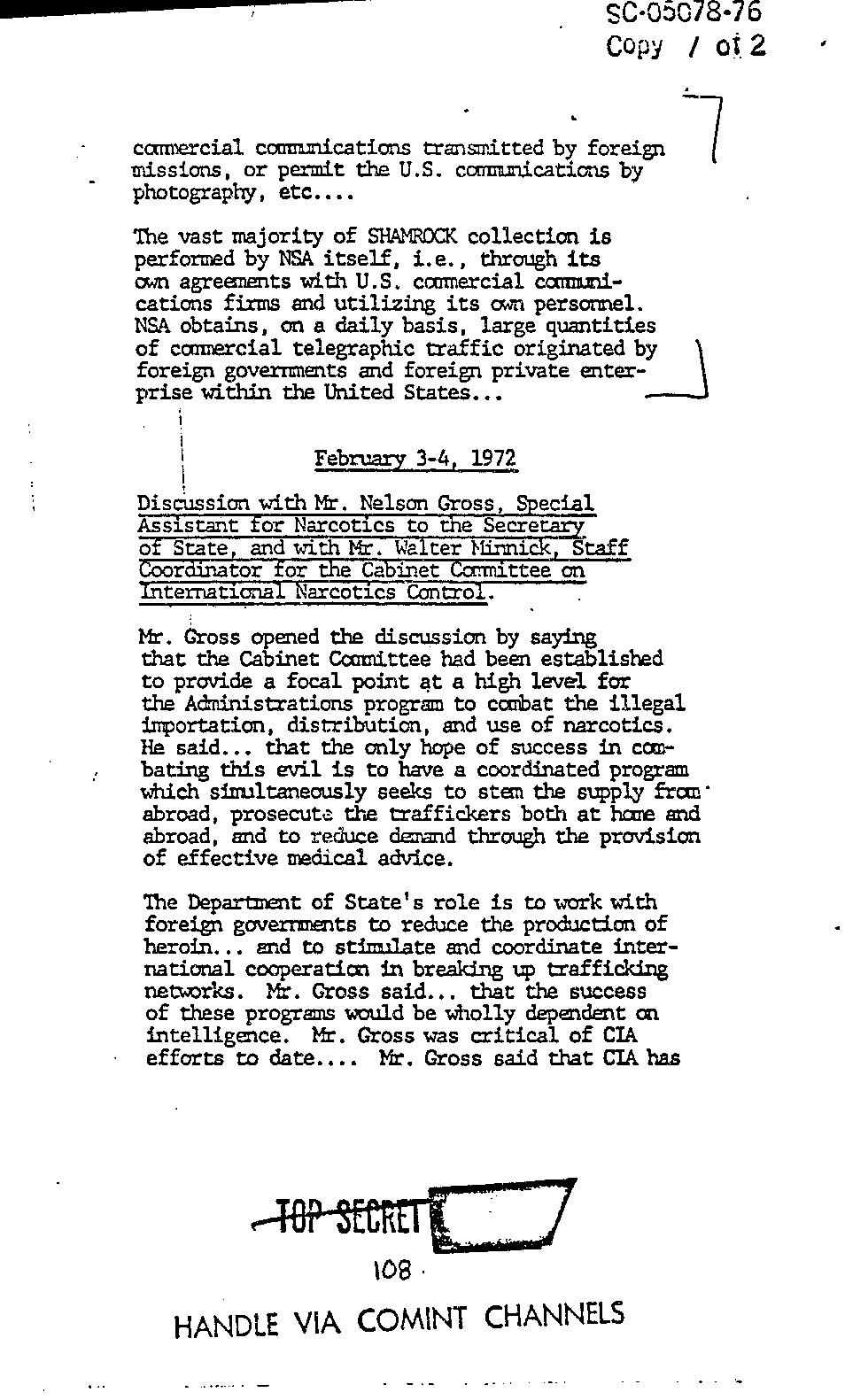
I SC-05078-76
Copy I at 2
commercial coummications transmitted by foreign 7
missions, or permit the U.S. communications by
photography, etc. . . .
?Ihe vast majority of SHAMROCK collection is
performed by NSA itself, i.e. through its
own agreements with U.S. commercial cotrmuni-
cations firms and utilizing its om persomel.
NSA obtains, an a daily basis, large quantities
of commercial telegraphic traffic originated by
foreign governments and foreign private enter-
prise within the United States. . .
i
1 February 3-4, 1972
Discussion with Mr. Nelson Gross, Special
Assistant for Narcotics to the Secretazgr
of State, and with Mr. Walter Minnich Staff
Coordinator for the Cabinet Carmittee on
International Narcotics Control.
Mr. Gross opened the discussion by saying
that the Cabinet Committee had been establisle
to provide a focal point at a high level for
the Administrations program to combat the illegal
importation, distribution, and use of narcotics.
He said. .. that the only hope of success in com-
bating this evil is to have a coordinated program
which simultaneously seeks to stem the supply from?
abroad, prosecute the traffickers both at home and
abroad, and to reduce demand through the provision
of effective medical advice.
The Deth of State's role is to work with
foreign to reduce the production of
heroin. . . and to stimulate and coordinate inter-
national cooperation in breaking up trafficking
networks. Mr. Gross that the success
of these programs would be wholly dependent on
intelligence. Mr. Gross was critical of CIA
efforts to . Mr. Gross said that CIA has
-
HANDLE VIA comm CHANNELS
I SC-05078-76
Copy I at 2
commercial coummications transmitted by foreign 7
missions, or permit the U.S. communications by
photography, etc. . . .
?Ihe vast majority of SHAMROCK collection is
performed by NSA itself, i.e. through its
own agreements with U.S. commercial cotrmuni-
cations firms and utilizing its om persomel.
NSA obtains, an a daily basis, large quantities
of commercial telegraphic traffic originated by
foreign governments and foreign private enter-
prise within the United States. . .
i
1 February 3-4, 1972
Discussion with Mr. Nelson Gross, Special
Assistant for Narcotics to the Secretazgr
of State, and with Mr. Walter Minnich Staff
Coordinator for the Cabinet Carmittee on
International Narcotics Control.
Mr. Gross opened the discussion by saying
that the Cabinet Committee had been establisle
to provide a focal point at a high level for
the Administrations program to combat the illegal
importation, distribution, and use of narcotics.
He said. .. that the only hope of success in com-
bating this evil is to have a coordinated program
which simultaneously seeks to stem the supply from?
abroad, prosecute the traffickers both at home and
abroad, and to reduce demand through the provision
of effective medical advice.
The Deth of State's role is to work with
foreign to reduce the production of
heroin. . . and to stimulate and coordinate inter-
national cooperation in breaking up trafficking
networks. Mr. Gross that the success
of these programs would be wholly dependent on
intelligence. Mr. Gross was critical of CIA
efforts to . Mr. Gross said that CIA has
-
HANDLE VIA comm CHANNELS
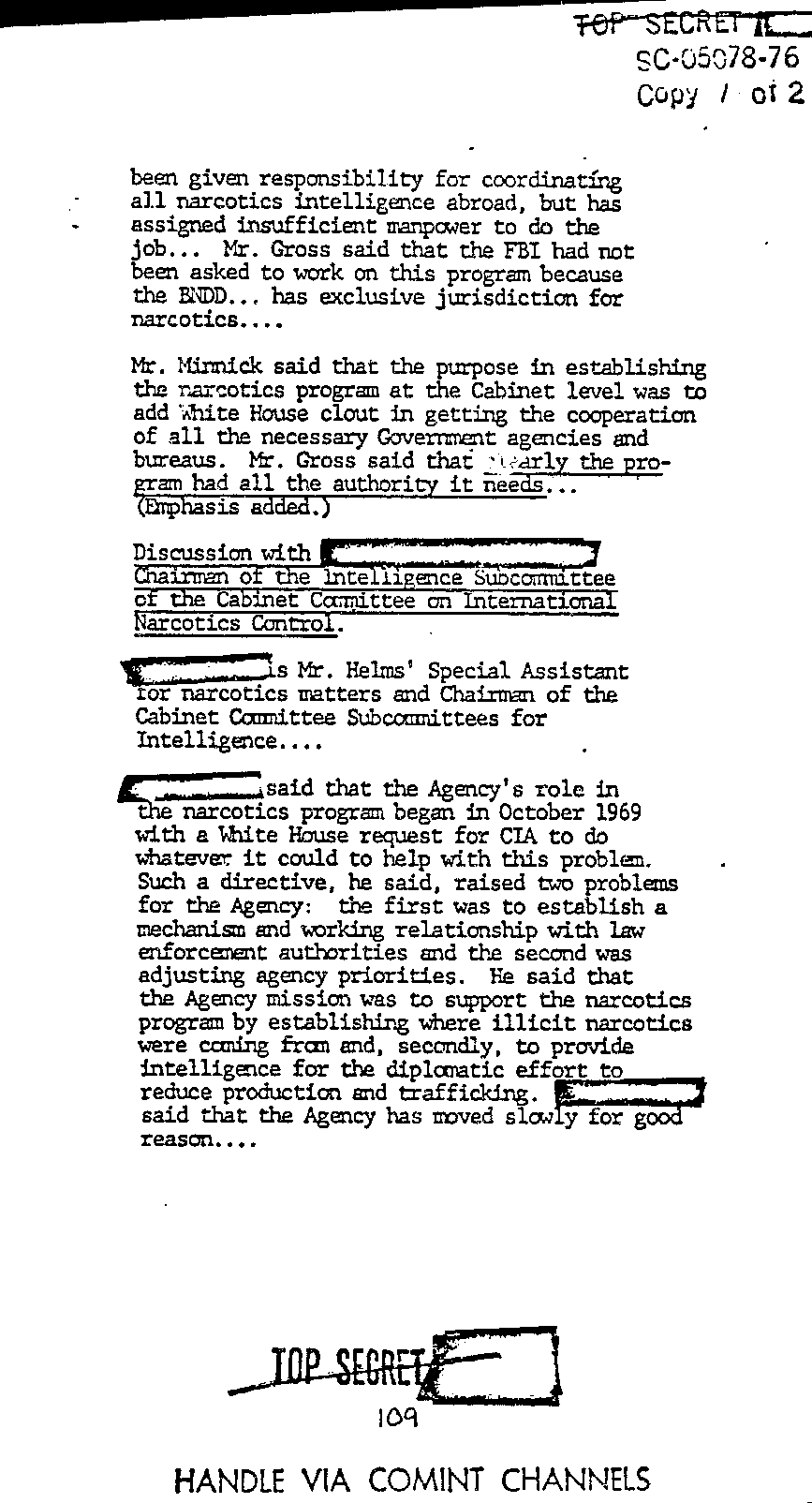
30.05078-76
COpy - of 2
besn given responsibility for coordinating
all narcotics intelligence abroad, but has
- assigned insufficient: manpower to do the
Mr. Gross said that the FBI had not
been asked to work on this program because
the . has exclusive jurisdiction for
narcotics. . . .
Mr. Minnick said that the purpose in establishing
the narcotics program at the Cabinet level was to
add ?nhite House clout in getting the cooperation
of all the necessary Goverment agencies and
bureaus. Mr. Gross said that L'Laarlz the pro-
gram had all the authority it nee
(Emphasis added.)
Discussion with .
Chairman of the Intelligence SubcomrTittee
of the Cabinet Cmmittee on International
Narcotics Control.
Mr. Helms" Special Assistant
or narcotics matters and Chem of the
Cabinet Committee Subcommittees for
Intelligence. . . .
I. said that the Agency's role in
narcotics program began in October 1969
with a l-hite House request for CIA to do
whatever it could to help with this problem.
Such a directive, he said, raised two problems
for the Agency: the first was to establish a
mechanism and working relationship with law
enforth autl'aorities and the second was
adjusting agency priorities. He said that
the Agency mission was to sUpport the narcotics
program by establishing where illicit narcotics
were coming from and. secondly, to provide
intelligaice for the diplomatic effort to
reduce production and trafficking.
said that the Agency has craved slow for
reason. . . .
HANDLE VIA COMINT CHANNELS
30.05078-76
COpy - of 2
besn given responsibility for coordinating
all narcotics intelligence abroad, but has
- assigned insufficient: manpower to do the
Mr. Gross said that the FBI had not
been asked to work on this program because
the . has exclusive jurisdiction for
narcotics. . . .
Mr. Minnick said that the purpose in establishing
the narcotics program at the Cabinet level was to
add ?nhite House clout in getting the cooperation
of all the necessary Goverment agencies and
bureaus. Mr. Gross said that L'Laarlz the pro-
gram had all the authority it nee
(Emphasis added.)
Discussion with .
Chairman of the Intelligence SubcomrTittee
of the Cabinet Cmmittee on International
Narcotics Control.
Mr. Helms" Special Assistant
or narcotics matters and Chem of the
Cabinet Committee Subcommittees for
Intelligence. . . .
I. said that the Agency's role in
narcotics program began in October 1969
with a l-hite House request for CIA to do
whatever it could to help with this problem.
Such a directive, he said, raised two problems
for the Agency: the first was to establish a
mechanism and working relationship with law
enforth autl'aorities and the second was
adjusting agency priorities. He said that
the Agency mission was to sUpport the narcotics
program by establishing where illicit narcotics
were coming from and. secondly, to provide
intelligaice for the diplomatic effort to
reduce production and trafficking.
said that the Agency has craved slow for
reason. . . .
HANDLE VIA COMINT CHANNELS
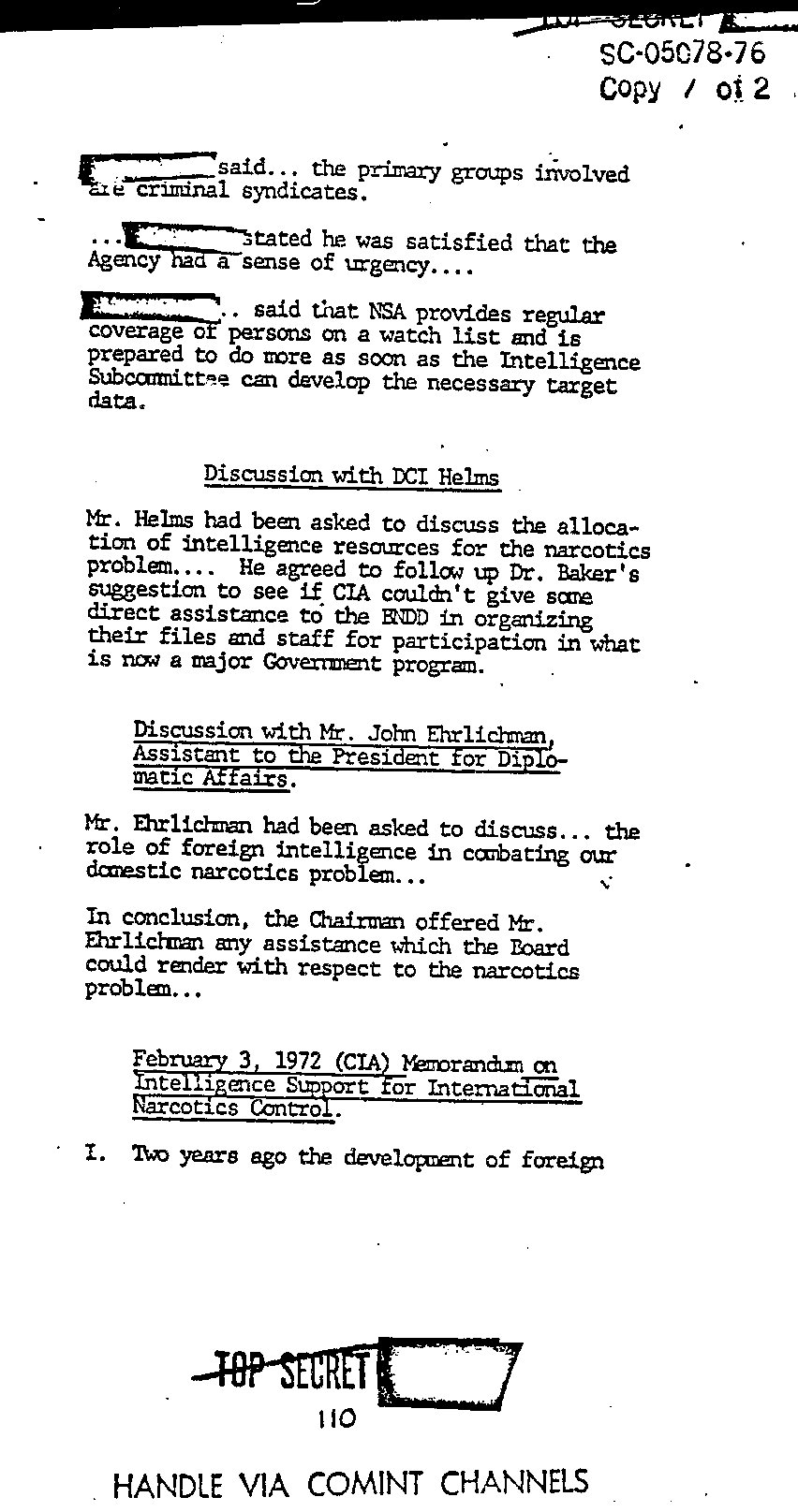
800507876
Copy oi 2
r. said. .. the primary groups involved
as criminal syndicates.
. . :?stated he was satisfied that the
Agency a sense of urgency. . . .
. said that NSA provides regular
coverage 0 persons on a watch list and is
prepared to do more as soon as the Intelligence
Submittee can develoP the necessary target
amt
Discussion with DCI Helms
Mr. Helms had been asked to discuss the alloca-
tion of intelligence resources for the narcotics
problem. . . . He agreed to follow up Dr. Baker's
suggestion to see ii CIA couldn't give some
direct assistance to the EDD in organizing
their files and staff for participation in what
is now a major Govermmt program.
Discussion with Mr. John Ehrlichman
to BE PresidEt for Di Io-
matic KEIair' 5.
Mr. had been asked to discuss. . . the
role of foreign intelligence in coohating our
domestic narcotics problem. . .
In conclusion, the Chairman offaed Mr.
Ehrliclmam any assistance which the Board
could render with respect to the narcotics
problan. . .
February 3, 1972 (CIA) Piesorandxm on
Intelligence SEEort for
arcotics Contro .
1. Two years ago the develoPmmt of foreigi
. HANDLE VIA COMINT CHANNELS
800507876
Copy oi 2
r. said. .. the primary groups involved
as criminal syndicates.
. . :?stated he was satisfied that the
Agency a sense of urgency. . . .
. said that NSA provides regular
coverage 0 persons on a watch list and is
prepared to do more as soon as the Intelligence
Submittee can develoP the necessary target
amt
Discussion with DCI Helms
Mr. Helms had been asked to discuss the alloca-
tion of intelligence resources for the narcotics
problem. . . . He agreed to follow up Dr. Baker's
suggestion to see ii CIA couldn't give some
direct assistance to the EDD in organizing
their files and staff for participation in what
is now a major Govermmt program.
Discussion with Mr. John Ehrlichman
to BE PresidEt for Di Io-
matic KEIair' 5.
Mr. had been asked to discuss. . . the
role of foreign intelligence in coohating our
domestic narcotics problem. . .
In conclusion, the Chairman offaed Mr.
Ehrliclmam any assistance which the Board
could render with respect to the narcotics
problan. . .
February 3, 1972 (CIA) Piesorandxm on
Intelligence SEEort for
arcotics Contro .
1. Two years ago the develoPmmt of foreigi
. HANDLE VIA COMINT CHANNELS
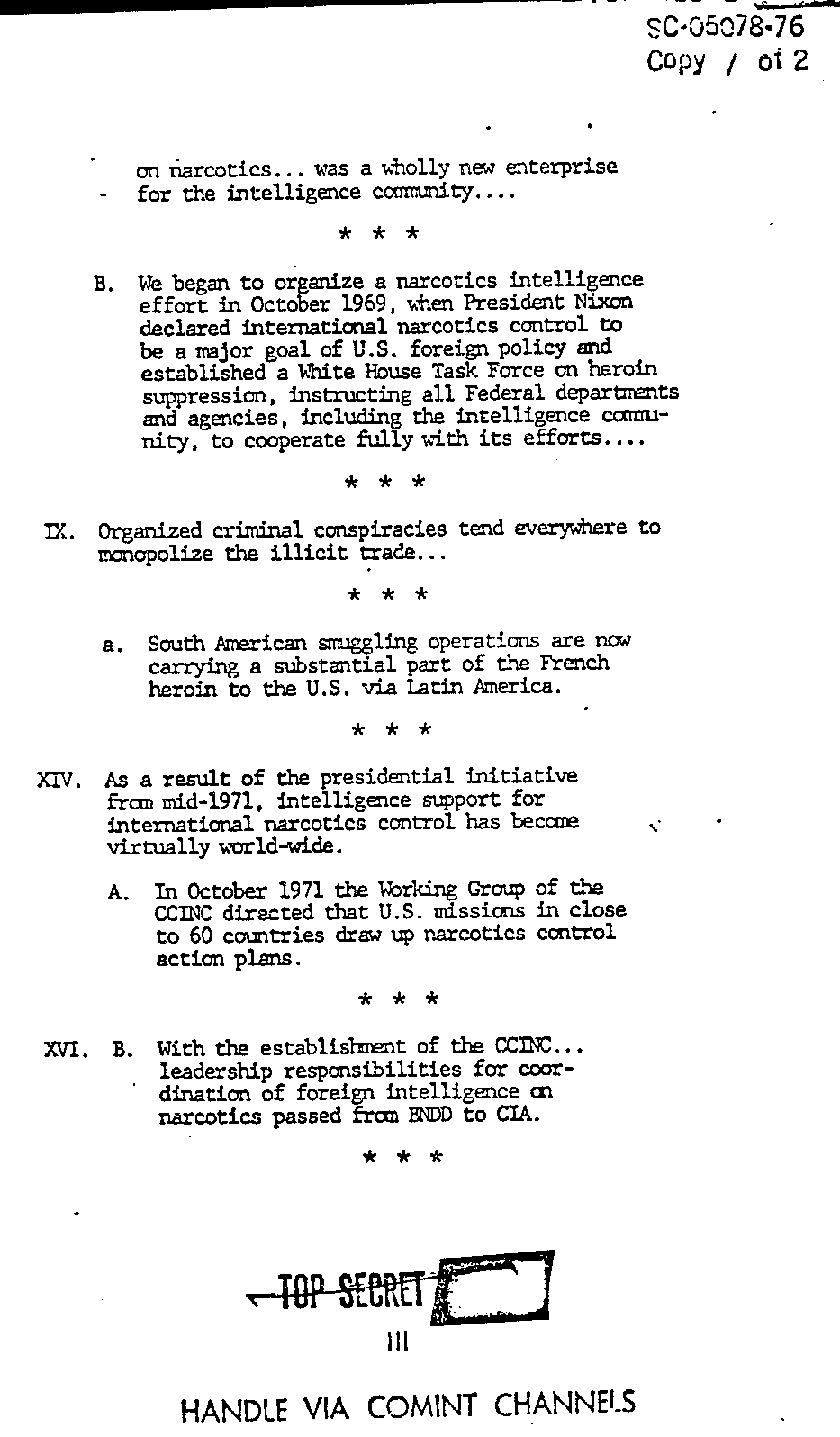
IX.
M.
803557
8-76
COpy 01'2
on narcotics. . . was a wholly new enterprise
- for the intelligence . ..
B. We began to organize a narcotics intelligence
effort in October 1969. when President Nixon
declared international narcotics control to
be a major goal of U.S. foreign policy and
established a White House Task Force on heroin
suppression, instructing all Federal departments
and agencies, including the intelligence condu-
nity, to cooperate fully with its efforts. . . .
Organized criminal conspiracies tend everywhere to
mopolize the illicit trade. . .
a. South American operations are nm
carrying a substantial part of the Frendl
heroin to the U.S. via Latin America.
As a result of the presidential initiative
from mid-1971, intelligence support for
international narcotics control has become
virtually world-wide.
A. In October 1971 the Working Group of the
CCINC directed that U.S. missions in close
to 60 countries draw up narcotics control
action plans.
B. With the establith of the mm.. .
leadership responsibilities for coor-
dination of foreign intelligence tn
narcotics passed from BNDD to CIA.
HANDLE VIA CHANNELS
IX.
M.
803557
8-76
COpy 01'2
on narcotics. . . was a wholly new enterprise
- for the intelligence . ..
B. We began to organize a narcotics intelligence
effort in October 1969. when President Nixon
declared international narcotics control to
be a major goal of U.S. foreign policy and
established a White House Task Force on heroin
suppression, instructing all Federal departments
and agencies, including the intelligence condu-
nity, to cooperate fully with its efforts. . . .
Organized criminal conspiracies tend everywhere to
mopolize the illicit trade. . .
a. South American operations are nm
carrying a substantial part of the Frendl
heroin to the U.S. via Latin America.
As a result of the presidential initiative
from mid-1971, intelligence support for
international narcotics control has become
virtually world-wide.
A. In October 1971 the Working Group of the
CCINC directed that U.S. missions in close
to 60 countries draw up narcotics control
action plans.
B. With the establith of the mm.. .
leadership responsibilities for coor-
dination of foreign intelligence tn
narcotics passed from BNDD to CIA.
HANDLE VIA CHANNELS
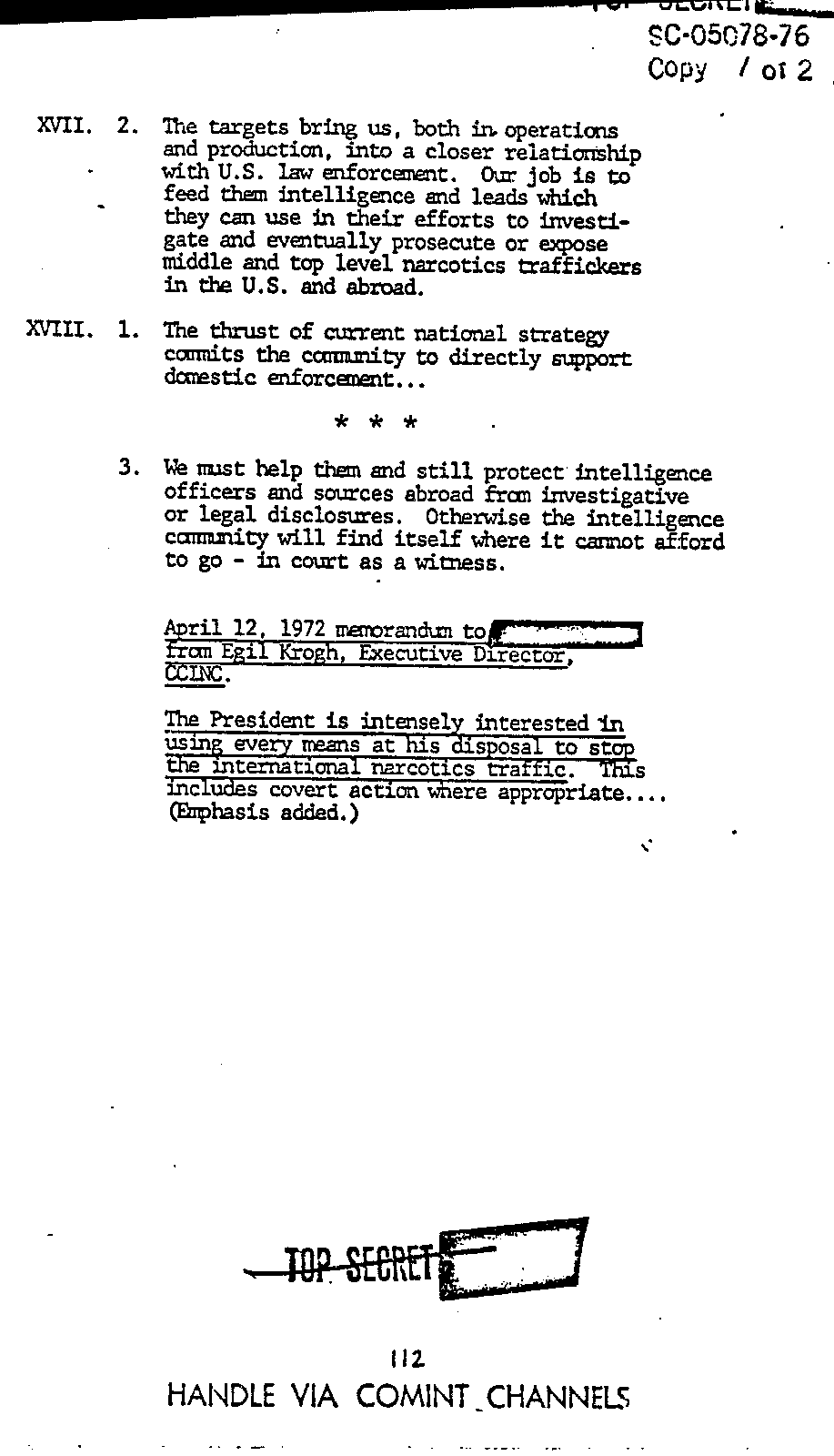
. 80-05078-76
Cosy 012 I
XVII. 2. The targets bring us, both in operations
and production, into a closer relationship
with U.S. law mforceumt. Om.- job is to
feed them intelligence and leads which
they can use in their efforts to investi-
gate and eventually prosecute or expose
middle and top level narcotics traffickers
in the U.S. and abroad.
l. The thrust of current natiml strategy
cocrmits the ccunmity to directly support
domestic mforcement. . .
3. We must help than and still protect intelligence
officers and sources abroad from irwestigative
or legal disclosures. Otherwise the intelligence
will find itself where it carmot afford
to go - in court as a witness.
April 12, 1972 mrandun to?
om Egi Krog Executive Director,
CCINC
:I?he Prasident is intensel interested in
usm' every means at His disposal to st?
international narcotics tra it.
includes covert action where appropriate. . . .
(Emphasis added.)
\e
12
HANDLE VIA
. 80-05078-76
Cosy 012 I
XVII. 2. The targets bring us, both in operations
and production, into a closer relationship
with U.S. law mforceumt. Om.- job is to
feed them intelligence and leads which
they can use in their efforts to investi-
gate and eventually prosecute or expose
middle and top level narcotics traffickers
in the U.S. and abroad.
l. The thrust of current natiml strategy
cocrmits the ccunmity to directly support
domestic mforcement. . .
3. We must help than and still protect intelligence
officers and sources abroad from irwestigative
or legal disclosures. Otherwise the intelligence
will find itself where it carmot afford
to go - in court as a witness.
April 12, 1972 mrandun to?
om Egi Krog Executive Director,
CCINC
:I?he Prasident is intensel interested in
usm' every means at His disposal to st?
international narcotics tra it.
includes covert action where appropriate. . . .
(Emphasis added.)
\e
12
HANDLE VIA
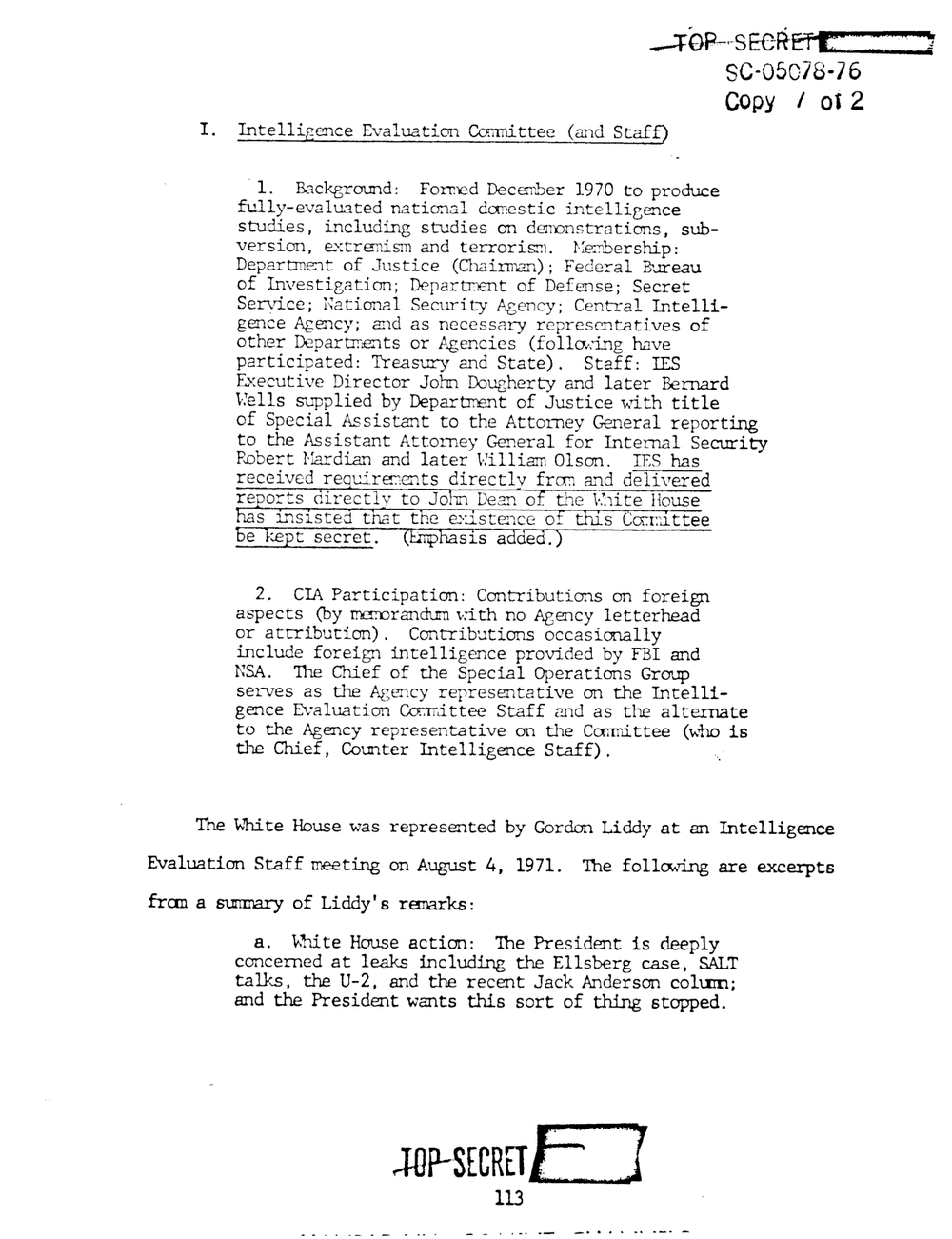
free-sees?
80-05078-76
COpy I oi 2
I. Intelligence Evaluation (and Staff)
Background: Forned December 1970 to produce
fully?evaluated national domestic intelligence
studies, including studies on demonstrations, sub-
version, extremism and terrorism. Membership:
Department of Justice (Chairman); Federal Bureau
of Investigation; Departrent of Defense; Secret
Service; National Security Agency; Central Intelli~
gence Agency; and as necessary representatives of
other Deparhnents or Agencies (following have
participated: Treasury and State). Staff: IE8
Executive Director John Dougherty and later Bernard
Wells supplied by Department of Justice with title
of Special Assistant to the Attorney General reporting
to the Assistant Attorney General for Internal Security
Robert Mardian and later William Olson. IRS has
received requirements directly fron and delivered
reports directly to John Dean of the hhite House
has insisted that the existence of this Cosn?ttee
be?kept secret. (Emphasis addedl)
2. CIA Participation: Contributions on foreign
aspects (by nrnorandun1with no Agency letterhead
or attribution). Contributions occasionally
include foreign intelligence provided by FBI and
NSA. The Chief of the Special Operations Group
serves as the Agency representative on the Intelli-
gence Evaluation Staff and as the alternate
to the Agency representative on the (who is
the Chief, Counter Intelligence Staff). .
The White House was represented by Gordon Liddy at an Intelligence
Evaluation Staff meeting on August 4, 1971. The following are excerpts
frtula summary of Liddy's remarks:
a. White House action: The President is deeply
concerned at leaks including the Ellsberg case, SAET
talks, the U-2, and the recent Jack.Anderson cobuni;
and the President wants this sort of thing stopped.
JGELSECRET
113
free-sees?
80-05078-76
COpy I oi 2
I. Intelligence Evaluation (and Staff)
Background: Forned December 1970 to produce
fully?evaluated national domestic intelligence
studies, including studies on demonstrations, sub-
version, extremism and terrorism. Membership:
Department of Justice (Chairman); Federal Bureau
of Investigation; Departrent of Defense; Secret
Service; National Security Agency; Central Intelli~
gence Agency; and as necessary representatives of
other Deparhnents or Agencies (following have
participated: Treasury and State). Staff: IE8
Executive Director John Dougherty and later Bernard
Wells supplied by Department of Justice with title
of Special Assistant to the Attorney General reporting
to the Assistant Attorney General for Internal Security
Robert Mardian and later William Olson. IRS has
received requirements directly fron and delivered
reports directly to John Dean of the hhite House
has insisted that the existence of this Cosn?ttee
be?kept secret. (Emphasis addedl)
2. CIA Participation: Contributions on foreign
aspects (by nrnorandun1with no Agency letterhead
or attribution). Contributions occasionally
include foreign intelligence provided by FBI and
NSA. The Chief of the Special Operations Group
serves as the Agency representative on the Intelli-
gence Evaluation Staff and as the alternate
to the Agency representative on the (who is
the Chief, Counter Intelligence Staff). .
The White House was represented by Gordon Liddy at an Intelligence
Evaluation Staff meeting on August 4, 1971. The following are excerpts
frtula summary of Liddy's remarks:
a. White House action: The President is deeply
concerned at leaks including the Ellsberg case, SAET
talks, the U-2, and the recent Jack.Anderson cobuni;
and the President wants this sort of thing stopped.
JGELSECRET
113
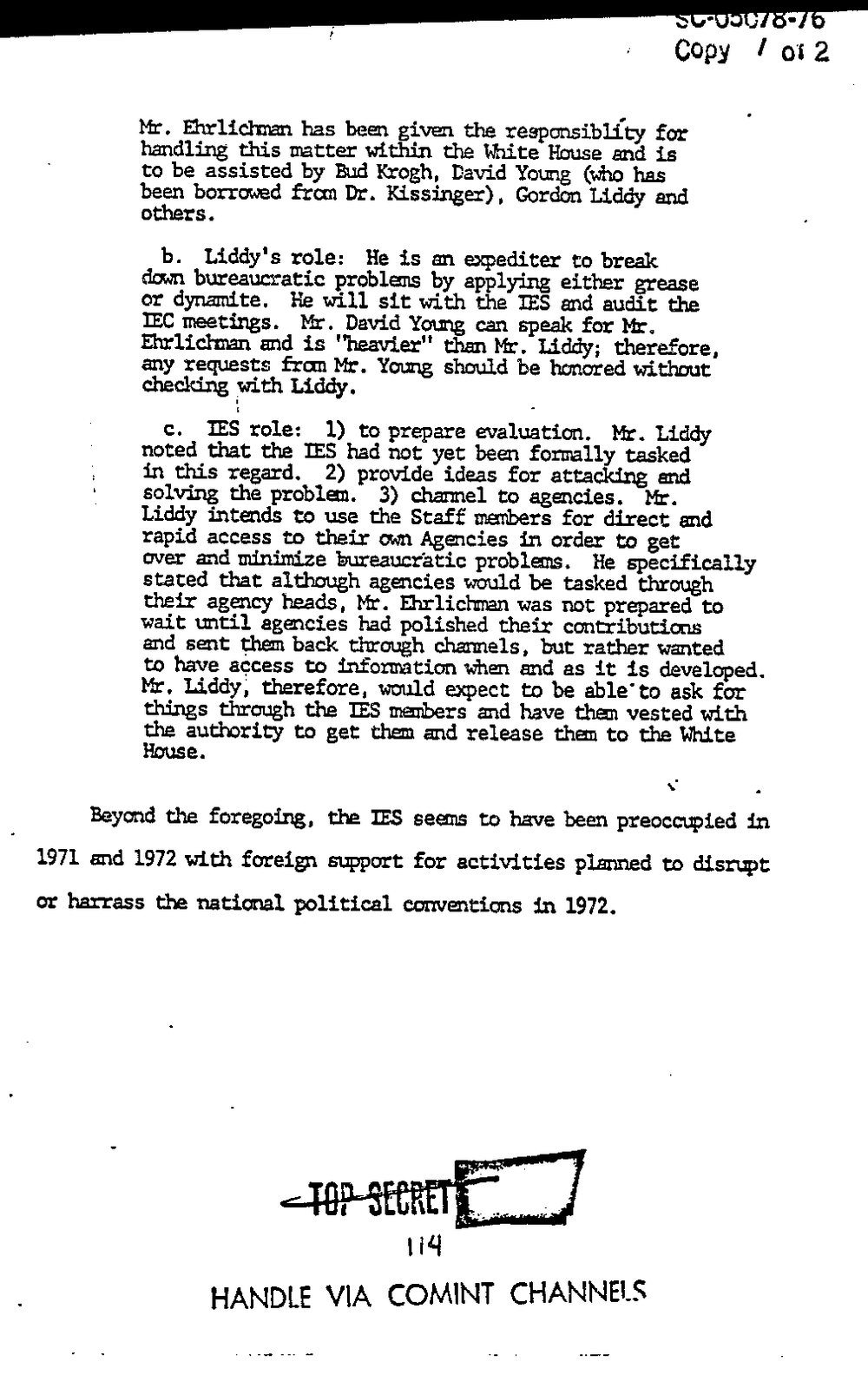
Cepy 0's 2
Mr. Ehrlicl?man has been given the respmsiblity for
handling this matter within the Waite House and is
to be assisted by Bud Krogh, David Young (who has
been borrowed Dr. Kissinger) . Gordon Liddy and
others.
b. Liddy's role: He is an expediter to break
down bureaucratic problems by applying either grease
or dynamite. He will sit with the IRS and audit the
IEC meetings. Mr. David Young can speak for Mr.
Ehrliclman and is "heavier" than Mr. Liddy; therefore,
any requests from Mr. Yomg should be honored without
checking with Liddy.
c. IES role: 1) to prepare evaluation. Mr. Liddy
noted that the ES had not yet been formally tasked
in this regard. 2) provide ideas for attacking and
solving the problem. 3) channel to agencies. Mr.
Liddy intends to use the Staff members for direct and
rapid access to their own Agencies in order to get
over and minimize bureaucratic problems. He specifically
stated that although agencies would be tasked through
their agency heads, Mr. El'zrlicl'nan was not prepared to
wait until agencies had polished their contributions
and sent them back through channels, but rather wanted
to have access to information when and as it is developed.
Mr. Liddy; therefore, would expect to be able'to ask for
things through the 1258 numbers and have them vested with
the authority to get them and release them to the White
House.
Beyond the foregoing, the 1255 seems to have been preoccupied in
1971 and 1972 with foreign support for activities planned to disrupt
or harrass the national political mentions in 1972.
Cepy 0's 2
Mr. Ehrlicl?man has been given the respmsiblity for
handling this matter within the Waite House and is
to be assisted by Bud Krogh, David Young (who has
been borrowed Dr. Kissinger) . Gordon Liddy and
others.
b. Liddy's role: He is an expediter to break
down bureaucratic problems by applying either grease
or dynamite. He will sit with the IRS and audit the
IEC meetings. Mr. David Young can speak for Mr.
Ehrliclman and is "heavier" than Mr. Liddy; therefore,
any requests from Mr. Yomg should be honored without
checking with Liddy.
c. IES role: 1) to prepare evaluation. Mr. Liddy
noted that the ES had not yet been formally tasked
in this regard. 2) provide ideas for attacking and
solving the problem. 3) channel to agencies. Mr.
Liddy intends to use the Staff members for direct and
rapid access to their own Agencies in order to get
over and minimize bureaucratic problems. He specifically
stated that although agencies would be tasked through
their agency heads, Mr. El'zrlicl'nan was not prepared to
wait until agencies had polished their contributions
and sent them back through channels, but rather wanted
to have access to information when and as it is developed.
Mr. Liddy; therefore, would expect to be able'to ask for
things through the 1258 numbers and have them vested with
the authority to get them and release them to the White
House.
Beyond the foregoing, the 1255 seems to have been preoccupied in
1971 and 1972 with foreign support for activities planned to disrupt
or harrass the national political mentions in 1972.
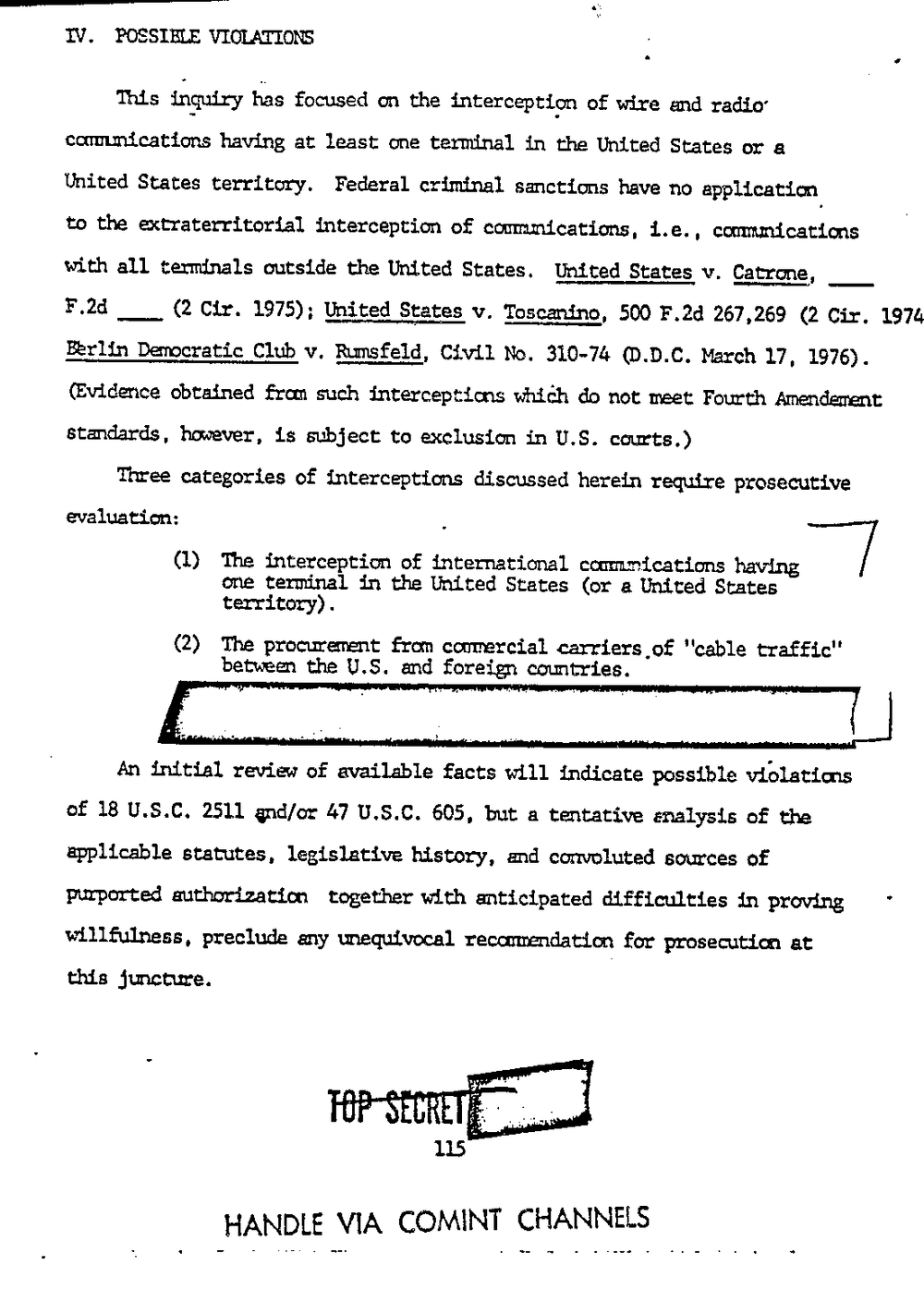
IV. POSSIBLE VIOLATIONS
This has focused on the interception of wire and radiO'
having at least one terminal in the United States or a
United States territory. Federal criminal sanctions have no applicaticn.
to the extraterritorial interception of coumunications. i.e. communications
with all terminals outside the United States. United States v. Catrone,
F.2d (2 Cir. 1975); United states v. Toscanino. 500 F.2d 267,269 (2 Cir. 1974
Berlin Dermcratic Club v. Rumsfeld, Civil No. 310-74 (D.D.C. March 17, 1976).
(Evidence obtained from such interceptims which do not meet Fourth Arnendelrmt
standards, however, is subject to exclusion in U.S. courts.)
Three categories of interceptions discussed herein require prosecutive
evaluation:
The interception of international cmnications having
one terminal in the United States (or a United States
territory).
(2) The procurement from commercial carrierspf "cable traffic"
between the 11.8. and foreign countries.
An initial review of available facts will indicate possible violatims
of 18 U.S.C. 2511 and/or 47 U.S.C. 605. but a tentative analysis of the
applicable statutes. legislative history, and convoluted sources of
purported authorizatim together with anticipated difficulties in proving
willfulness, preclude any unequivocal recmmendation for prosecution at
this juncture.
HANDLE VIA COMINT CHANNELS
IV. POSSIBLE VIOLATIONS
This has focused on the interception of wire and radiO'
having at least one terminal in the United States or a
United States territory. Federal criminal sanctions have no applicaticn.
to the extraterritorial interception of coumunications. i.e. communications
with all terminals outside the United States. United States v. Catrone,
F.2d (2 Cir. 1975); United states v. Toscanino. 500 F.2d 267,269 (2 Cir. 1974
Berlin Dermcratic Club v. Rumsfeld, Civil No. 310-74 (D.D.C. March 17, 1976).
(Evidence obtained from such interceptims which do not meet Fourth Arnendelrmt
standards, however, is subject to exclusion in U.S. courts.)
Three categories of interceptions discussed herein require prosecutive
evaluation:
The interception of international cmnications having
one terminal in the United States (or a United States
territory).
(2) The procurement from commercial carrierspf "cable traffic"
between the 11.8. and foreign countries.
An initial review of available facts will indicate possible violatims
of 18 U.S.C. 2511 and/or 47 U.S.C. 605. but a tentative analysis of the
applicable statutes. legislative history, and convoluted sources of
purported authorizatim together with anticipated difficulties in proving
willfulness, preclude any unequivocal recmmendation for prosecution at
this juncture.
HANDLE VIA COMINT CHANNELS
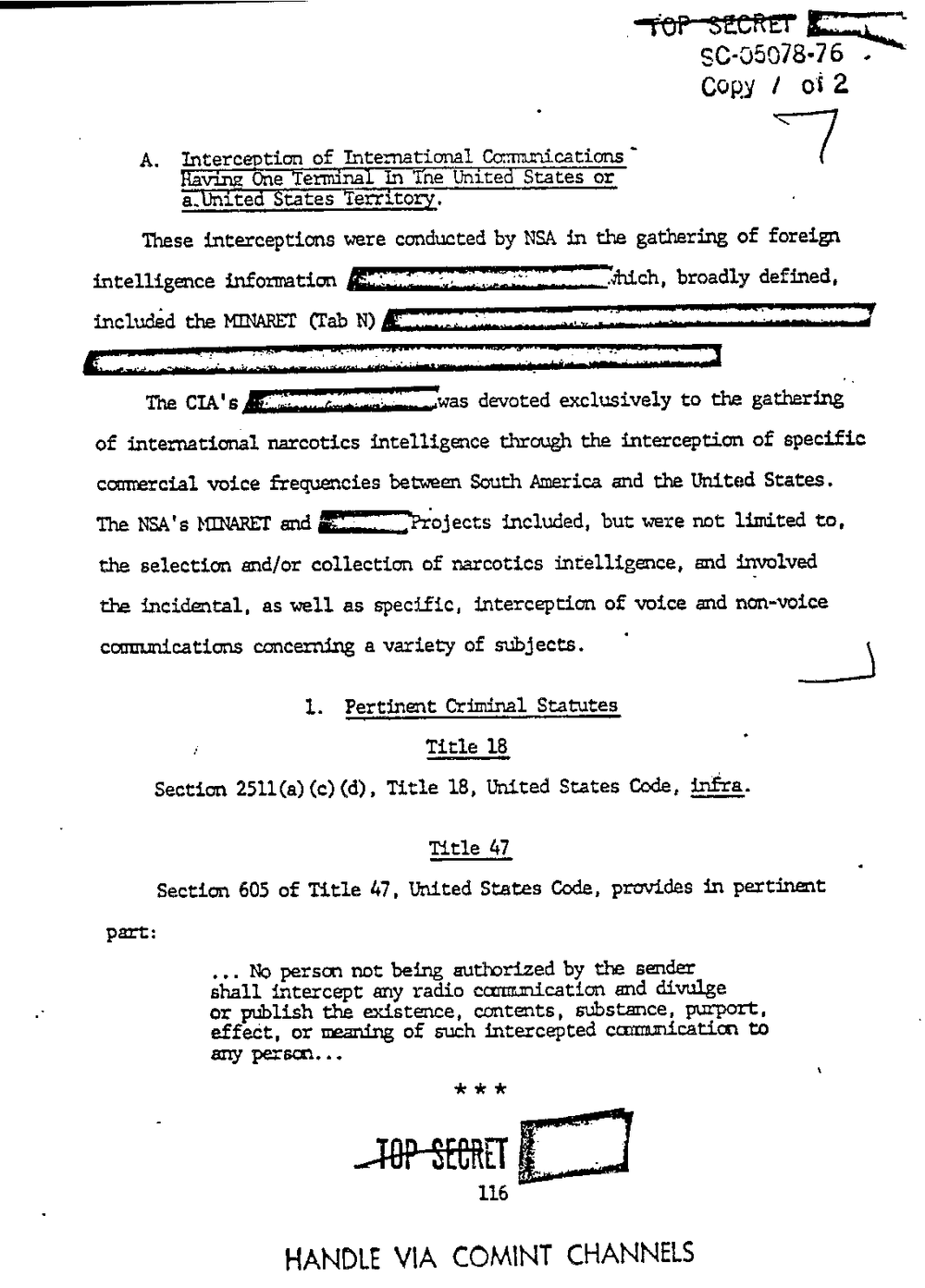
80-05078-Interception of International Commications
Ravine One Terminal In The United States or
a.United States Territory.
These interceptions were conducted by NSA in the gathering of foreigl
intelligence information 1 in?; .Jhich, broadly defined.
included (Tab tor?- . f?
The CIA's meme devoted exclusively to the gathering.-
of international narcotics intelligence through the interception of specific
comercial voice frequencies between South America and the United States.
The NSA's and mama included, but were not limited to.
the selection and/or collection of narcotics intelligence, and involved
the incidental. as well as specific. interception of voice and non-voice
commnications concerning a variety of subjects.
1. Pertinent Criminal Statutes
r' Title 18
Section 2511(e) Title 18, United States Code, mete.
Title 47
Section 605 of Title 47. United States Code, provides in pertinent
part:
. . . No person not being authorized by the sender
shall intercept any radio and divulge
or publish the existence, contents, substance, purport.
effect, or meaning of such intercepted to
HANDLE VIA COMINT CHANNELS
80-05078-Interception of International Commications
Ravine One Terminal In The United States or
a.United States Territory.
These interceptions were conducted by NSA in the gathering of foreigl
intelligence information 1 in?; .Jhich, broadly defined.
included (Tab tor?- . f?
The CIA's meme devoted exclusively to the gathering.-
of international narcotics intelligence through the interception of specific
comercial voice frequencies between South America and the United States.
The NSA's and mama included, but were not limited to.
the selection and/or collection of narcotics intelligence, and involved
the incidental. as well as specific. interception of voice and non-voice
commnications concerning a variety of subjects.
1. Pertinent Criminal Statutes
r' Title 18
Section 2511(e) Title 18, United States Code, mete.
Title 47
Section 605 of Title 47. United States Code, provides in pertinent
part:
. . . No person not being authorized by the sender
shall intercept any radio and divulge
or publish the existence, contents, substance, purport.
effect, or meaning of such intercepted to
HANDLE VIA COMINT CHANNELS
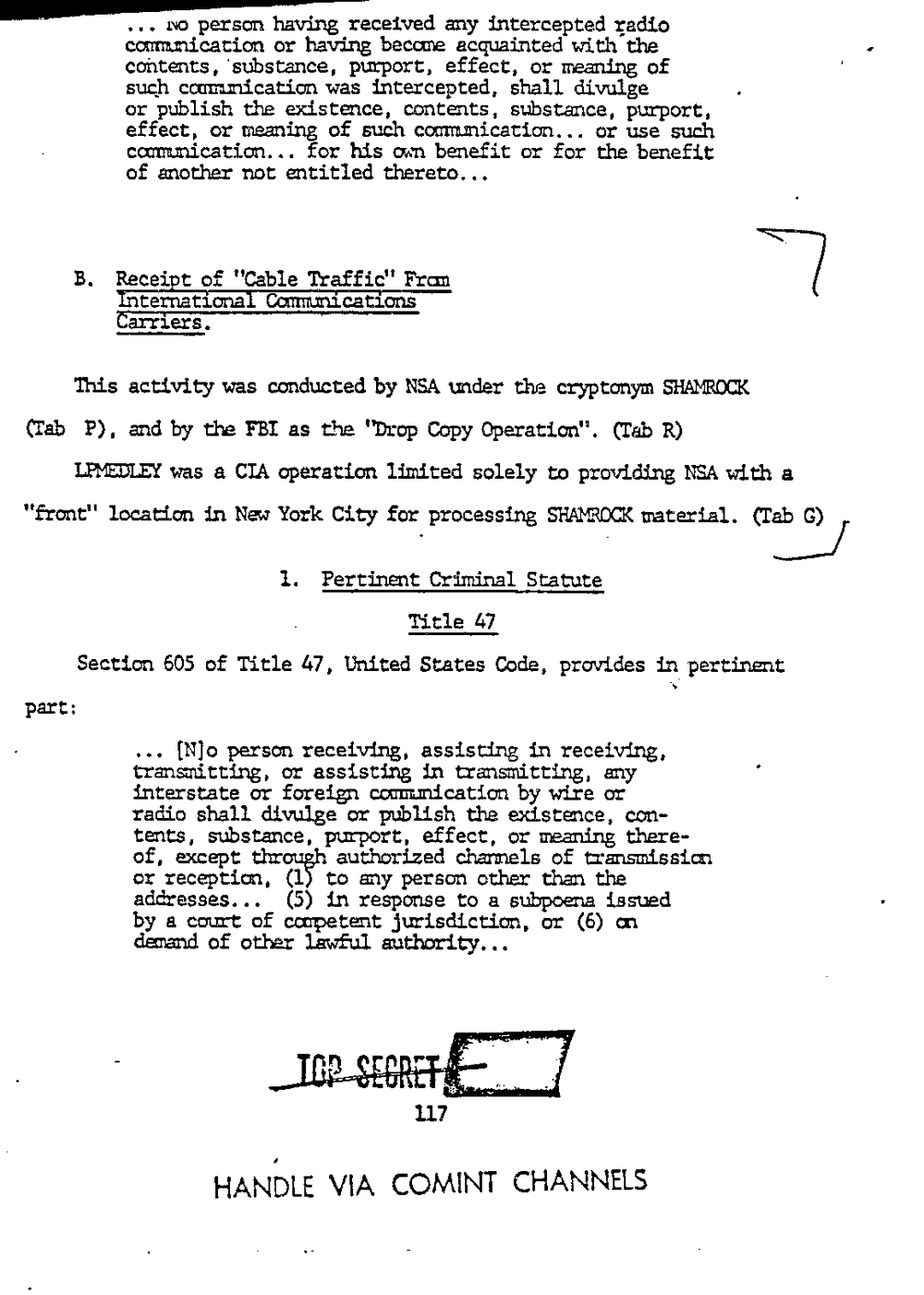
. . . no person having received any intercepted radio
conmmication or having become acquainted with the
contents, 'substance, purport, effect, or meaning of
such commnication was intercepted, shall divulge
or publish the existence, contents, substance, pmrport,
effect, or meaning of such communication. . . or use such
commication. . . for his own benefit or for the benefit
of another not entitled thereto. . .
B. Receipt of "Cable Traffic"
International Conmmications
Carriers.
This activity was conducted by NSA under the SHAMROCK
(Tab P). and by the FBI as the "Drop Copy Operation". (Tab R)
Lama! was a CIA operation limited solely to providing NSA with a
"front" location in New York City for processing material. (Tab G)
l. Pertinent Criminal Statute
Title 47
Section 605 of Title 47, United States Code, provides in. pertinent
part:
. . . person receiving, assisting in receiving,
trmmitting, or assisting in transmitting, any
interstate or foreign commieation by wire or
radio shall divulge or publish the existence, con?
tents, purport, effect, or meaning there-
of, except authorized chamels of transmissim
or reception, (1 to any person other than the
addresses. .. (5) in response to a subpoena issued
by a court of carpetent jurisdiction. or (6)
darand of other lawful
117
VIA comm CHANNELS
. . . no person having received any intercepted radio
conmmication or having become acquainted with the
contents, 'substance, purport, effect, or meaning of
such commnication was intercepted, shall divulge
or publish the existence, contents, substance, pmrport,
effect, or meaning of such communication. . . or use such
commication. . . for his own benefit or for the benefit
of another not entitled thereto. . .
B. Receipt of "Cable Traffic"
International Conmmications
Carriers.
This activity was conducted by NSA under the SHAMROCK
(Tab P). and by the FBI as the "Drop Copy Operation". (Tab R)
Lama! was a CIA operation limited solely to providing NSA with a
"front" location in New York City for processing material. (Tab G)
l. Pertinent Criminal Statute
Title 47
Section 605 of Title 47, United States Code, provides in. pertinent
part:
. . . person receiving, assisting in receiving,
trmmitting, or assisting in transmitting, any
interstate or foreign commieation by wire or
radio shall divulge or publish the existence, con?
tents, purport, effect, or meaning there-
of, except authorized chamels of transmissim
or reception, (1 to any person other than the
addresses. .. (5) in response to a subpoena issued
by a court of carpetent jurisdiction. or (6)
darand of other lawful
117
VIA comm CHANNELS
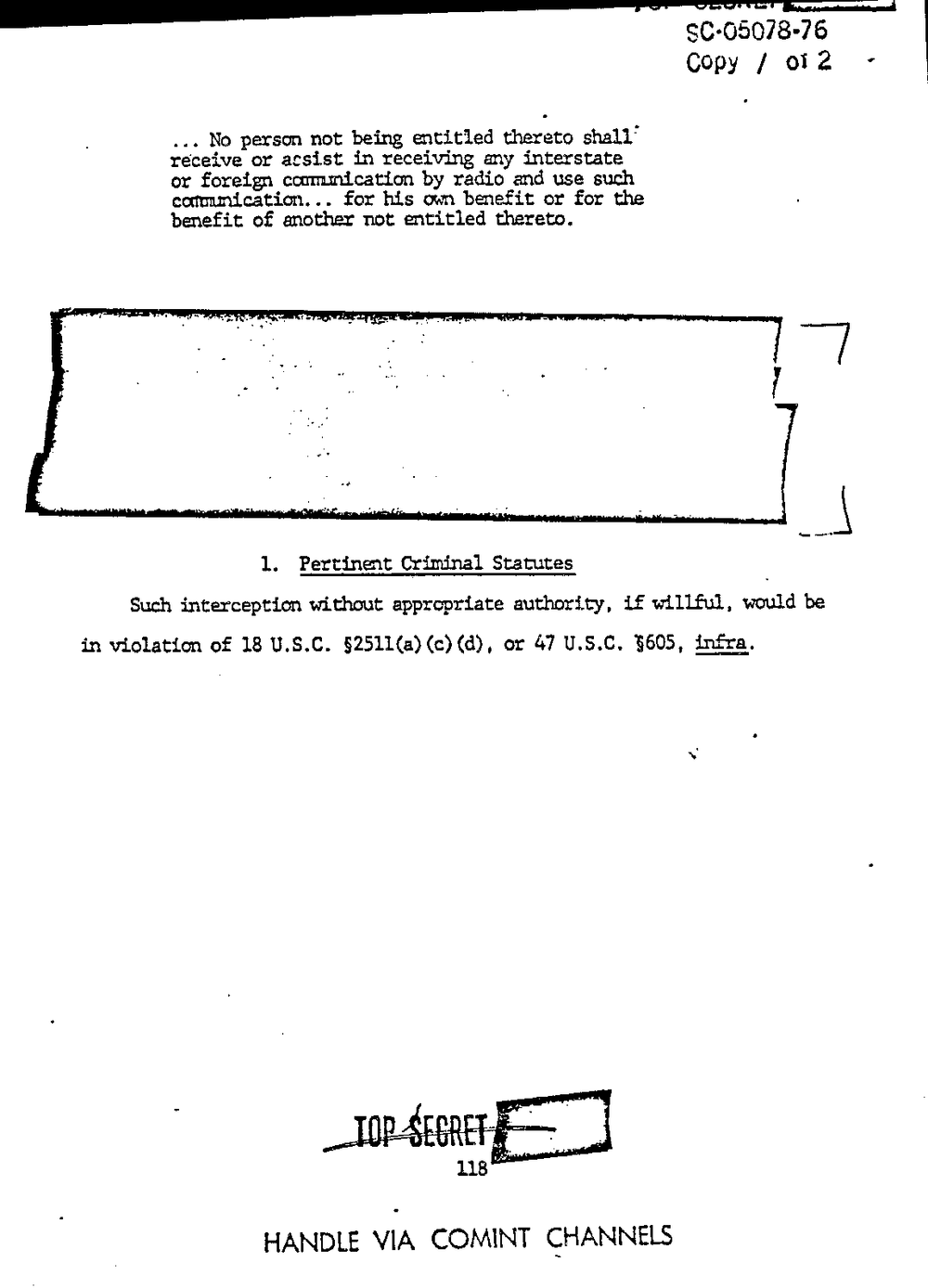
80-05078-76
COpy 012
. . . No person not being entitled thereto shall:
receive or assist in receiving any interstate
or foreign coommication by radio and use such
. . for his om benefit or for the
benefit of another not entitled thereto.
1. Pertinent criminal Statutes
Such interception without appropriate authority. if willful, would be
in violation of 18 U.S.C. ?2511(a) or 47 U.S.C. E605. infra.
HANDLE VIA COMINT (EHANNELS
80-05078-76
COpy 012
. . . No person not being entitled thereto shall:
receive or assist in receiving any interstate
or foreign coommication by radio and use such
. . for his om benefit or for the
benefit of another not entitled thereto.
1. Pertinent criminal Statutes
Such interception without appropriate authority. if willful, would be
in violation of 18 U.S.C. ?2511(a) or 47 U.S.C. E605. infra.
HANDLE VIA COMINT (EHANNELS
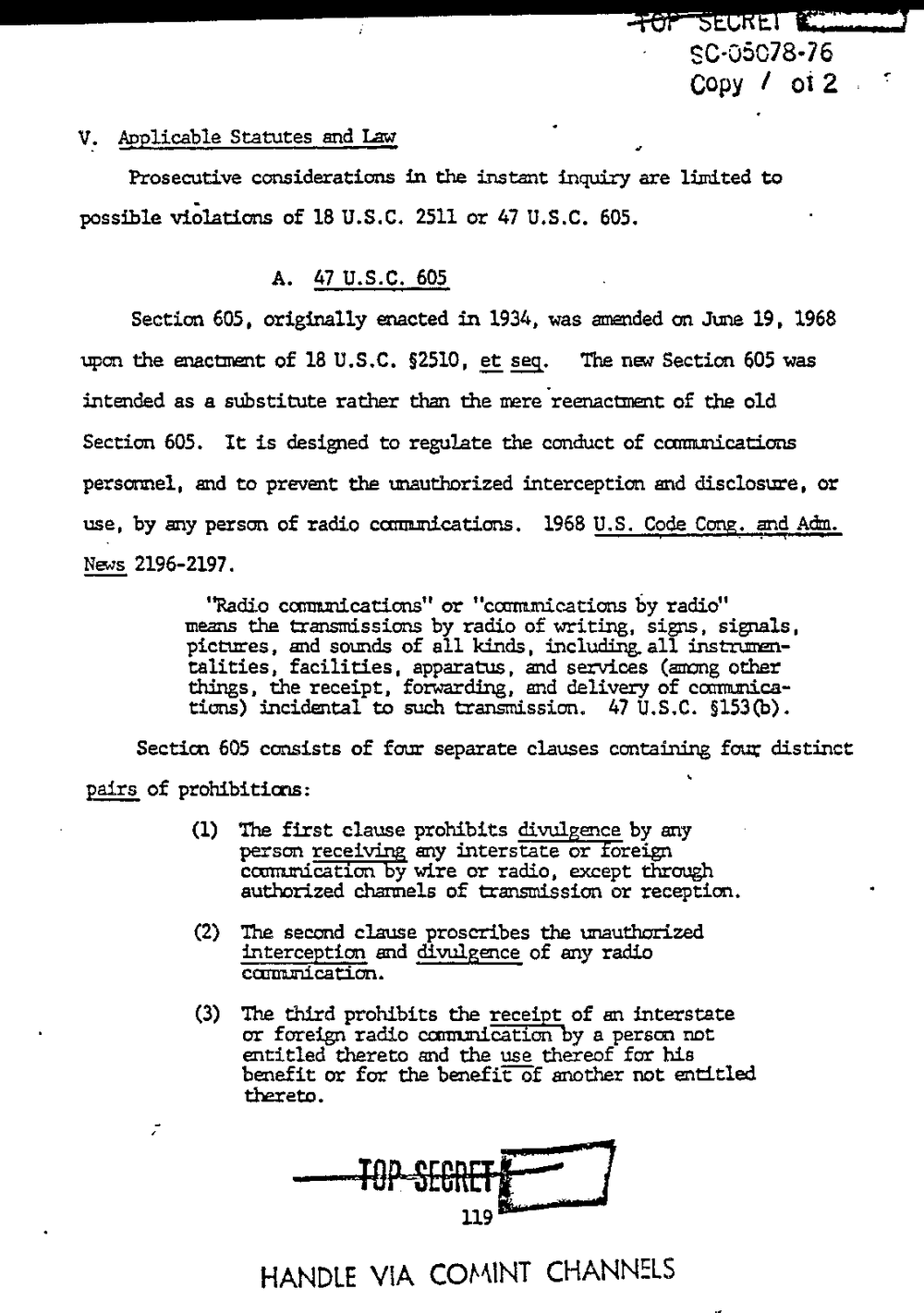
80-05078-76
COpy on
V. Applicable Statutes and Law
.u
Prosecutive considerations in the instant inquiry are limited to
possible violations of 18 u.s.c. 2511 or 47 u.s.c. 605.
A. 47 U.S.C. 605
Section 605, originally enacted in 1934, was amended on June 19, 1968
upon the math of 18 U.S.C. 52510, gag. The new Section 605 was
intended as a substitute rather than the nere'reenacment of the old
Section 605. It is designed to regulate the conduct of coonmicatiorm
personnel, and to prevent the mauthorized interception and disclosure, or
use, by any person of radio cummications. 1968 U.S. Code Cong. and Adm.
News 2196-2197.
"Radio cormnmications" or "coummications by radio"
means the transmissions by radio of writing, sips, signals,
pictures, and sounds of all kinds, including, all
talities. facilities. apparatus, and services (among other
things. the receipt, forwarding, and delivery of coommica-
tions) incidental to such transmission. 47 U.S.C. 5153(b).
Section 505 consists of four separate clauses containing four distinct
pairs of prohibitims:
The first clause prohibits divul once by my
person recei any interstate or foreigI
comrunication wire or radio, except
authorized channels of transmission or reception.
(2) The second clause prescribes the unauthorized
interception and divulgence of any radio
cammication.
(3) The third prohibits the recei of an interstate
or foreigu radio a person not
entitled thereto and the use thereof for his
benefit or for the benefit?(3f another not entitled
thereto.
2
. OLUIILI
119
- -1
cc:
HANDLE VIA COMINT CHANNELS
80-05078-76
COpy on
V. Applicable Statutes and Law
.u
Prosecutive considerations in the instant inquiry are limited to
possible violations of 18 u.s.c. 2511 or 47 u.s.c. 605.
A. 47 U.S.C. 605
Section 605, originally enacted in 1934, was amended on June 19, 1968
upon the math of 18 U.S.C. 52510, gag. The new Section 605 was
intended as a substitute rather than the nere'reenacment of the old
Section 605. It is designed to regulate the conduct of coonmicatiorm
personnel, and to prevent the mauthorized interception and disclosure, or
use, by any person of radio cummications. 1968 U.S. Code Cong. and Adm.
News 2196-2197.
"Radio cormnmications" or "coummications by radio"
means the transmissions by radio of writing, sips, signals,
pictures, and sounds of all kinds, including, all
talities. facilities. apparatus, and services (among other
things. the receipt, forwarding, and delivery of coommica-
tions) incidental to such transmission. 47 U.S.C. 5153(b).
Section 505 consists of four separate clauses containing four distinct
pairs of prohibitims:
The first clause prohibits divul once by my
person recei any interstate or foreigI
comrunication wire or radio, except
authorized channels of transmission or reception.
(2) The second clause prescribes the unauthorized
interception and divulgence of any radio
cammication.
(3) The third prohibits the recei of an interstate
or foreigu radio a person not
entitled thereto and the use thereof for his
benefit or for the benefit?(3f another not entitled
thereto.
2
. OLUIILI
119
- -1
cc:
HANDLE VIA COMINT CHANNELS
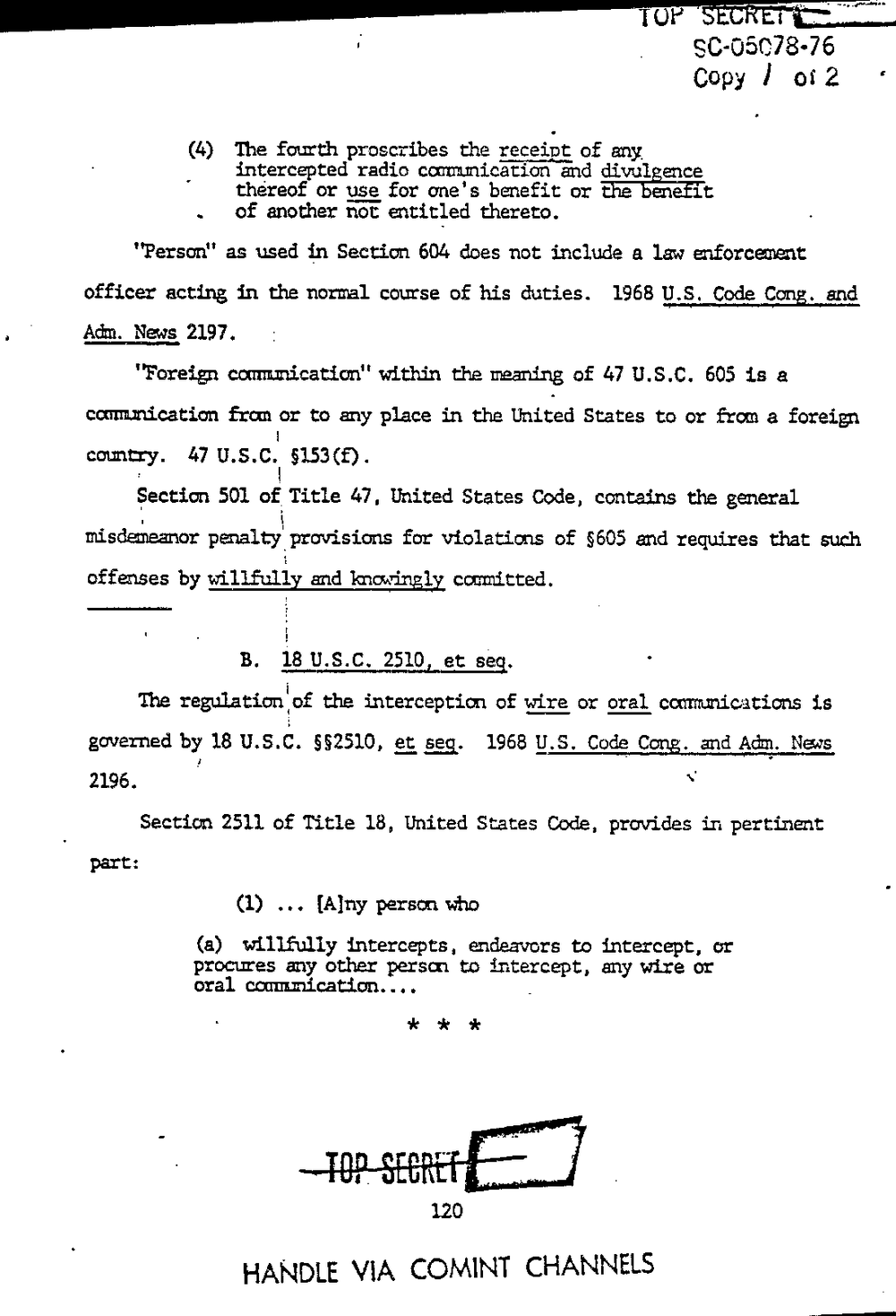
-
. 30'05078-76
COpy I 0: 2
(4) The fourth prescribes the receip. of any
intercepted radio coon-mication and divul ence
thereof or use for one's benefit or Senau:
. of another 5313 entitled thereto.
"Person" as used in Section 604 does not include a law emforceomt
officer acting in the normal course of his duties. 1968 Code Cong. and
. Adm. News 2197.
'T?oreigx communication" within the naming of 47 U.S.C. 605 is a
communication from or to any place in the United States to or from a foreign
country. 47 U.S.C.I 5153(f).
Section 501 ofl' Title 47. United States Code, contains the general
misdetneanor penalty? provisions for violations of 5605 and requires that such
offenses by willfully and knowingly coomitted.
B. l8 U.S.C. 2510, et seq.
The regulationiof the interception of Big or gel commioations is
governed by 18 552510, 1968 Code Cong. and Ackn. News
2195.
Section 2511 of Title 18, United States Code, provides in pertinent
part:
(1) . . . [Alny person who
willfully intercepts, endeavors to intercept, or
procures any other person to intercept, any wire or
oral coummication. . . . .
*tk'k
ornnW
120
HANDLE VIA COMINT CHANNELS
-
. 30'05078-76
COpy I 0: 2
(4) The fourth prescribes the receip. of any
intercepted radio coon-mication and divul ence
thereof or use for one's benefit or Senau:
. of another 5313 entitled thereto.
"Person" as used in Section 604 does not include a law emforceomt
officer acting in the normal course of his duties. 1968 Code Cong. and
. Adm. News 2197.
'T?oreigx communication" within the naming of 47 U.S.C. 605 is a
communication from or to any place in the United States to or from a foreign
country. 47 U.S.C.I 5153(f).
Section 501 ofl' Title 47. United States Code, contains the general
misdetneanor penalty? provisions for violations of 5605 and requires that such
offenses by willfully and knowingly coomitted.
B. l8 U.S.C. 2510, et seq.
The regulationiof the interception of Big or gel commioations is
governed by 18 552510, 1968 Code Cong. and Ackn. News
2195.
Section 2511 of Title 18, United States Code, provides in pertinent
part:
(1) . . . [Alny person who
willfully intercepts, endeavors to intercept, or
procures any other person to intercept, any wire or
oral coummication. . . . .
*tk'k
ornnW
120
HANDLE VIA COMINT CHANNELS
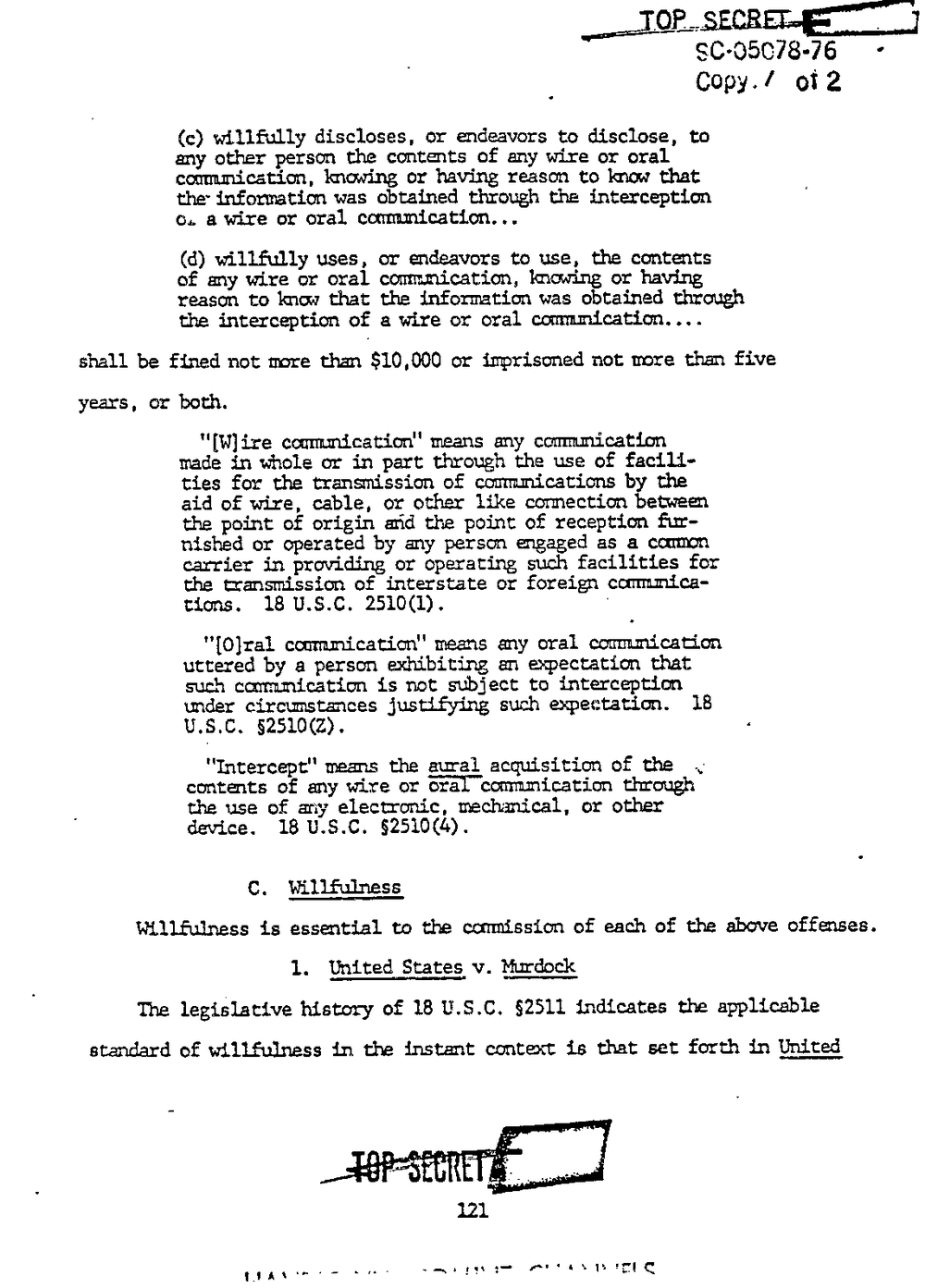
lesionstm
sc-osc7s-7s
COpy. I of 2
willfully discloses, or endeavors to disclose, to
any other person the contents of any wire or oral
conmmication, lmom'ng or having reason to know that
the- information was obtained through the interception
oi. a wire or oral ..
willfully uses, or endeavors to use, the contents
of any wire or oral conmmication, knowing or he
reason to know that the information was obtained through
the interception of a wire or oral .. .
shall be fined not more than $10,000 or imprisoned not more than five
years, or both.
ire coommication" means any communication
nude in whole or in part through the use of facili-
ties for the transmission of coummications by the
aid of wire, cable, or other like connection between
the point of origin and the point of reception fur-
nished or operated by any person engaged as a comma
carrier in providing or Operating such facilities for
the transmission of interstate or foreigi cumin-lice?
tions. 18 U.S.C. 2510(1).
"[0]ral coummication" means any oral couumicadon
uttered by a person exhibiting an ewectation that
such is not subject to interception
under justifying such expec:tation. 18
U.S.C. 525106).
"Intercept" means the aural acquisition of the
contents of any wire or oral cornmmication through
the use of any electronic. technical, or other
device. 18 U.S.C. ?2510(4).
'5
C. Willfu'lness
Mllfulness is essential to the commission of each of the above offenses.
1. United States v. Murdock
The legislative history of 18 use. 52511 indicates the applicable
standard of willfulness in the instant context is that set forth in Un__it;elc_1_
lesionstm
sc-osc7s-7s
COpy. I of 2
willfully discloses, or endeavors to disclose, to
any other person the contents of any wire or oral
conmmication, lmom'ng or having reason to know that
the- information was obtained through the interception
oi. a wire or oral ..
willfully uses, or endeavors to use, the contents
of any wire or oral conmmication, knowing or he
reason to know that the information was obtained through
the interception of a wire or oral .. .
shall be fined not more than $10,000 or imprisoned not more than five
years, or both.
ire coommication" means any communication
nude in whole or in part through the use of facili-
ties for the transmission of coummications by the
aid of wire, cable, or other like connection between
the point of origin and the point of reception fur-
nished or operated by any person engaged as a comma
carrier in providing or Operating such facilities for
the transmission of interstate or foreigi cumin-lice?
tions. 18 U.S.C. 2510(1).
"[0]ral coummication" means any oral couumicadon
uttered by a person exhibiting an ewectation that
such is not subject to interception
under justifying such expec:tation. 18
U.S.C. 525106).
"Intercept" means the aural acquisition of the
contents of any wire or oral cornmmication through
the use of any electronic. technical, or other
device. 18 U.S.C. ?2510(4).
'5
C. Willfu'lness
Mllfulness is essential to the commission of each of the above offenses.
1. United States v. Murdock
The legislative history of 18 use. 52511 indicates the applicable
standard of willfulness in the instant context is that set forth in Un__it;elc_1_
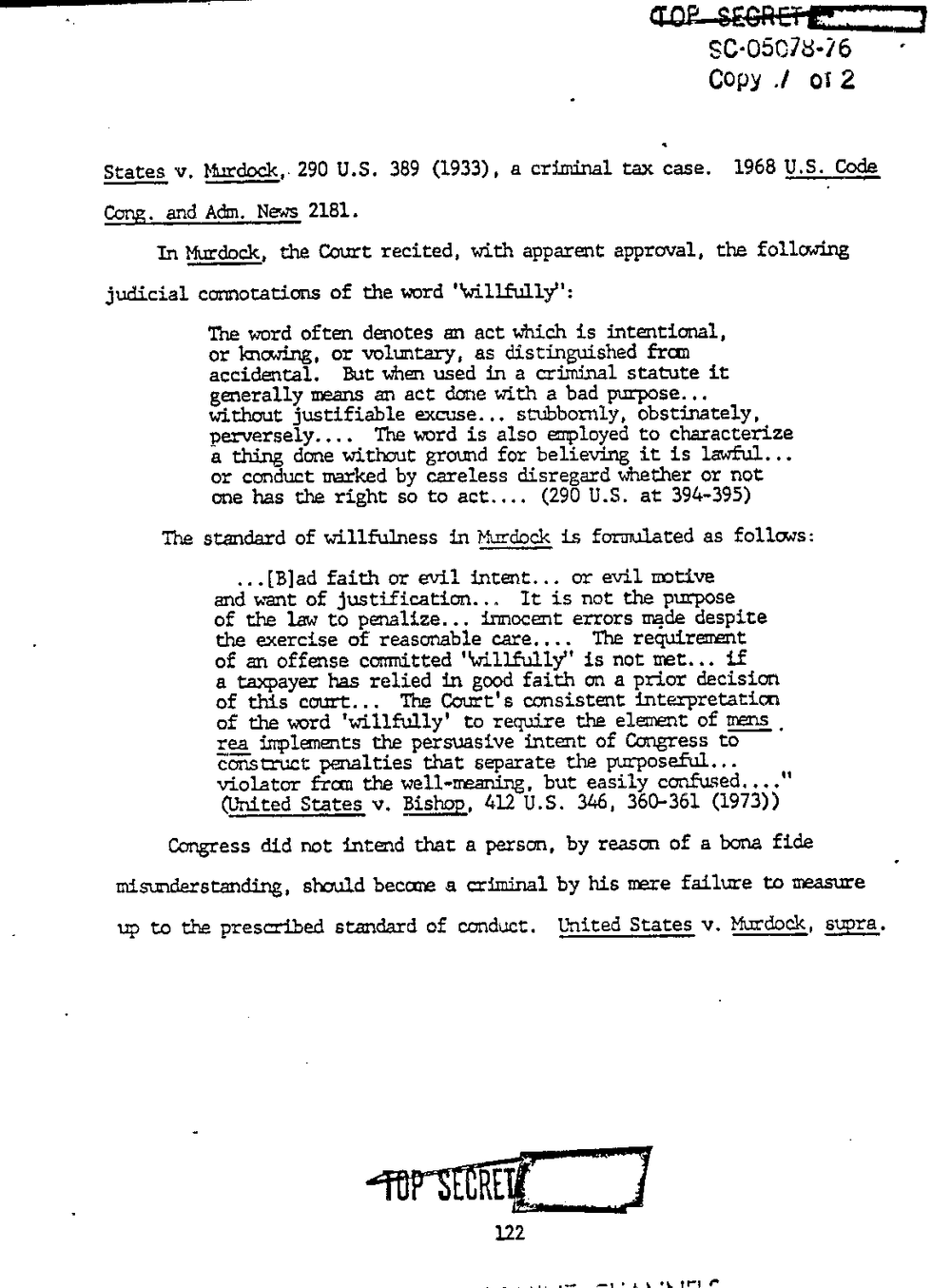
500507846
COpy at 2
States v. Mirdock,. 290 U.S. 389 (1933). a criminal tax case. 1968 U.S. Code
Cong. and Adm. News 2181.
In Murdock. the Court recited, with apparent approval, the follcming
judicial connotations of the word "willfully":
The word often denotes an act which is intentional,
or bowing, or voluntary, as distinguished Eran
accidental. But when used in a criminal statute it
generally means an act done with a bad purpose. . .
without justifiable excuse. .. stubbornly, obstinately.
perversely. . . . The word is also erployed to characterize
a thing done without ground for believing it is lawful. . .
or conduct marked by careless disregard whether or not
one has the right so to act. (290 U.S. at 394~395)
The standard of willfulness in Murdock is forumlated as follows:
.. .[B]ad faith or evil intent. . . or evil motive
and want of It is not the purpose
of the law to penalize. . . innocent errors trade despite
the exercise of reasonable care. . . . The requirement
of an offense committed "willfLilly" is not met. . . if
a taxpayer has relied in good faith on a prior decision
of this court. . . The Court's consistent interpretaticn
of the word 'willfully' to require the element of mens .
3e}; inplemmts the persuasive intent of Congress to
construct penalties that separate the purposeful. . .
violator fran the well-meaning, but easily confused. . .
(United States v. Bishop. 412 U.S. 346. 360?361 (1973))
Congress did not intend that a person, by reason of a bona fide
misxmderstanding, should become a criminal by his mere failure to measure
up to the prescribed standard of conduct. United States v. Pin-dock, supra.
500507846
COpy at 2
States v. Mirdock,. 290 U.S. 389 (1933). a criminal tax case. 1968 U.S. Code
Cong. and Adm. News 2181.
In Murdock. the Court recited, with apparent approval, the follcming
judicial connotations of the word "willfully":
The word often denotes an act which is intentional,
or bowing, or voluntary, as distinguished Eran
accidental. But when used in a criminal statute it
generally means an act done with a bad purpose. . .
without justifiable excuse. .. stubbornly, obstinately.
perversely. . . . The word is also erployed to characterize
a thing done without ground for believing it is lawful. . .
or conduct marked by careless disregard whether or not
one has the right so to act. (290 U.S. at 394~395)
The standard of willfulness in Murdock is forumlated as follows:
.. .[B]ad faith or evil intent. . . or evil motive
and want of It is not the purpose
of the law to penalize. . . innocent errors trade despite
the exercise of reasonable care. . . . The requirement
of an offense committed "willfLilly" is not met. . . if
a taxpayer has relied in good faith on a prior decision
of this court. . . The Court's consistent interpretaticn
of the word 'willfully' to require the element of mens .
3e}; inplemmts the persuasive intent of Congress to
construct penalties that separate the purposeful. . .
violator fran the well-meaning, but easily confused. . .
(United States v. Bishop. 412 U.S. 346. 360?361 (1973))
Congress did not intend that a person, by reason of a bona fide
misxmderstanding, should become a criminal by his mere failure to measure
up to the prescribed standard of conduct. United States v. Pin-dock, supra.
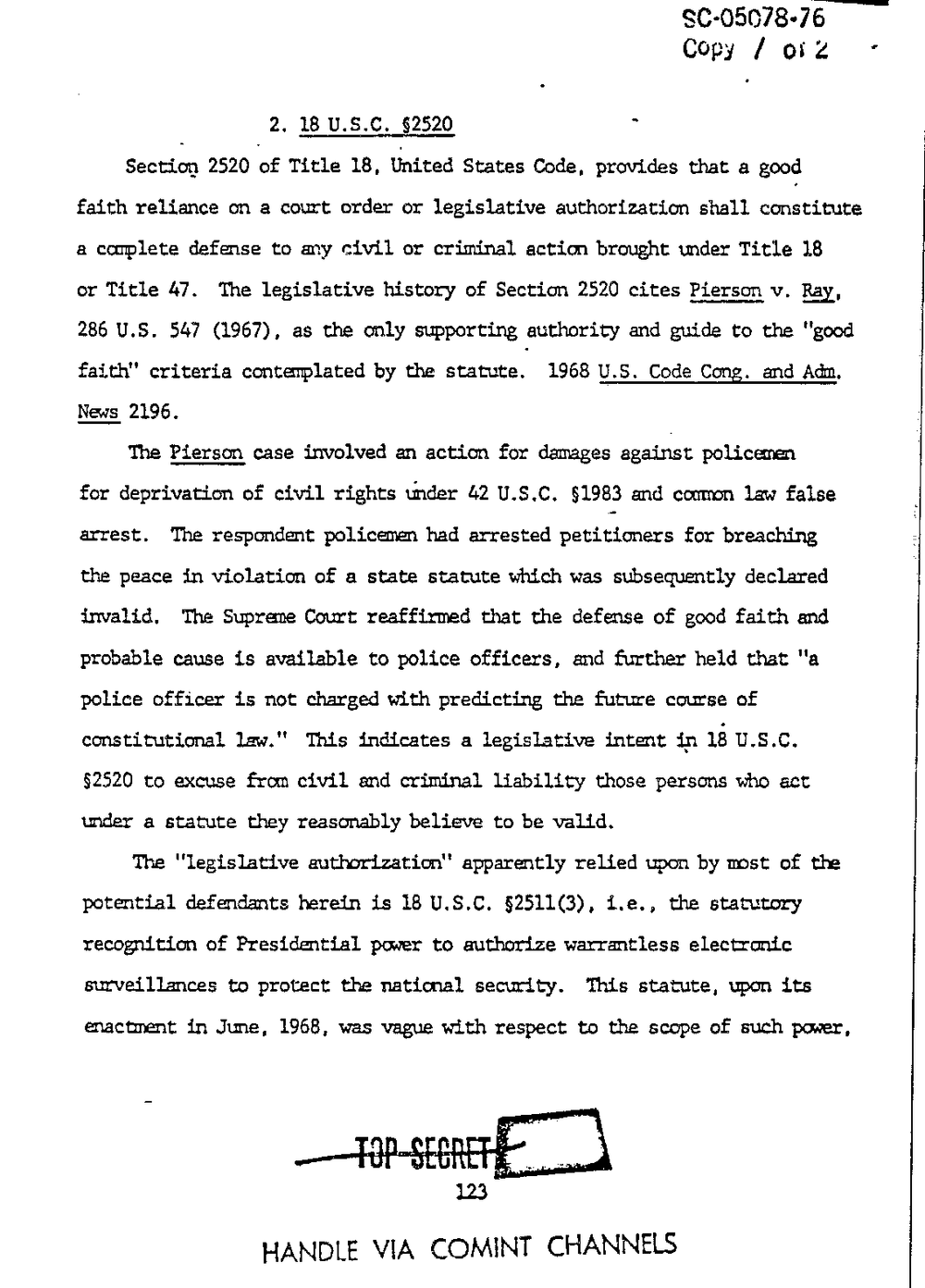
sc-osma-ie
Copy osz
2. 18 U.S.C. 52520
Section 2520 'of Title 18, United States Code. provides that a good
faith reliance on a court order or legislative authorization shall constitute
a couplets defense to any civil or crin?nal actim brought under Title 18
or Title 47. The legislative history of Section 2520 cites v. 391,
286 U.S. 5A7 (1967), as the only supporting authority and guide to the "good
faith" criteria contemplated by the statute. 1968 11.5. Code Cong. and Adm.
News 2196.
The case involved an action for damages against policemen
for deprivation of civil rights under 42 U.S.C. ?l983 and common law false
arrest. The respondent policemen had arrested petitioners for breaching
the peace in violation of a state statute which was subsequently declared
invalid. The same Court reaffirmed that the defense of good faith and
probable cause is available to police officers, and further held that "a
police officer is not charged with predicting the ?iture course of
constitutional law." 'I'his indicates a legislative intent l? U.S.C.
?2520 to excuse from civil and criminal liability those persons who act
under a statute they reasonably believe to be valid.
The "legislative authorization" relied upon by of the
potential defendants herein is 18 U.S.C. 5511(3), the stamtory
recognition of Presidential pwer to authorize warrantless electronic
surveillances to protect the mtional security. This statute, upon its
enactment in June, 1968, was vague with respect to the scope of such power,
HANDLE VIA COMINT CHANNELS
sc-osma-ie
Copy osz
2. 18 U.S.C. 52520
Section 2520 'of Title 18, United States Code. provides that a good
faith reliance on a court order or legislative authorization shall constitute
a couplets defense to any civil or crin?nal actim brought under Title 18
or Title 47. The legislative history of Section 2520 cites v. 391,
286 U.S. 5A7 (1967), as the only supporting authority and guide to the "good
faith" criteria contemplated by the statute. 1968 11.5. Code Cong. and Adm.
News 2196.
The case involved an action for damages against policemen
for deprivation of civil rights under 42 U.S.C. ?l983 and common law false
arrest. The respondent policemen had arrested petitioners for breaching
the peace in violation of a state statute which was subsequently declared
invalid. The same Court reaffirmed that the defense of good faith and
probable cause is available to police officers, and further held that "a
police officer is not charged with predicting the ?iture course of
constitutional law." 'I'his indicates a legislative intent l? U.S.C.
?2520 to excuse from civil and criminal liability those persons who act
under a statute they reasonably believe to be valid.
The "legislative authorization" relied upon by of the
potential defendants herein is 18 U.S.C. 5511(3), the stamtory
recognition of Presidential pwer to authorize warrantless electronic
surveillances to protect the mtional security. This statute, upon its
enactment in June, 1968, was vague with respect to the scope of such power,
HANDLE VIA COMINT CHANNELS
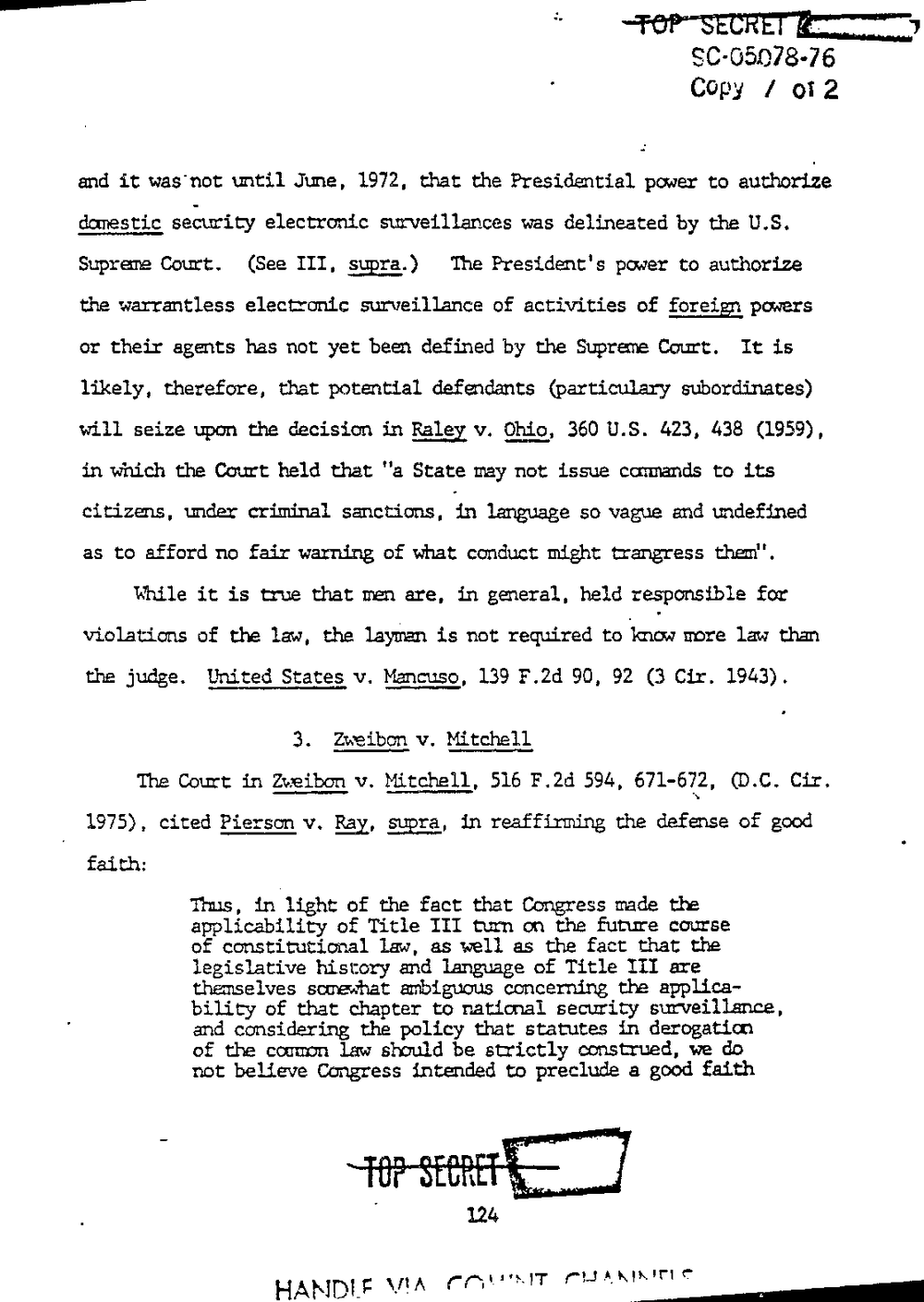
800507846
0093 2
and it was'not until June, 1972. that the Presidential power to authoriae
domestic security electronic surveillances was delineated by the U.S.
Supreme Court. (See m3.) 'Ihe President's power to authorize
the warrmitless electronic surveillance of activities of powers
or their agents has not yet hem defined by the Suprane Court. It is
likely, therefore, that potential defendants (particulary subordinates)
will seize upon the decision in Mm 91112, 360 U.S. 423, 438 (1959),
in which the Court held that "a State may not issue cmmands to its
citizens. under criminal sanctions. in language so vague and undefined
as to afford no fair warning of what conduct might trangress them".
While it is true that men are. in general. held responsible for
violations of the law, the layman is not required to more law than
the judge. United States v. W. 139 F.2d 90, 92 (3 Cir. 1943).
3. Zueibon v. Mitchell
The Court in Zweibon v. Mitchell, 516 F.2d 594, 671-672, (D.C. Cir.
1975), cited Pierson v. Ray. supra. in reaffirming the defense of good
faith:
Thus, in light of the fact that Congress made the
applicability of Title turn on the future course
of constitutional law, as well as the fact that the
legislative history and language of Title are
themselves somewhat ambiguous concerning the applica-
bility of that chapter to national security surveillance,
and considering the policy that statutes in derogation
of the commn law should be strictly construed, we do
not believe Congress intended to preclude a good faith
VFA r24
800507846
0093 2
and it was'not until June, 1972. that the Presidential power to authoriae
domestic security electronic surveillances was delineated by the U.S.
Supreme Court. (See m3.) 'Ihe President's power to authorize
the warrmitless electronic surveillance of activities of powers
or their agents has not yet hem defined by the Suprane Court. It is
likely, therefore, that potential defendants (particulary subordinates)
will seize upon the decision in Mm 91112, 360 U.S. 423, 438 (1959),
in which the Court held that "a State may not issue cmmands to its
citizens. under criminal sanctions. in language so vague and undefined
as to afford no fair warning of what conduct might trangress them".
While it is true that men are. in general. held responsible for
violations of the law, the layman is not required to more law than
the judge. United States v. W. 139 F.2d 90, 92 (3 Cir. 1943).
3. Zueibon v. Mitchell
The Court in Zweibon v. Mitchell, 516 F.2d 594, 671-672, (D.C. Cir.
1975), cited Pierson v. Ray. supra. in reaffirming the defense of good
faith:
Thus, in light of the fact that Congress made the
applicability of Title turn on the future course
of constitutional law, as well as the fact that the
legislative history and language of Title are
themselves somewhat ambiguous concerning the applica-
bility of that chapter to national security surveillance,
and considering the policy that statutes in derogation
of the commn law should be strictly construed, we do
not believe Congress intended to preclude a good faith
VFA r24
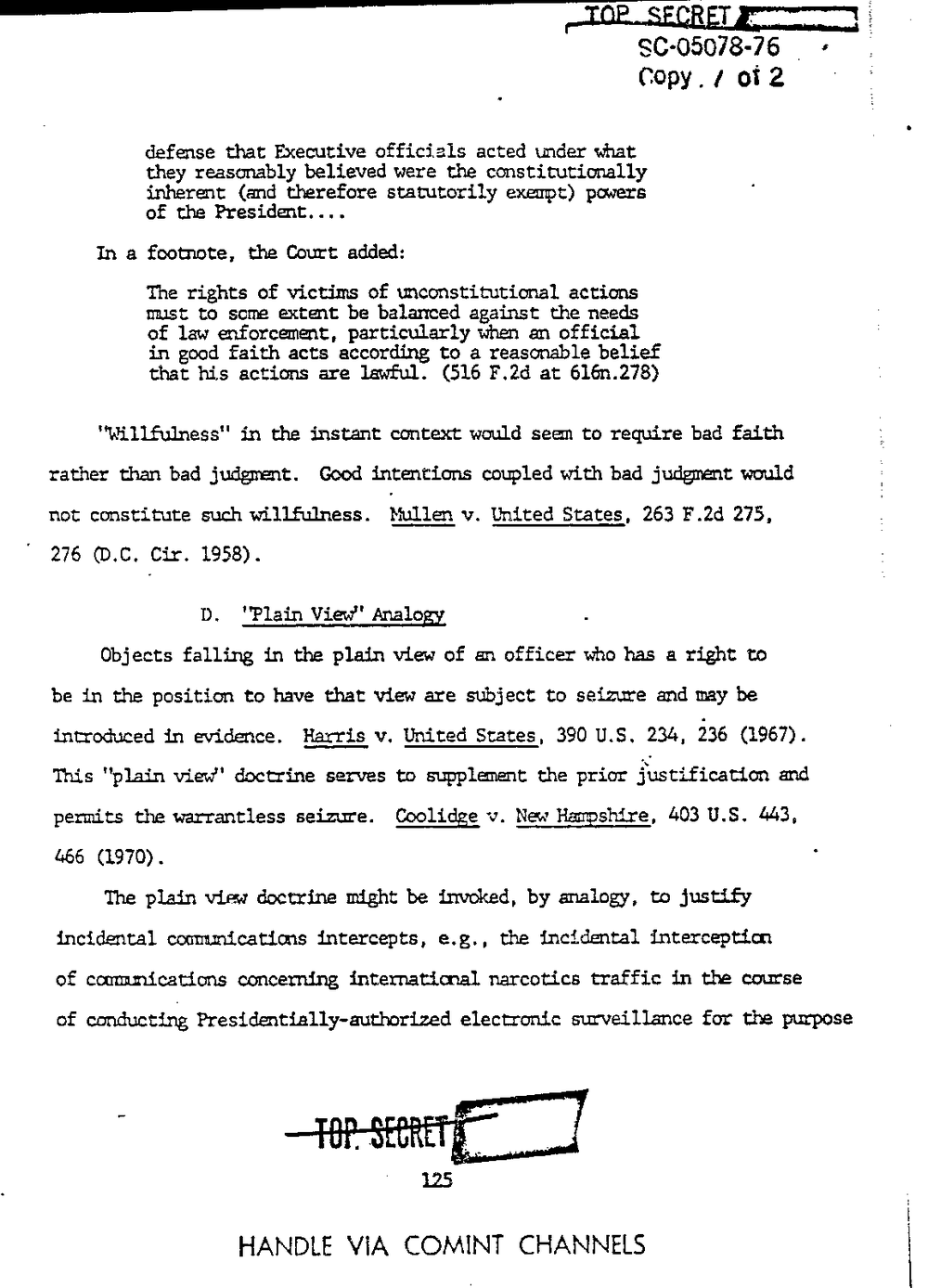
30-05078-76 3
Copy. of 2
defense that Executive officials acted under what
they reasonably believed were the constitutionally
inherent (and therefore stamtorily exempt) powers
of the President. . . .
In a footnote, the Court added:
The rights of victims of mconstitutional actions
trust to some extent be balanced against the needs
of law enforcement, particularly when an official
in good faith acts according to a reasonable belief
that his actions are lawful. (516 F.2d at 616n.278)
'M?llfulness" in the instant context would seem to require bad faith
rather than badjudgrrent. Good intentions coupled with bad judgment would
not constitute such willfl?ness. Mullen v. United States, 263 F.2d 275,
276 (D.C.. Cir. 1958).
I). "Plain View" Analogy
Objects falling in the plain View of an officer who has a right a:
be in the position to have that view are subject to seizure and may be
introduced in evidence. Harris v. United States. 390 1.1.5. 234, ?36 (1967).
This "plain view" doctrine serves to supplement the prior j?osti?oation and
permits the warrantless seizure. Coolidge v. New H?gshire. 403 11.3. 443.
466 (1970).
The plain View doctrine might be invoked, by analogy, to justify
incidental coummications intercepts, e. g. . the incidental interception
of coommications concerning internatimal narcotics traffic in the course
of conducting Presidentially?authorized electronic ameillance for the purpose
125
HANDLE VIA COMINT CHANNELS
30-05078-76 3
Copy. of 2
defense that Executive officials acted under what
they reasonably believed were the constitutionally
inherent (and therefore stamtorily exempt) powers
of the President. . . .
In a footnote, the Court added:
The rights of victims of mconstitutional actions
trust to some extent be balanced against the needs
of law enforcement, particularly when an official
in good faith acts according to a reasonable belief
that his actions are lawful. (516 F.2d at 616n.278)
'M?llfulness" in the instant context would seem to require bad faith
rather than badjudgrrent. Good intentions coupled with bad judgment would
not constitute such willfl?ness. Mullen v. United States, 263 F.2d 275,
276 (D.C.. Cir. 1958).
I). "Plain View" Analogy
Objects falling in the plain View of an officer who has a right a:
be in the position to have that view are subject to seizure and may be
introduced in evidence. Harris v. United States. 390 1.1.5. 234, ?36 (1967).
This "plain view" doctrine serves to supplement the prior j?osti?oation and
permits the warrantless seizure. Coolidge v. New H?gshire. 403 11.3. 443.
466 (1970).
The plain View doctrine might be invoked, by analogy, to justify
incidental coummications intercepts, e. g. . the incidental interception
of coommications concerning internatimal narcotics traffic in the course
of conducting Presidentially?authorized electronic ameillance for the purpose
125
HANDLE VIA COMINT CHANNELS
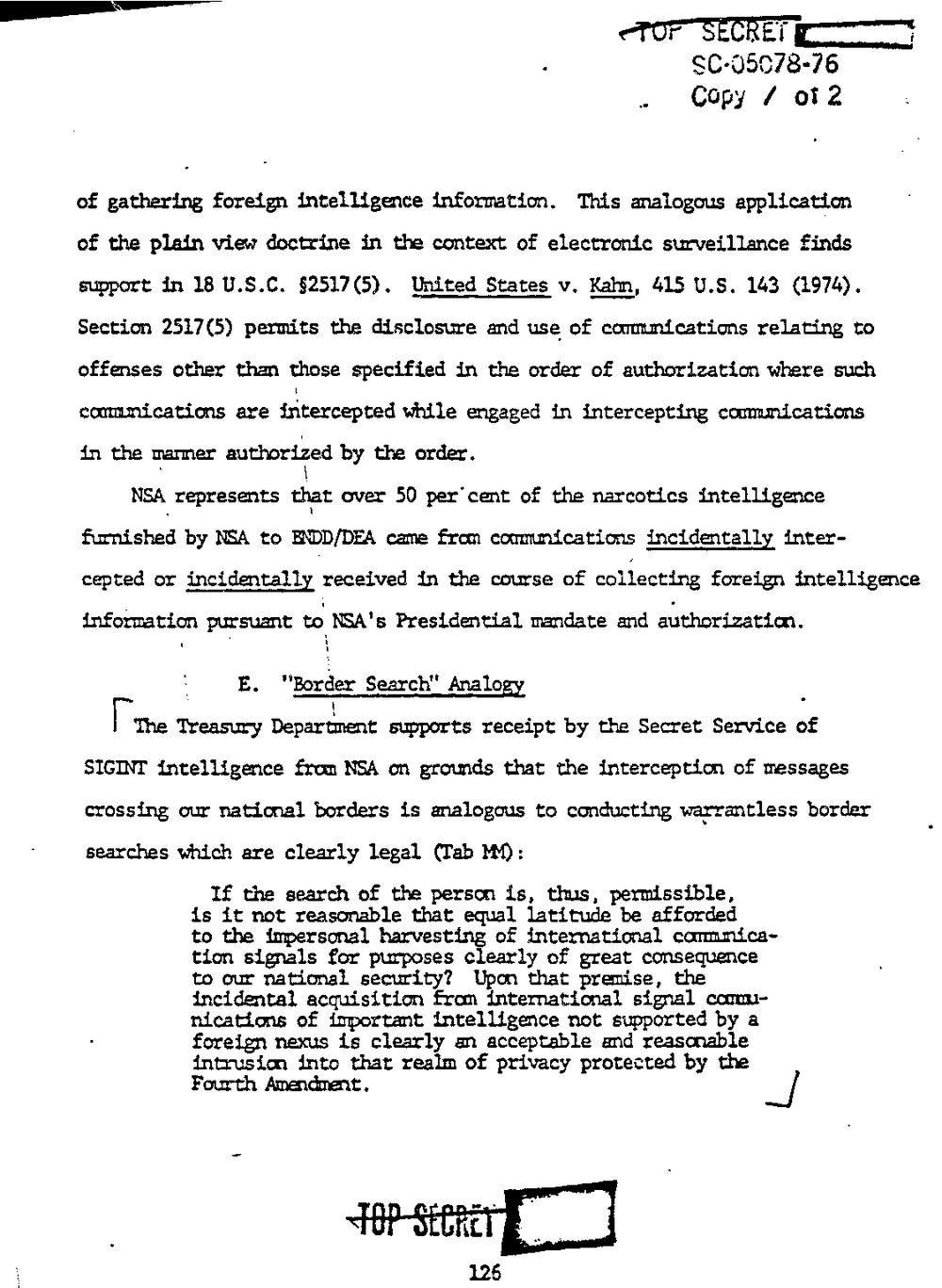
?zz:
80-05078-76
.. Copy 0t 2
of gathering foreign intelligence information. This analogous application
of the plain view doctrine in the context of electronic surveillance finds
wpport in 18 U.S.C. ?2517(5). United States v. Kahn, 415 U.S. 143 (1974).
Section 2517(5) permits the disclosure and use of cormmications relating to
offenses other than those specified in the order of authorization where such
coommicatims are intercepted while engaged in intercepting communications
in the earner authorized by the order.
NSA represents that over 50 per'cent of the narcotics intelligmce
furnished by NBA to came coumunicatims incidentallx inter-
cepted or incidmtallzreceived in the course of collecting foreign intelligence
information pursuant NSA's Presidential mdate and authorizatim.
E. "Border Search" Analogy .
r'lhe Treasury Depardment supports receipt by the Secret Service of
SIGINT intelligence from NSA on that the interception of messages
crossing our natimal borders is analogous to conducting mrrantless border
searches which are clearly legal (Tab Mi):
If the search of the person is, this, permissible.
is it not reasonable that equal latitude be afforded
to the impersonal harvesting of international canonica-
tion signals for purposes clearly of great consequence
to our national security? Upon that premise, the
incidental acquisition from international signal cumu?
nicaticns of ioportant intelligence not supported by a
foreign news is clearly an acceptable and reasonable
intrusim into that realm of privacy protected by the
Font}:
?zz:
80-05078-76
.. Copy 0t 2
of gathering foreign intelligence information. This analogous application
of the plain view doctrine in the context of electronic surveillance finds
wpport in 18 U.S.C. ?2517(5). United States v. Kahn, 415 U.S. 143 (1974).
Section 2517(5) permits the disclosure and use of cormmications relating to
offenses other than those specified in the order of authorization where such
coommicatims are intercepted while engaged in intercepting communications
in the earner authorized by the order.
NSA represents that over 50 per'cent of the narcotics intelligmce
furnished by NBA to came coumunicatims incidentallx inter-
cepted or incidmtallzreceived in the course of collecting foreign intelligence
information pursuant NSA's Presidential mdate and authorizatim.
E. "Border Search" Analogy .
r'lhe Treasury Depardment supports receipt by the Secret Service of
SIGINT intelligence from NSA on that the interception of messages
crossing our natimal borders is analogous to conducting mrrantless border
searches which are clearly legal (Tab Mi):
If the search of the person is, this, permissible.
is it not reasonable that equal latitude be afforded
to the impersonal harvesting of international canonica-
tion signals for purposes clearly of great consequence
to our national security? Upon that premise, the
incidental acquisition from international signal cumu?
nicaticns of ioportant intelligence not supported by a
foreign news is clearly an acceptable and reasonable
intrusim into that realm of privacy protected by the
Font}:
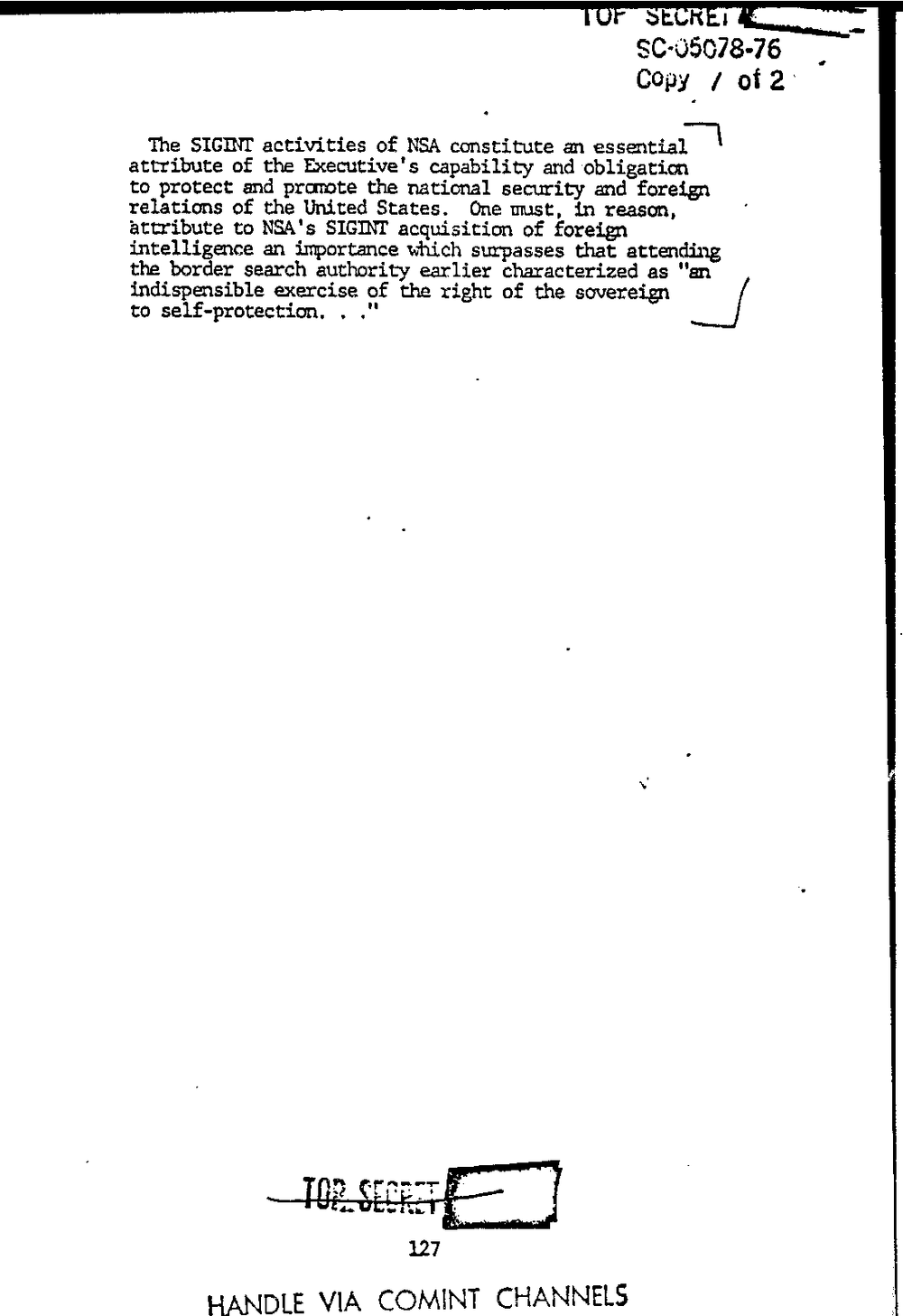
.
306507836
Copy of 2?
The SIGINT activities of NSA constitute an essential?_1
attribute of the Executive's capability and obligation
to protect and promote the national security and foreign
relations of the United States. One must, in reason.
attribute to NSA's SIGINT acquisition of foreign
intelligence an importance which surpasses that attending
the border search authority earlier characterized as "an
indispensible exercise of the right of the sovereign
to self-protection. .
HANDLE VIA COMINT CHANNELS
.
306507836
Copy of 2?
The SIGINT activities of NSA constitute an essential?_1
attribute of the Executive's capability and obligation
to protect and promote the national security and foreign
relations of the United States. One must, in reason.
attribute to NSA's SIGINT acquisition of foreign
intelligence an importance which surpasses that attending
the border search authority earlier characterized as "an
indispensible exercise of the right of the sovereign
to self-protection. .
HANDLE VIA COMINT CHANNELS
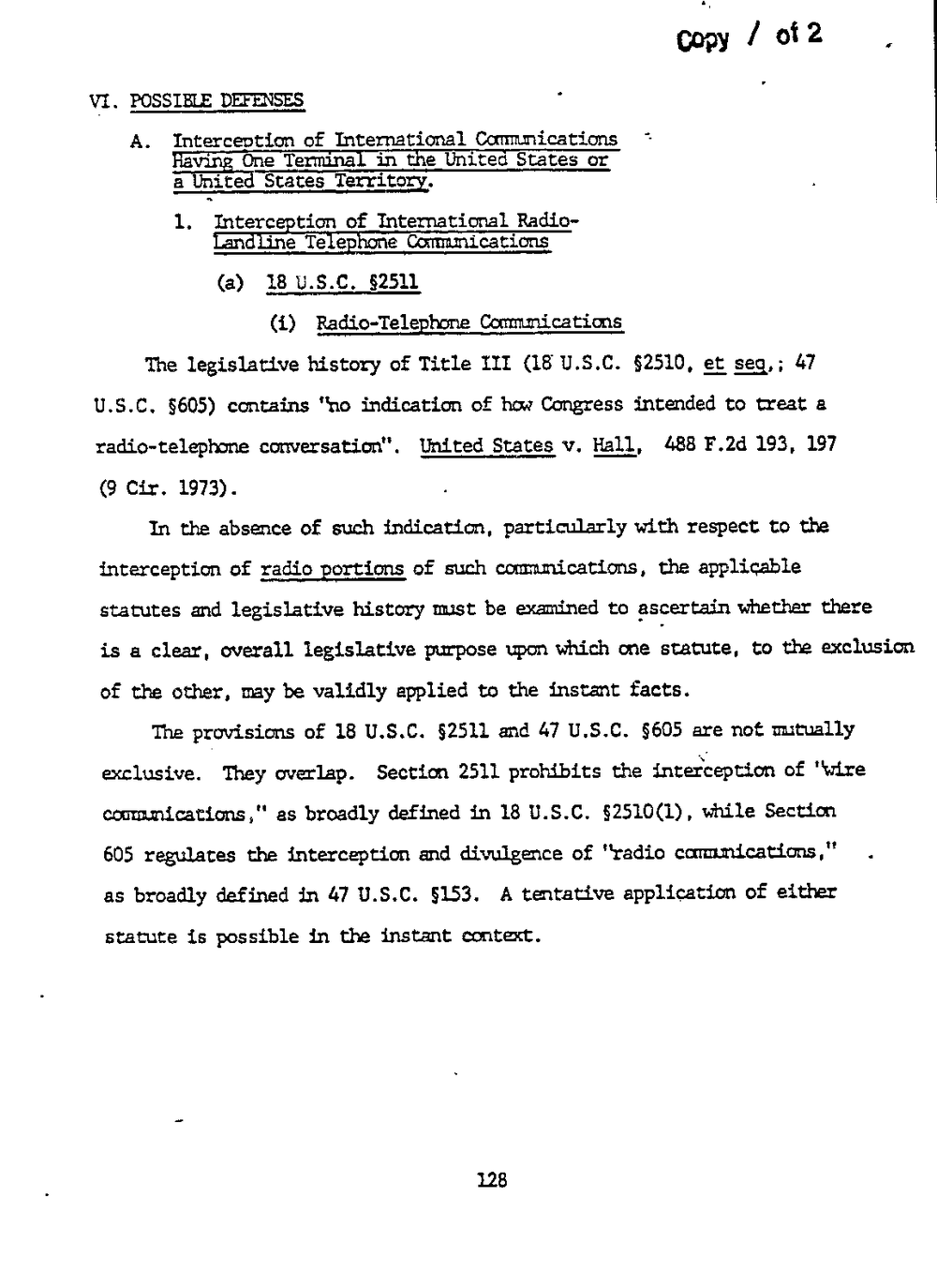
copy 0? 2 .
VI. POSSIBLE DEFENSES
A. Interception of International Cmnmications
Hiring One Terminal in the United States or
a United States Territog.
1. Interception of International Radio-
Landline Telephone gormmications
18 U.S.C. 52511
Radio-Telepl'me Cormmicatims
The legislative history of Title (18' U.S.C. 52510, at sad 47
U.S.C. 5605) contains 'ho indication of how Congress intended to treat a
radio-telephone conversation". United States v. Hall, 438 F.2d 193, 197
(9 Cir. 1973).
In the absence of such indication, particularly with respect to the
interception of radio portions of such coummications, the applicable
statutes and legislative history must be examined to ascertain whether there
is a clear. overall legislative purpose upon which one statute, to the exclusion
of the other, may be validly applied to the instant facts.
Tne provisions of 18 U.S.C. 52511 and 47 U.S.C. ?605 are not mutually
exclusive. They overlap. Section 2511 prohibits the interception of "wire
coummications," as broadly defined in 18 U.S.C. ?2510(l) while Section
605 regulates the interception and divulgence of "radio camunications."
as broadly defined in 47 U.S.C. 5153. A tentative application of either
statute is possible in the instant context.
128
copy 0? 2 .
VI. POSSIBLE DEFENSES
A. Interception of International Cmnmications
Hiring One Terminal in the United States or
a United States Territog.
1. Interception of International Radio-
Landline Telephone gormmications
18 U.S.C. 52511
Radio-Telepl'me Cormmicatims
The legislative history of Title (18' U.S.C. 52510, at sad 47
U.S.C. 5605) contains 'ho indication of how Congress intended to treat a
radio-telephone conversation". United States v. Hall, 438 F.2d 193, 197
(9 Cir. 1973).
In the absence of such indication, particularly with respect to the
interception of radio portions of such coummications, the applicable
statutes and legislative history must be examined to ascertain whether there
is a clear. overall legislative purpose upon which one statute, to the exclusion
of the other, may be validly applied to the instant facts.
Tne provisions of 18 U.S.C. 52511 and 47 U.S.C. ?605 are not mutually
exclusive. They overlap. Section 2511 prohibits the interception of "wire
coummications," as broadly defined in 18 U.S.C. ?2510(l) while Section
605 regulates the interception and divulgence of "radio camunications."
as broadly defined in 47 U.S.C. 5153. A tentative application of either
statute is possible in the instant context.
128
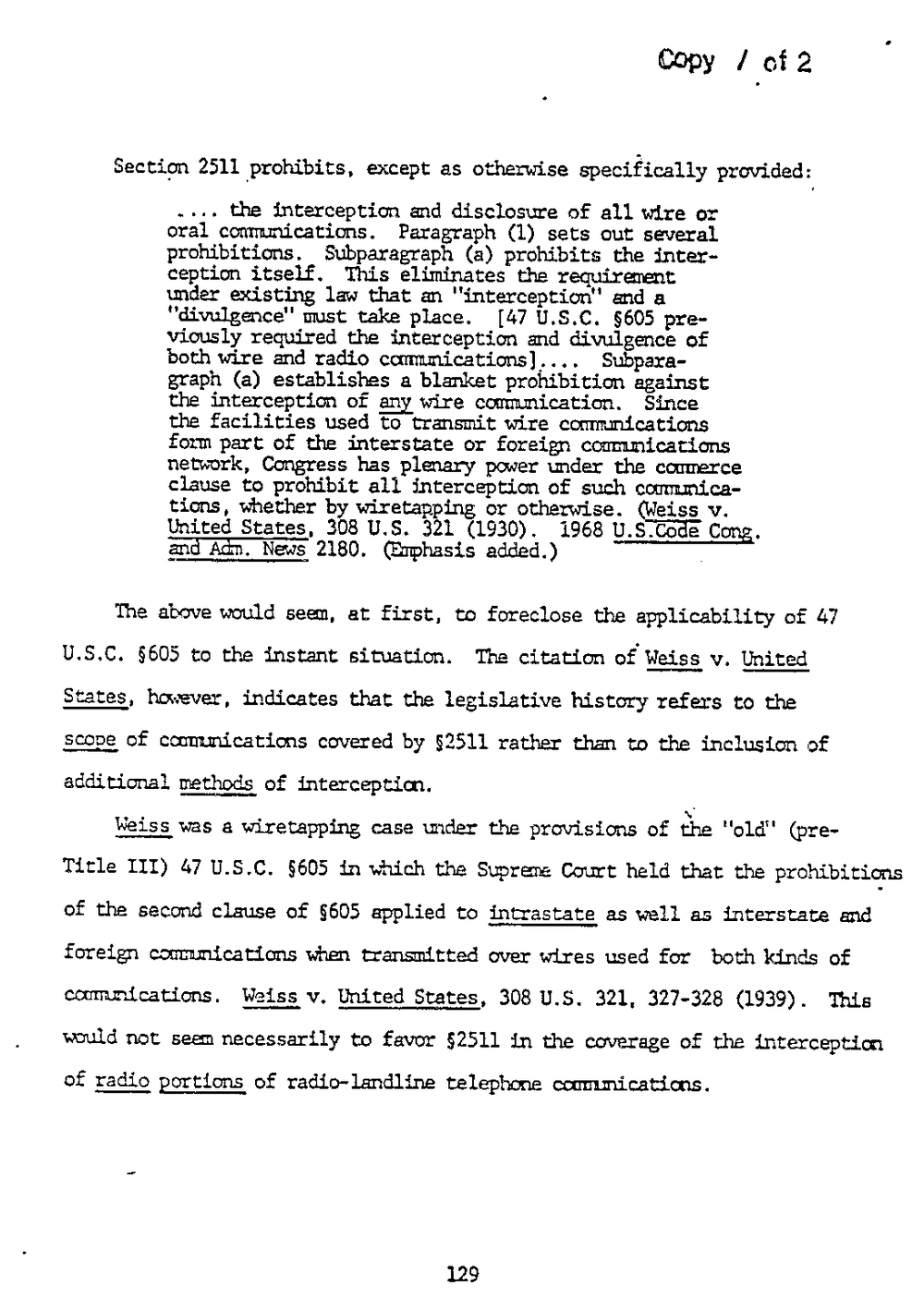
Com! Iiof2
Section 2511 prohibits, except as otherwise specifically provided:
. the interception and disclosure of all wire or
oral communications. Paragraph (1) sets out several
prohibitions. Subparagraph prohibits the inter-
caption itself. This eliminates the requirement
under existing law that an "interception" and a
"divulgence" must take place. [47 U.S.C. 5605 pre-
viously required the interception and divulgence of
both wire and radio . . . Subpara-
graph establishes a blanket prohibition against
the interception of ?wire communication. Since
the facilities used to transmit wire communications
form part of the interstate or foreign comnmicatimis
network, Congress has plenary power under the commerce
clause to prohibit all interception of such counuiica-
tions, whether by wiretapping or otherwise. (Weiss v.
United States, 308 U.S. 321 (1930). 1968 U.S.Code CE.
2180. (Emphasis added.)
The above would seem. at first, to foreclose the applicability of 1+7
U.S.C. 5605 to the instant situation. The citation v.
?a_te_s. however, indicates that the legislative history refers to the
?_cr_3p_e_ of communicatims covered by 52511 rather than to the inclusion of
additional of interception.
Ewes a wiretapping case under the provisions of "old" (pre-
Title 47 U.S.C. 5605 in which the Supreme Co-txrt held that the prohibitions
of the second clause of ?605 applied to intrastate as well as interstate and
foreign comomications when transmitted over wires used for both kinds of
empirications. Weiss v. United States. 308 U.S. 321. 327-328 (1939). This
would not seen necessarily to favor ?2511 in the coverage of the interception
of 3.3132 portions of radio-laidhne telephone coummicatims.
129
Com! Iiof2
Section 2511 prohibits, except as otherwise specifically provided:
. the interception and disclosure of all wire or
oral communications. Paragraph (1) sets out several
prohibitions. Subparagraph prohibits the inter-
caption itself. This eliminates the requirement
under existing law that an "interception" and a
"divulgence" must take place. [47 U.S.C. 5605 pre-
viously required the interception and divulgence of
both wire and radio . . . Subpara-
graph establishes a blanket prohibition against
the interception of ?wire communication. Since
the facilities used to transmit wire communications
form part of the interstate or foreign comnmicatimis
network, Congress has plenary power under the commerce
clause to prohibit all interception of such counuiica-
tions, whether by wiretapping or otherwise. (Weiss v.
United States, 308 U.S. 321 (1930). 1968 U.S.Code CE.
2180. (Emphasis added.)
The above would seem. at first, to foreclose the applicability of 1+7
U.S.C. 5605 to the instant situation. The citation v.
?a_te_s. however, indicates that the legislative history refers to the
?_cr_3p_e_ of communicatims covered by 52511 rather than to the inclusion of
additional of interception.
Ewes a wiretapping case under the provisions of "old" (pre-
Title 47 U.S.C. 5605 in which the Supreme Co-txrt held that the prohibitions
of the second clause of ?605 applied to intrastate as well as interstate and
foreign comomications when transmitted over wires used for both kinds of
empirications. Weiss v. United States. 308 U.S. 321. 327-328 (1939). This
would not seen necessarily to favor ?2511 in the coverage of the interception
of 3.3132 portions of radio-laidhne telephone coummicatims.
129
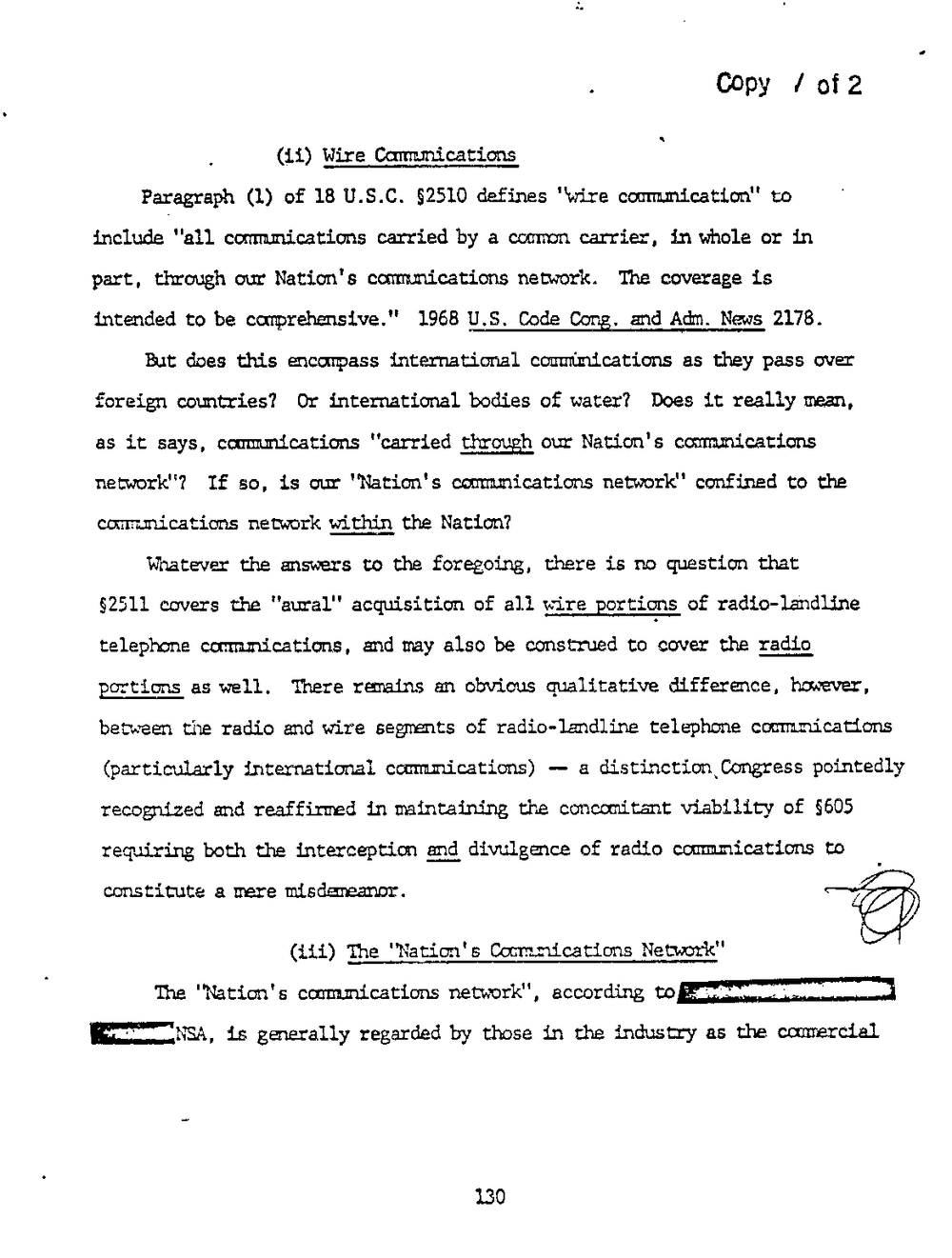
Copy lof2
(ii) Wire Cmnmications
Paragraph (1) of 18 U.S.C. 52510 defines "wire coummication" to
include "all cmmications carried by a common carrier, in whole or in
part, through our Nation's cmications nemork. The coverage is
intended to be 1968 U.S. Code Cong. and Adm. News 2178.
But does this encompass international coonin?cations as they pass over
foreign countries? Or international bodies of water? Does it really mean,
as it says, coummications "carried our Nation's conmmications
network"? If so, is our "Nation's commications network" confined to the
amications network the Nation?
Whatever the answers to the foregoing, there is no question that
?2511 covers the "aural" acquisition of all wire portions of radio-la'ndline
telephone omnmications. and may also be construed to cover the
portions as well. There remins an obvious qualitative difference, however,
between the radio and wire of radio-landline telephone cmmicadons
(particularly international counnmications) -- a distinction?Congress pointedly
recognized and reaffirmed in maintaining the conudtant viability of ?605
requiring both the interception and divulgence of radio coummications to
constitute a mere misdemeanor.
The 'Nation's Network"
The "Nation's network", according to
Essa, is generally regarded by those in the industry as the cmmercial
1.30
Copy lof2
(ii) Wire Cmnmications
Paragraph (1) of 18 U.S.C. 52510 defines "wire coummication" to
include "all cmmications carried by a common carrier, in whole or in
part, through our Nation's cmications nemork. The coverage is
intended to be 1968 U.S. Code Cong. and Adm. News 2178.
But does this encompass international coonin?cations as they pass over
foreign countries? Or international bodies of water? Does it really mean,
as it says, coummications "carried our Nation's conmmications
network"? If so, is our "Nation's commications network" confined to the
amications network the Nation?
Whatever the answers to the foregoing, there is no question that
?2511 covers the "aural" acquisition of all wire portions of radio-la'ndline
telephone omnmications. and may also be construed to cover the
portions as well. There remins an obvious qualitative difference, however,
between the radio and wire of radio-landline telephone cmmicadons
(particularly international counnmications) -- a distinction?Congress pointedly
recognized and reaffirmed in maintaining the conudtant viability of ?605
requiring both the interception and divulgence of radio coummications to
constitute a mere misdemeanor.
The 'Nation's Network"
The "Nation's network", according to
Essa, is generally regarded by those in the industry as the cmmercial
1.30
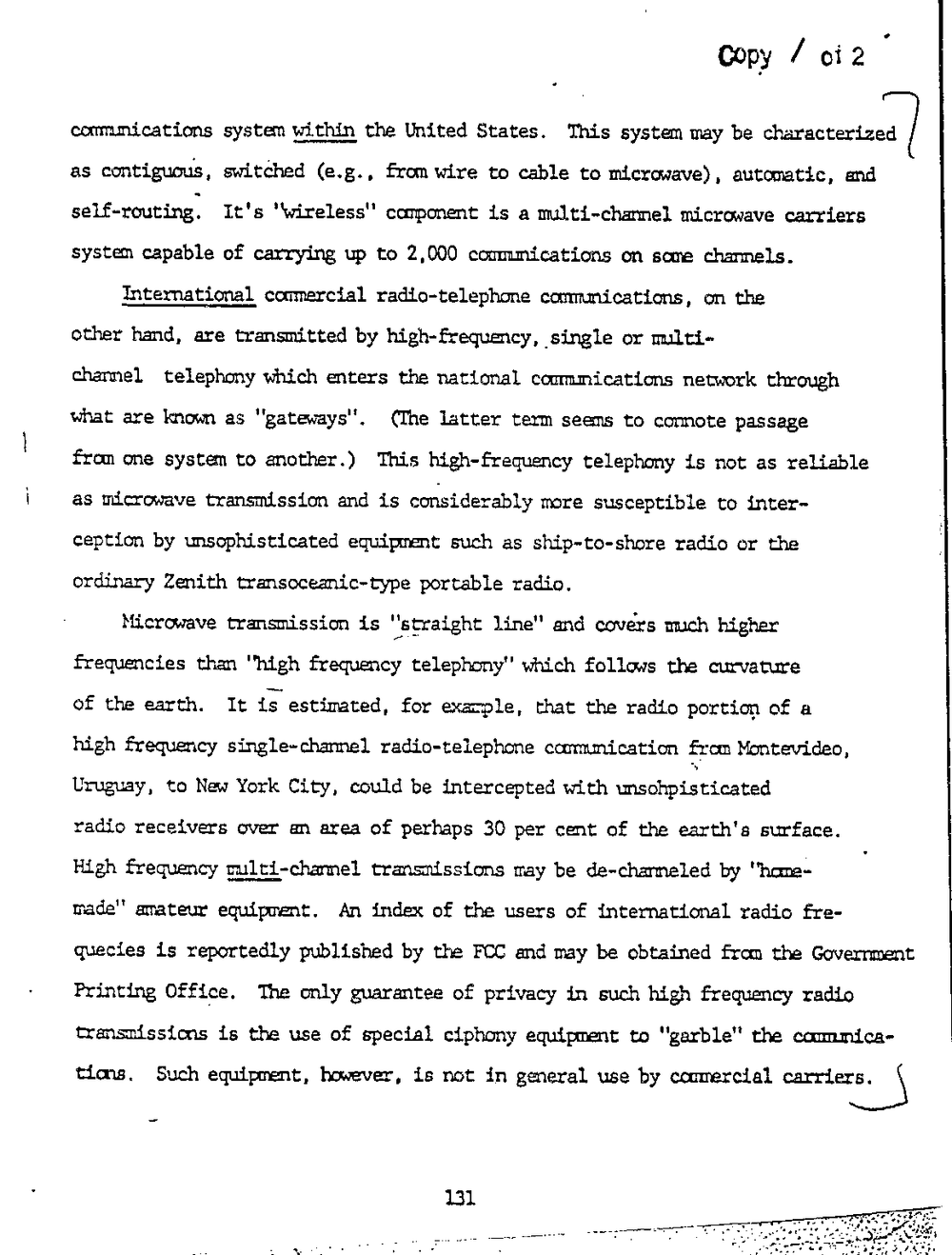
.5
0
Copy of 2
system within the United States. This system may be characterized?
as contiguous, switched from wire to cable to micron-rave). autocratic, and
self-routing: It's Hwireless? corponent is a mJlti?chamel micrmave carriers
system capable of carrying up to 2,000 couumications on some channels.
International commercial radio-telephone coommicatiorm. on the
other hand, are transmitted by high-frequency, _single or multi-
chazmel telephony which enters the national comunications network through
what are known as "gateways". (The latter term sews to connote passage
from one systan to another.) This high-frequency telephony is not as reliable
as microwave transmission and is considerably more susceptible to inter-
ception by unsophisticated equip-amt such as ship-to-shore radio or the
ordinary Zenith trmsocemic-type portable radio.
Microwave transmission is 'lstraight line" and covers much higher
frequencies than "high frequency telephony" which follows the mrrvattre
of the earth. It is estimated, for eats-cple, that the radio portion of a
high frequency singlewcharmel radio-telephone {from Montevideo.
Uruguay, to New York City, could be intercepted with msohpisticated
radio receivers over an area of perhaps 30 per cent of the earth's surface.
High frequency gig-ma may be de-charmeled by "ham;
made" amateur equipment. An index of the users of international radio fre-
quecies is reportedly published by the FCC and may be obtained from the Covert-mt
Printing Office. The only guarantee of privacy in such high frequency radio
maximissims is the use of special ciphony equipment to "garble" the ccummica-
tims. Such equipumt, hmmer. is not in general use by commercial carrich
131
part;
n- "1 r.
. Jul-Jig: fedm?
#5
.5
0
Copy of 2
system within the United States. This system may be characterized?
as contiguous, switched from wire to cable to micron-rave). autocratic, and
self-routing: It's Hwireless? corponent is a mJlti?chamel micrmave carriers
system capable of carrying up to 2,000 couumications on some channels.
International commercial radio-telephone coommicatiorm. on the
other hand, are transmitted by high-frequency, _single or multi-
chazmel telephony which enters the national comunications network through
what are known as "gateways". (The latter term sews to connote passage
from one systan to another.) This high-frequency telephony is not as reliable
as microwave transmission and is considerably more susceptible to inter-
ception by unsophisticated equip-amt such as ship-to-shore radio or the
ordinary Zenith trmsocemic-type portable radio.
Microwave transmission is 'lstraight line" and covers much higher
frequencies than "high frequency telephony" which follows the mrrvattre
of the earth. It is estimated, for eats-cple, that the radio portion of a
high frequency singlewcharmel radio-telephone {from Montevideo.
Uruguay, to New York City, could be intercepted with msohpisticated
radio receivers over an area of perhaps 30 per cent of the earth's surface.
High frequency gig-ma may be de-charmeled by "ham;
made" amateur equipment. An index of the users of international radio fre-
quecies is reportedly published by the FCC and may be obtained from the Covert-mt
Printing Office. The only guarantee of privacy in such high frequency radio
maximissims is the use of special ciphony equipment to "garble" the ccummica-
tims. Such equipumt, hmmer. is not in general use by commercial carrich
131
part;
n- "1 r.
. Jul-Jig: fedm?
#5
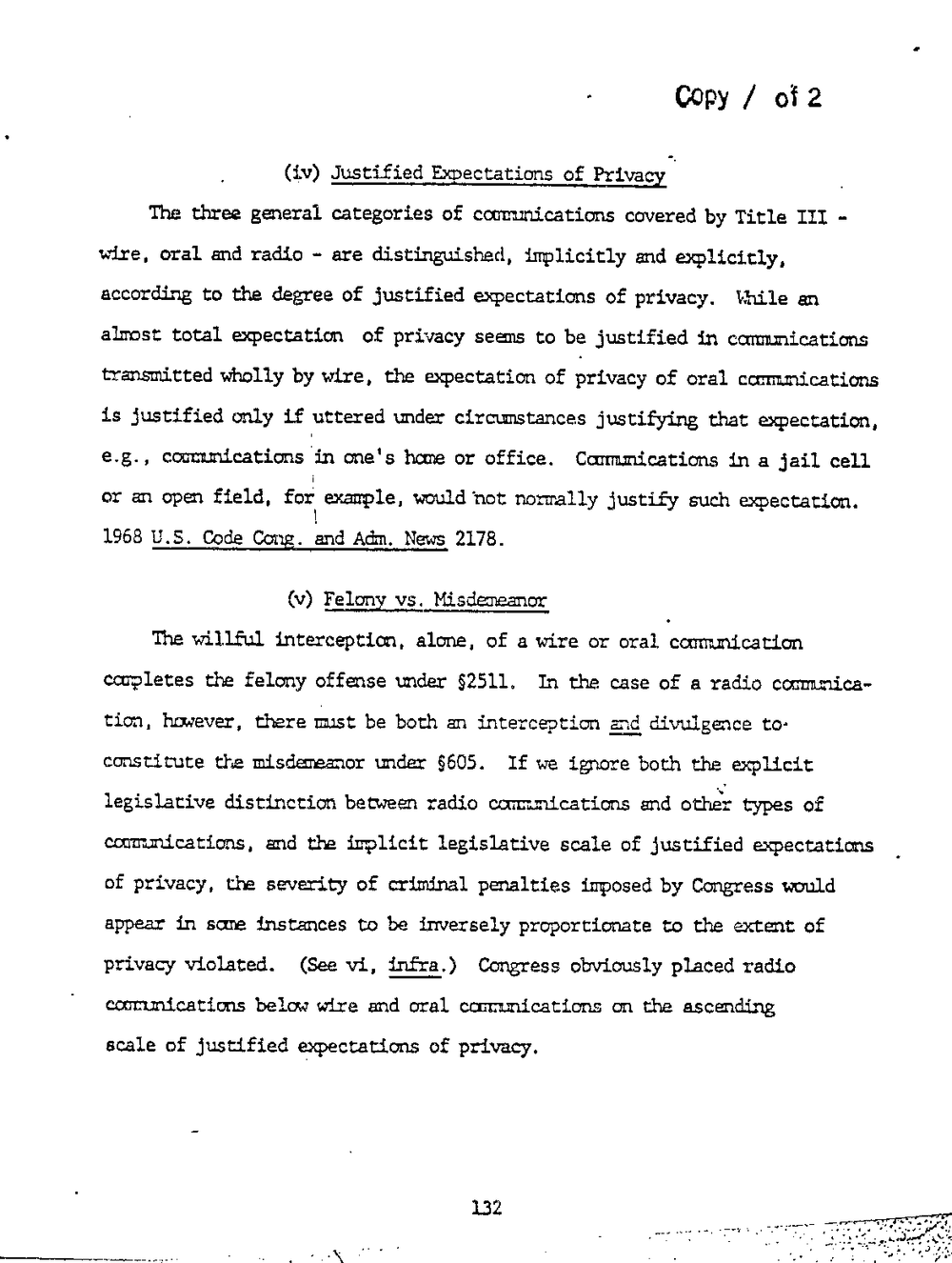
COPY o'f2
(iv) Justified Expectations of Privacy.-
The three general categories of communications covered by Title
wire, oral and radio - are distinguished, implicitly and explicitly,
according to the degree of justified expectations of privacy. bhile an
almost total expectation of privacy seems to be justified in cmmications
wholly by wire, the expectation of trivacy of oral coommications
is justified only if uttered under justifying that expectation,
coommications :in one's home or office. in a jail cell
or an opau field, for:? example. would ?not normally justify such expectation.
1968 v.5. Code Cong. and Adm. News 2178.
Felony vs. Misdemeanor
The willful interception, alone. of a wire or oral communication
con-plates the felony offense under 52511. In the case of a radio coommica-
tion, however, there roast be both an interception and divulgence to?
constitute the misdaneanor mder ?605. If we ignore both the explicit
legislative distinction between radio cmnuiications and other types of
mud the implicit legislative scale of justified expectations
of privacy. the severity of criminal penalties imposed by Congress would
appear in sane instances to be inversely proportionate to the extent of
privacy violated. (See vi, Congress obviously placed radio
communications below wire and oral carrmications on the ascending
scale of justified expectations of privacy.
132
COPY o'f2
(iv) Justified Expectations of Privacy.-
The three general categories of communications covered by Title
wire, oral and radio - are distinguished, implicitly and explicitly,
according to the degree of justified expectations of privacy. bhile an
almost total expectation of privacy seems to be justified in cmmications
wholly by wire, the expectation of trivacy of oral coommications
is justified only if uttered under justifying that expectation,
coommications :in one's home or office. in a jail cell
or an opau field, for:? example. would ?not normally justify such expectation.
1968 v.5. Code Cong. and Adm. News 2178.
Felony vs. Misdemeanor
The willful interception, alone. of a wire or oral communication
con-plates the felony offense under 52511. In the case of a radio coommica-
tion, however, there roast be both an interception and divulgence to?
constitute the misdaneanor mder ?605. If we ignore both the explicit
legislative distinction between radio cmnuiications and other types of
mud the implicit legislative scale of justified expectations
of privacy. the severity of criminal penalties imposed by Congress would
appear in sane instances to be inversely proportionate to the extent of
privacy violated. (See vi, Congress obviously placed radio
communications below wire and oral carrmications on the ascending
scale of justified expectations of privacy.
132
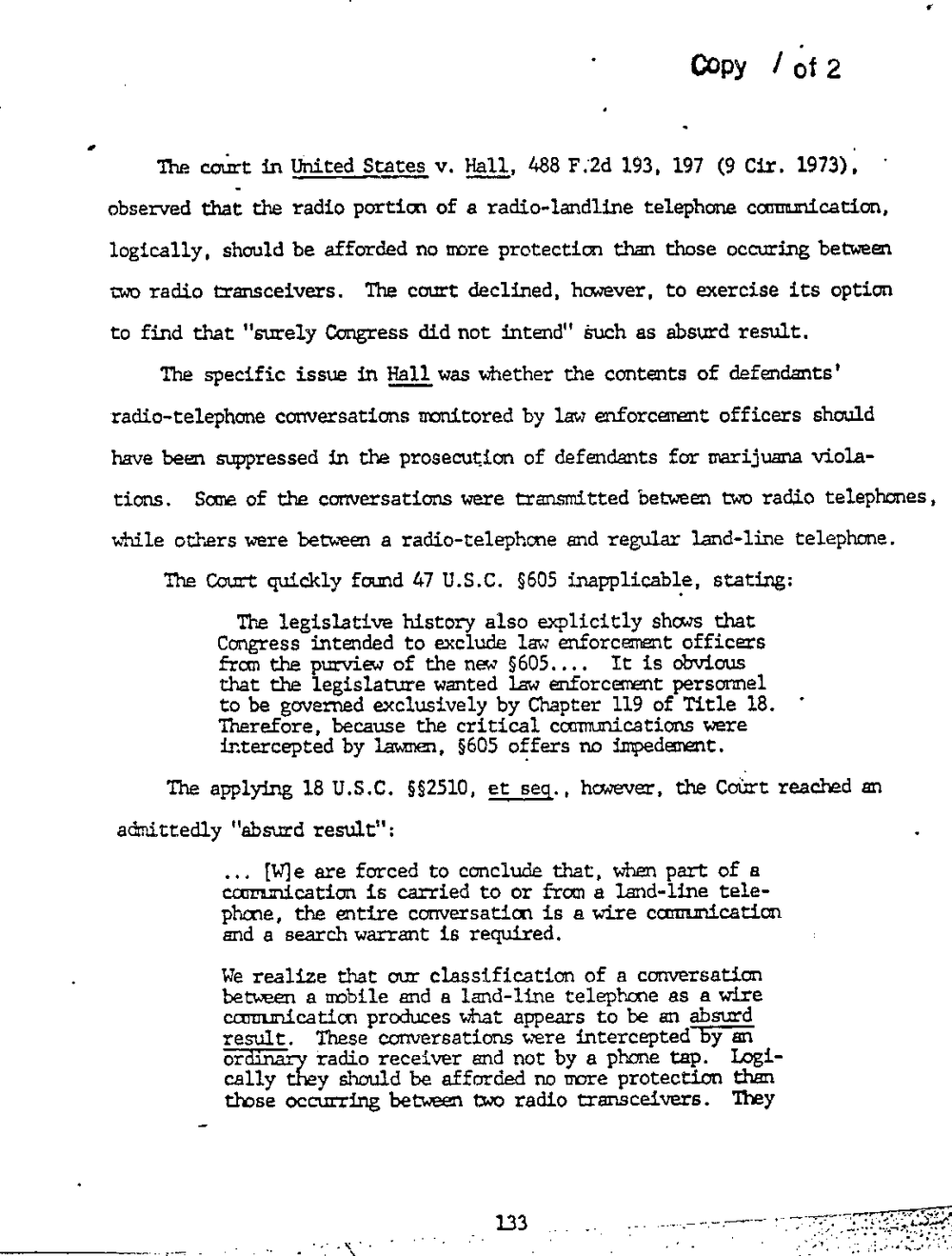
Copy l?tz
The court in United States v. gag, 488 F.2d 193. 197 (9 cu. 1973),
observed the radio portion of a radio-landline telephone communication,
logically, should be afforded no more protection than those occuring between
two radio transceivers. The court declined, however, to exercise its option
to find that "surely Congress did not intend" ?such as absurd result.
The specific issue in Hillwas whether the contents of defendants'
radio-telephone conversations monitored by law enforth officers should
have been suppressed in the prosecution of defendants for marijuana viola-
tions. Some of the conversations were transmitted between two radio telephones,
while others were betwsen a radio-telephone and regular land-line telephone.
The Court quickly found 1+7 U.S.C. 5605 inapplicable, stating:
The legislative history also explicitly shows that
Congress intended to exclude law enforcenmt officers
from the purview of the new It is obvious
that the legislature wanted law enforcement personnel
to be governed exclusively by Chapter 119 of Title 18.
Therefore, because the critical conninnications were
intercepted by lawnen, ?605 offers no impedenent.
'I'he applying 18 U.S.C. ??2510, et seg., however, the Court reached an
adnittedly "absurd result":
[We are forced to conclude that, when part of a
is carried to or from a land-line tele-
phone, the entire conversation is a wire canmmicatim
and a search warrant is required.
We realize that our classification of a conversation
between a mobile and a land-line telephone as a wire
produces what appears to be an absurd
result. These conversations were intercepted By an
Ewen-mm receiver and not by a phone tap. Logi-
cally should be afforded no sore protection than
those occurring between two radio transceivers. They
Copy l?tz
The court in United States v. gag, 488 F.2d 193. 197 (9 cu. 1973),
observed the radio portion of a radio-landline telephone communication,
logically, should be afforded no more protection than those occuring between
two radio transceivers. The court declined, however, to exercise its option
to find that "surely Congress did not intend" ?such as absurd result.
The specific issue in Hillwas whether the contents of defendants'
radio-telephone conversations monitored by law enforth officers should
have been suppressed in the prosecution of defendants for marijuana viola-
tions. Some of the conversations were transmitted between two radio telephones,
while others were betwsen a radio-telephone and regular land-line telephone.
The Court quickly found 1+7 U.S.C. 5605 inapplicable, stating:
The legislative history also explicitly shows that
Congress intended to exclude law enforcenmt officers
from the purview of the new It is obvious
that the legislature wanted law enforcement personnel
to be governed exclusively by Chapter 119 of Title 18.
Therefore, because the critical conninnications were
intercepted by lawnen, ?605 offers no impedenent.
'I'he applying 18 U.S.C. ??2510, et seg., however, the Court reached an
adnittedly "absurd result":
[We are forced to conclude that, when part of a
is carried to or from a land-line tele-
phone, the entire conversation is a wire canmmicatim
and a search warrant is required.
We realize that our classification of a conversation
between a mobile and a land-line telephone as a wire
produces what appears to be an absurd
result. These conversations were intercepted By an
Ewen-mm receiver and not by a phone tap. Logi-
cally should be afforded no sore protection than
those occurring between two radio transceivers. They
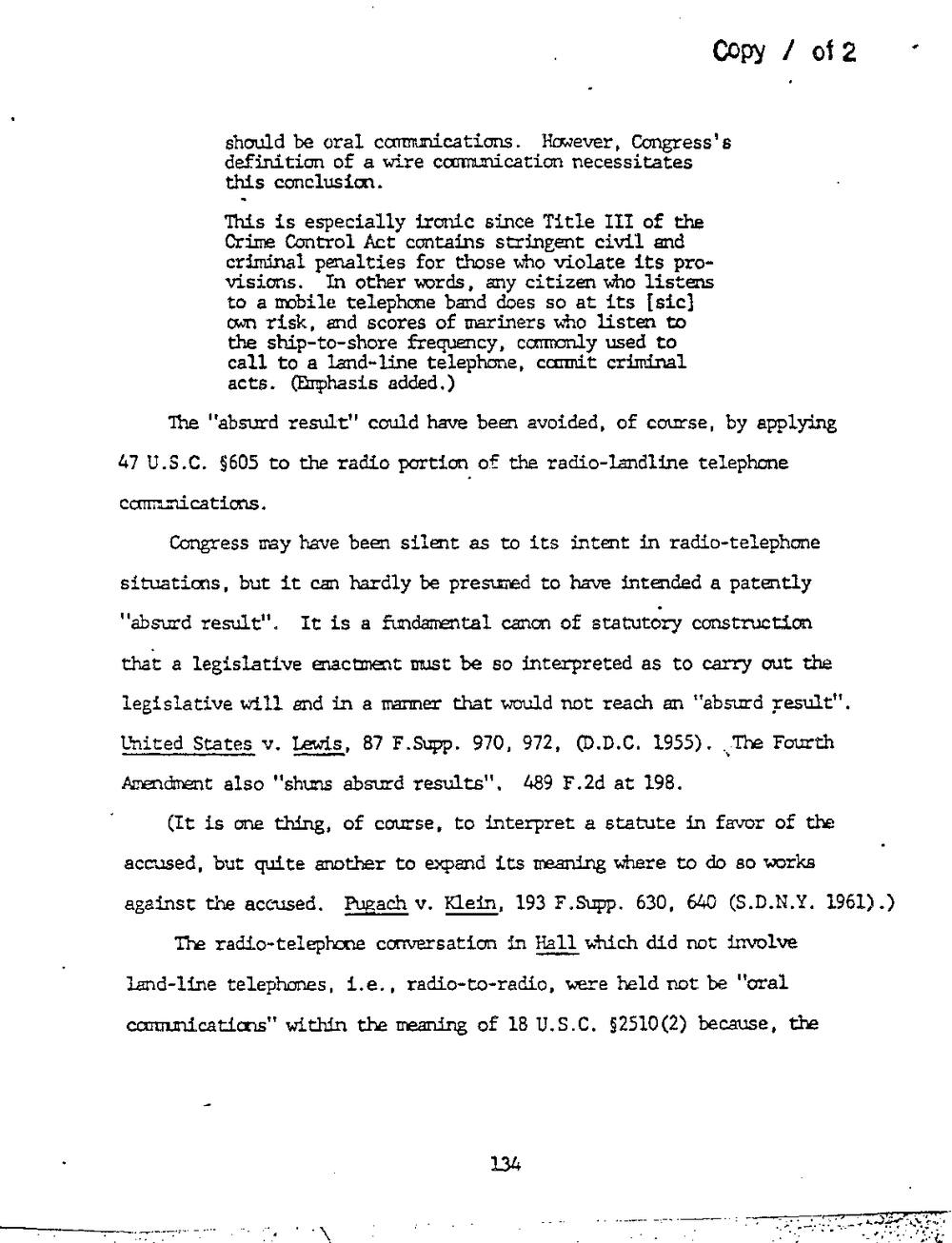
Copy/om
should be oral cmmnications. Hmever, Congress?s
definition of a wire coummication necessitates
this conclusion.
This is especially ironic since Title of the
Crime Control Act contains stringent civil and
criminal penalties for those who violate its pro-
visions. In other words, any citizen who listens
to a mobile telephone band does so at its [sic]
own risk, and scores of mariners who listen to
the ship-to?shore frequency, commonly used to
call to a land-line telephone, commit criminal
acts. (Exphasis added.)
The "absurd result" could have been avoided, of course, by applying
47 U.S.C. 5605 to the radio portion of the radio-landline telephone
connimications.
Congress may have been silmt as to its intent in radio-telephone
situations, but it can hardly be presumed to have intended a patently
"absurd result", It is a fmdamental canon of statutory construction
that a legislative math must be so interpreted as to carry out the
legislative will and in a name: that would not reach an "absurd result".
United States v. Lewis, 87 F.5upp. 970, 972, (D.D.C. 1955). Fourth
mam: also "shuns absurd results". 489 F.2d at 198.
(It is one thing, of course, to interpret a statute in favor of the
accused, but quite another to expand its meaning where to do so works
against the accused. ngach v. Klein, 193 F.Supp. 630, 640 (S.D.N.Y. 1961).)
The radio-telephone conversation in Hall which did not involve
land-line telephones, i.e. radio?to-radio, were held not be "oral
oocrmnicatims" within the meaning of 18 U.S.C. ?2510(2) betause
Copy/om
should be oral cmmnications. Hmever, Congress?s
definition of a wire coummication necessitates
this conclusion.
This is especially ironic since Title of the
Crime Control Act contains stringent civil and
criminal penalties for those who violate its pro-
visions. In other words, any citizen who listens
to a mobile telephone band does so at its [sic]
own risk, and scores of mariners who listen to
the ship-to?shore frequency, commonly used to
call to a land-line telephone, commit criminal
acts. (Exphasis added.)
The "absurd result" could have been avoided, of course, by applying
47 U.S.C. 5605 to the radio portion of the radio-landline telephone
connimications.
Congress may have been silmt as to its intent in radio-telephone
situations, but it can hardly be presumed to have intended a patently
"absurd result", It is a fmdamental canon of statutory construction
that a legislative math must be so interpreted as to carry out the
legislative will and in a name: that would not reach an "absurd result".
United States v. Lewis, 87 F.5upp. 970, 972, (D.D.C. 1955). Fourth
mam: also "shuns absurd results". 489 F.2d at 198.
(It is one thing, of course, to interpret a statute in favor of the
accused, but quite another to expand its meaning where to do so works
against the accused. ngach v. Klein, 193 F.Supp. 630, 640 (S.D.N.Y. 1961).)
The radio-telephone conversation in Hall which did not involve
land-line telephones, i.e. radio?to-radio, were held not be "oral
oocrmnicatims" within the meaning of 18 U.S.C. ?2510(2) betause
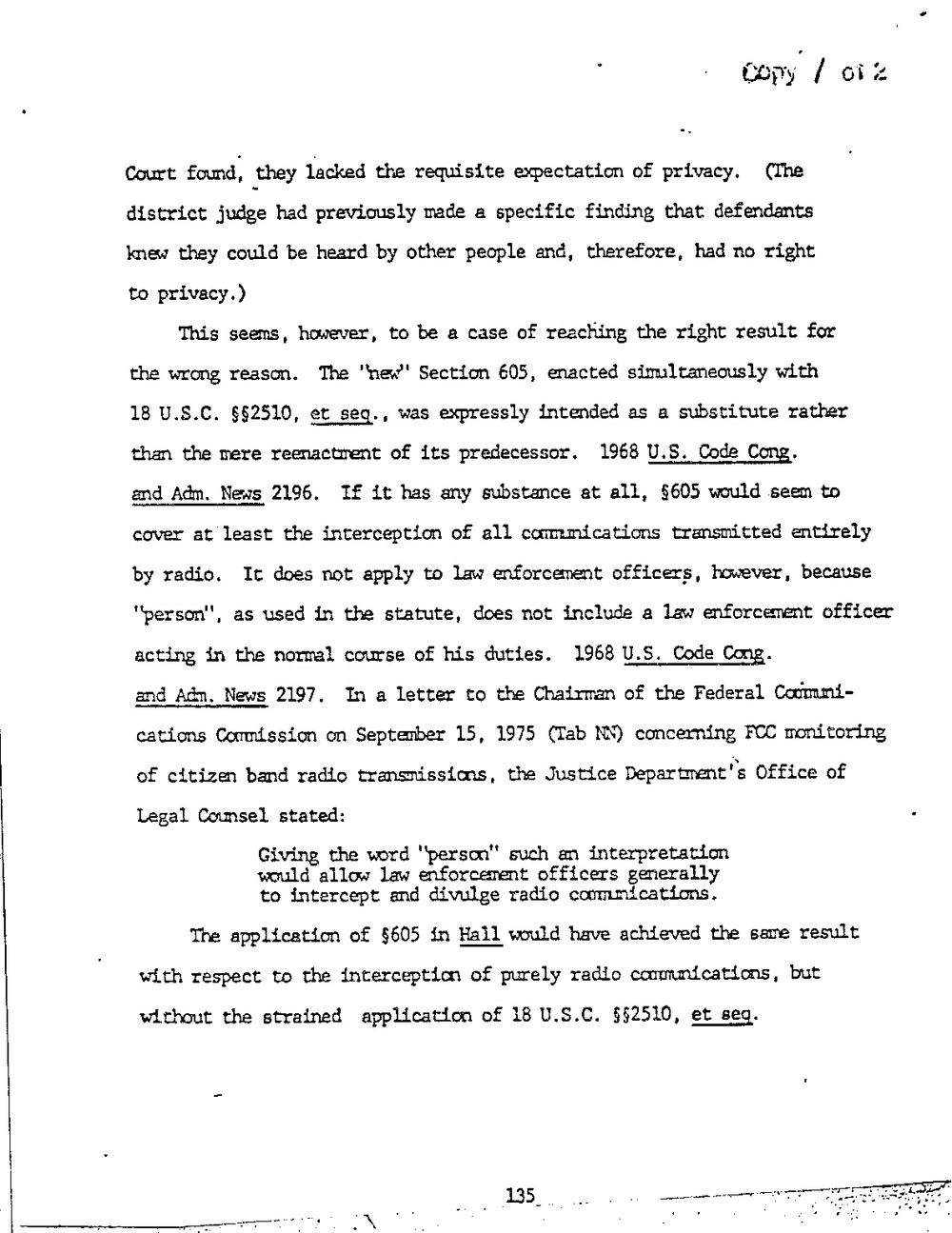
mp'y? 0i 1:
Court found. .they lacked the requisite expectation of privacy. (The
district judge had previously made a specific finding that defendants
knew they could be heard by other people and, therefore, had no right
to privacy.)
This seems, homer, to be a case of reaching the right result for
the wrong reason. The "new" Section 605, enacted sinmltaneously with
18 U.S.C. ??2510, $353., was expressly intended as a substitute rather
than the mere reenactment of its predecessor. 1968 U.S. Code Cg_ng.
and Adm. News 2196. If it has any substance at all, ?605 would seem to
cover at'least the interception of all commications entirely
by radio. It does not apply to law enforcement officer-gs, however, because
"person", as used in the stamte, does not include a law officer
acting in the normal course of his duties. 1968 13.5. Code Qg.
and Ada. News 2197. In a letter to the Chairman of the Federal Commi-
cations Commission on Septanber 15. 1975 (Tab NN) concerning FCC monitoring
of citizen band radio transmissims. the Justice Department?s Office of
Legal Counsel stated:
Giving the word "person" such an interpretation
would allow law enforcemait officers generally
to intercept and divulge radio cmications.
The application of 55605 in Hall would have achieved the same result
with respect to the interception of purely radio ccnmunicatims, but
without the strained application of 18 U.S.C. 552510, at sagwt.?
mp'y? 0i 1:
Court found. .they lacked the requisite expectation of privacy. (The
district judge had previously made a specific finding that defendants
knew they could be heard by other people and, therefore, had no right
to privacy.)
This seems, homer, to be a case of reaching the right result for
the wrong reason. The "new" Section 605, enacted sinmltaneously with
18 U.S.C. ??2510, $353., was expressly intended as a substitute rather
than the mere reenactment of its predecessor. 1968 U.S. Code Cg_ng.
and Adm. News 2196. If it has any substance at all, ?605 would seem to
cover at'least the interception of all commications entirely
by radio. It does not apply to law enforcement officer-gs, however, because
"person", as used in the stamte, does not include a law officer
acting in the normal course of his duties. 1968 13.5. Code Qg.
and Ada. News 2197. In a letter to the Chairman of the Federal Commi-
cations Commission on Septanber 15. 1975 (Tab NN) concerning FCC monitoring
of citizen band radio transmissims. the Justice Department?s Office of
Legal Counsel stated:
Giving the word "person" such an interpretation
would allow law enforcemait officers generally
to intercept and divulge radio cmications.
The application of 55605 in Hall would have achieved the same result
with respect to the interception of purely radio ccnmunicatims, but
without the strained application of 18 U.S.C. 552510, at sagwt.?
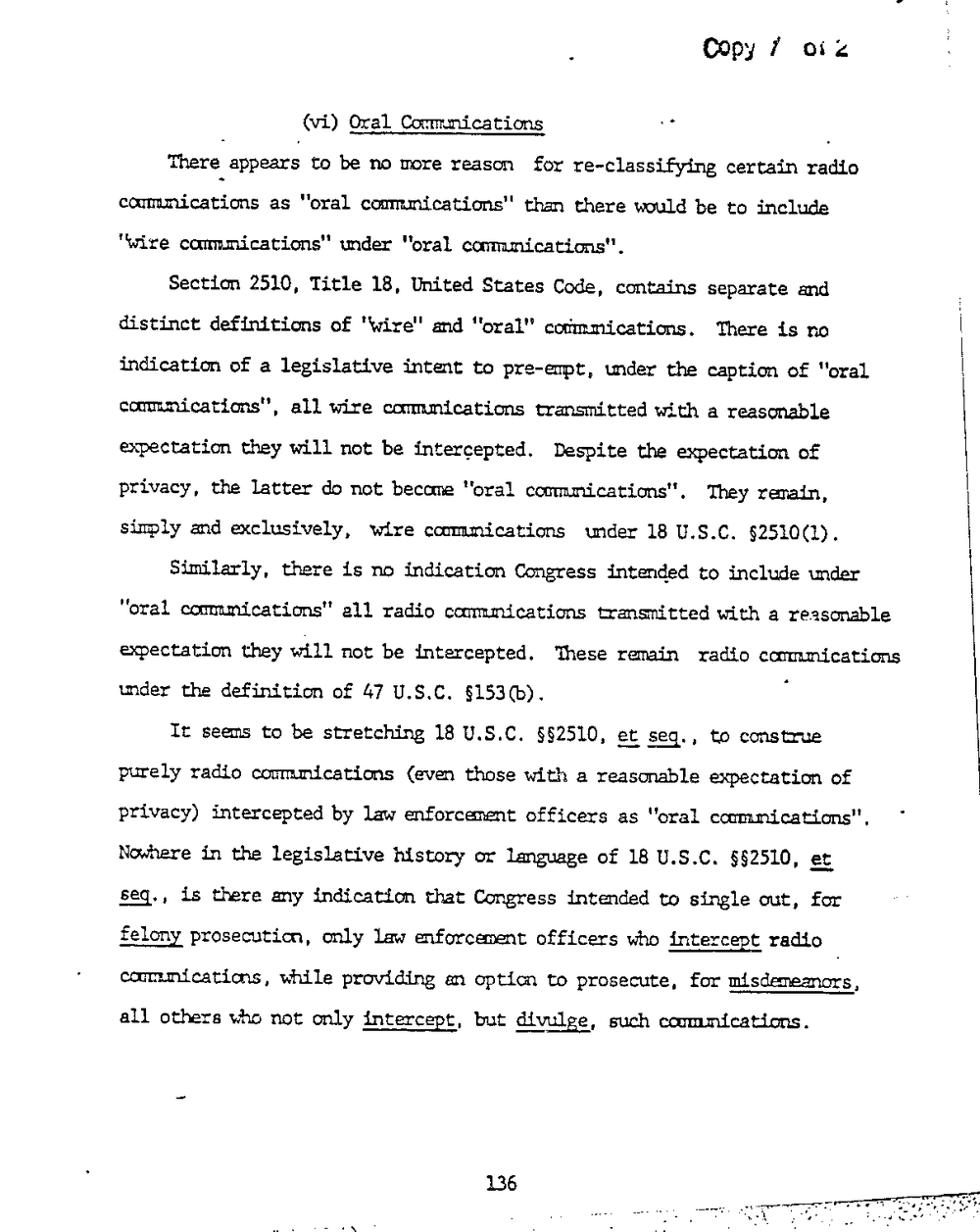
COpy ma
(vi) Oral .
There appears to be no more reason for re-classifying certain radio
communications as "oral cmnmications" than there would be to include
Wire cmnmications" under "oral cmnmications".
Section 2510, Title 18, United States Code, contains separate and
distinct definitions of "wire" and "oral" codmmications. There is no
indication of a legislative intent to pre-enpt, under the caption of "oral
cooumications", all wire transmitted with a reasonable
expectation they will not be intercepted. Despite the eatpectation of
privacy, the latter do not become "oral coonmnications". They remain,
simply and exclusively, wire comnmications under 18 U.S.C. ?2510(l) .
Similarly, there is no indication Congress intended to include under
"oral coommications? all radio cwmmications transmitted with a reasonable
expectation they will not be intercepted. These remain radio
under the definition of 47 U.S.C. 51530:).
It seems to be stretching 18 U.S.C. ??2510, etsgg? to construe
purely radio commnications (even those with a reasonable expectation of
privacy) intercepted by law mforcezmt officers as "oral
Nowhere in the legislative history or language of 18 U.S.C. 552510,
. is there any indication that Congress intended to single out, for
prosecution, only law enforcement officers who intercept radio .
cammicatims, while providing an option to prosecute, for misdmmeanors,
all others who not only intercept. but $5.31ng such
136
COpy ma
(vi) Oral .
There appears to be no more reason for re-classifying certain radio
communications as "oral cmnmications" than there would be to include
Wire cmnmications" under "oral cmnmications".
Section 2510, Title 18, United States Code, contains separate and
distinct definitions of "wire" and "oral" codmmications. There is no
indication of a legislative intent to pre-enpt, under the caption of "oral
cooumications", all wire transmitted with a reasonable
expectation they will not be intercepted. Despite the eatpectation of
privacy, the latter do not become "oral coonmnications". They remain,
simply and exclusively, wire comnmications under 18 U.S.C. ?2510(l) .
Similarly, there is no indication Congress intended to include under
"oral coommications? all radio cwmmications transmitted with a reasonable
expectation they will not be intercepted. These remain radio
under the definition of 47 U.S.C. 51530:).
It seems to be stretching 18 U.S.C. ??2510, etsgg? to construe
purely radio commnications (even those with a reasonable expectation of
privacy) intercepted by law mforcezmt officers as "oral
Nowhere in the legislative history or language of 18 U.S.C. 552510,
. is there any indication that Congress intended to single out, for
prosecution, only law enforcement officers who intercept radio .
cammicatims, while providing an option to prosecute, for misdmmeanors,
all others who not only intercept. but $5.31ng such
136
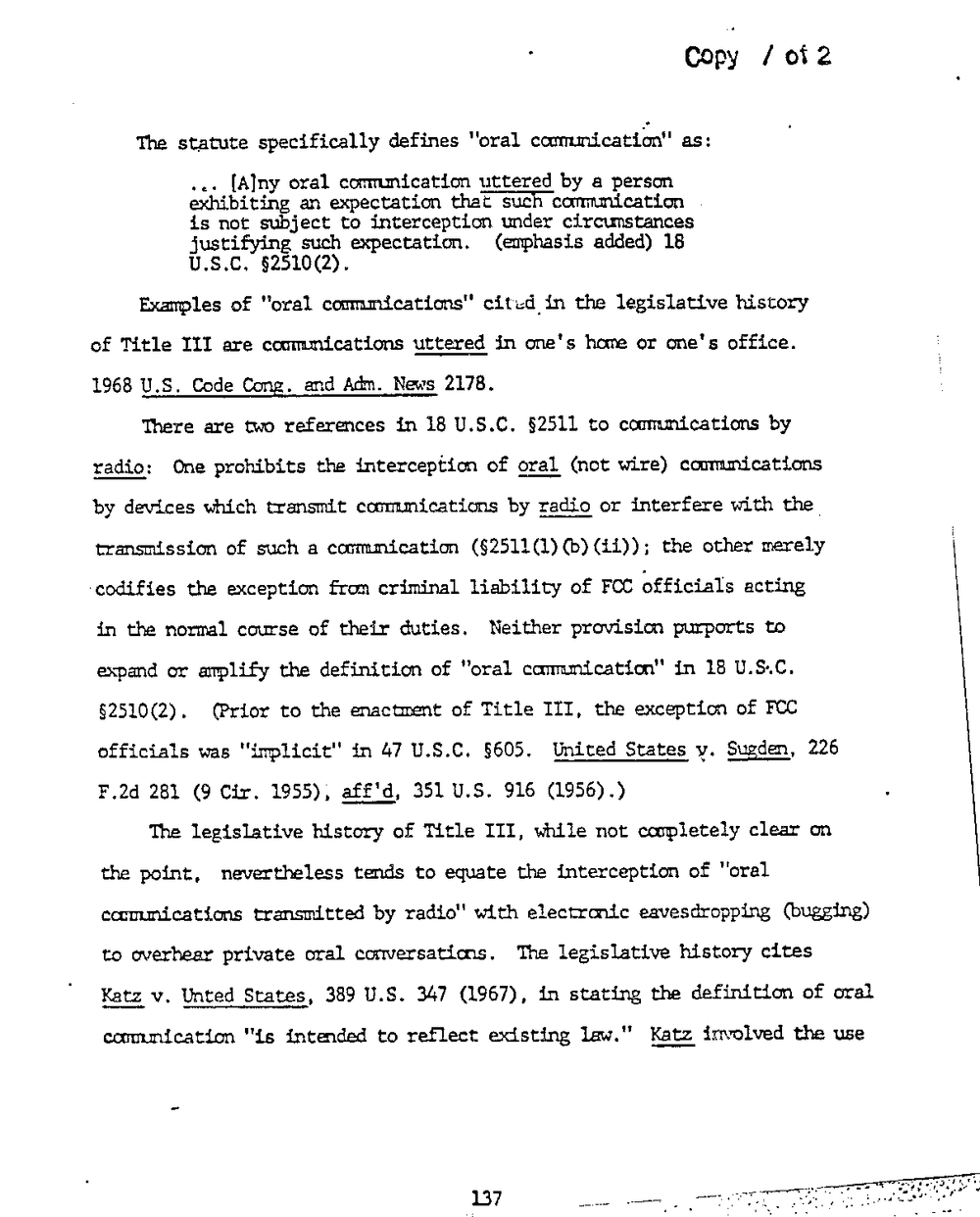
Copy lon
The statute specifically defines "oral communication" as:
. .. [Alny oral cmieation uttered by a person
exhibiting an expectation ?at?sEcTcormmication .
is not subject to interception under circumstances
justifying such expectation. (emphasis added) 18
U.S.C. ?2510(2).
Ei-cairples of "oral communications" cited-in the legislative history
of Title are coommications in one's home or one's office.
1968 U.S. Code Cong. and Adm. News 2178.
'Ihere are two references in 18 U.S.C. 52511 to cocnmications by
?11.93 One prohibits the interception of oral (not wire) counmications
by devices which cmmications by radio or interfere with the
transmission of such a (?2511(l) the other merely
codifies the exception from criminal liability of FCC officials acting
in the normal course of their duties. Neither provision pint-ports to
expand or amplify the definition of "oral in 18 U.S-.C.
?2510(2). (Prior to the enactment of Title the exception of FCC
officials was ?inplicit? in 47 U.S.C. 5605. United States v. Suede-n, 226
F.2d 281 (9 Cir. 1955); @353, 351 U.S. 916 (1956).)
The legislative history of Title while not clear on
the point, nevertheless tends to equate the interception of "oral
cconmications transmitted by radio? with electronic eavesdropping (bugging)
to overhear private oral cmversaticns. 'Ihe legislative history cites
Ketz v. Unted States, 389 U.S. 347 (1967), in stating the definition of oral
coummication "is intended to reflect existing law." Katz im'olved the use
Copy lon
The statute specifically defines "oral communication" as:
. .. [Alny oral cmieation uttered by a person
exhibiting an expectation ?at?sEcTcormmication .
is not subject to interception under circumstances
justifying such expectation. (emphasis added) 18
U.S.C. ?2510(2).
Ei-cairples of "oral communications" cited-in the legislative history
of Title are coommications in one's home or one's office.
1968 U.S. Code Cong. and Adm. News 2178.
'Ihere are two references in 18 U.S.C. 52511 to cocnmications by
?11.93 One prohibits the interception of oral (not wire) counmications
by devices which cmmications by radio or interfere with the
transmission of such a (?2511(l) the other merely
codifies the exception from criminal liability of FCC officials acting
in the normal course of their duties. Neither provision pint-ports to
expand or amplify the definition of "oral in 18 U.S-.C.
?2510(2). (Prior to the enactment of Title the exception of FCC
officials was ?inplicit? in 47 U.S.C. 5605. United States v. Suede-n, 226
F.2d 281 (9 Cir. 1955); @353, 351 U.S. 916 (1956).)
The legislative history of Title while not clear on
the point, nevertheless tends to equate the interception of "oral
cconmications transmitted by radio? with electronic eavesdropping (bugging)
to overhear private oral cmversaticns. 'Ihe legislative history cites
Ketz v. Unted States, 389 U.S. 347 (1967), in stating the definition of oral
coummication "is intended to reflect existing law." Katz im'olved the use
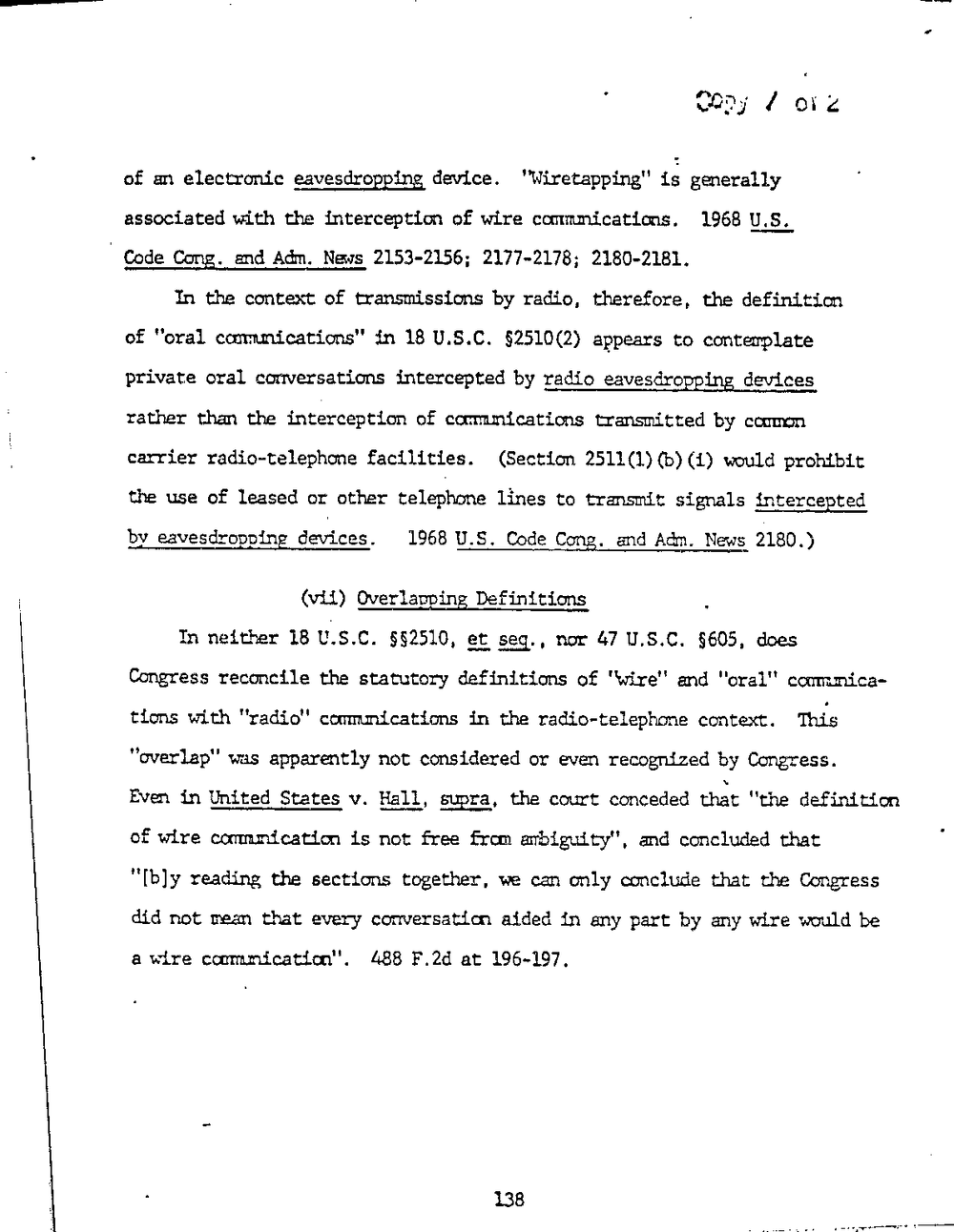
3013' 052:
of an electronic eavesdroppi'gg device. 'Wiretapping" is generally
associated with the interception of wire 1968
Code Cong. end Adm. News 2153-2155; 2177-2178; 2180-2181.
In the context of transmissions by radio, therefore, the definition
of "oral ccn'cmications" in 18 U.S.C. ?2510(2) appears to contemplate
private oral conversations intercepted by radio eavesdropping devices
rather them the interception of commications transmitted by common
carrier radio?telephone facilities. (Section 2511(1) would prohibit
the use of leased or other telephone lines to transmit signals intercepted
1:3; eavesdropping devices. 1968 v.5. Code Cong. and Adm. News 2180.)
(vii) Overlapping Definitions
In neither 18 U.S.C. mm, 2553:}, not 47 U.S.C. 5605. does
Congress reconcile the statutory definitions of 'koire" and "oral"
tions with "radio" conmmications in the radio-telephone context.
"overlap" was apparently not considered or even recognized by Congress.
Even in United States v. Hall, Styra. the court conceded that definition
of wire communication is not free from arrbiguity", and concluded that
"[ny reading the sections together. we can only conclude that the Congress
did not mean that every conversaticn aided in any part by any wire would be
a wire ccomznicatim". 488 F.2d at 196-197.
138
3013' 052:
of an electronic eavesdroppi'gg device. 'Wiretapping" is generally
associated with the interception of wire 1968
Code Cong. end Adm. News 2153-2155; 2177-2178; 2180-2181.
In the context of transmissions by radio, therefore, the definition
of "oral ccn'cmications" in 18 U.S.C. ?2510(2) appears to contemplate
private oral conversations intercepted by radio eavesdropping devices
rather them the interception of commications transmitted by common
carrier radio?telephone facilities. (Section 2511(1) would prohibit
the use of leased or other telephone lines to transmit signals intercepted
1:3; eavesdropping devices. 1968 v.5. Code Cong. and Adm. News 2180.)
(vii) Overlapping Definitions
In neither 18 U.S.C. mm, 2553:}, not 47 U.S.C. 5605. does
Congress reconcile the statutory definitions of 'koire" and "oral"
tions with "radio" conmmications in the radio-telephone context.
"overlap" was apparently not considered or even recognized by Congress.
Even in United States v. Hall, Styra. the court conceded that definition
of wire communication is not free from arrbiguity", and concluded that
"[ny reading the sections together. we can only conclude that the Congress
did not mean that every conversaticn aided in any part by any wire would be
a wire ccomznicatim". 488 F.2d at 196-197.
138
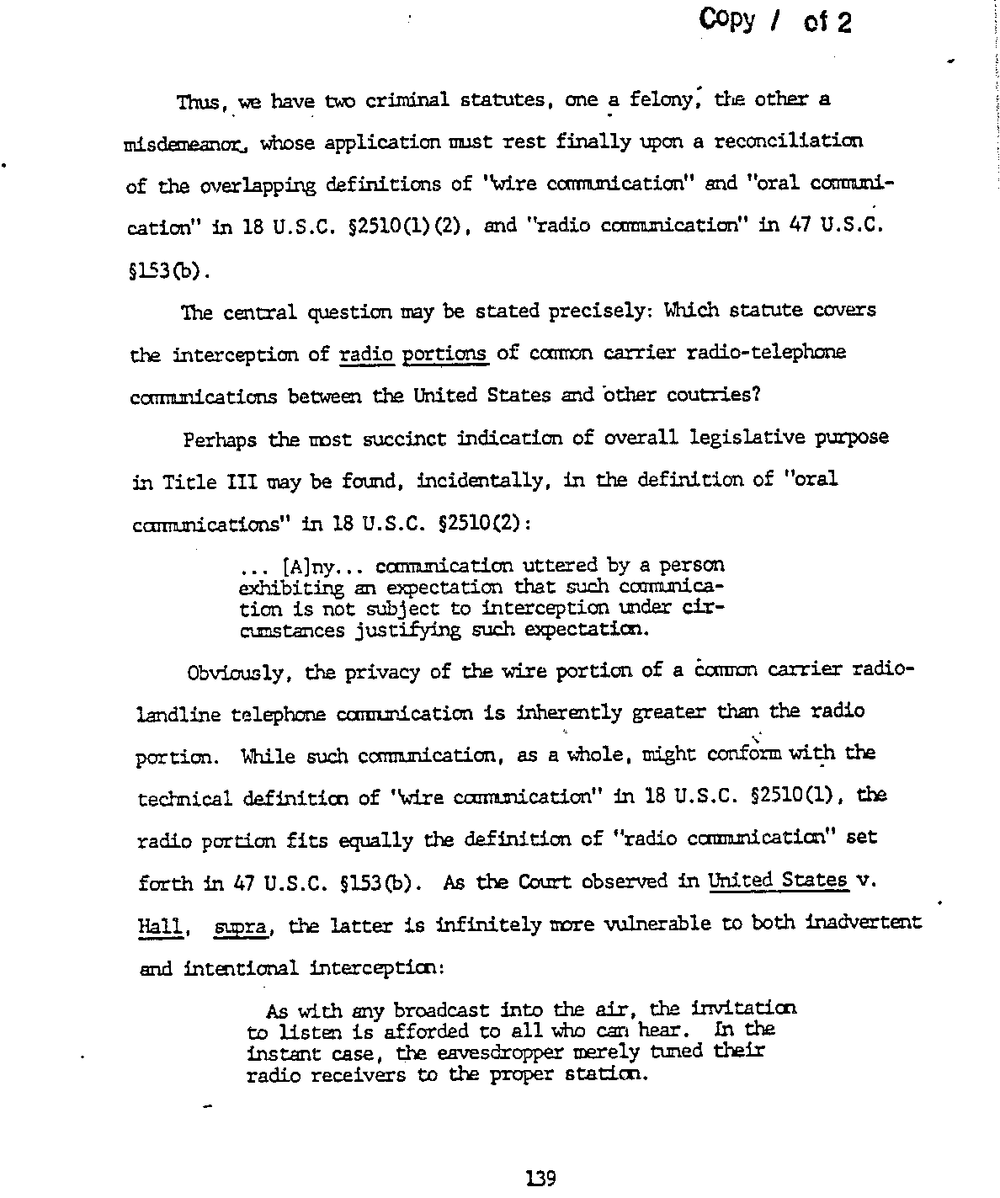
012
Thushwe have two criminal statutes, one a felony: the other a
misdeieanor, whose application must rest finally upon a reconciliaticn
of the overlapping definitions of ?wire cormmication" and "oral cosm-
cation" in 18 U.S.C. s2510(1) (2). and "radio coonnmication" in 47 11.3.6.
?153 Cb)-
Ihe central question may be stated precisely: which statute covers
the interception of portions of common carrier radio-telephone
cormnmications between the United States and other coutries?
Perhaps the most succinct indication of overall legislative propose
in Title may be found. incidentally, in the definition of "oral
cmmioations" in 18 U.S.C. ?2510(2):
I . . . [A]ny. . . communication uttered by a person
exhibiting an expectation that such coommica-
tion is not subject to interception under cir-
cumstances justifying such expectation.
Obviously, the privacy of the wire portion of a carrier radio-
landline telephone is inherently greater than the radio
portion. While such cormmication, as a awhole, might the
technical definition of 'R-rire mudcadon" in 18 U.S.C. the
radio portion fits equally the definition of "radio ccrmumication" set
forth in 1+7 U.S.C. 5153(b). As the Court observed in United States v.
gall. gang. the latter is infinitely more vulnerable to both inadvertent .
and intentional intercepticn:
As with any broadcast into the air, the invitation
to listen is afforded to all who can hear. In the
instant case, the eavesdropper merely tuned their
radio receivers to the proper staticn.
B9
012
Thushwe have two criminal statutes, one a felony: the other a
misdeieanor, whose application must rest finally upon a reconciliaticn
of the overlapping definitions of ?wire cormmication" and "oral cosm-
cation" in 18 U.S.C. s2510(1) (2). and "radio coonnmication" in 47 11.3.6.
?153 Cb)-
Ihe central question may be stated precisely: which statute covers
the interception of portions of common carrier radio-telephone
cormnmications between the United States and other coutries?
Perhaps the most succinct indication of overall legislative propose
in Title may be found. incidentally, in the definition of "oral
cmmioations" in 18 U.S.C. ?2510(2):
I . . . [A]ny. . . communication uttered by a person
exhibiting an expectation that such coommica-
tion is not subject to interception under cir-
cumstances justifying such expectation.
Obviously, the privacy of the wire portion of a carrier radio-
landline telephone is inherently greater than the radio
portion. While such cormmication, as a awhole, might the
technical definition of 'R-rire mudcadon" in 18 U.S.C. the
radio portion fits equally the definition of "radio ccrmumication" set
forth in 1+7 U.S.C. 5153(b). As the Court observed in United States v.
gall. gang. the latter is infinitely more vulnerable to both inadvertent .
and intentional intercepticn:
As with any broadcast into the air, the invitation
to listen is afforded to all who can hear. In the
instant case, the eavesdropper merely tuned their
radio receivers to the proper staticn.
B9
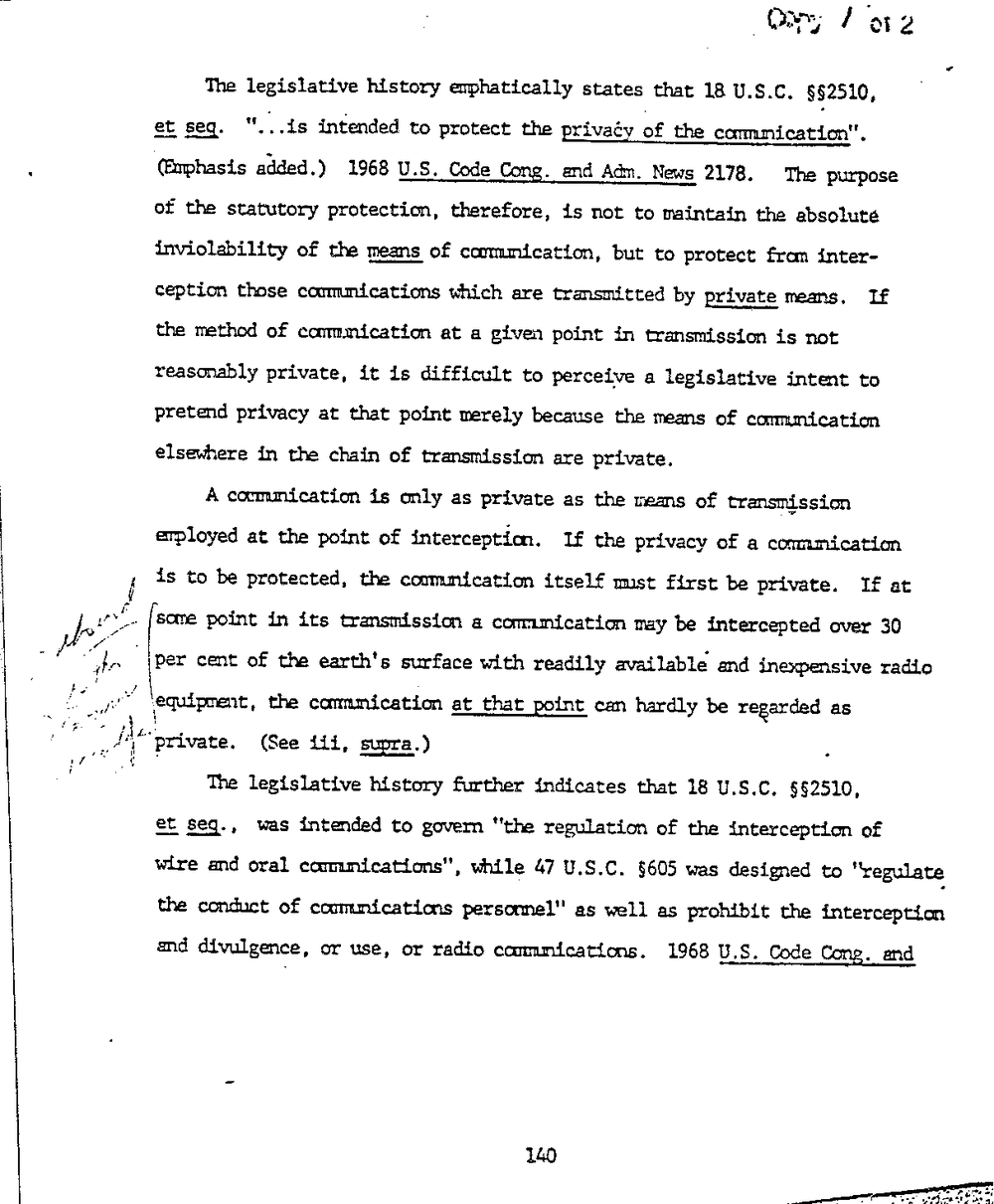
at 2
The legislative history emphatically states that 18 U.S.C. 552510,
at sea. .is intended to protect the giva?y of the
(emphasis added.) 1968 U.S. Code Cong. and Adm. News 2173. The purpose
of the statutory protection. therefore, is not to maintain the absolute
inviolability of the of commication, but to protect from inter-
caption tl'nse which are transmitted by 3% means. If
the method of at a given point in transmission is not
reasonably private, it is difficult to perceive a legislative intent to
pretend privacy at that point merely because the means of coummication
elsewhere in the chain of transmission are private.
A communication is only as private as the seal-ms of transmission
employed at the point of interceptim. If the privacy of a communication
if is to be protected, the itself mast first be private. If at
some point in its a cormunication may be intercepted over 30
I - .
per cent of the earth's surface with readily available and inexpensive radio
up?, :?equipment, the camication at that mint can hardly be regarded as
(See gm.)
. t?
The legislative history further indicates that 18 U.S.C. ??2510.
gt gag. . was intended to govern "the regulation of the interception of
wire and oral while A7 U.S.C. (5605 was designed to "regulate
the comiuct of commnications persomel" as wall as prohibit the interceptim
and divulgence, or use, or radio ccunnmicatims. 1968 U.S. Code Cong. and
140
at 2
The legislative history emphatically states that 18 U.S.C. 552510,
at sea. .is intended to protect the giva?y of the
(emphasis added.) 1968 U.S. Code Cong. and Adm. News 2173. The purpose
of the statutory protection. therefore, is not to maintain the absolute
inviolability of the of commication, but to protect from inter-
caption tl'nse which are transmitted by 3% means. If
the method of at a given point in transmission is not
reasonably private, it is difficult to perceive a legislative intent to
pretend privacy at that point merely because the means of coummication
elsewhere in the chain of transmission are private.
A communication is only as private as the seal-ms of transmission
employed at the point of interceptim. If the privacy of a communication
if is to be protected, the itself mast first be private. If at
some point in its a cormunication may be intercepted over 30
I - .
per cent of the earth's surface with readily available and inexpensive radio
up?, :?equipment, the camication at that mint can hardly be regarded as
(See gm.)
. t?
The legislative history further indicates that 18 U.S.C. ??2510.
gt gag. . was intended to govern "the regulation of the interception of
wire and oral while A7 U.S.C. (5605 was designed to "regulate
the comiuct of commnications persomel" as wall as prohibit the interceptim
and divulgence, or use, or radio ccunnmicatims. 1968 U.S. Code Cong. and
140
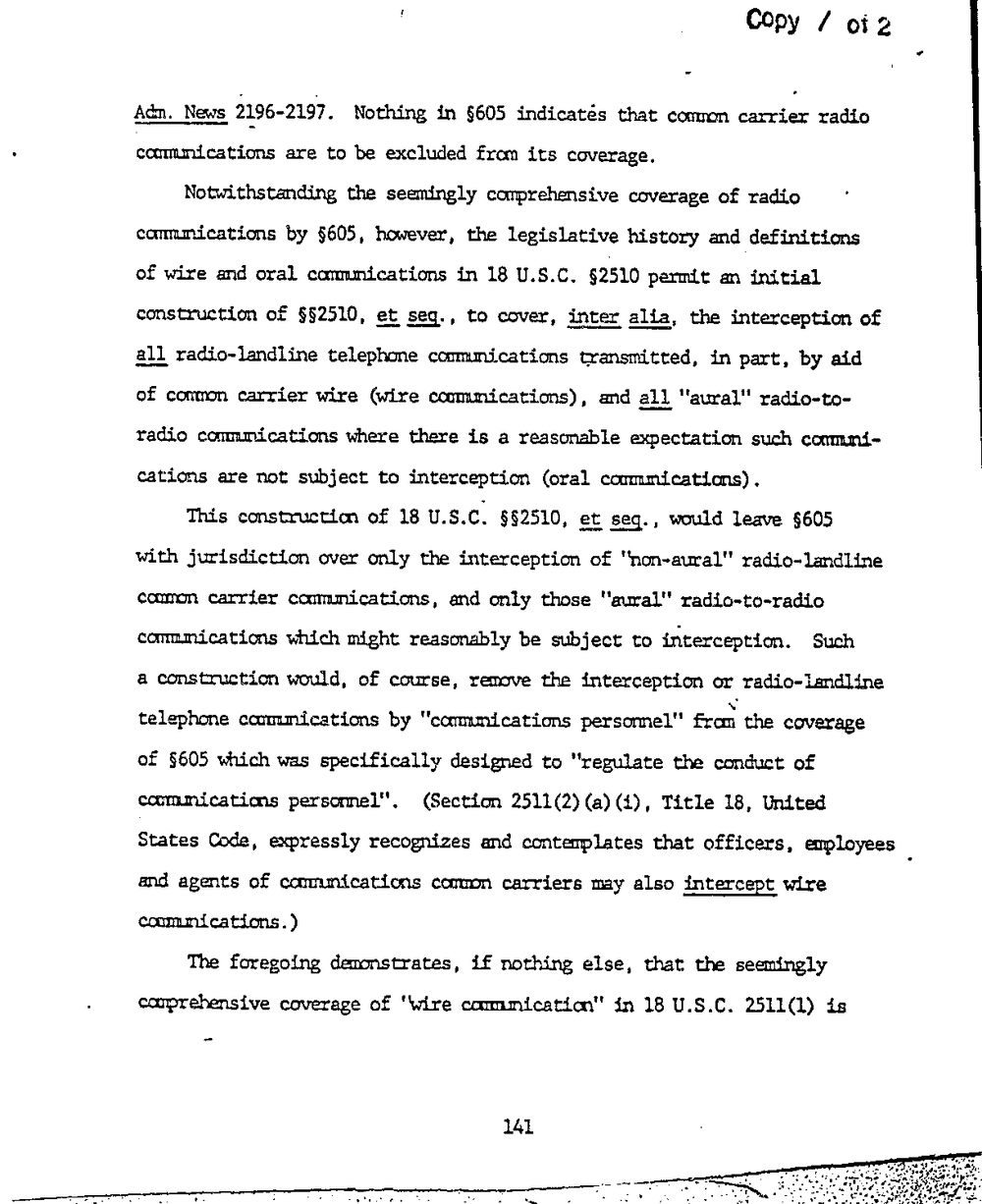
Copy 012
Adm. News 2196?2191. Nothing in 5605 indicates that comm carrier radio
cmnulications are to be excluded from its coverage.
Nomithstanding the seemingly coverage of radio
camications by 5605. however, the legislative history andgdefinitions
of wire and oral cmmications in 18 U.S.C. 52510 permit an initial
construction of 552510, . to cover, ?153; the interception of
all radio-landline telephone conmmications transmitted. in part, by aid
of common carrier wire (wire commications) and g1}: "aural" radio-to-
radio communications where there is a reasonable expectation such commi-
cations are not subject to interception (oral coummications) .
This constructitn of 18 U.s.cl ??2510, 35 33., would leave ?605
with jurisdiction over only the interception of "non-amal" radio-landline
cannon carrier coommications, and only those "amal" radio-to-radio
cmicatims which might reasonably be subject to interception. Such
a construction would. of course, remove the interception or radio-lmdline
telephone counmications by "cormmications personnel" the coverage
of ?605 which was specifically designed to "regulate the conduct of
cocmmicatims persomel". (Section 2511(2) Title 18. United
States Code, expressly recognizes and cmtaiplates that officers, employees .
and agents of cammicaticns ccumn carriers may also wire
The foregoing if nothing else. that the seemingly
emprelmsive coverage of Wire cammicatim" in 18 U.S.C. 2511(1) is
.t
141
I 1.nulti."
.
Copy 012
Adm. News 2196?2191. Nothing in 5605 indicates that comm carrier radio
cmnulications are to be excluded from its coverage.
Nomithstanding the seemingly coverage of radio
camications by 5605. however, the legislative history andgdefinitions
of wire and oral cmmications in 18 U.S.C. 52510 permit an initial
construction of 552510, . to cover, ?153; the interception of
all radio-landline telephone conmmications transmitted. in part, by aid
of common carrier wire (wire commications) and g1}: "aural" radio-to-
radio communications where there is a reasonable expectation such commi-
cations are not subject to interception (oral coummications) .
This constructitn of 18 U.s.cl ??2510, 35 33., would leave ?605
with jurisdiction over only the interception of "non-amal" radio-landline
cannon carrier coommications, and only those "amal" radio-to-radio
cmicatims which might reasonably be subject to interception. Such
a construction would. of course, remove the interception or radio-lmdline
telephone counmications by "cormmications personnel" the coverage
of ?605 which was specifically designed to "regulate the conduct of
cocmmicatims persomel". (Section 2511(2) Title 18. United
States Code, expressly recognizes and cmtaiplates that officers, employees .
and agents of cammicaticns ccumn carriers may also wire
The foregoing if nothing else. that the seemingly
emprelmsive coverage of Wire cammicatim" in 18 U.S.C. 2511(1) is
.t
141
I 1.nulti."
.
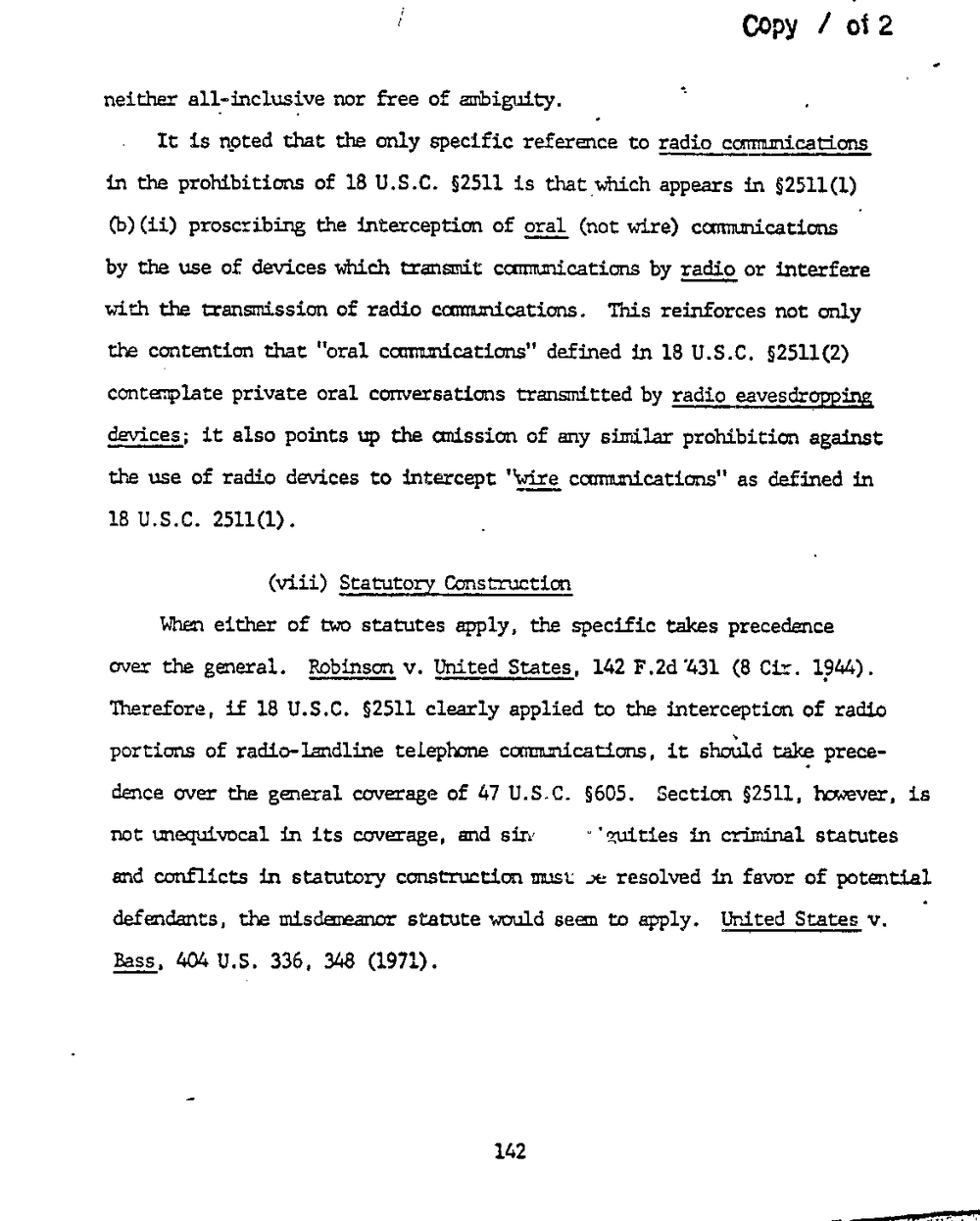
neither all-vinclusive nor free of ambiguity.
It is npted that the only specific reference to radio corummicatzions
in the prohibitions of 18 U.S.C. ?2511 is that _which appears in ?2511(1)
(ii) proscribing the interception of (not wire) connmications
by the use of devices which trarisrnit by radio or interfere
with the transmission of radio commieations. This reinforces not only
the contention that "oral cammications" defined in 18 U.S.C. ?2511(2)
contemplate private oral conversations transmitted by radio eavesdropping
devices; it also points up the emission of any similar prohibition against
the use of radio devices to intercept ?wire counmications" as defined in
18 U.S.C. 2511(1).
Statutog
When either of two statutes apply, the specific takes precedence
over the general. Robinson v. United States, 142 F.2d '431 (8 Cir. 1944).
Therefore, if 18 U.S.C. ?2511 clearly applied to the interception of radio
portions of radio-landline telephone communications, it shonld prece-
dence over the general coverage of 1+7 U.S.C. ?605. Section 52511, however, is
not mequivocal in its coverage, and sin! 'zuities in criminal statutes
and conflicts in statutory met .a-e resolved in favor of potential
defendants, the misdmeanor stamte would seem to apply. United States v.
404 0.5. 336, 348 (1971).
142
neither all-vinclusive nor free of ambiguity.
It is npted that the only specific reference to radio corummicatzions
in the prohibitions of 18 U.S.C. ?2511 is that _which appears in ?2511(1)
(ii) proscribing the interception of (not wire) connmications
by the use of devices which trarisrnit by radio or interfere
with the transmission of radio commieations. This reinforces not only
the contention that "oral cammications" defined in 18 U.S.C. ?2511(2)
contemplate private oral conversations transmitted by radio eavesdropping
devices; it also points up the emission of any similar prohibition against
the use of radio devices to intercept ?wire counmications" as defined in
18 U.S.C. 2511(1).
Statutog
When either of two statutes apply, the specific takes precedence
over the general. Robinson v. United States, 142 F.2d '431 (8 Cir. 1944).
Therefore, if 18 U.S.C. ?2511 clearly applied to the interception of radio
portions of radio-landline telephone communications, it shonld prece-
dence over the general coverage of 1+7 U.S.C. ?605. Section 52511, however, is
not mequivocal in its coverage, and sin! 'zuities in criminal statutes
and conflicts in statutory met .a-e resolved in favor of potential
defendants, the misdmeanor stamte would seem to apply. United States v.
404 0.5. 336, 348 (1971).
142
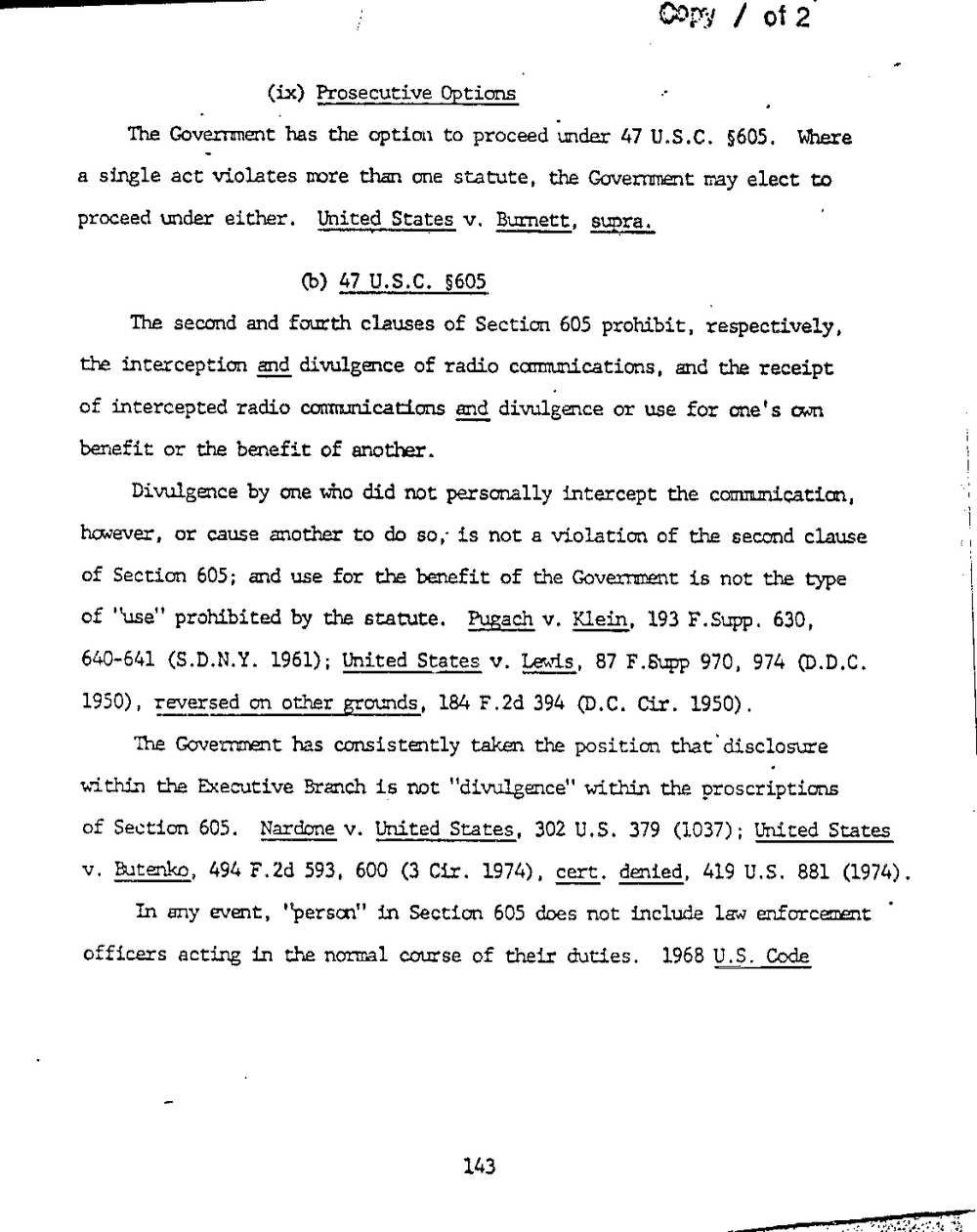
605-a of 2'
(ix) Prosecutive Options I
The Govemnent-has the option to proceed 47 U.S.C. 5605. Where
a single act violates sore than one statute. the may elect to
proceed under either. United States v. Burnett, supra.
47 U.S.C. ?605
The second and fourth clauses of Section 605 prohibit. respectively.
the interception Ed divulgence of radio cmmraioations. and the receipt
of intercepted radio connrmicadons 31g divul?ence or use for one's can
benefit or the benefit of another.
Divulgence by one who did not personally intercept the cwumicatim,
however, or cause mother to do so; is not a violation of the second clause
of Section 605; and use for the benefit of the Goverrment is not the type
of "use" prohibited by the statute. WV. 51111;. 193 F.8upp. 630,
640-641 (S.D.N.Y. 1961); United States v. Lewis, 87 F.8upp 970, 974 (D.D.C.
1950), reversed on other grounds, 184 F.2d 394 CD.C. Cir. 1950).
The Government has consistently taken the position that'disclosm'e
mithin the Executive Branch is not "divulgence" within the prescriptions
of Section 605. Nardone v. United States, 302 1.1.8. 379 (1037); United States
v. Bitenko, 494 F.2d 593, 600 (3 Cir. 1974), Earl. diuLieg, 419 0.5. 881 (1974).
In any event, "person" in Section 605 does not include law enforcanmt
officers acting in the normal course of their duties. 1968 Q. Code
143
605-a of 2'
(ix) Prosecutive Options I
The Govemnent-has the option to proceed 47 U.S.C. 5605. Where
a single act violates sore than one statute. the may elect to
proceed under either. United States v. Burnett, supra.
47 U.S.C. ?605
The second and fourth clauses of Section 605 prohibit. respectively.
the interception Ed divulgence of radio cmmraioations. and the receipt
of intercepted radio connrmicadons 31g divul?ence or use for one's can
benefit or the benefit of another.
Divulgence by one who did not personally intercept the cwumicatim,
however, or cause mother to do so; is not a violation of the second clause
of Section 605; and use for the benefit of the Goverrment is not the type
of "use" prohibited by the statute. WV. 51111;. 193 F.8upp. 630,
640-641 (S.D.N.Y. 1961); United States v. Lewis, 87 F.8upp 970, 974 (D.D.C.
1950), reversed on other grounds, 184 F.2d 394 CD.C. Cir. 1950).
The Government has consistently taken the position that'disclosm'e
mithin the Executive Branch is not "divulgence" within the prescriptions
of Section 605. Nardone v. United States, 302 1.1.8. 379 (1037); United States
v. Bitenko, 494 F.2d 593, 600 (3 Cir. 1974), Earl. diuLieg, 419 0.5. 881 (1974).
In any event, "person" in Section 605 does not include law enforcanmt
officers acting in the normal course of their duties. 1968 Q. Code
143
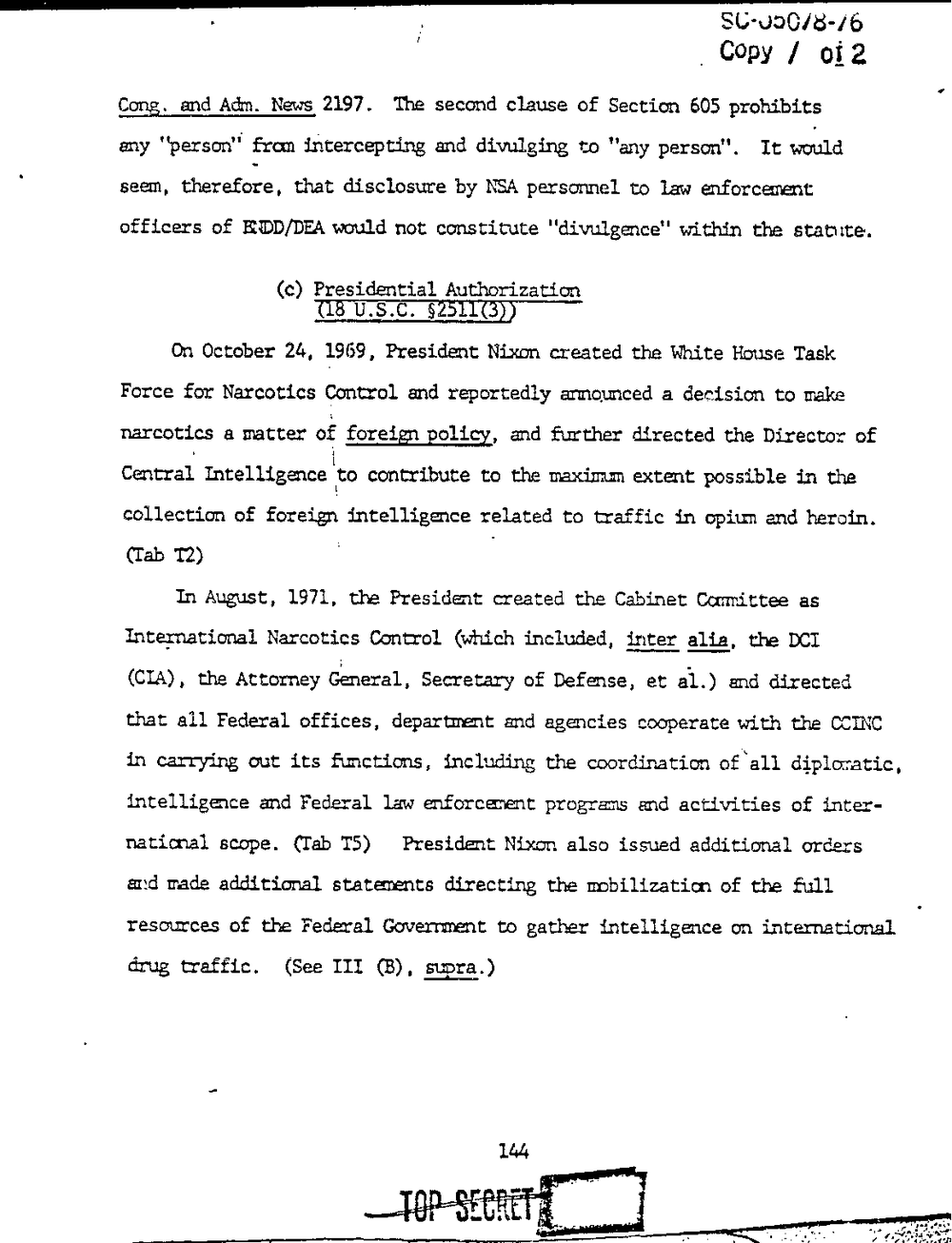
SU-uoO/tS-lo
. Copy 012
Cong. and Adm. News 2197. The second clause of Section 605 prohibits
any ?person? from htercepting and divulging to "any person". It would
seem, therefore, that disclosure by NSA personnel to Law enforcement
I.
officers of would not constitute "divulgence" within the statute.
Presidential Authorization
U8 U.S.C. ?2511(3))
On October 2h, l969, President Nixon created the White House Task
Force for Narcotics Control and reportedly announced a decision to make
narcotics a matter oi? foreign policy, and further directed the Director of
Central Intelligencei?to contribute to the maximrn extent possible in the
collection of foreign intelligence related to traffic in and heroin.
(Tab 12) I
In August, 1971, the President created the Cabinet Carmittee as
International Narcotics Control (which included, inter the D01
(CIA). the Attorney General, Secretary of Defense, et al.) and directed
that all Federal offices, departn'mt and agencies cooperate with the CCINC
in carrying out its functions, including the coordination of?all diplomatic.
intelligence and Federal law enforcazmnt programs and activities of inter-
national scope. (Tab T5) President Nixon also issued additional orders
and made additional statements directing the mbilizaticxn of the full
resources of the Federal Government to gather intelligence on international
drug traffic. (See (B), 112%.)
SU-uoO/tS-lo
. Copy 012
Cong. and Adm. News 2197. The second clause of Section 605 prohibits
any ?person? from htercepting and divulging to "any person". It would
seem, therefore, that disclosure by NSA personnel to Law enforcement
I.
officers of would not constitute "divulgence" within the statute.
Presidential Authorization
U8 U.S.C. ?2511(3))
On October 2h, l969, President Nixon created the White House Task
Force for Narcotics Control and reportedly announced a decision to make
narcotics a matter oi? foreign policy, and further directed the Director of
Central Intelligencei?to contribute to the maximrn extent possible in the
collection of foreign intelligence related to traffic in and heroin.
(Tab 12) I
In August, 1971, the President created the Cabinet Carmittee as
International Narcotics Control (which included, inter the D01
(CIA). the Attorney General, Secretary of Defense, et al.) and directed
that all Federal offices, departn'mt and agencies cooperate with the CCINC
in carrying out its functions, including the coordination of?all diplomatic.
intelligence and Federal law enforcazmnt programs and activities of inter-
national scope. (Tab T5) President Nixon also issued additional orders
and made additional statements directing the mbilizaticxn of the full
resources of the Federal Government to gather intelligence on international
drug traffic. (See (B), 112%.)
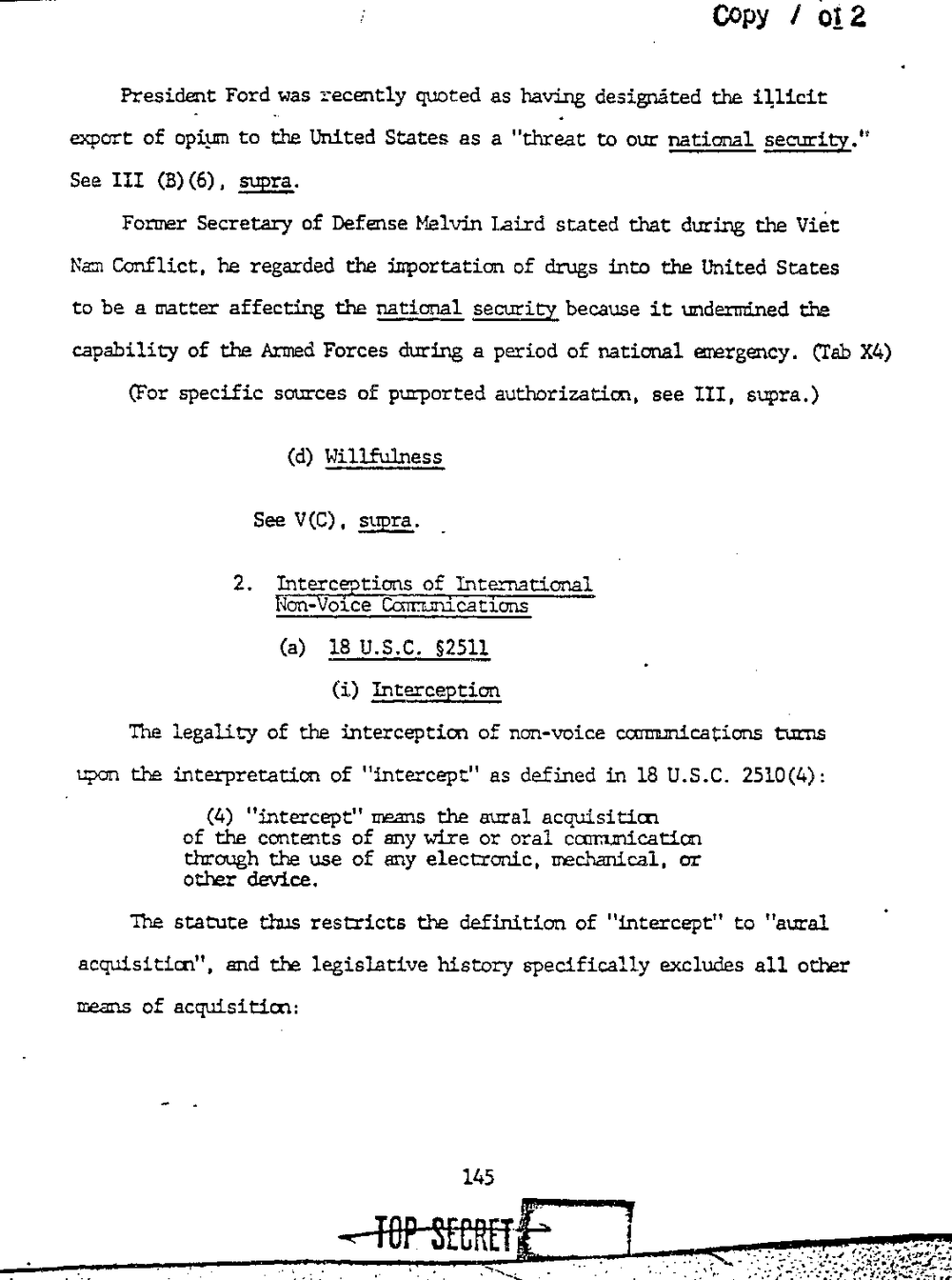
Copy I 612
President Ford was recently quoted as having designated the illicit
export of opiin'n to the United States as a "threat to our national security."
See (B) (6). Egg.
Former Secretary of Defense Melvin Laird stated that during the Viet
Nam Conflict, he regarded the importation of drugs into the United States
to be a matter affecting the national security because it imdermined the
capabilityr of the Armed Forces during a period of national emergency. (Tab X4)
(For specific sources of purported autlwrizatim, see supra.)
Willfulness
See ma.
2. Interceptions of International
Non-Woice Camications
18 U.S.C. ?2511
Interception
The legality of the interception of non-voice coummications
upon the interpretation of "intercept" as defined in 18 U.S.C. 2510(4):
I (A) "intercept" means the aural acquisiticn
of the contents of any wire or oral connunication
the use of any electronic, mechanical, or
other device.
The statute restricts the definition of "intercept" to "aural
acquisiticn". and the legislative history specifically excludes all other
means of acquisition:
Copy I 612
President Ford was recently quoted as having designated the illicit
export of opiin'n to the United States as a "threat to our national security."
See (B) (6). Egg.
Former Secretary of Defense Melvin Laird stated that during the Viet
Nam Conflict, he regarded the importation of drugs into the United States
to be a matter affecting the national security because it imdermined the
capabilityr of the Armed Forces during a period of national emergency. (Tab X4)
(For specific sources of purported autlwrizatim, see supra.)
Willfulness
See ma.
2. Interceptions of International
Non-Woice Camications
18 U.S.C. ?2511
Interception
The legality of the interception of non-voice coummications
upon the interpretation of "intercept" as defined in 18 U.S.C. 2510(4):
I (A) "intercept" means the aural acquisiticn
of the contents of any wire or oral connunication
the use of any electronic, mechanical, or
other device.
The statute restricts the definition of "intercept" to "aural
acquisiticn". and the legislative history specifically excludes all other
means of acquisition:
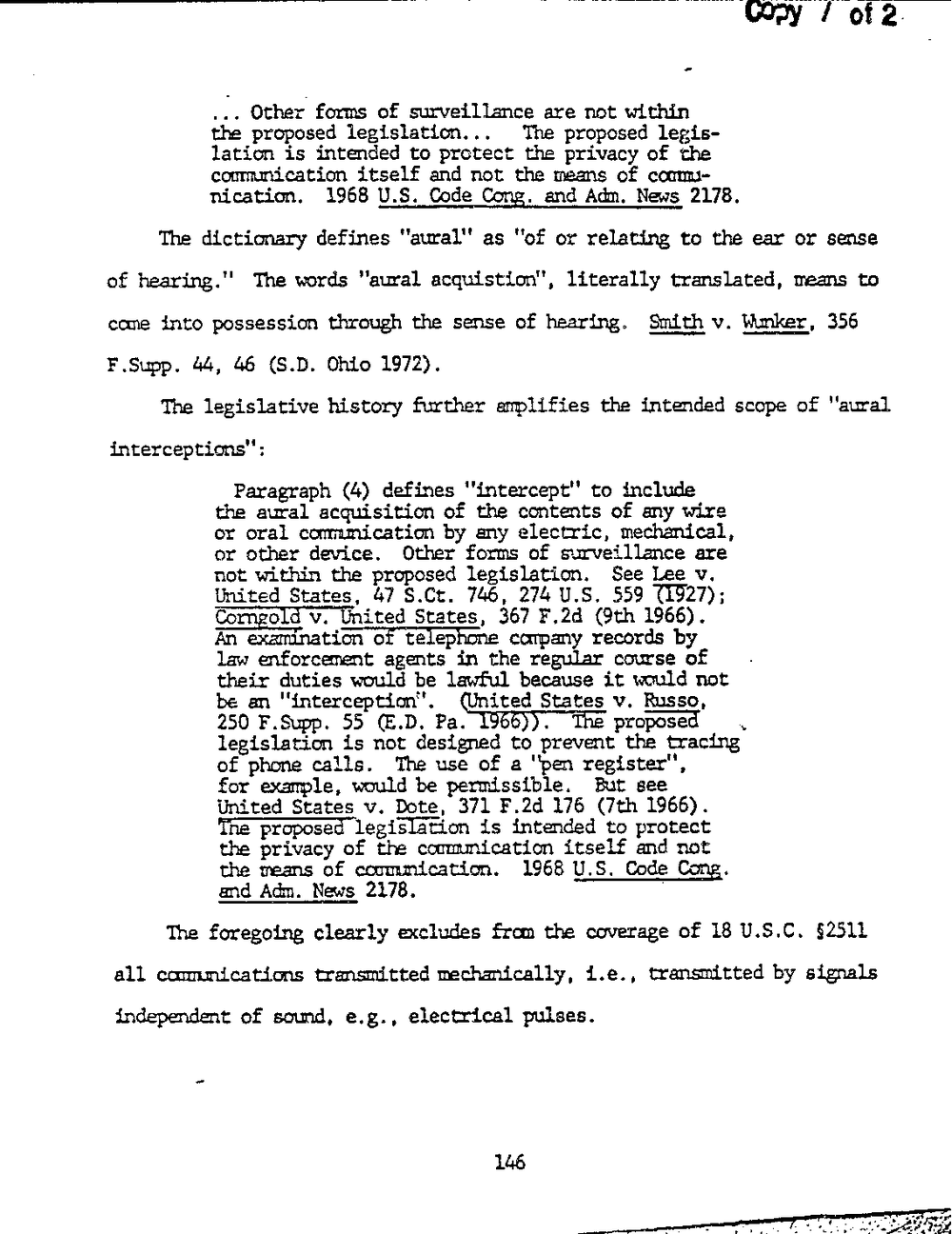
. .. Other forms of surveillance are not within
the proposed legislation. . . The proposed legis-
lation is intended to protect the privacy of the
counmication itself and not the means of comm-
nication. 1968 U.S. Code Cong. and Adm. News 2178.
The dictionary defines "aural" as "of or relating to the ear or sense
of hearing." The words "aural acquistion", literally translated. means to
cane into possession through the sense of hearing. Smith v. Wanker, 356
F.Supp. M, ?6 (S.D. Ohio 1972).
The legislative history further amplifies the intended scope of "aural
interceptions"
Paragraph (4) defines "intercept" to include
the aural acquisition of the contents of any wire
or oral cormmication by any electric, mechanical,
or other device. Other forms of surveillance are
not within the proposed legislation. See Lee v.
United States. 47 8.01:. 746, 274 U.S. 559 "(1927);
Corngold v. United States. 367 F.2d (9th 1966).
An examination of telephone ccmpany records by
law enforcement agents in the regular course of
their duties would be lawhll because it would not
be an "interception". (%ited States v. Russo.
250 F.Supp. 55 (E.D. Pa. . proposed ..
legislation is not designed to prevent the tracing
of phone calls. The use of a "pen register",
for example, would be permissible. But see
United States v. Dote. 371 F.2d 176 (7th 1966).
THE proposed legislation is intended to protect
the privacy of the coummication itself and not
the ms of coummication. 1968 U.S. Code gag. .
and Adm. News 2178.
The foregoing clearly excludes from the coverage of 18 U.S.C. 52511
all commiications transmitted mechaiically, i.e. transmitted by signals
independent of somd. electrical pulses.
146
. .. Other forms of surveillance are not within
the proposed legislation. . . The proposed legis-
lation is intended to protect the privacy of the
counmication itself and not the means of comm-
nication. 1968 U.S. Code Cong. and Adm. News 2178.
The dictionary defines "aural" as "of or relating to the ear or sense
of hearing." The words "aural acquistion", literally translated. means to
cane into possession through the sense of hearing. Smith v. Wanker, 356
F.Supp. M, ?6 (S.D. Ohio 1972).
The legislative history further amplifies the intended scope of "aural
interceptions"
Paragraph (4) defines "intercept" to include
the aural acquisition of the contents of any wire
or oral cormmication by any electric, mechanical,
or other device. Other forms of surveillance are
not within the proposed legislation. See Lee v.
United States. 47 8.01:. 746, 274 U.S. 559 "(1927);
Corngold v. United States. 367 F.2d (9th 1966).
An examination of telephone ccmpany records by
law enforcement agents in the regular course of
their duties would be lawhll because it would not
be an "interception". (%ited States v. Russo.
250 F.Supp. 55 (E.D. Pa. . proposed ..
legislation is not designed to prevent the tracing
of phone calls. The use of a "pen register",
for example, would be permissible. But see
United States v. Dote. 371 F.2d 176 (7th 1966).
THE proposed legislation is intended to protect
the privacy of the coummication itself and not
the ms of coummication. 1968 U.S. Code gag. .
and Adm. News 2178.
The foregoing clearly excludes from the coverage of 18 U.S.C. 52511
all commiications transmitted mechaiically, i.e. transmitted by signals
independent of somd. electrical pulses.
146
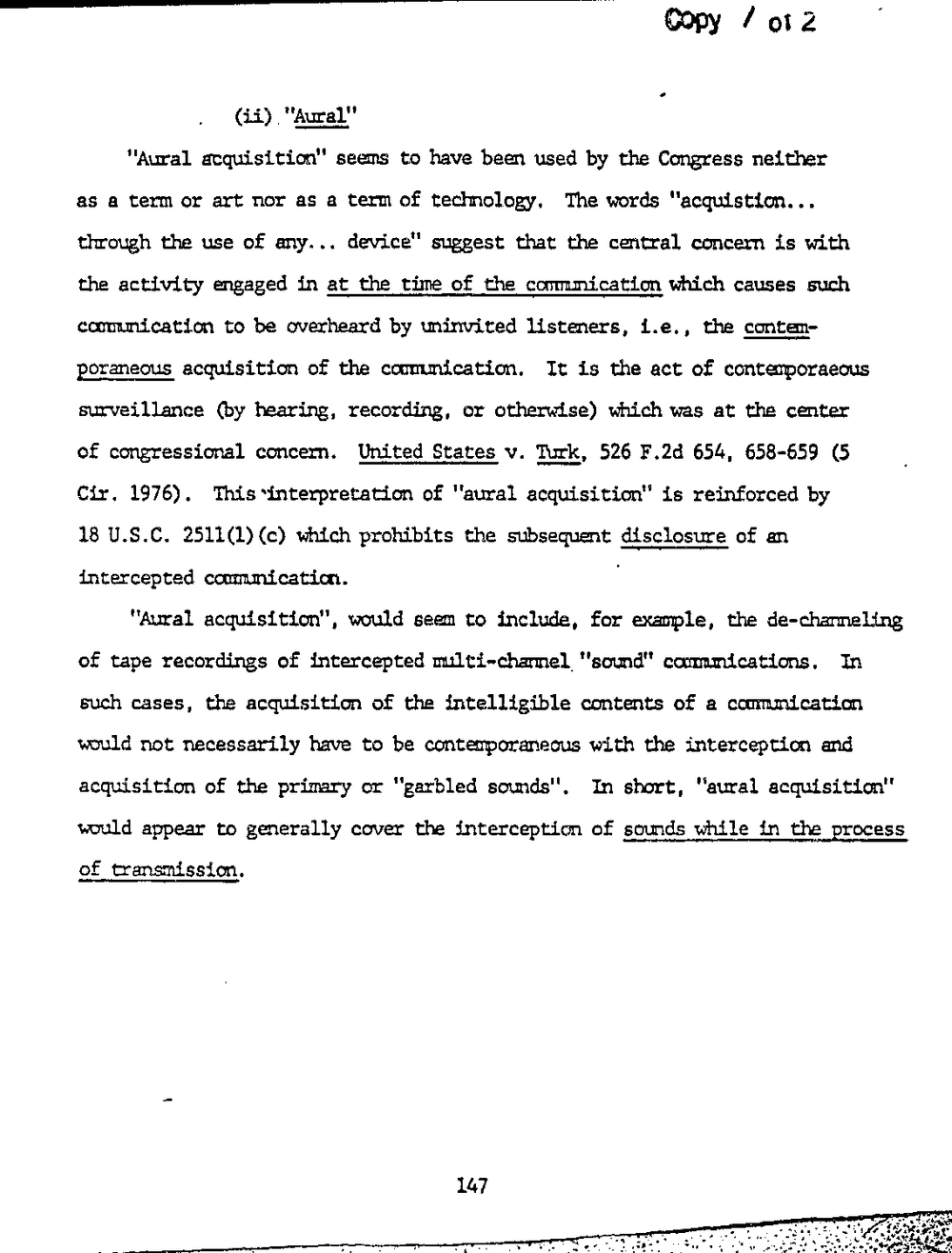
Copy/012
(owing:
"Am-a1 acquisition" seems to have been used by the Congress neither
as a term or art nor as a term of technology. The words "acquistion. . .
through the use of any. . . device" suggest that the central concern is with
the activity engaged in at the time of the corrmmication which causes such
coummication to be overheard by uninvited listeners, i.e. . the gogg-
poraneous acquisition of the communication. It is the act of contemporaeous
meillance (by hearing, recording, or otherwise) which was at the cats:
of congressional concern. United States v. 11113, 526 F.2d 654. 658-659 (5
Cir. 1976) . This ?interpretadon of "aural acquisition" is reinforced by
18 U.S.C. 2511(1) which prohibits the subsequent disclosure of an
intercepted counmaication.
"Aural acquisition", would seem to include, for example, the de-chameljng
of tape recordings of intercepted nmlti-chennel "sound" counmications. In
such cases, the acquisition of the intelligible contents of a communication
would not necessarily have to be contmporaneom with the interception and
acquisition of the primary or "garbled sounds". In start, "aural acquisition"
would appear to generally cover the interception of sounds while in the process
of trmission.
Copy/012
(owing:
"Am-a1 acquisition" seems to have been used by the Congress neither
as a term or art nor as a term of technology. The words "acquistion. . .
through the use of any. . . device" suggest that the central concern is with
the activity engaged in at the time of the corrmmication which causes such
coummication to be overheard by uninvited listeners, i.e. . the gogg-
poraneous acquisition of the communication. It is the act of contemporaeous
meillance (by hearing, recording, or otherwise) which was at the cats:
of congressional concern. United States v. 11113, 526 F.2d 654. 658-659 (5
Cir. 1976) . This ?interpretadon of "aural acquisition" is reinforced by
18 U.S.C. 2511(1) which prohibits the subsequent disclosure of an
intercepted counmaication.
"Aural acquisition", would seem to include, for example, the de-chameljng
of tape recordings of intercepted nmlti-chennel "sound" counmications. In
such cases, the acquisition of the intelligible contents of a communication
would not necessarily have to be contmporaneom with the interception and
acquisition of the primary or "garbled sounds". In start, "aural acquisition"
would appear to generally cover the interception of sounds while in the process
of trmission.
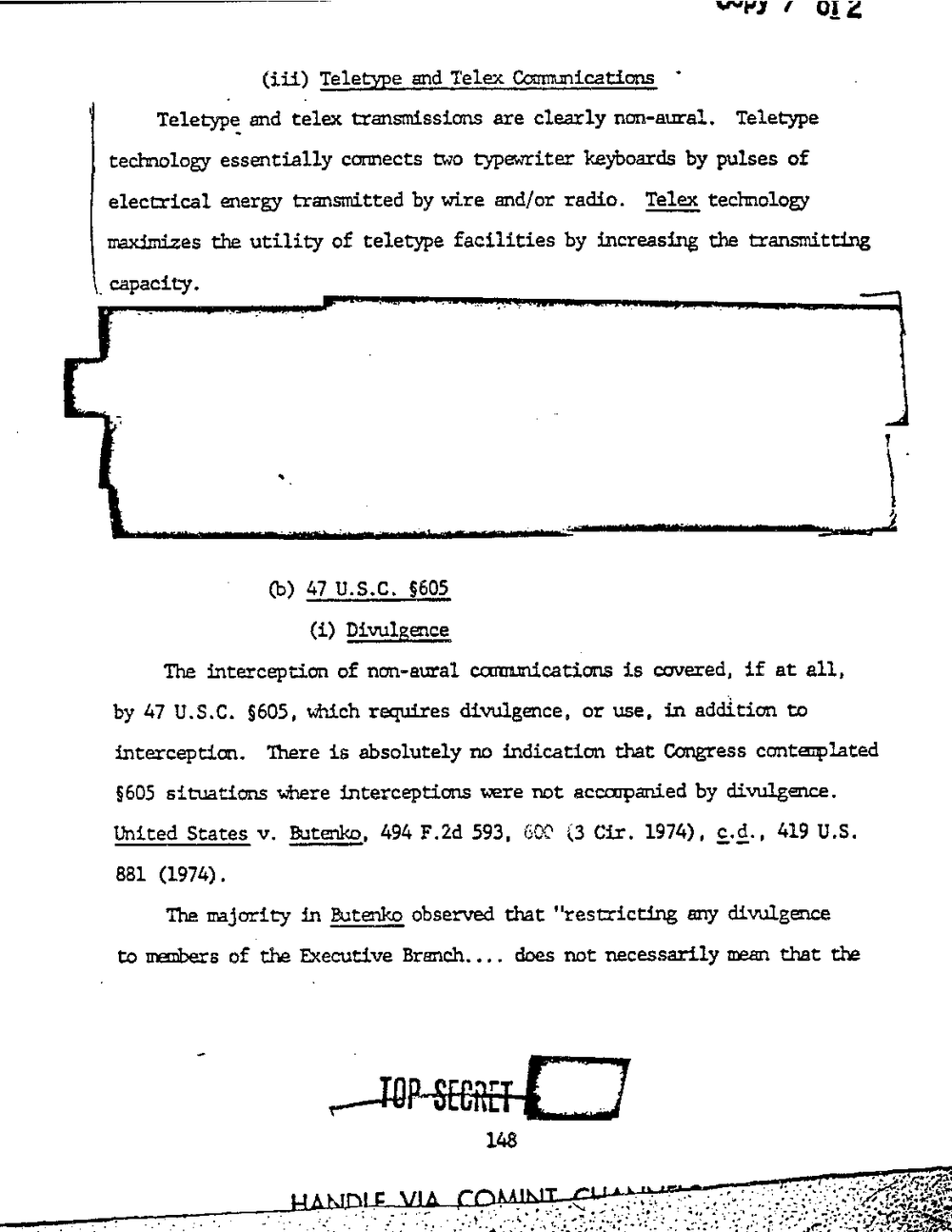
01
Teletype and Telex Coammications
Teletype and telex transmissions are clearly non-aural. Teletype
technology essentially connects two typewriter keyboards by pulses of
electrical energy transmitted by wire and/or radio. 2939; technology
umdmizes the utility of teletype facilities by increasing the transmitting
capacity.
47 U.S.C. 5605
Divulgence
The interception of non-aural communications is covered, if at all.
by 47 U.S.C. secs, which requires divulgence, or use. in addition to
interception. There is absolutely no indication that Congress contemplated
situations where interceptions were not accoupanied by divulgence.
United States v. m, 494 F.2d 593, (3 Cir. 1974). 419 13.5.
881 (1974).
The majority in observed that "restricting any divulgence
to members of the Executive Branch. . . . does not necessarily man that the
01
Teletype and Telex Coammications
Teletype and telex transmissions are clearly non-aural. Teletype
technology essentially connects two typewriter keyboards by pulses of
electrical energy transmitted by wire and/or radio. 2939; technology
umdmizes the utility of teletype facilities by increasing the transmitting
capacity.
47 U.S.C. 5605
Divulgence
The interception of non-aural communications is covered, if at all.
by 47 U.S.C. secs, which requires divulgence, or use. in addition to
interception. There is absolutely no indication that Congress contemplated
situations where interceptions were not accoupanied by divulgence.
United States v. m, 494 F.2d 593, (3 Cir. 1974). 419 13.5.
881 (1974).
The majority in observed that "restricting any divulgence
to members of the Executive Branch. . . . does not necessarily man that the
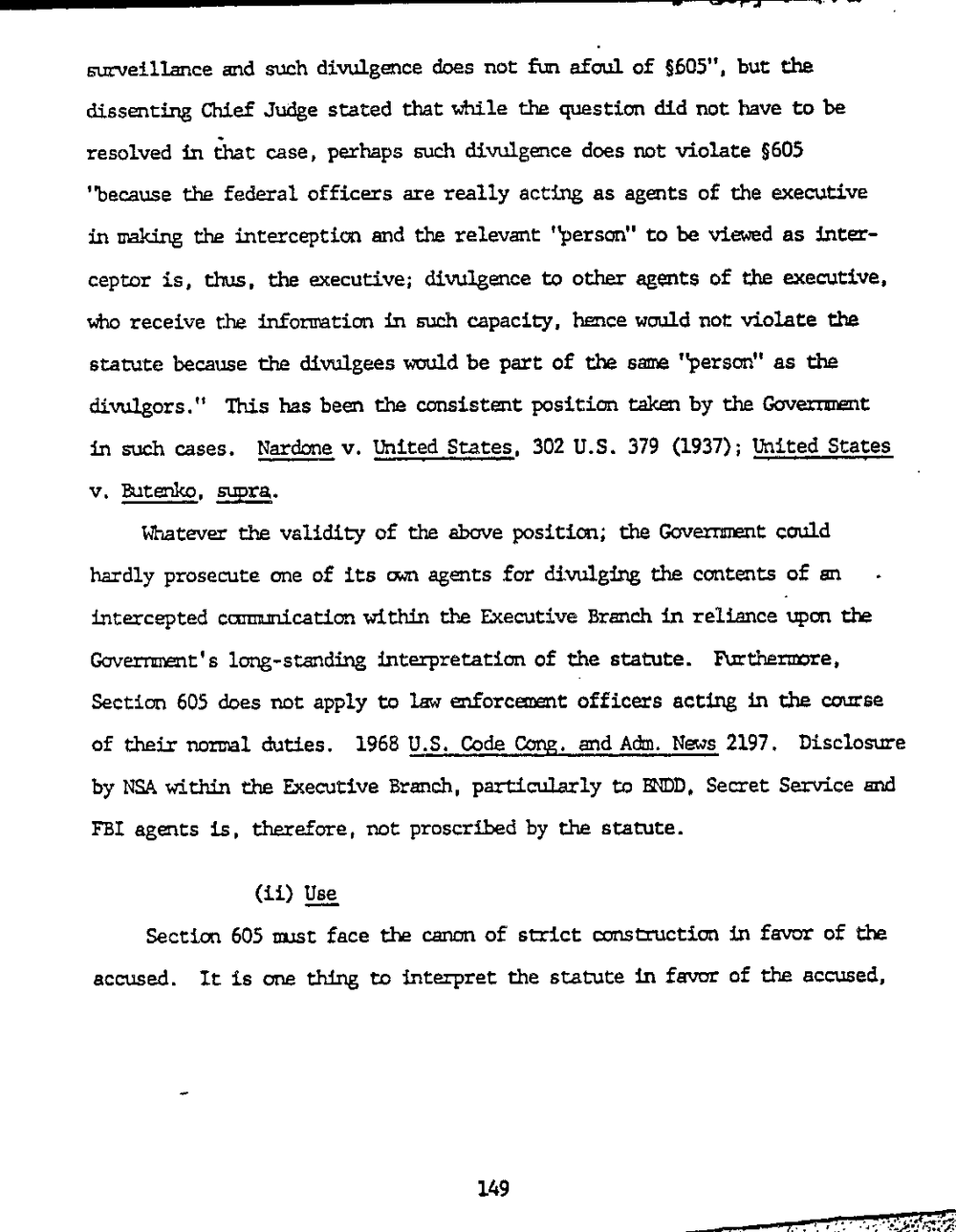
m??f?w
surveillance and such divulgence does not Em afoul of 5505", but the
dissenting Chief Judge stated that while the question did not have to be
resolved in that case, perhaps such divulgence does not violate ?605
"because the federal officers are really acting as agents of the executive
in making the interception and the relevant "person" to be viewed as inter-
ceptor is, thus. the executive; divulgence to other agents of the executive.
who receive the information in such capacity, hence would not violate the
statute because the divulgees would be part of the same "person" as the
divulgors." This has been the consistent position taken by the Government
in arch cases. Nardone v. United States, 302 U.S. 379 (1937); United States
v. We. aera-
Whatever the validity of the above position; the could
hardly prosecute one of its own agents for divulging the contents of an
intacepted communication within the Executive Branch in reliance 'upon the
Goverrmt's long-staiding interpretation of the statute. Rathermore,
Section 605 does not apply to law mforcenent officers acting in the course
of their nor-cal duties. 1968 U.S. Code Gong. and Adm. News 2197. Disclosure
by NSA within the Executive Branch, particularly to BNDD. Secret Service and
FBI agents is. therefore, not proscribed by the statute.
(ii) Elsa
Section 605 mat face the canon of strict construction in favor of the
accused. It is one thing to interpret the statute in favor of the accused,
149
m??f?w
surveillance and such divulgence does not Em afoul of 5505", but the
dissenting Chief Judge stated that while the question did not have to be
resolved in that case, perhaps such divulgence does not violate ?605
"because the federal officers are really acting as agents of the executive
in making the interception and the relevant "person" to be viewed as inter-
ceptor is, thus. the executive; divulgence to other agents of the executive.
who receive the information in such capacity, hence would not violate the
statute because the divulgees would be part of the same "person" as the
divulgors." This has been the consistent position taken by the Government
in arch cases. Nardone v. United States, 302 U.S. 379 (1937); United States
v. We. aera-
Whatever the validity of the above position; the could
hardly prosecute one of its own agents for divulging the contents of an
intacepted communication within the Executive Branch in reliance 'upon the
Goverrmt's long-staiding interpretation of the statute. Rathermore,
Section 605 does not apply to law mforcenent officers acting in the course
of their nor-cal duties. 1968 U.S. Code Gong. and Adm. News 2197. Disclosure
by NSA within the Executive Branch, particularly to BNDD. Secret Service and
FBI agents is. therefore, not proscribed by the statute.
(ii) Elsa
Section 605 mat face the canon of strict construction in favor of the
accused. It is one thing to interpret the statute in favor of the accused,
149
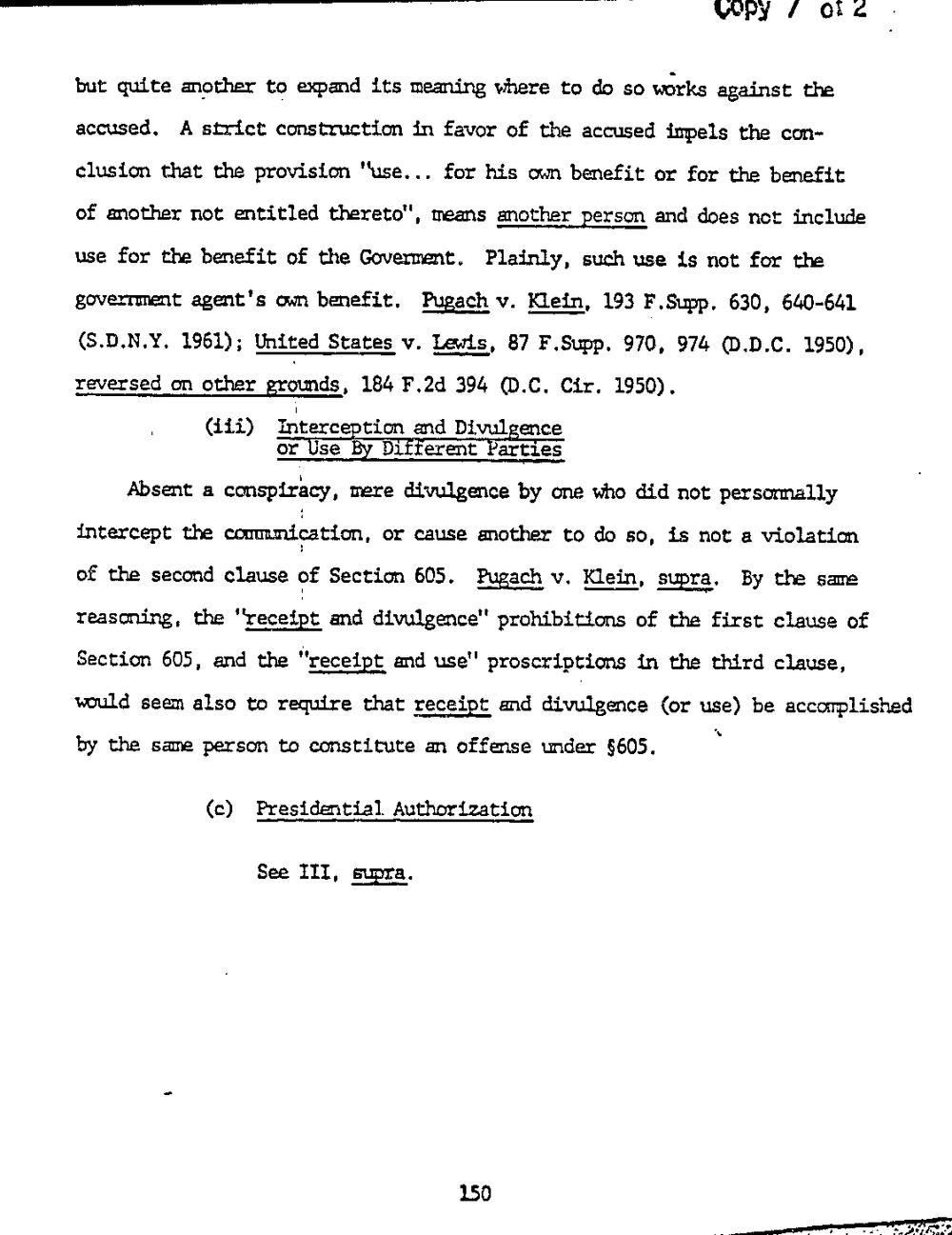
0X 2
but quite mother to expand its meaning where to do so works against the
accused. A strict construction in favor of the accused impels the con-
clusion that the provision "use. . . for his own benefit or for the benefit
of another not entitled thereto", means another person and does not include
use for the benefit of the Govement. Plainly, such use is not for the
government agent's own benefit. Pugach v. Klein. 193 630, 640-641
(S.D.N.Y. 1961); United States v. Lewis, 87 F.Supp. 970. 974 (D.D.C. 1950),
reversed on other gromds. 184 F.2d 394 (D.C. Cir. 1950) .
Interception and Divulgence
or Use gr Different Parties
Absent a conspiracy, mere divulgence by one who did not persomally
intercept the contamination. or cause another to do so, is not a violation
of the second clause of Section 605. Pugach v. Klein. supra. By the same
reasoning, the "r_eoe_i?oLt and divulgence" prohibitions of the first clause of
Section 605, and the "?33in and use" proscriptions in the third clause,
would seem also to require that receipt and divulgence (or use) be accomplished
by the sane person to constitute an offense under s605. .
Presidential Authorization
See 5932;.
150
?9
4
0X 2
but quite mother to expand its meaning where to do so works against the
accused. A strict construction in favor of the accused impels the con-
clusion that the provision "use. . . for his own benefit or for the benefit
of another not entitled thereto", means another person and does not include
use for the benefit of the Govement. Plainly, such use is not for the
government agent's own benefit. Pugach v. Klein. 193 630, 640-641
(S.D.N.Y. 1961); United States v. Lewis, 87 F.Supp. 970. 974 (D.D.C. 1950),
reversed on other gromds. 184 F.2d 394 (D.C. Cir. 1950) .
Interception and Divulgence
or Use gr Different Parties
Absent a conspiracy, mere divulgence by one who did not persomally
intercept the contamination. or cause another to do so, is not a violation
of the second clause of Section 605. Pugach v. Klein. supra. By the same
reasoning, the "r_eoe_i?oLt and divulgence" prohibitions of the first clause of
Section 605, and the "?33in and use" proscriptions in the third clause,
would seem also to require that receipt and divulgence (or use) be accomplished
by the sane person to constitute an offense under s605. .
Presidential Authorization
See 5932;.
150
?9
4
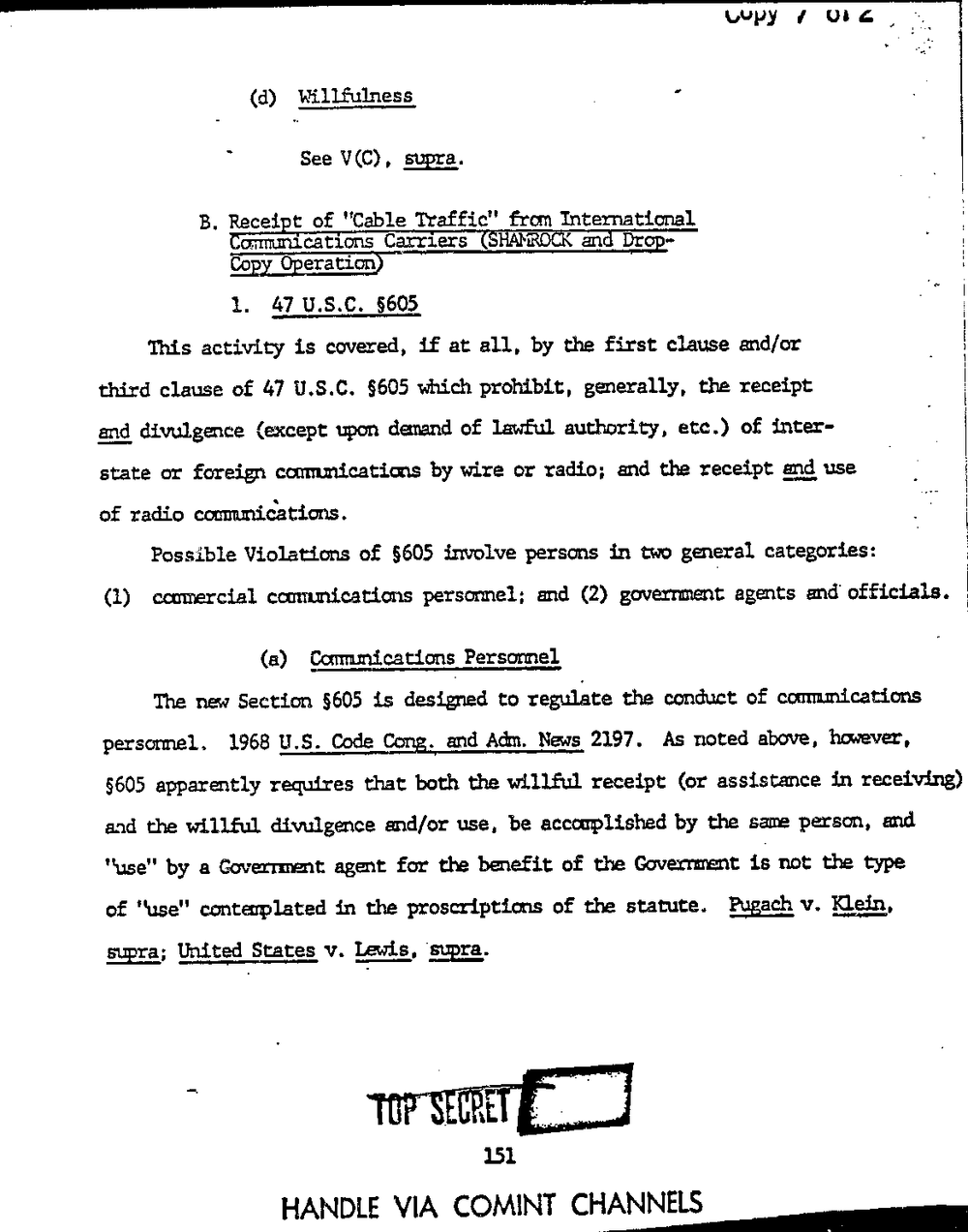
cum I on:
Willfulness
See m.
B. Receipt of "Cable Traffic" from International
Commuications Car?ers (3mm and Drop-
Cop): @erationi
1. 47 U.S.C. 5605
This activity is covered, if at all, by the first clause and/or
third clause of 47 U.S.C. 5605 which prohibit, generally, the receipt
and divulgence {accept upon demand of lawful authority, etc.) of inter-
state or foreign corrmnications by wire or radio; and the receipt use
of radio communications .
Possible Violations of 5605 involve persons in two general categories:
(1) commercial coununications persomel; and (2) goverrment agents md' officials.
Cannmications Persomel
The new Section 5605 is designed to regulate the conduct of cormunications
personnel. 1968 11.5. Code Gong: and Adm. Nears 2197. As noted above. havever,
5605 apparently requires that both the willful receipt (or assistance in receiving)
and the willful divulgence and/or use, he accou'plished by the same person, and
"use" by a Govermmt agent for the bmefit of the Govth it not tIe type
of ?use? contemplated in the proscriptims of the statute. Pugach v. Klein,
supra; United States v. lewis. supra.
HANDLE VIA CHANNELS
cum I on:
Willfulness
See m.
B. Receipt of "Cable Traffic" from International
Commuications Car?ers (3mm and Drop-
Cop): @erationi
1. 47 U.S.C. 5605
This activity is covered, if at all, by the first clause and/or
third clause of 47 U.S.C. 5605 which prohibit, generally, the receipt
and divulgence {accept upon demand of lawful authority, etc.) of inter-
state or foreign corrmnications by wire or radio; and the receipt use
of radio communications .
Possible Violations of 5605 involve persons in two general categories:
(1) commercial coununications persomel; and (2) goverrment agents md' officials.
Cannmications Persomel
The new Section 5605 is designed to regulate the conduct of cormunications
personnel. 1968 11.5. Code Gong: and Adm. Nears 2197. As noted above. havever,
5605 apparently requires that both the willful receipt (or assistance in receiving)
and the willful divulgence and/or use, he accou'plished by the same person, and
"use" by a Govermmt agent for the bmefit of the Govth it not tIe type
of ?use? contemplated in the proscriptims of the statute. Pugach v. Klein,
supra; United States v. lewis. supra.
HANDLE VIA CHANNELS
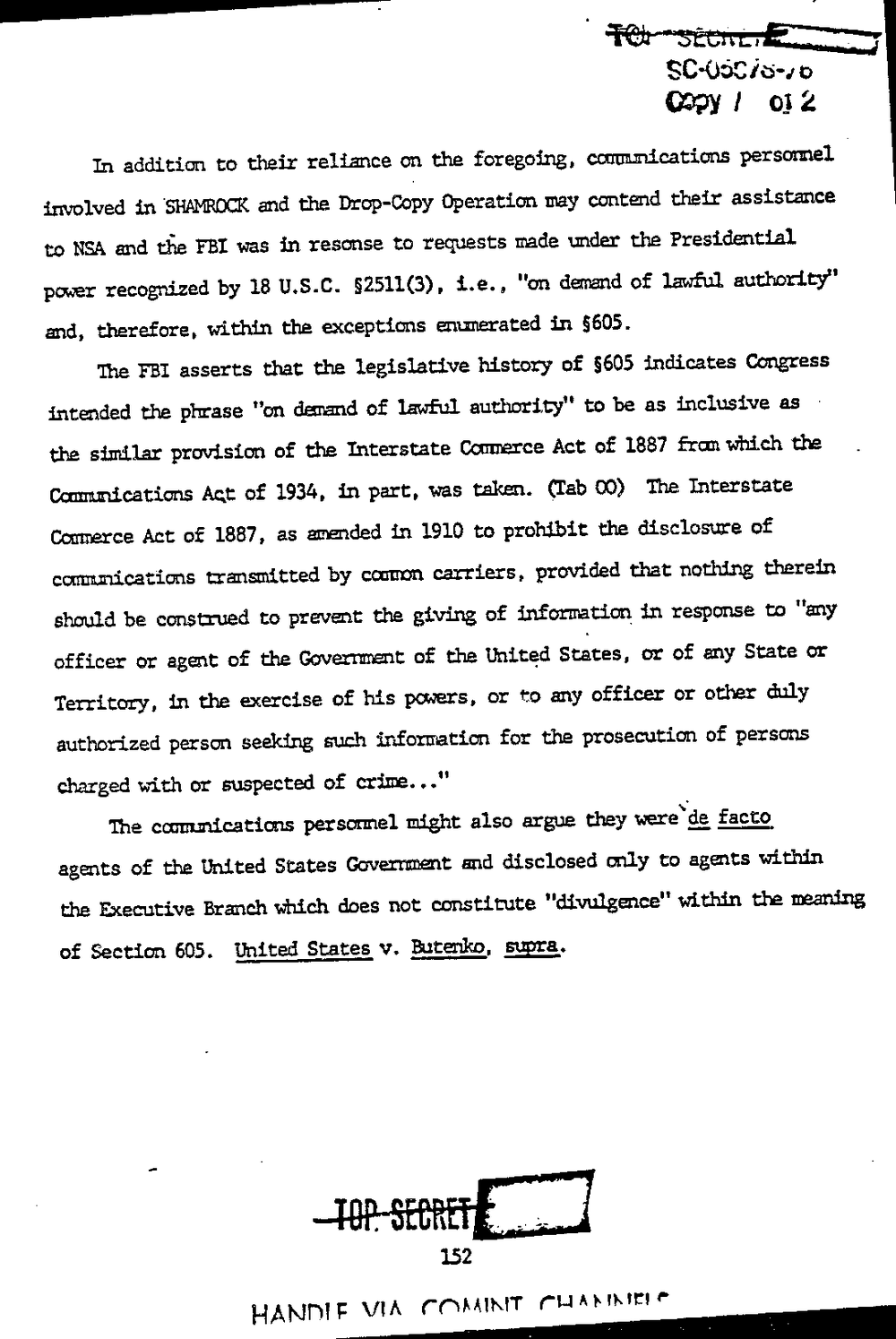
?t - . .
SC-O?Cio-vo
WY I 2
In addition to their reliance on the foregoing, couumications persomel I
involved in SHAMROCK and the Drop-Copy Operation may contend their assistance
resonse to requests made under the Presidmtial
power recognized by 18 U.S.C. ?251l(3). "on danand of lawful authority"
md, therefore, within the exceptions enmerated in ?605.
The FBI asserts that the legislative history of ?605 indicates Congress
intended the phrase "on danand of law?il authority" to be as inclusive as -
the similar provision of the Interstate Commerce Act of 1887 from which the
Commications Act of 1934, in part, was taken. (Tab 00) The Interstate
Commerce Act of 1887, as mded in 1910 to prohibit the disclosure of
cormmications transmitted by cocoon carriers, provided that nothing therein
should be construed to prevent the giving of information in response to "any
officer or agent of the Cover-th of the United States, or of any State or
Territory, in the ext-noise of his powers, or to any officer or other duly
authorized person seeking such information for the prosecution of persons
charged with or suspected of crime.
The ccnumications persomel might also argue they mex'gg Q9129,
agmts of the United States Goverrment and disclosed only to agents within
the Executive Branch which does not constitute "divulgence" within the meaning
of Section 605. United States v. w. ma.
1.52
HANDIF VIA runmmr
?t - . .
SC-O?Cio-vo
WY I 2
In addition to their reliance on the foregoing, couumications persomel I
involved in SHAMROCK and the Drop-Copy Operation may contend their assistance
resonse to requests made under the Presidmtial
power recognized by 18 U.S.C. ?251l(3). "on danand of lawful authority"
md, therefore, within the exceptions enmerated in ?605.
The FBI asserts that the legislative history of ?605 indicates Congress
intended the phrase "on danand of law?il authority" to be as inclusive as -
the similar provision of the Interstate Commerce Act of 1887 from which the
Commications Act of 1934, in part, was taken. (Tab 00) The Interstate
Commerce Act of 1887, as mded in 1910 to prohibit the disclosure of
cormmications transmitted by cocoon carriers, provided that nothing therein
should be construed to prevent the giving of information in response to "any
officer or agent of the Cover-th of the United States, or of any State or
Territory, in the ext-noise of his powers, or to any officer or other duly
authorized person seeking such information for the prosecution of persons
charged with or suspected of crime.
The ccnumications persomel might also argue they mex'gg Q9129,
agmts of the United States Goverrment and disclosed only to agents within
the Executive Branch which does not constitute "divulgence" within the meaning
of Section 605. United States v. w. ma.
1.52
HANDIF VIA runmmr
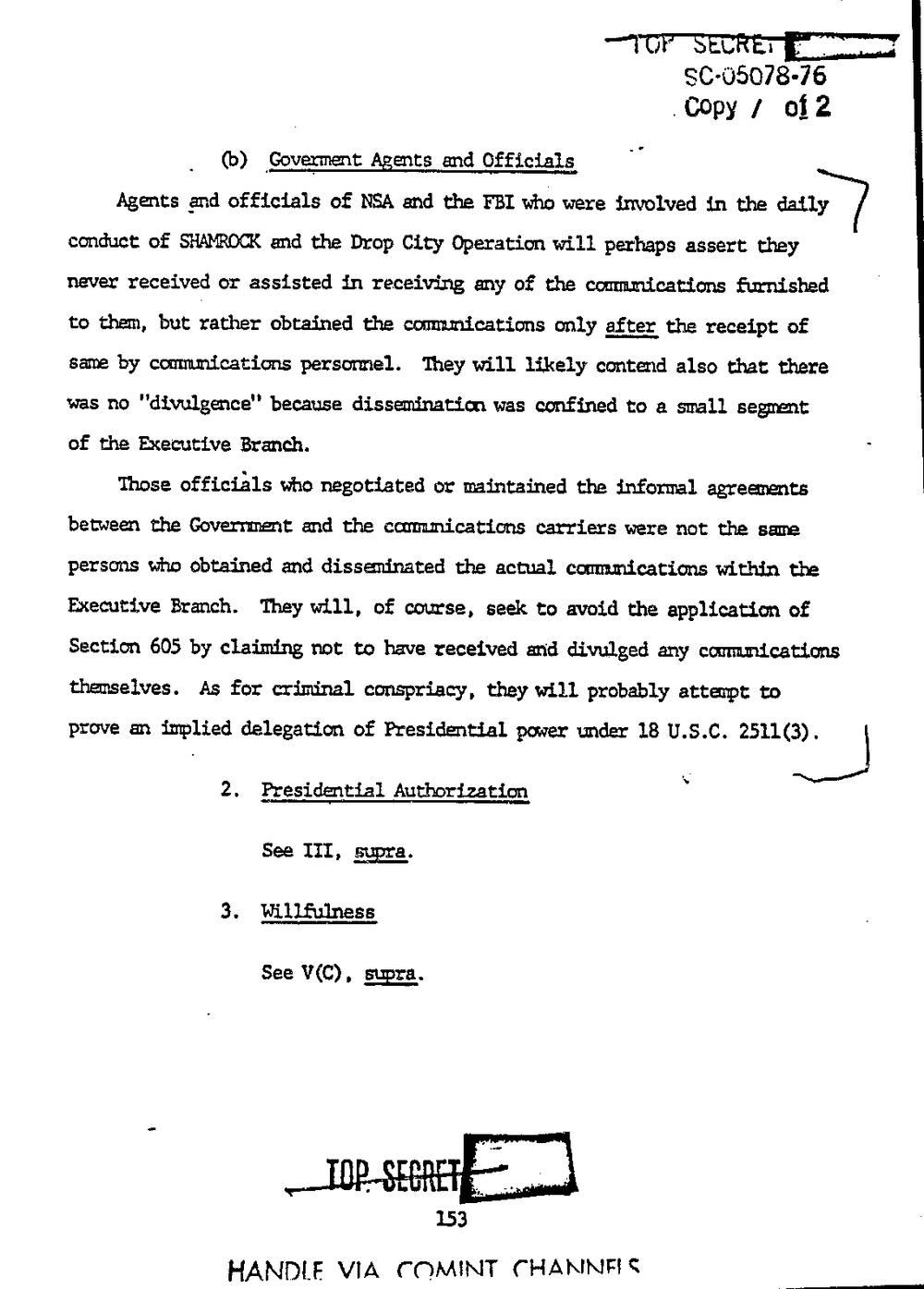
?1 or smith: --
800507846
. Copy 012
Goverment Agents and Officials
Agents and officials of NSA and the FBI were involved in the dailn
conduct of 51W and the Drop City Operation will perhaps assert they
never received or assisted in receiving any of the communications furnished
to them, but rather obtained the commieations only age; the receipt of
same by coammications personnel. They will likely contend also that there
was no "divulge-ace" because dissemination was confined to a small segment
of the Executive Branch.
Those officials who negotiated or maintained the informal agreements
between the Goverrment and the cconmications carriers were not the same
persons who obtained and disseminated the actual counmications within the
Executive Branch. They will, of course. seek to avoid the application of
Section 605 by claiming not to have received and divulged any
themselves. As for criminal conspriacy, they will probably attempt to
prove an implied delegation of Presidential power under 18 U.S.C.
2 . Presidential Authorization
See m.
3. Will??ness
See VCC) . m,
HANDLE VIA FHANNFIQ
?1 or smith: --
800507846
. Copy 012
Goverment Agents and Officials
Agents and officials of NSA and the FBI were involved in the dailn
conduct of 51W and the Drop City Operation will perhaps assert they
never received or assisted in receiving any of the communications furnished
to them, but rather obtained the commieations only age; the receipt of
same by coammications personnel. They will likely contend also that there
was no "divulge-ace" because dissemination was confined to a small segment
of the Executive Branch.
Those officials who negotiated or maintained the informal agreements
between the Goverrment and the cconmications carriers were not the same
persons who obtained and disseminated the actual counmications within the
Executive Branch. They will, of course. seek to avoid the application of
Section 605 by claiming not to have received and divulged any
themselves. As for criminal conspriacy, they will probably attempt to
prove an implied delegation of Presidential power under 18 U.S.C.
2 . Presidential Authorization
See m.
3. Will??ness
See VCC) . m,
HANDLE VIA FHANNFIQ
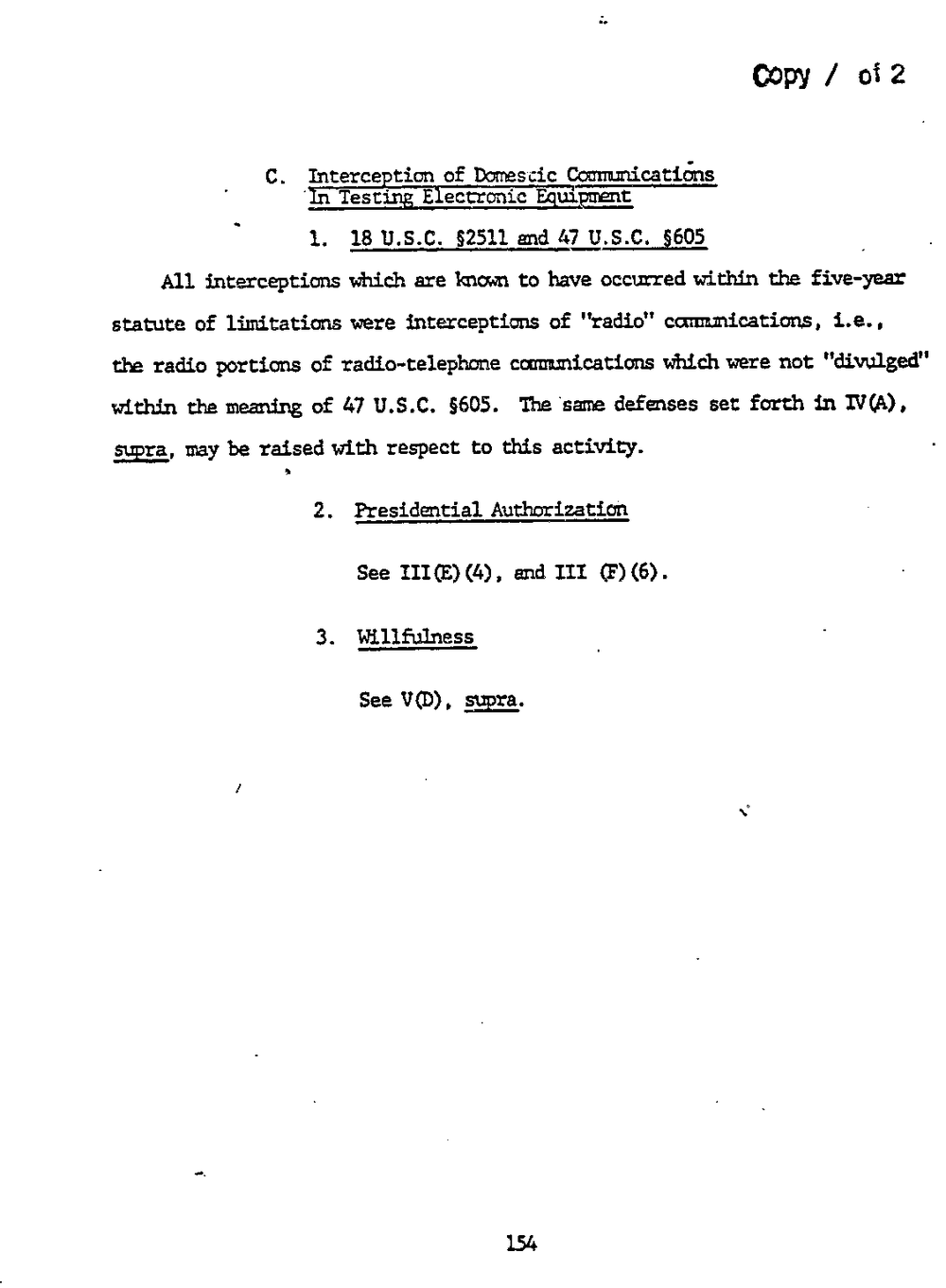
C. Interception of Domescic Cmnmioations
'In Testing Electronic Equipumt
l. 18 11.8.0. 52511 and U.S.C. 5605
.
All interceptions which are known to have occurred within the five-year
statute of limitations were interceptions of "radio" cummioations. i.e. .
the radio portions of radio?telephone counmications which were not "divulged"
within the meaning of 47 U.S.C. 5605. The same defenses set forth in IVCA),
m3, may be raised with respect to this activity.
2. Presidential Authorization
See (4) and (F) (6).
3. Mll??ness
See VCD) Era.
C. Interception of Domescic Cmnmioations
'In Testing Electronic Equipumt
l. 18 11.8.0. 52511 and U.S.C. 5605
.
All interceptions which are known to have occurred within the five-year
statute of limitations were interceptions of "radio" cummioations. i.e. .
the radio portions of radio?telephone counmications which were not "divulged"
within the meaning of 47 U.S.C. 5605. The same defenses set forth in IVCA),
m3, may be raised with respect to this activity.
2. Presidential Authorization
See (4) and (F) (6).
3. Mll??ness
See VCD) Era.
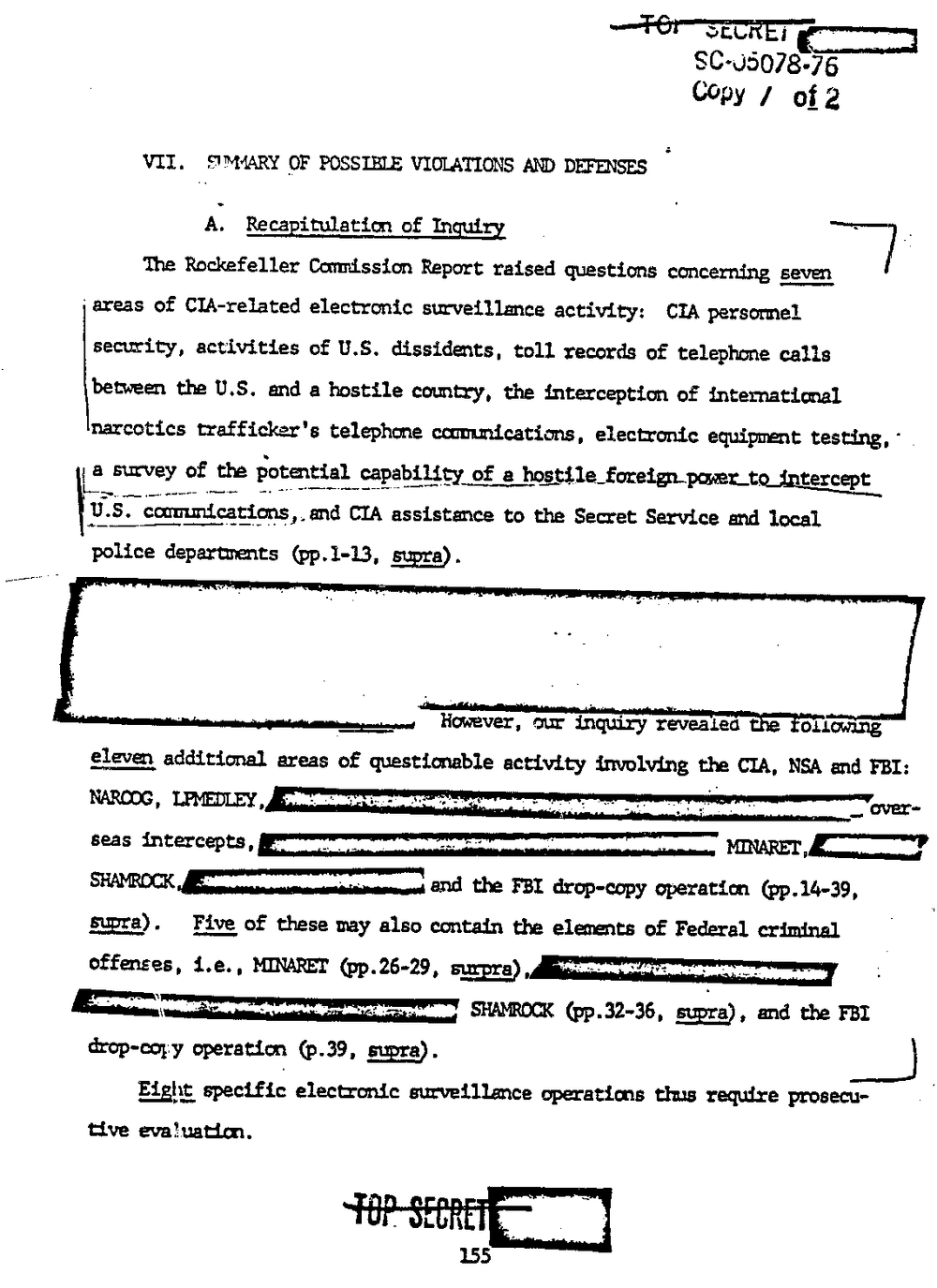
OLLREI
SC-05078-7 6
Copy 012
v11. 9mm: pt Possum: VIOLATIONS AND DEFENSBS
A. Recapitulation of Inquiry .
The Rockefeller Conmission Report raised questions concerning 59351 I
?areas of CIA-related electronic surveillance activity: CIA personnel
security, activities of U.S. dissidents, toll records of telephone calls
between the U.S. and a hostile comtry, the interception of international
narcotics trafficker's telephone mmications, electronic equipnmt testing.
a me of the ?otmtial ca abili of a hostilejorei . terc
If. mm
I
.
Dis. coonmicagions and CIA assistance to the Secret Service and local
u?u-
police (pp.l-IL3.
7 However; our revealed 3'13 founding
eleven additional areas of questionable activity involving the CIA. NSA and FBI:
seas intercepts, a '5 MARBLE,
- and the FBI drop-copy?operaticn (pp.14-39.
ma) . 11132; of these may also contain the elements of Federal criminal
offenses, mm (pp.26-29, Ema).
Simmocx (pp.32-36, and the FBI
drop-cow operation (p.39. ma).
Eight specific electronic surveillance operations thus require prosecu-
tive evaEuadm.
OLLREI
SC-05078-7 6
Copy 012
v11. 9mm: pt Possum: VIOLATIONS AND DEFENSBS
A. Recapitulation of Inquiry .
The Rockefeller Conmission Report raised questions concerning 59351 I
?areas of CIA-related electronic surveillance activity: CIA personnel
security, activities of U.S. dissidents, toll records of telephone calls
between the U.S. and a hostile comtry, the interception of international
narcotics trafficker's telephone mmications, electronic equipnmt testing.
a me of the ?otmtial ca abili of a hostilejorei . terc
If. mm
I
.
Dis. coonmicagions and CIA assistance to the Secret Service and local
u?u-
police (pp.l-IL3.
7 However; our revealed 3'13 founding
eleven additional areas of questionable activity involving the CIA. NSA and FBI:
seas intercepts, a '5 MARBLE,
- and the FBI drop-copy?operaticn (pp.14-39.
ma) . 11132; of these may also contain the elements of Federal criminal
offenses, mm (pp.26-29, Ema).
Simmocx (pp.32-36, and the FBI
drop-cow operation (p.39. ma).
Eight specific electronic surveillance operations thus require prosecu-
tive evaEuadm.
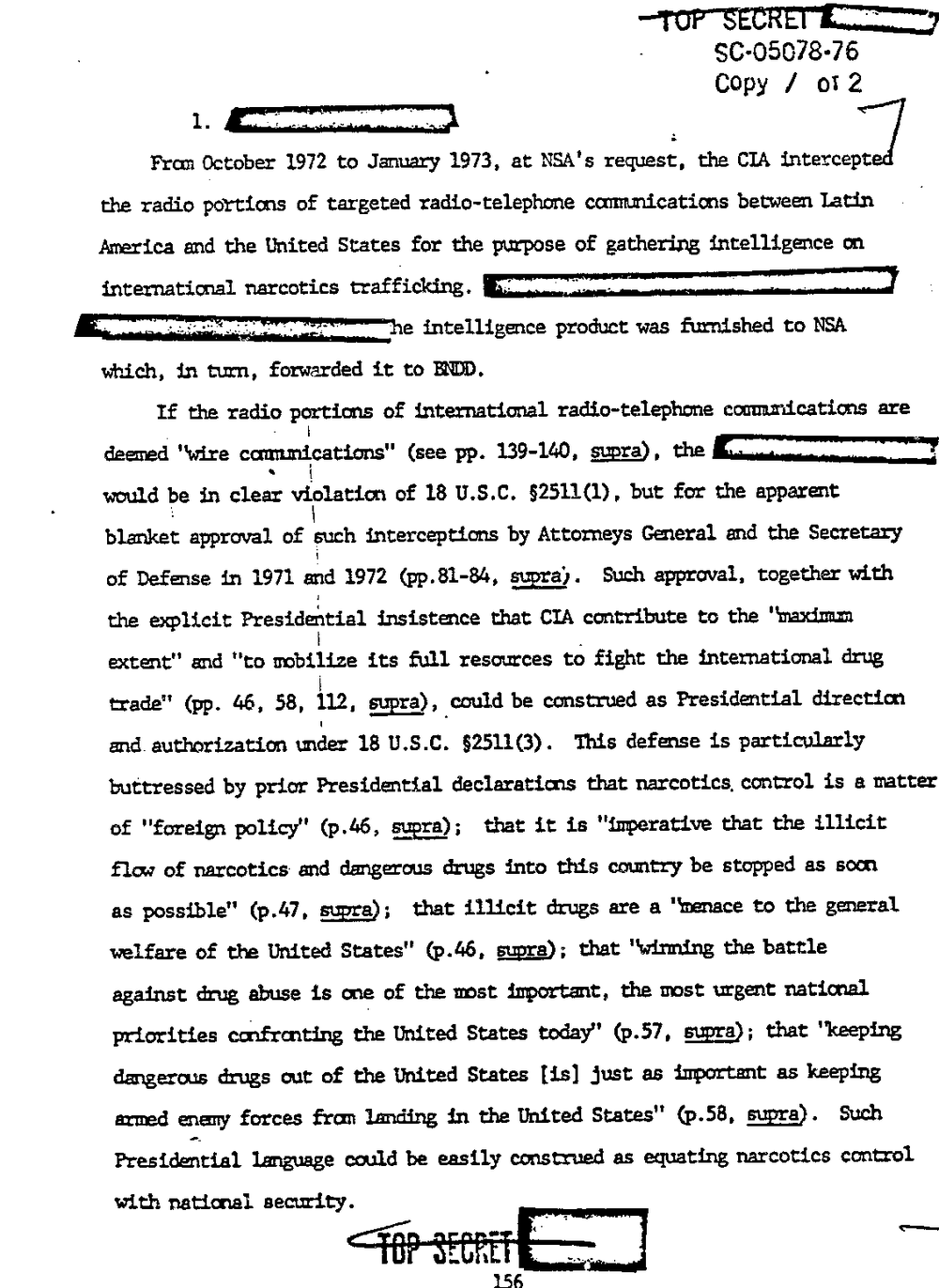
- 50-05078-76
COpy or 2
1.
Fran October 1972 to January 1973, at NSA's request, the CIA intercept
the radio portims of targeted radio-telephone cammications between Latin
America and the United States for the purpose of gathering intelligence on
internatimal narcotics trafficking.
intelligence product was furnished to NSA
which, in turn, forwarded it to m.
If the radio portions of international radio-telephone are
deemed "wire cadumications" (see pp. 139?140, was). the
would be in clear violation of 18 U.S.C. 525110) but for the apparent
blanket approval of \such interceptions by Attorneys General and the Secretary
of Defense in 1971 and 1972 (pp.81-84, we) . Such approval. together with
the explicit Presidential insistence that CIA contribute to the 'beximm
extent" and ?to mobilize its full resources to fight the international drug
1+6. 58, llZ, Eggs), could be construed as Presidential direction
and. authorization under 18 U.S.C. 525110) . 'Ihis defense is particularly
buttressed by prior Presidential declarations that narcotics, control is a matter
of "foreig1 policy" (p.46, supra; that it is "imperative that the illicit
flow of narcotics and dangerous drugs into this comtry be stopped as soon
as possible" (p.47, mg); that illicit drugs are a "menace to the general
welfare of the United States" (p.45, me); that ?kwkming the battle
against drug abuse is one of the most inportmt, the most urgent mtimal
priorities tats:th the United States today" (p.57, m; that 'keepmg
dangerous drugs out of the United States [is] just as important as keeping
armed enany forces landing in the United States" (p.58, mg). Such
Presidential language could be easily construed as equating narcotics control
with natimal semity.
- 50-05078-76
COpy or 2
1.
Fran October 1972 to January 1973, at NSA's request, the CIA intercept
the radio portims of targeted radio-telephone cammications between Latin
America and the United States for the purpose of gathering intelligence on
internatimal narcotics trafficking.
intelligence product was furnished to NSA
which, in turn, forwarded it to m.
If the radio portions of international radio-telephone are
deemed "wire cadumications" (see pp. 139?140, was). the
would be in clear violation of 18 U.S.C. 525110) but for the apparent
blanket approval of \such interceptions by Attorneys General and the Secretary
of Defense in 1971 and 1972 (pp.81-84, we) . Such approval. together with
the explicit Presidential insistence that CIA contribute to the 'beximm
extent" and ?to mobilize its full resources to fight the international drug
1+6. 58, llZ, Eggs), could be construed as Presidential direction
and. authorization under 18 U.S.C. 525110) . 'Ihis defense is particularly
buttressed by prior Presidential declarations that narcotics, control is a matter
of "foreig1 policy" (p.46, supra; that it is "imperative that the illicit
flow of narcotics and dangerous drugs into this comtry be stopped as soon
as possible" (p.47, mg); that illicit drugs are a "menace to the general
welfare of the United States" (p.45, me); that ?kwkming the battle
against drug abuse is one of the most inportmt, the most urgent mtimal
priorities tats:th the United States today" (p.57, m; that 'keepmg
dangerous drugs out of the United States [is] just as important as keeping
armed enany forces landing in the United States" (p.58, mg). Such
Presidential language could be easily construed as equating narcotics control
with natimal semity.
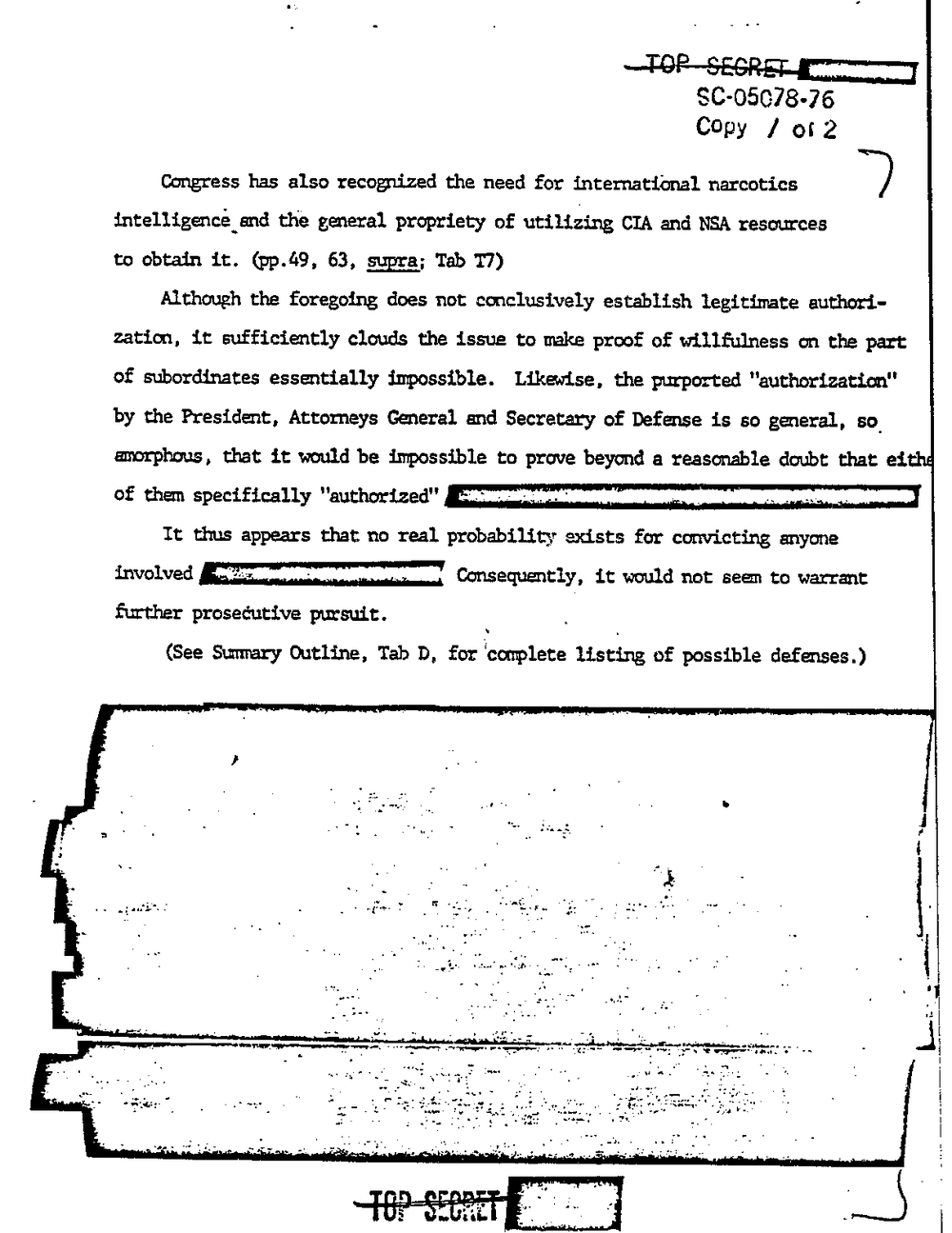
80-05078-76
or 2
Congress has also recognized the need for international narcotics ?7
intelligenc??nd the general propriety of utilising CIA and NSA resources
to obtain it. (1:13.49, 63, ?22; Tab '17)
Although the foregoing does not conclusively establish legitimate authori-
zation, it sufficiently clouds the issue to make proof of willfulness on the part
of subordinates essentially impossible. Likewise, the purported "authorization"
by the President. Attorneys General and Secretary of Defense is so general. so_
arrorphous, that it would be impossible to prove beyond a reasonable doubt that eitha
of them specifically "authorized"
It thus appears that no real probability exists for convicting anyone
involved Consequently, it would not seem to warrant:
?rther prosec?utive pursuit .
(See Surmary Outline, Tab D, for "complete listing of possible defenses.)
80-05078-76
or 2
Congress has also recognized the need for international narcotics ?7
intelligenc??nd the general propriety of utilising CIA and NSA resources
to obtain it. (1:13.49, 63, ?22; Tab '17)
Although the foregoing does not conclusively establish legitimate authori-
zation, it sufficiently clouds the issue to make proof of willfulness on the part
of subordinates essentially impossible. Likewise, the purported "authorization"
by the President. Attorneys General and Secretary of Defense is so general. so_
arrorphous, that it would be impossible to prove beyond a reasonable doubt that eitha
of them specifically "authorized"
It thus appears that no real probability exists for convicting anyone
involved Consequently, it would not seem to warrant:
?rther prosec?utive pursuit .
(See Surmary Outline, Tab D, for "complete listing of possible defenses.)
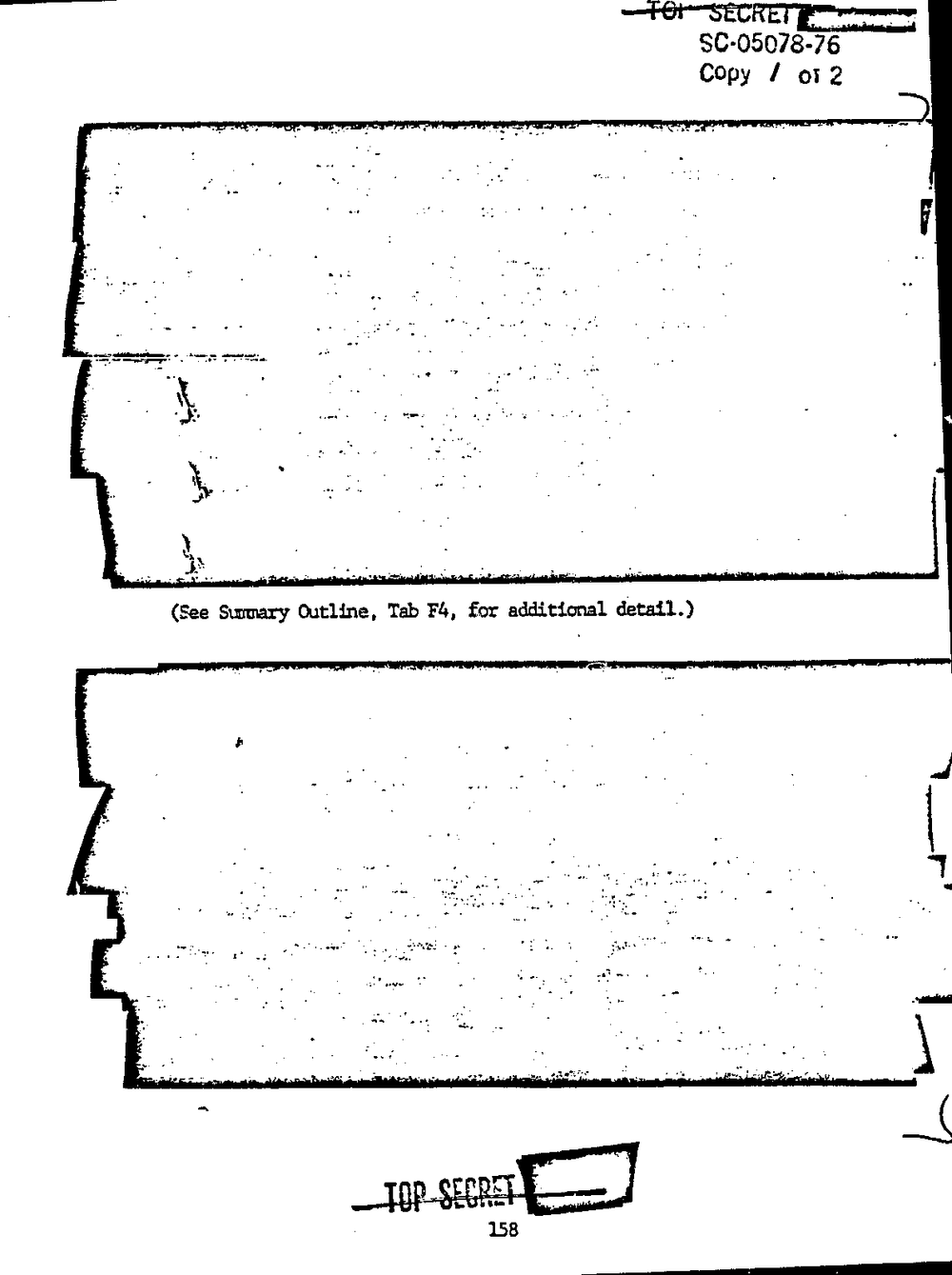
30-05078-
30-05078-
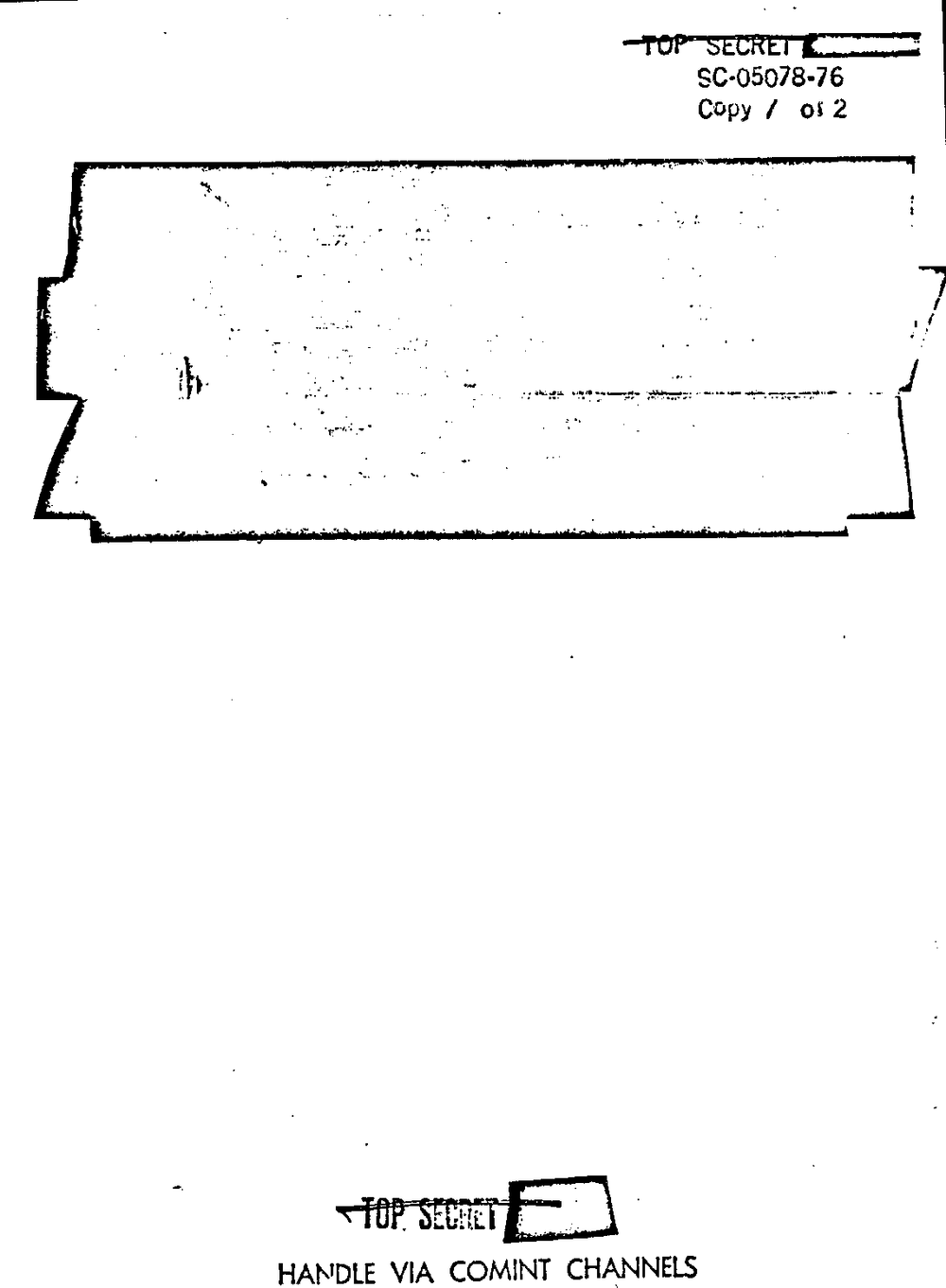
80-05078-Ignt
.
. . .-. .
. I
- ltd; Mid mun?cl- - awn?Ir. .- ?nu-It tn- .Iui-u- uncu- cup-luHit- a
HANDLE VIA COMINT CHANNELS
80-05078-Ignt
.
. . .-. .
. I
- ltd; Mid mun?cl- - awn?Ir. .- ?nu-It tn- .Iui-u- uncu- cup-luHit- a
HANDLE VIA COMINT CHANNELS
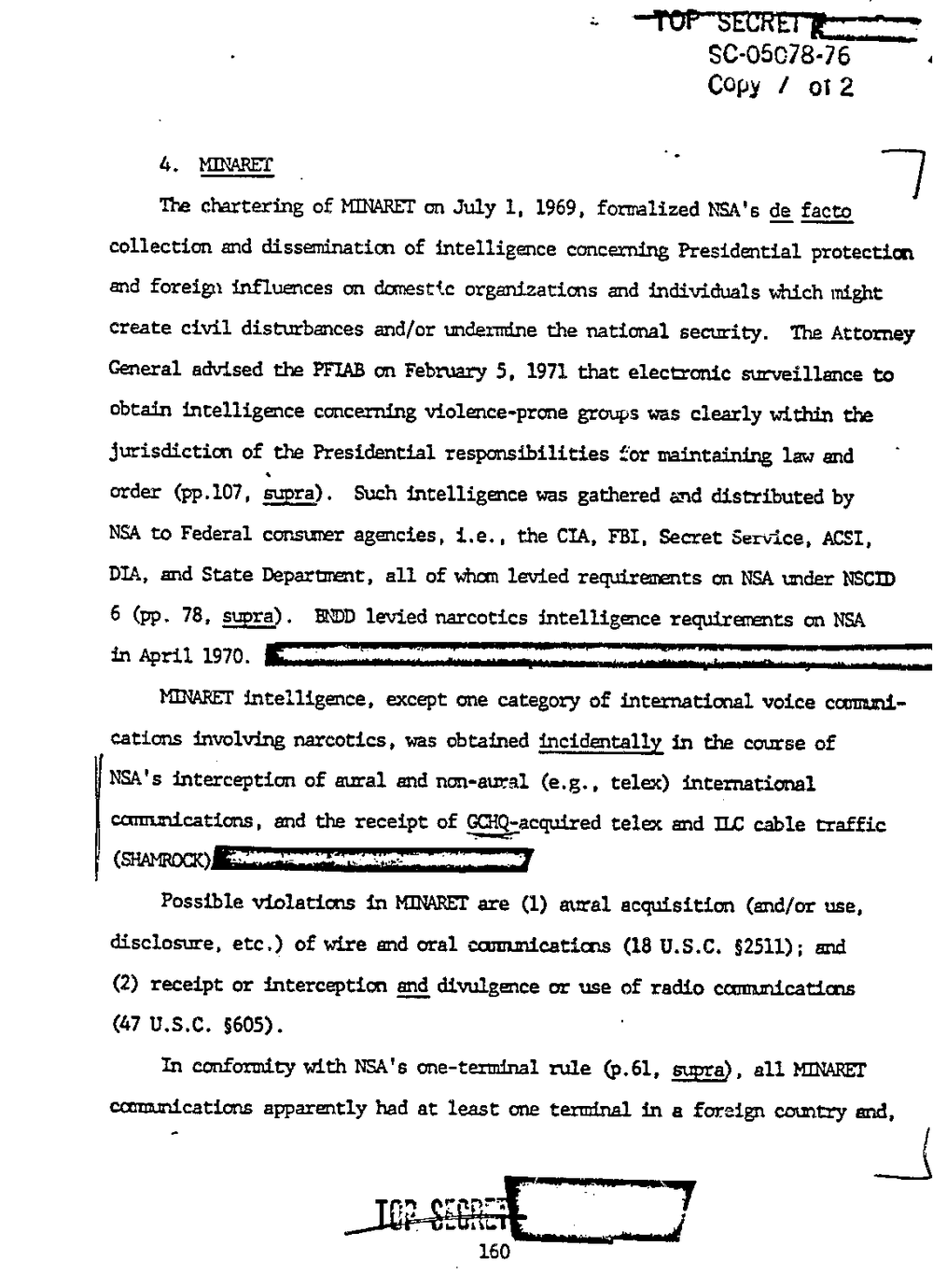
80-05078-76
COpy OIZ
.7
collection and dissenu?nation of intelligence concerning Presidential protection
The chartering of on July 1. 1969. formalized NSA's g_e_ facto
and foreign influences on domestic organizations and individuals which might
create civil disturbances and/or undermine the national security. The Attorney
General advised the PFLAB on February 5, 1971 that electronic surveillance to
obtain intelligence concerning violence-prone groups was clearly within the
jurisdiction of the Presidential responsibilities for maintaining law and
order (pp.lO7, $1.223). Such intelligence was gathered and distributed by
NSA to Federal consumr agencies. i.e. . the CIA, FBI, Secret Service. ACSI,
DIA, and State Deparmaent. all of levied reqx?xeamts on NSA under NSCID
6 (pp. 78, m) . ENDD levied narcotics intelligence requirenents on NSA
in April 1970.
mass-r intelligence, except one category of international voice commi-
cations involving narcotics. was obtained incidentally in the course of
NSA's interception of aural and non-aural g. telex) international
cummications. and the receipt of ?acquired telex mud 118 cable traffic
(W)
Possible violations in WET are (1) aural acquisition (and/or use.
disclosure, etc.) of wire and oral cwnmicatims (18 U.S.C. 52511); and
(2) receipt or interception and divulgance or use of radio
(47 U.S.C. 5605).
In conformity with NSA's one-terminal rule (p.61, My, all
apparently had at least one termnal in a foreign comtry mad,
80-05078-76
COpy OIZ
.7
collection and dissenu?nation of intelligence concerning Presidential protection
The chartering of on July 1. 1969. formalized NSA's g_e_ facto
and foreign influences on domestic organizations and individuals which might
create civil disturbances and/or undermine the national security. The Attorney
General advised the PFLAB on February 5, 1971 that electronic surveillance to
obtain intelligence concerning violence-prone groups was clearly within the
jurisdiction of the Presidential responsibilities for maintaining law and
order (pp.lO7, $1.223). Such intelligence was gathered and distributed by
NSA to Federal consumr agencies. i.e. . the CIA, FBI, Secret Service. ACSI,
DIA, and State Deparmaent. all of levied reqx?xeamts on NSA under NSCID
6 (pp. 78, m) . ENDD levied narcotics intelligence requirenents on NSA
in April 1970.
mass-r intelligence, except one category of international voice commi-
cations involving narcotics. was obtained incidentally in the course of
NSA's interception of aural and non-aural g. telex) international
cummications. and the receipt of ?acquired telex mud 118 cable traffic
(W)
Possible violations in WET are (1) aural acquisition (and/or use.
disclosure, etc.) of wire and oral cwnmicatims (18 U.S.C. 52511); and
(2) receipt or interception and divulgance or use of radio
(47 U.S.C. 5605).
In conformity with NSA's one-terminal rule (p.61, My, all
apparently had at least one termnal in a foreign comtry mad,
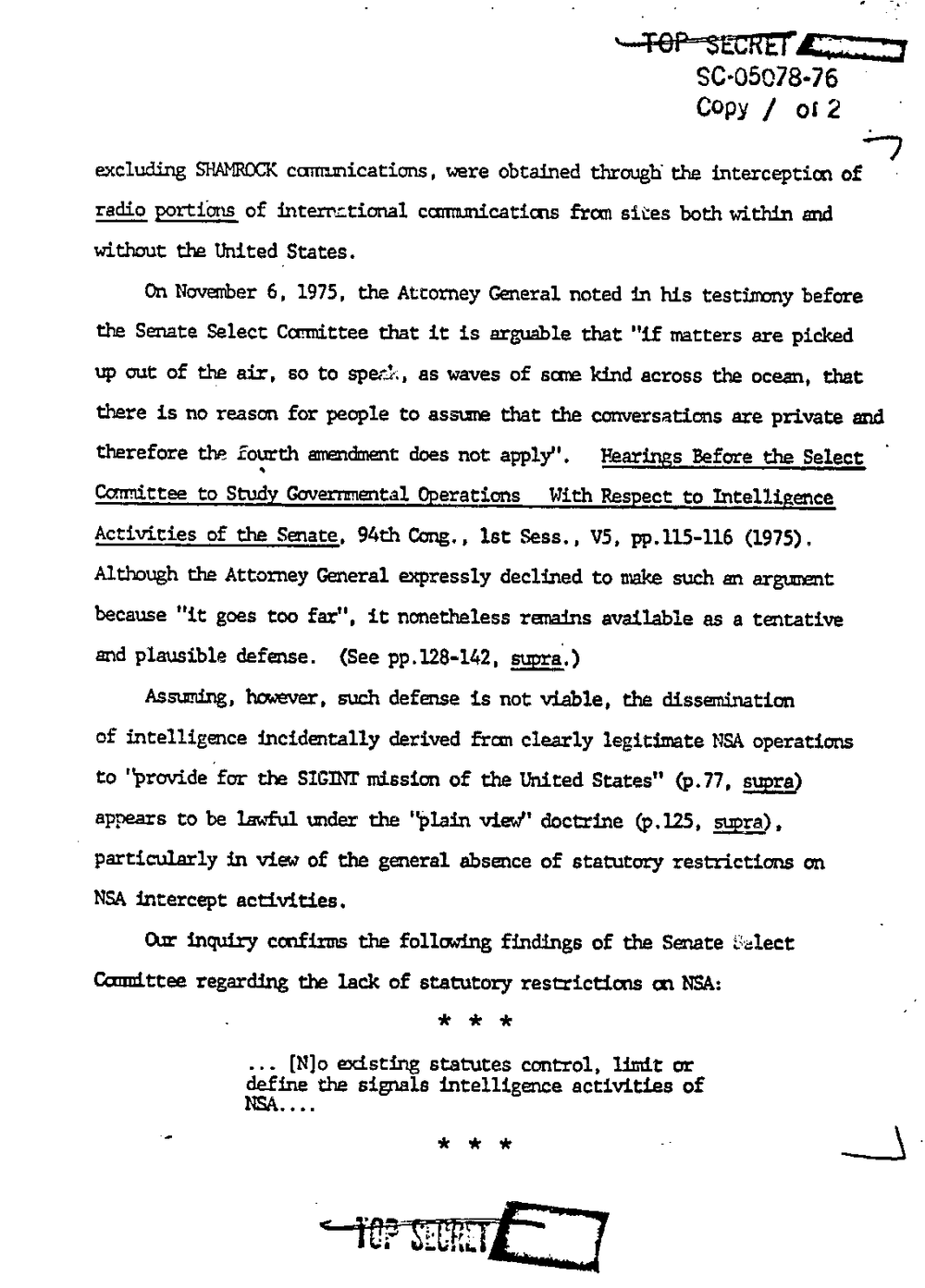
WEE:
30-05078-76
COpy or 2
4.7
excluding SHAMROCK cmnunications, were obtained through the interception of -
?113 Erti'ons of international cmmn?catims from sites both within and
without the United'States.
On November 6. 1975. the Attorney General noted in his testinony before
the Senate Select Committee that it is arguable that "if matters are picked
up out of air, so to speak. as waves of some kind across the ocean, that
there is no reason for people to assure that the conversations are private and
therefore the fourth amendment does not apply". Hearings Before the Select
Comittee to Govemnental Operations With Respect to Intelligence
Activities of the Senate. 94th Cong. . Sass. . V5, pp.llS-116 (1975).
Although the Attorney General expressly declined to make such an arth
because "it goes too far", it nonetheless remains available as a tentative
and plausible defense. (See
Assuming, however. such defense is not viable. the dissemination
of intelligence incidentally derived from clearly legitimate NSA operations
to "provide [for the 818M mission of the United States" (p.77, we)
appears to be lawful under the "plain vieuf' doctrine (p.125, ?are .
particularly in view of the general absence of statutory restrictions on
NSA intercept activities.
(hr inquiry confirms the following findings of the Senate Select
Camittee regarding the lack of statutory restrictions :11 NBA:
. . . [Nlo existing statutes control, limit or
define the signals intelligence activities of
WEE:
30-05078-76
COpy or 2
4.7
excluding SHAMROCK cmnunications, were obtained through the interception of -
?113 Erti'ons of international cmmn?catims from sites both within and
without the United'States.
On November 6. 1975. the Attorney General noted in his testinony before
the Senate Select Committee that it is arguable that "if matters are picked
up out of air, so to speak. as waves of some kind across the ocean, that
there is no reason for people to assure that the conversations are private and
therefore the fourth amendment does not apply". Hearings Before the Select
Comittee to Govemnental Operations With Respect to Intelligence
Activities of the Senate. 94th Cong. . Sass. . V5, pp.llS-116 (1975).
Although the Attorney General expressly declined to make such an arth
because "it goes too far", it nonetheless remains available as a tentative
and plausible defense. (See
Assuming, however. such defense is not viable. the dissemination
of intelligence incidentally derived from clearly legitimate NSA operations
to "provide [for the 818M mission of the United States" (p.77, we)
appears to be lawful under the "plain vieuf' doctrine (p.125, ?are .
particularly in view of the general absence of statutory restrictions on
NSA intercept activities.
(hr inquiry confirms the following findings of the Senate Select
Camittee regarding the lack of statutory restrictions :11 NBA:
. . . [Nlo existing statutes control, limit or
define the signals intelligence activities of
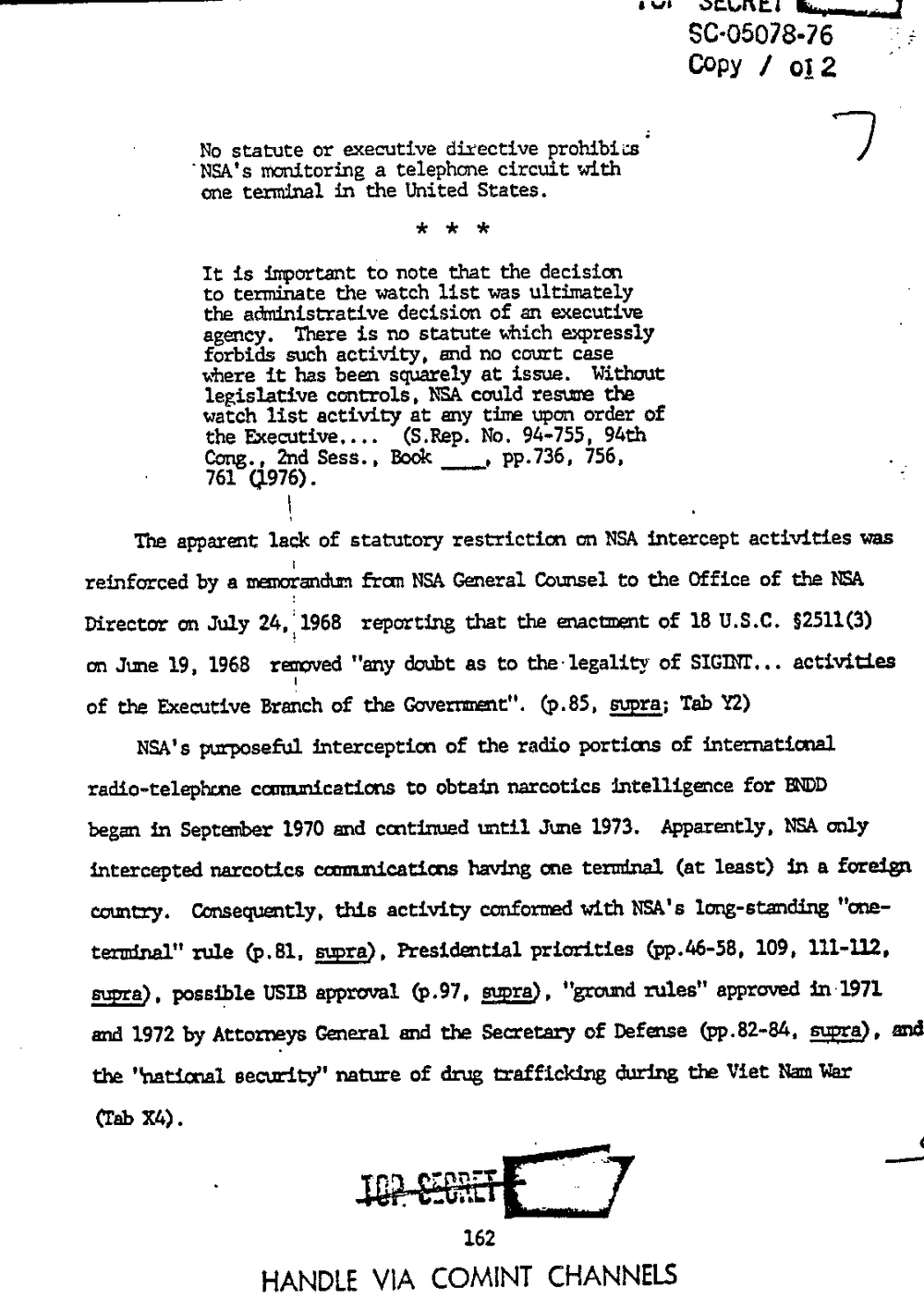
counts
50-05078-76
COPY 012
No statute or executive directive prohibits 3
monitoring a telephone circuit with
one terminal in the United States.
It is important to note that the decision
to terminate the watch list was ultimately
the administrative decision of an executive
agency. There is no statute which expressly
forbids such activity, and no court case
where it has been squarely at issue. Without
legislative controls NBA could resume the
watch list activity at any time upon order of
the Executive. . .. (S.Rep. No. 9h?755, 94th
Cong.. 2nd Book . PP.736. 756,
761 0.976) .
.
The apparent lack of statutory restriction on NBA intercept activities was
reinforced by a from NSA General Counsel to the Office of the NSA
Director on July 24,i1968 reporting that the enactment of 18 use. mum
on June 19, 196-8 resumed "any doubt as to the-legality of . . activities
of the Executive Branch of the Govermmt". (p.85. m5; Tab Y2)
NSA's pmposeful interception of the radio portions of international
radio-telephone to obtain narcotics intelligence for man
began in Septarber 1970 and continued until June 1973. Apparently, NSA only
intercepted narcotics ooummicatims having one terminal (at least) in a foreign
comtry. Consequently. this activity conformed with NSA's long-standing "one-
terminal" rule (p.81. Era), Presidential priorities 109. 111-112,
525:3) . possible USIB approval (p.97, "ground rules" approved 111-1971
and 1972 by Attorneys General and the Secretary of Defense (pp.82-84, we). md
the "national security" nature of during the Viet Nam War
(Tab Xlo) .
162
HANDLE VIA COMINT CHANNELS
counts
50-05078-76
COPY 012
No statute or executive directive prohibits 3
monitoring a telephone circuit with
one terminal in the United States.
It is important to note that the decision
to terminate the watch list was ultimately
the administrative decision of an executive
agency. There is no statute which expressly
forbids such activity, and no court case
where it has been squarely at issue. Without
legislative controls NBA could resume the
watch list activity at any time upon order of
the Executive. . .. (S.Rep. No. 9h?755, 94th
Cong.. 2nd Book . PP.736. 756,
761 0.976) .
.
The apparent lack of statutory restriction on NBA intercept activities was
reinforced by a from NSA General Counsel to the Office of the NSA
Director on July 24,i1968 reporting that the enactment of 18 use. mum
on June 19, 196-8 resumed "any doubt as to the-legality of . . activities
of the Executive Branch of the Govermmt". (p.85. m5; Tab Y2)
NSA's pmposeful interception of the radio portions of international
radio-telephone to obtain narcotics intelligence for man
began in Septarber 1970 and continued until June 1973. Apparently, NSA only
intercepted narcotics ooummicatims having one terminal (at least) in a foreign
comtry. Consequently. this activity conformed with NSA's long-standing "one-
terminal" rule (p.81. Era), Presidential priorities 109. 111-112,
525:3) . possible USIB approval (p.97, "ground rules" approved 111-1971
and 1972 by Attorneys General and the Secretary of Defense (pp.82-84, we). md
the "national security" nature of during the Viet Nam War
(Tab Xlo) .
162
HANDLE VIA COMINT CHANNELS
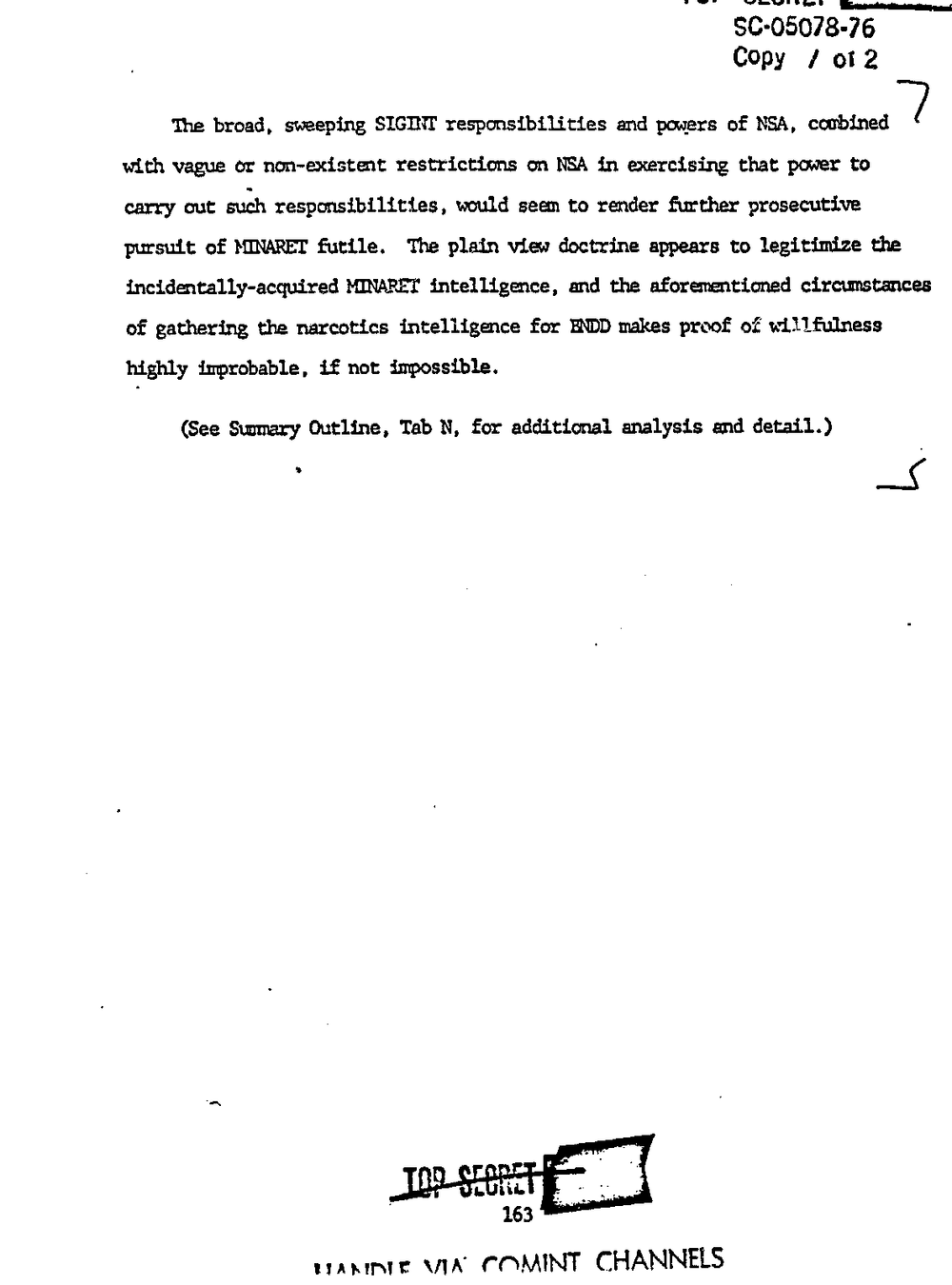
I 1-- Uhleb.
80-05078-76
COPY I or 2
The broad, sweeping SIGINT responsibilities and powers of NSA, cocrbined 7
with vague or non?existent restrictions on NSA in exercising that power to
carry out such responsibilities, would seem to render ?n-ther prosecutive
pursuit of futile. The plain view doctrine appears to legitimize the
incidmtally-acquired WEE intelligence, and the aforementioned
of gathering the narcotics intelligence for MD makes proof of willfulness
highly inpro?bable. if not impossible.
(See Sumnery Outline, Tab N, for additional analysis and detail.)
I
HAHN: \nA' CHANNELS
I 1-- Uhleb.
80-05078-76
COPY I or 2
The broad, sweeping SIGINT responsibilities and powers of NSA, cocrbined 7
with vague or non?existent restrictions on NSA in exercising that power to
carry out such responsibilities, would seem to render ?n-ther prosecutive
pursuit of futile. The plain view doctrine appears to legitimize the
incidmtally-acquired WEE intelligence, and the aforementioned
of gathering the narcotics intelligence for MD makes proof of willfulness
highly inpro?bable. if not impossible.
(See Sumnery Outline, Tab N, for additional analysis and detail.)
I
HAHN: \nA' CHANNELS
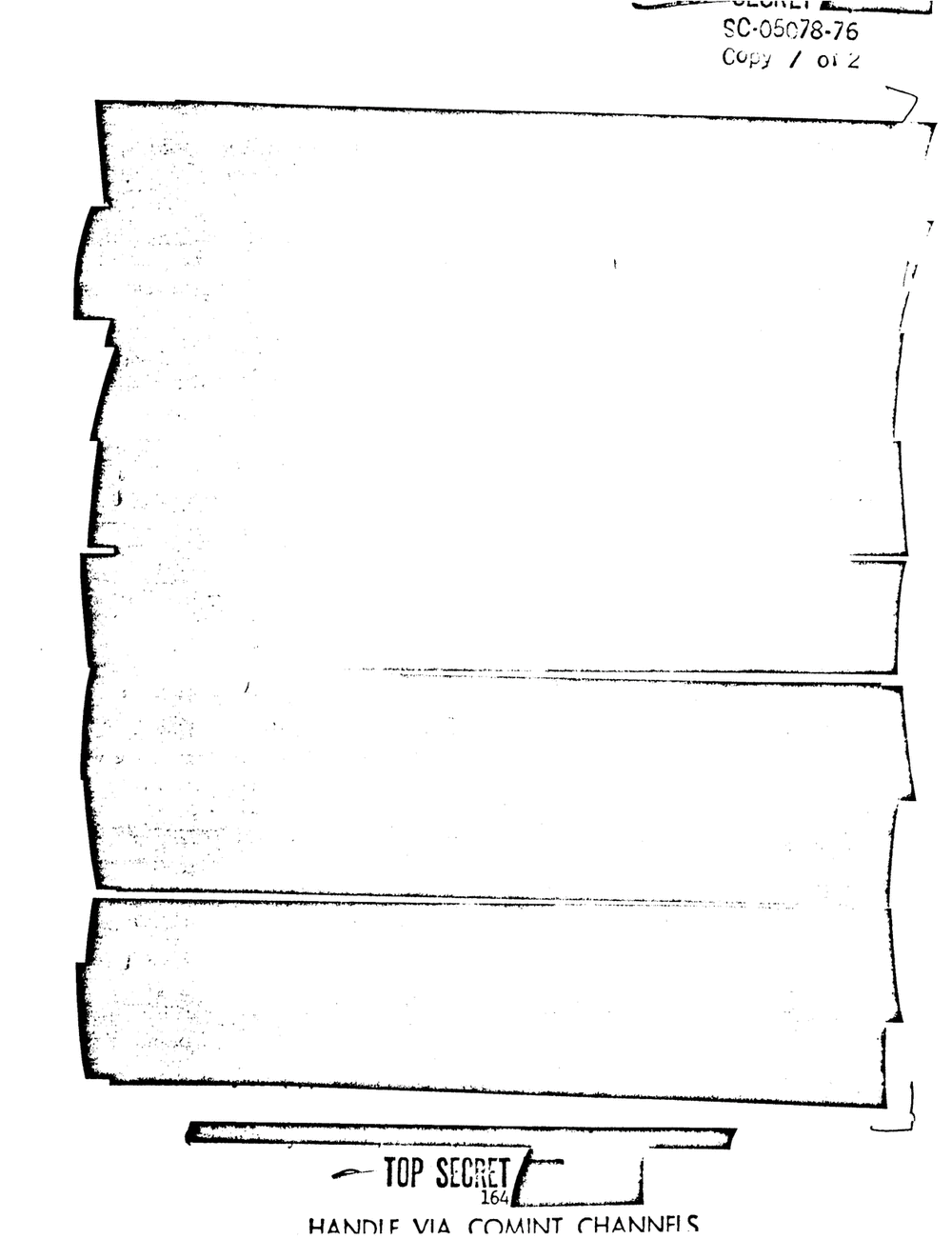
I
80-05078-76
Copy ?Lin? smagf
HANDIF VIA FOMINT
I
80-05078-76
Copy ?Lin? smagf
HANDIF VIA FOMINT
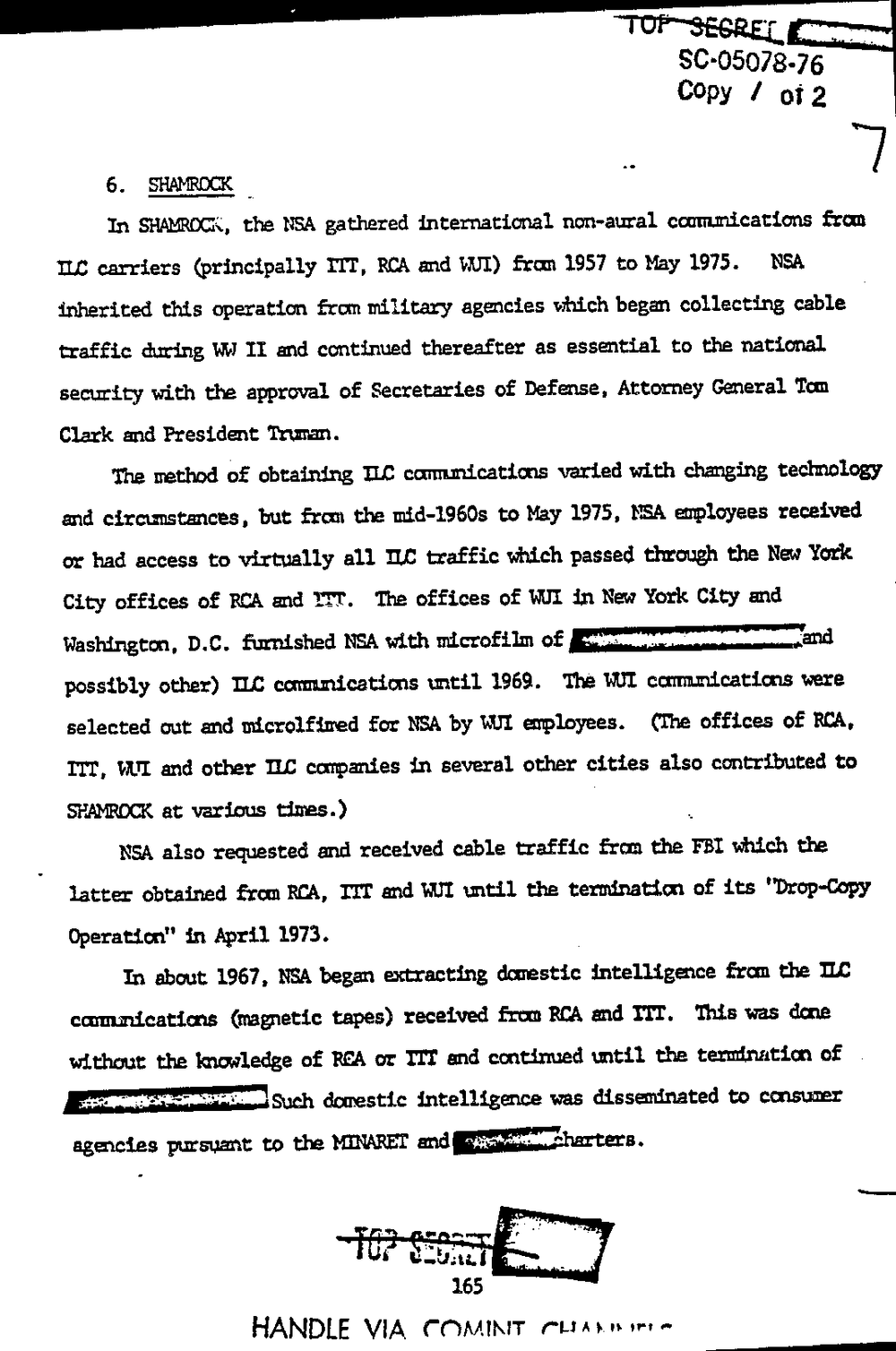
80-05078-7
Copy I at 2
6. summon: 7
In SHAMROCE. the NSA gathered international non-aural coonunications {run
113 carriers (principally RCA and HUI) from 1957 to May 1975. NBA
inherited this operation from udlitary agencies which began collecting cable -
traffic during WW II and continued thereafter as essential to the national
security with the approval of Secretaries of Defense. Attorney General Tom
Clark and President m.
The method of obtaining varied with changing tectmology
and circunstances but the mid-19605 to May 1975, NBA employees received
or had access to virtually all IDS traffic which passed tl'mwgh the New York
City offices of RCA and The offices of WUI in New York City and
vasrungtm, n.c. furnished NSA with microfilm of
possibly other) or: corrmmications until 1969. The WUI were
selected out and microlfimed for NBA by WI employees. (The offices of RCA.
WI and other I18 companies in several other cities also contributed to
511m at various times.) I
NBA also requested and received cable traffic fran the FBI which the
latter obtained from RCA, and W1 until the termination of its "Drop-Copy
Operation" in April 1973.
In about 1967. NSA began extracting domestic intelligence iron the m:
cmaications (mgrnetic tapes) received from RCA and m. This was dcne
without the knowledge of REA or and continued until the termimtim of .
.- a
Such domestic intelligence was disseminated to cormuoer
egmcies to the menu
HANDLE VIA rnMw-r m,
80-05078-7
Copy I at 2
6. summon: 7
In SHAMROCE. the NSA gathered international non-aural coonunications {run
113 carriers (principally RCA and HUI) from 1957 to May 1975. NBA
inherited this operation from udlitary agencies which began collecting cable -
traffic during WW II and continued thereafter as essential to the national
security with the approval of Secretaries of Defense. Attorney General Tom
Clark and President m.
The method of obtaining varied with changing tectmology
and circunstances but the mid-19605 to May 1975, NBA employees received
or had access to virtually all IDS traffic which passed tl'mwgh the New York
City offices of RCA and The offices of WUI in New York City and
vasrungtm, n.c. furnished NSA with microfilm of
possibly other) or: corrmmications until 1969. The WUI were
selected out and microlfimed for NBA by WI employees. (The offices of RCA.
WI and other I18 companies in several other cities also contributed to
511m at various times.) I
NBA also requested and received cable traffic fran the FBI which the
latter obtained from RCA, and W1 until the termination of its "Drop-Copy
Operation" in April 1973.
In about 1967. NSA began extracting domestic intelligence iron the m:
cmaications (mgrnetic tapes) received from RCA and m. This was dcne
without the knowledge of REA or and continued until the termimtim of .
.- a
Such domestic intelligence was disseminated to cormuoer
egmcies to the menu
HANDLE VIA rnMw-r m,
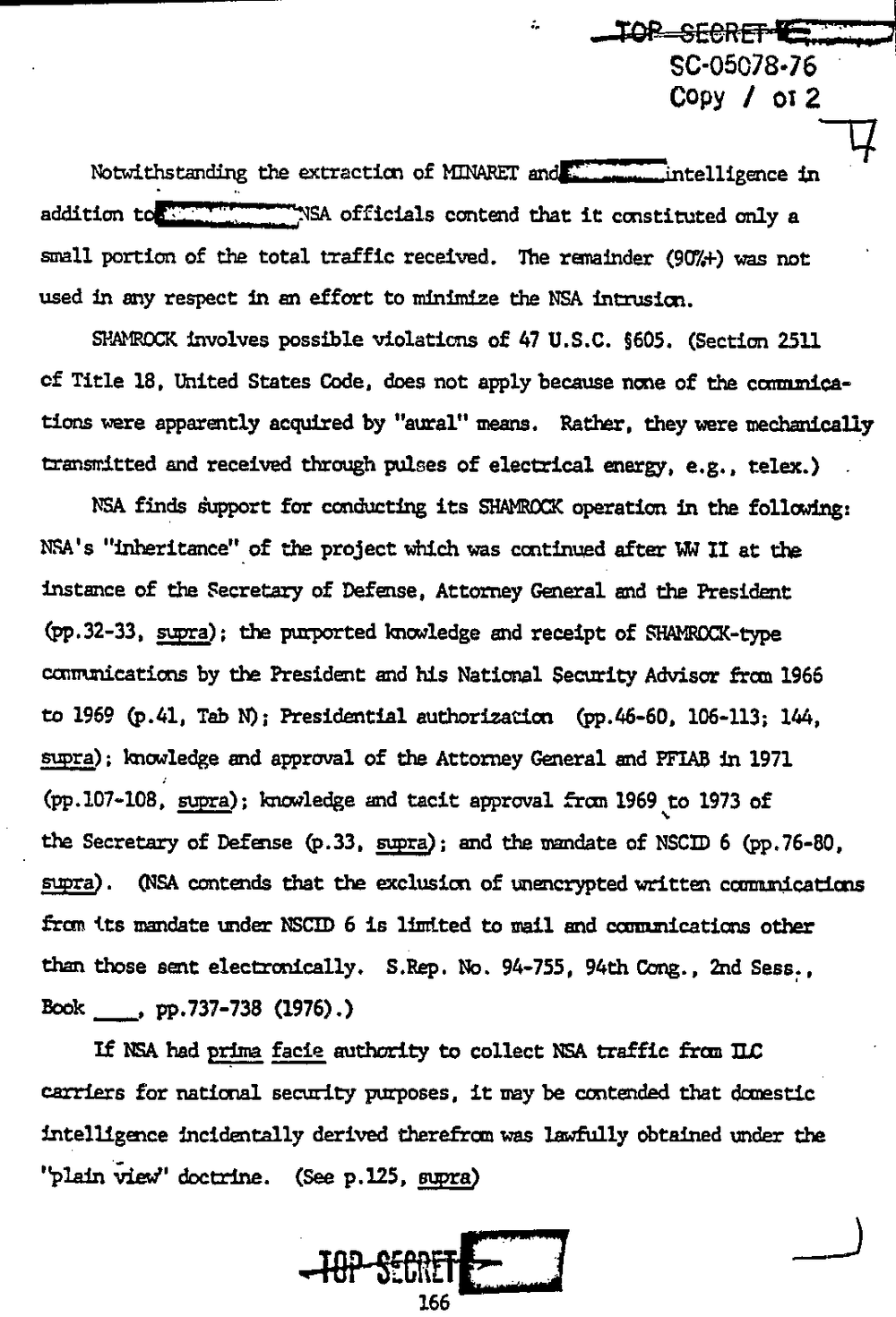
. --
30-05078-76
COpy o: 2
the extraction of manor mmtelligence in
addition officials contend that it constituted only a
small portion of the total traffic received. The reminder (902+) was not
used in any respect in an effort to minimize the NSA intrusim.
SHAMROCK involves possible violations of 47 U.S.C. 5605. (Section 2511
of Title 18, United States Code, does not apply because none of the
tions were acquired by "astral" means. Rather. they were mechmioally
transmitted and received through pulses of electrical artery, e.g. telex.)
NSA finds dupport for conducting its SHAMROCK operation in the following:
NSA's "ir?xeritance'lof the project which was continued after WW II at the
instance of the Secretary of Defense. Attorney General and the Presidmt
(pp.32-33. Lard); the pmrported lmowledge and receipt of
cmnmicatims by the President and his National Security Advisor from 1965
to 1959 (p.41, Tab Presidential authorization (pp.45-60, 106-113; 144.
knowledge and approval of the Attorney General and PFIAB in 1971
(119107-108: ma); knov?edge and tacit approval 1969 Nto 1973 of
the Secretary of Defatse (p.33. and the mandate of NSCID 6 (pp.76-80,
I we) . (NSA contends that the exclusion of written cmicaticns
from its umdate under NSCID 6 is limited to mail and other
than those sent electronically. map. No. 94-755. 94th 2nd Sosa.
Book pp.737-738 (1976).)
If NSA had ?3313 authority to collect NSA traffic m:
carriers for natimal secrn-ity purposes. it may be cmtended that domestic-
intelligence incidentally derived therefrom was lawfully obtained under the
"plain doctrine. (See p.125, me)
166
. --
30-05078-76
COpy o: 2
the extraction of manor mmtelligence in
addition officials contend that it constituted only a
small portion of the total traffic received. The reminder (902+) was not
used in any respect in an effort to minimize the NSA intrusim.
SHAMROCK involves possible violations of 47 U.S.C. 5605. (Section 2511
of Title 18, United States Code, does not apply because none of the
tions were acquired by "astral" means. Rather. they were mechmioally
transmitted and received through pulses of electrical artery, e.g. telex.)
NSA finds dupport for conducting its SHAMROCK operation in the following:
NSA's "ir?xeritance'lof the project which was continued after WW II at the
instance of the Secretary of Defense. Attorney General and the Presidmt
(pp.32-33. Lard); the pmrported lmowledge and receipt of
cmnmicatims by the President and his National Security Advisor from 1965
to 1959 (p.41, Tab Presidential authorization (pp.45-60, 106-113; 144.
knowledge and approval of the Attorney General and PFIAB in 1971
(119107-108: ma); knov?edge and tacit approval 1969 Nto 1973 of
the Secretary of Defatse (p.33. and the mandate of NSCID 6 (pp.76-80,
I we) . (NSA contends that the exclusion of written cmicaticns
from its umdate under NSCID 6 is limited to mail and other
than those sent electronically. map. No. 94-755. 94th 2nd Sosa.
Book pp.737-738 (1976).)
If NSA had ?3313 authority to collect NSA traffic m:
carriers for natimal secrn-ity purposes. it may be cmtended that domestic-
intelligence incidentally derived therefrom was lawfully obtained under the
"plain doctrine. (See p.125, me)
166
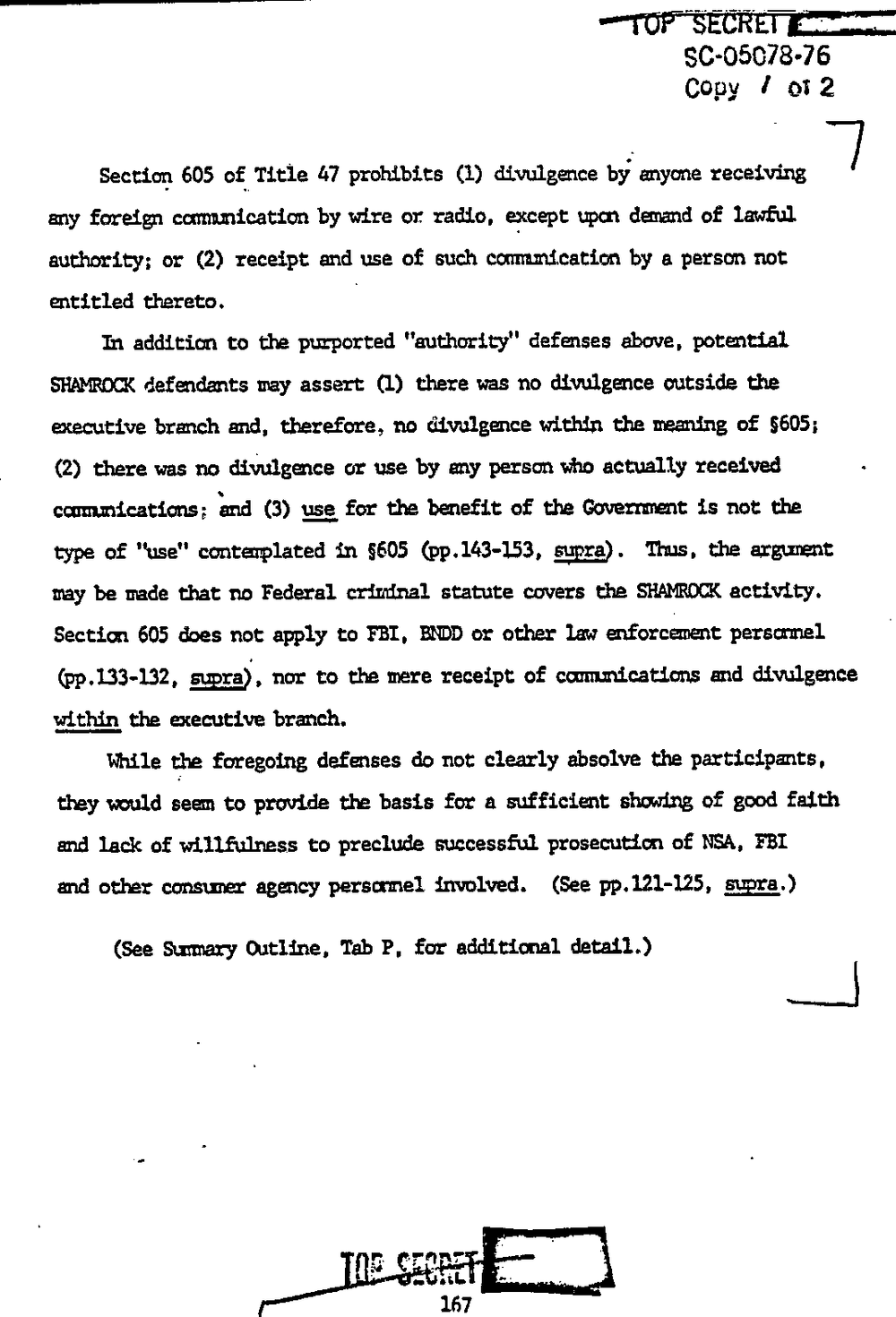
80-05078-76
0093' I or 2
Section 605 of Title 47 prohibits (1) divulgence by: anyone receiving 7
any foreig: cmnmication by wire or radio. except upa't demand of lawful
authority; or (2) receipt and use of such cmmnication by a person not
entitled thereto. -
In addition to the purported "authority" defenses above. potential
SHAMROCK defendants may assert (1) there was no diwlgence outside the
acecutive branch and. therefore, no diwlgence within the reaming of 5605;
(2) there was no idivulgmce or use by any person who actually received
?and (3) ?5 for the benefit of the Goverment is not the
type of "use" contemplated in 5505 (pp.143-153. we). 'Ihus. the arth
may be made that no Federal criminal statute covers the SHAMROCK activity.
Secticm 605 does not apply to FBI. BNDD or other law enforcement persomel
(pp.133-132, m9 nor to the mere receipt of counmications and divulgmce
the executive branch.
While foregoing defenses do not clearly absolve the participate,
they would seem to provide the basis for a sufficient shoamg of good faith
and lack of willfulness to preclude successful prosecution of NSA, FBI
and other consuner agmcy involved. (See pp.lZl-125. me.)
A
(See Smmary Outline, Tab P. for additional detail.)
80-05078-76
0093' I or 2
Section 605 of Title 47 prohibits (1) divulgence by: anyone receiving 7
any foreig: cmnmication by wire or radio. except upa't demand of lawful
authority; or (2) receipt and use of such cmmnication by a person not
entitled thereto. -
In addition to the purported "authority" defenses above. potential
SHAMROCK defendants may assert (1) there was no diwlgence outside the
acecutive branch and. therefore, no diwlgence within the reaming of 5605;
(2) there was no idivulgmce or use by any person who actually received
?and (3) ?5 for the benefit of the Goverment is not the
type of "use" contemplated in 5505 (pp.143-153. we). 'Ihus. the arth
may be made that no Federal criminal statute covers the SHAMROCK activity.
Secticm 605 does not apply to FBI. BNDD or other law enforcement persomel
(pp.133-132, m9 nor to the mere receipt of counmications and divulgmce
the executive branch.
While foregoing defenses do not clearly absolve the participate,
they would seem to provide the basis for a sufficient shoamg of good faith
and lack of willfulness to preclude successful prosecution of NSA, FBI
and other consuner agmcy involved. (See pp.lZl-125. me.)
A
(See Smmary Outline, Tab P. for additional detail.)
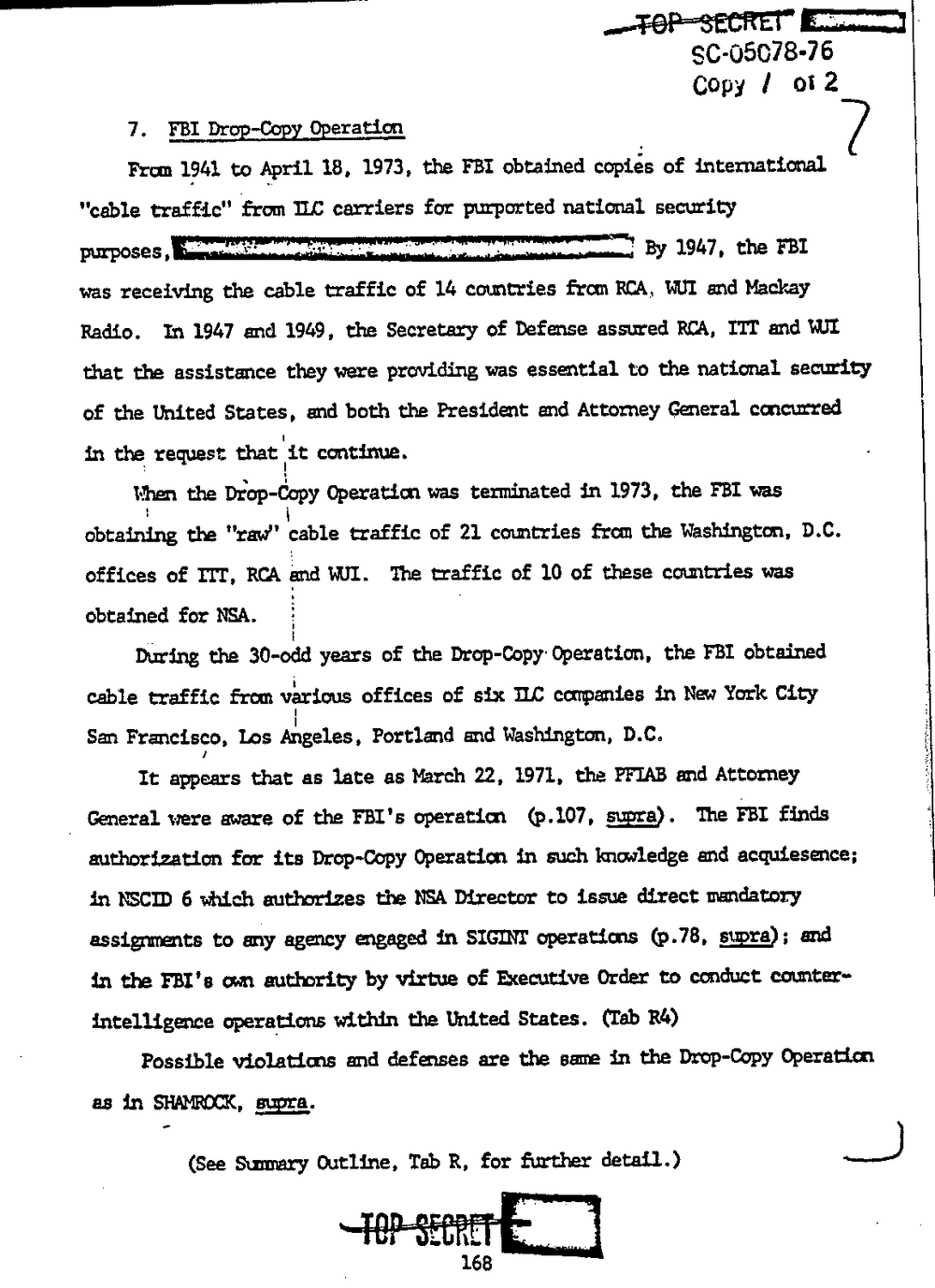
80-05078-76
COpy I 0t 2
7 . FBI Drop-Copy Operation
Fran 1941 to apt-11 18. 1973. the FBI obtained capies of international
"cable traffic" from carriers for purported national security
By 1947. the
was receiving the cable traffic of 14 countries from RCA, WI and Mackay
pun-poses .
Radio. In 1947 and 1949, the Secretary of Defense assured RCA, HT and W1
that the assistance they were providing was essential to the national semity
of the United States. and both the President and Attorney General concurred
in request thatllit continue.
than the Drop-Copy Operation was teminated in 1973, the FBI was
obtaining the "raw!" lcable traffic of 21 countries from the Washington, D.C.
offices of m. RCA WUI. The traffic of 10 of these countries was
obtained for use.
During the 30-03:: years of the Drop-Copy-Operation. the obtained
cable traffic from various offices of six 115 companies in New York City
San Francisco. Los Angeles. Portland and Wasl?ngton. D.C.
It appears that as late as March 22. 1971. the PFIAB and Attorney
General were aware of the FBI's operation (p.107, we) . 'Ihe FBI finds
authorization for its Drop-Copy Operaticn in such knowledge and acquiesence;
in NSCID 6 which authorizes the NBA Director to issue direct mandatory
assigrrnents to any agency engaged in operatims (p.78. and
in the FBI's own authority by virtue of Exewtive Order to counter-
intelligence operations within the United States. (Tab R4)
Possible violade and defenses are the same in the Drop-Copy Operatim
as in SHAMROCK, 5E3.
(See Sun-nary Outline. Tab R, for fm?ther detail.)
80-05078-76
COpy I 0t 2
7 . FBI Drop-Copy Operation
Fran 1941 to apt-11 18. 1973. the FBI obtained capies of international
"cable traffic" from carriers for purported national security
By 1947. the
was receiving the cable traffic of 14 countries from RCA, WI and Mackay
pun-poses .
Radio. In 1947 and 1949, the Secretary of Defense assured RCA, HT and W1
that the assistance they were providing was essential to the national semity
of the United States. and both the President and Attorney General concurred
in request thatllit continue.
than the Drop-Copy Operation was teminated in 1973, the FBI was
obtaining the "raw!" lcable traffic of 21 countries from the Washington, D.C.
offices of m. RCA WUI. The traffic of 10 of these countries was
obtained for use.
During the 30-03:: years of the Drop-Copy-Operation. the obtained
cable traffic from various offices of six 115 companies in New York City
San Francisco. Los Angeles. Portland and Wasl?ngton. D.C.
It appears that as late as March 22. 1971. the PFIAB and Attorney
General were aware of the FBI's operation (p.107, we) . 'Ihe FBI finds
authorization for its Drop-Copy Operaticn in such knowledge and acquiesence;
in NSCID 6 which authorizes the NBA Director to issue direct mandatory
assigrrnents to any agency engaged in operatims (p.78. and
in the FBI's own authority by virtue of Exewtive Order to counter-
intelligence operations within the United States. (Tab R4)
Possible violade and defenses are the same in the Drop-Copy Operatim
as in SHAMROCK, 5E3.
(See Sun-nary Outline. Tab R, for fm?ther detail.)
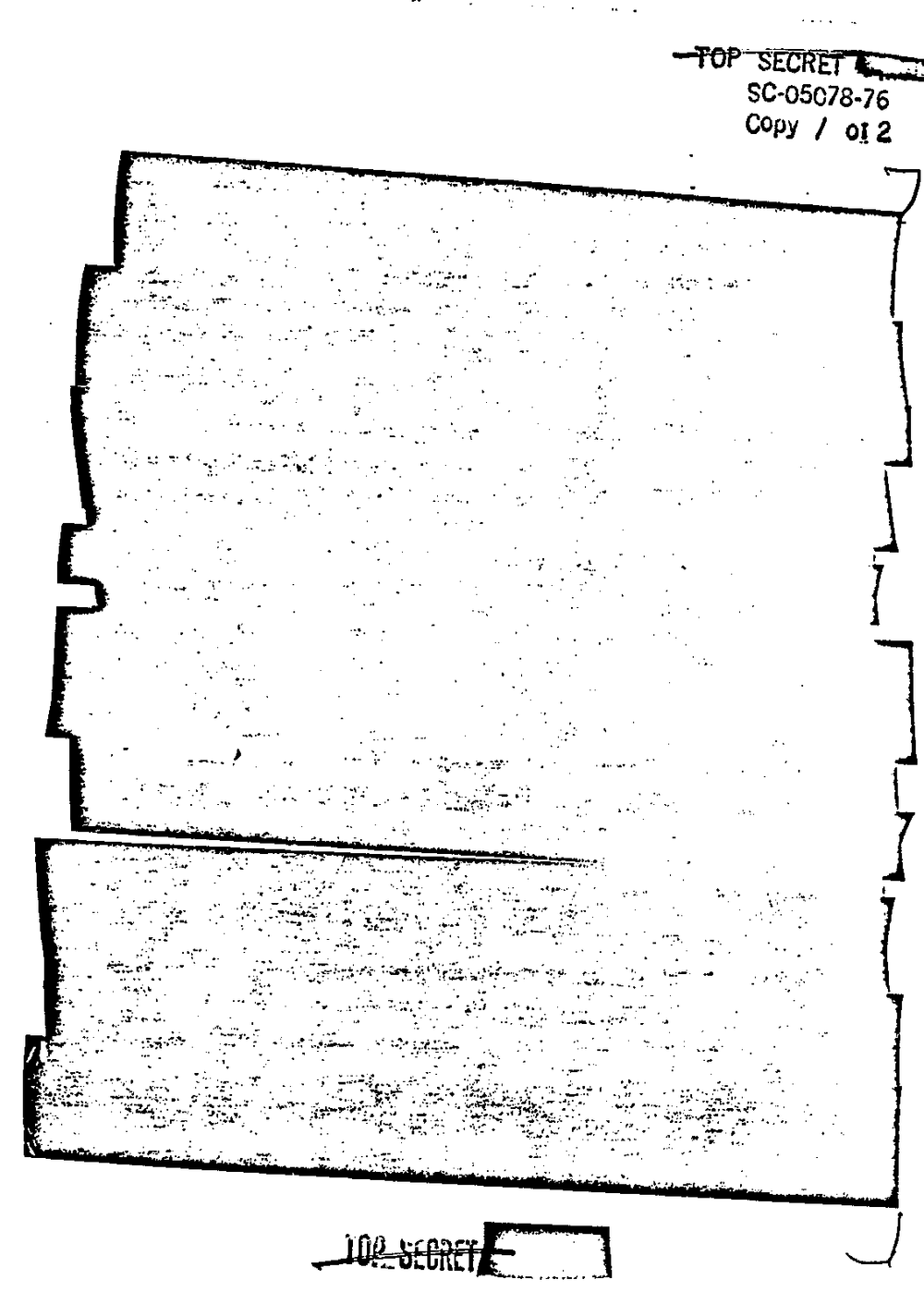
- .
.
- .
.
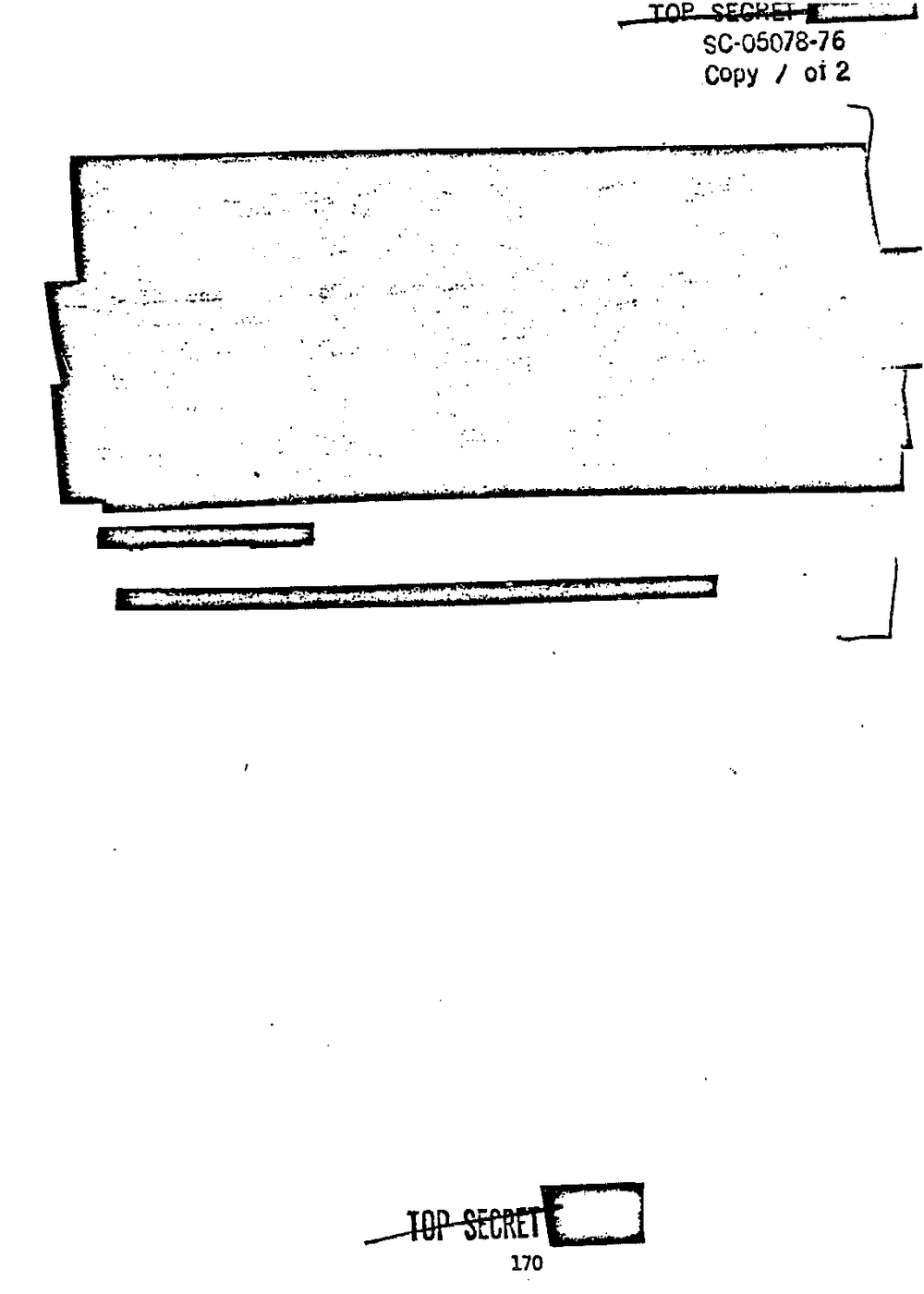
50-05078-76
Copy
50-05078-76
Copy
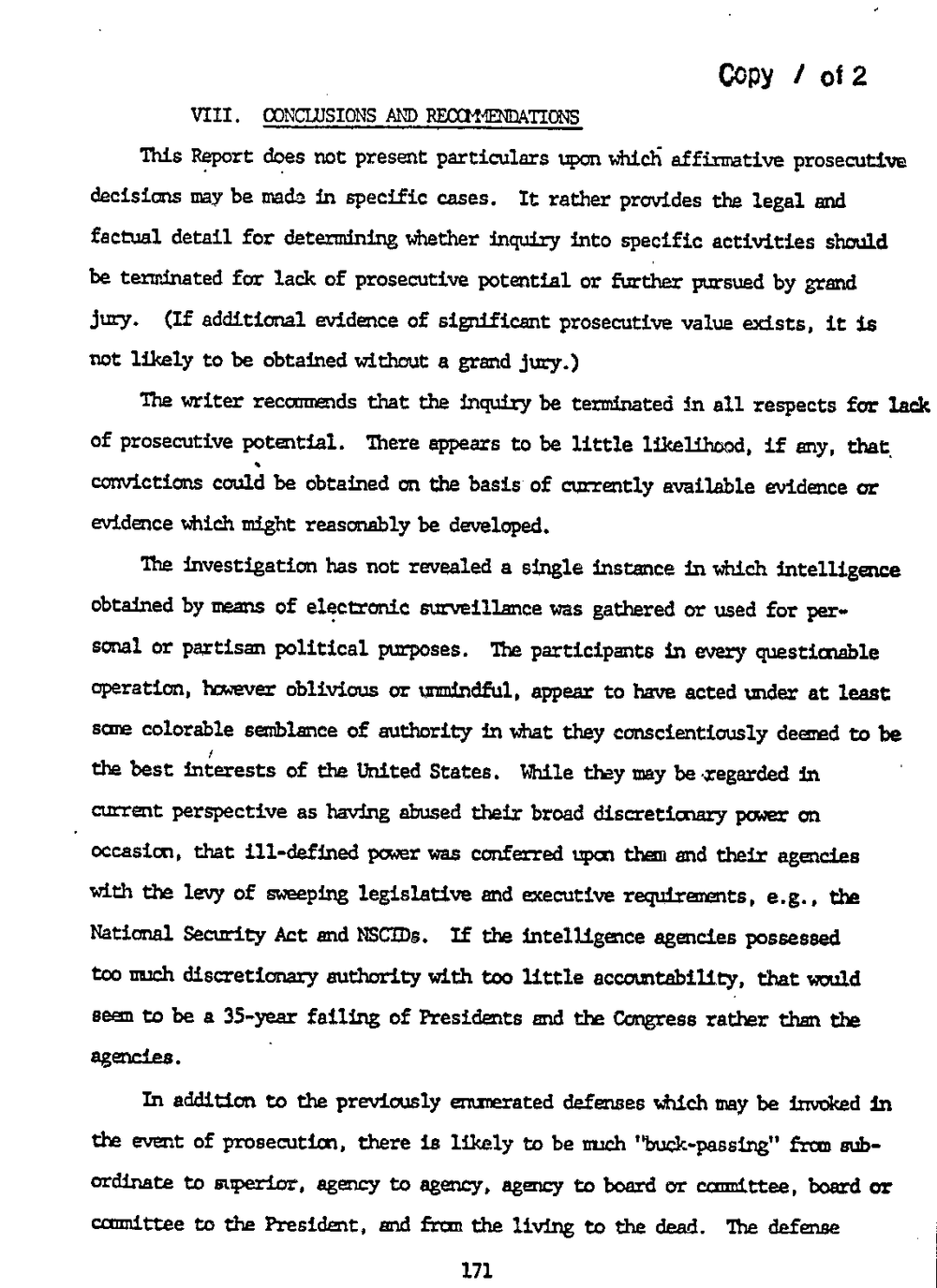
Copy I 012
CONCLUSIONS AND
This Report does not present particulars upon which affirmative prosecutive
decisions may be made in specific cases. It rather provides the legal and
factual detail for determining whether inquiry into specific activities
be terminated for lack of prosecutive potential or pursued by grand
jury. (If additional evidence of significant prosecutive value exists. it is
not likely to be obtained without a grand jury.)
The writer recoanmds that the inquiry be terminated in all respects for lack
of prosecutive potential. There appears to be little l?celihood, if any. that
convictions could be obtained on the basis of mently available evidence or
evidence which might reasonably be developed.
The investigation has not revealed a single instance in which intelligence
obtained by means of electronic surveillance was gathered or used for per-
sonal or partisan political purposes. The participants in every questionable
operation, however oblivious or umindful, appear to have acted under at least
acme colorable semblance of authority in what they conscientiously deemed to be
the best interests of the United States. While they may be regarded in
current perspective as having abused their bread discretionary power on
. occasim. that ill-defined power was conferred upcn them and their agencies
with the levy of sweeping legislative and executive requirewmts, e.g. . the
National Security Act and NSCIDs. If the intelligence agencies possessed
too uuch discretionary authority with too little that would
seen to be a 35-year failing of Presidents and tie Congress rather than the
agencies. -
In addition to the previously enumerated defenses which may be invoked in
the event of prosecutim, there is likely to be such "buck-passing" from sub-
ordinatetomperior. agencytoagency, agencytoboardorcoumittee, boarder
mitteetothePreside-nt. mdfranthelivingtothedead. 'lhedefense
171
Copy I 012
CONCLUSIONS AND
This Report does not present particulars upon which affirmative prosecutive
decisions may be made in specific cases. It rather provides the legal and
factual detail for determining whether inquiry into specific activities
be terminated for lack of prosecutive potential or pursued by grand
jury. (If additional evidence of significant prosecutive value exists. it is
not likely to be obtained without a grand jury.)
The writer recoanmds that the inquiry be terminated in all respects for lack
of prosecutive potential. There appears to be little l?celihood, if any. that
convictions could be obtained on the basis of mently available evidence or
evidence which might reasonably be developed.
The investigation has not revealed a single instance in which intelligence
obtained by means of electronic surveillance was gathered or used for per-
sonal or partisan political purposes. The participants in every questionable
operation, however oblivious or umindful, appear to have acted under at least
acme colorable semblance of authority in what they conscientiously deemed to be
the best interests of the United States. While they may be regarded in
current perspective as having abused their bread discretionary power on
. occasim. that ill-defined power was conferred upcn them and their agencies
with the levy of sweeping legislative and executive requirewmts, e.g. . the
National Security Act and NSCIDs. If the intelligence agencies possessed
too uuch discretionary authority with too little that would
seen to be a 35-year failing of Presidents and tie Congress rather than the
agencies. -
In addition to the previously enumerated defenses which may be invoked in
the event of prosecutim, there is likely to be such "buck-passing" from sub-
ordinatetomperior. agencytoagency, agencytoboardorcoumittee, boarder
mitteetothePreside-nt. mdfranthelivingtothedead. 'lhedefense
171
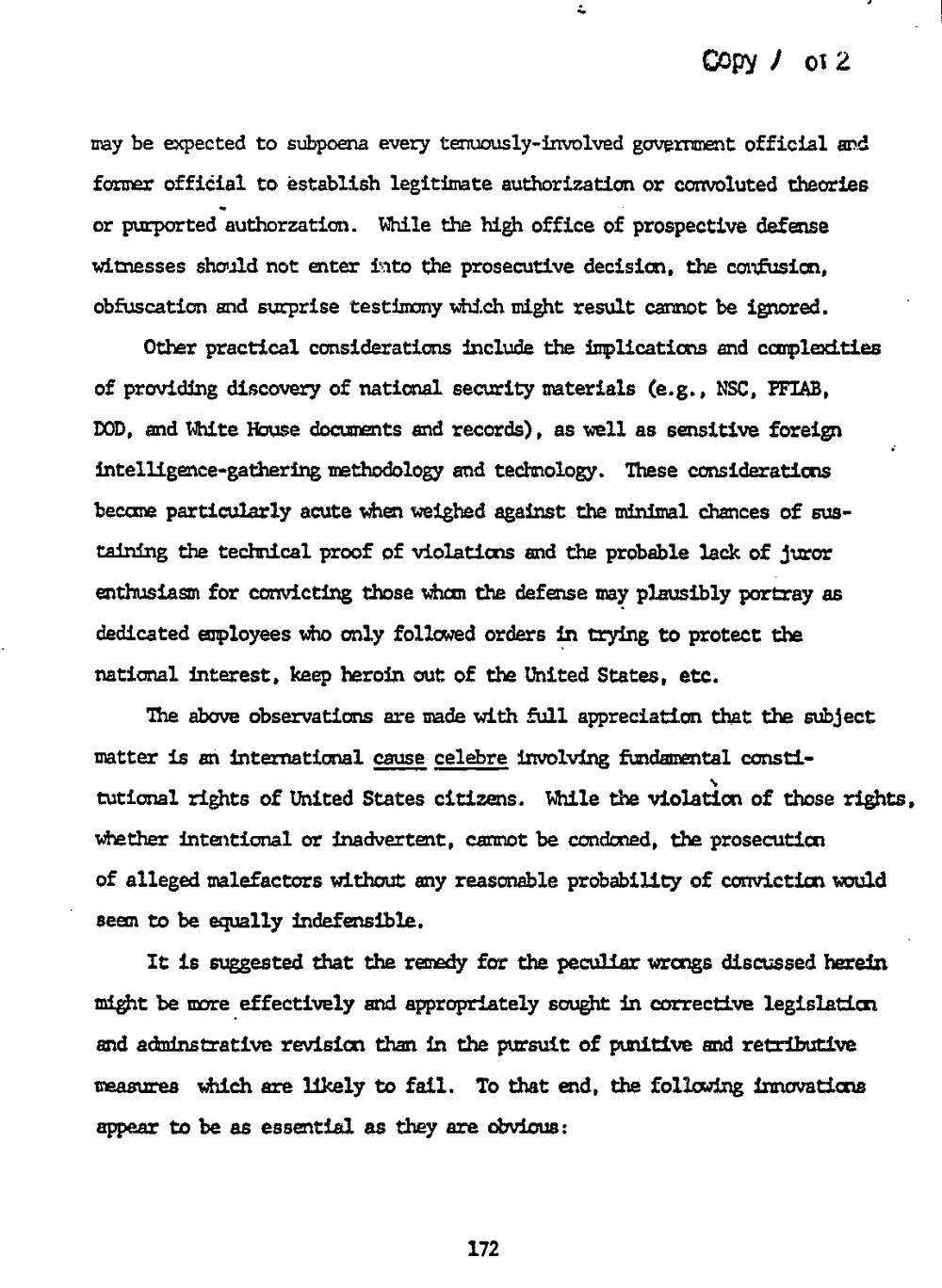
Copy} 012'
may be expected to subpoena every tezmously-involved government official and
former official to establish legitimate authorization or convoluted theories
or pun-ported author-cation. While the high office of prospective defense
witnesses should not enter into the prosecutive decisim. the confusion.
obfuscation and surprise testimony which might result cannot be ignored.
Other practical considerations include the inplications and cmpladties
of providing discovery of national security materials NSC, PFIAB.
DOD, arm! White House documents and records) as well as sensitive foreigx
intelligence-gaer methodology and tecl?nology. These considerations
bectne particularly acute wtxen weighed against the minimal chances of sus-
taining the technical proof of violaticns and the probable lack of juror
entl'msiasm for convicting those whom the defense my plausibly portray as
dedicated employees who only followed orders trying to protect the
national interest, keep heroin out of the United States. etc.
The above observations are sade with .?ill appreciation that the subject
matter is an international gglebre involving fmdauental consti-
tutional rights of United States citizens. While the violation of those rights,
whether intentional or inadvertent, cannot be condoned, the prosecution
of alleged male-factors without any reasonable probability of convictim would
seem to be equally indefmsible.
It is suggested that the remedy for the peculiar wrongs discussed herein
might be more effectively and appropriately sought in corrective legislatim
and adminstrative revision than in the pm'suit of pmitive md retributive
memes which are likely to fail. To that end, the following ixmovatima
appeartobeas essmtialastheyareobvioua:
172
Copy} 012'
may be expected to subpoena every tezmously-involved government official and
former official to establish legitimate authorization or convoluted theories
or pun-ported author-cation. While the high office of prospective defense
witnesses should not enter into the prosecutive decisim. the confusion.
obfuscation and surprise testimony which might result cannot be ignored.
Other practical considerations include the inplications and cmpladties
of providing discovery of national security materials NSC, PFIAB.
DOD, arm! White House documents and records) as well as sensitive foreigx
intelligence-gaer methodology and tecl?nology. These considerations
bectne particularly acute wtxen weighed against the minimal chances of sus-
taining the technical proof of violaticns and the probable lack of juror
entl'msiasm for convicting those whom the defense my plausibly portray as
dedicated employees who only followed orders trying to protect the
national interest, keep heroin out of the United States. etc.
The above observations are sade with .?ill appreciation that the subject
matter is an international gglebre involving fmdauental consti-
tutional rights of United States citizens. While the violation of those rights,
whether intentional or inadvertent, cannot be condoned, the prosecution
of alleged male-factors without any reasonable probability of convictim would
seem to be equally indefmsible.
It is suggested that the remedy for the peculiar wrongs discussed herein
might be more effectively and appropriately sought in corrective legislatim
and adminstrative revision than in the pm'suit of pmitive md retributive
memes which are likely to fail. To that end, the following ixmovatima
appeartobeas essmtialastheyareobvioua:
172
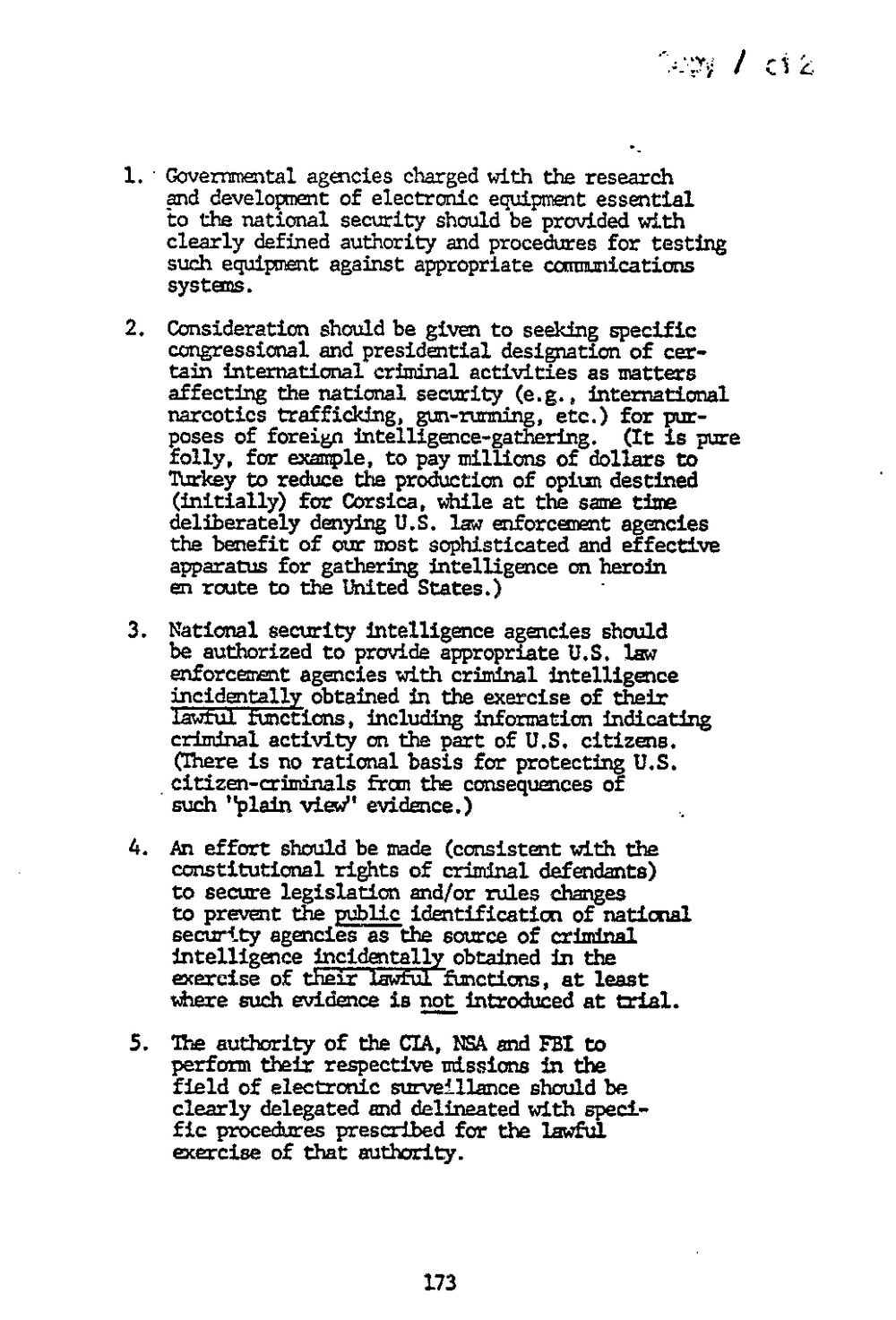
. agencies charged with the research
and development of electronic equipmt essential
to the national security should be provided with
clearly defined authority and procedures for testing
such equipment against appropriate cormmications
systems.
Consideration should be given to seeking specific
congressional and presidential designation of cer-
tain international criminal activities as matters
affecting the national security international
narcotics trafficking, gin-naming, etc.) for pur-
poses of foreign intelligence?gathering. (It is pure
folly, for example, to pay millions of dollars to
Turkey to reduce the production of opiun destined
(initially) for Corsica, while at the same time
deliberately dmying U.S. law enforcement agencies
the benefit of our most sophisticated and effective
apparatus for gathering intelligence on heroin
en route to the United States.)
National security intelligence agencies should
be authorized to provide appropriate U.S. law
enforth agencies with criminal intelligence
incidentall obtained in the exercise of their
WEI functions including infomation indicating
crin?nal activity on the part of U.S. citizens.
(There is no rational basis for protecting U.S.
I citizm-crindnals the consequences of
such "plain vim" evidence.)
An effort should be made (consistent with the
constitutional rights of criminal defendants)
to secure legislation and/or rules changes
to prevem the lic identification of natimal
security agencies as the source of criminal
intelligence incidentall obtained in the
exercise of 1r functions, at least
where such evidence is 1395 introduced at trial.
'IheauthorityoftheCIA,
perform their respective missions in the
field of electronic strveillmce should be
clearly delegated and delineated with speci-
fic procedures prescribed for the lawful
exercise of that authority.
173
. agencies charged with the research
and development of electronic equipmt essential
to the national security should be provided with
clearly defined authority and procedures for testing
such equipment against appropriate cormmications
systems.
Consideration should be given to seeking specific
congressional and presidential designation of cer-
tain international criminal activities as matters
affecting the national security international
narcotics trafficking, gin-naming, etc.) for pur-
poses of foreign intelligence?gathering. (It is pure
folly, for example, to pay millions of dollars to
Turkey to reduce the production of opiun destined
(initially) for Corsica, while at the same time
deliberately dmying U.S. law enforcement agencies
the benefit of our most sophisticated and effective
apparatus for gathering intelligence on heroin
en route to the United States.)
National security intelligence agencies should
be authorized to provide appropriate U.S. law
enforth agencies with criminal intelligence
incidentall obtained in the exercise of their
WEI functions including infomation indicating
crin?nal activity on the part of U.S. citizens.
(There is no rational basis for protecting U.S.
I citizm-crindnals the consequences of
such "plain vim" evidence.)
An effort should be made (consistent with the
constitutional rights of criminal defendants)
to secure legislation and/or rules changes
to prevem the lic identification of natimal
security agencies as the source of criminal
intelligence incidentall obtained in the
exercise of 1r functions, at least
where such evidence is 1395 introduced at trial.
'IheauthorityoftheCIA,
perform their respective missions in the
field of electronic strveillmce should be
clearly delegated and delineated with speci-
fic procedures prescribed for the lawful
exercise of that authority.
173
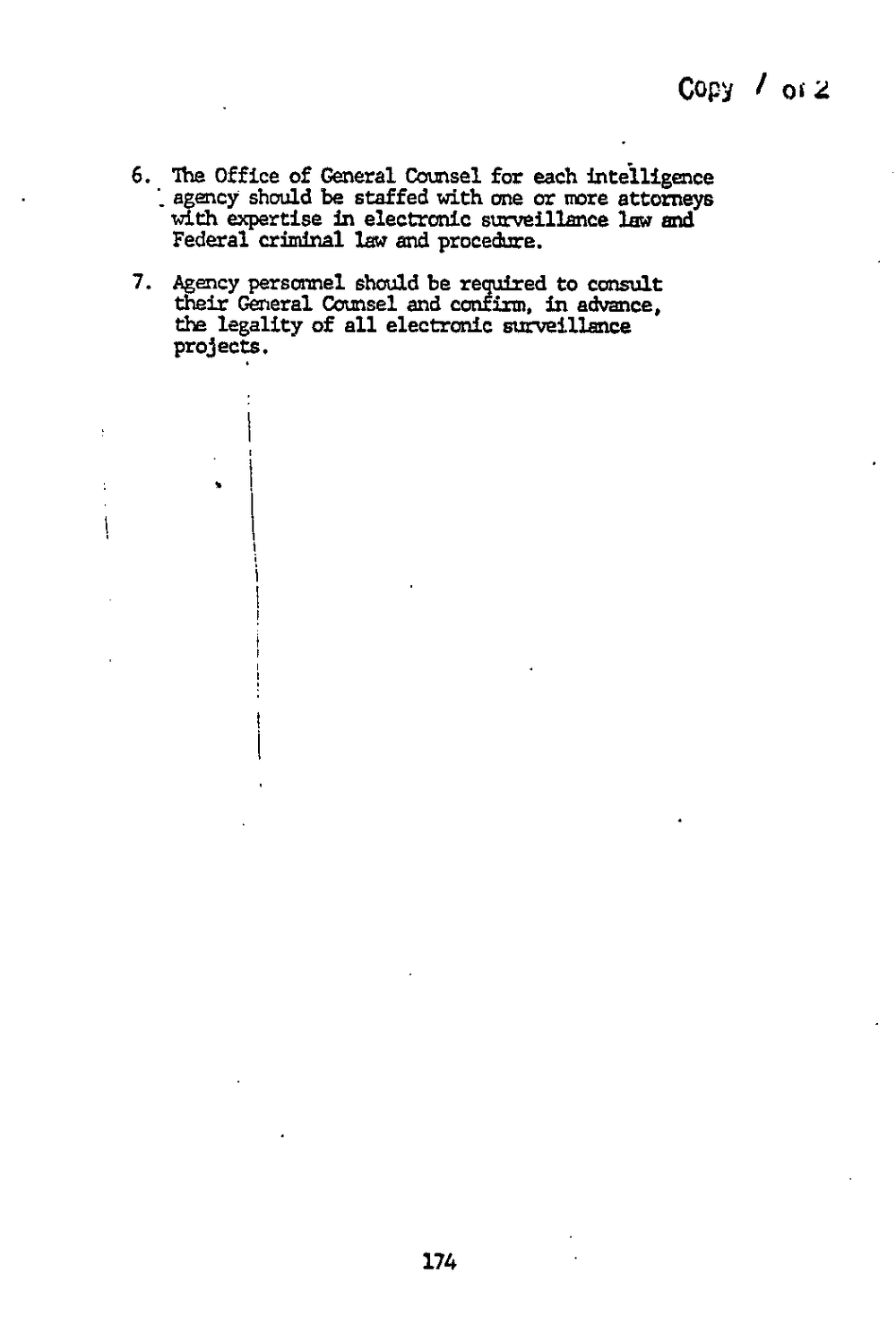
Copy on? 2
6. The Office of General Counsel for each intelligence
agency should be staffed with one or more attorneys
with expertise in electronic surveillmce law and
Federal crindnal law and procedure.
7. Agency personnel should be re ed to consult
their General Counsel and magi-rm, in advance,
the legality of all electronic surveillance
projects.
174
Copy on? 2
6. The Office of General Counsel for each intelligence
agency should be staffed with one or more attorneys
with expertise in electronic surveillmce law and
Federal crindnal law and procedure.
7. Agency personnel should be re ed to consult
their General Counsel and magi-rm, in advance,
the legality of all electronic surveillance
projects.
174
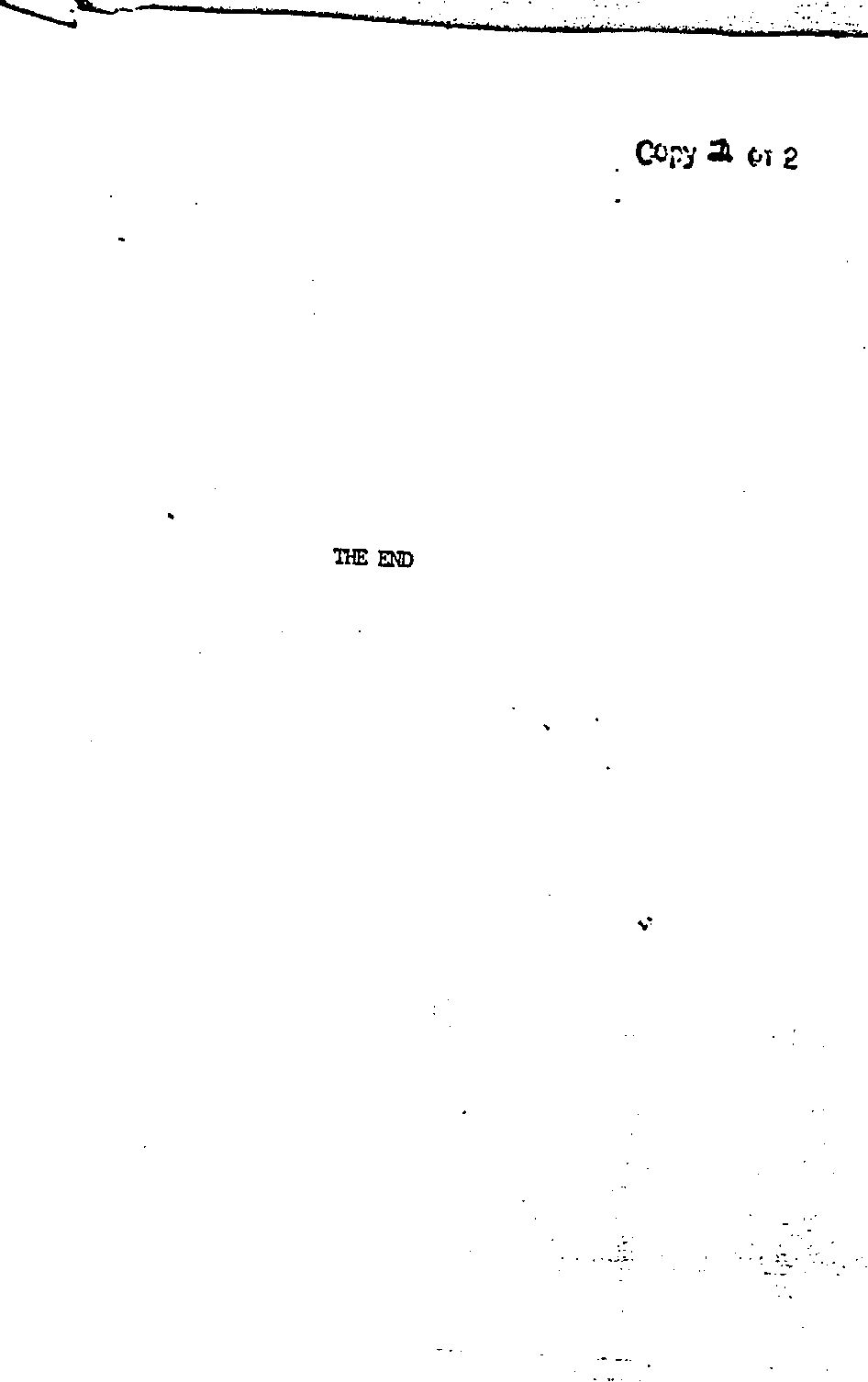
.-
.-
- n. - .
I
a?
un-
.-
.-
- n. - .
I
a?
un-